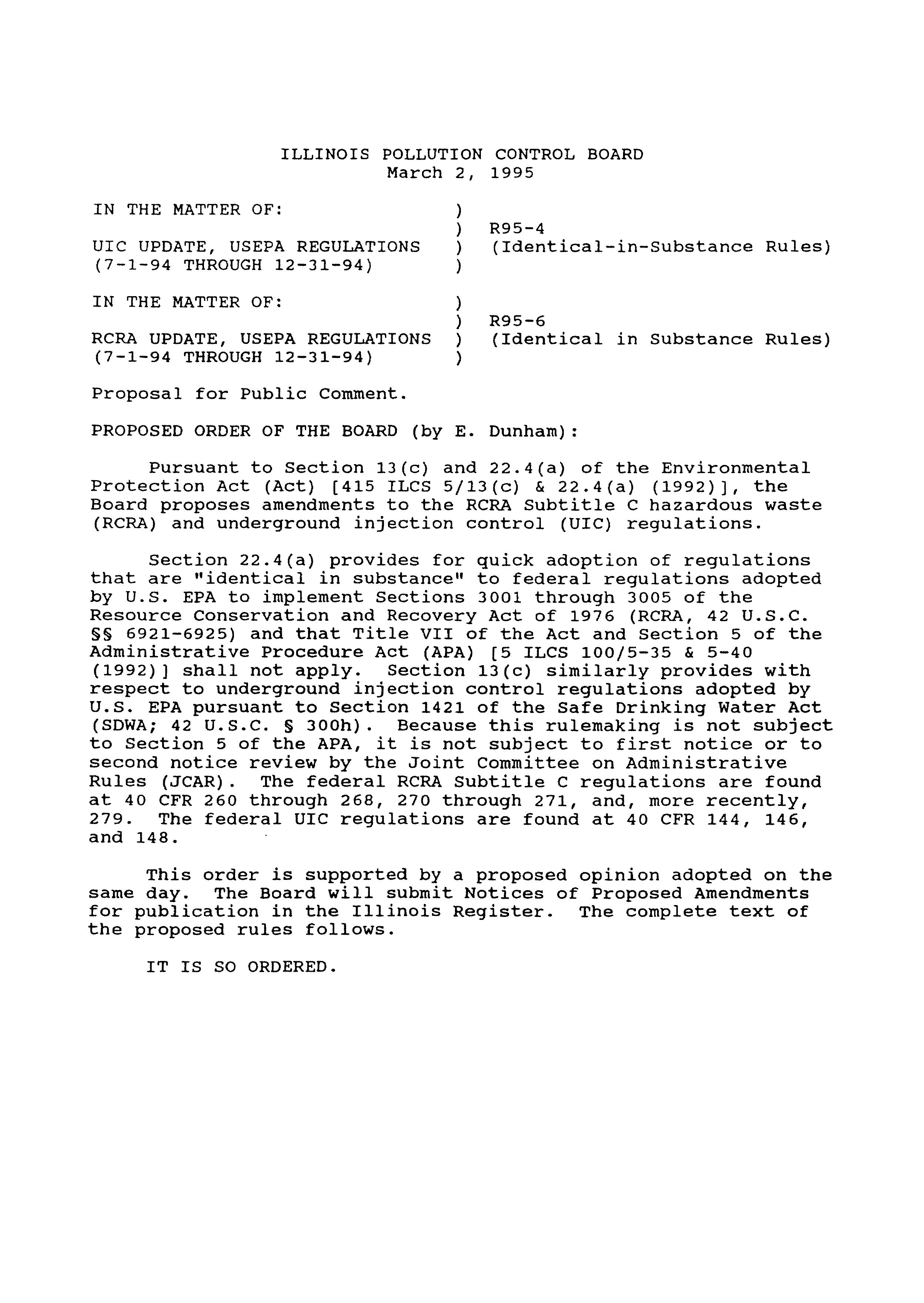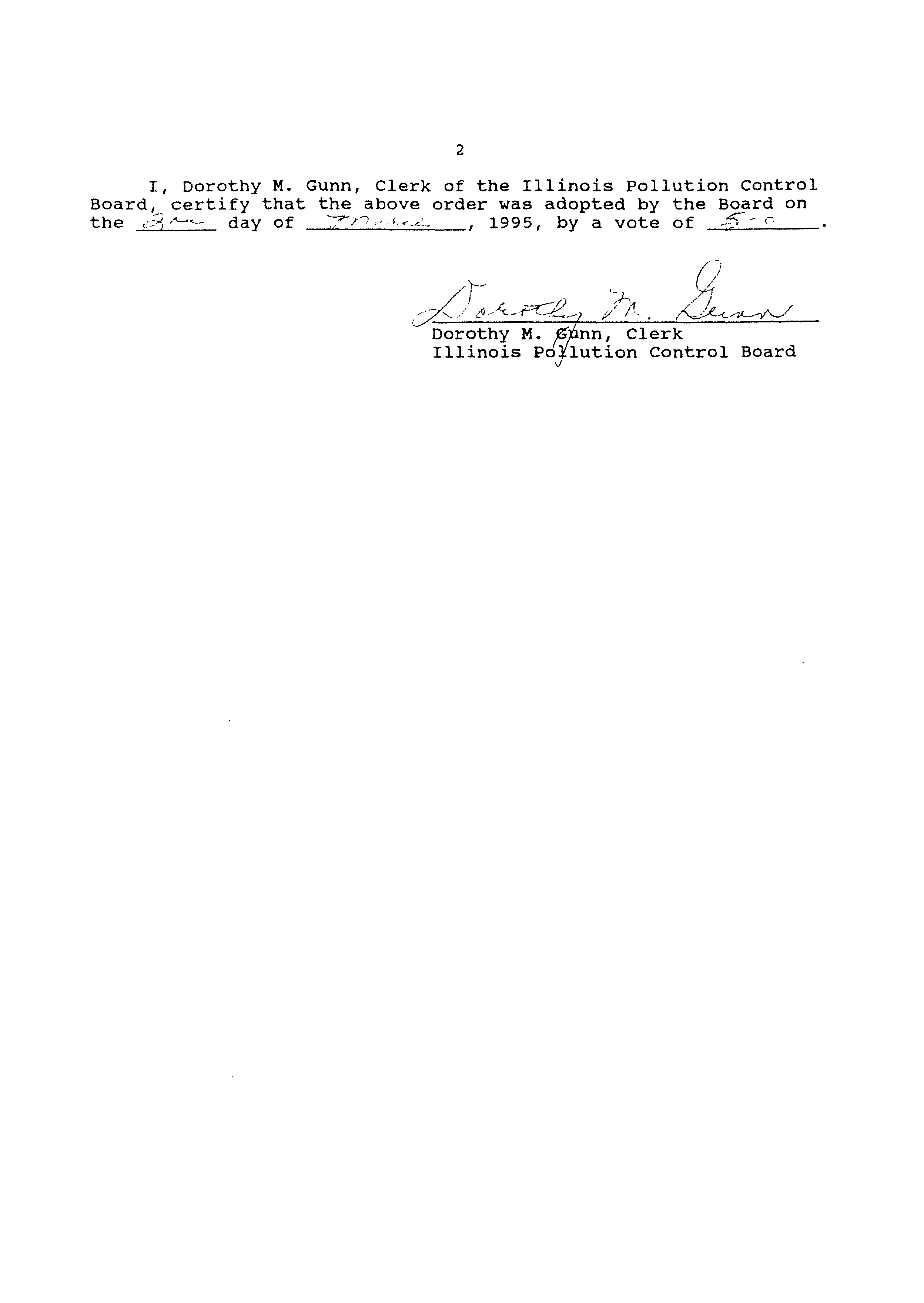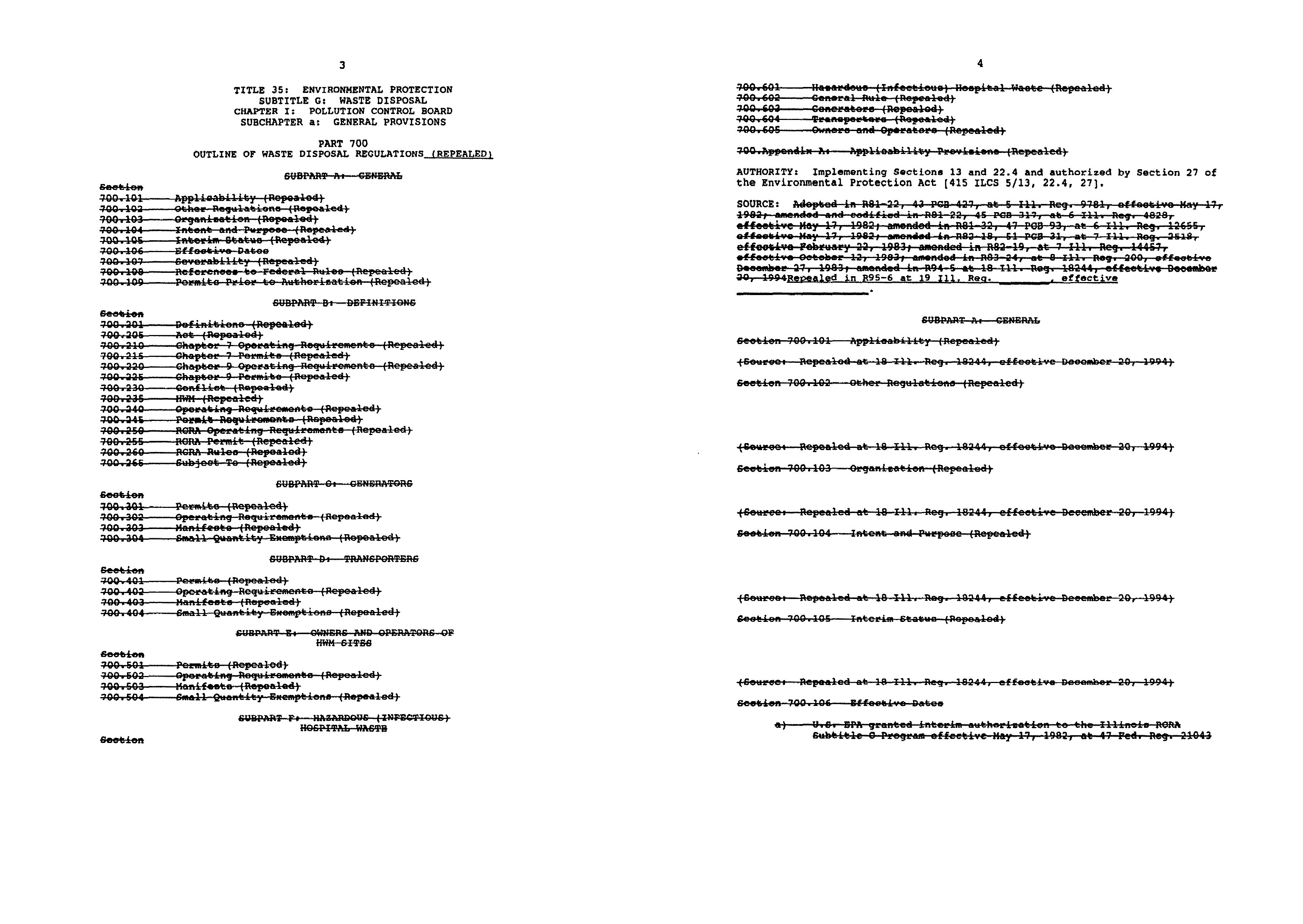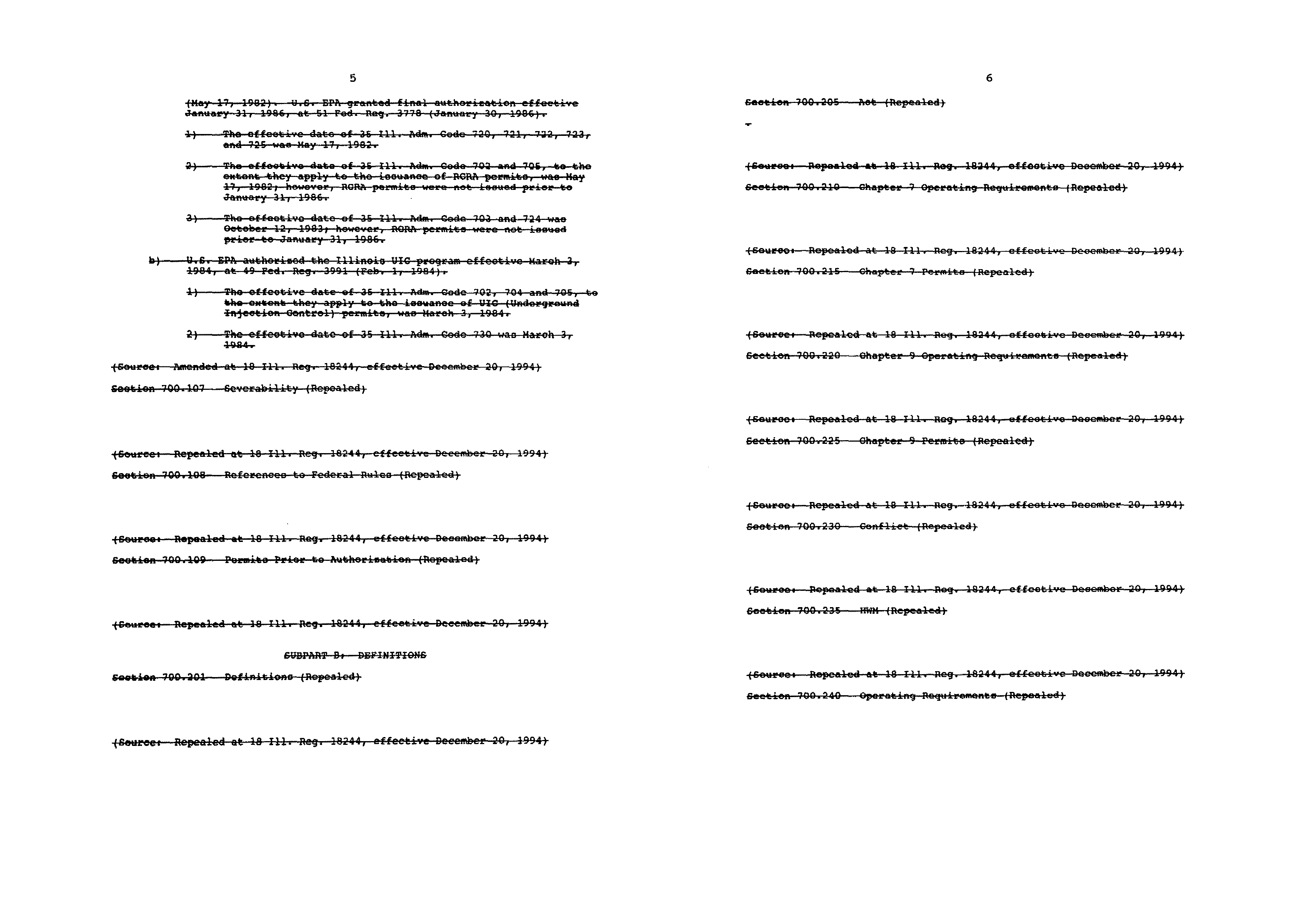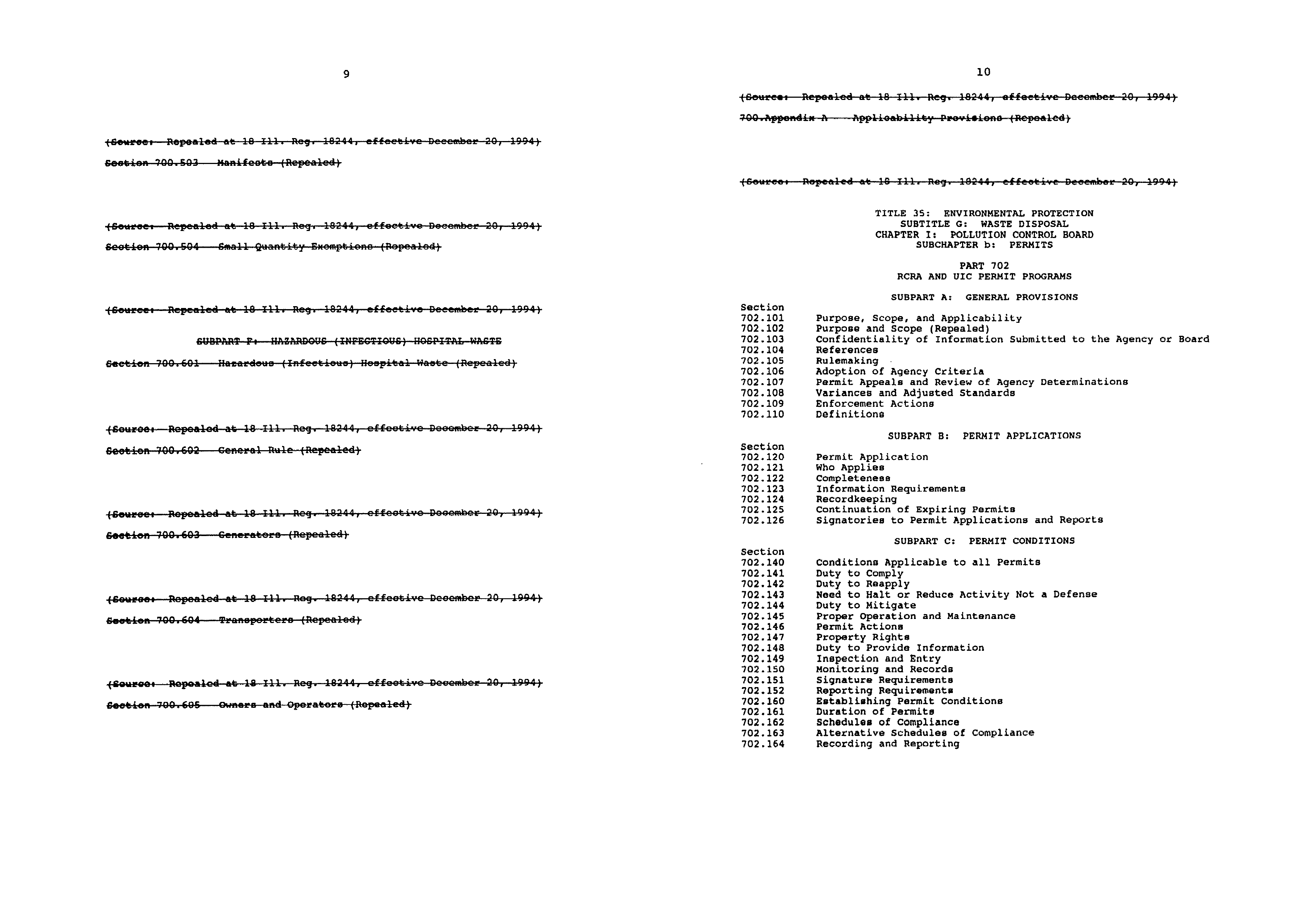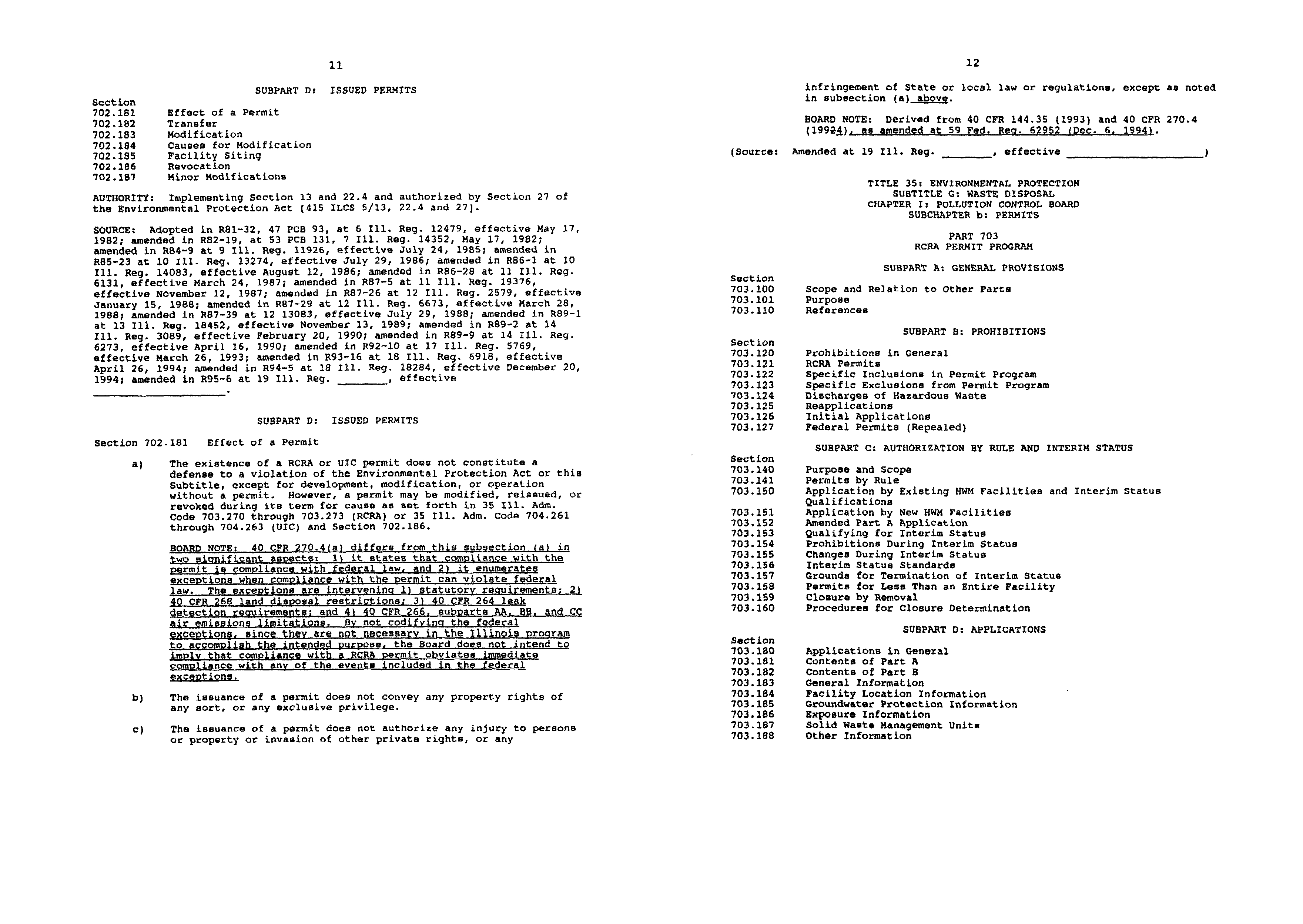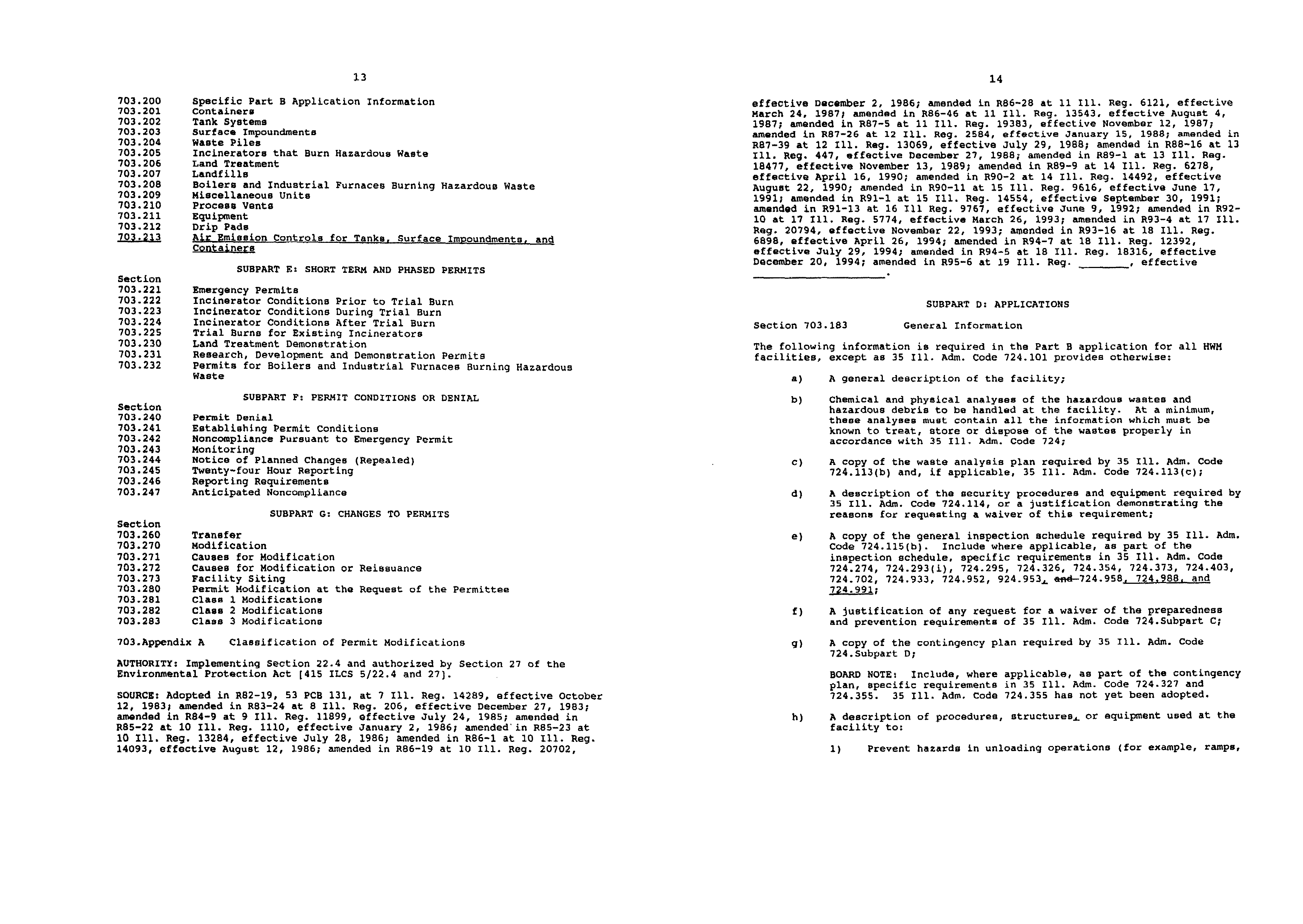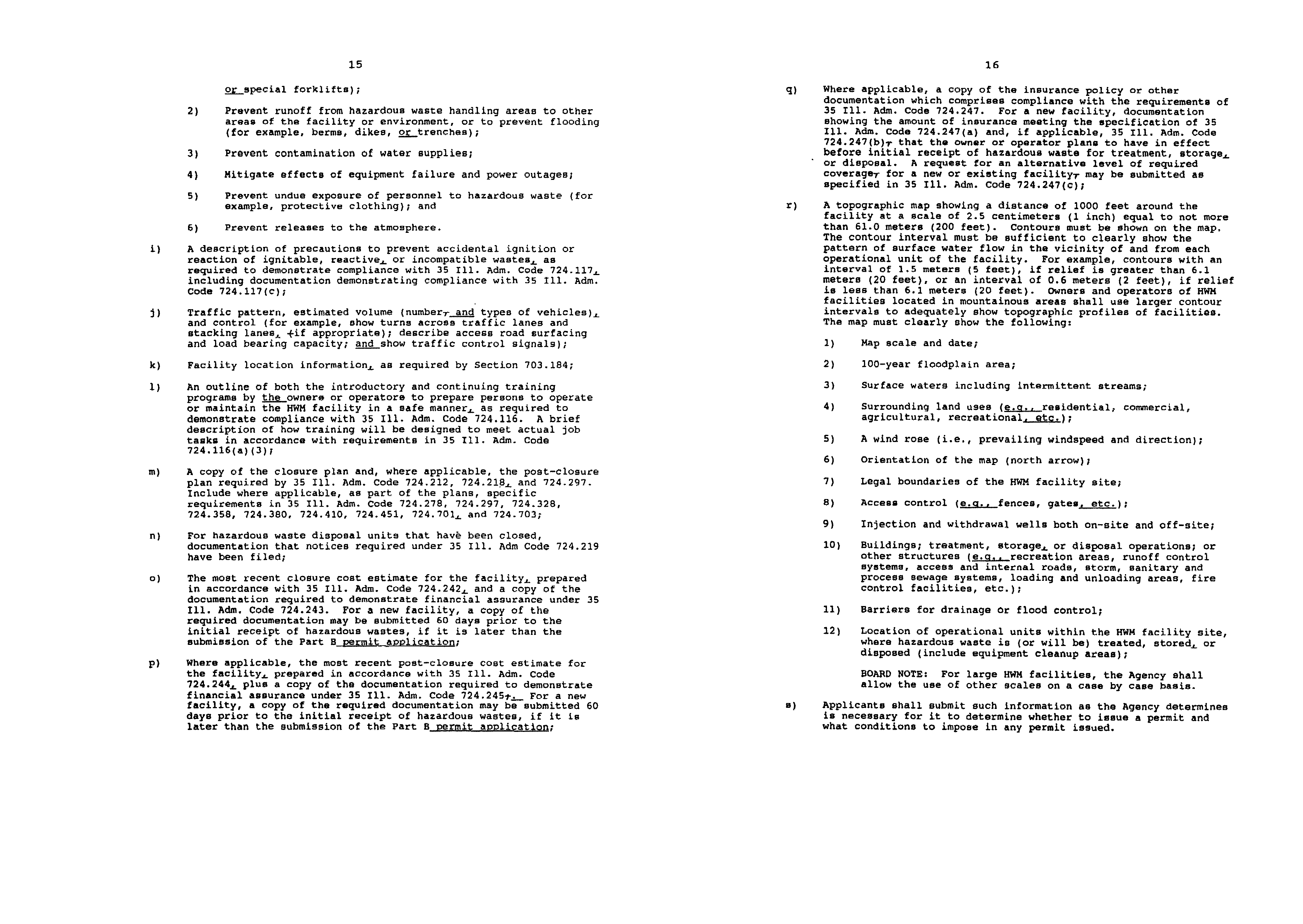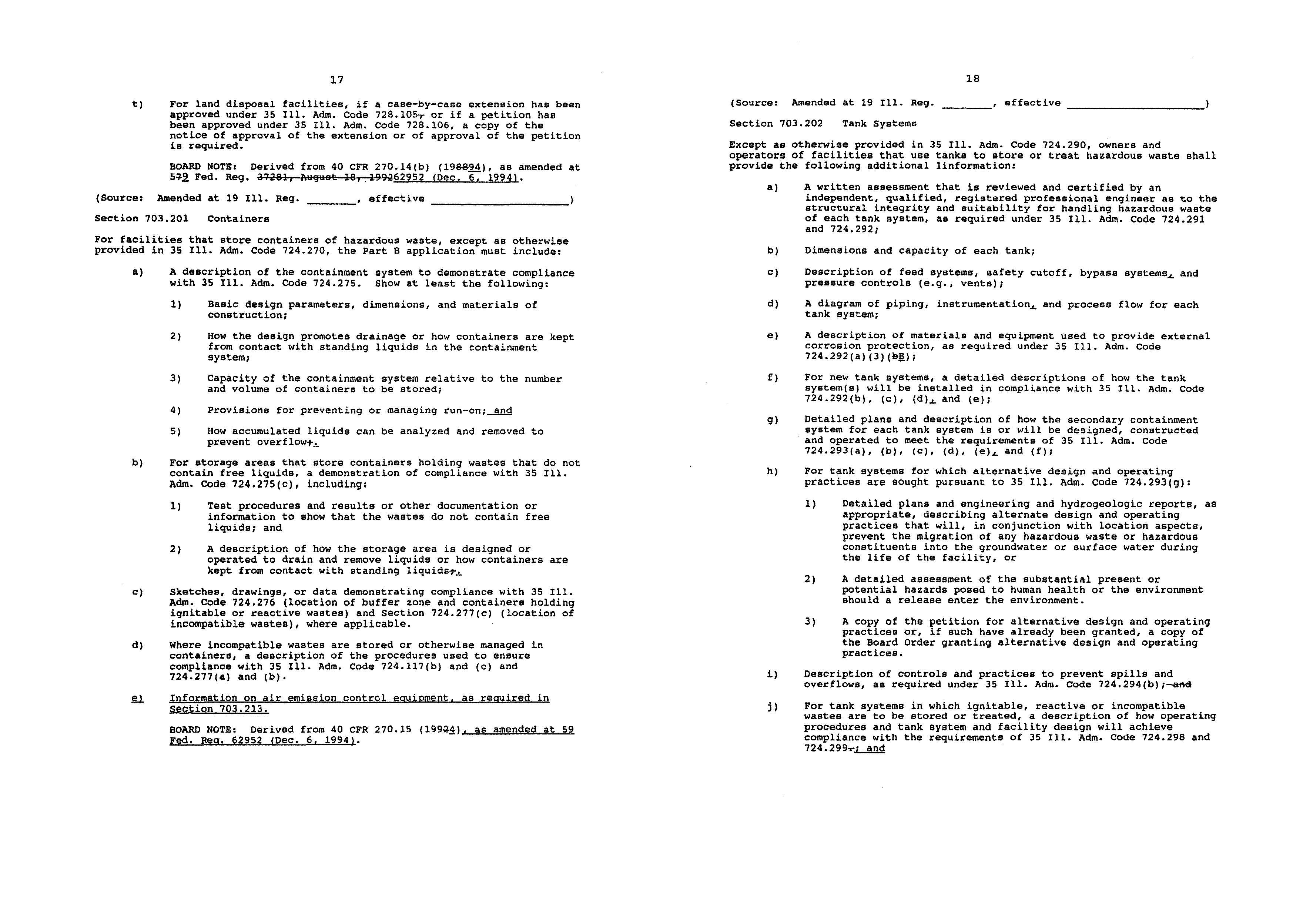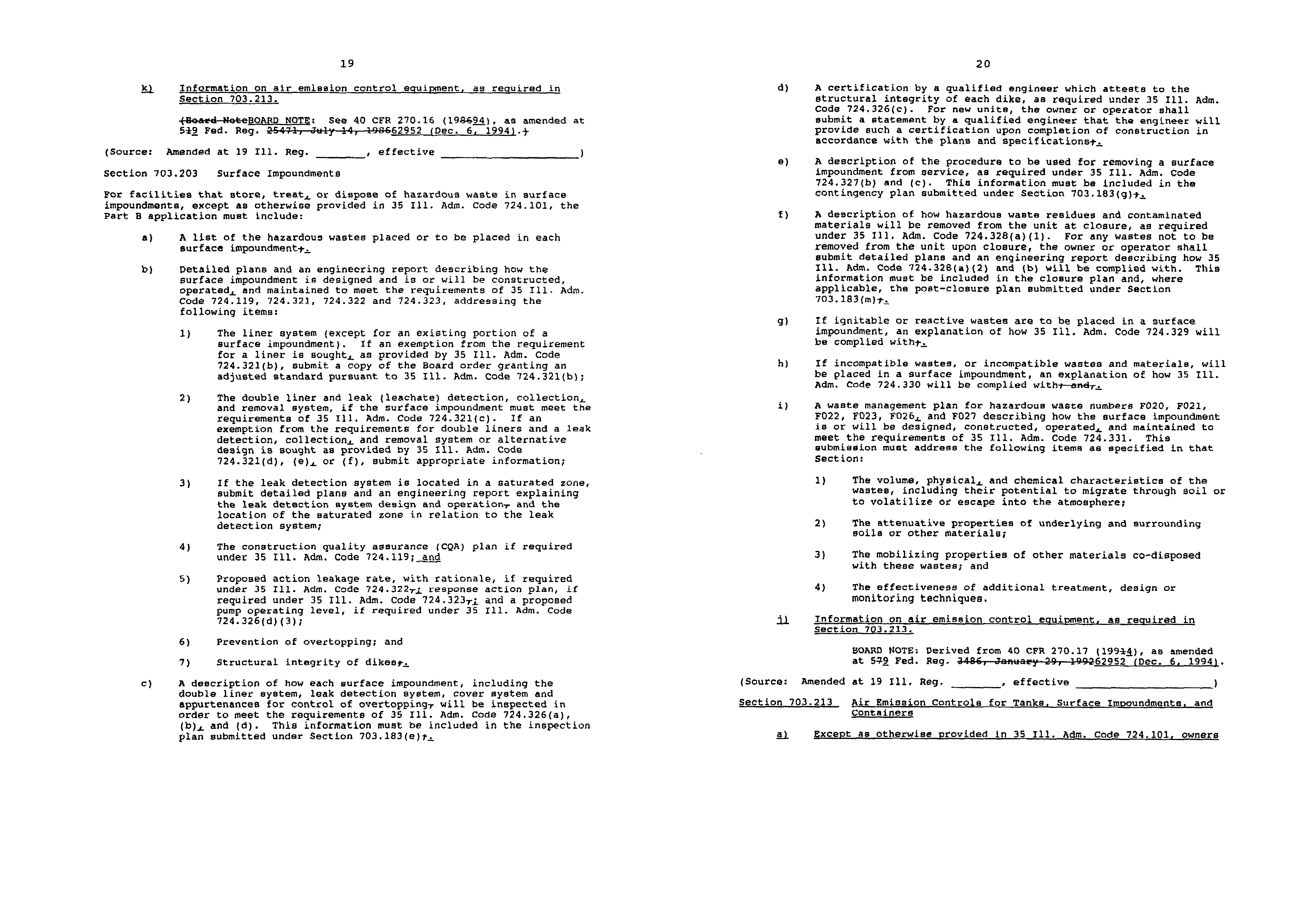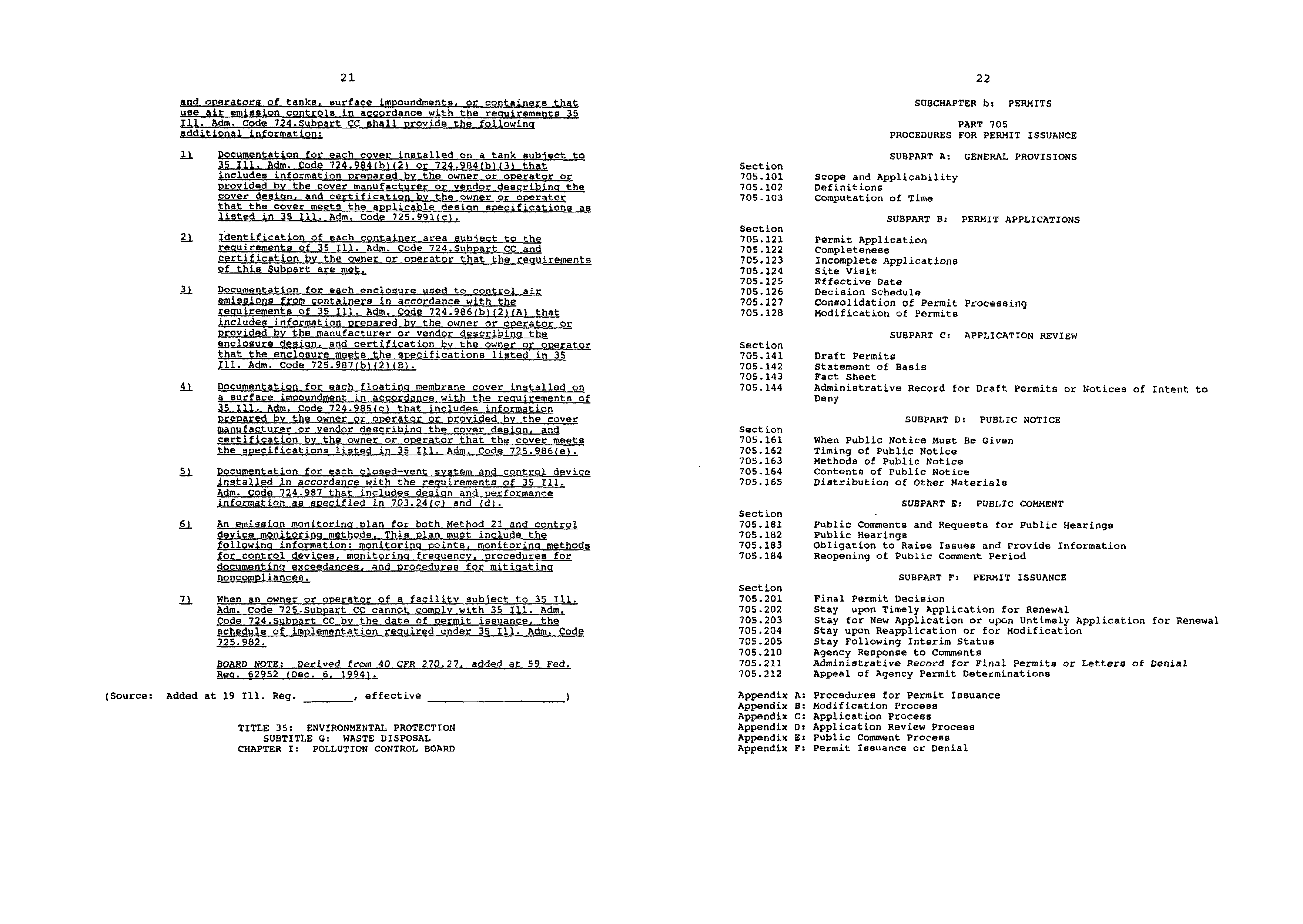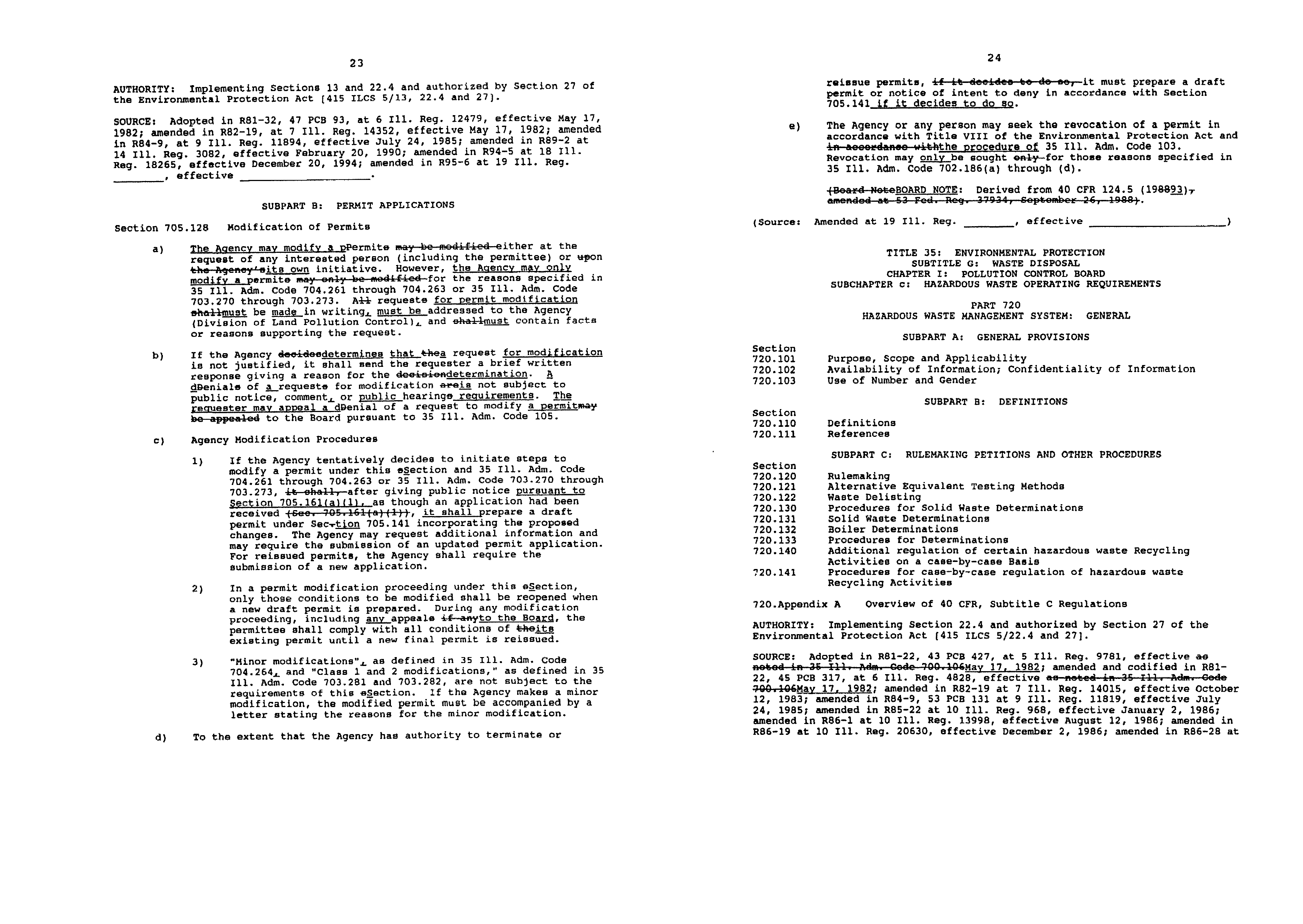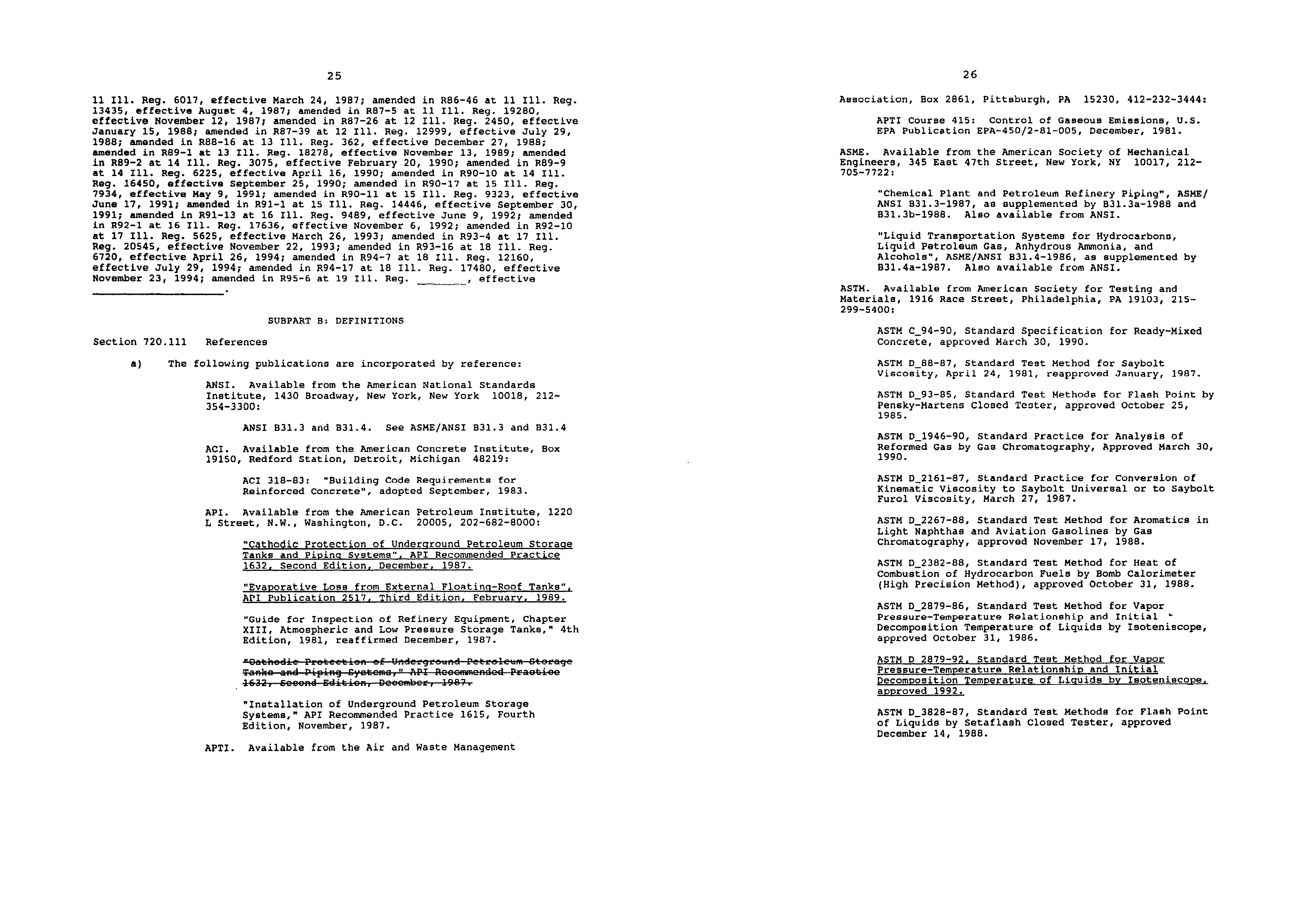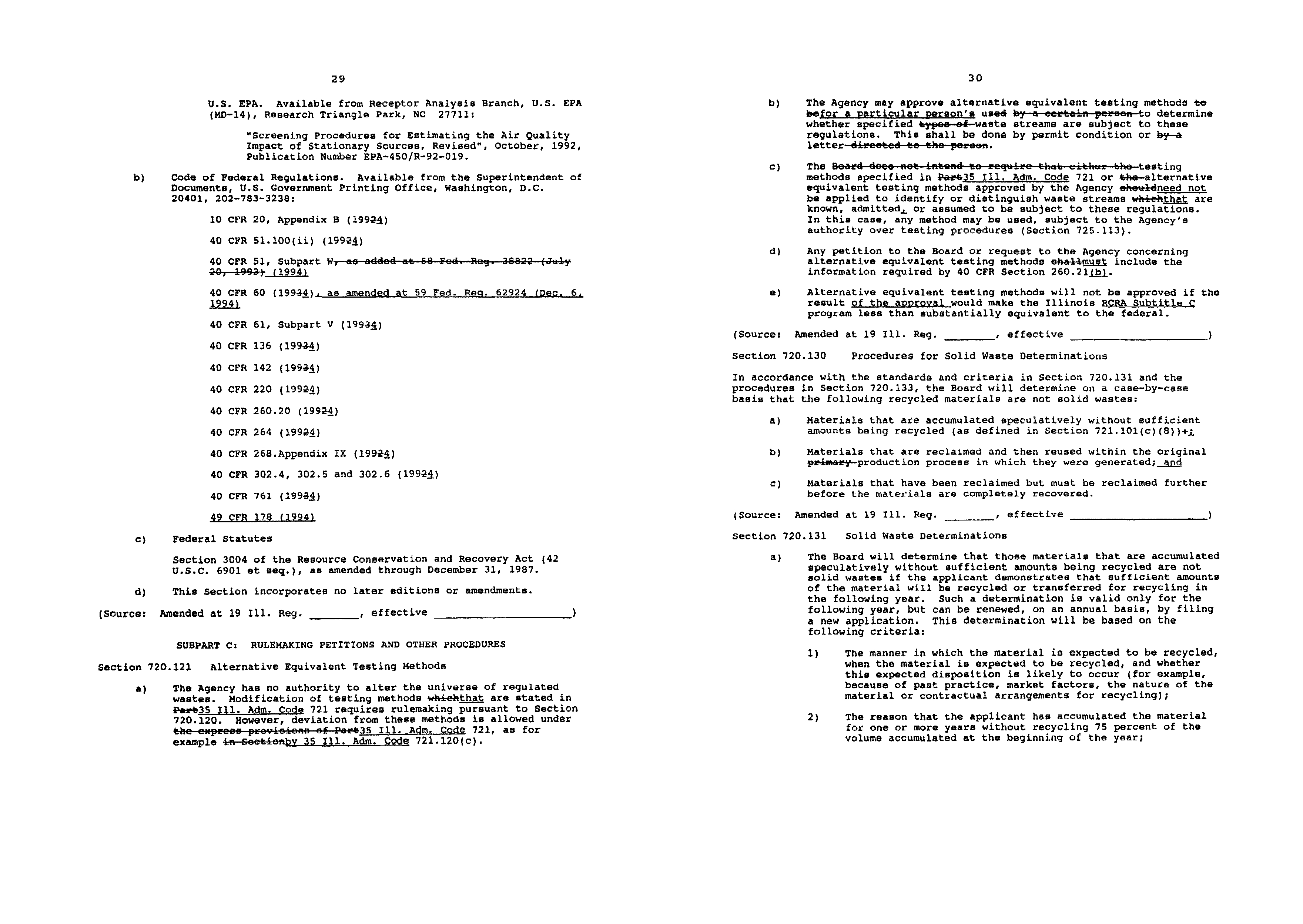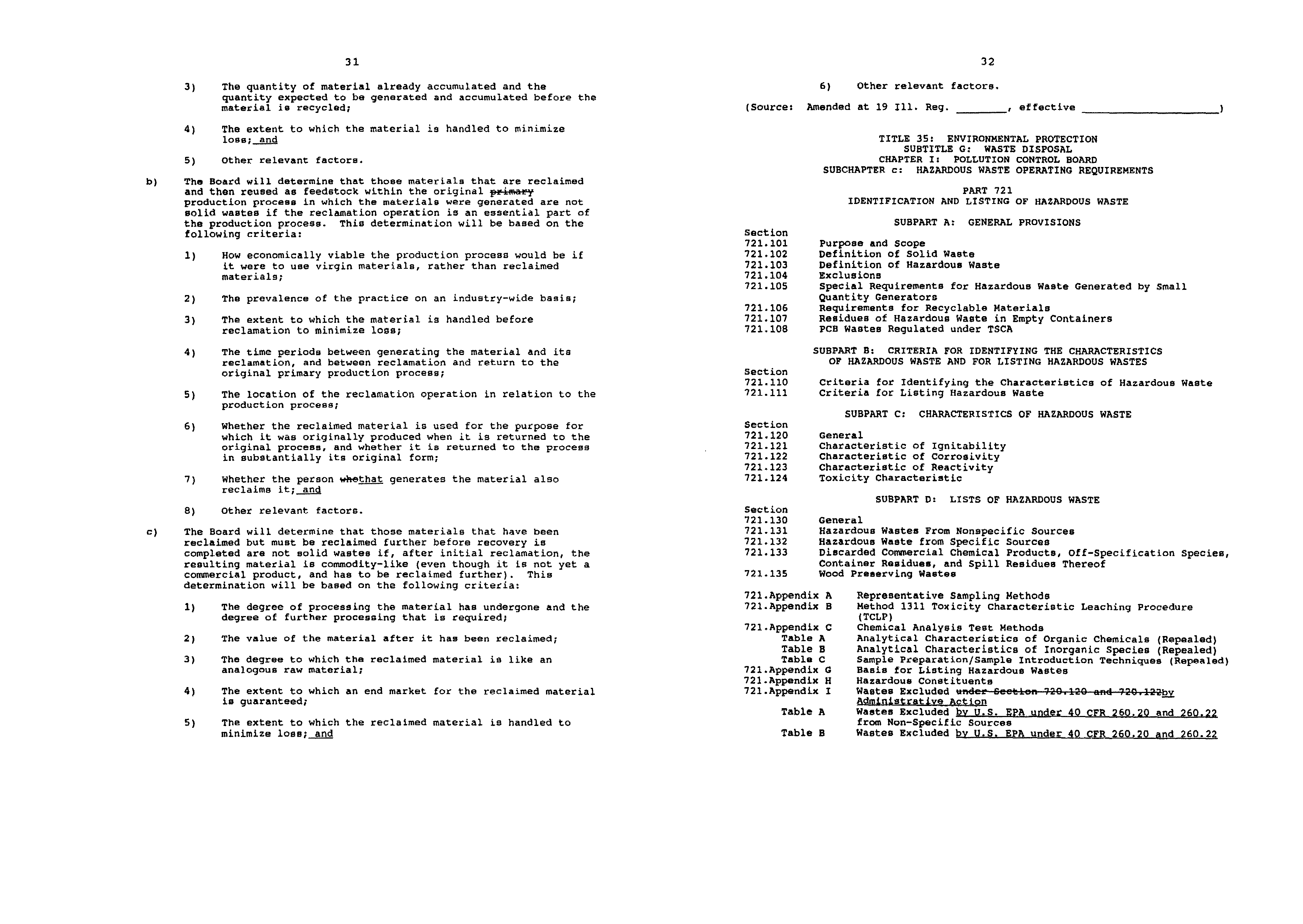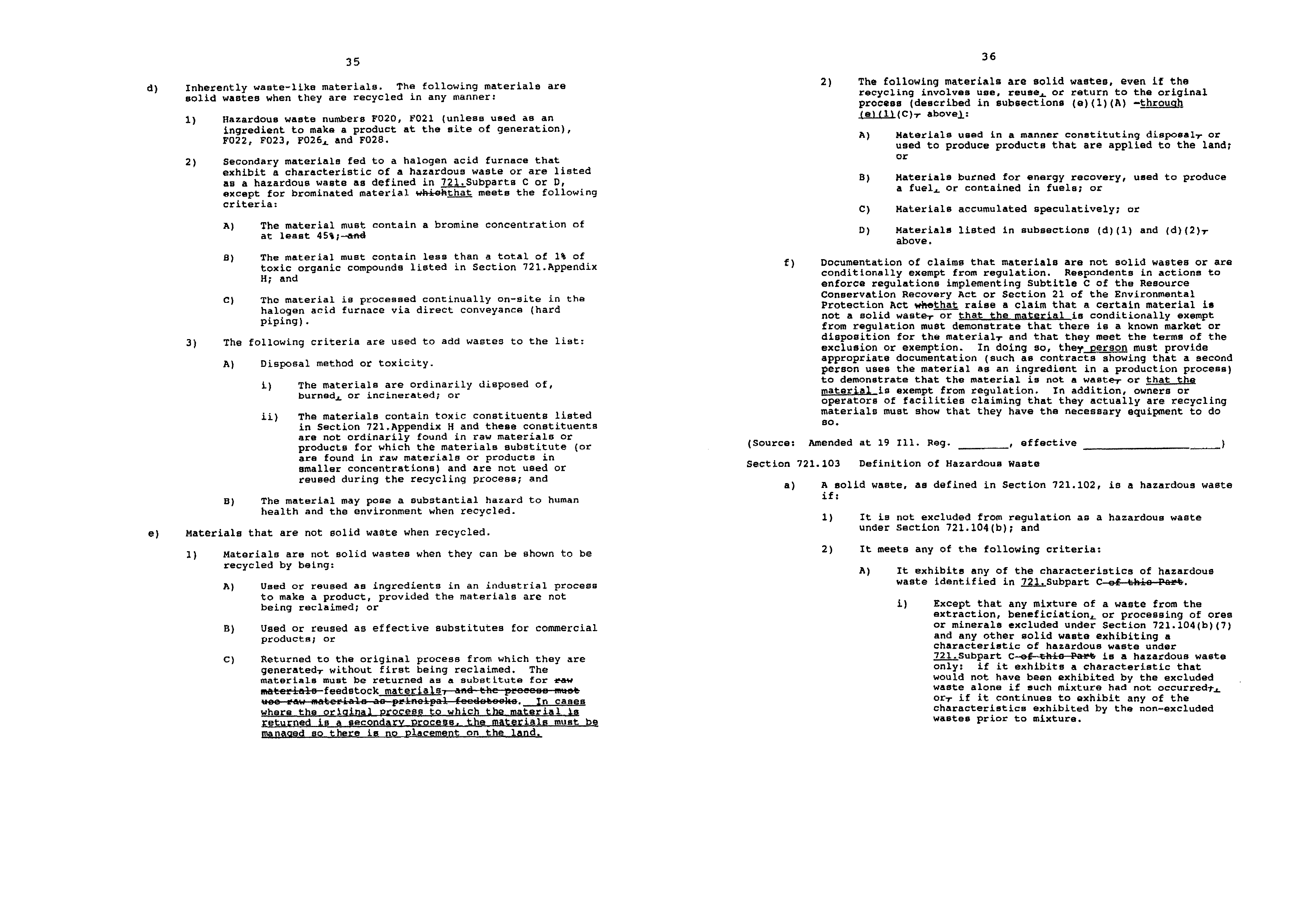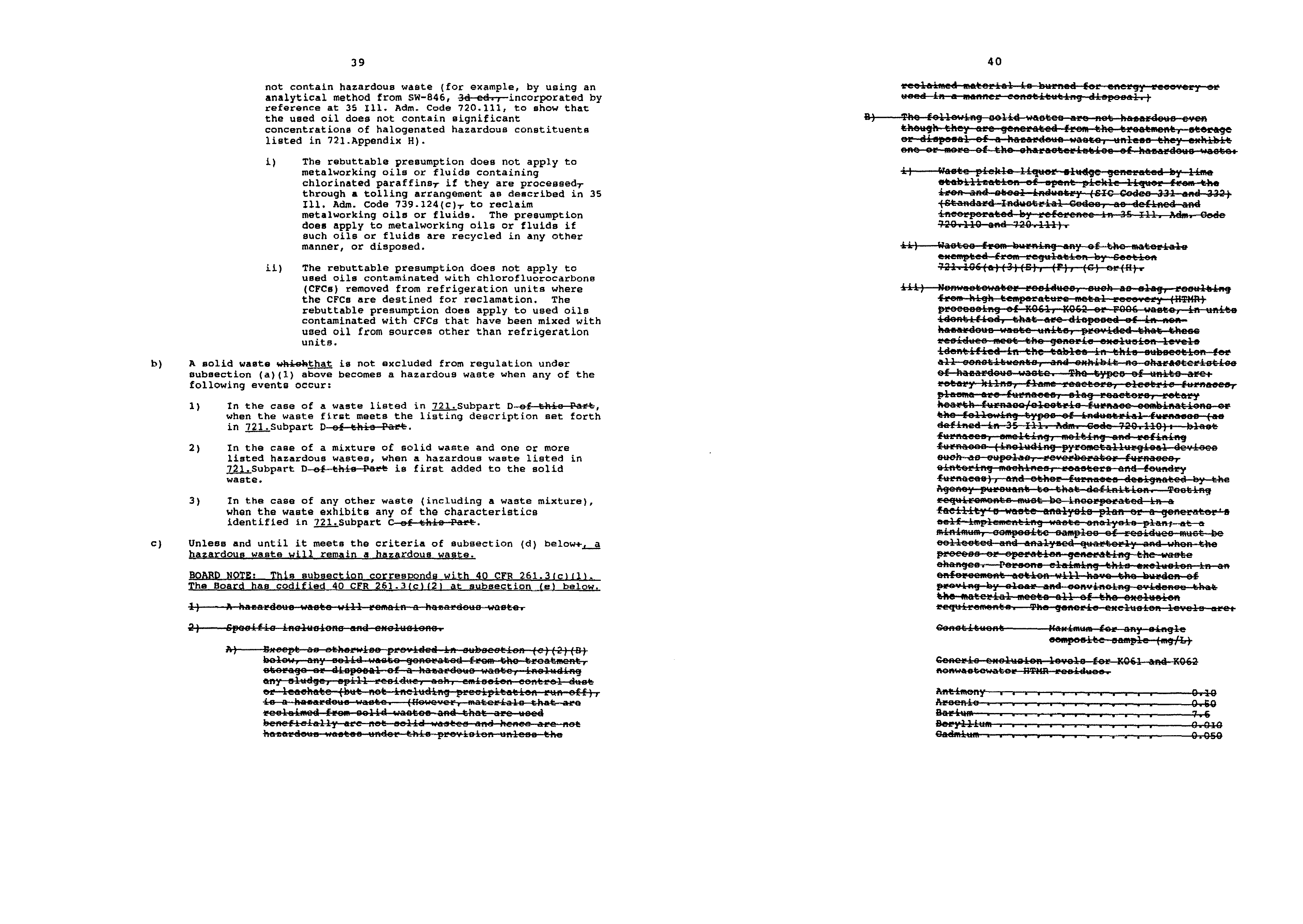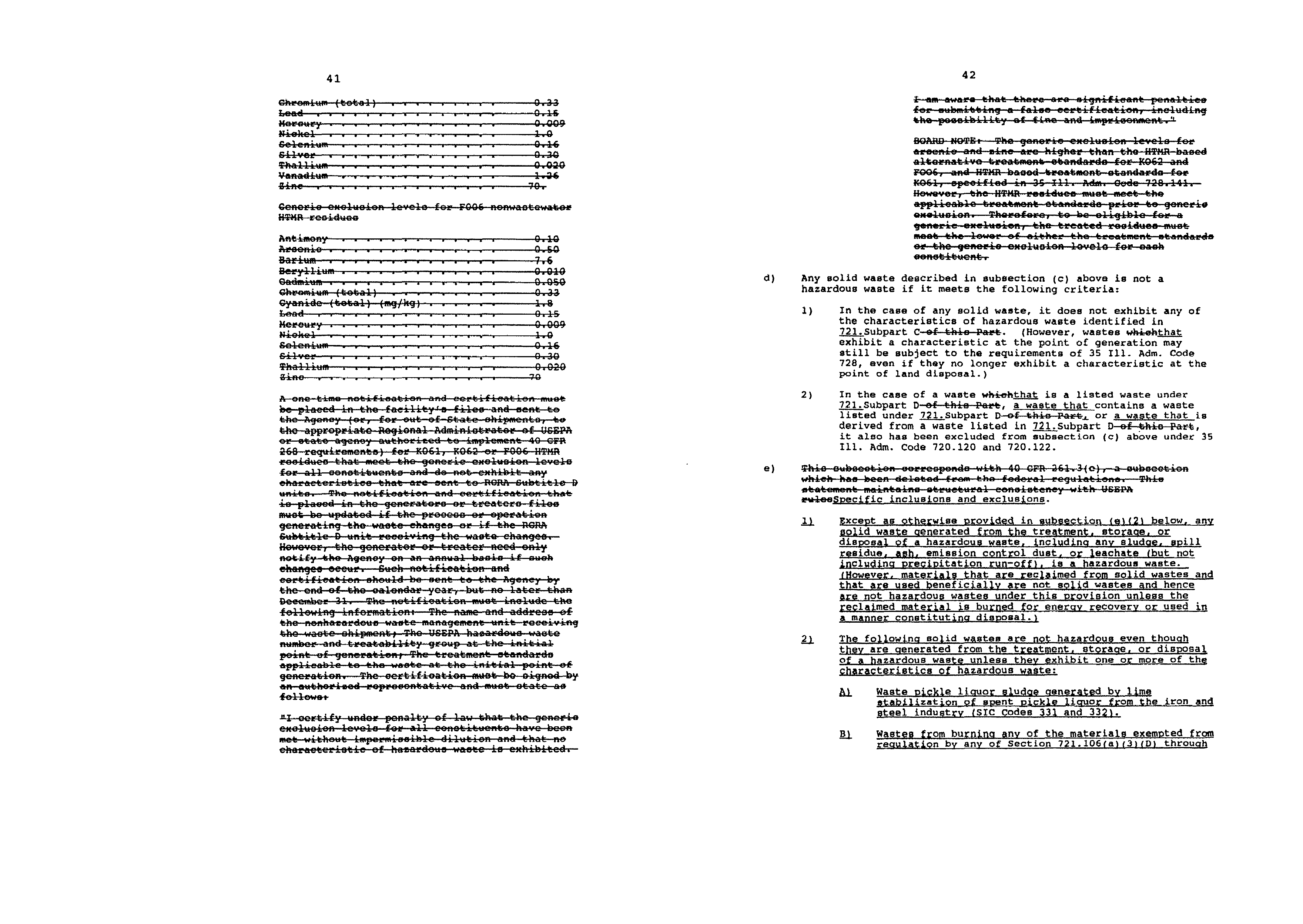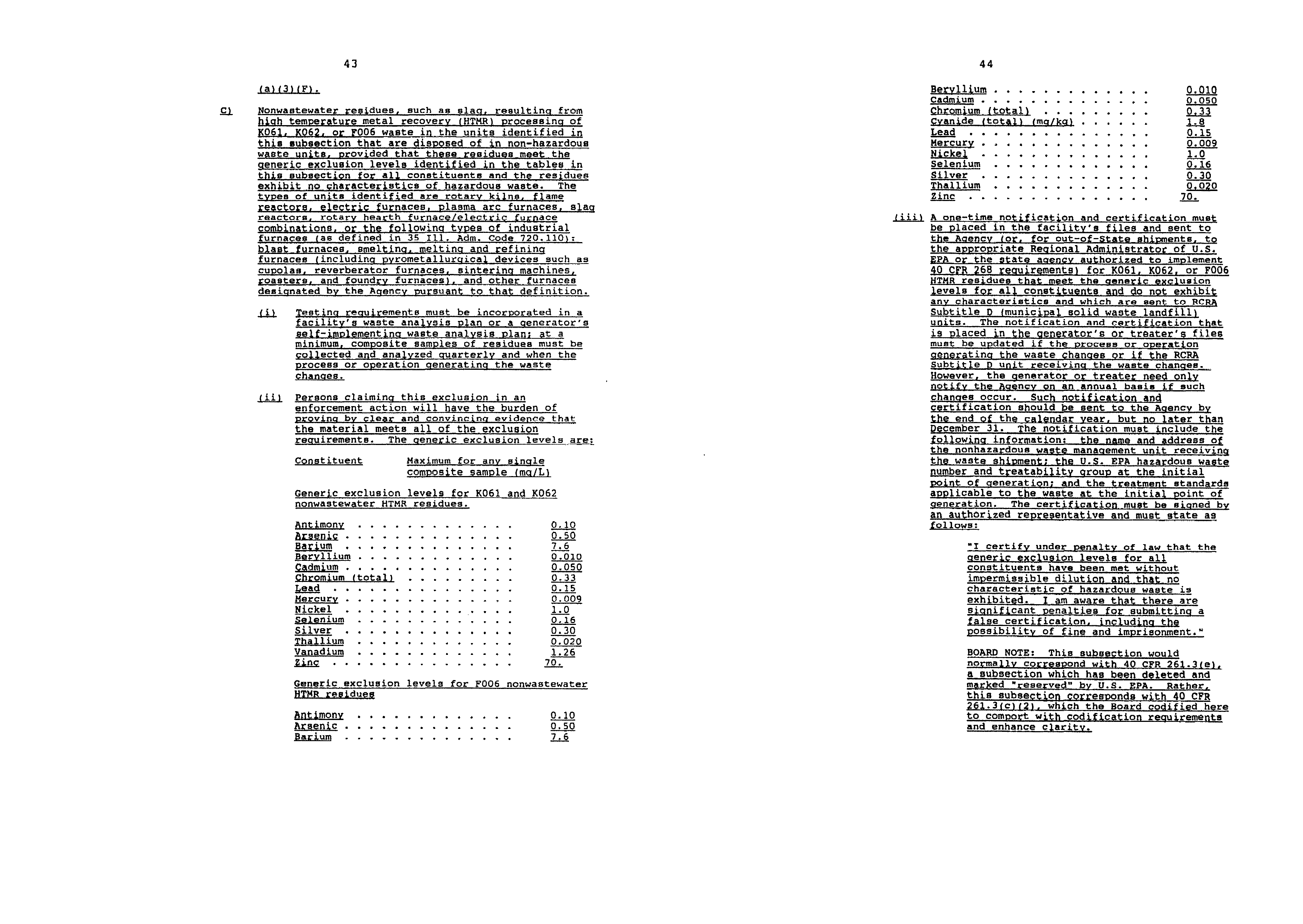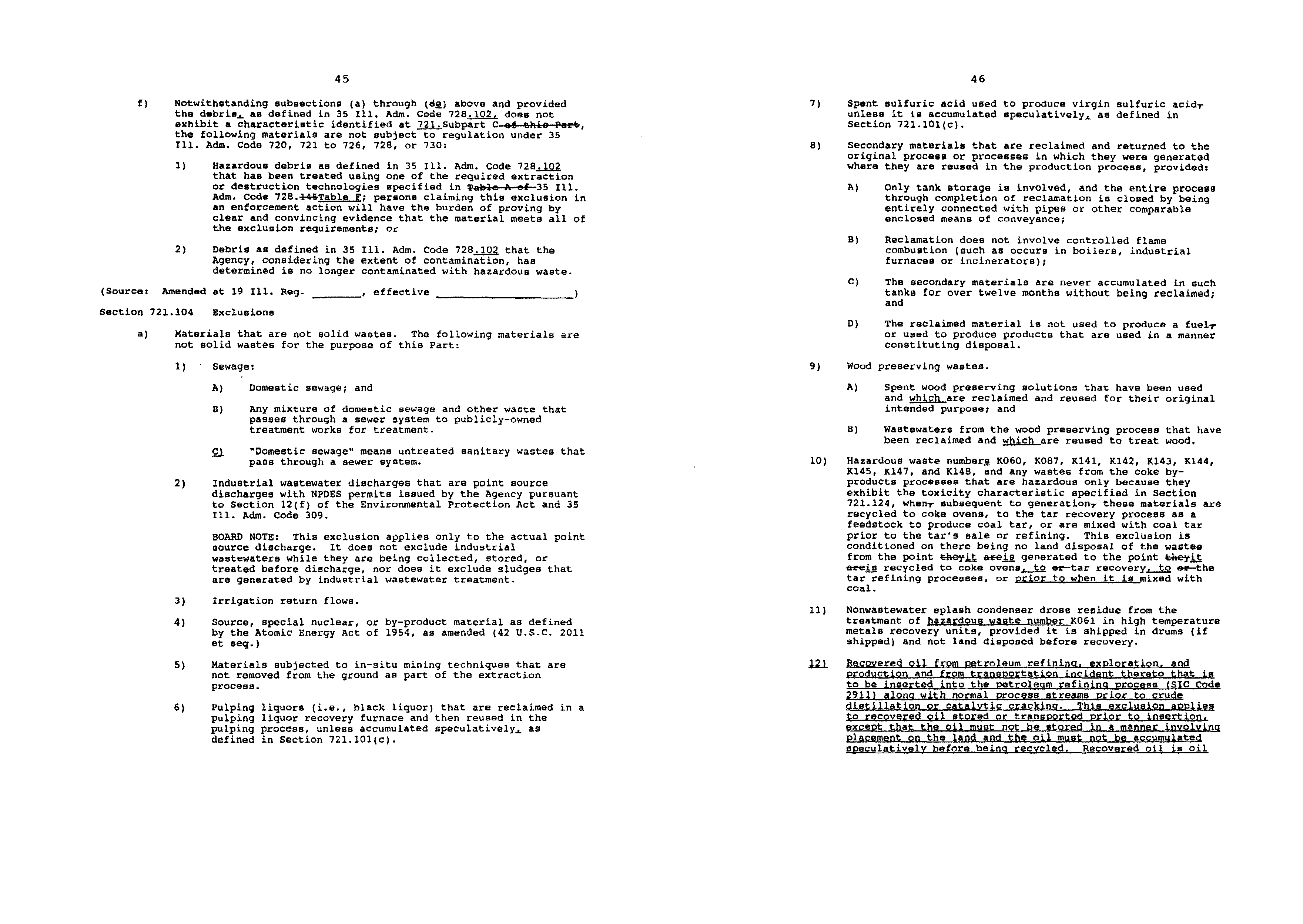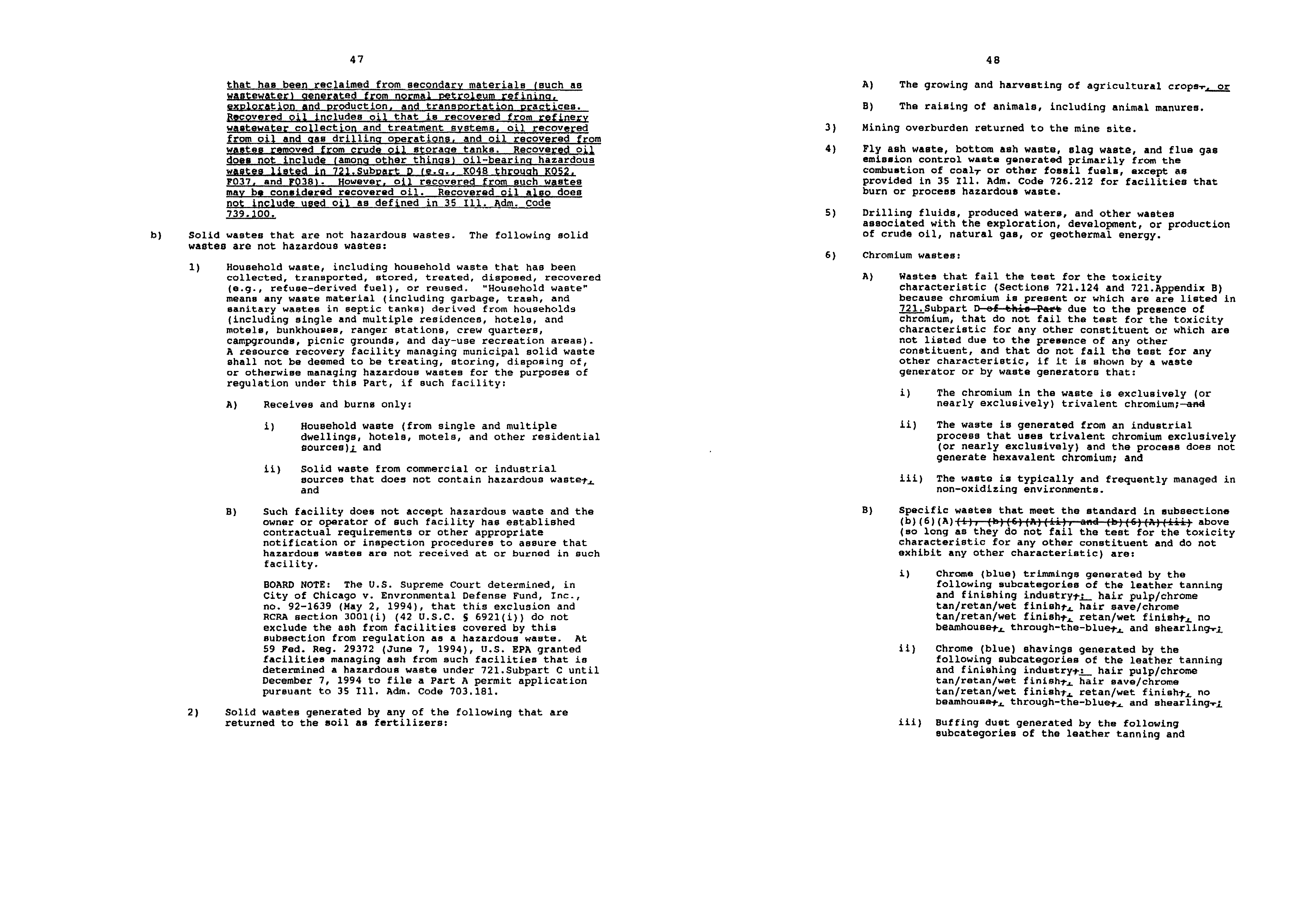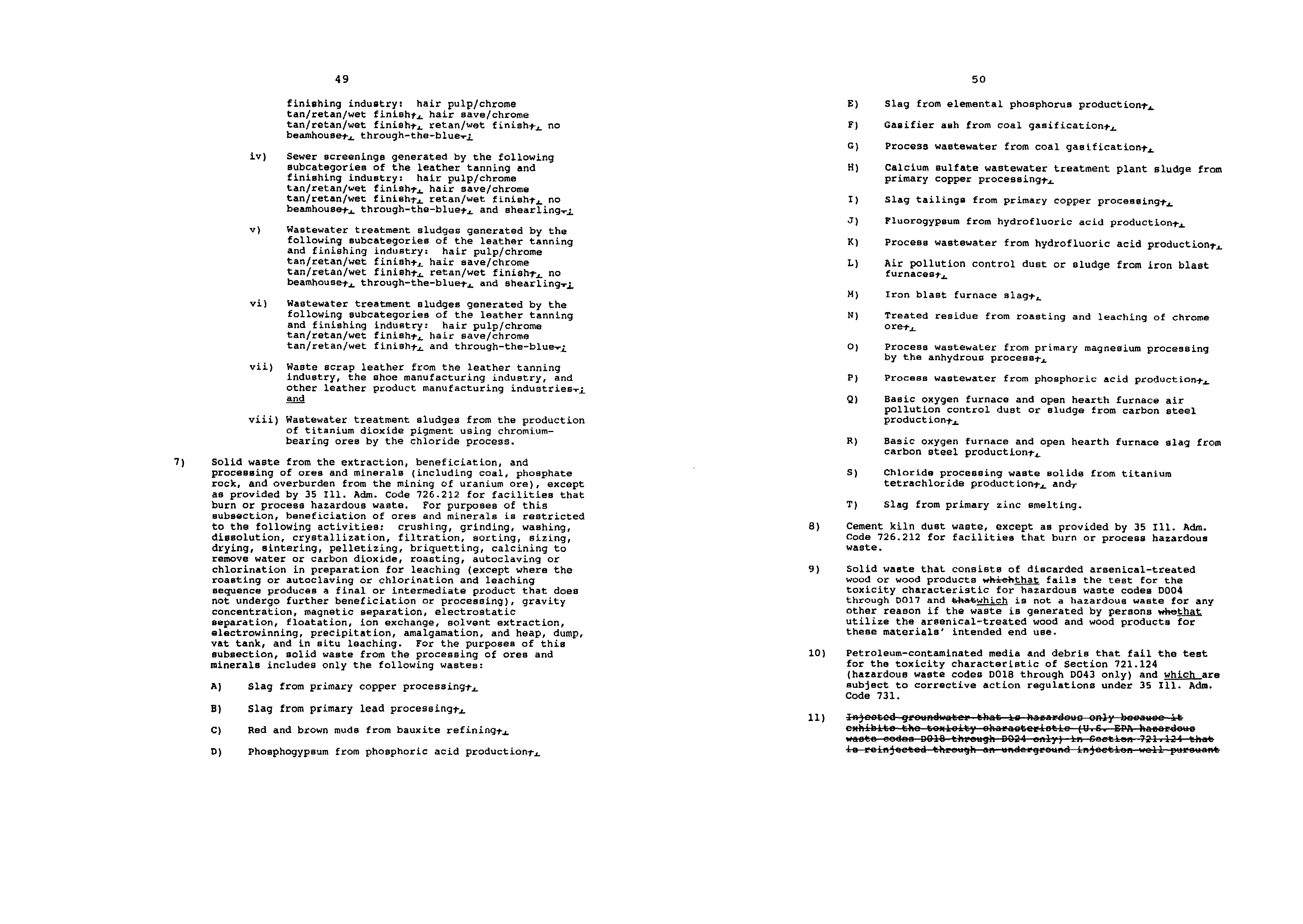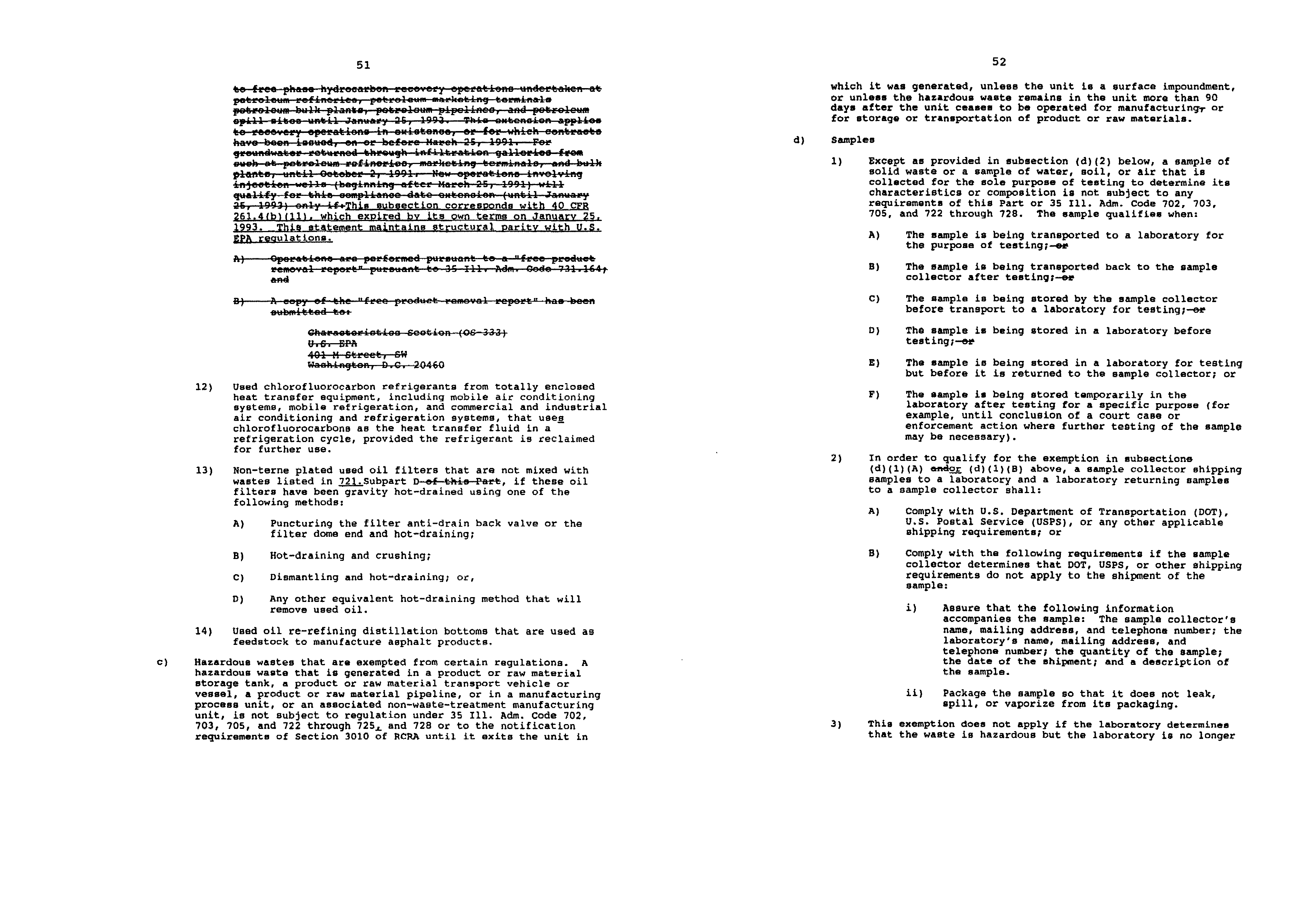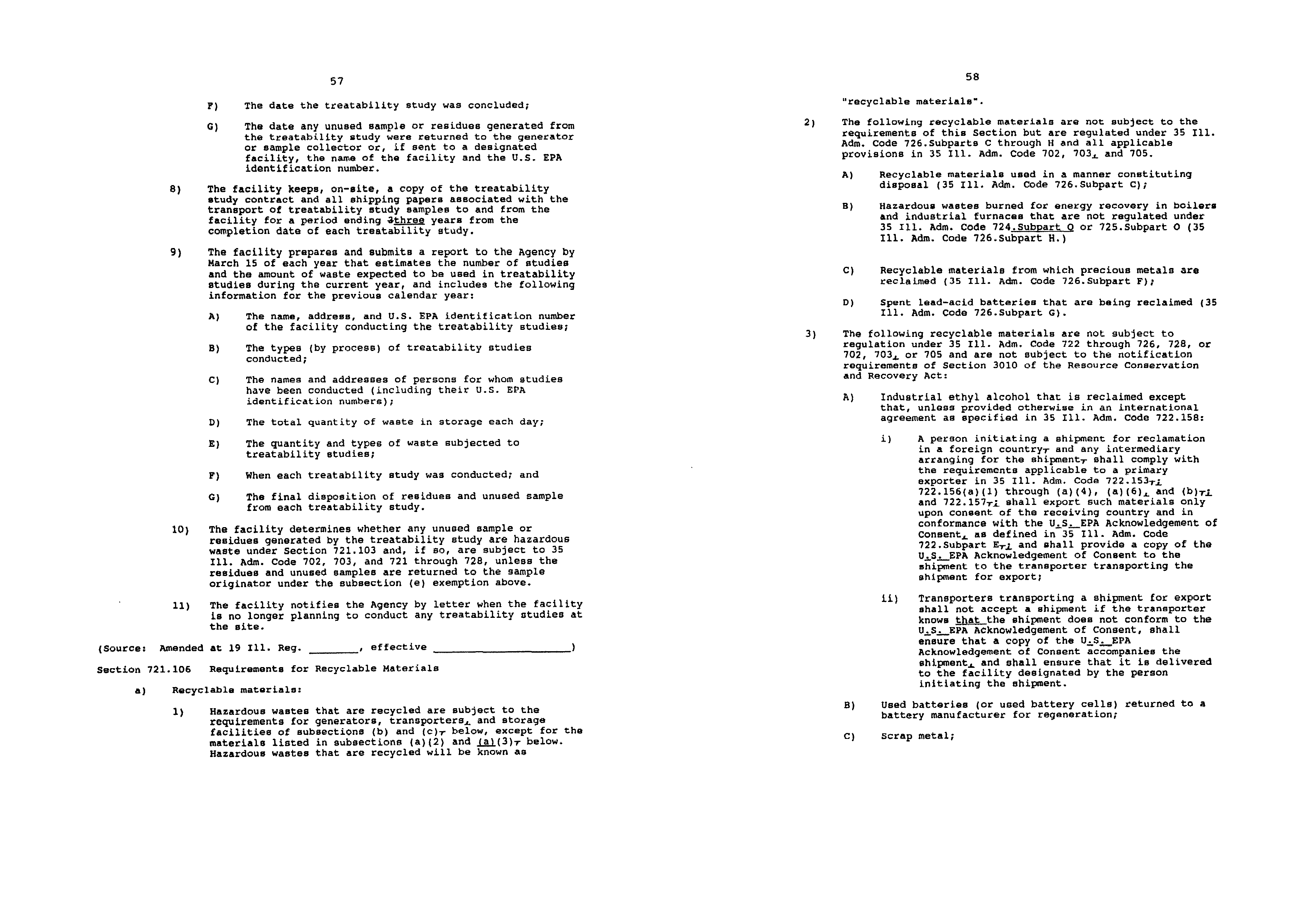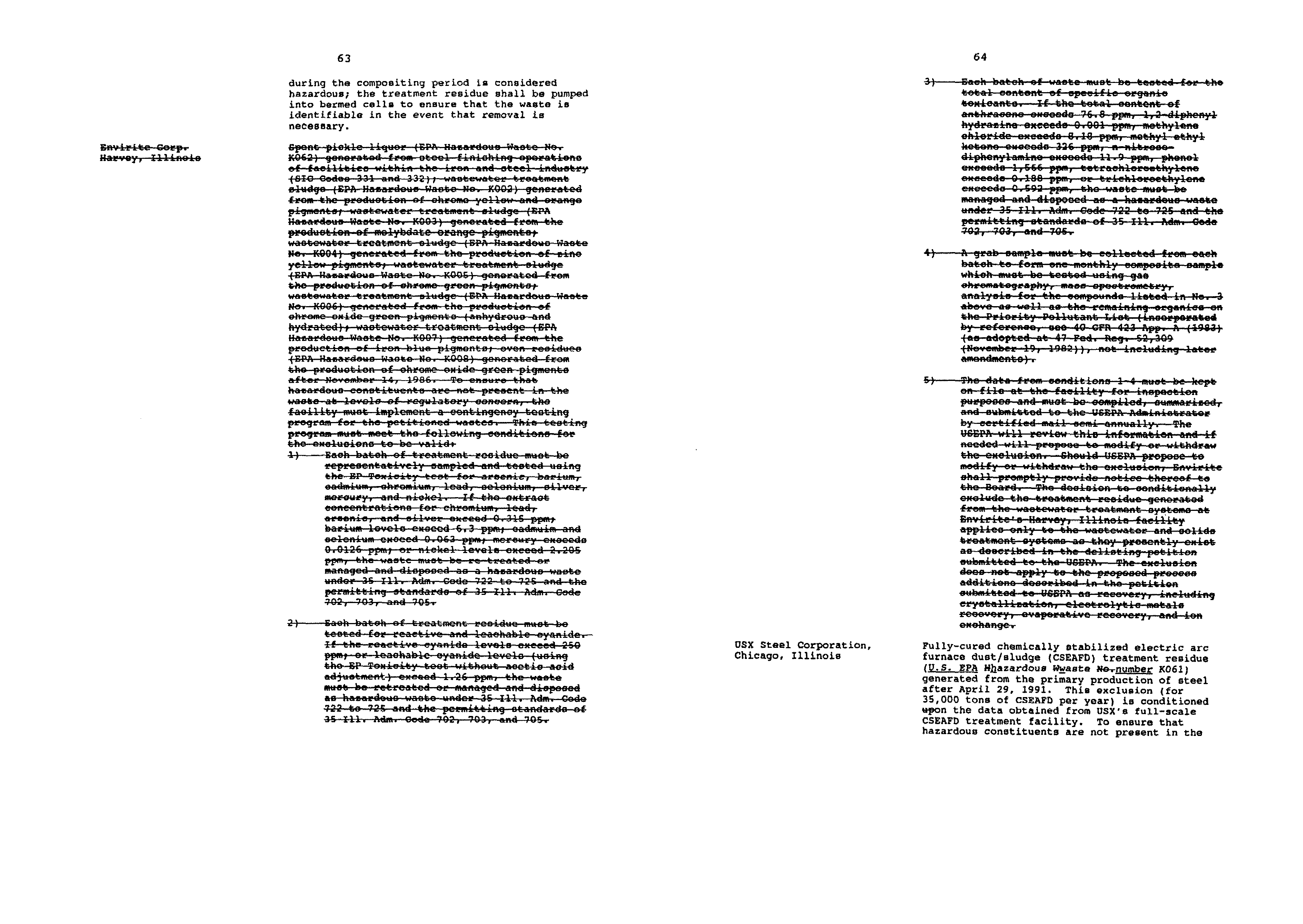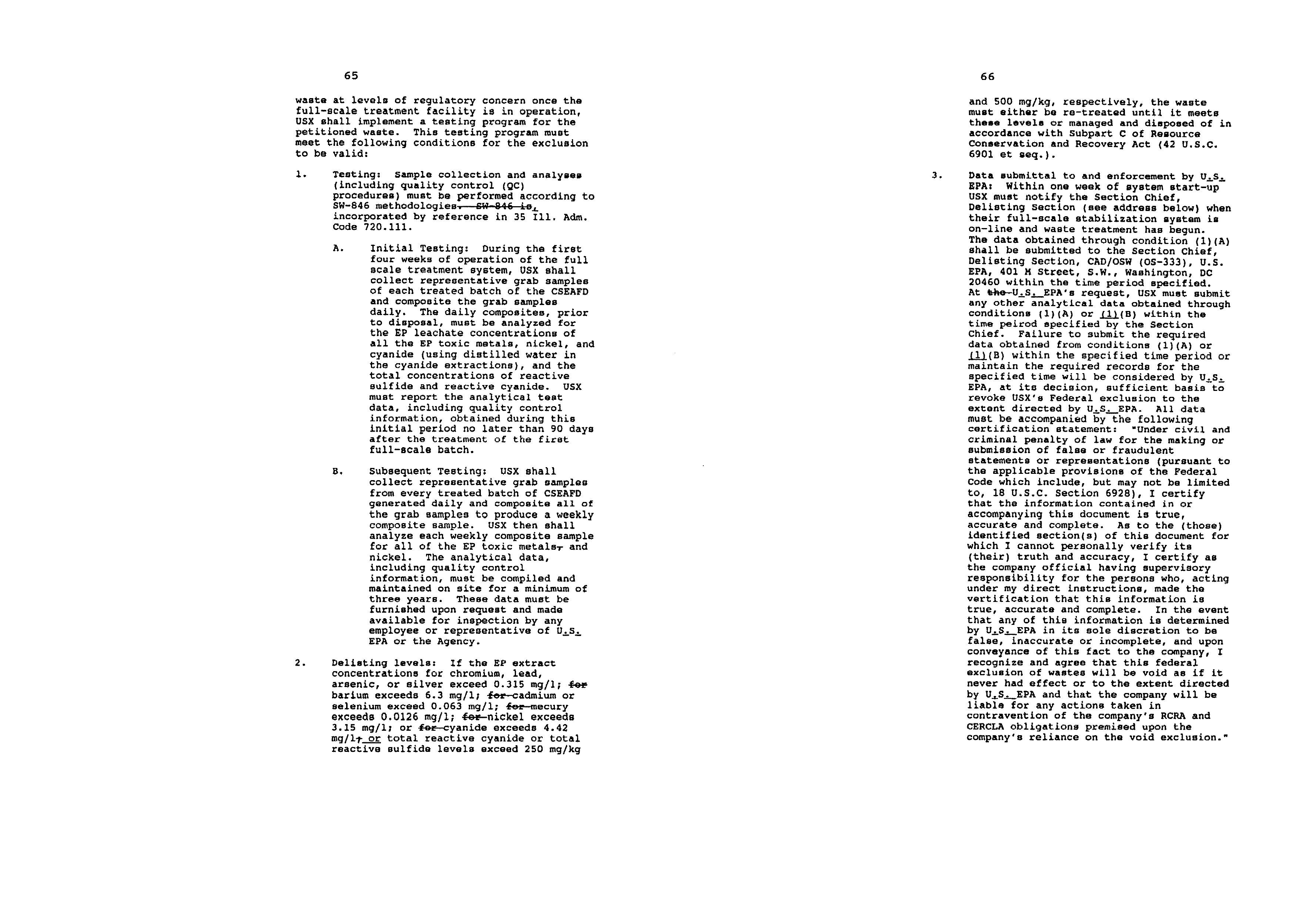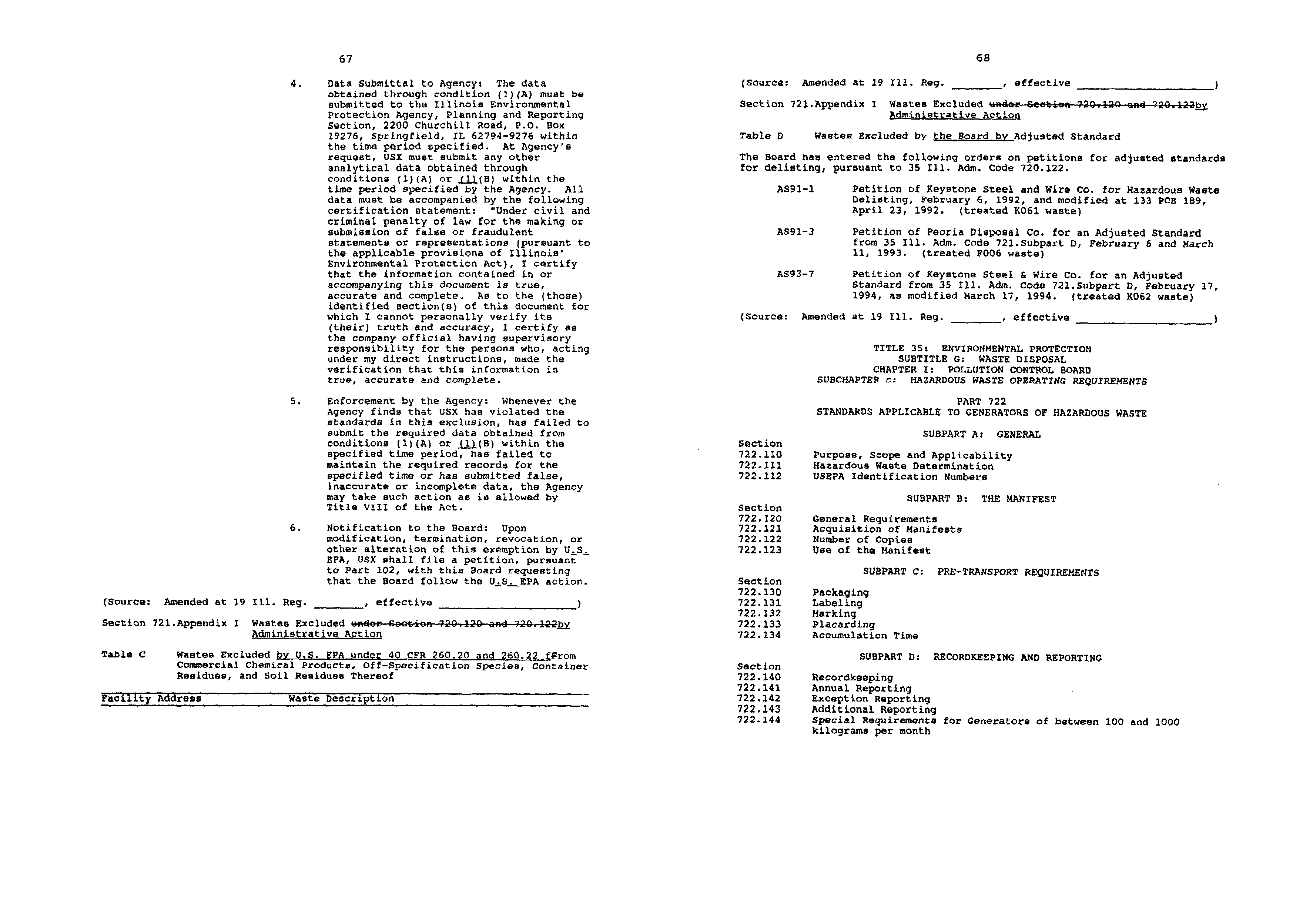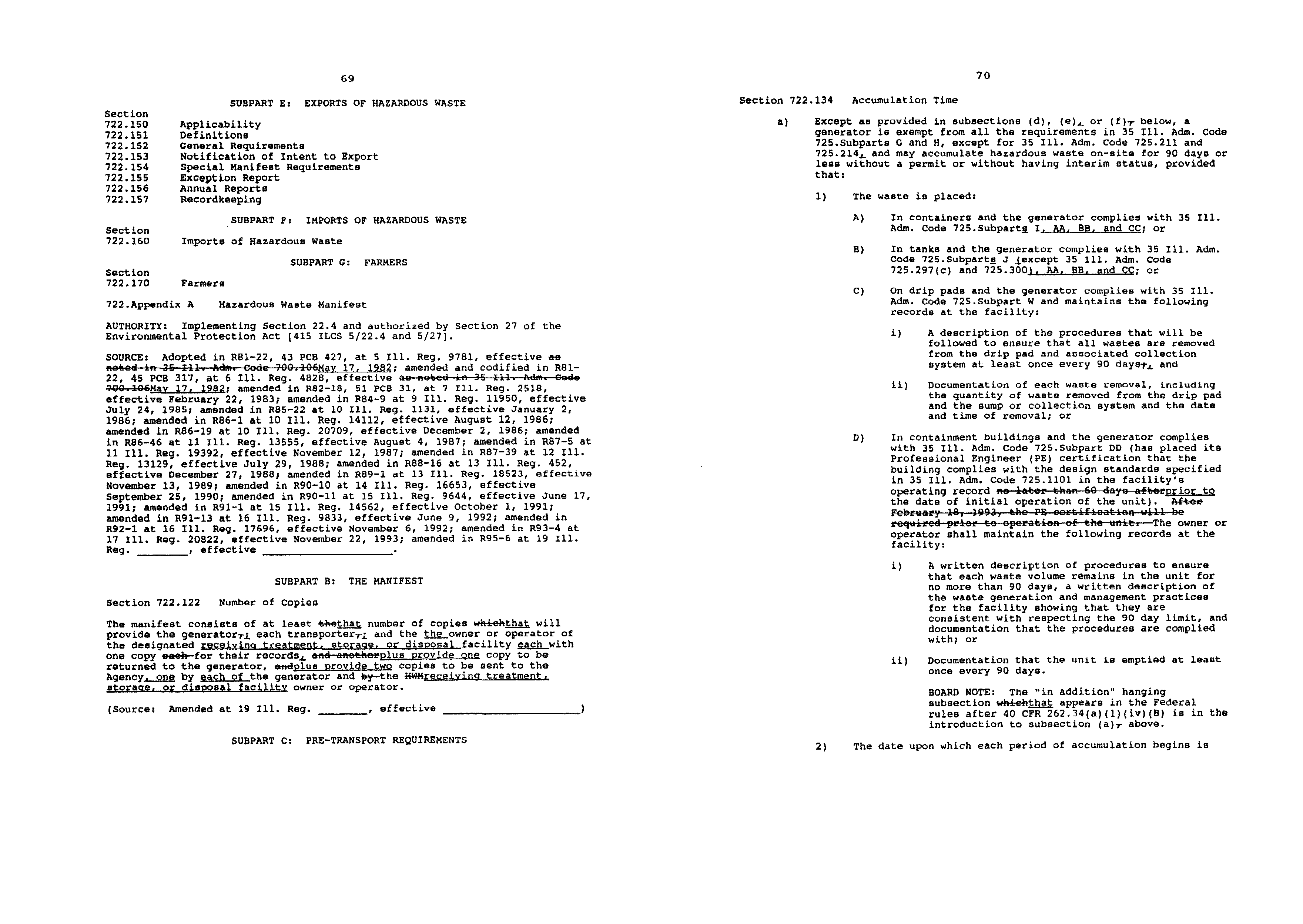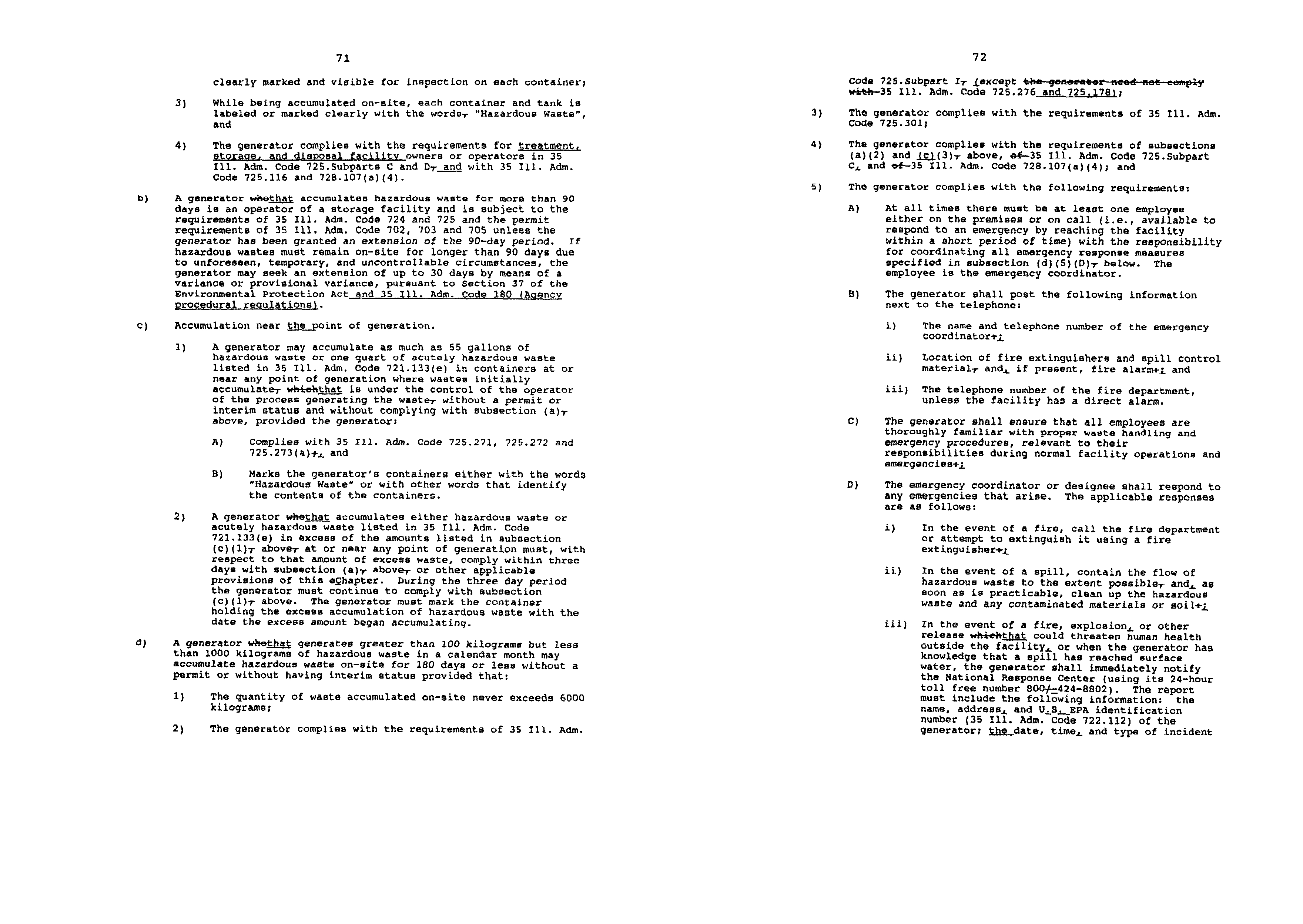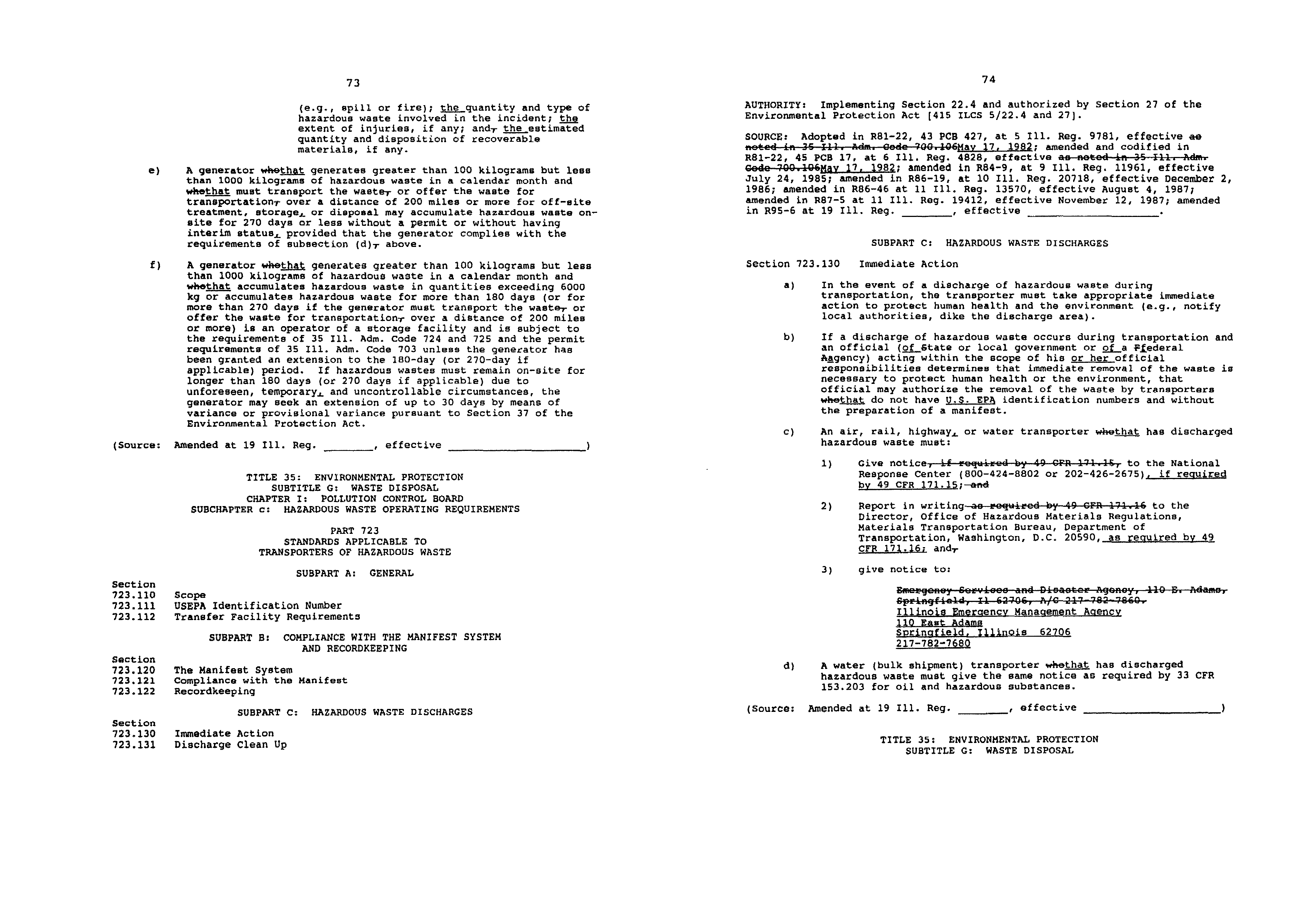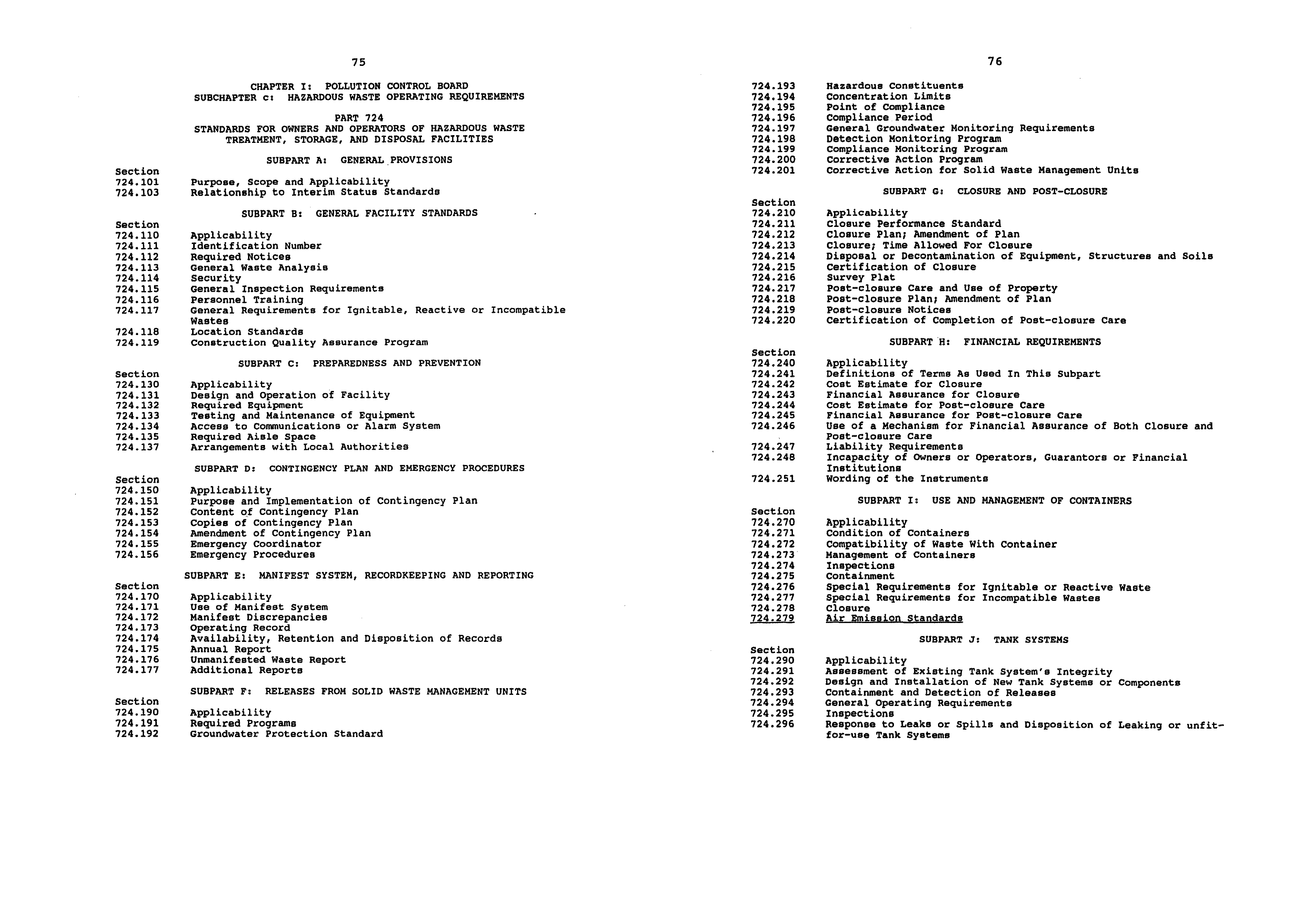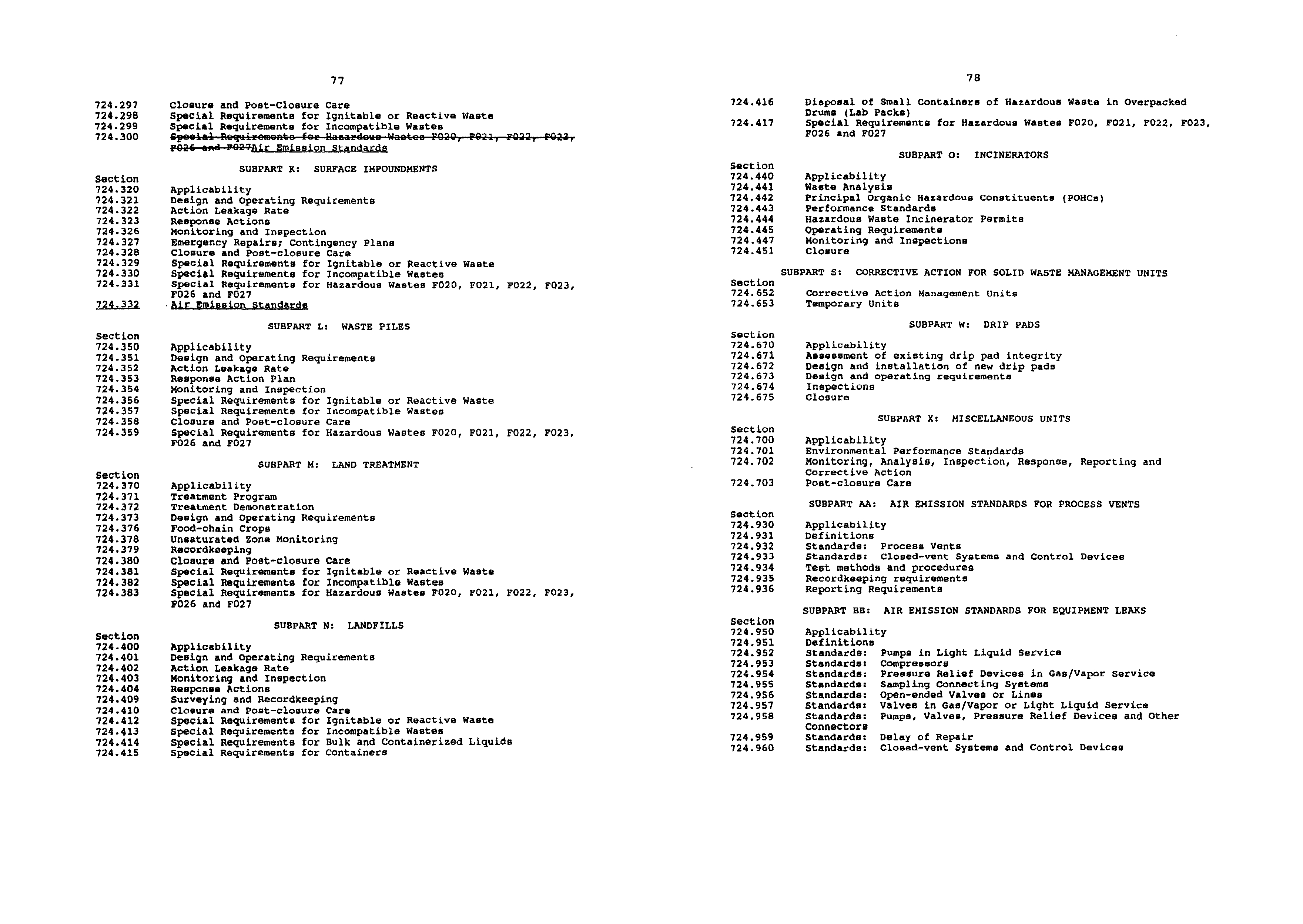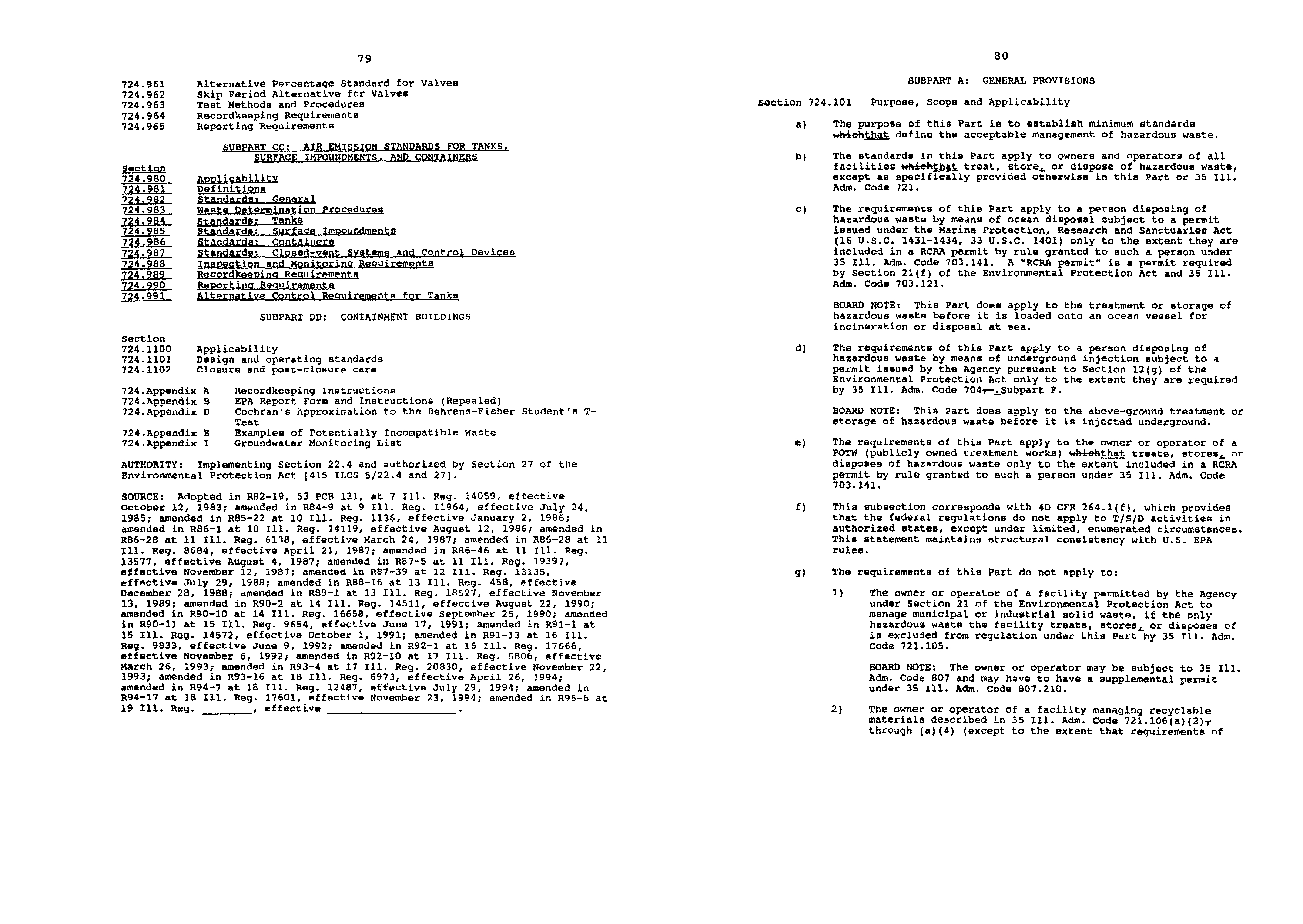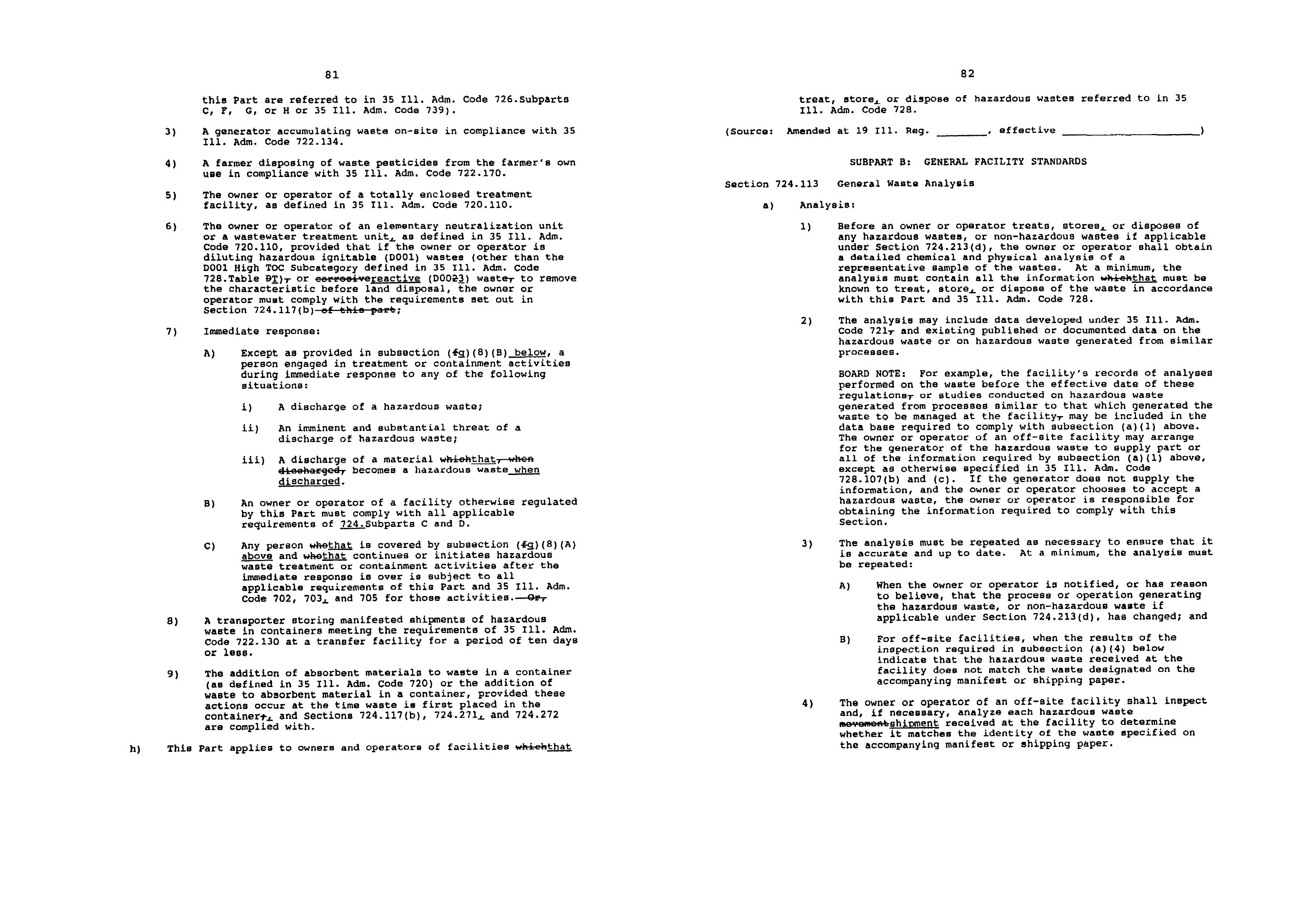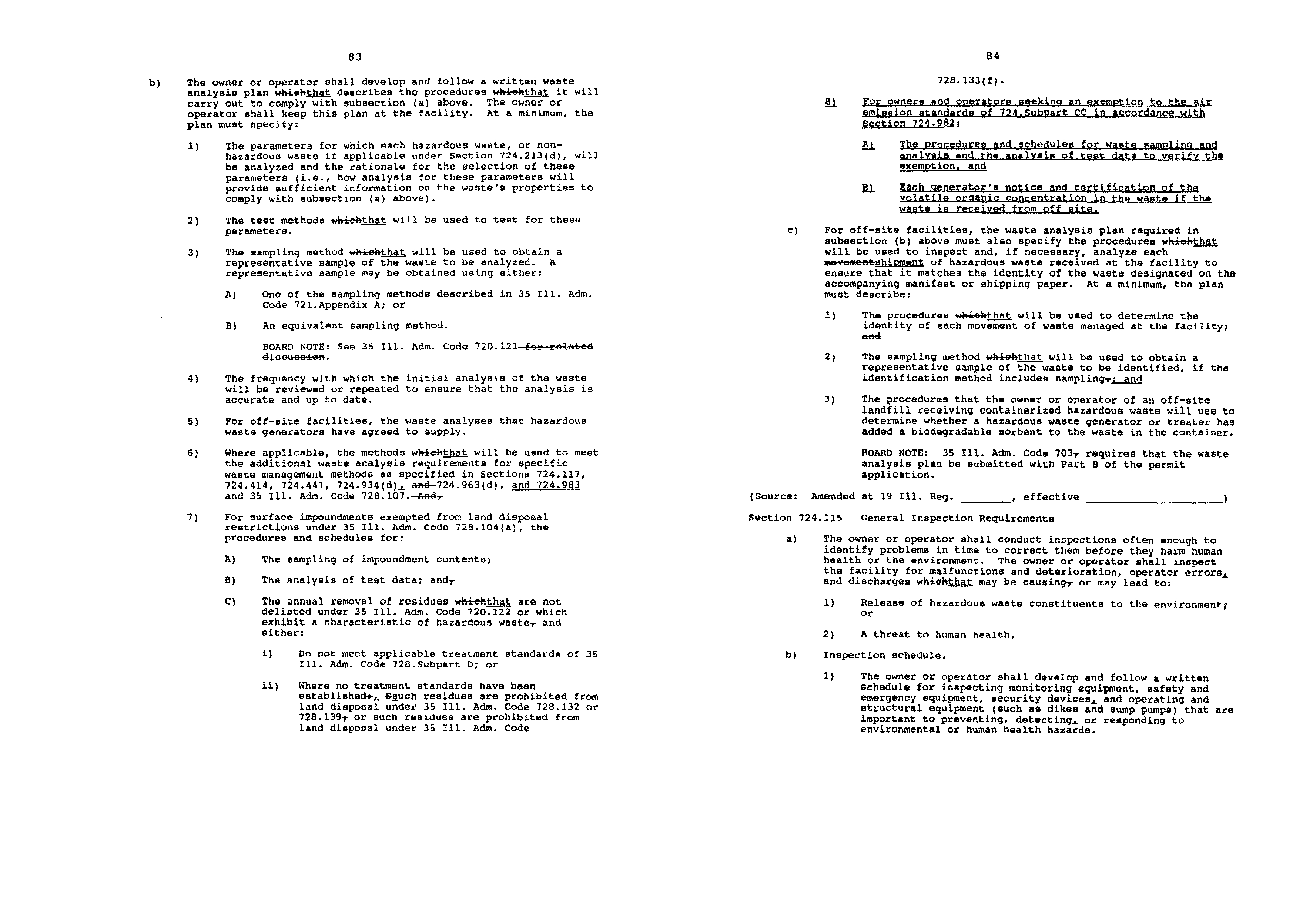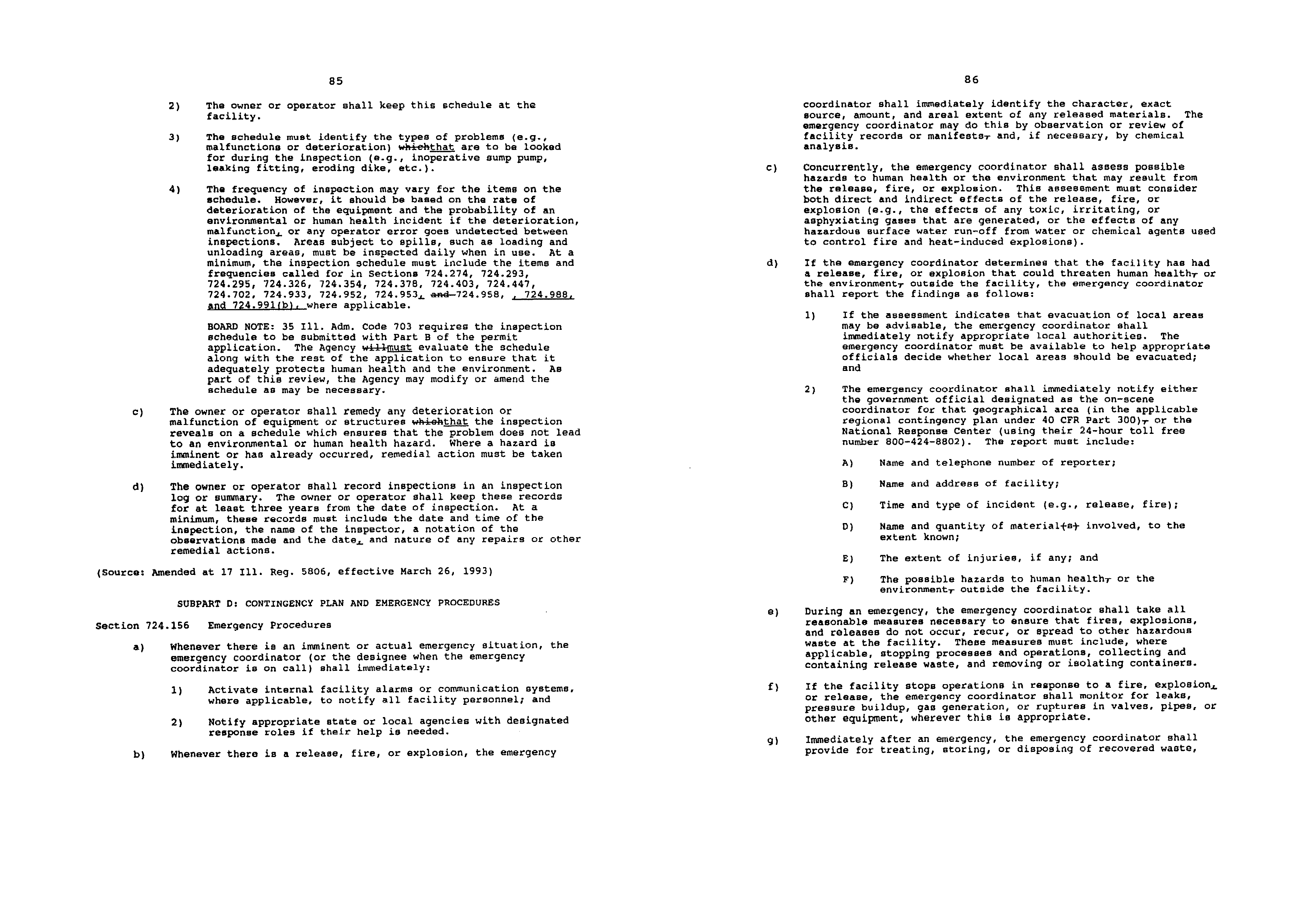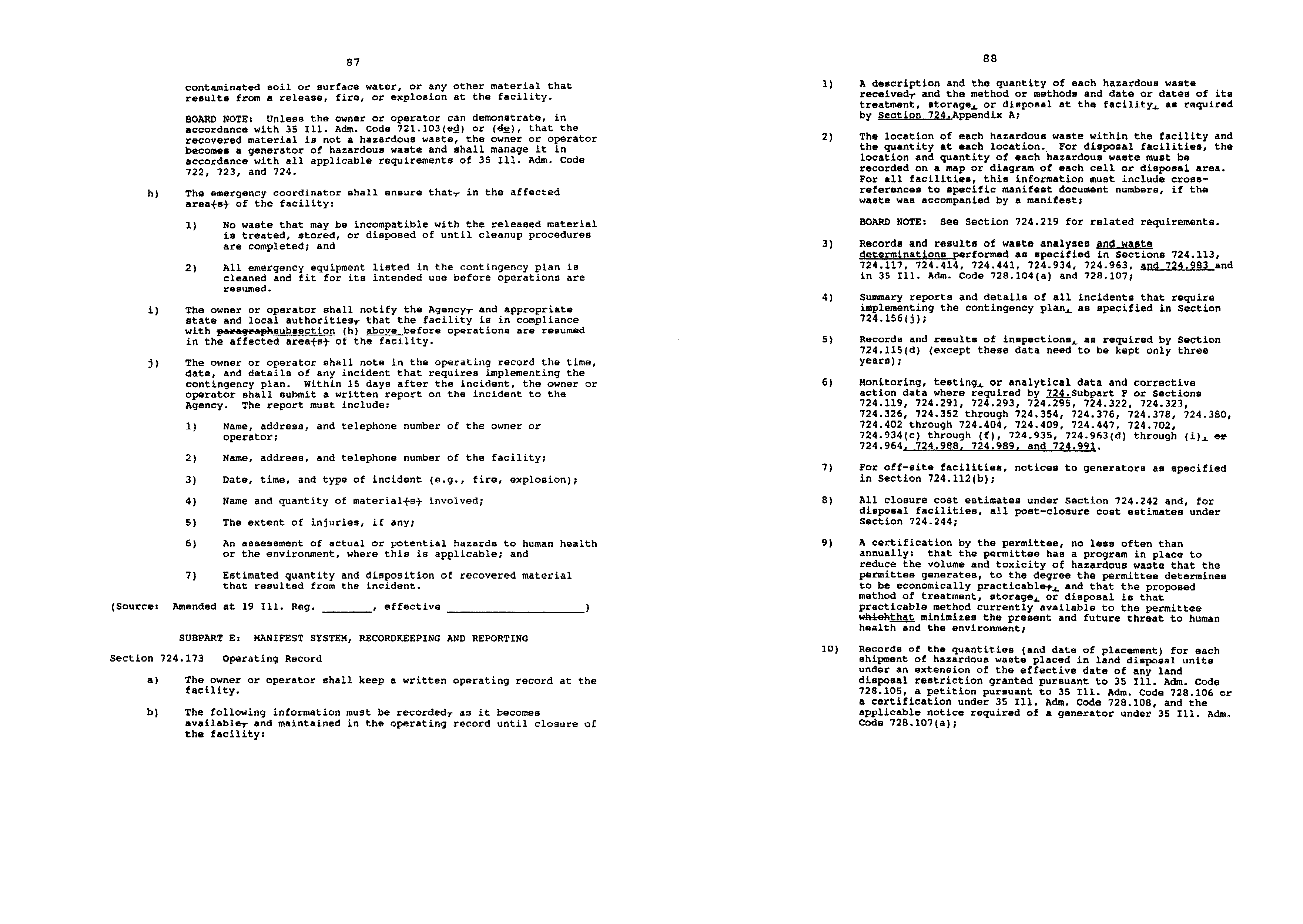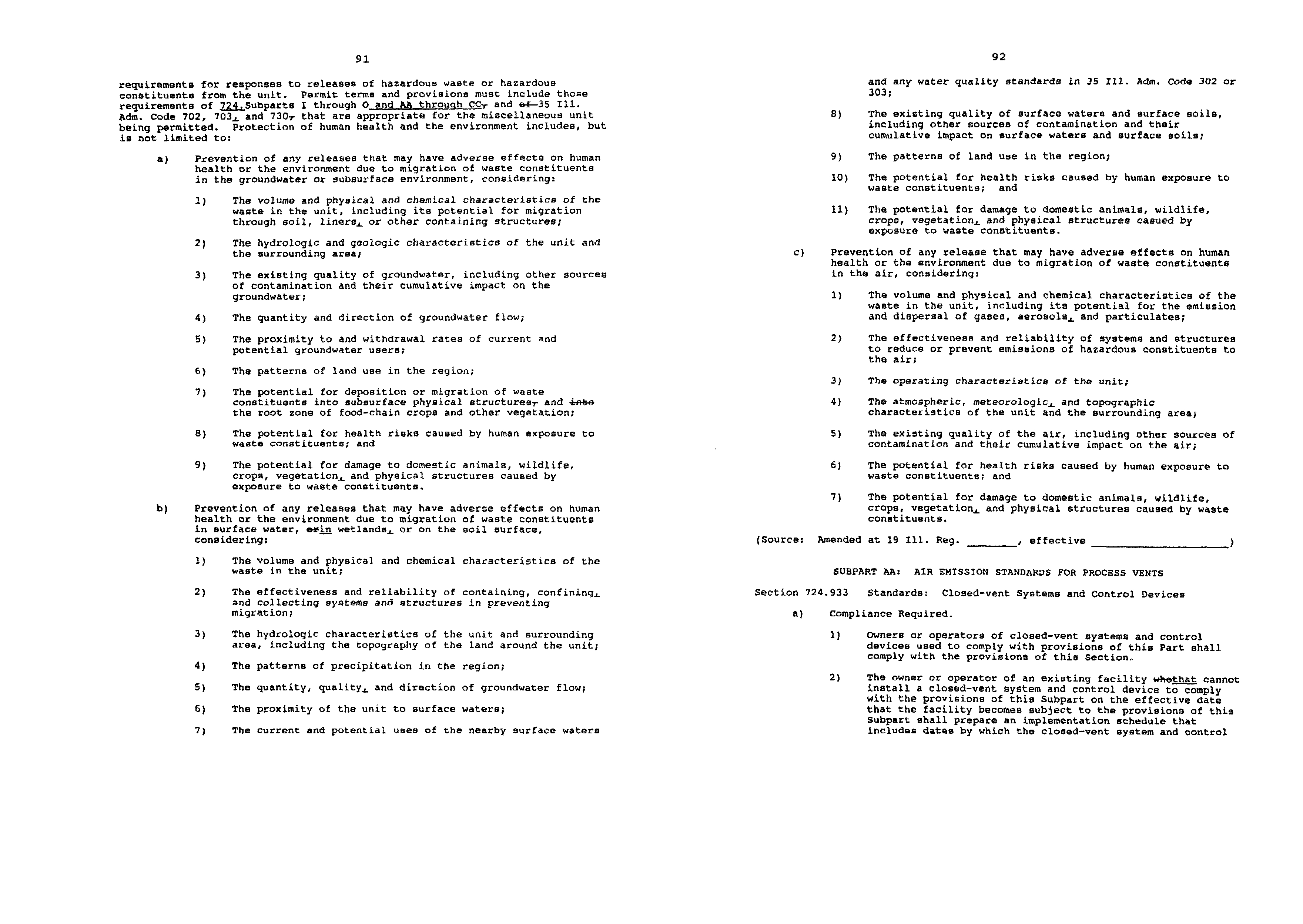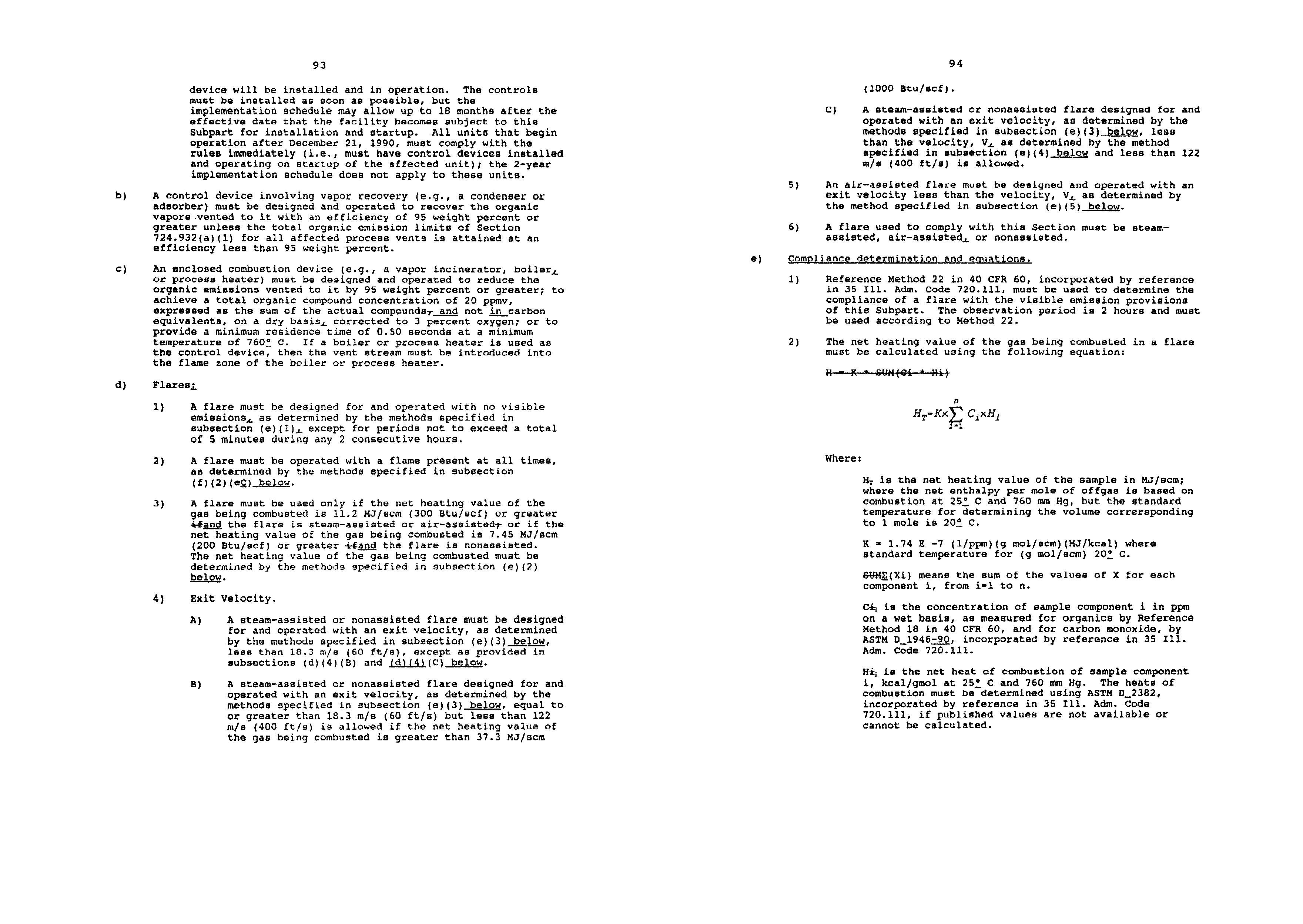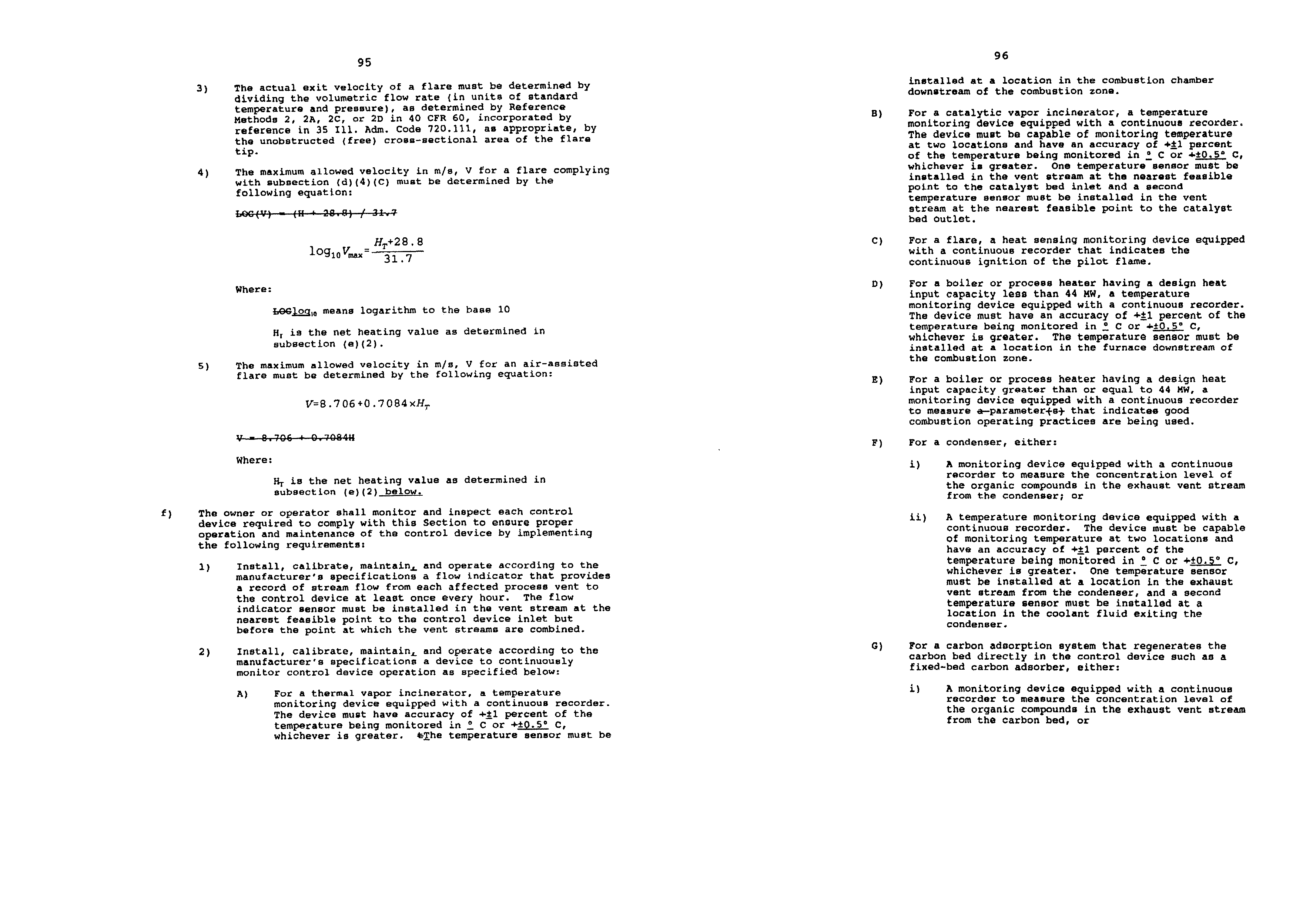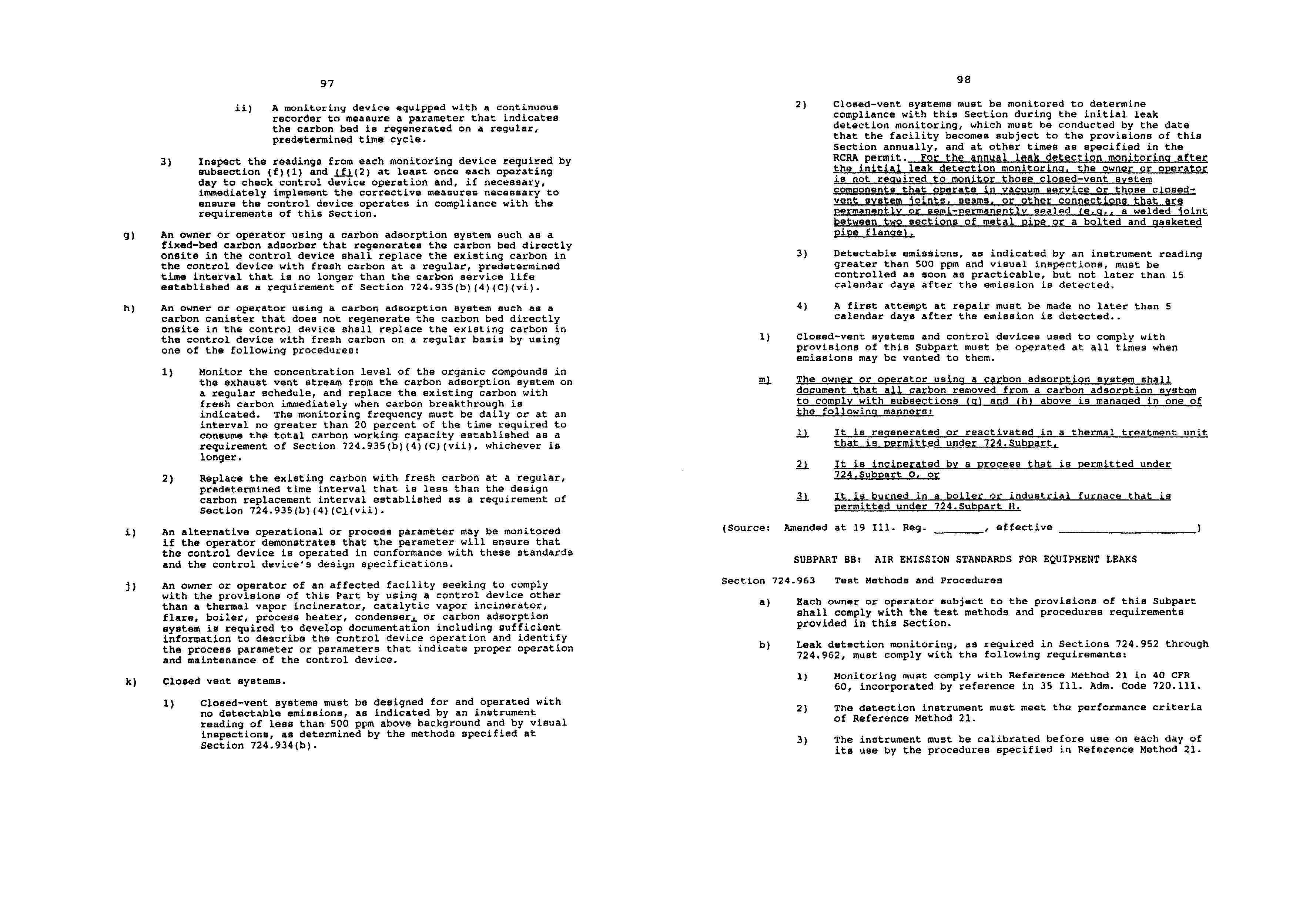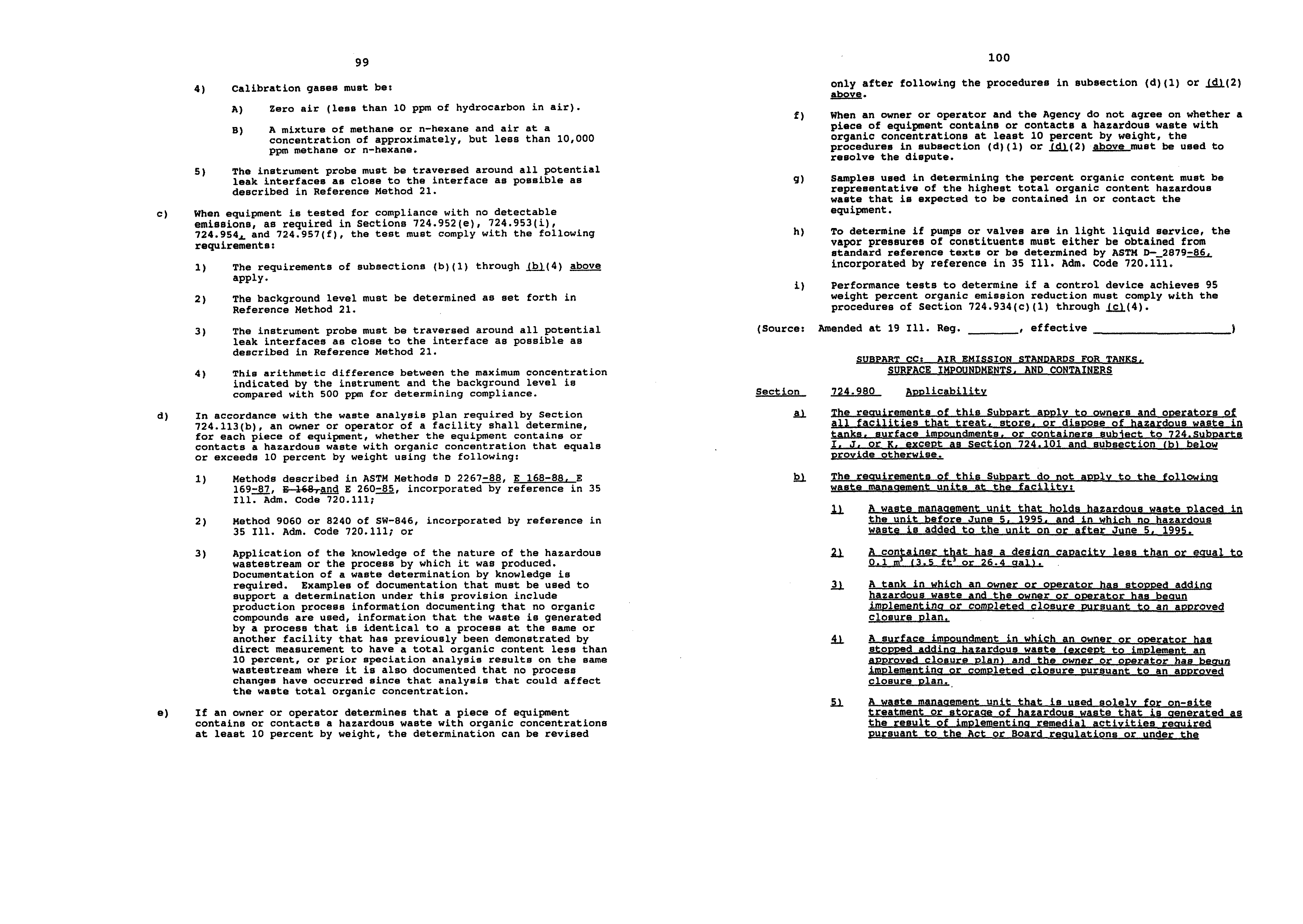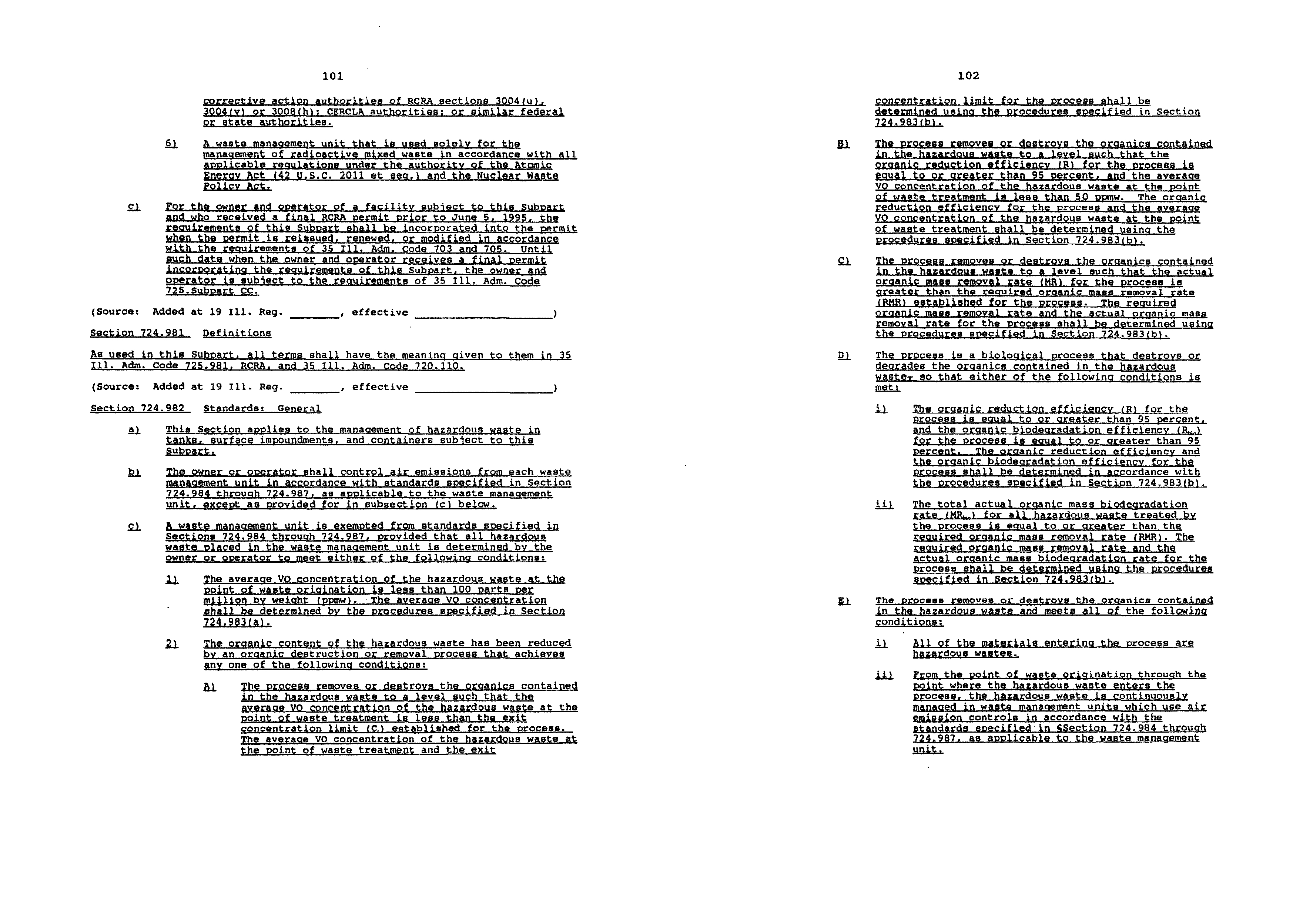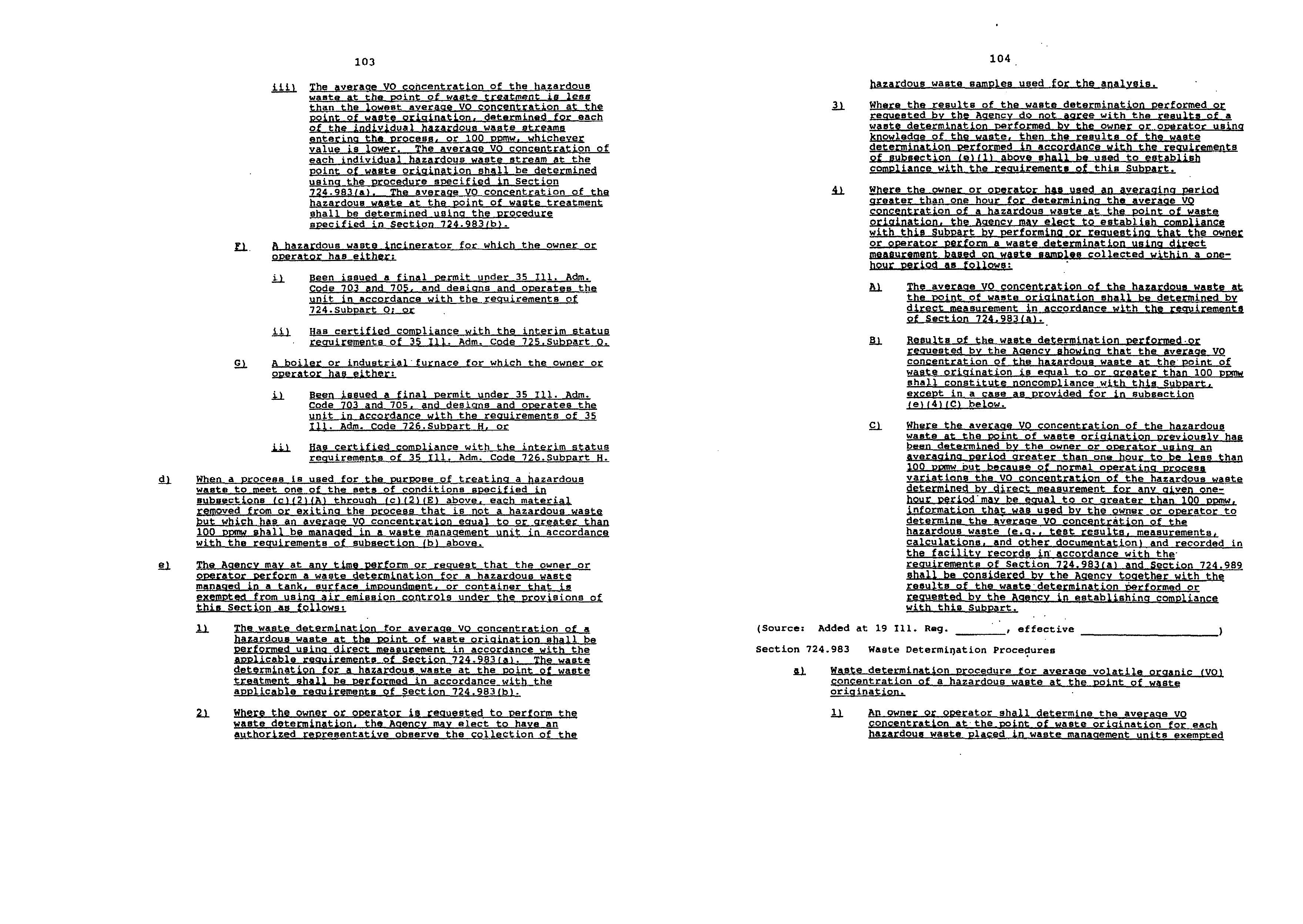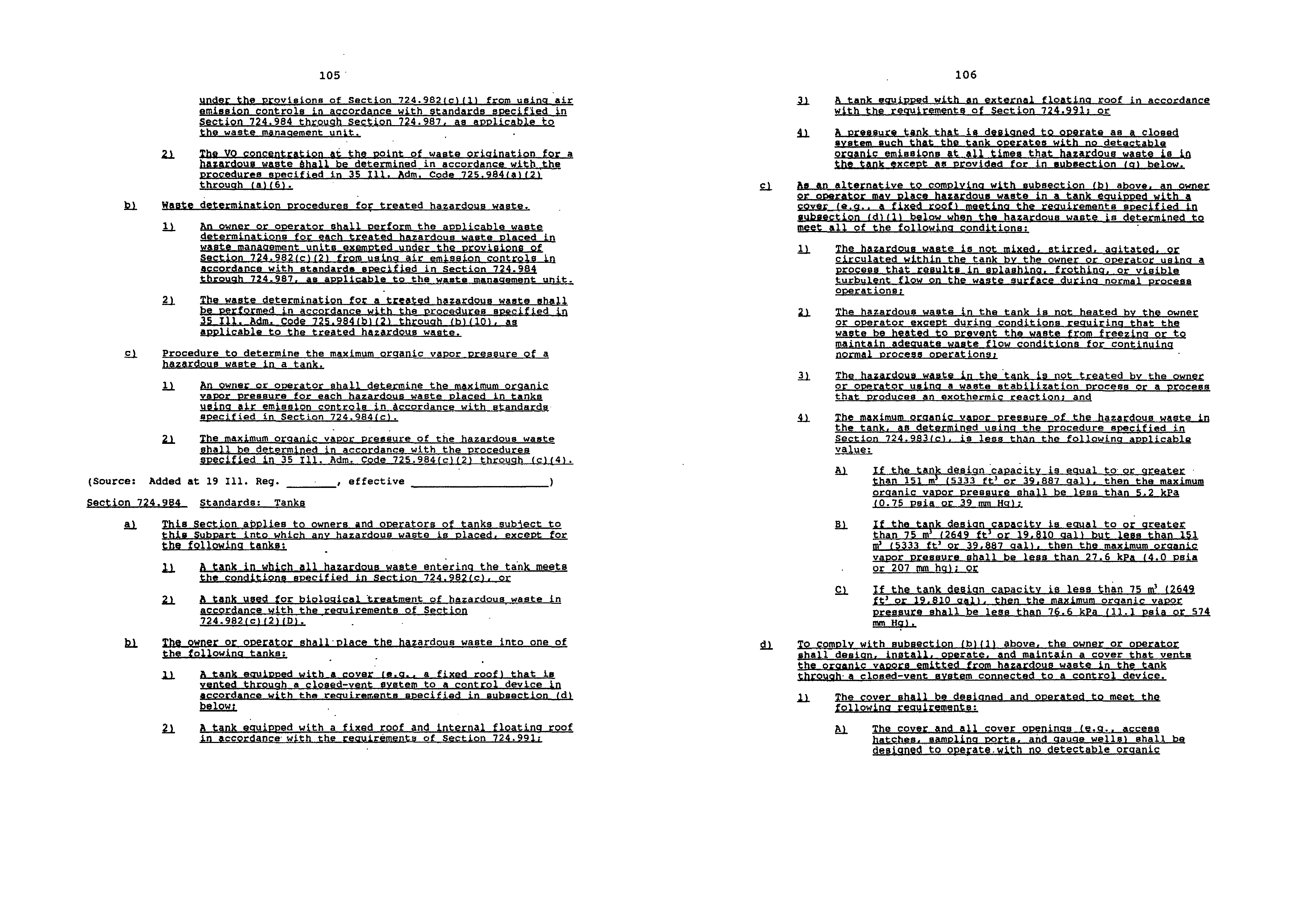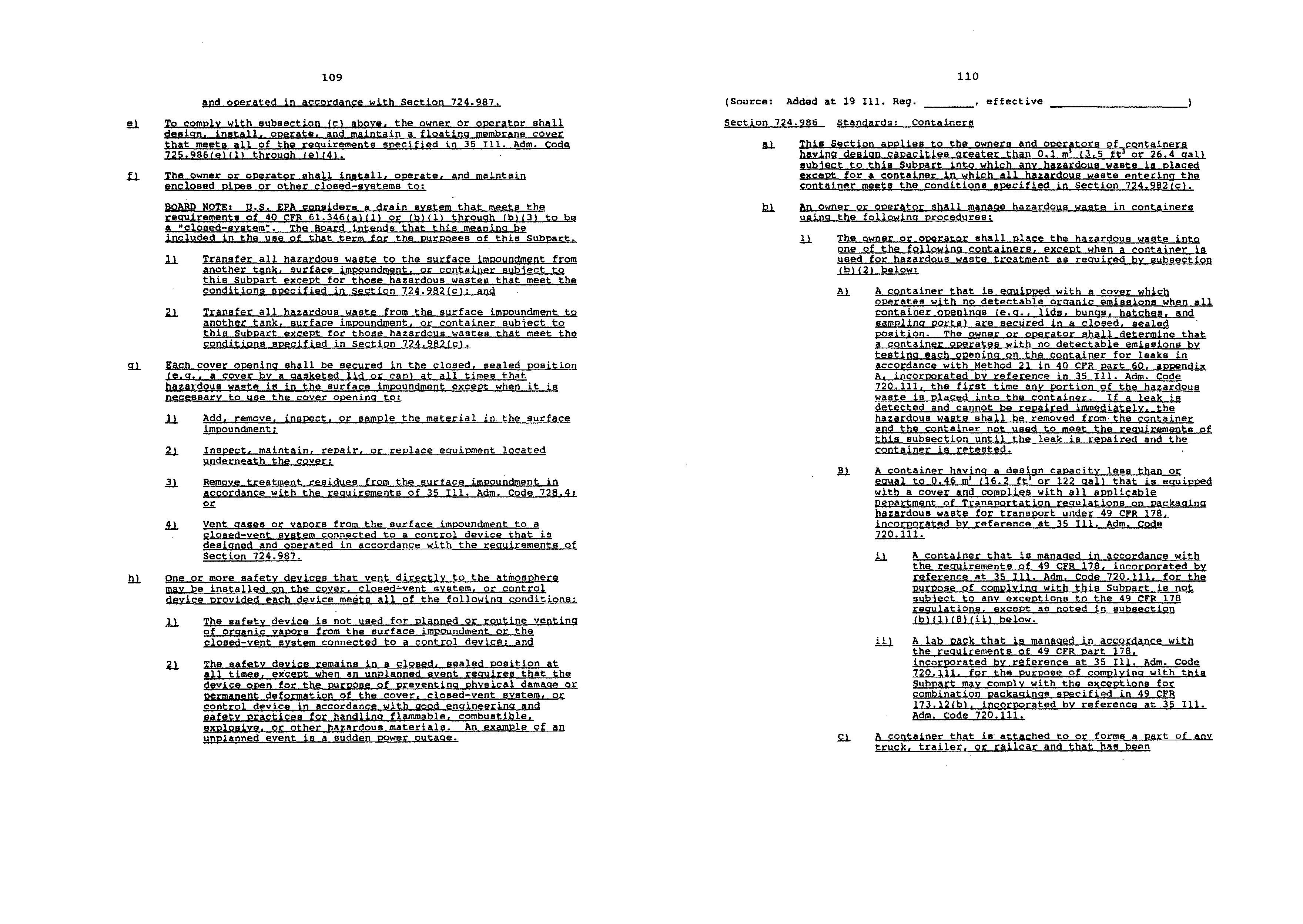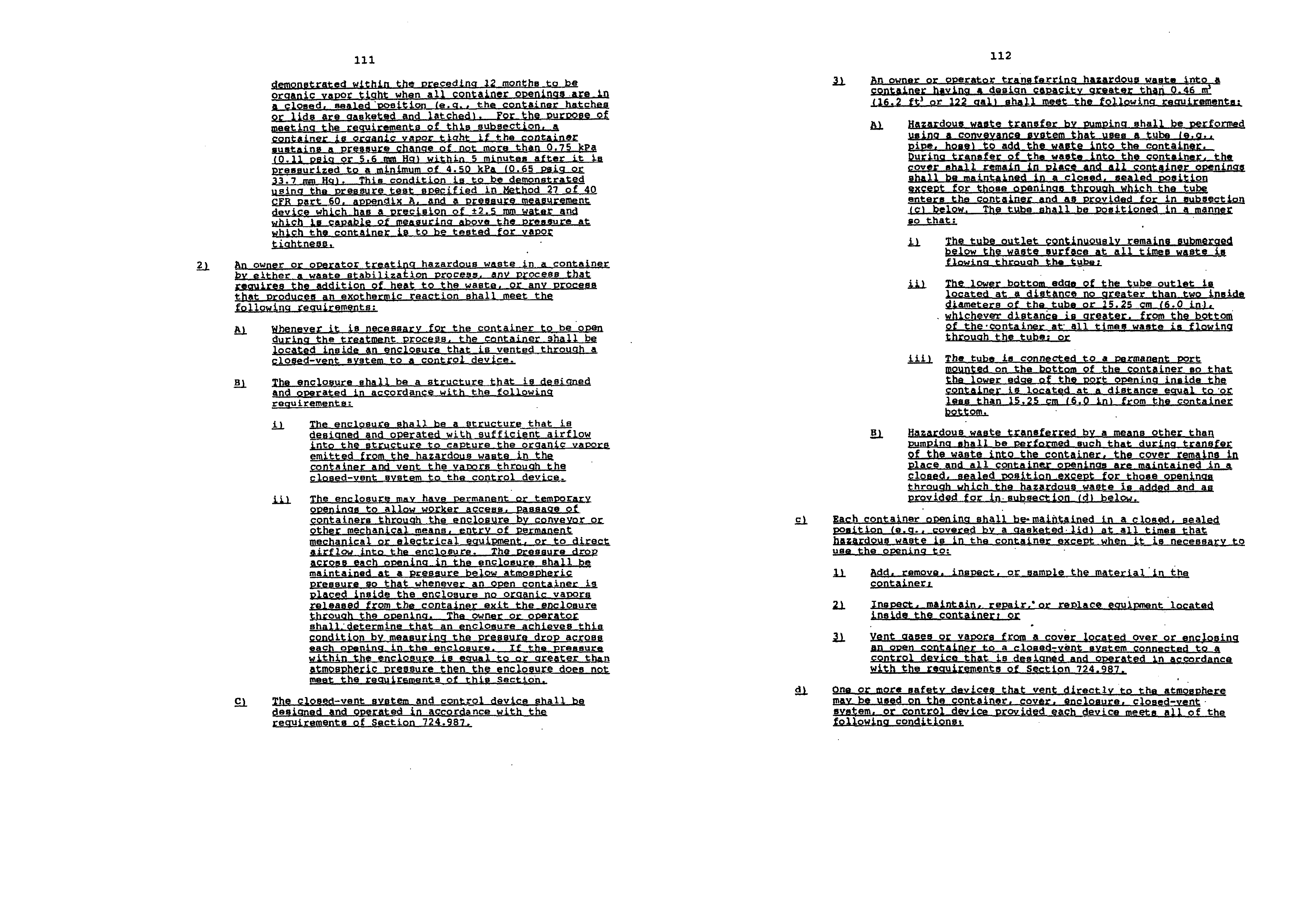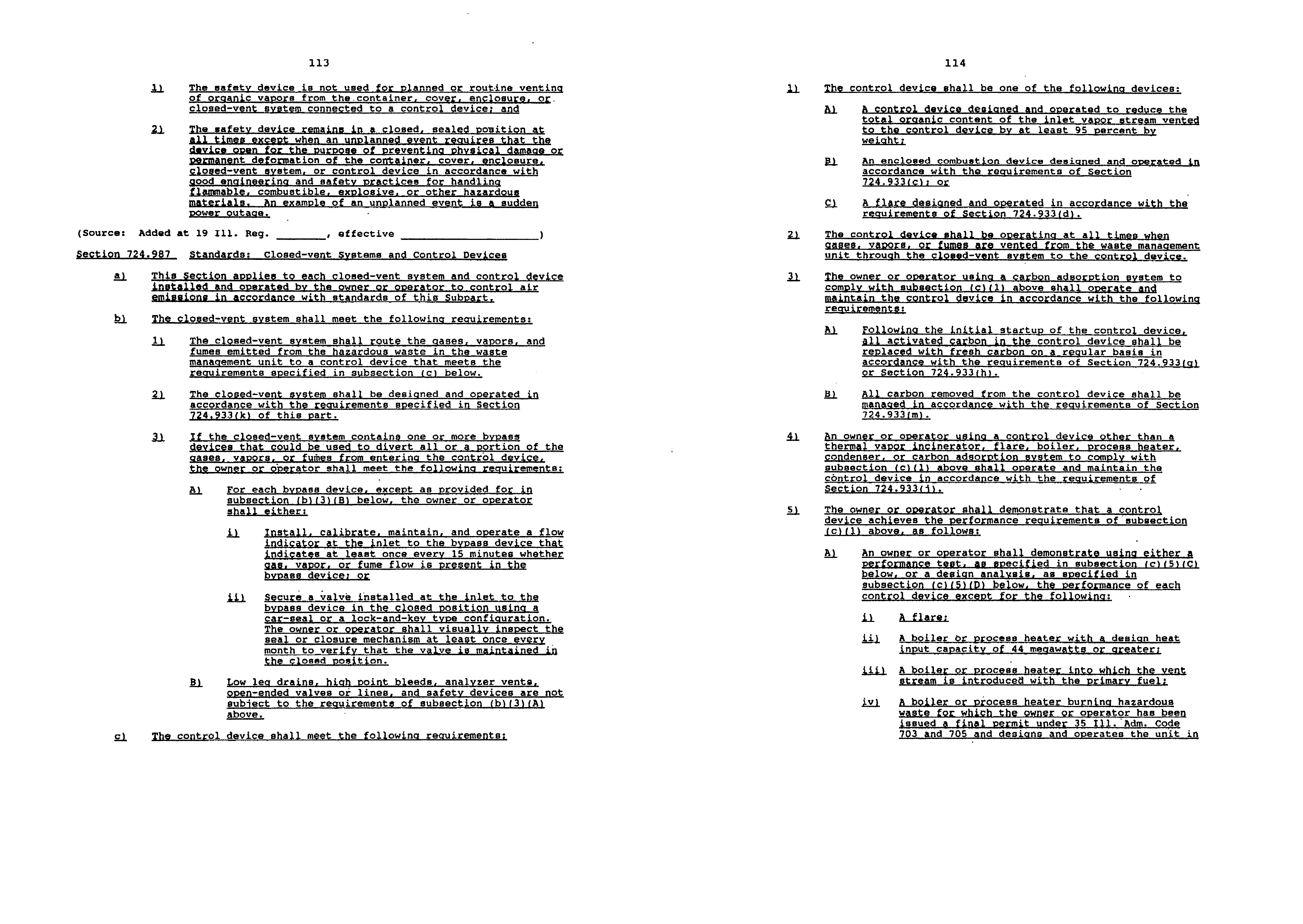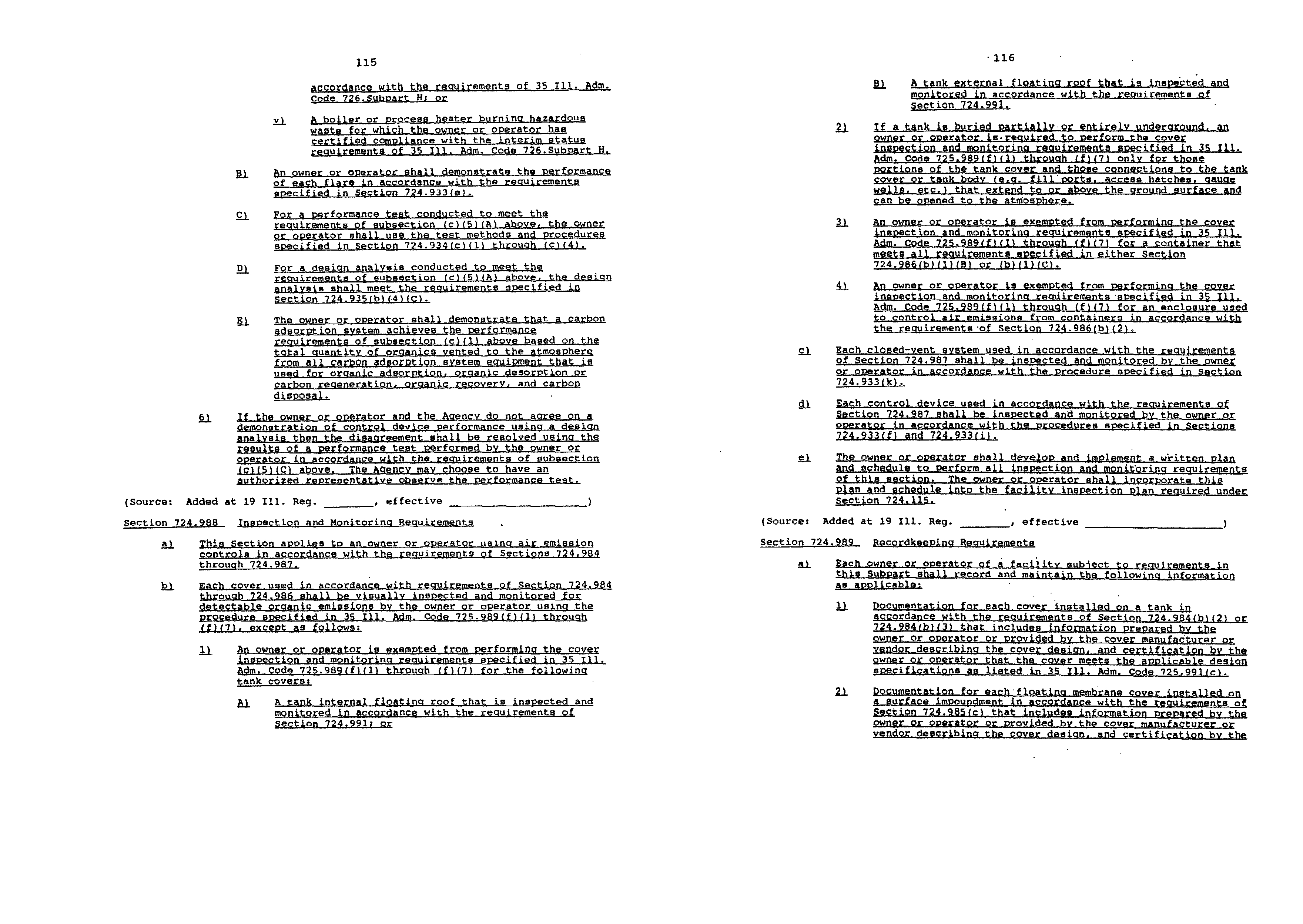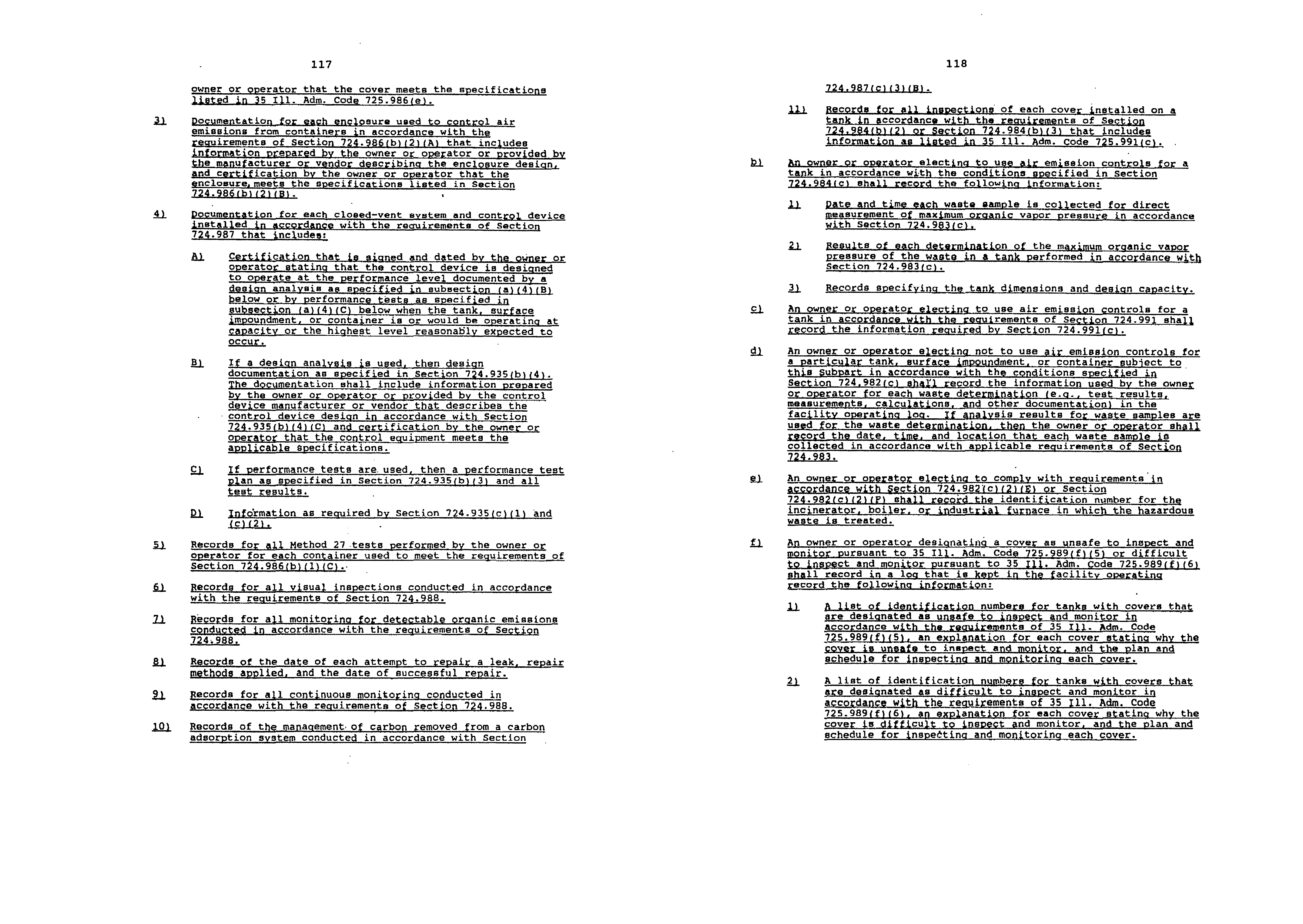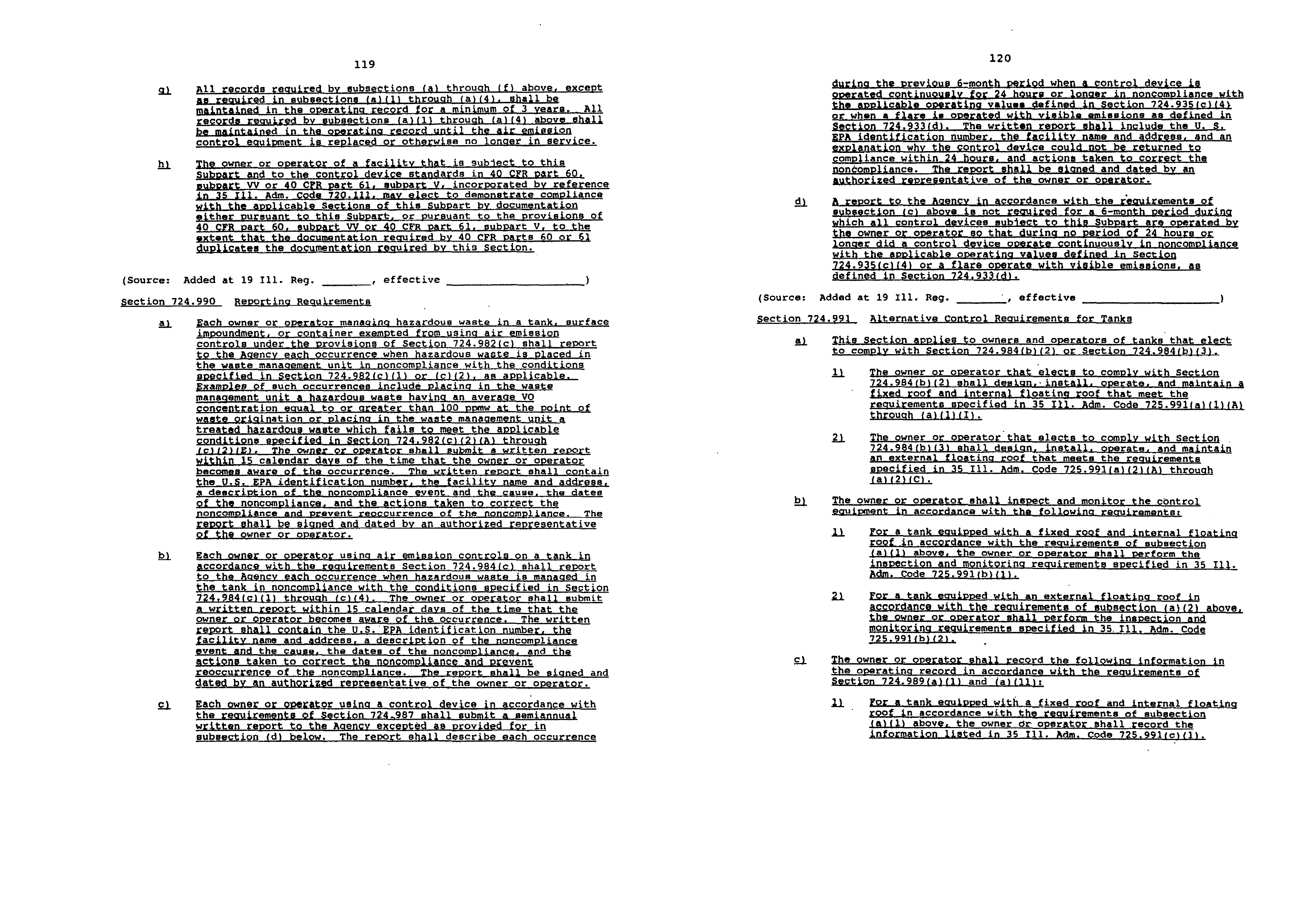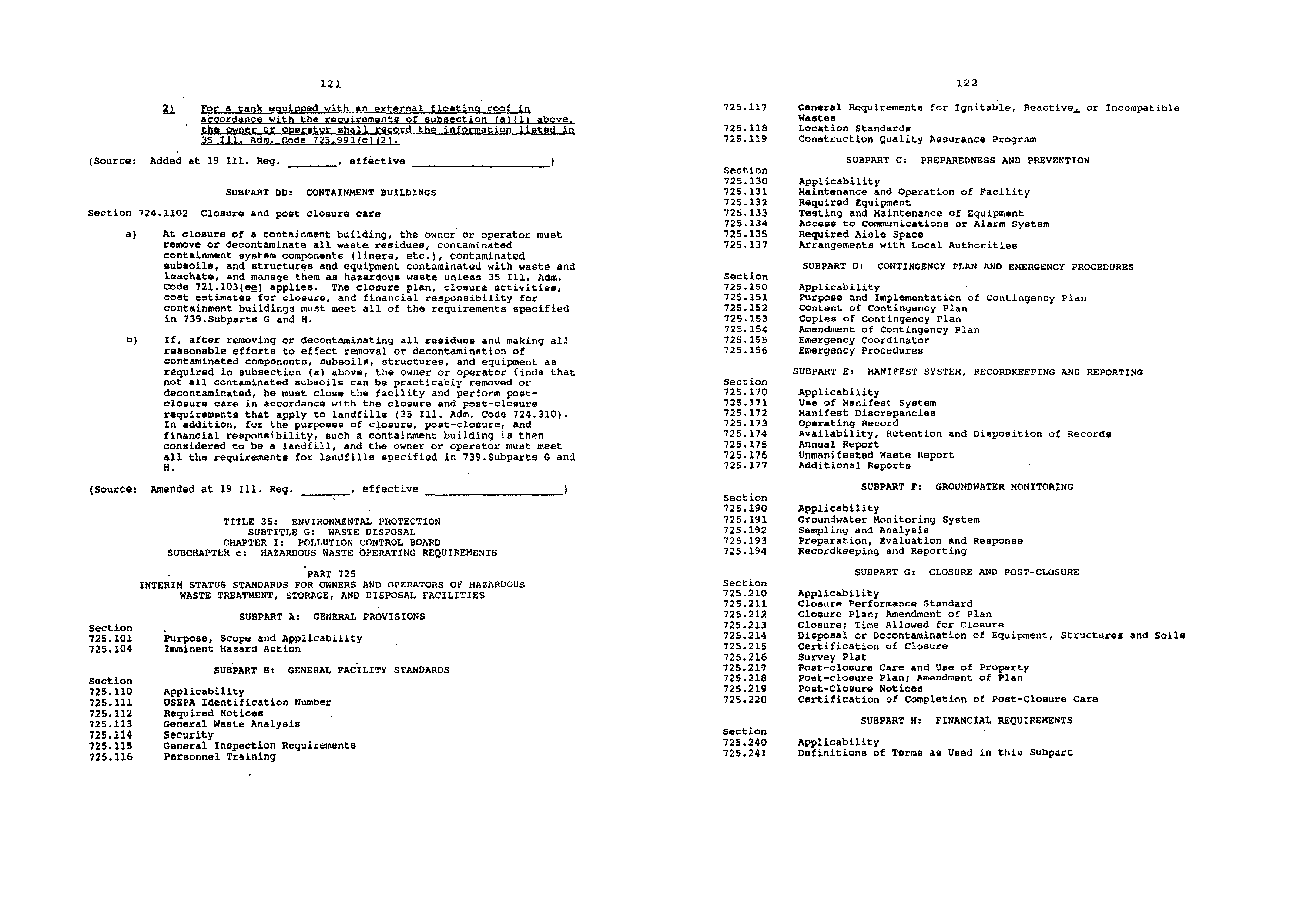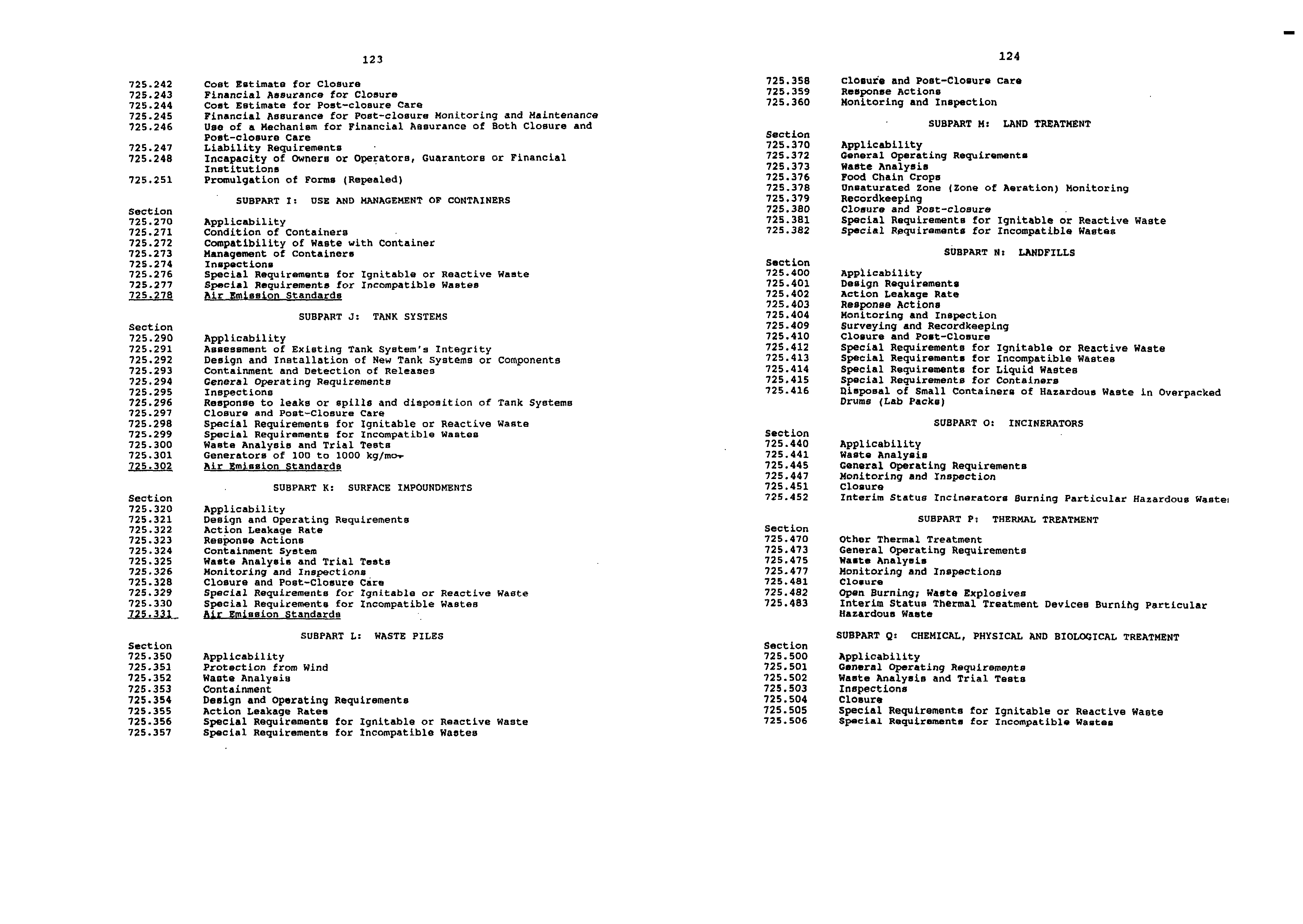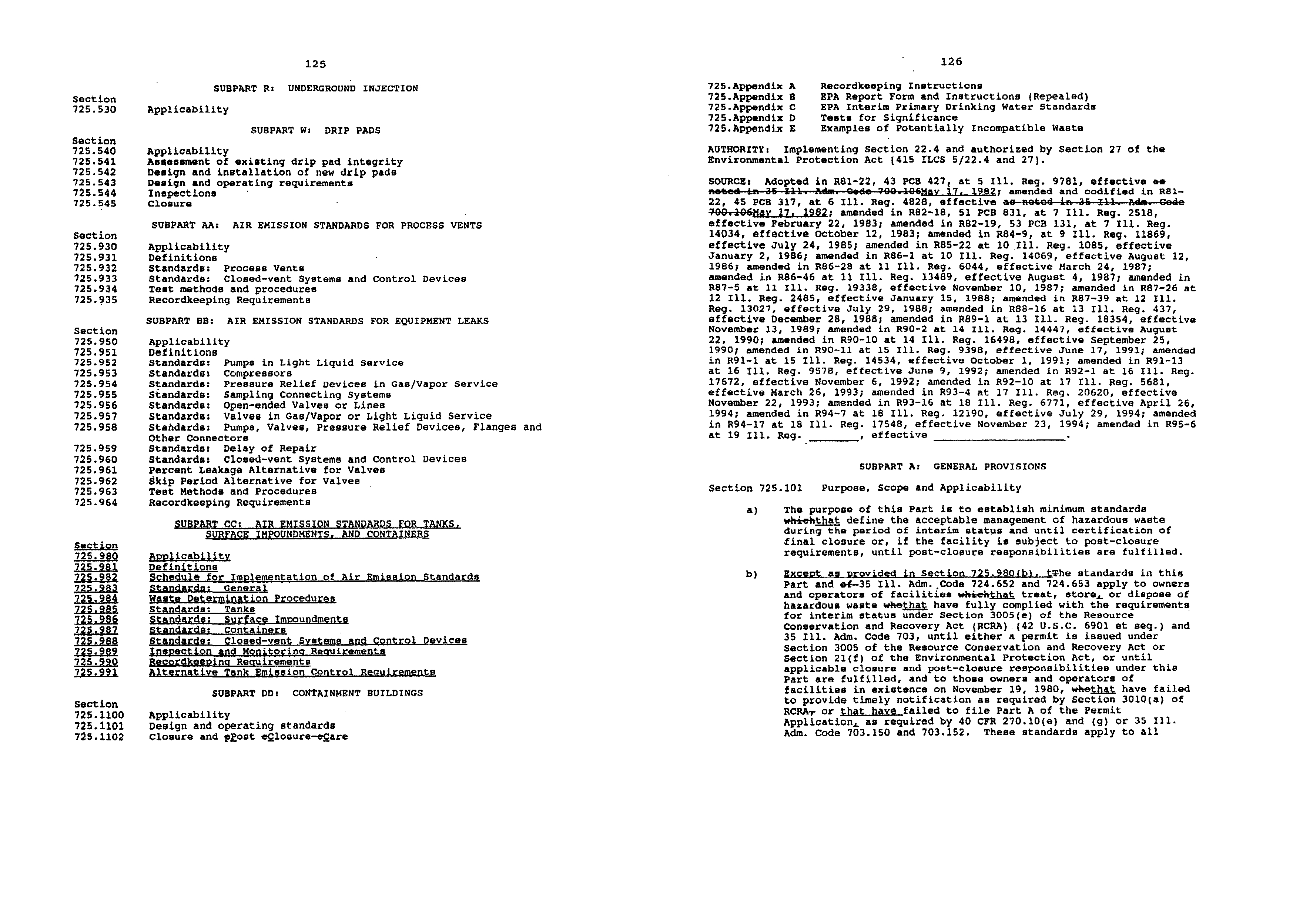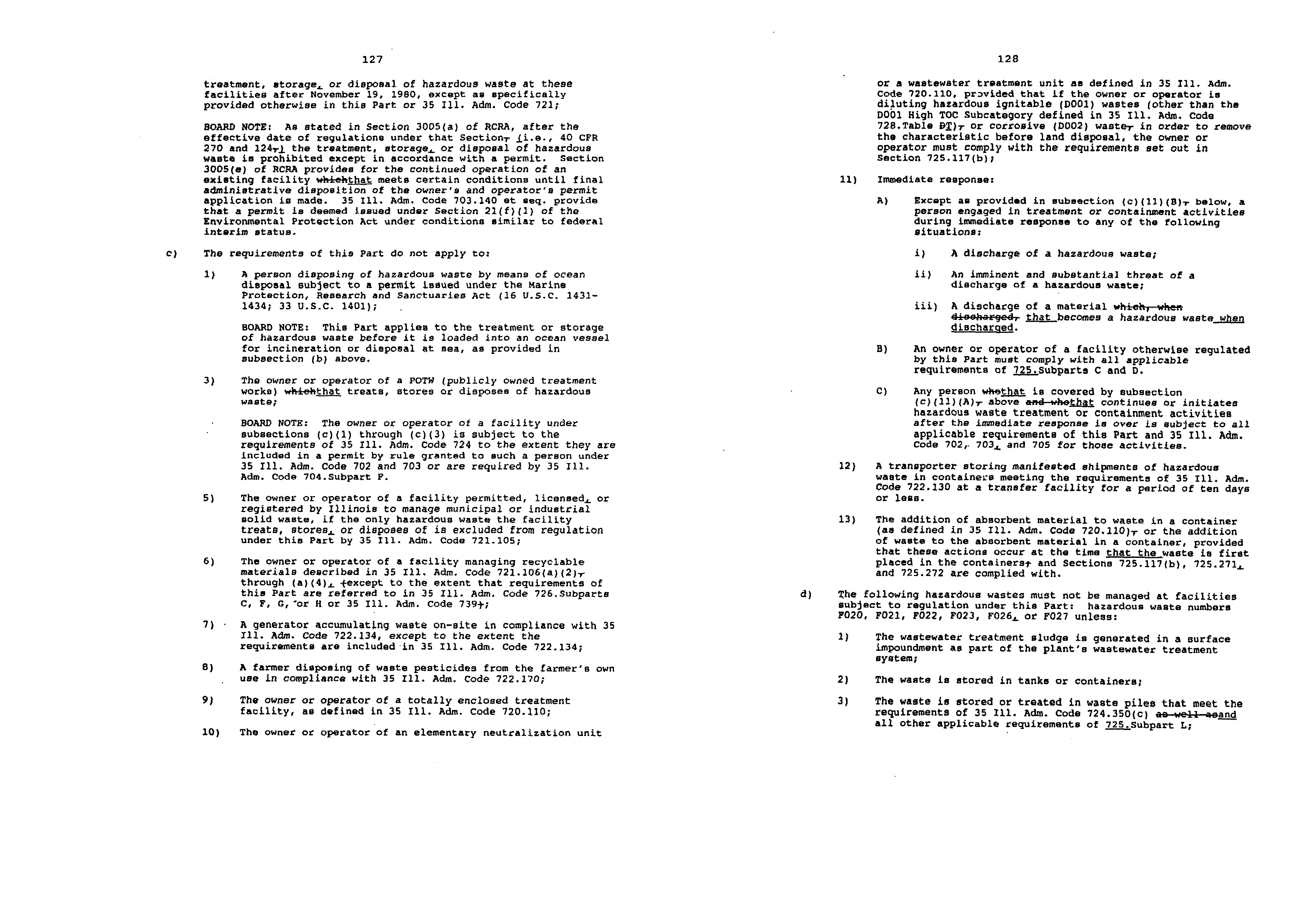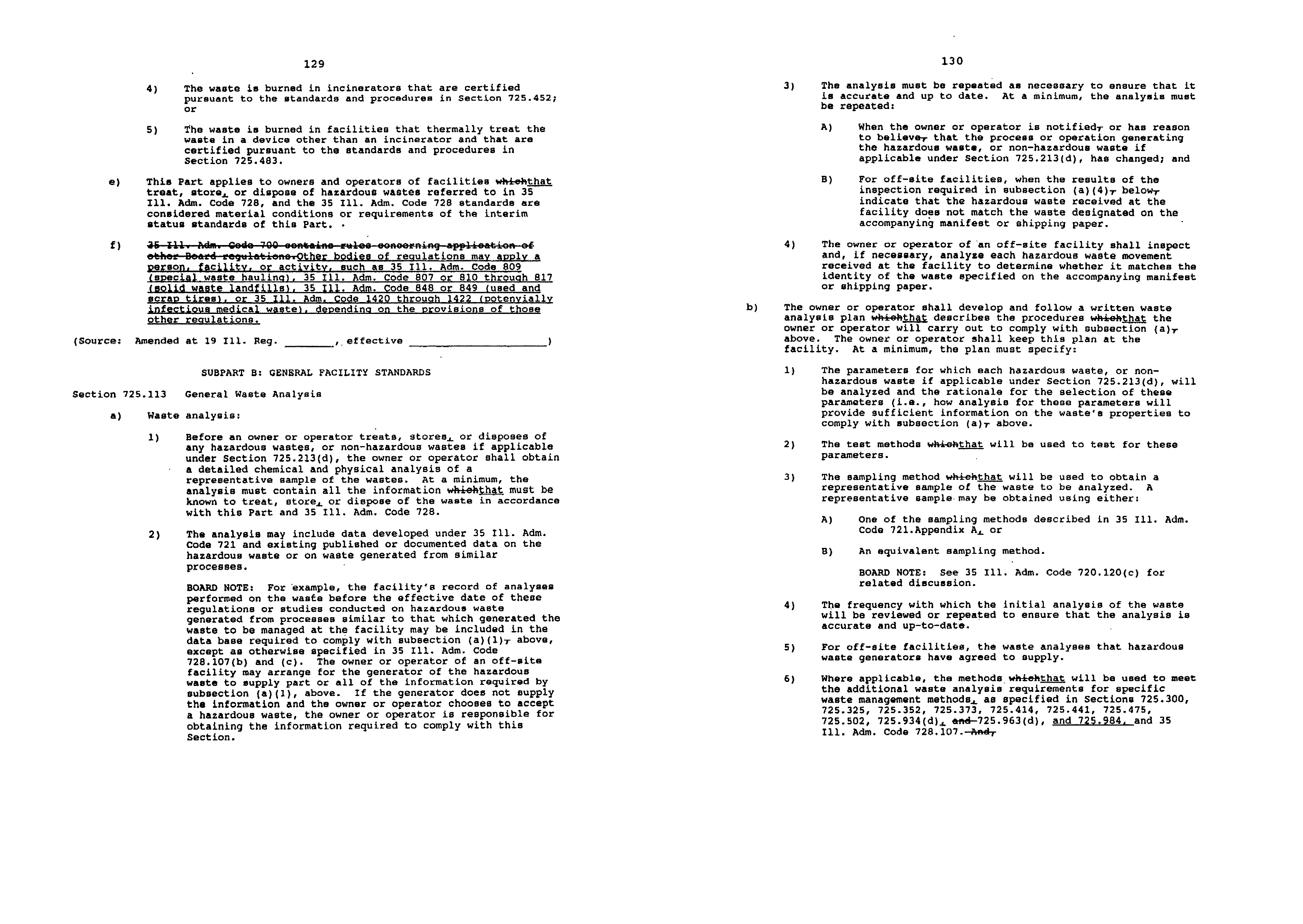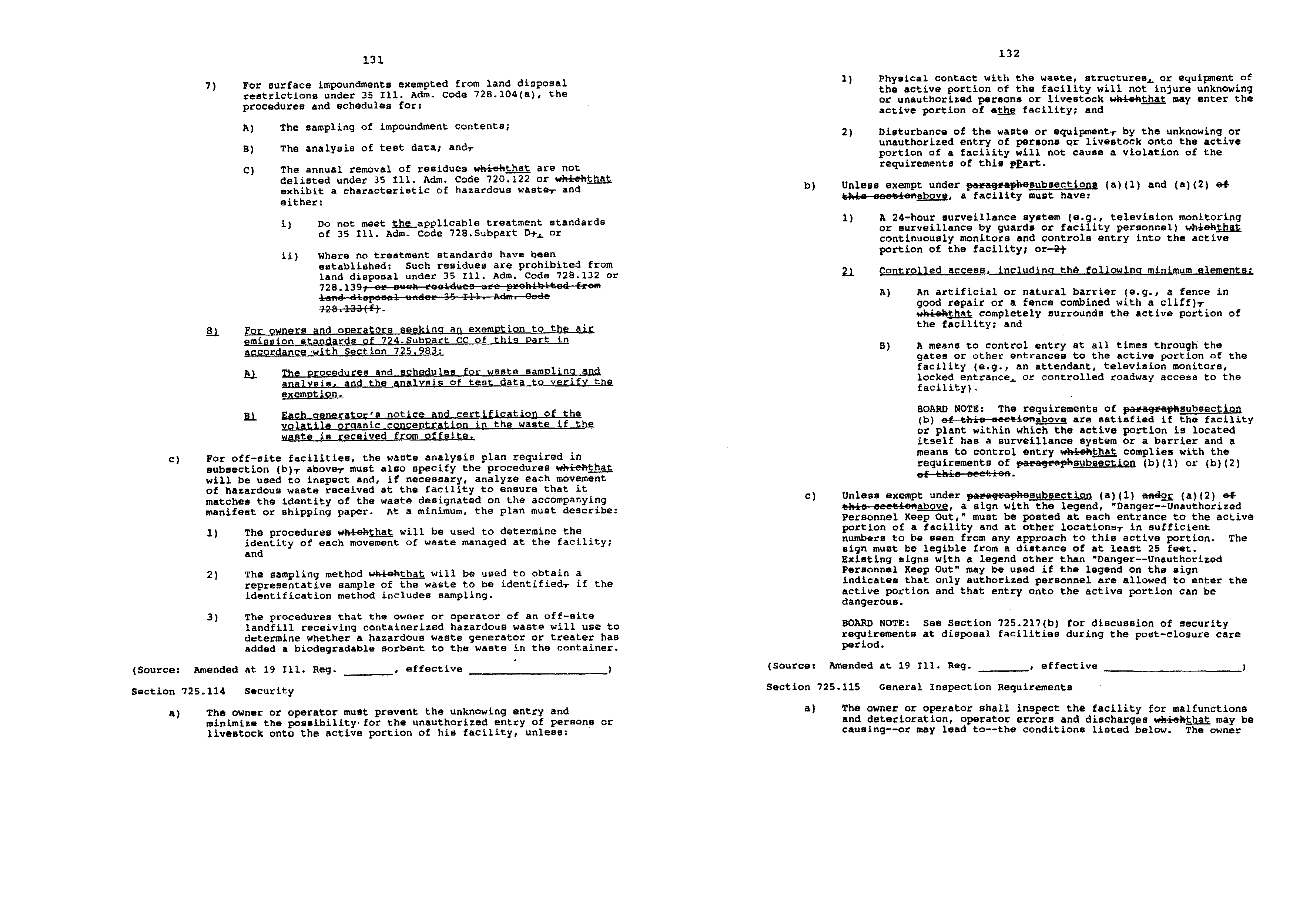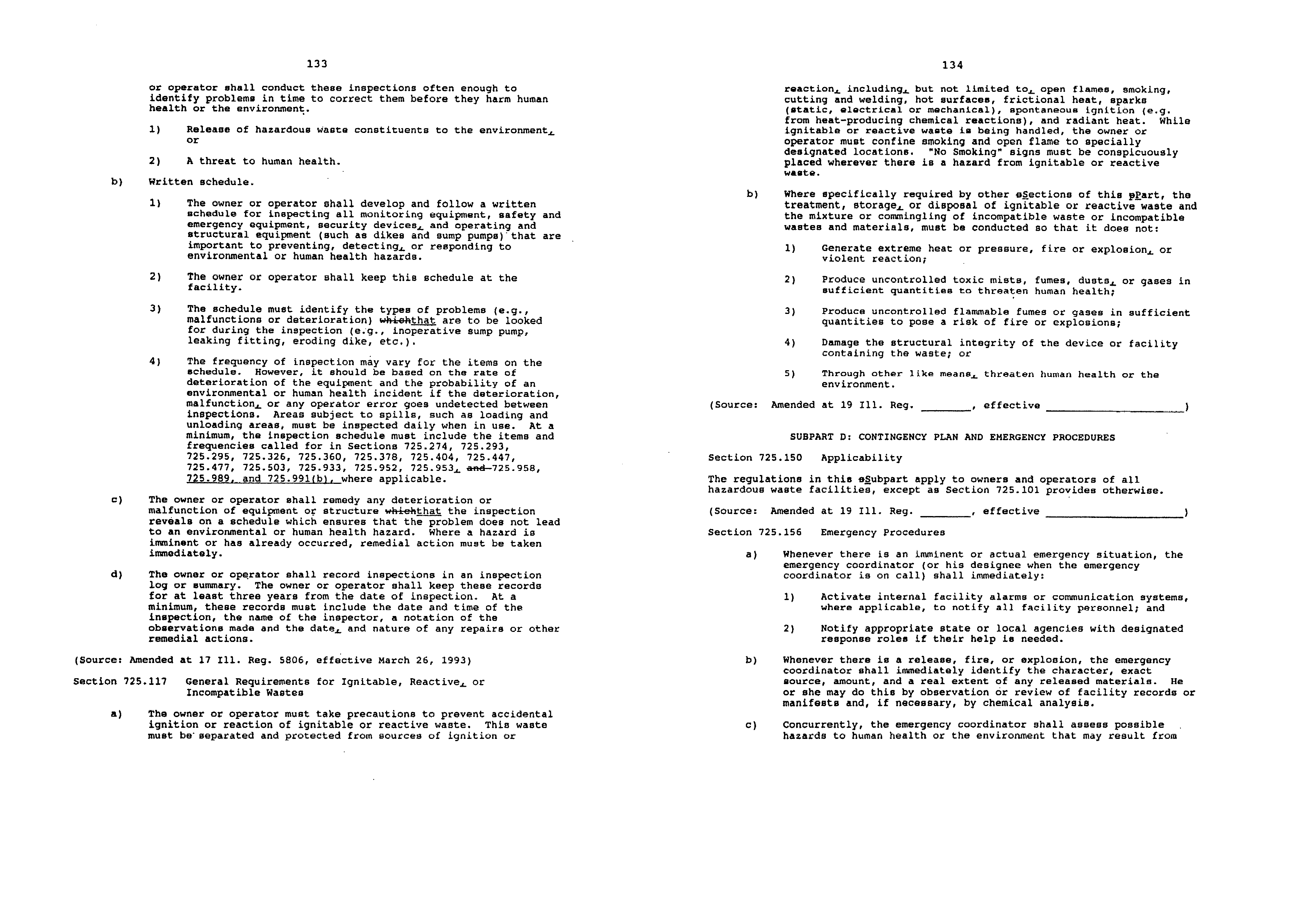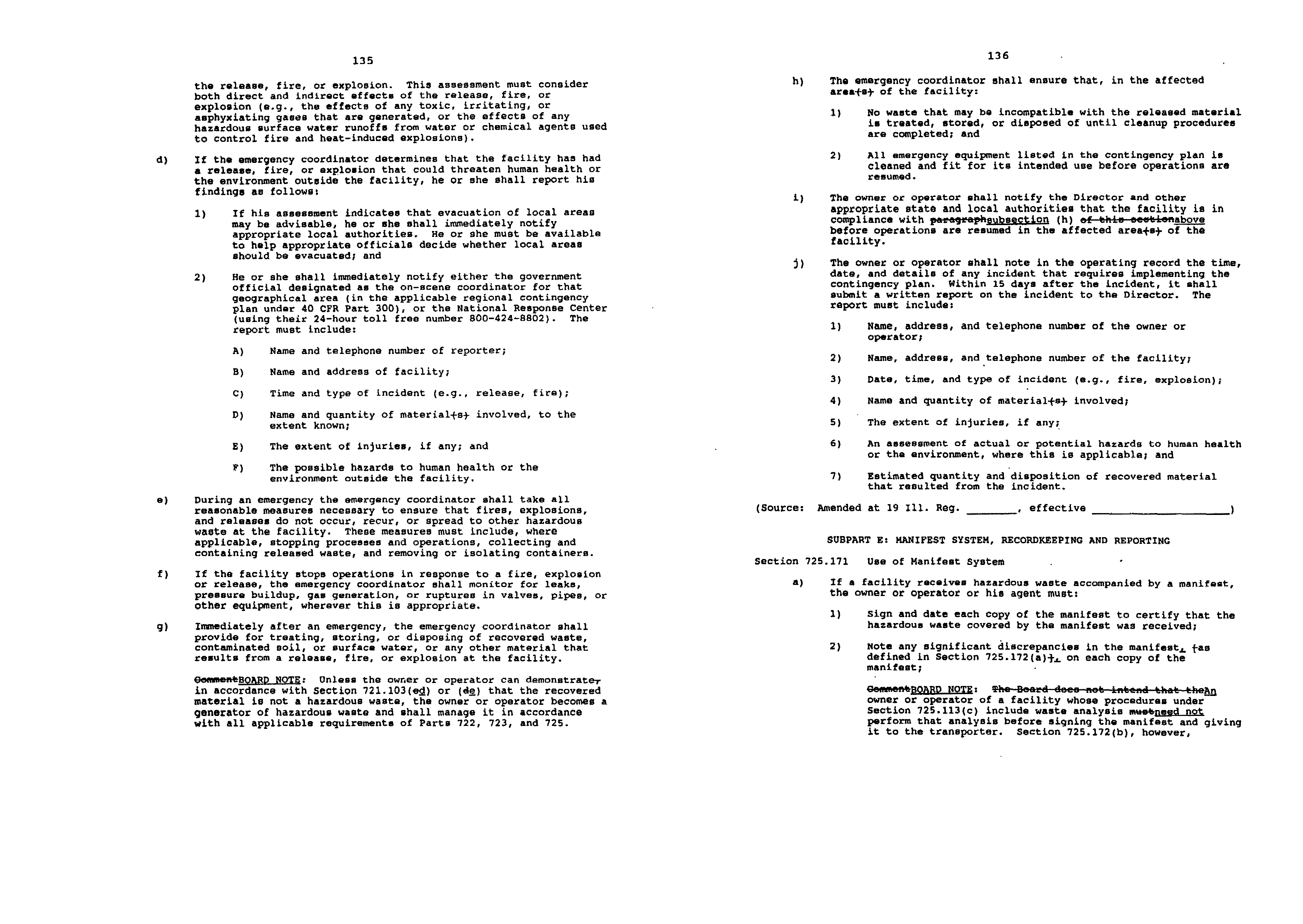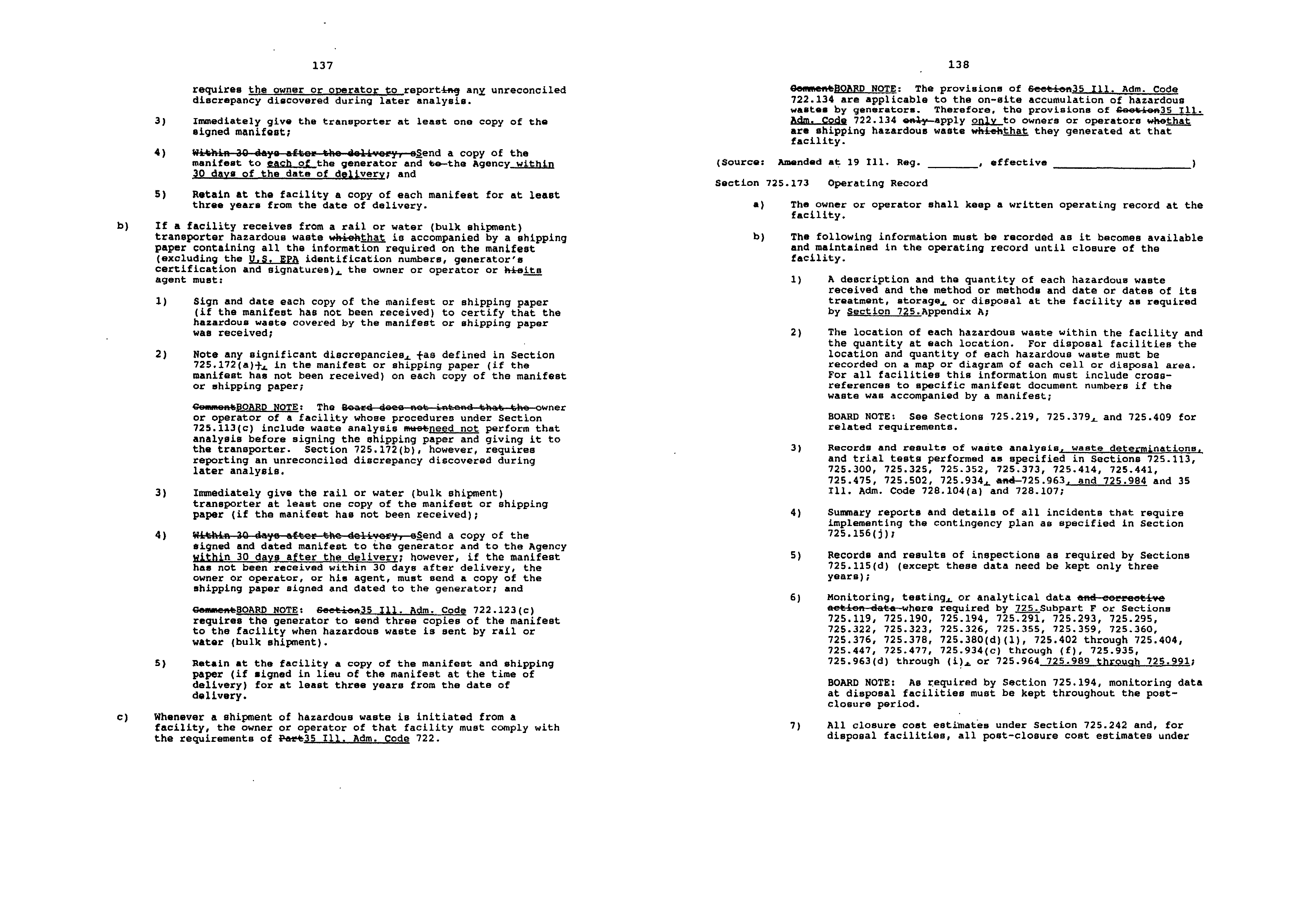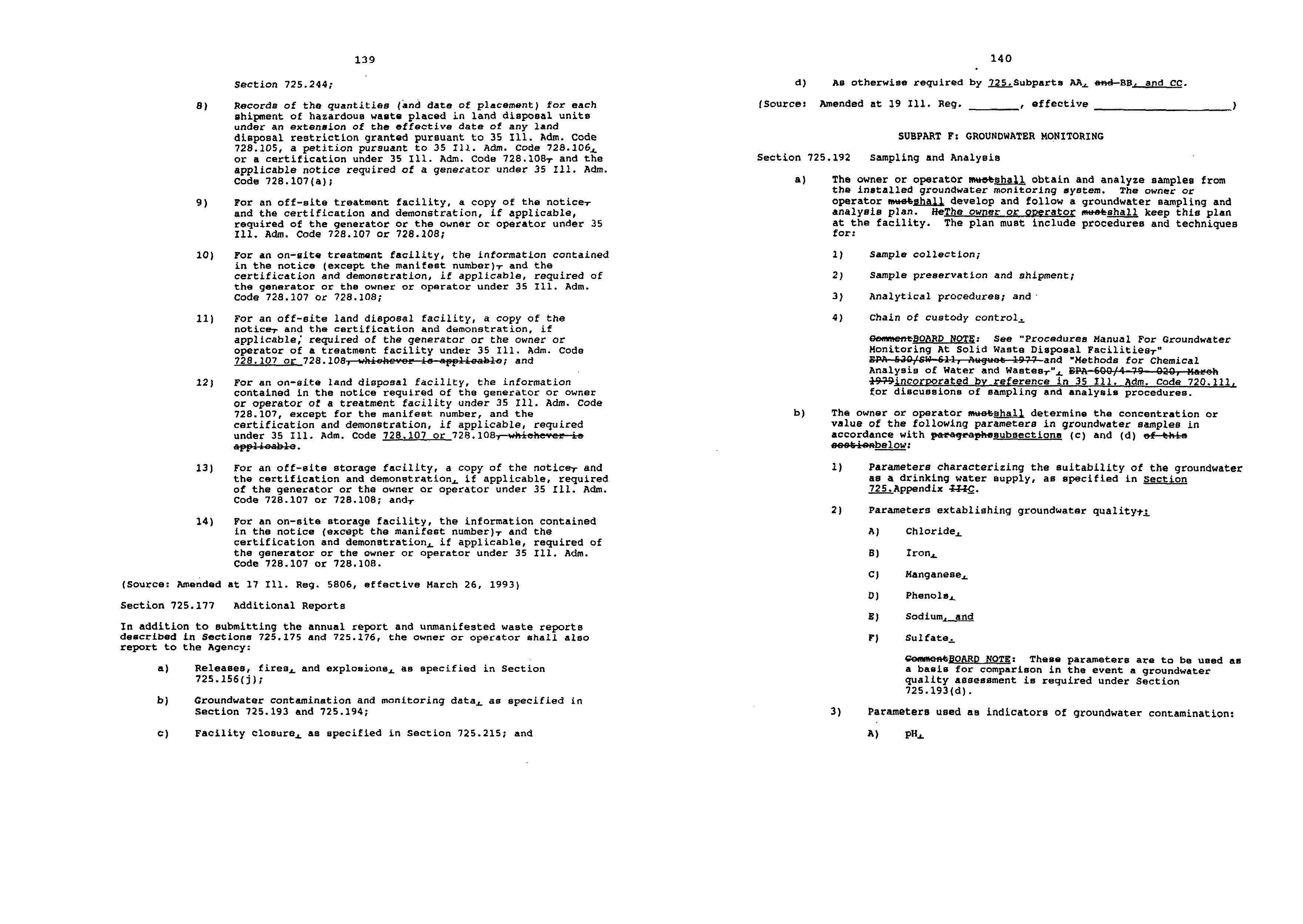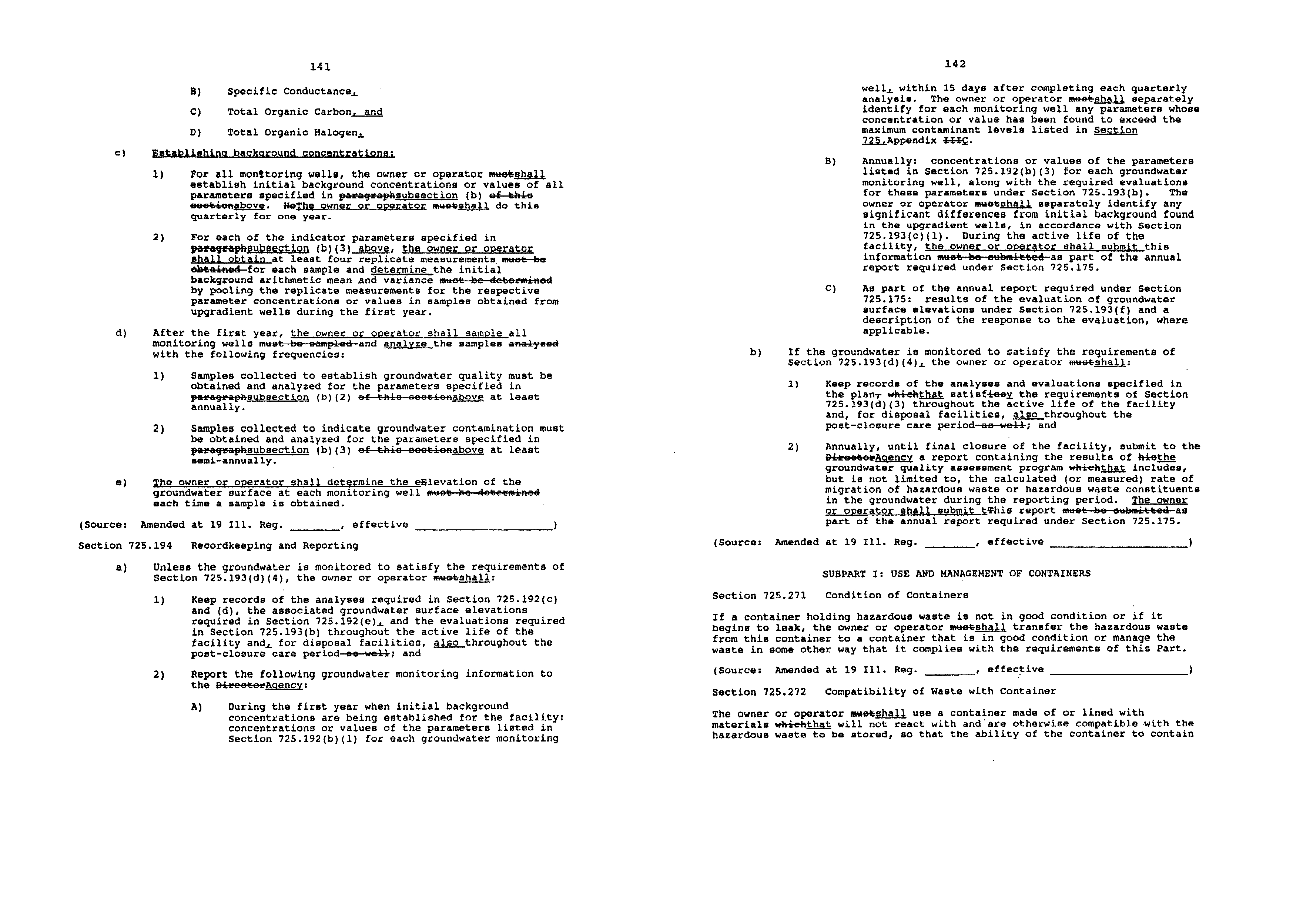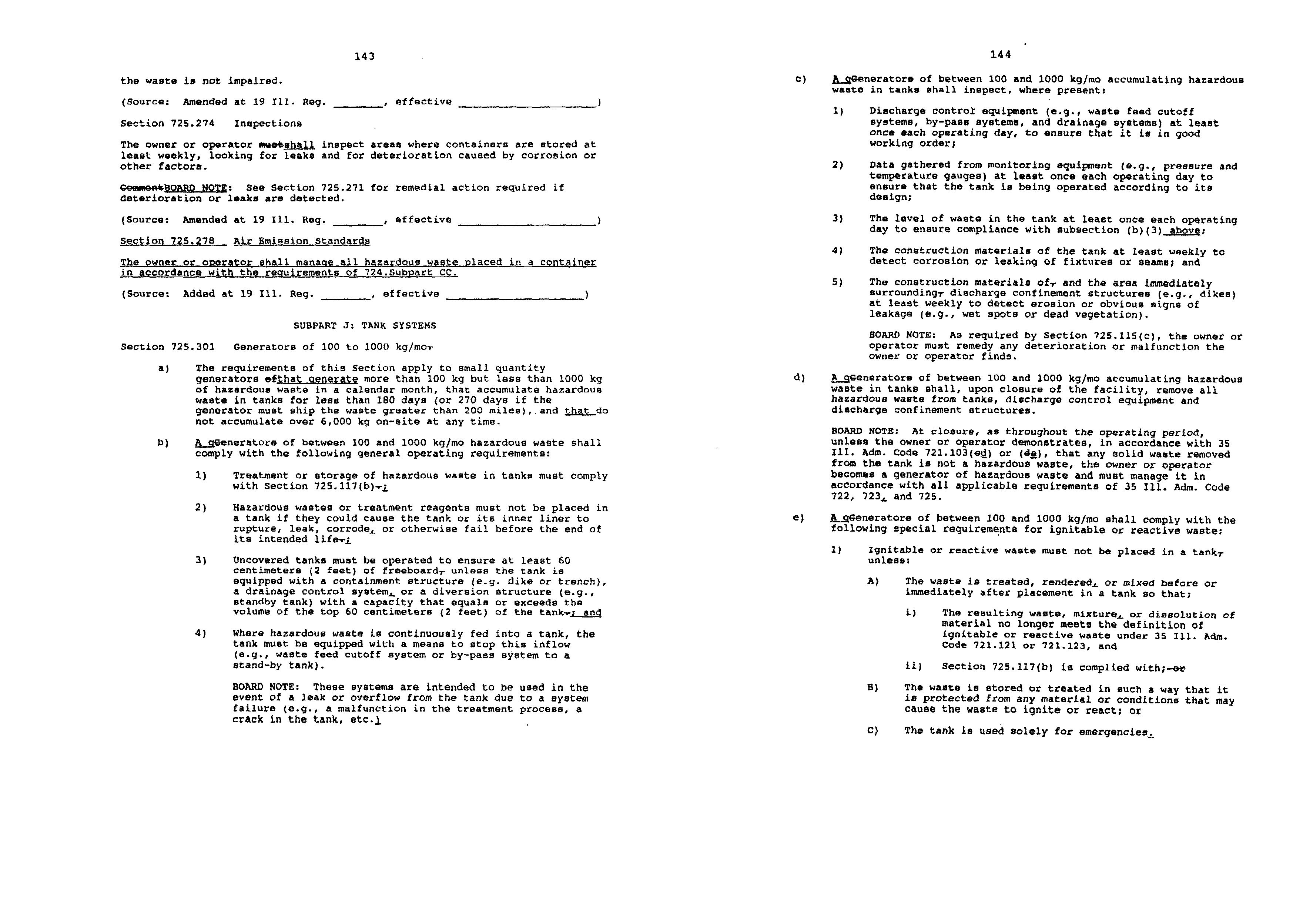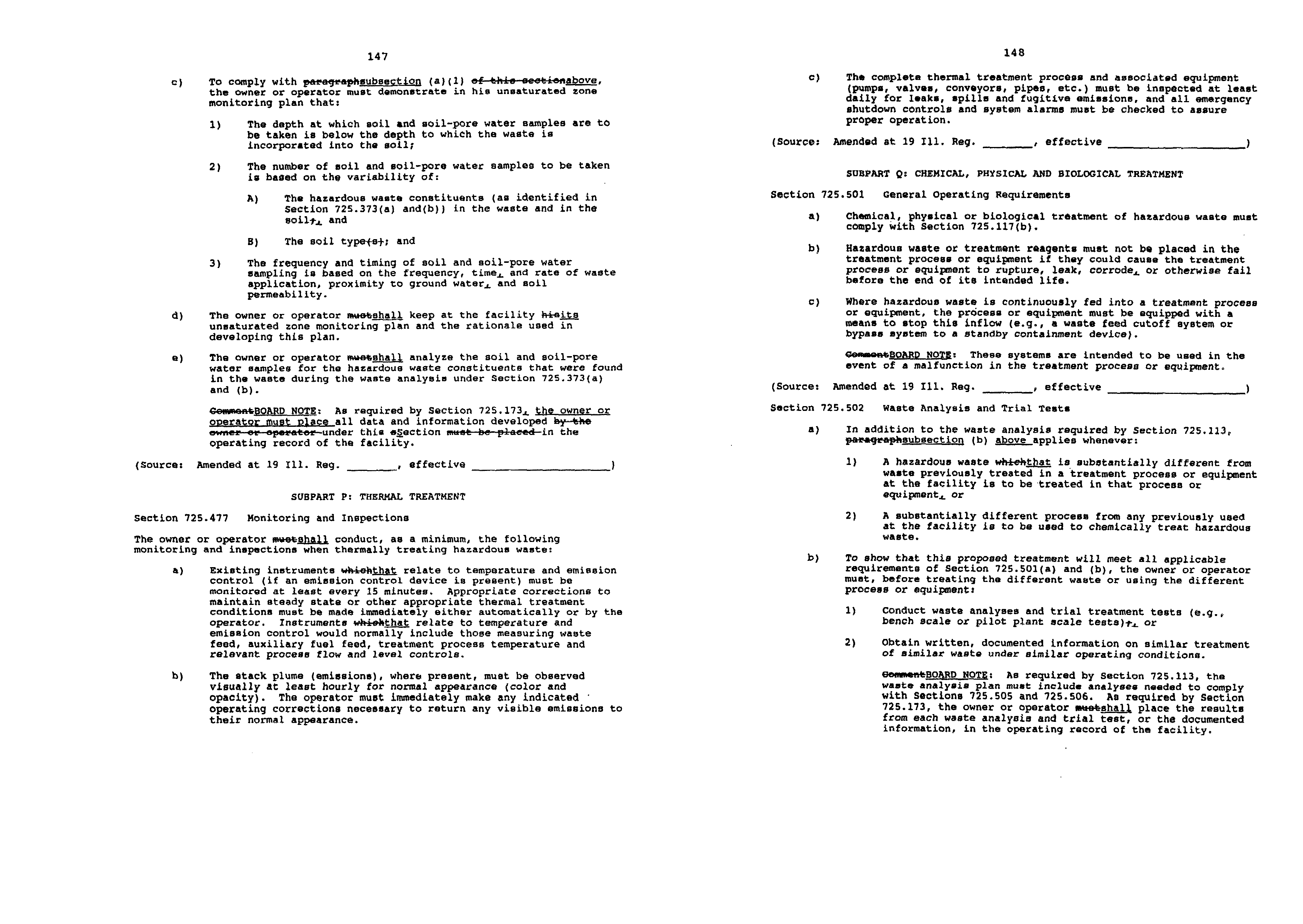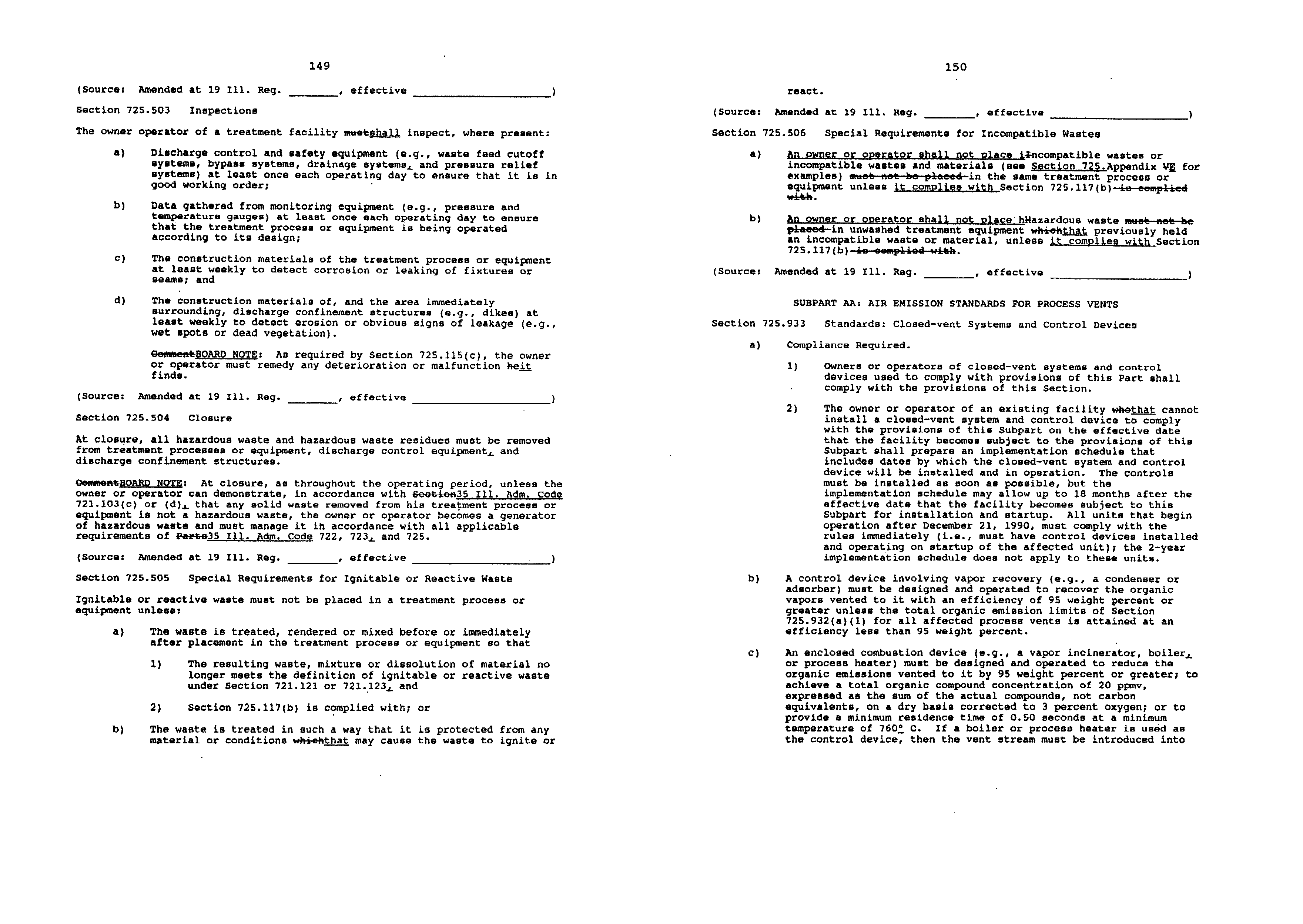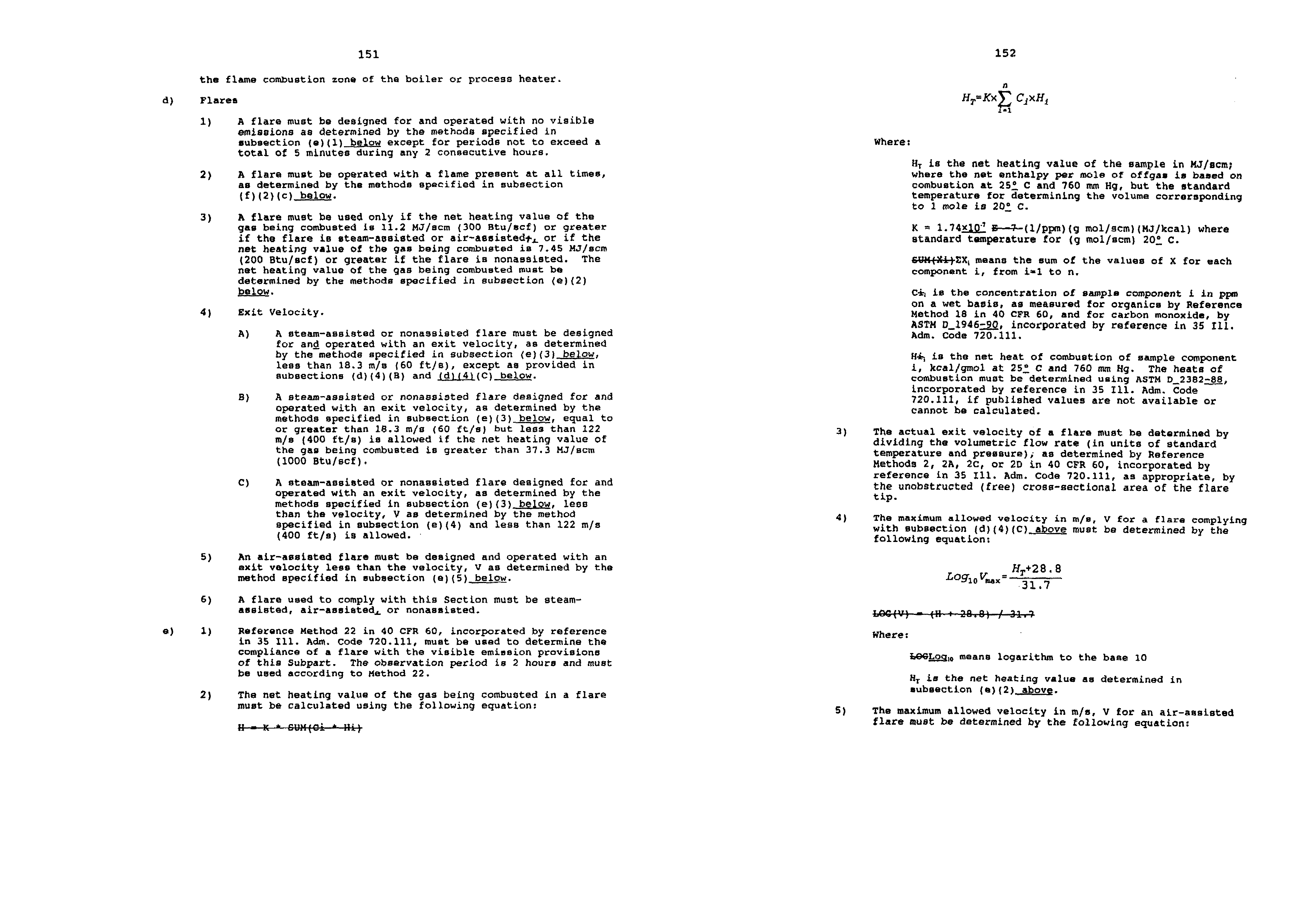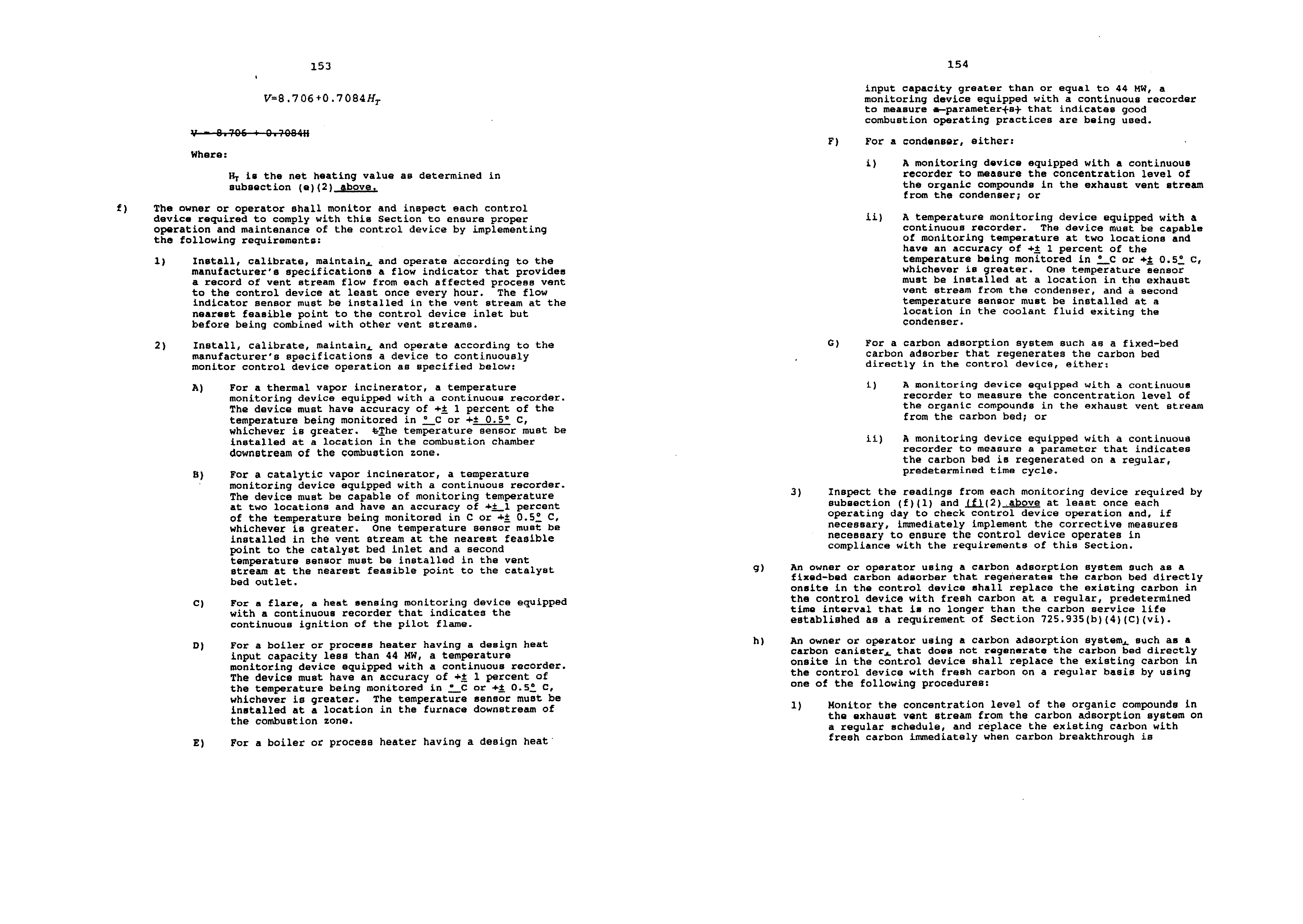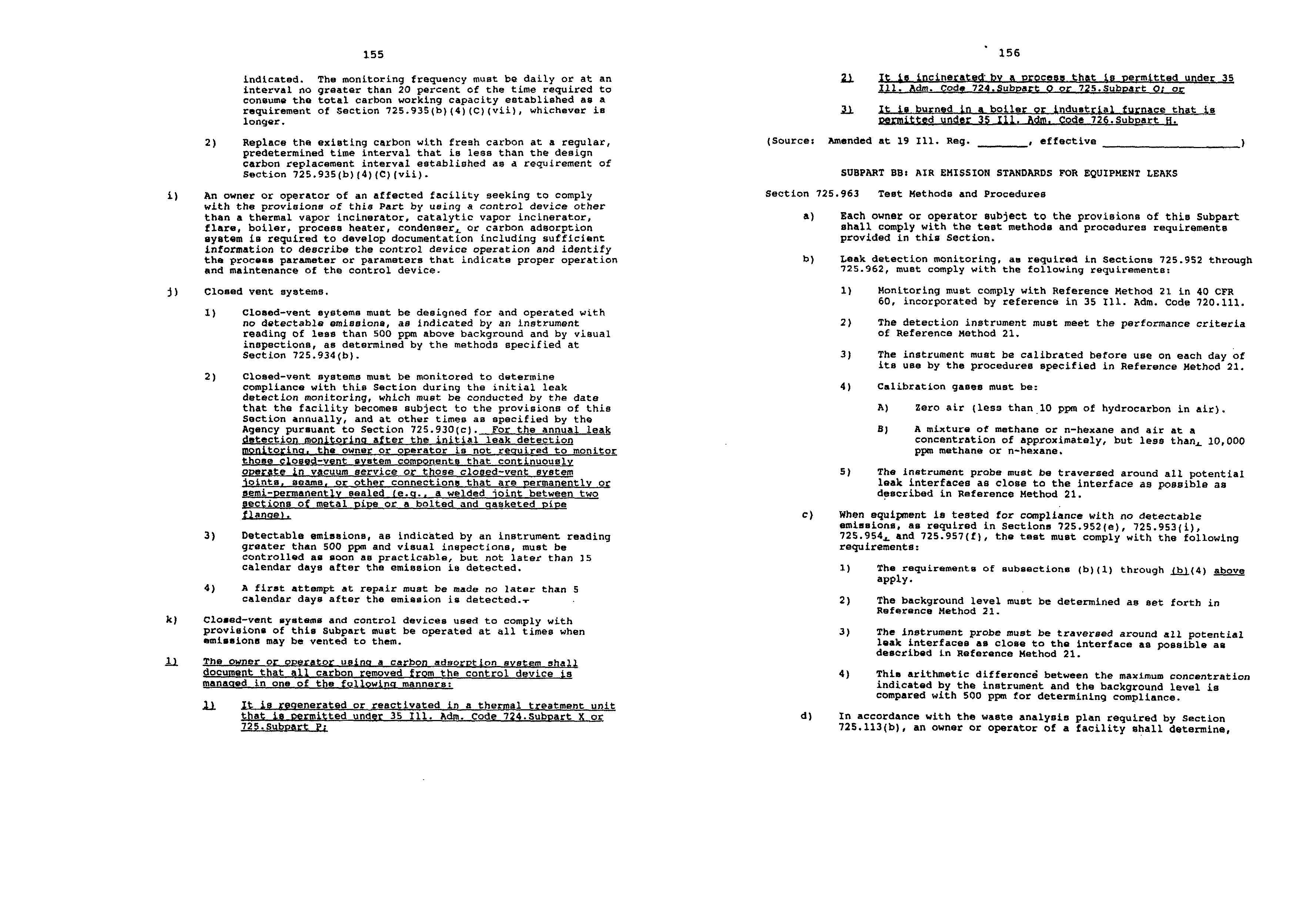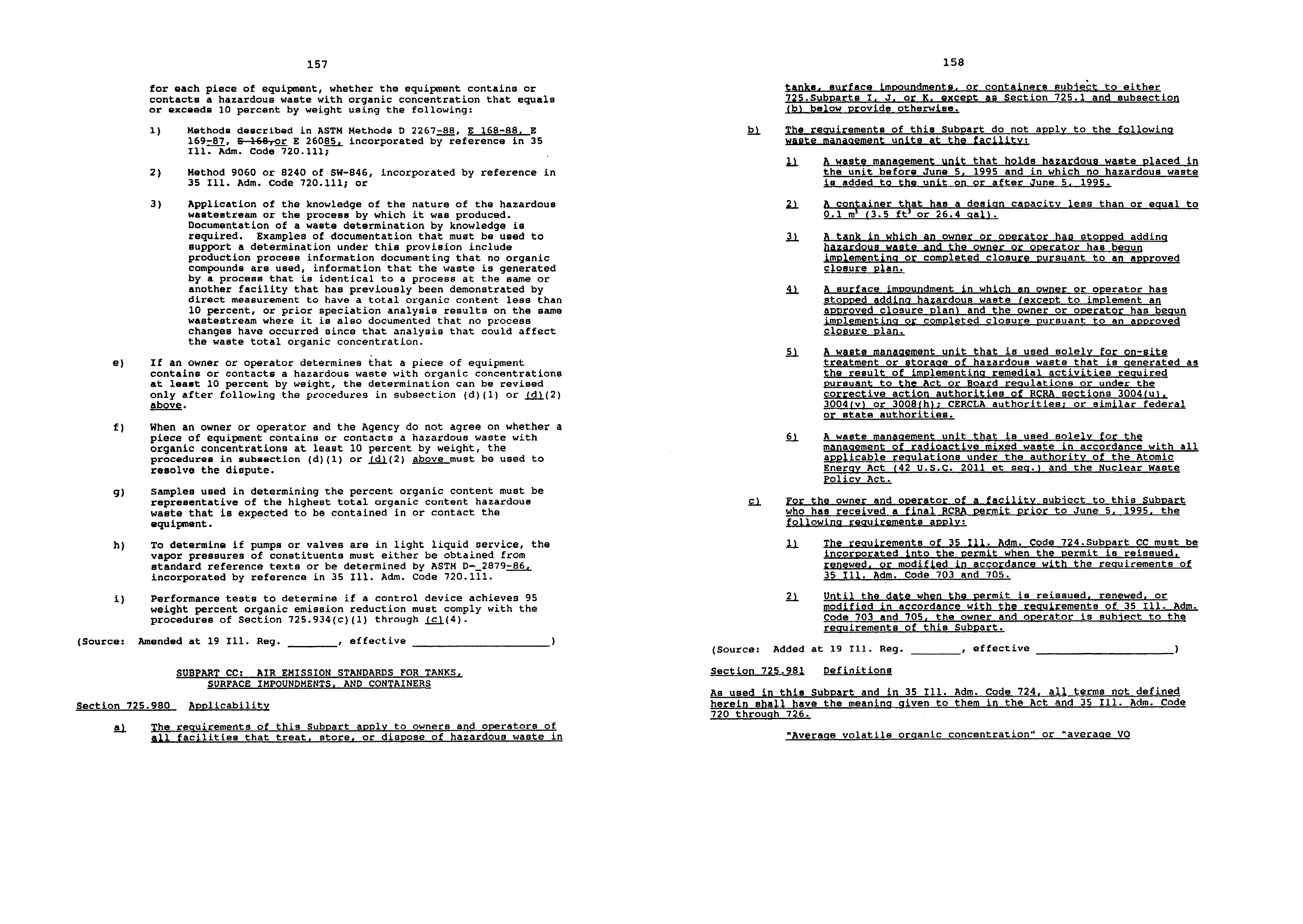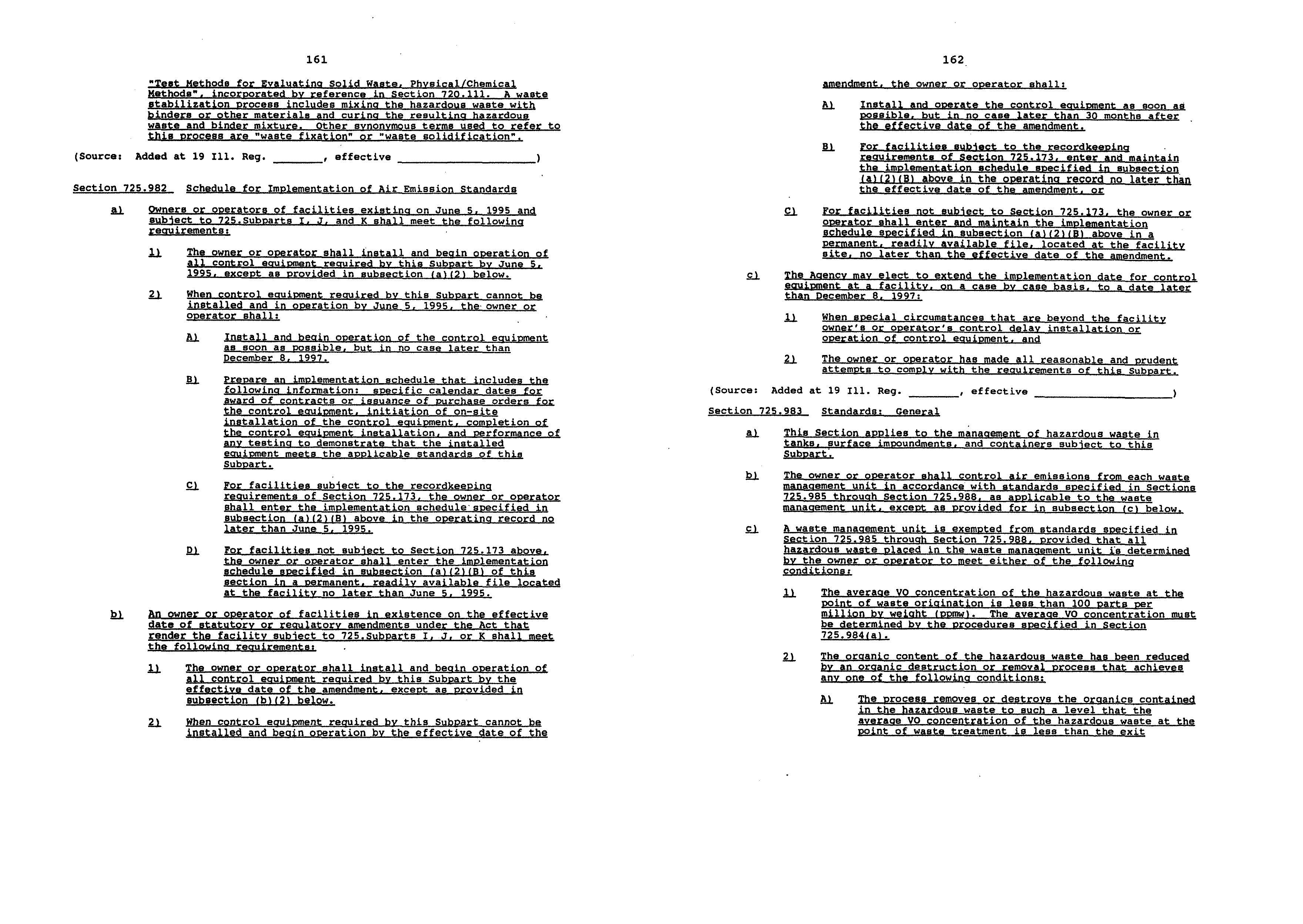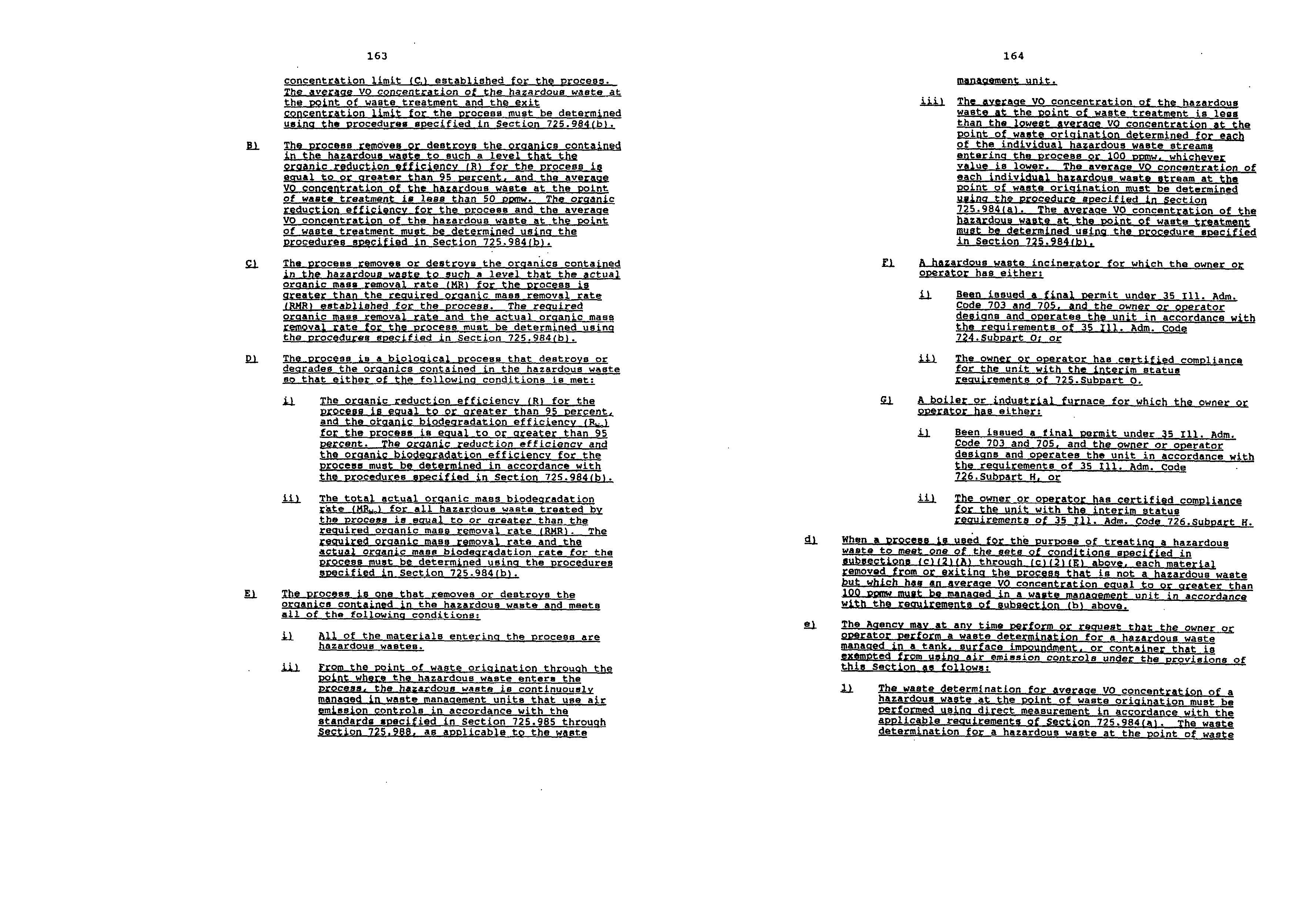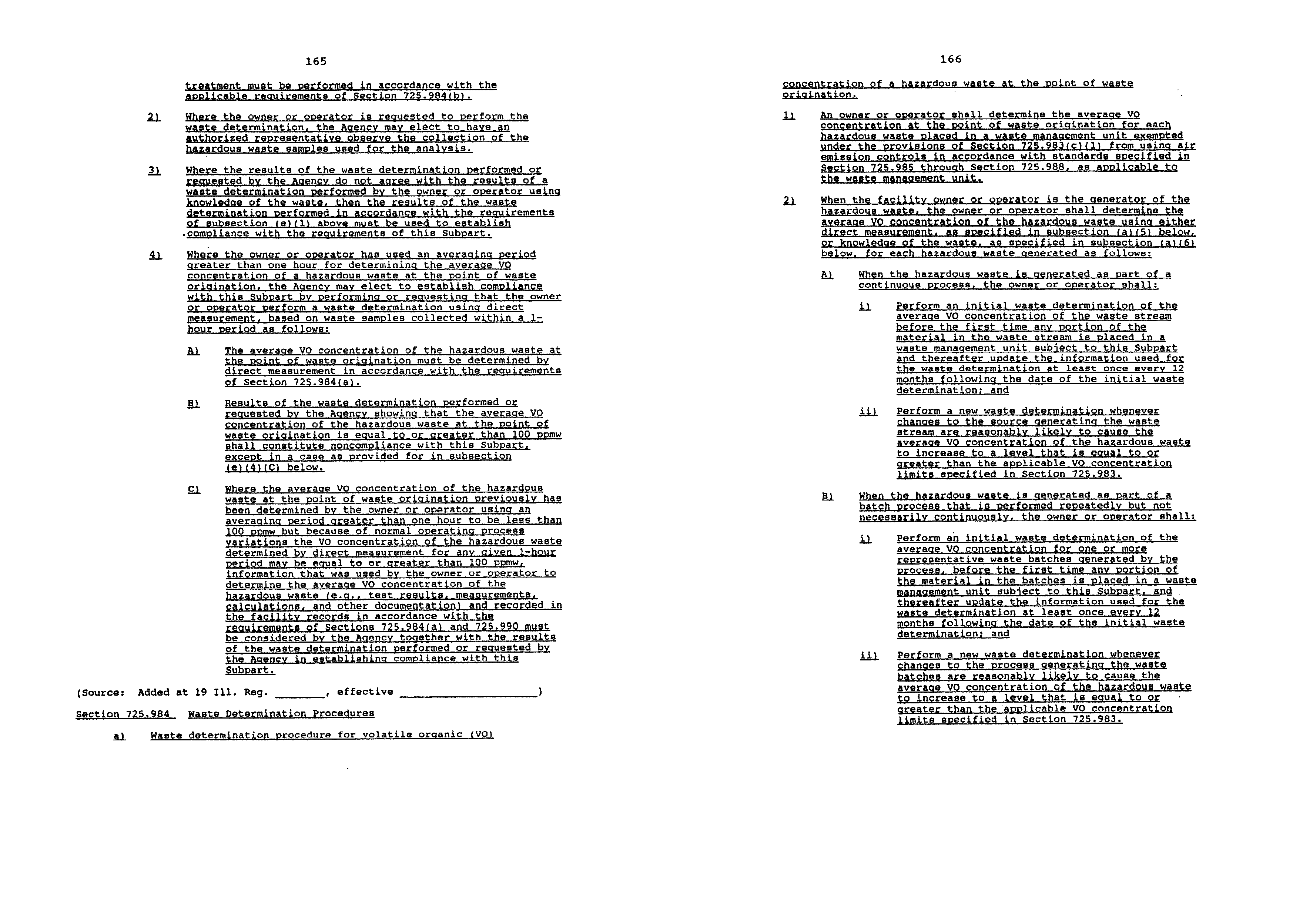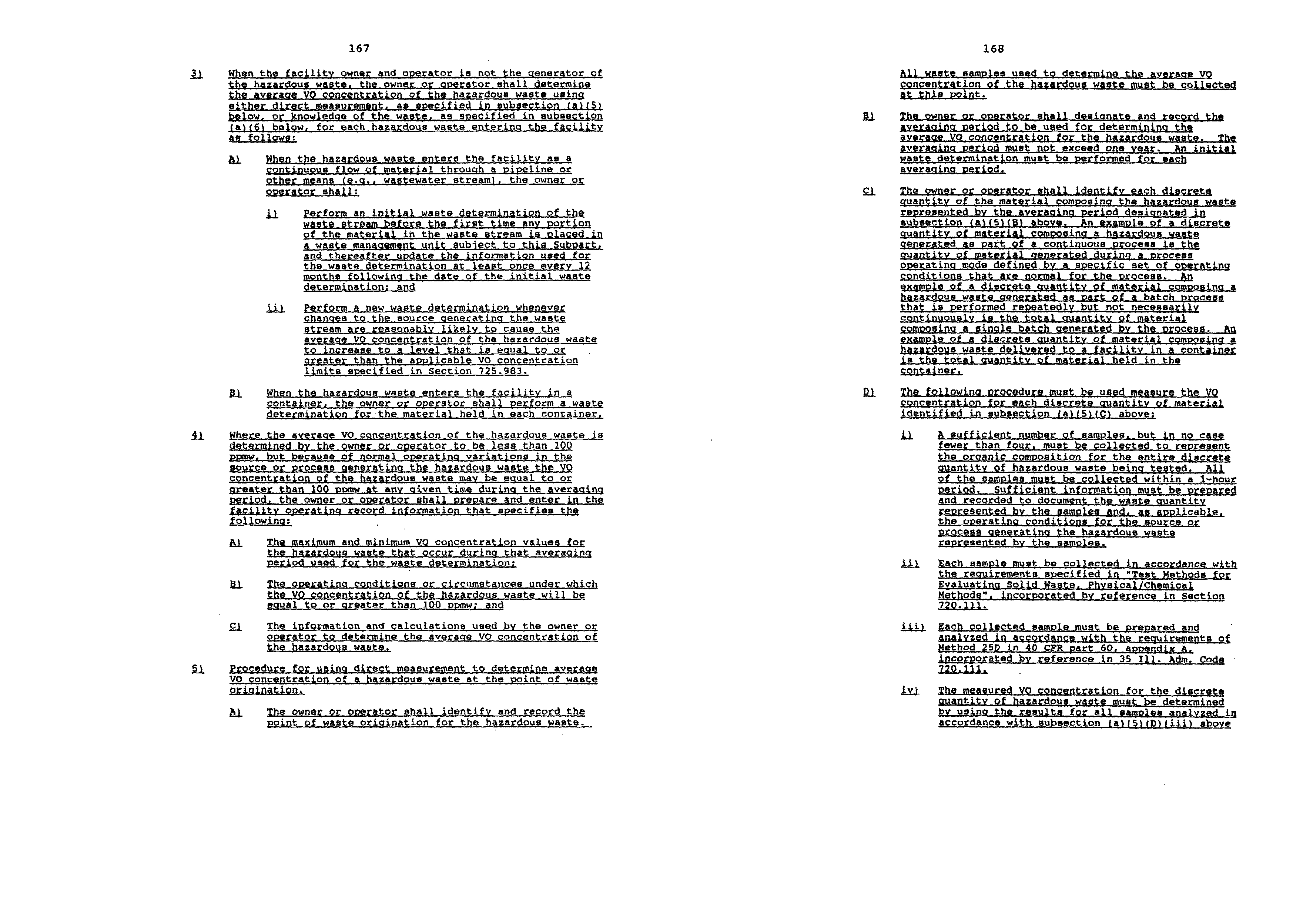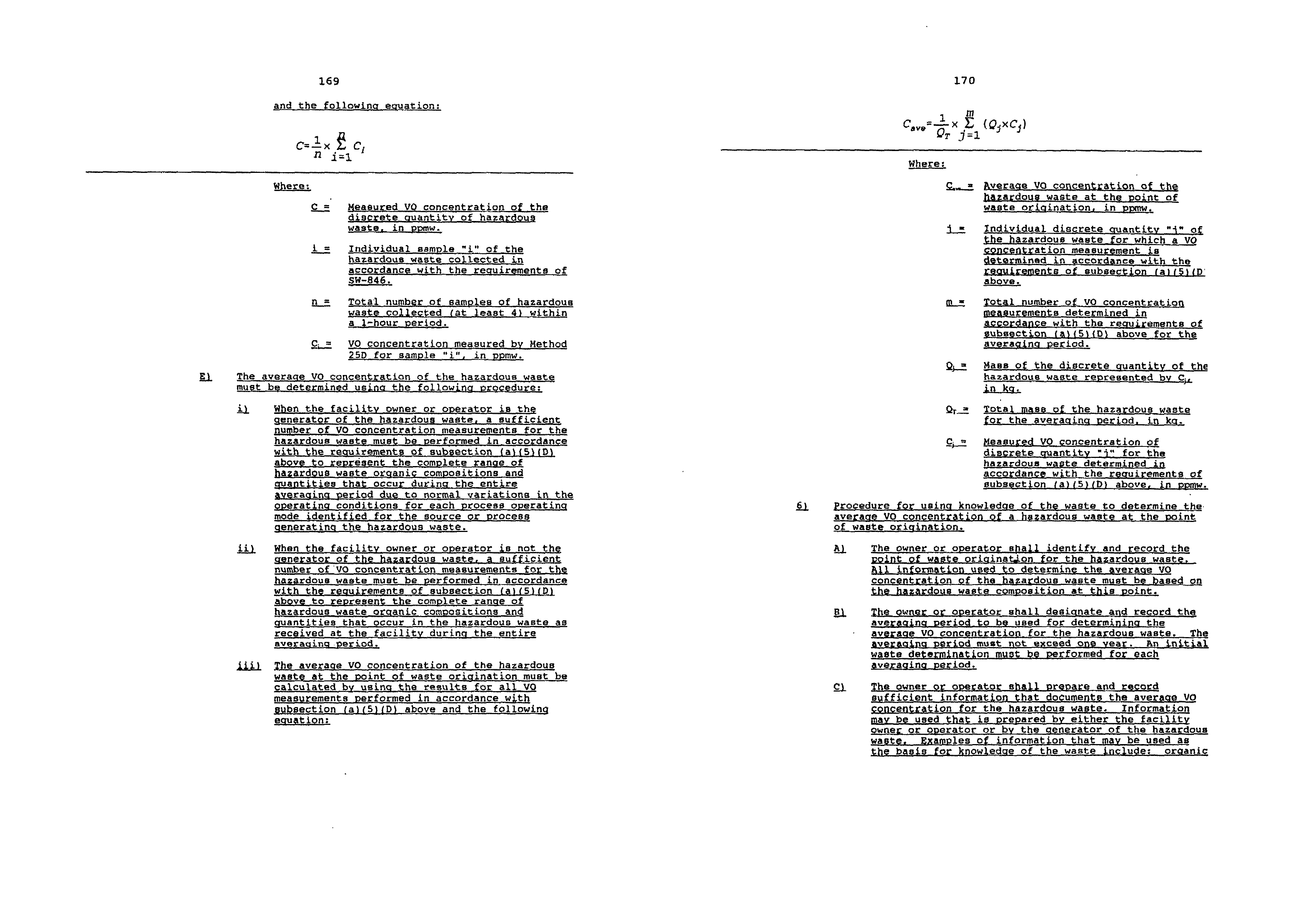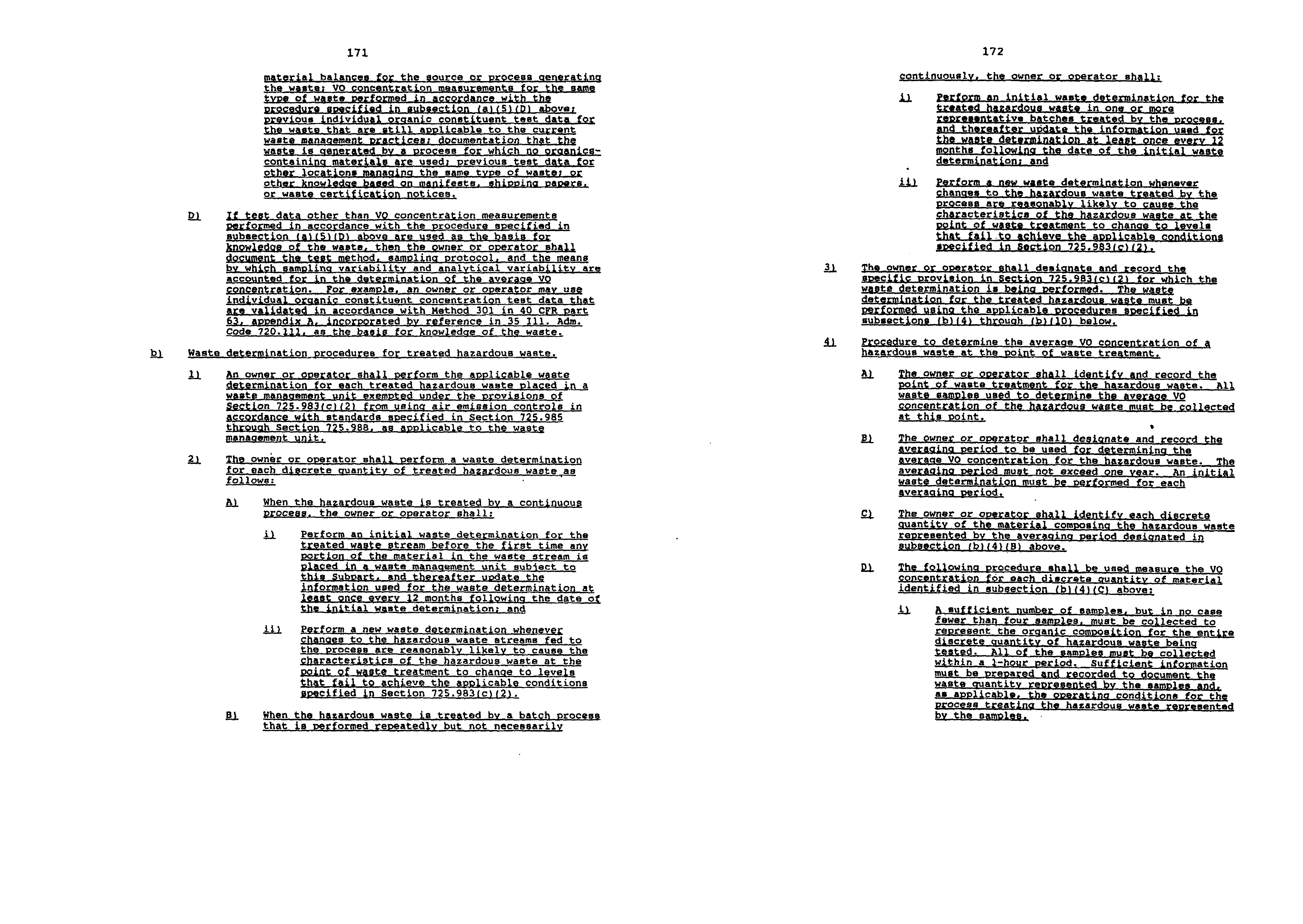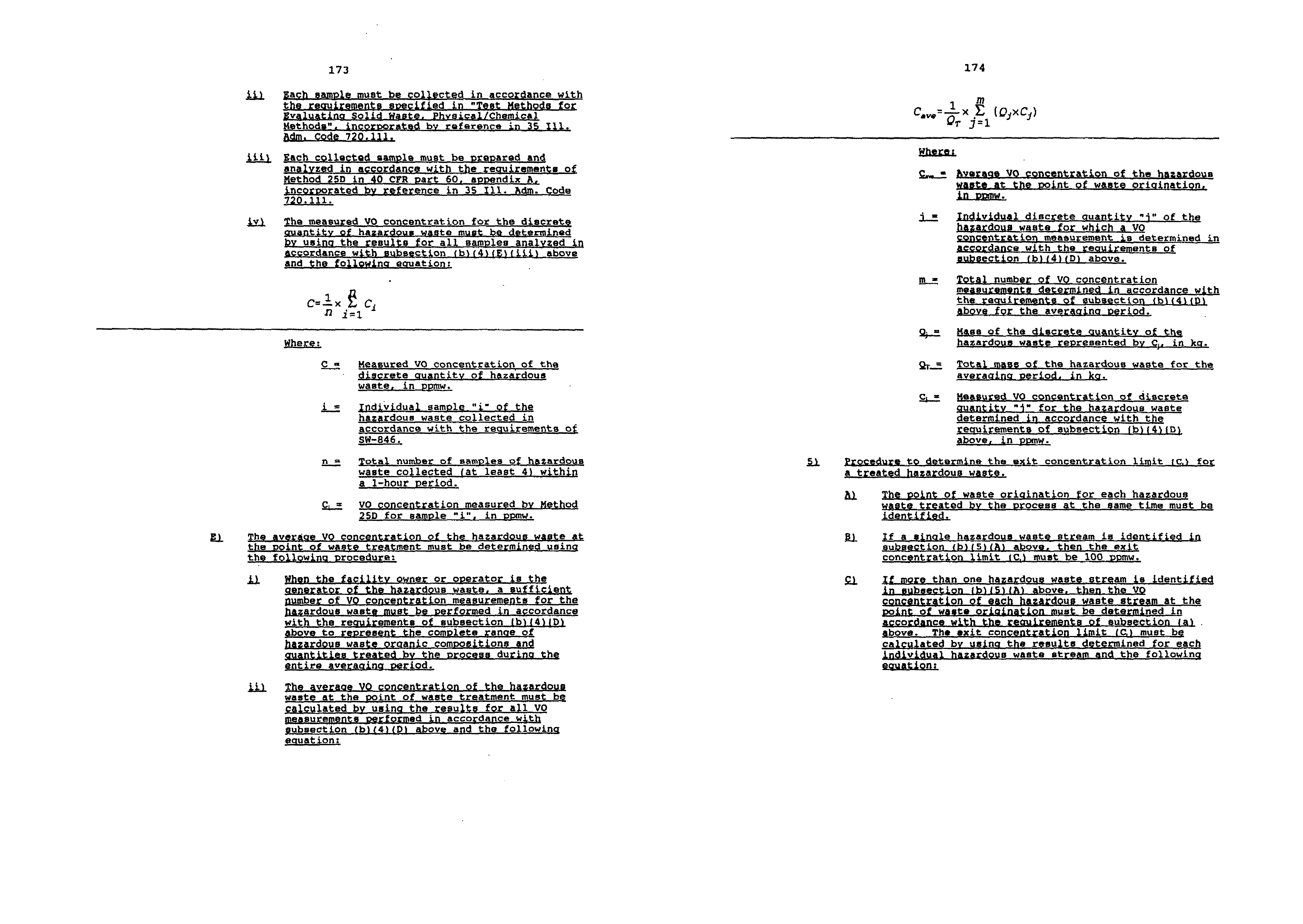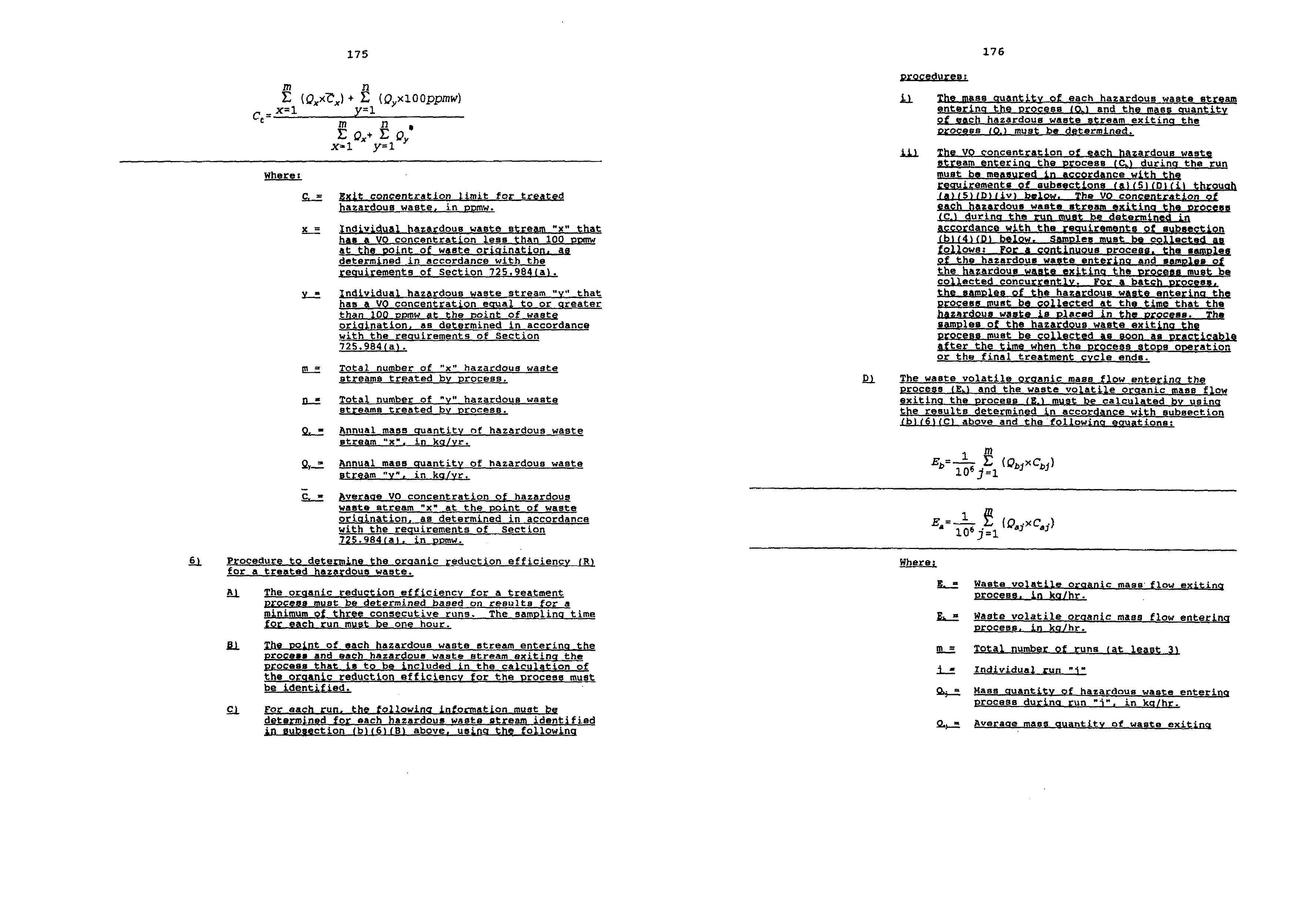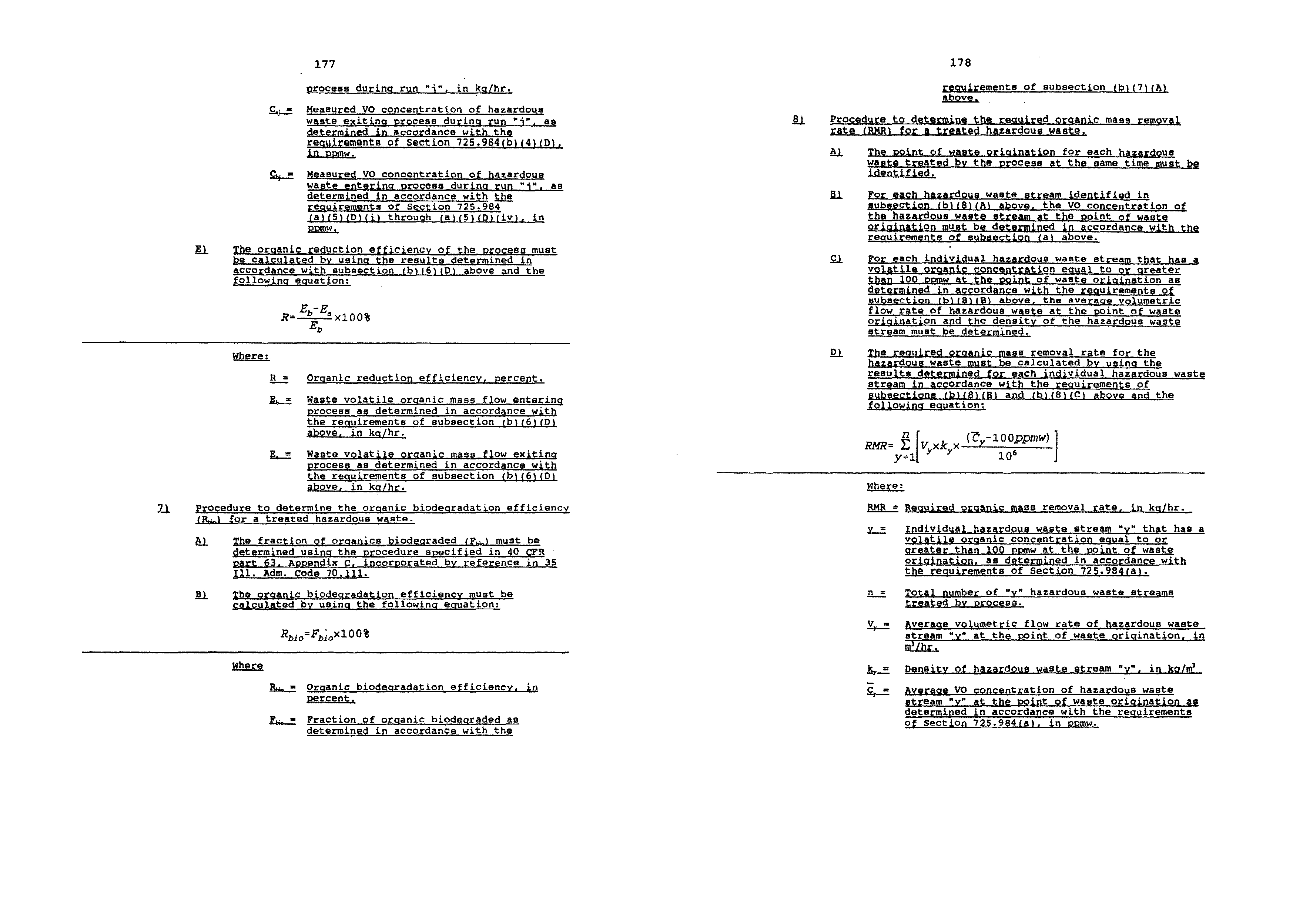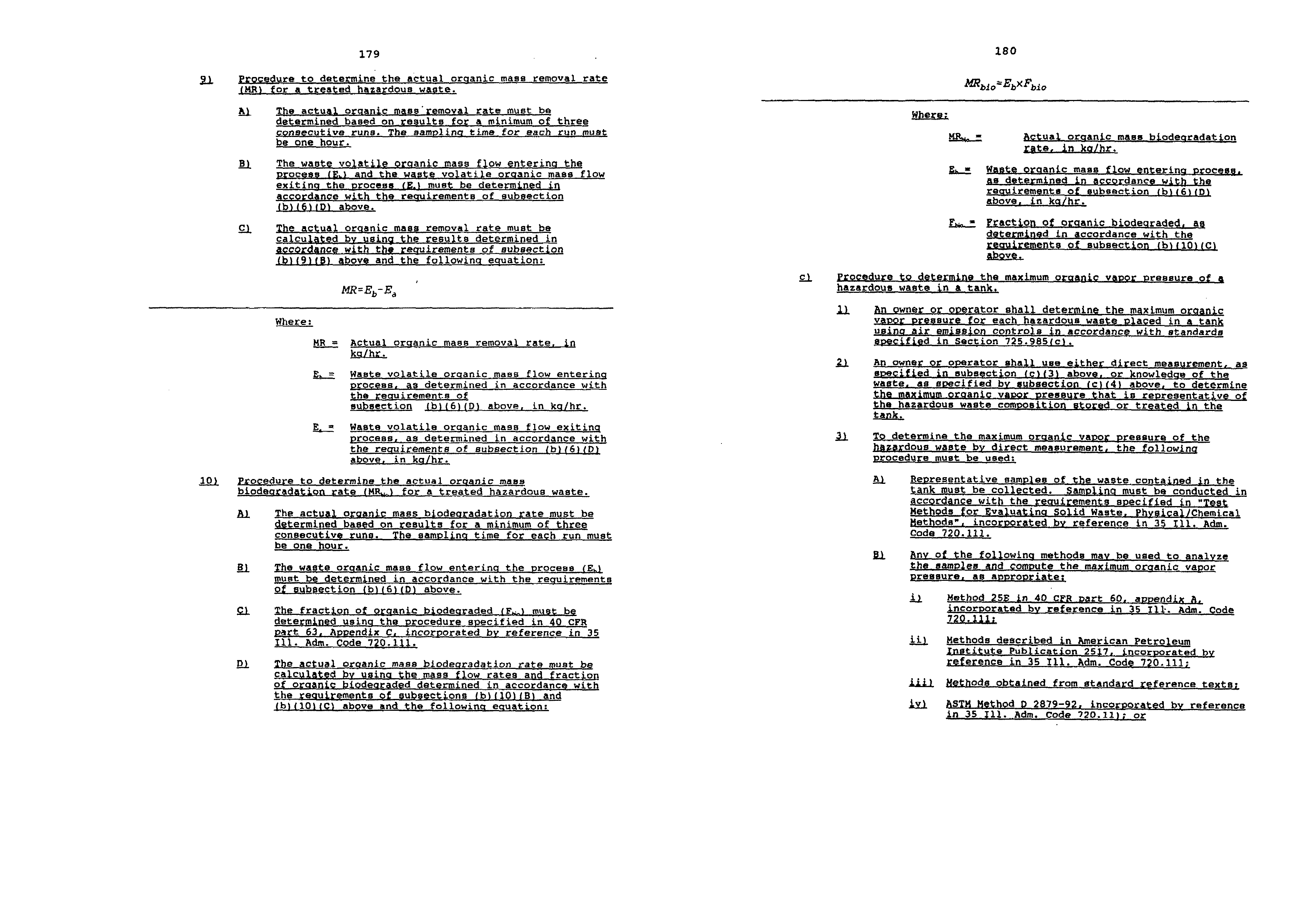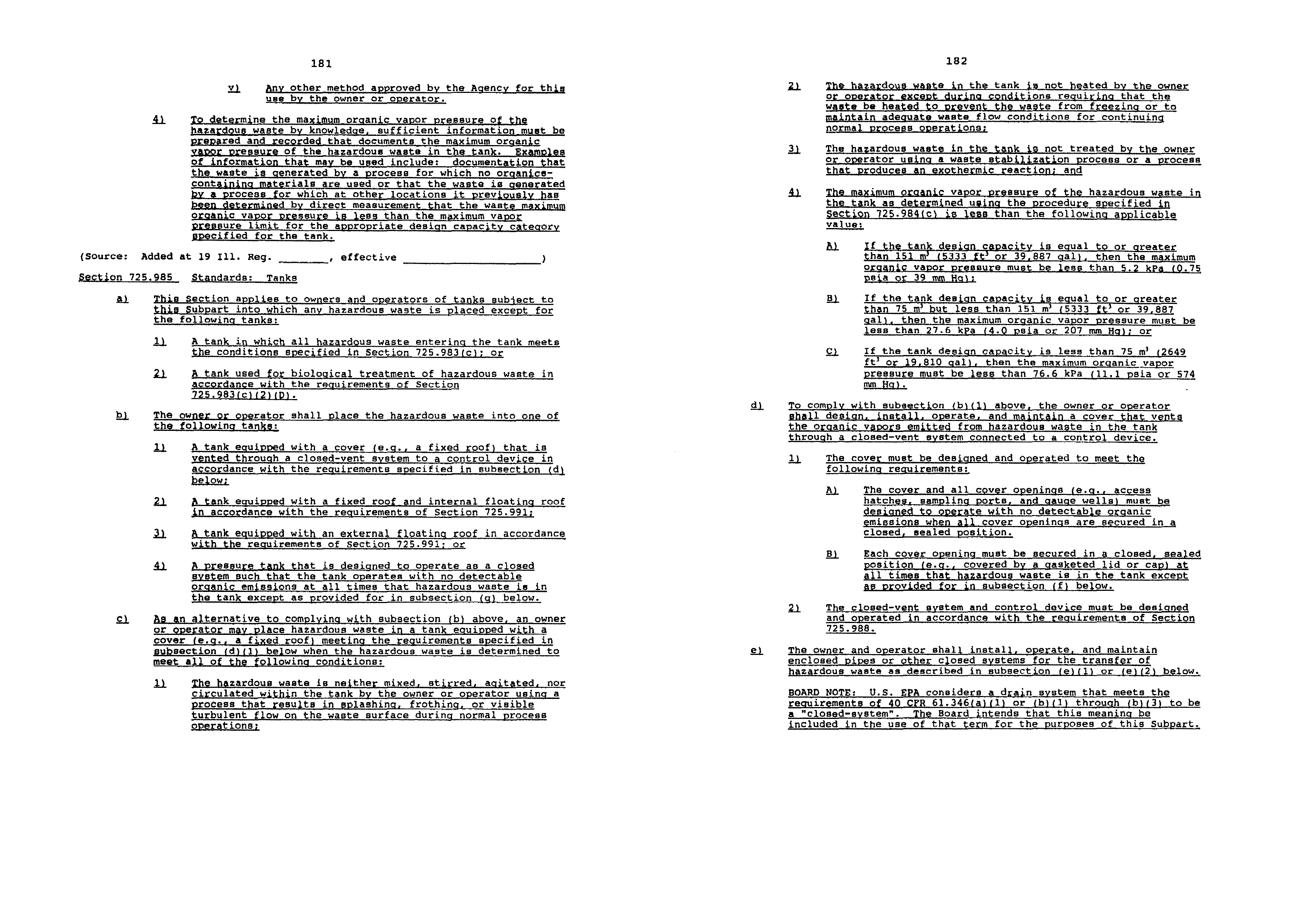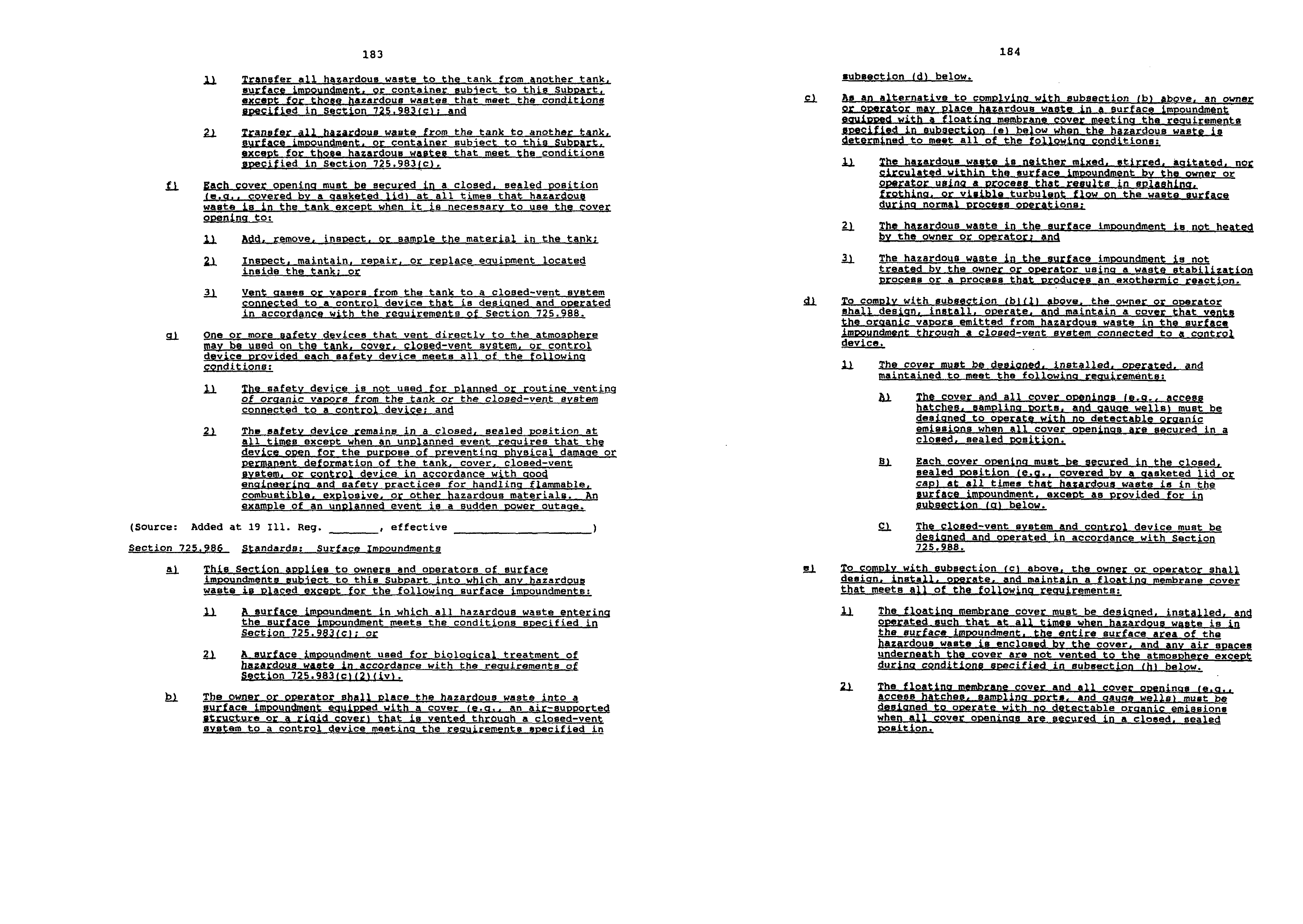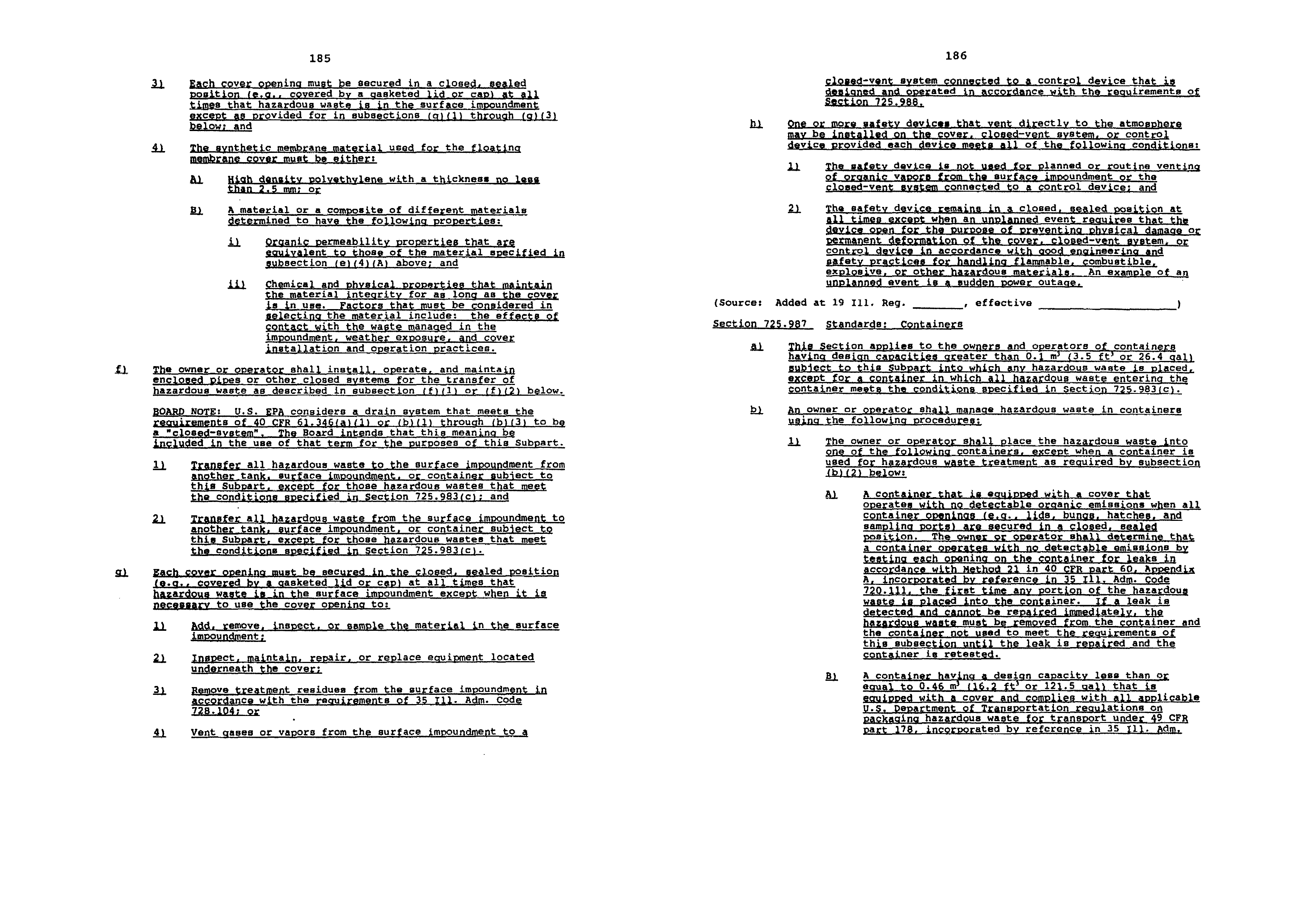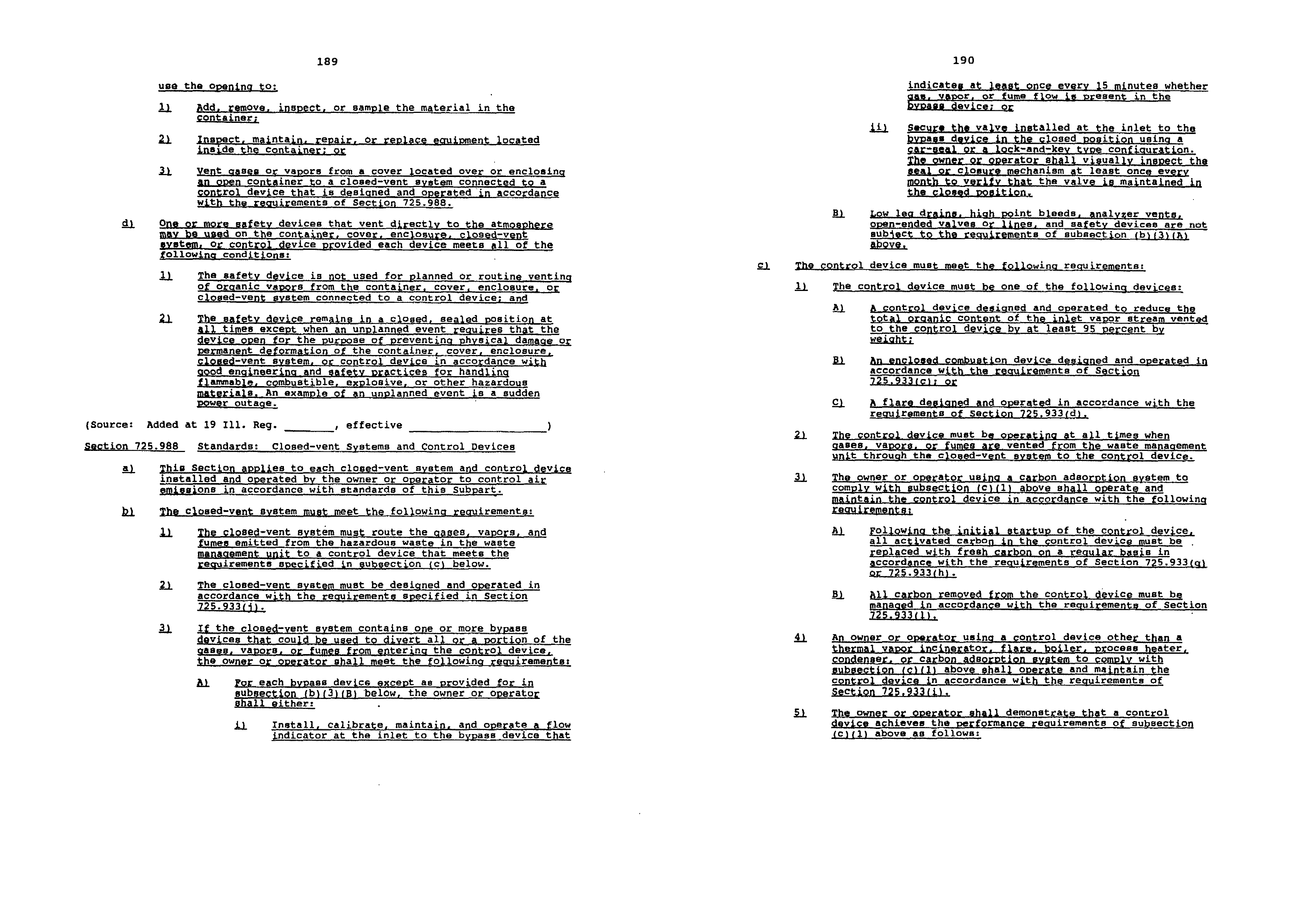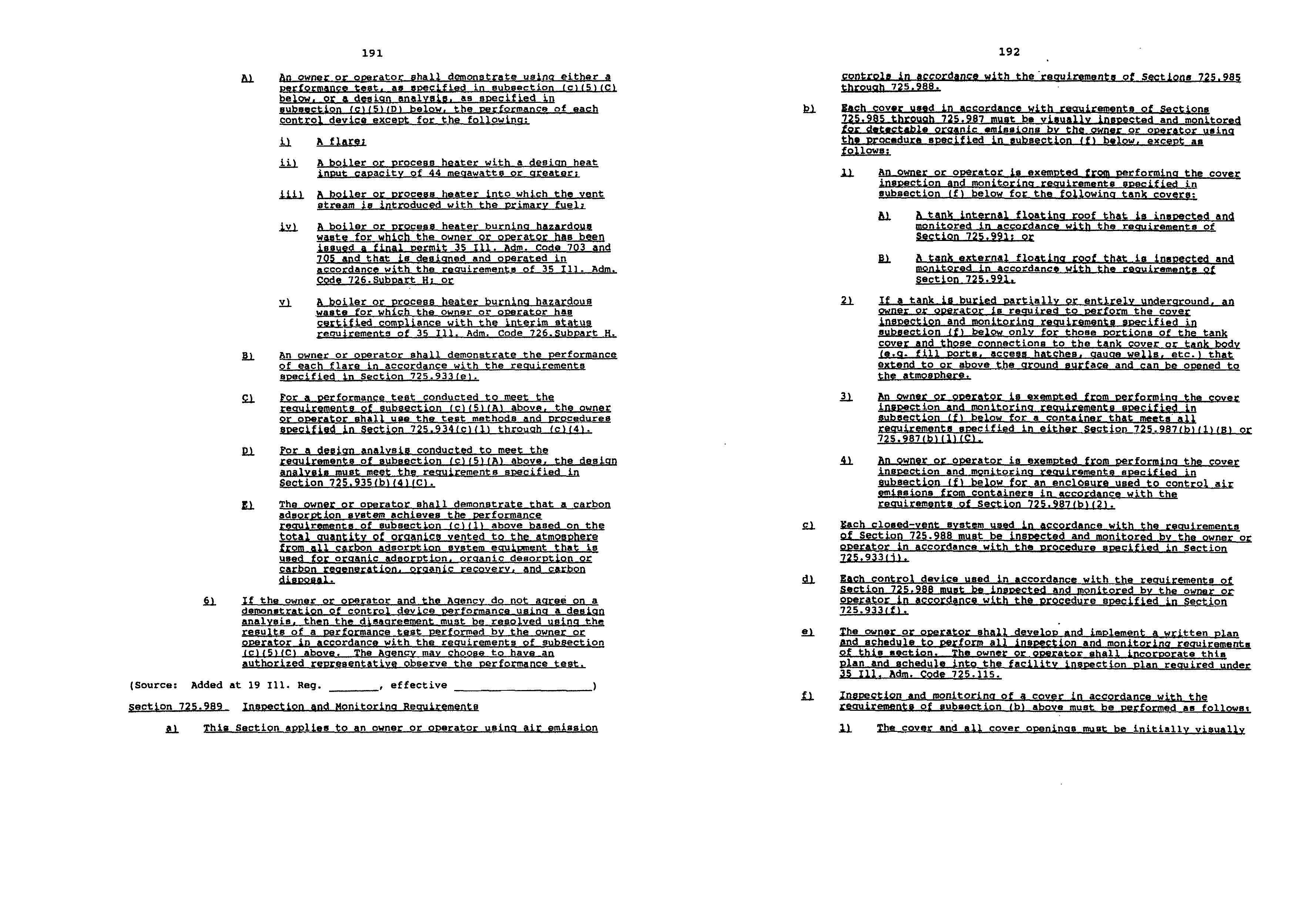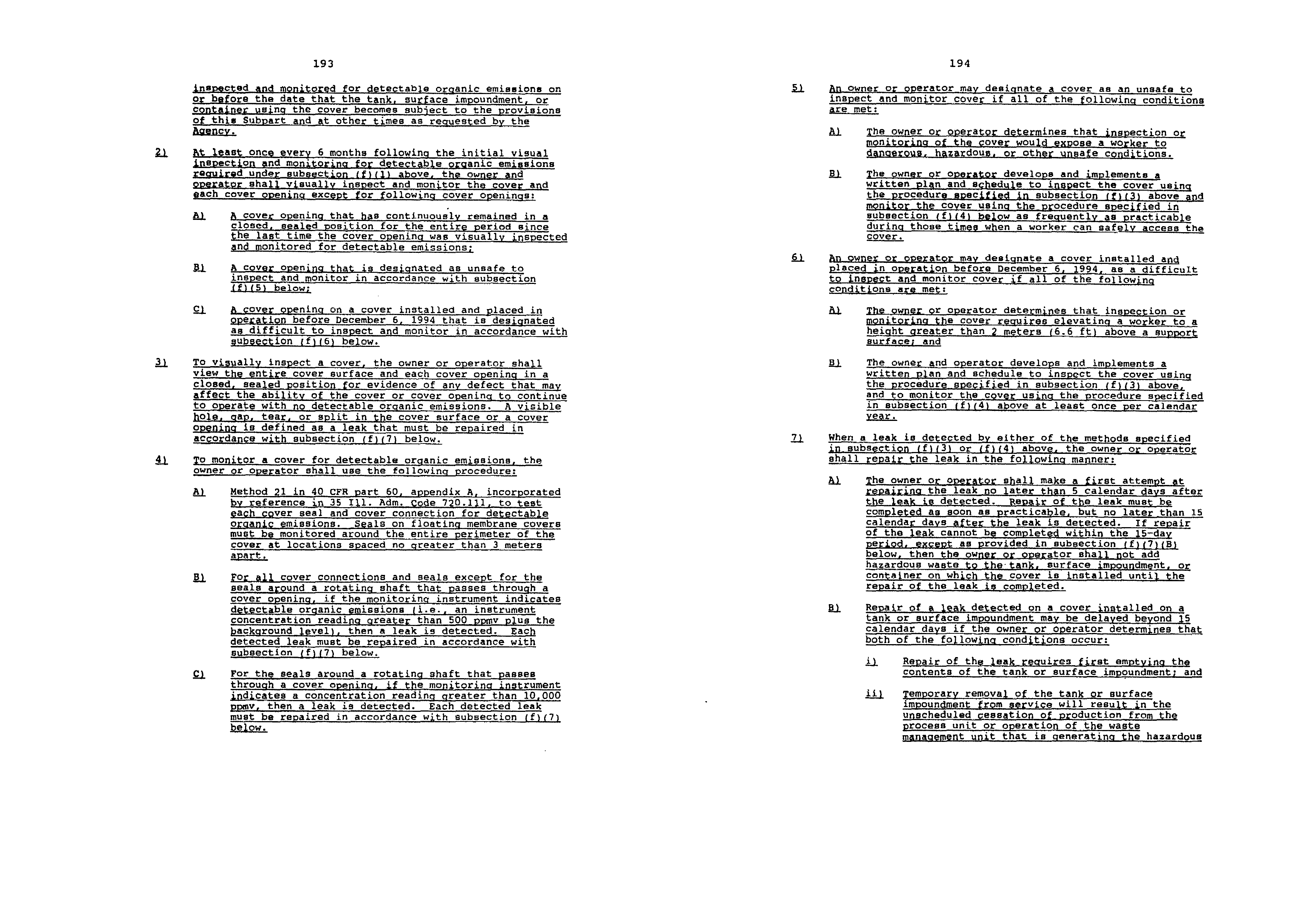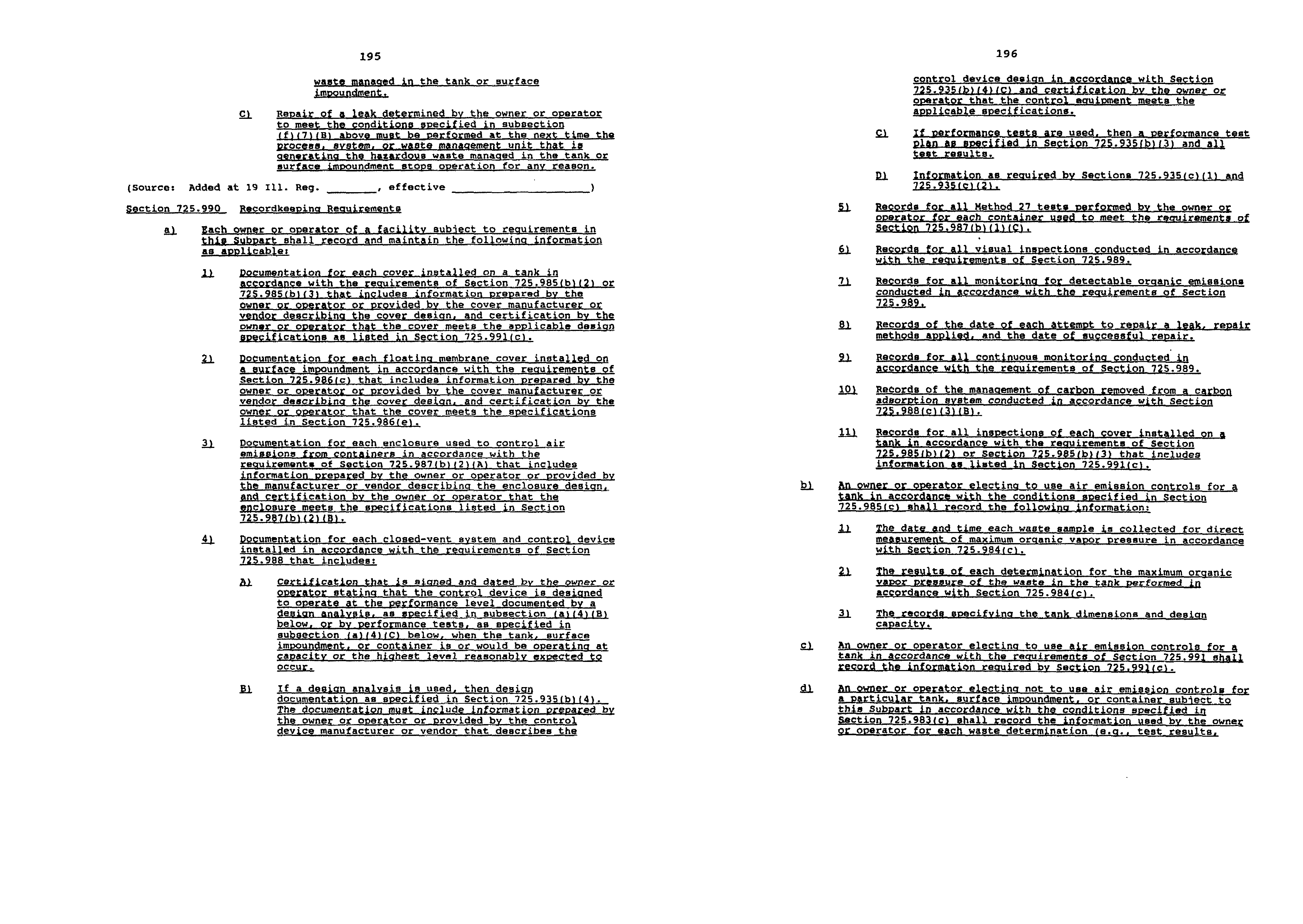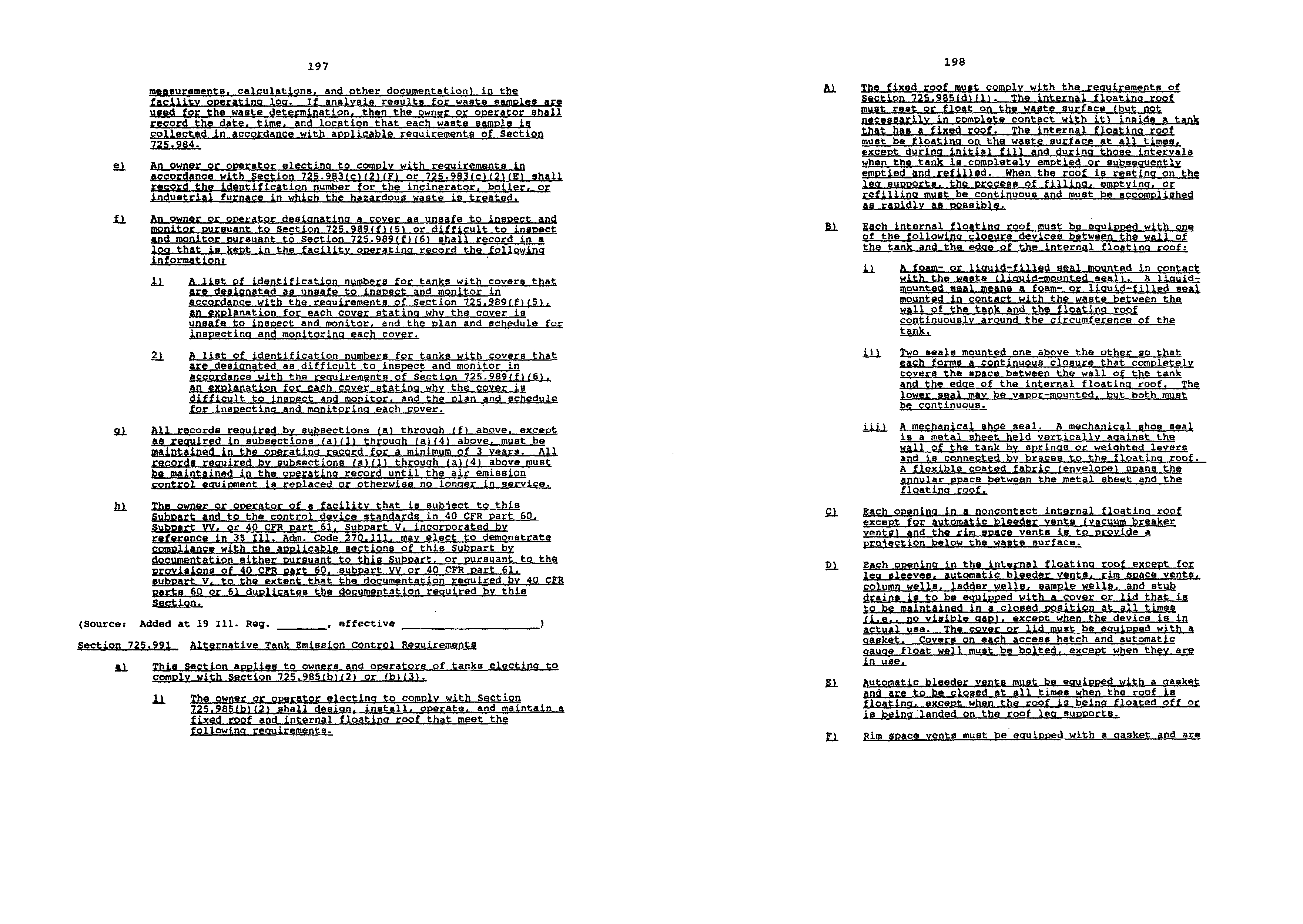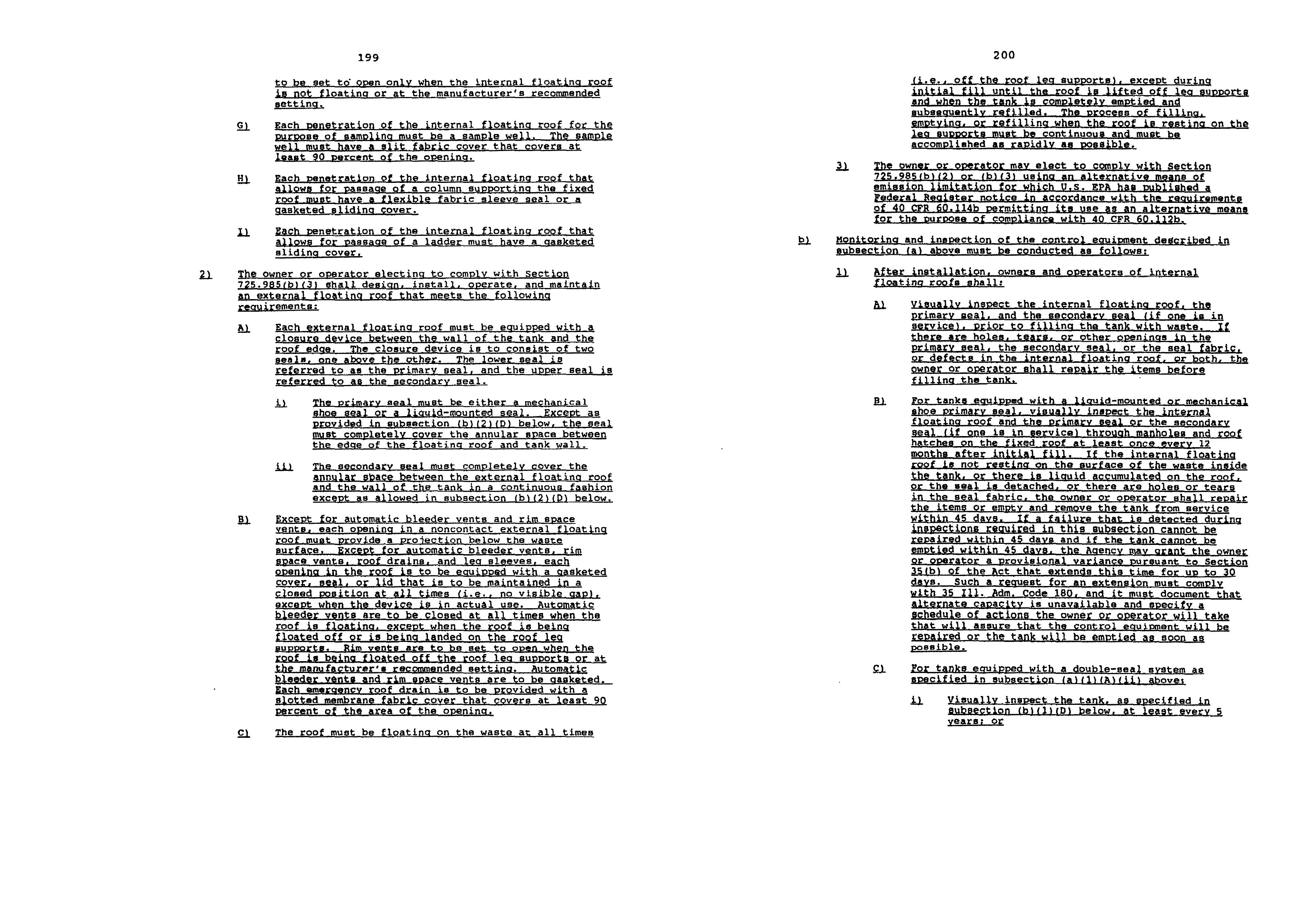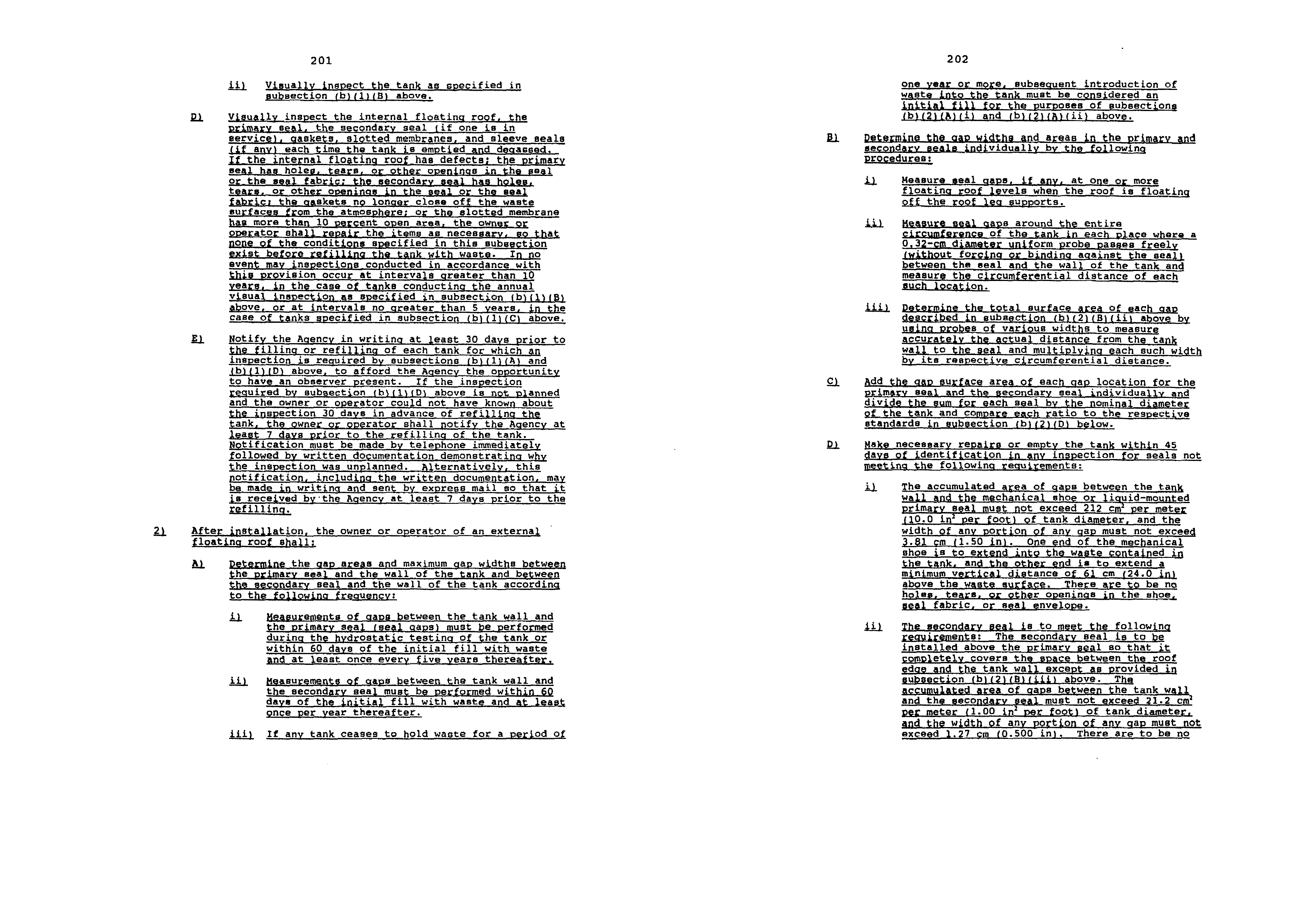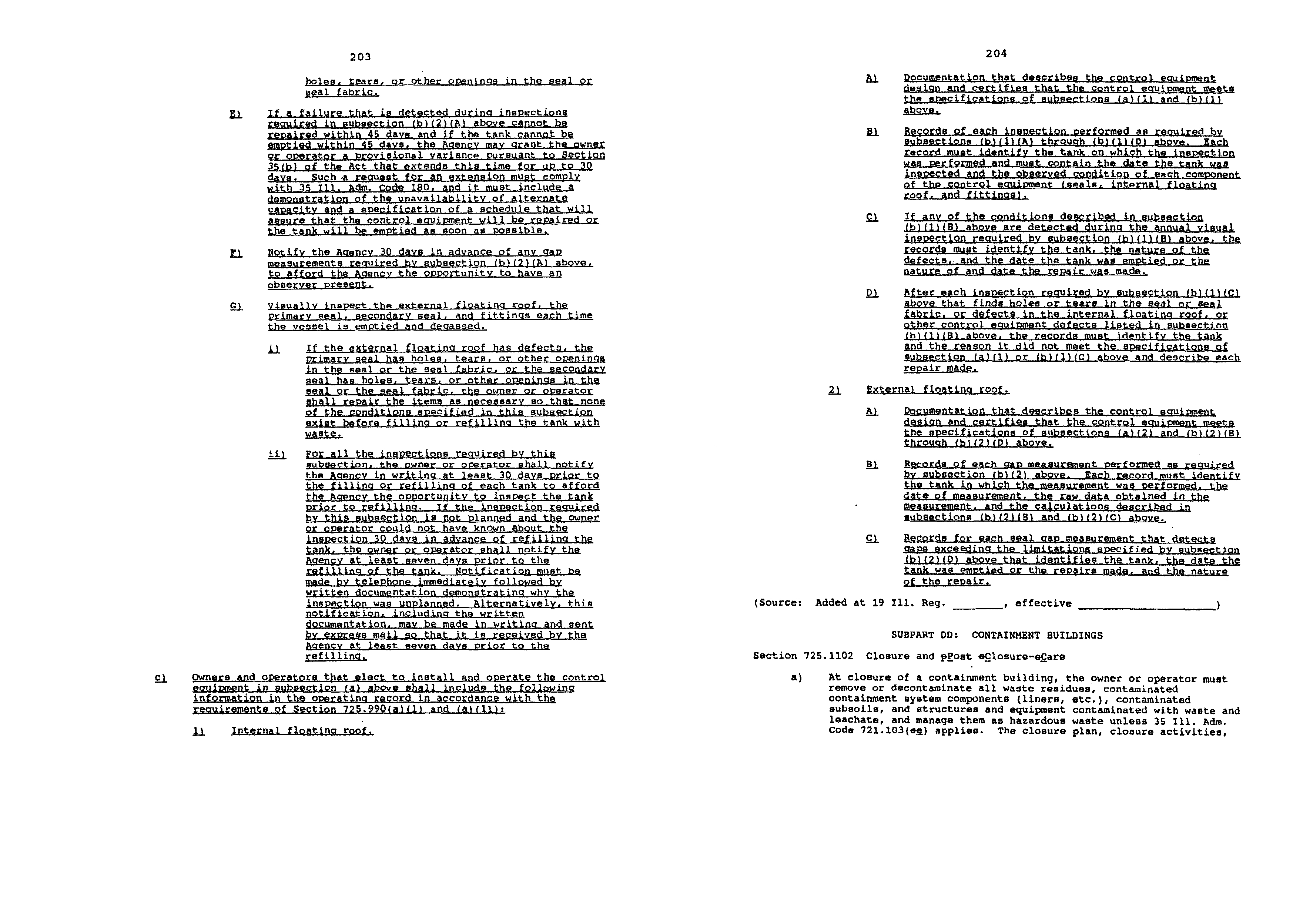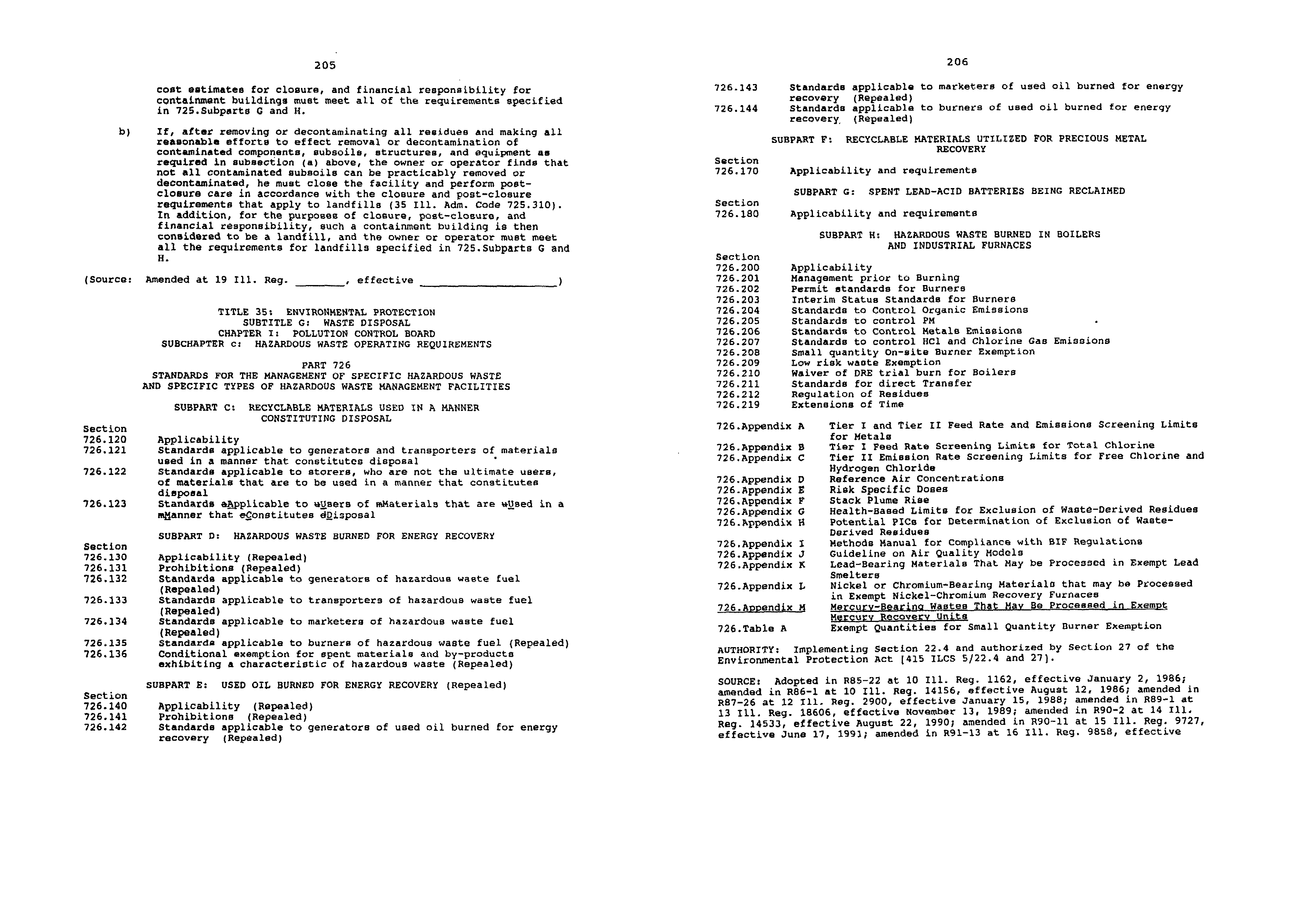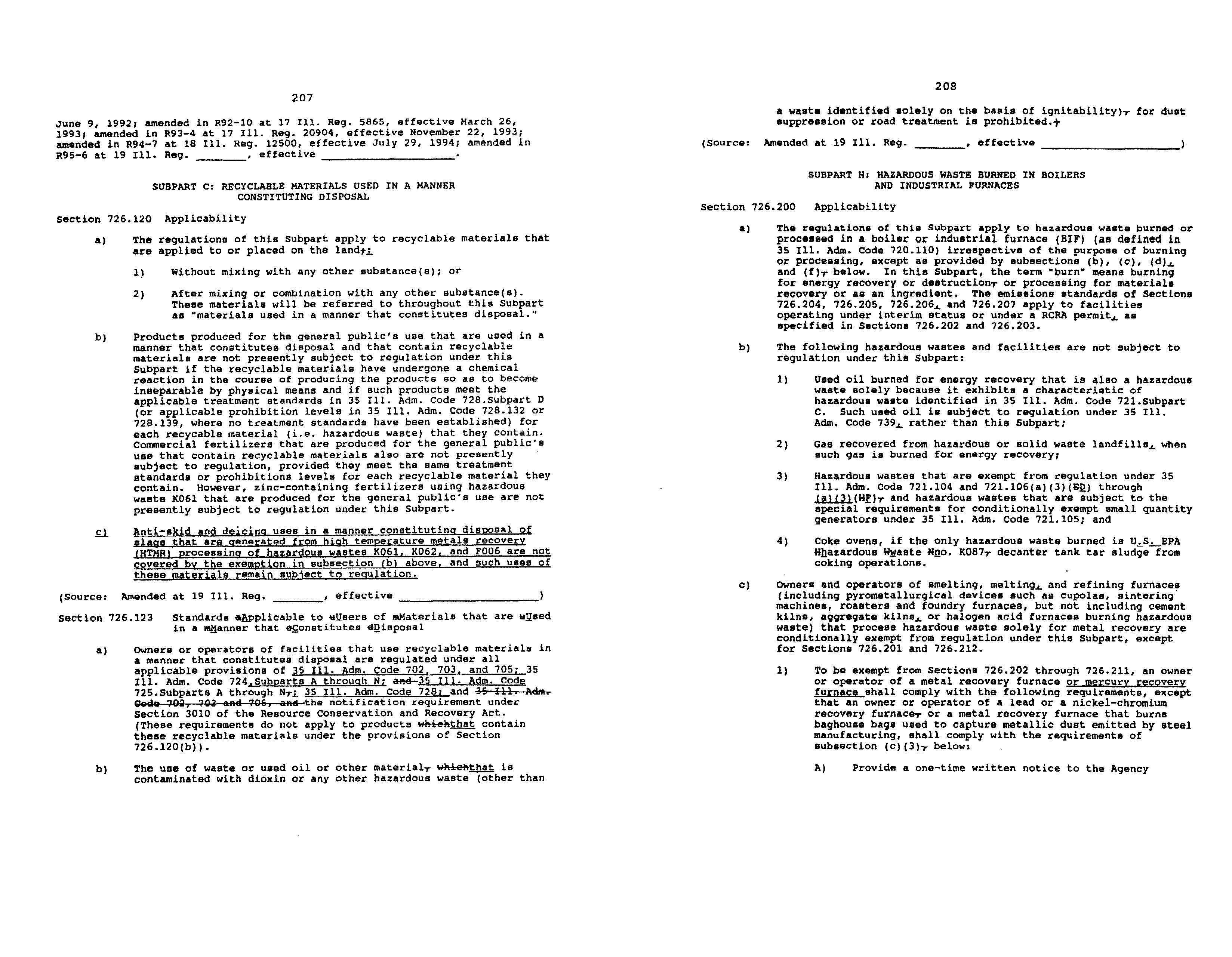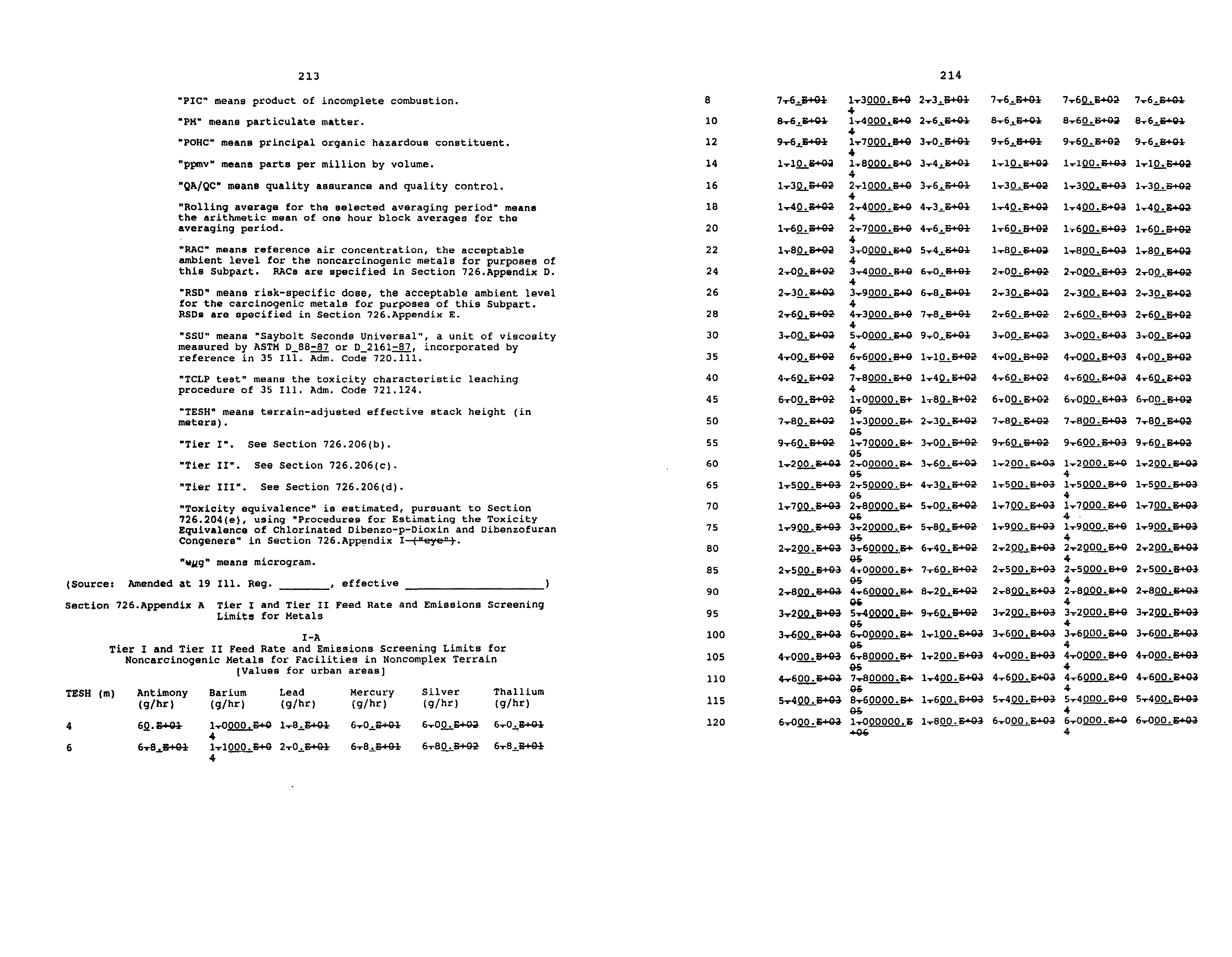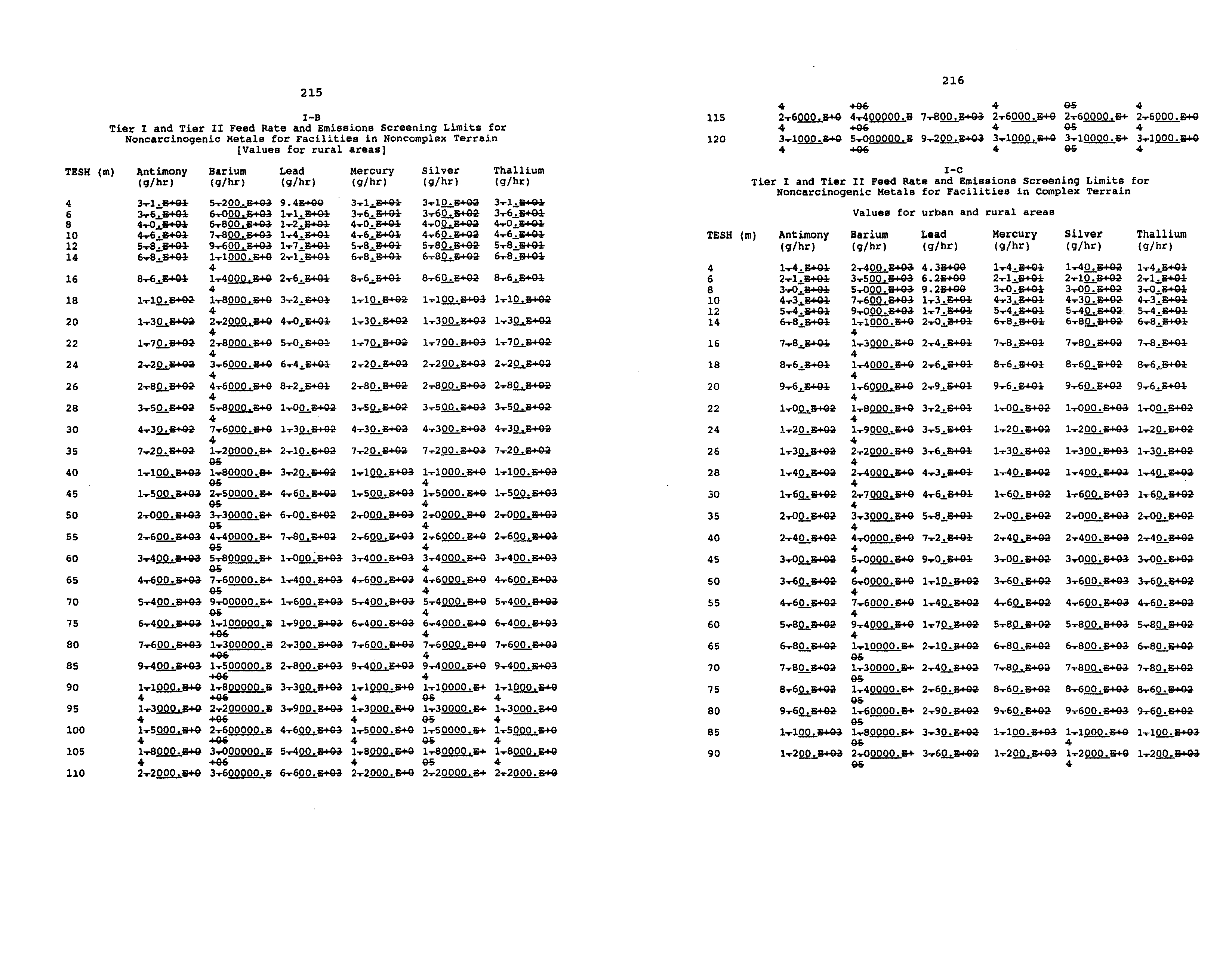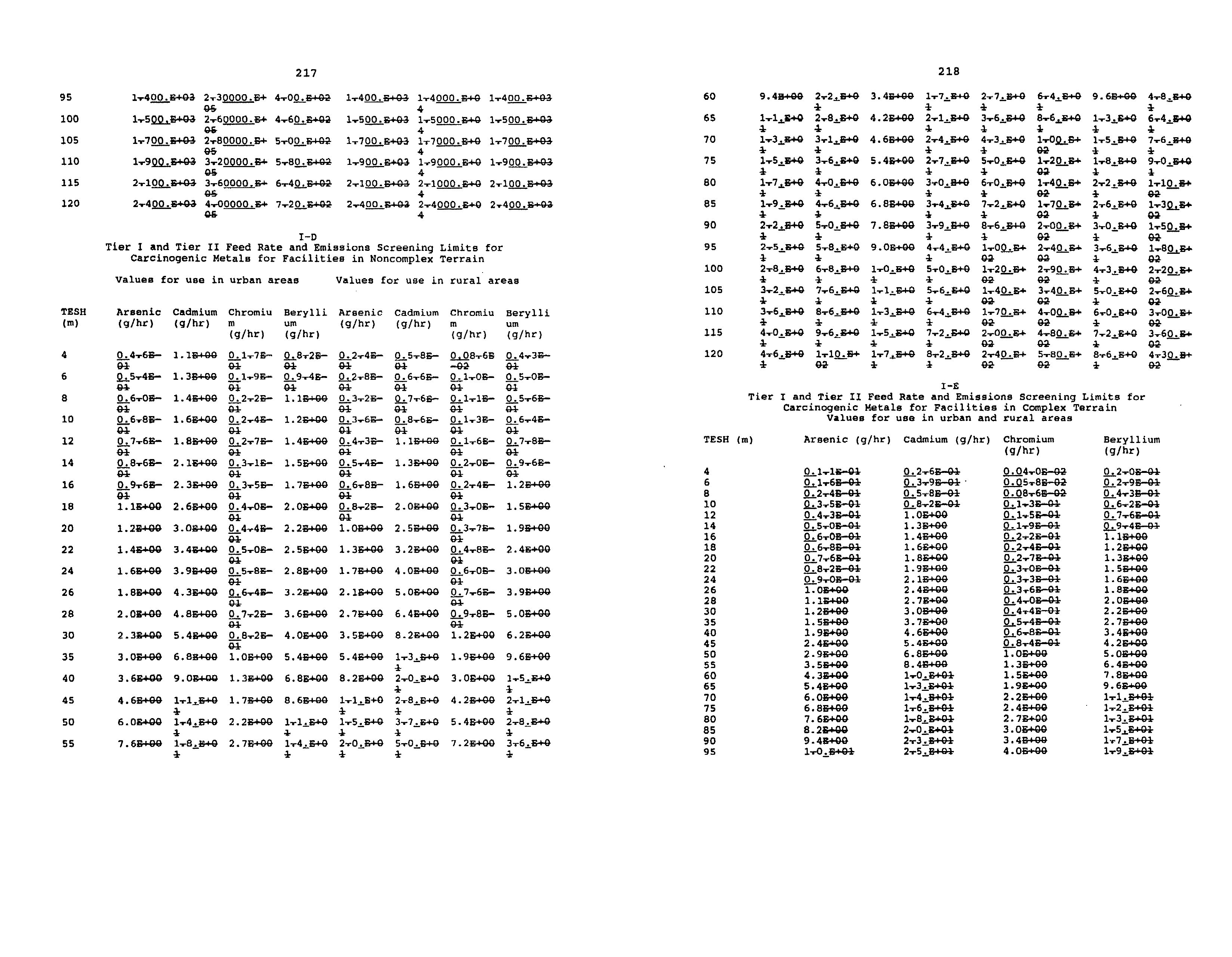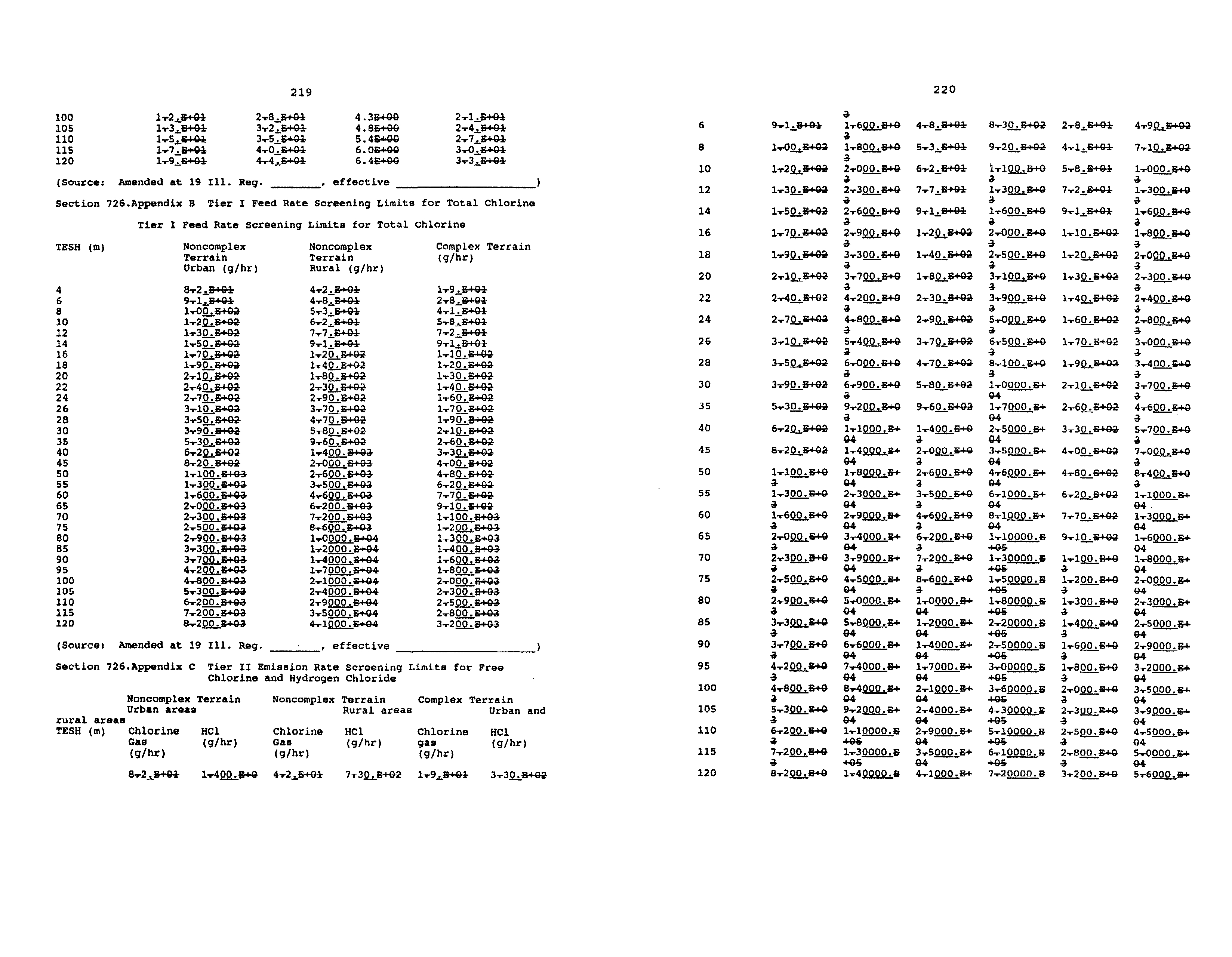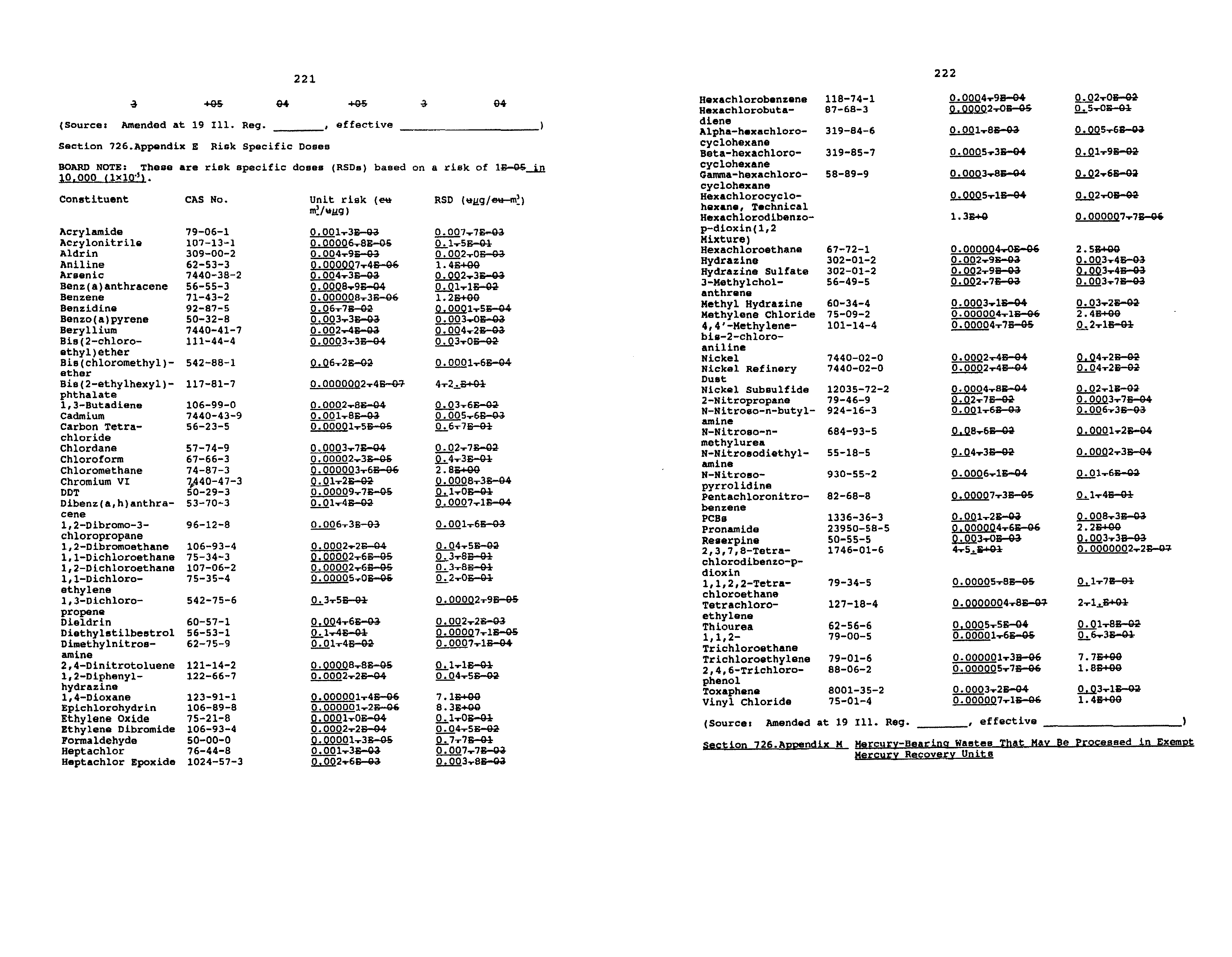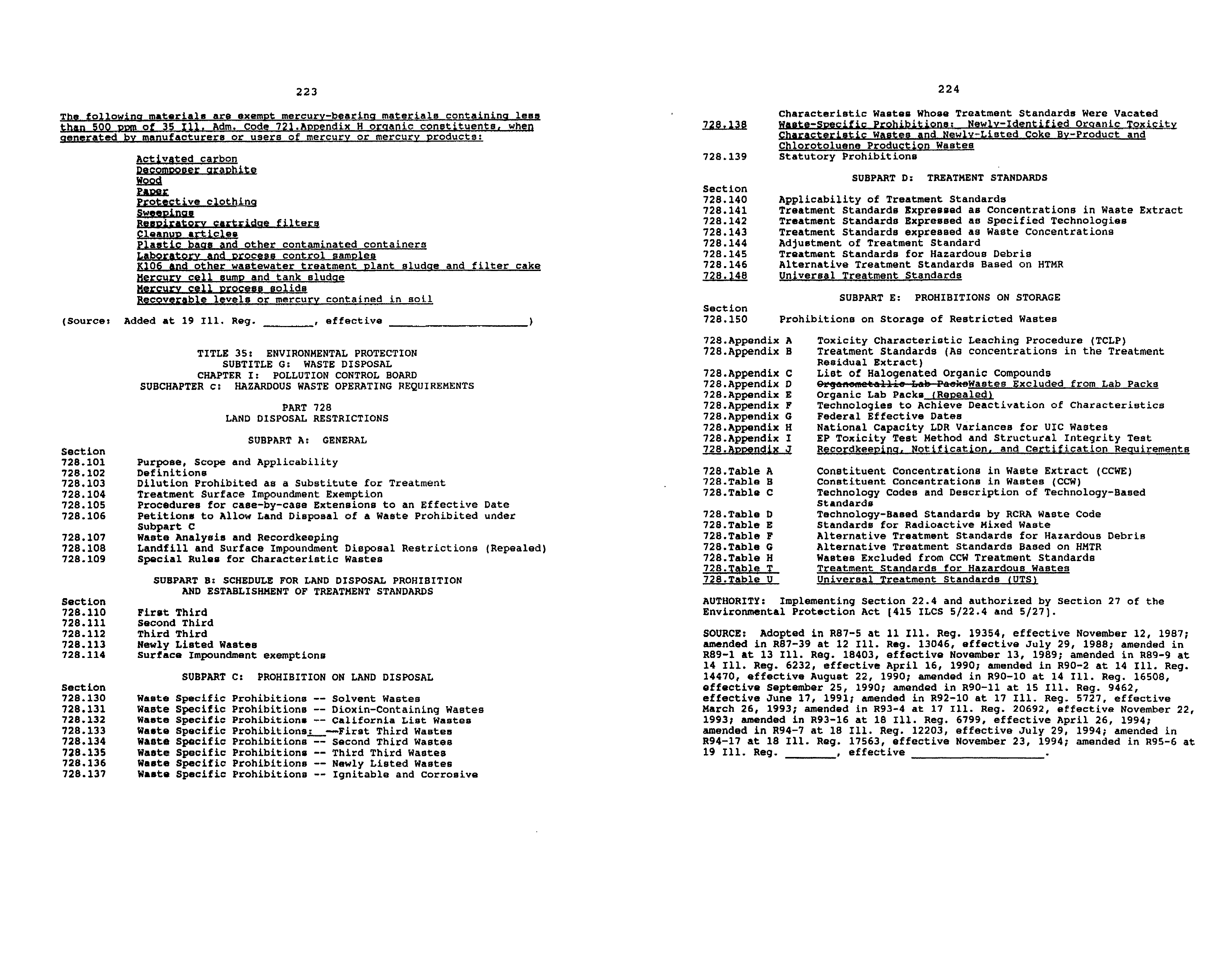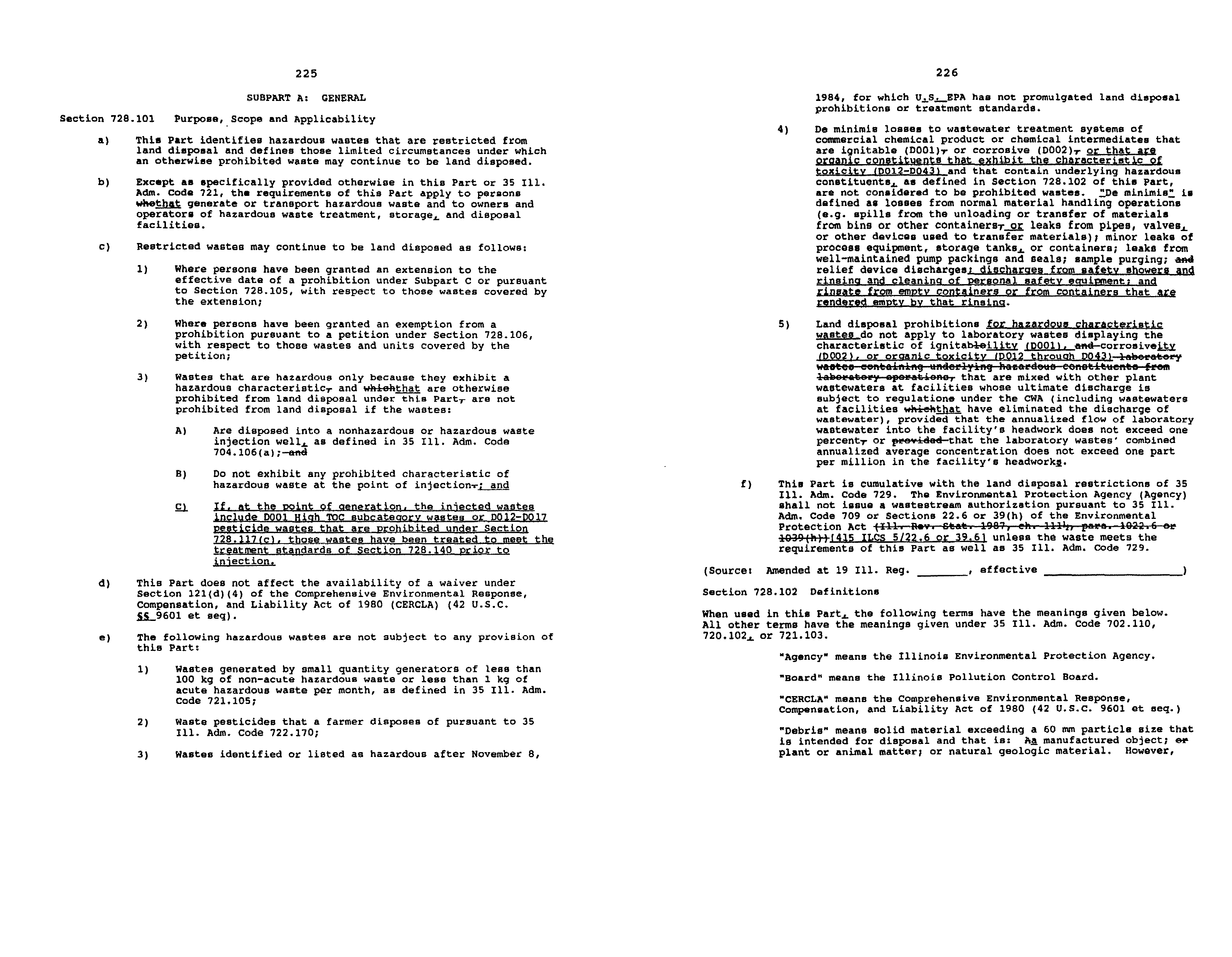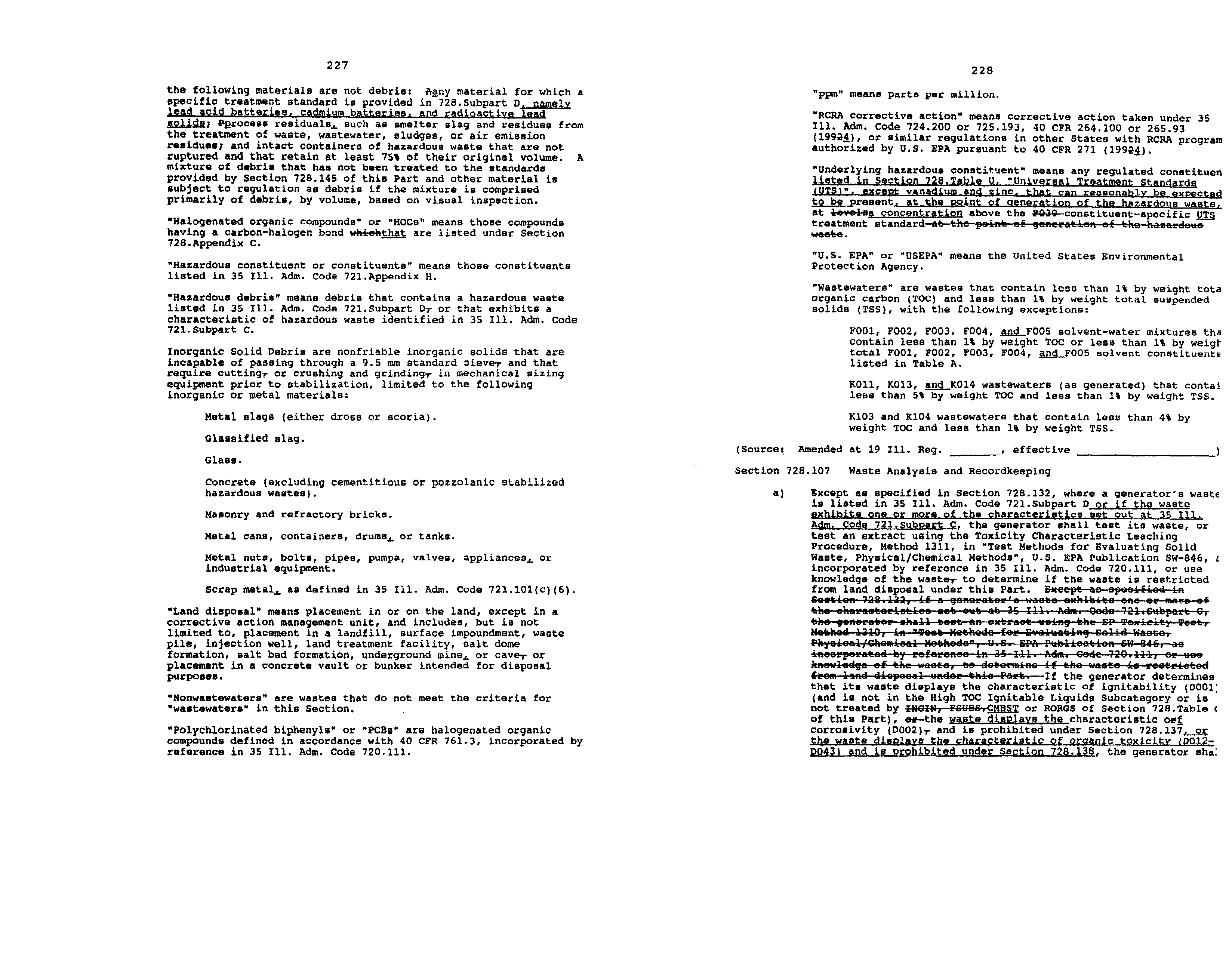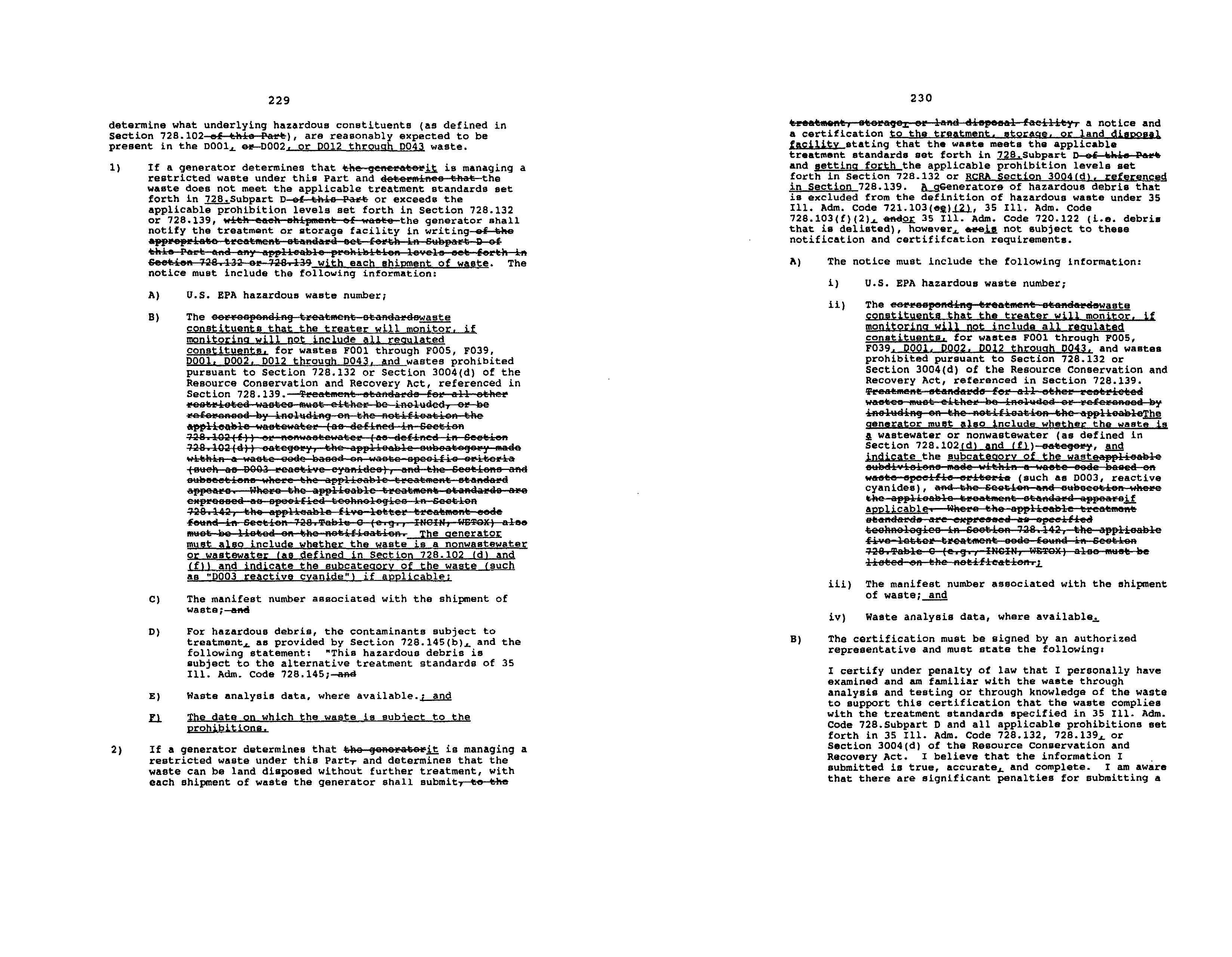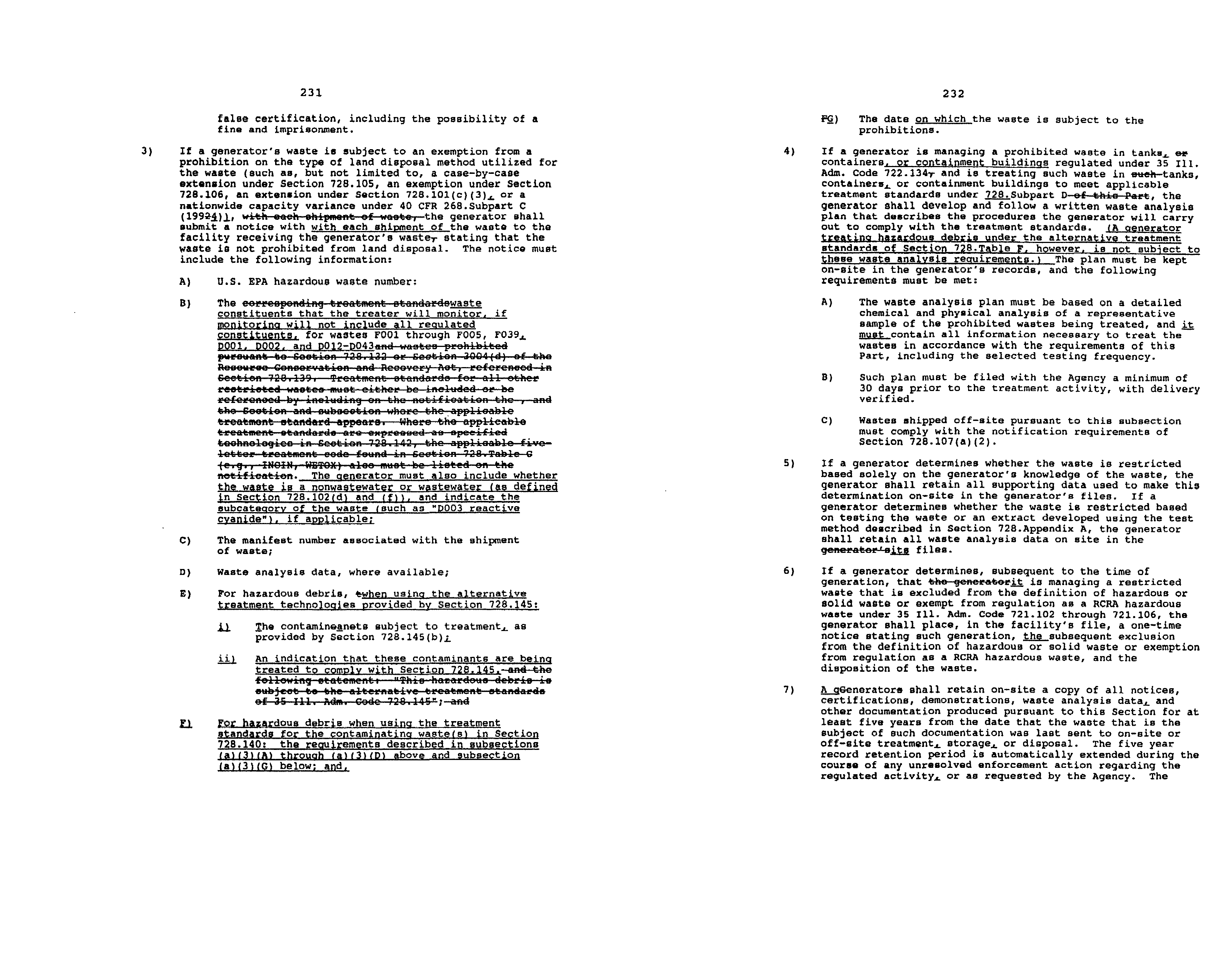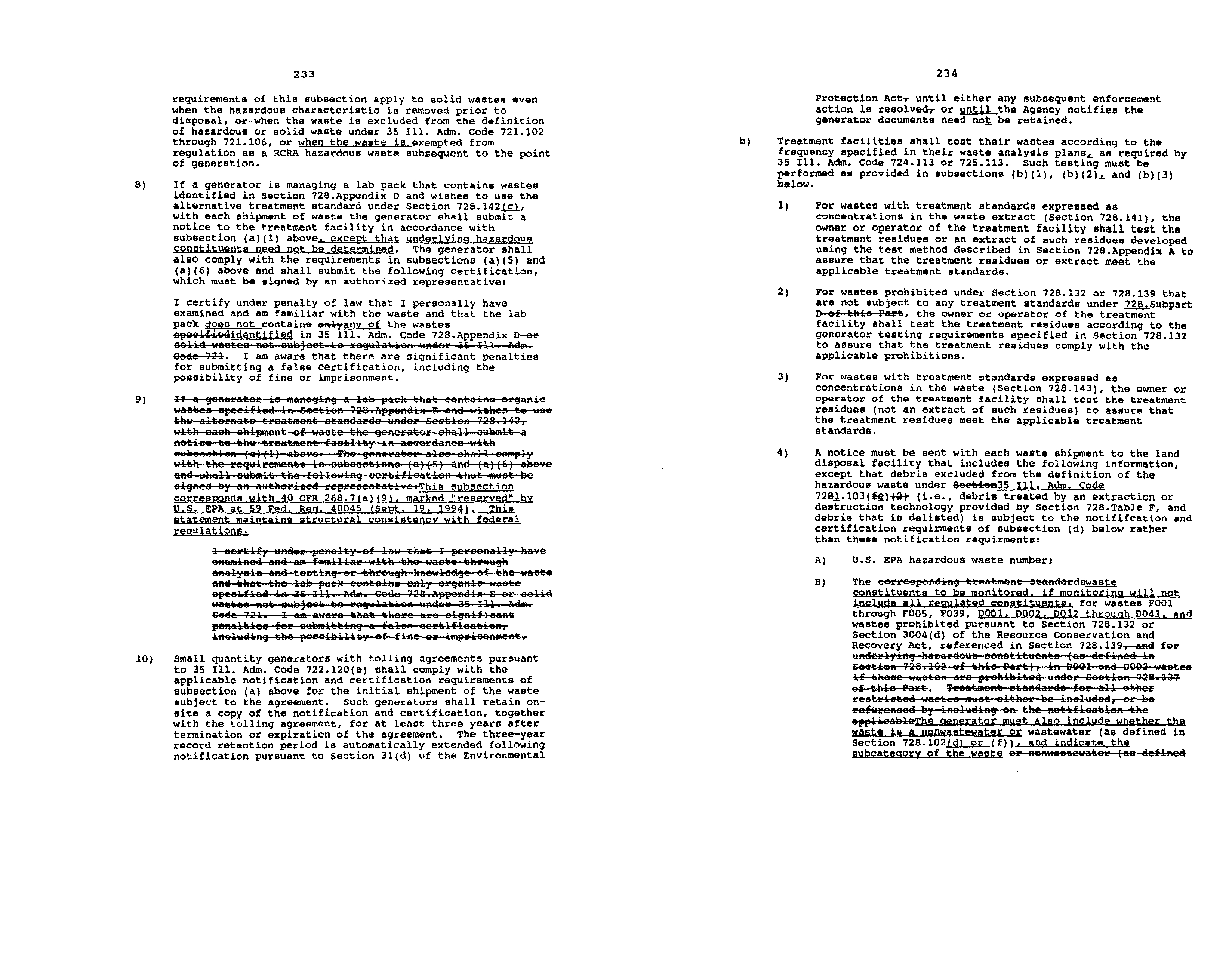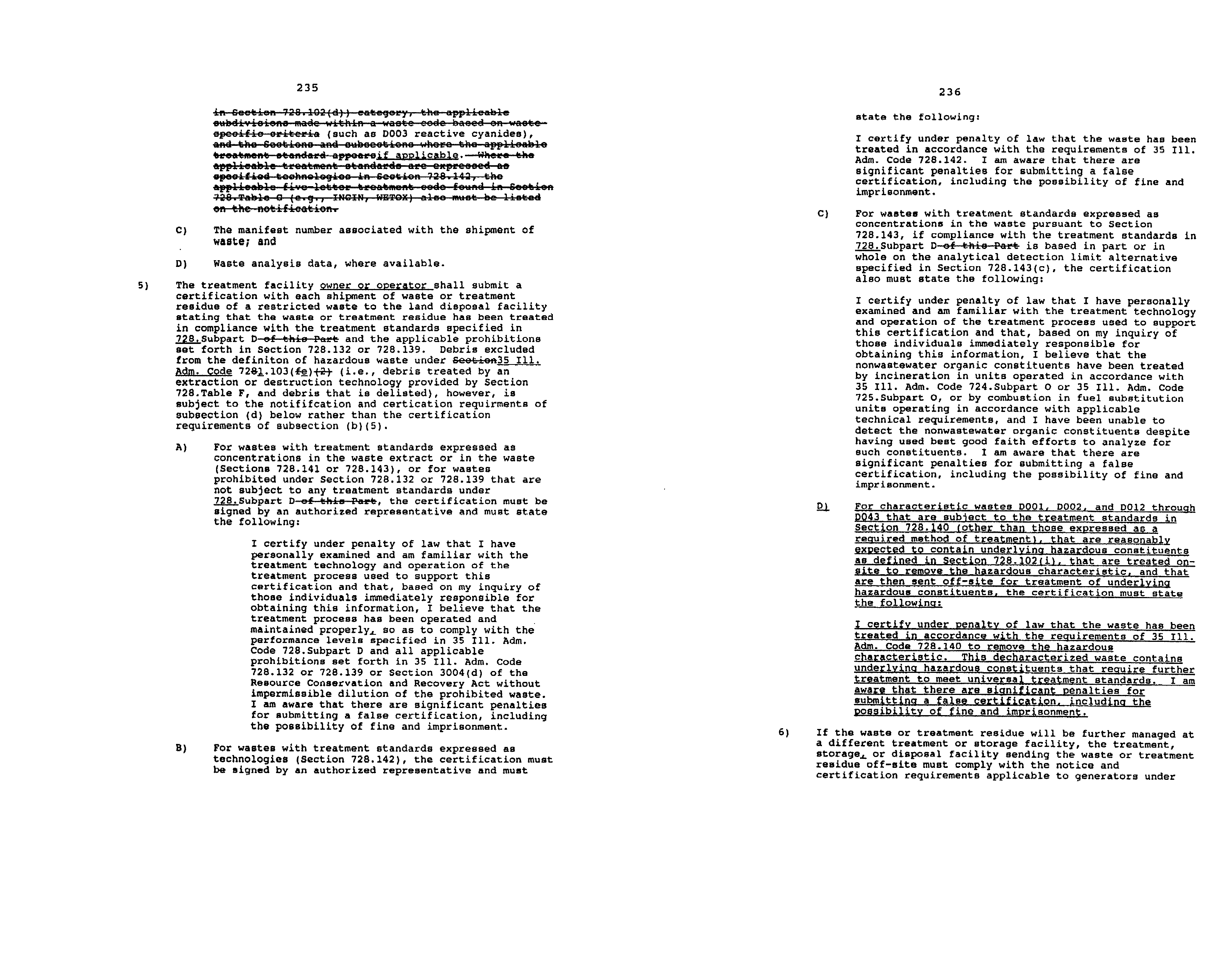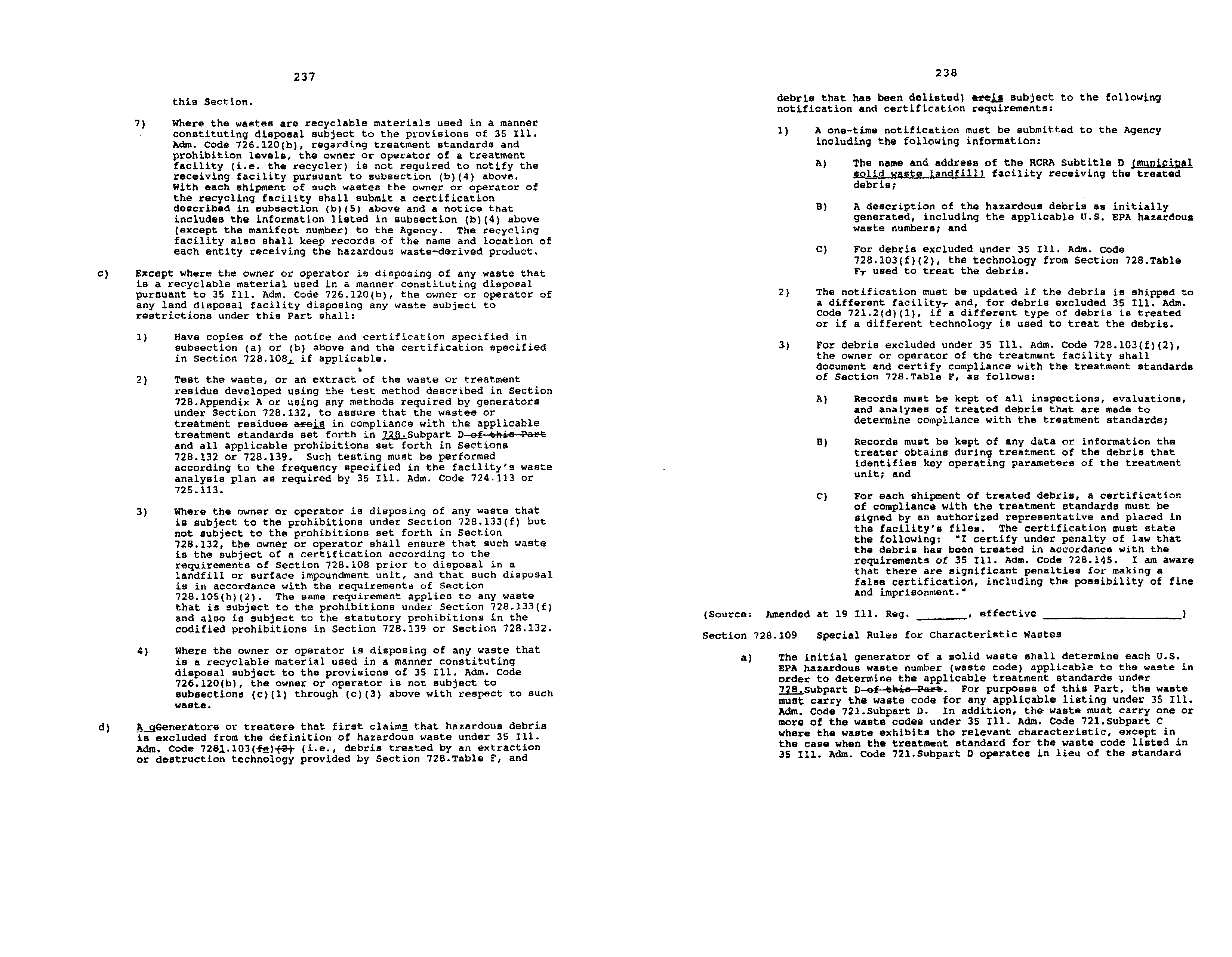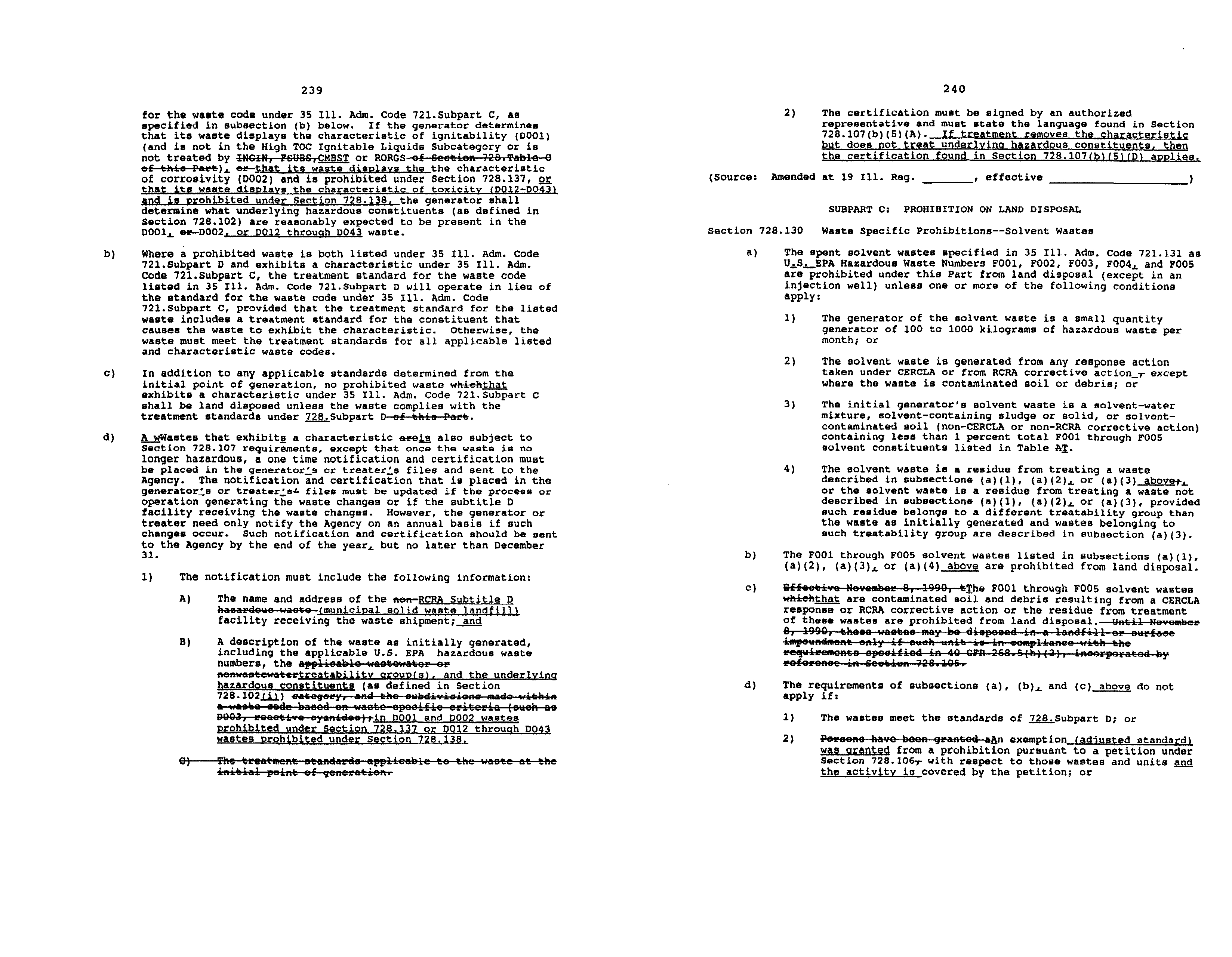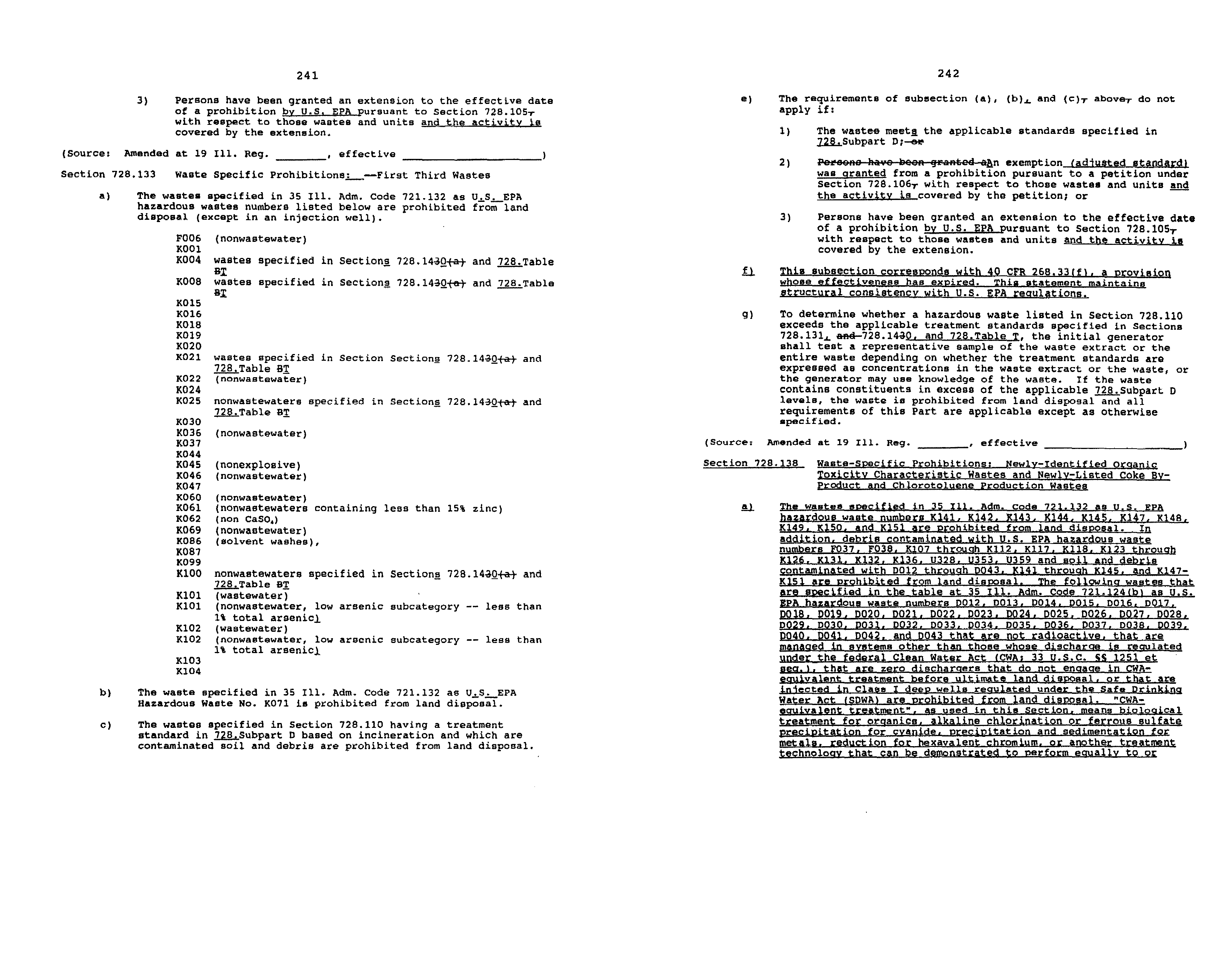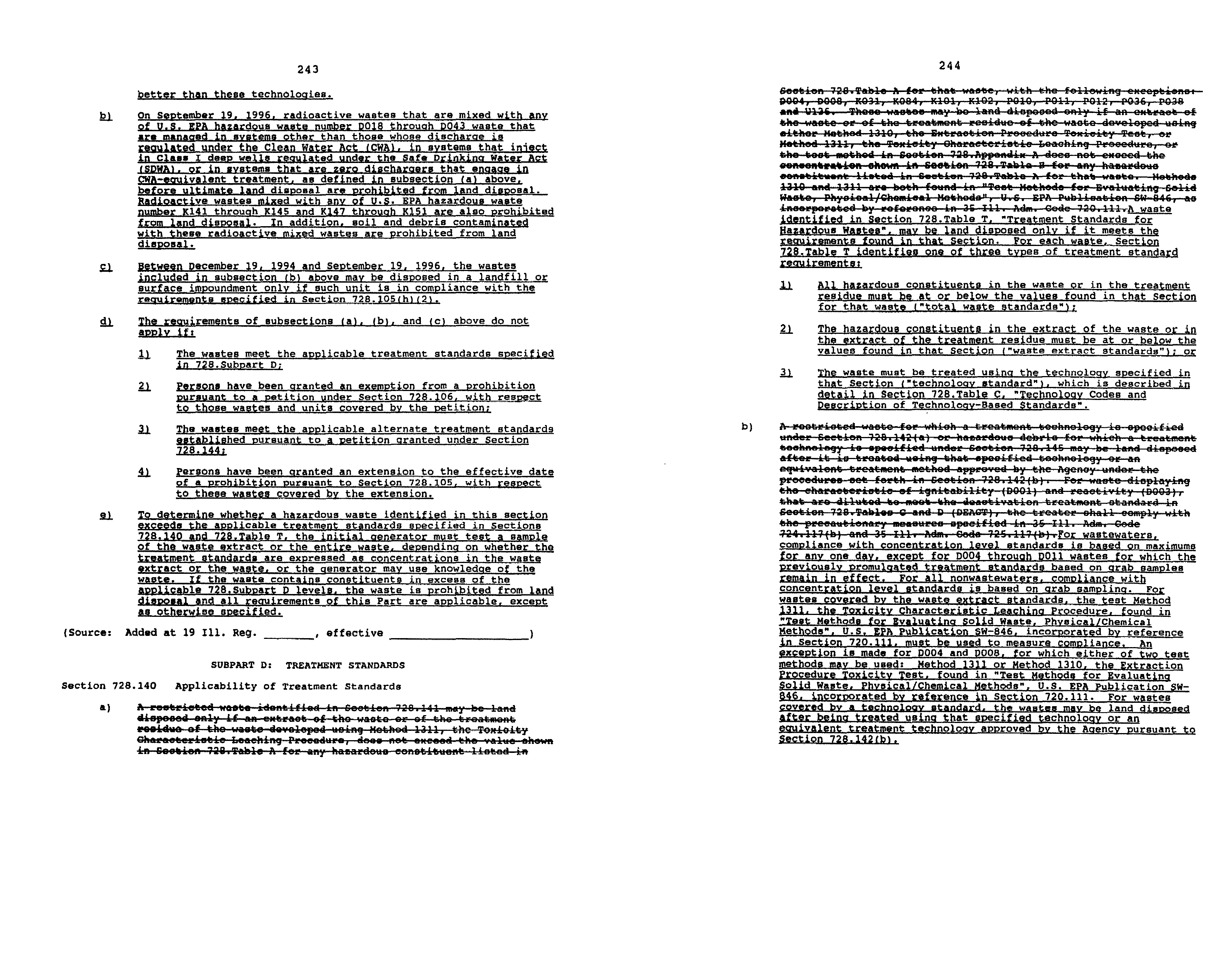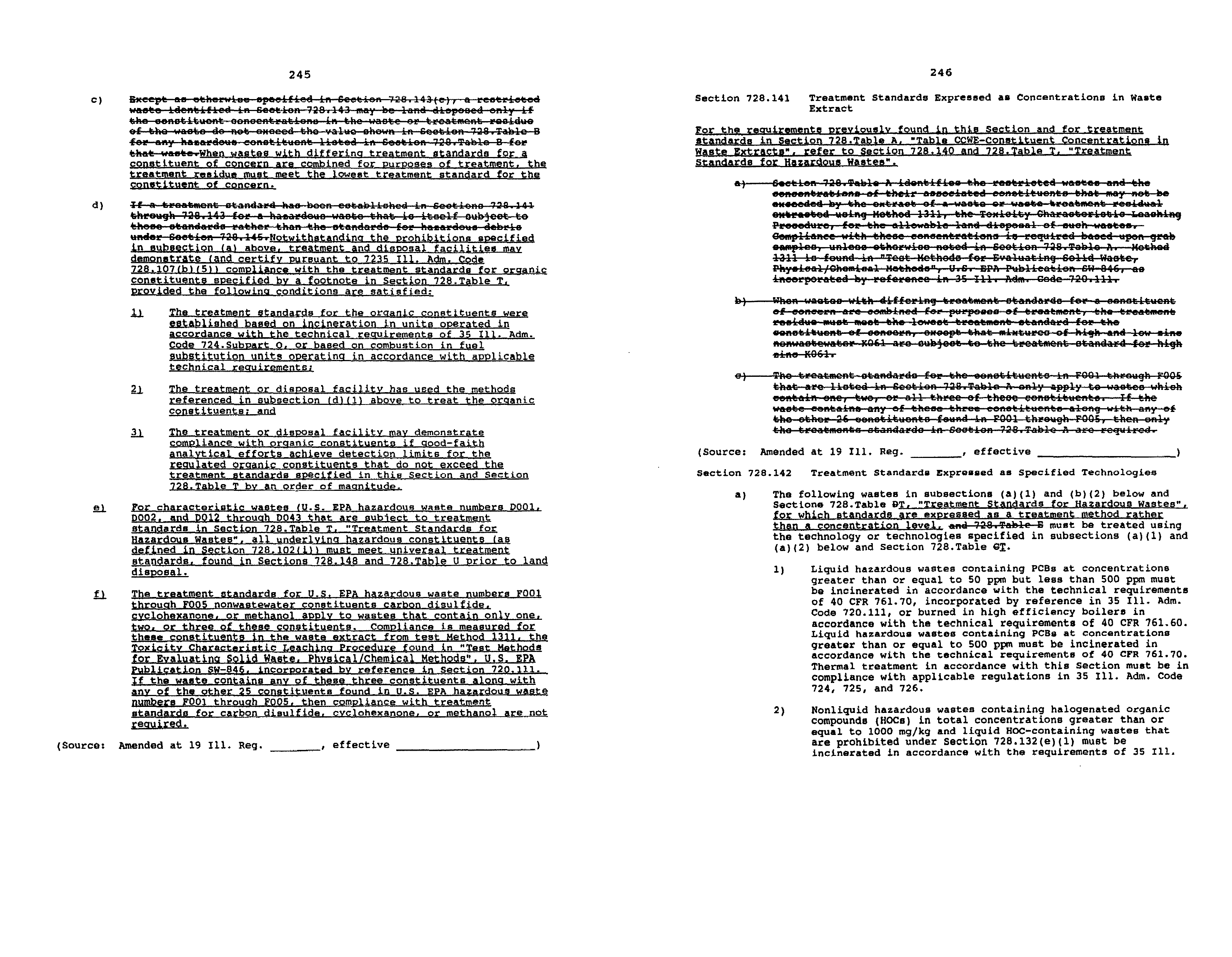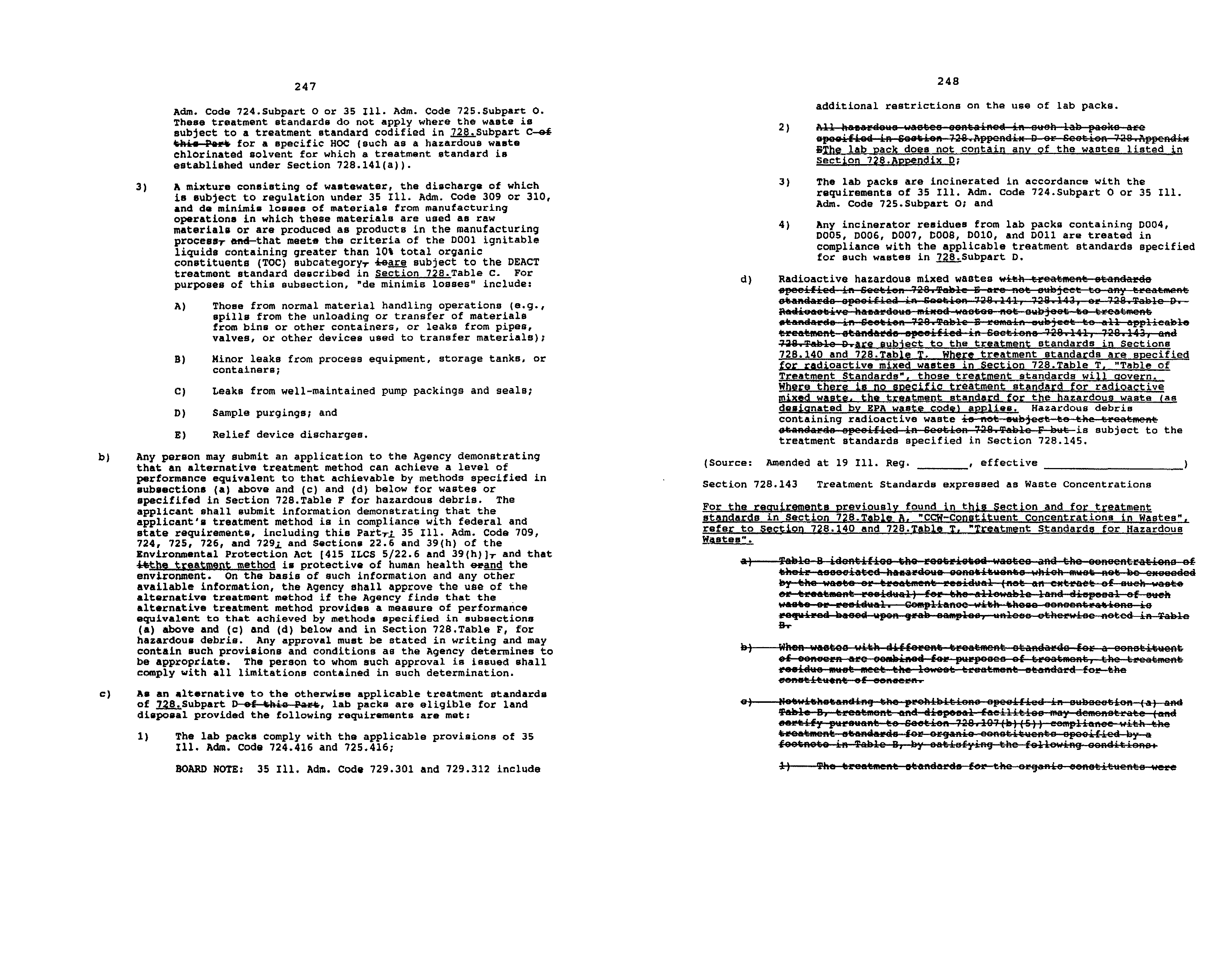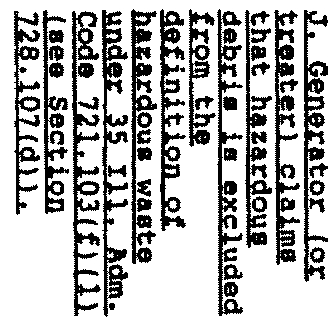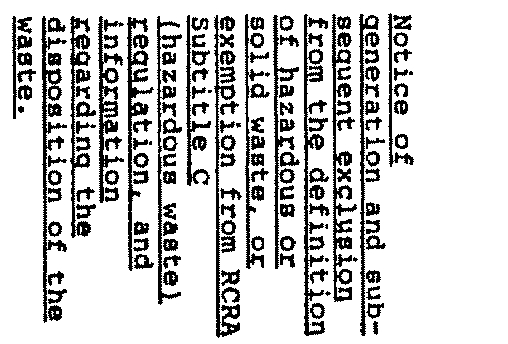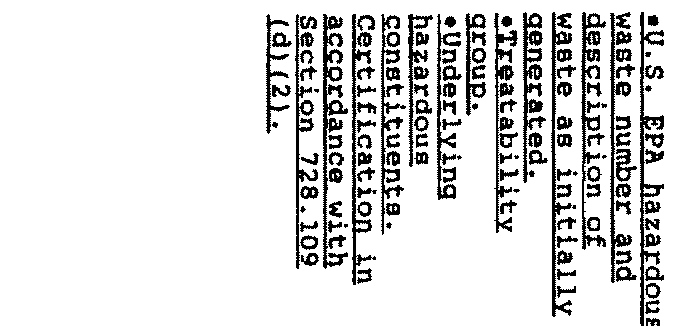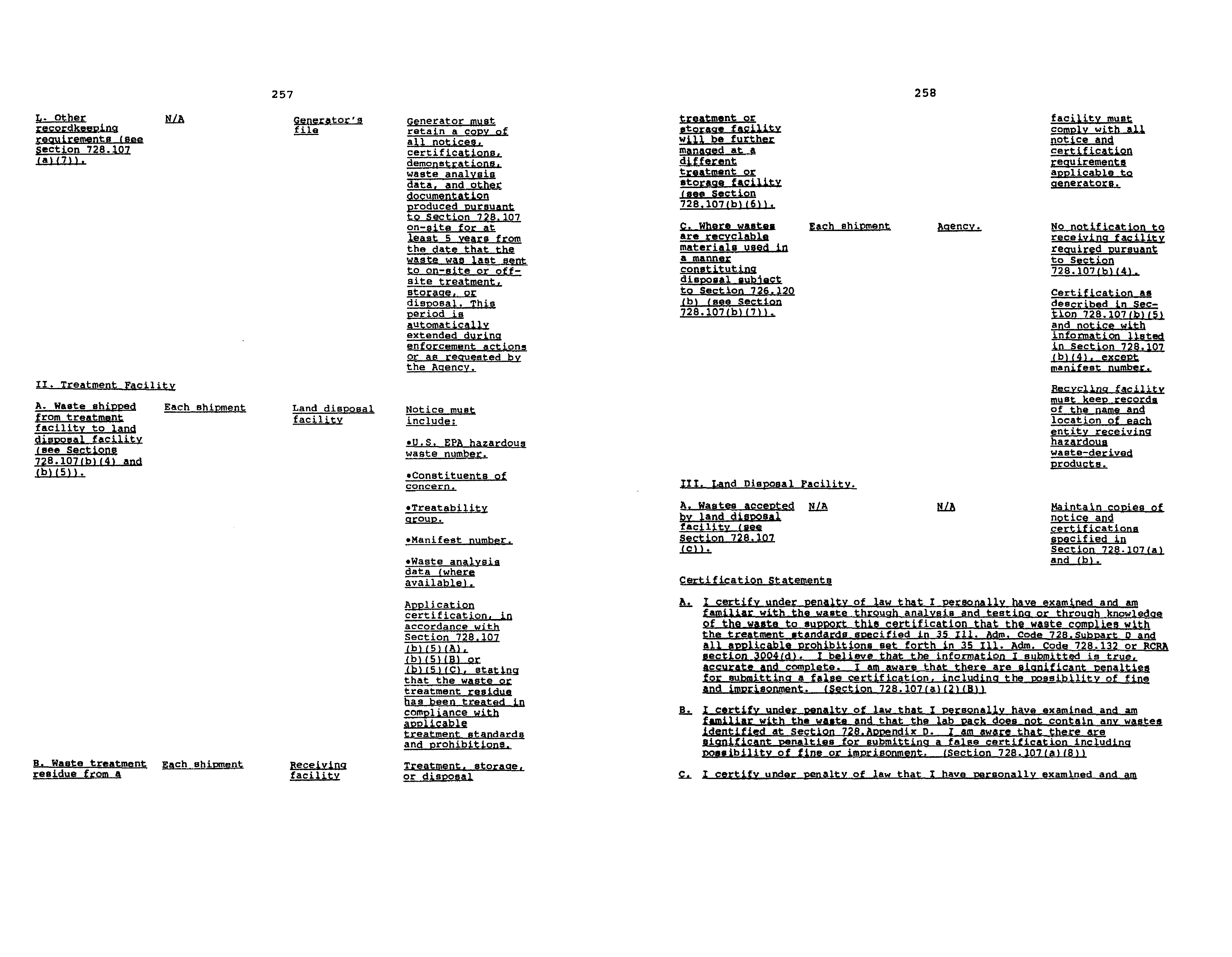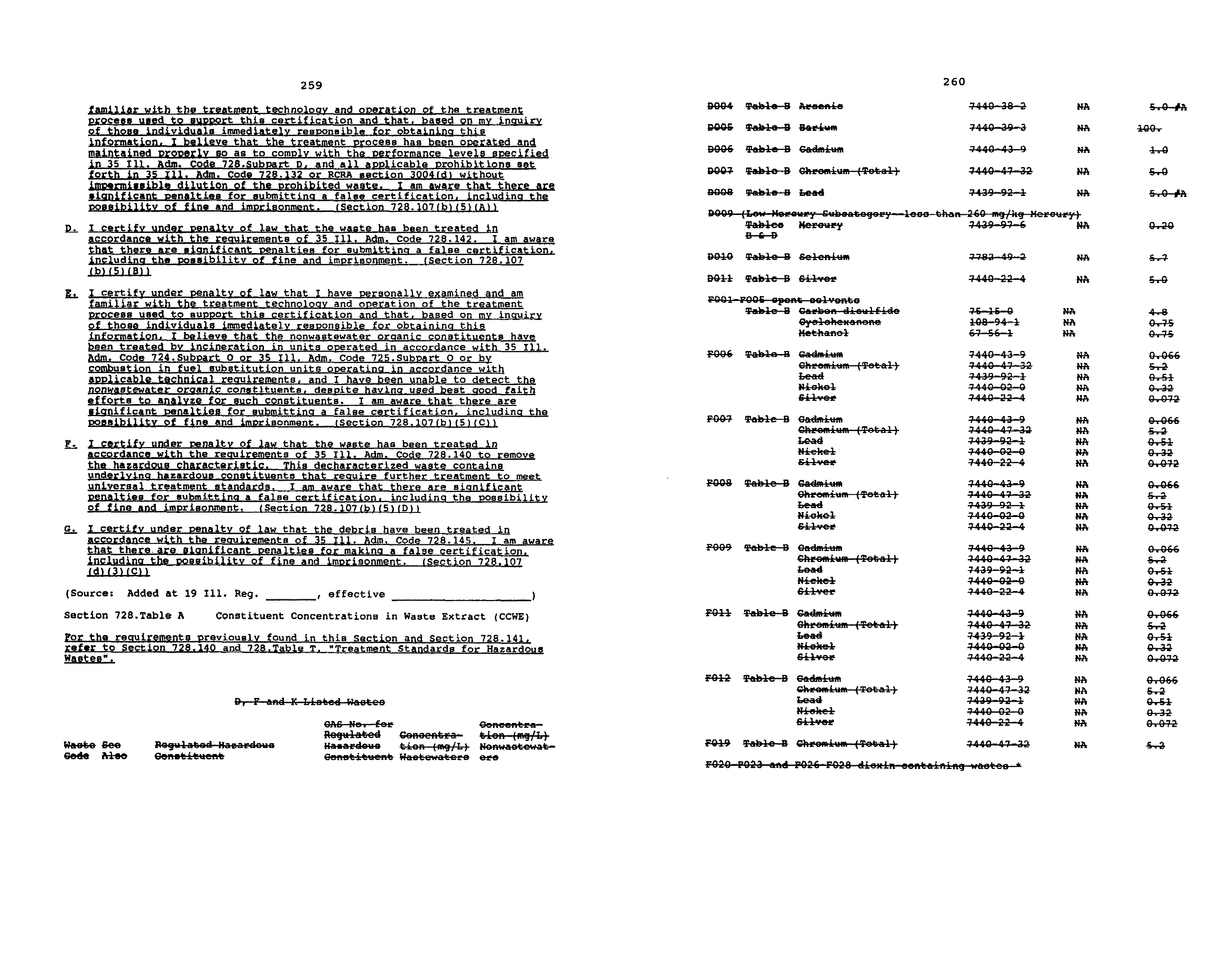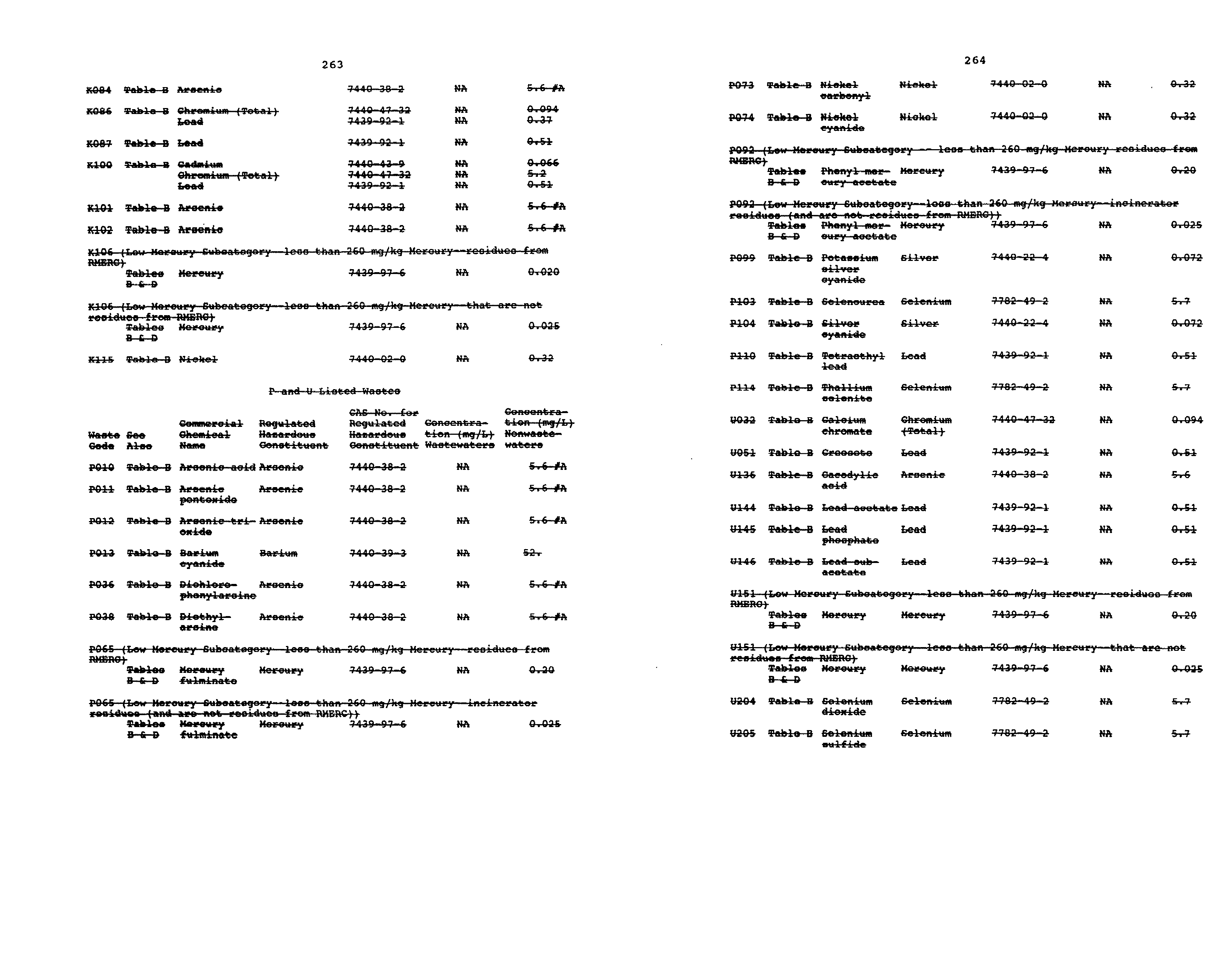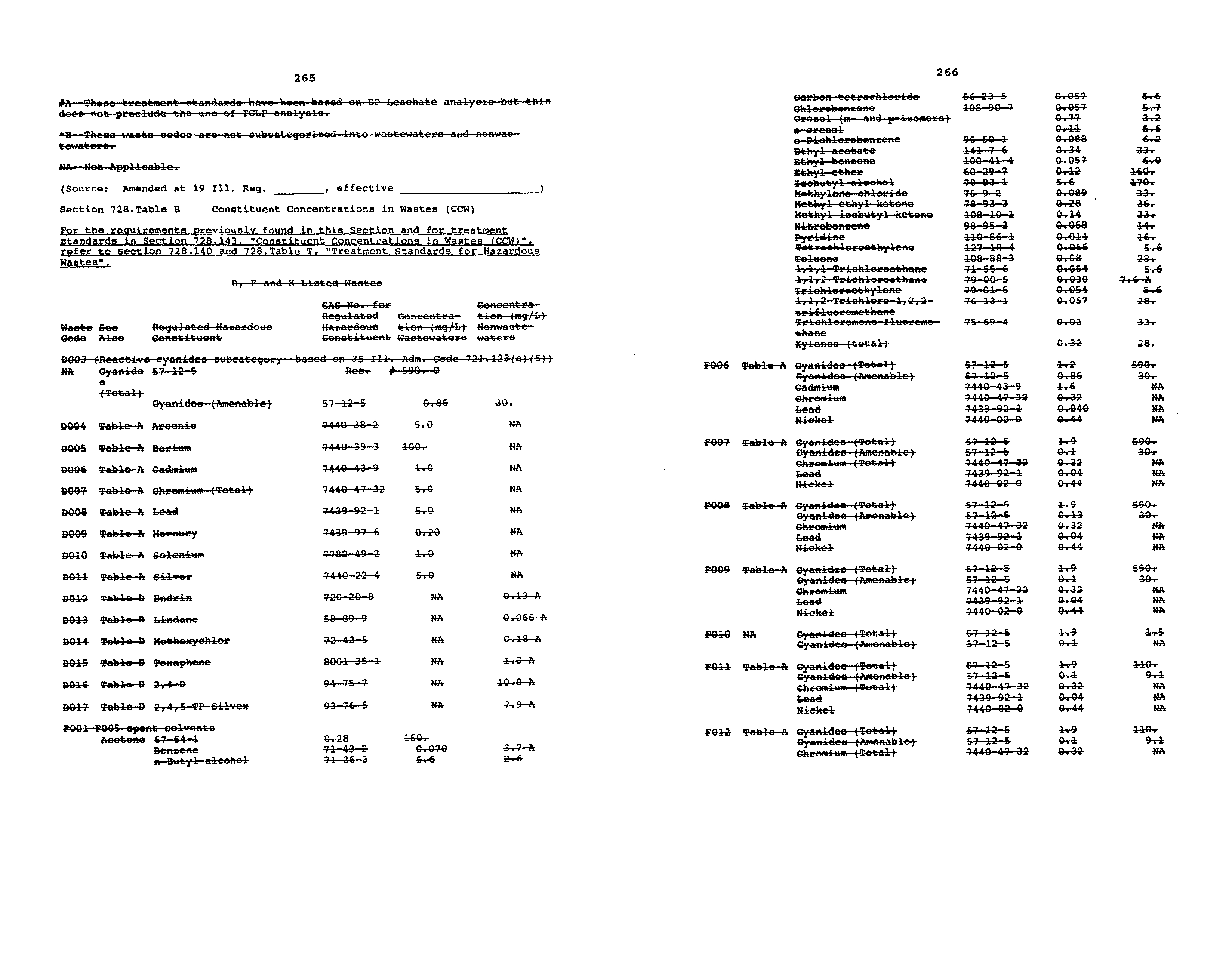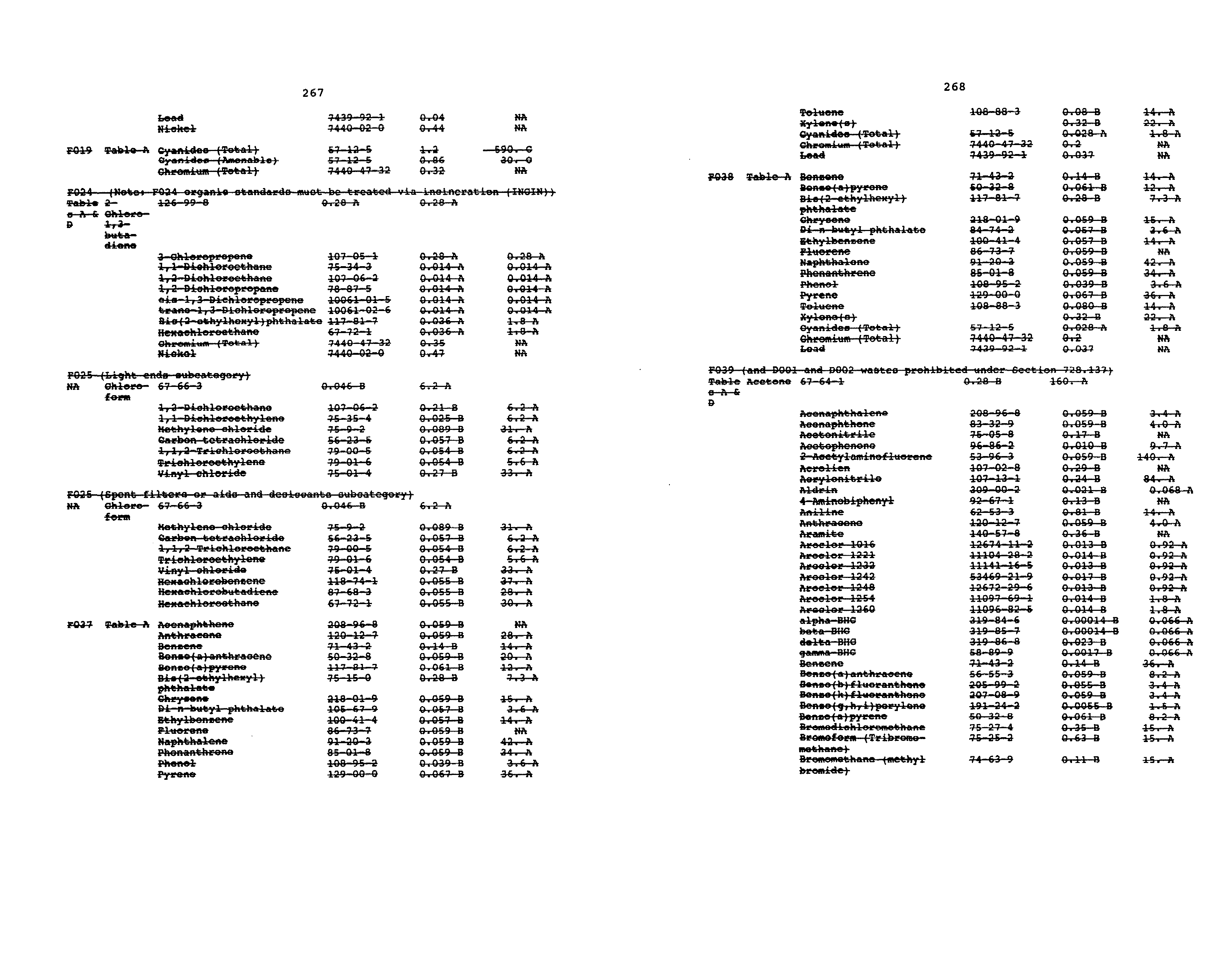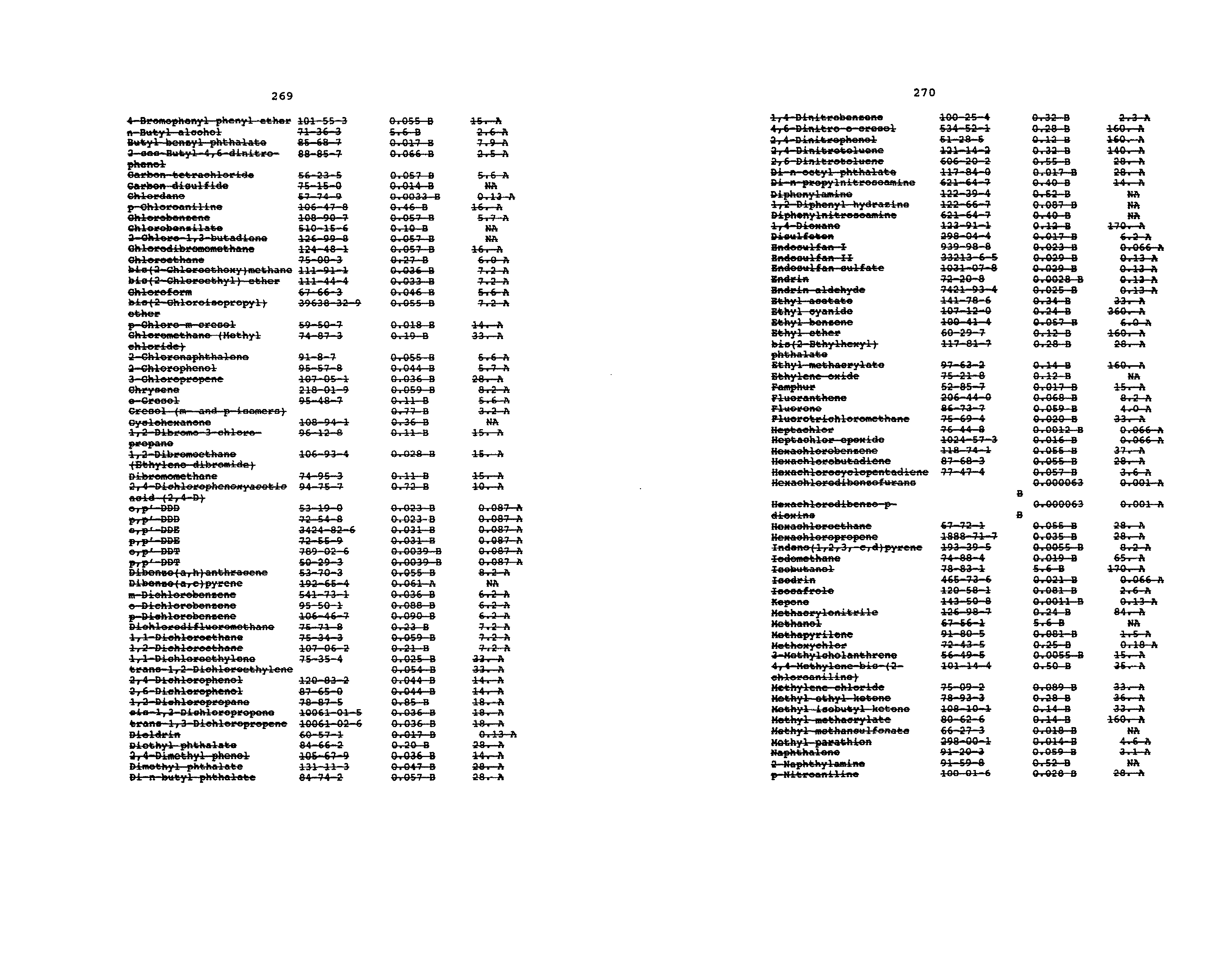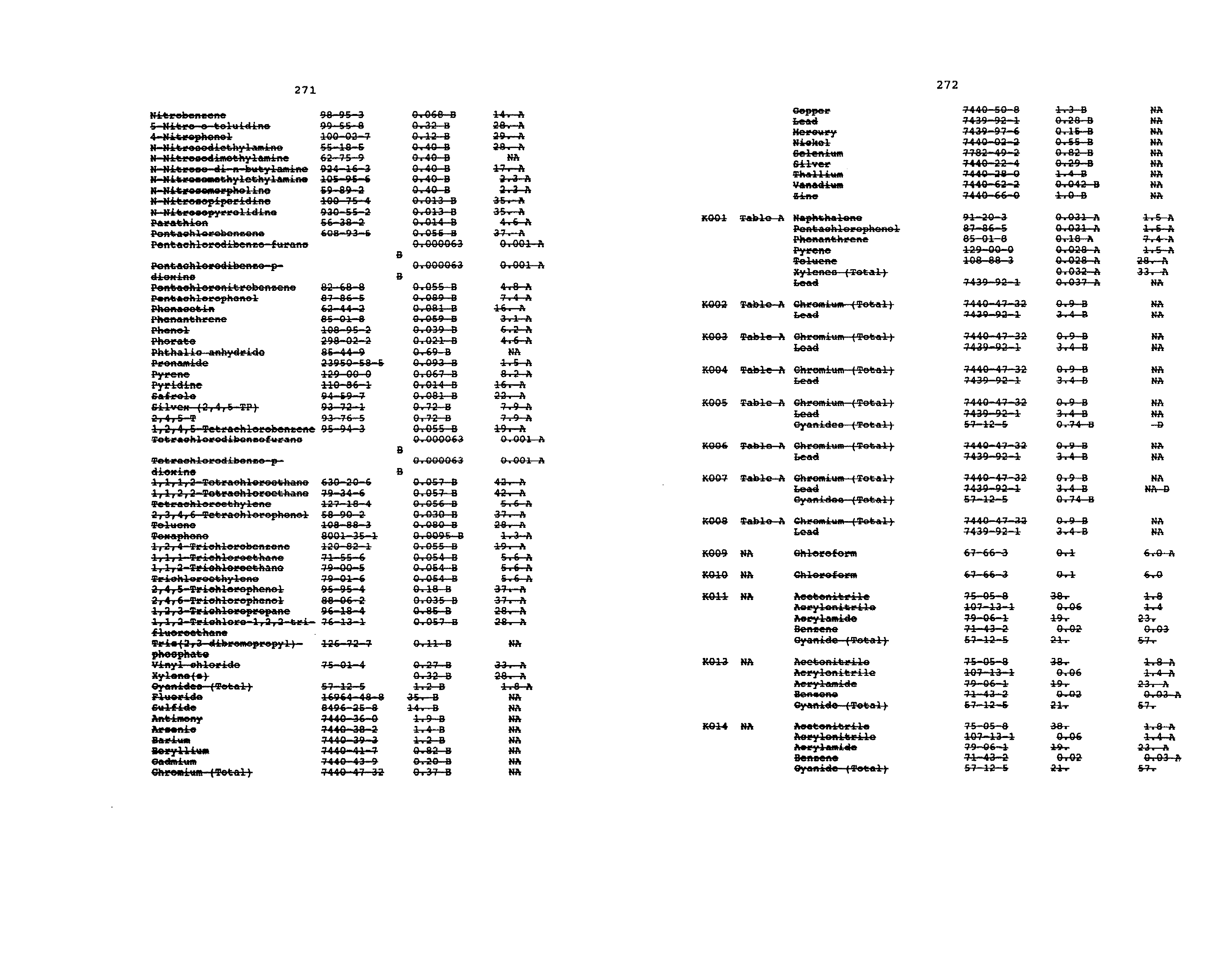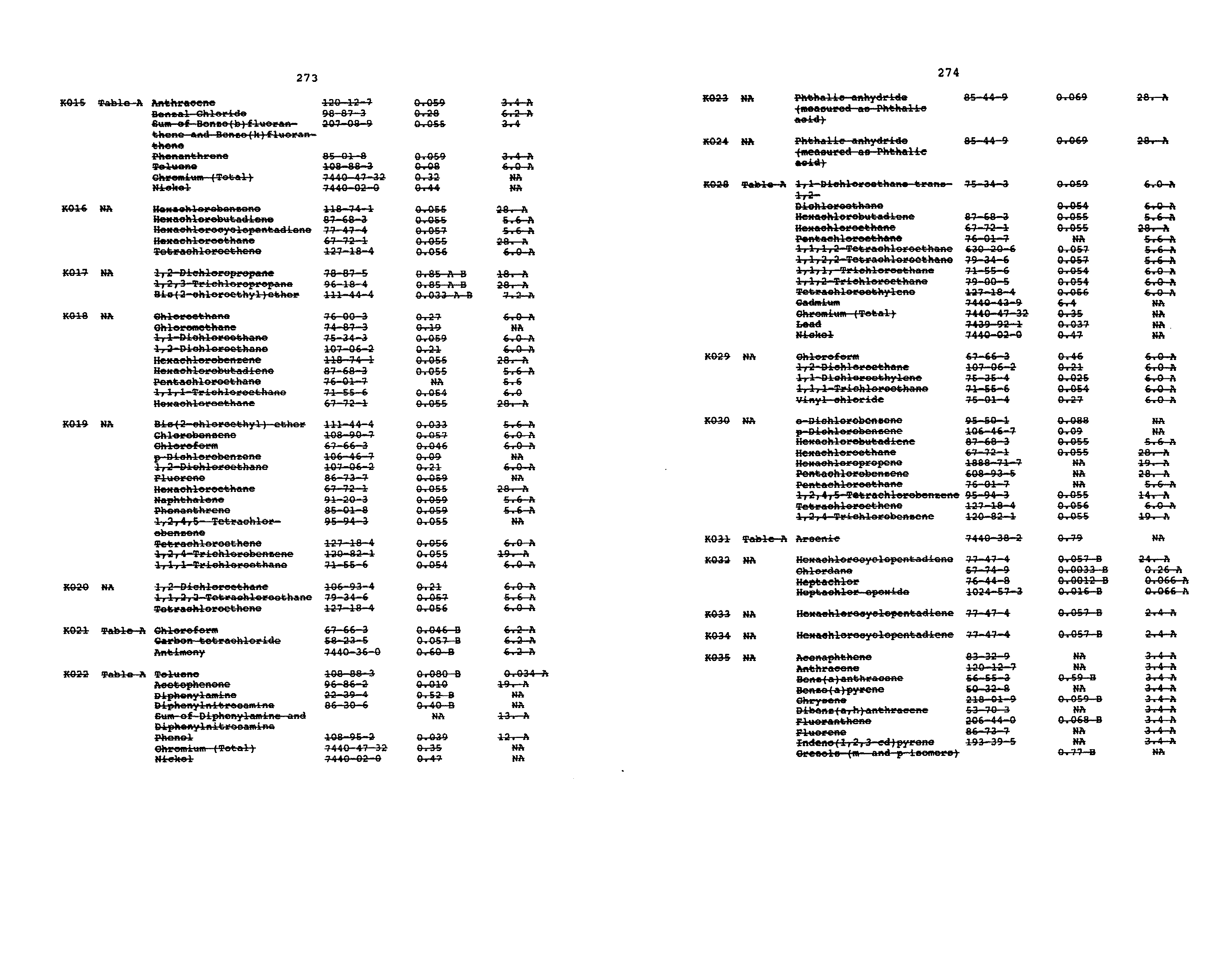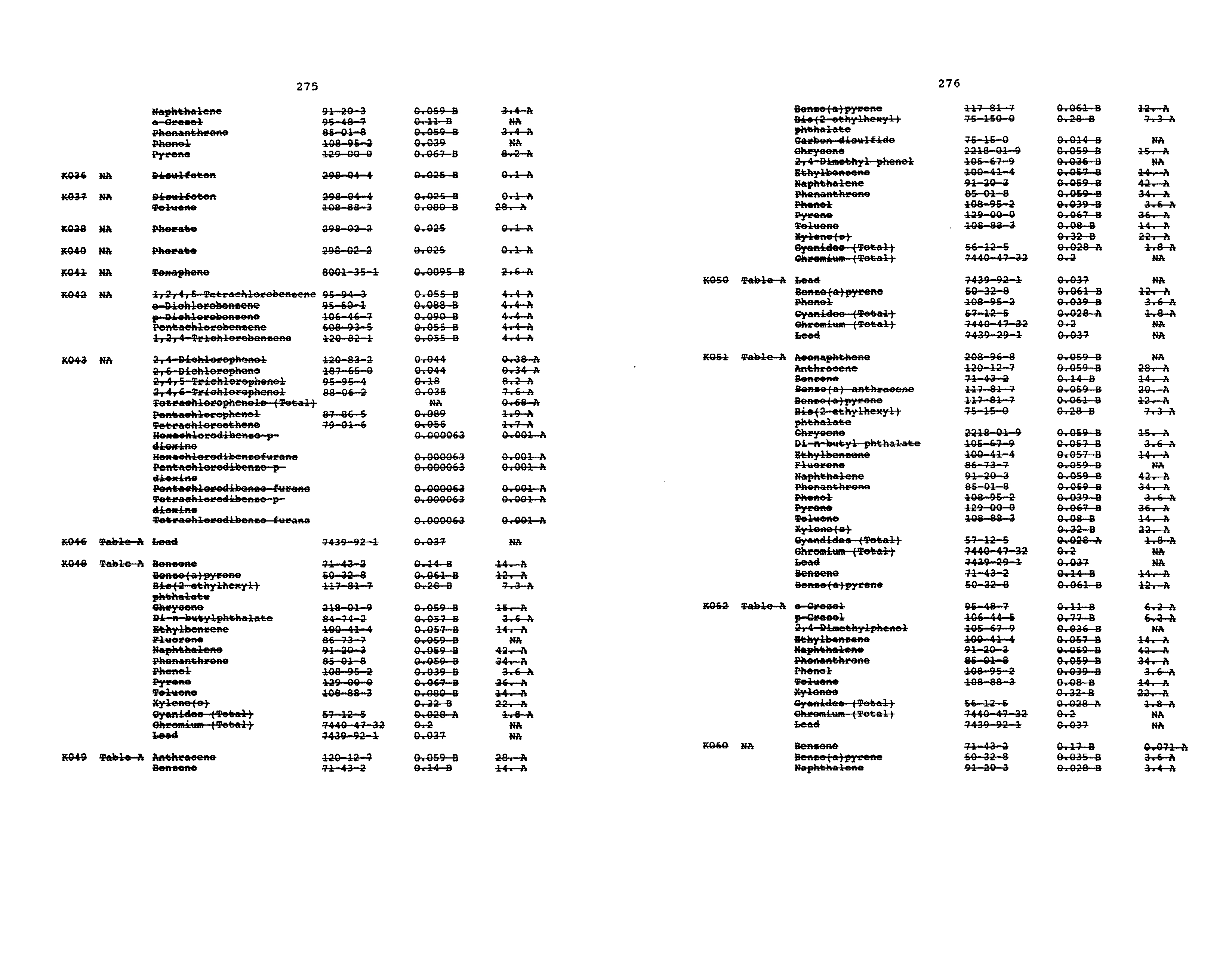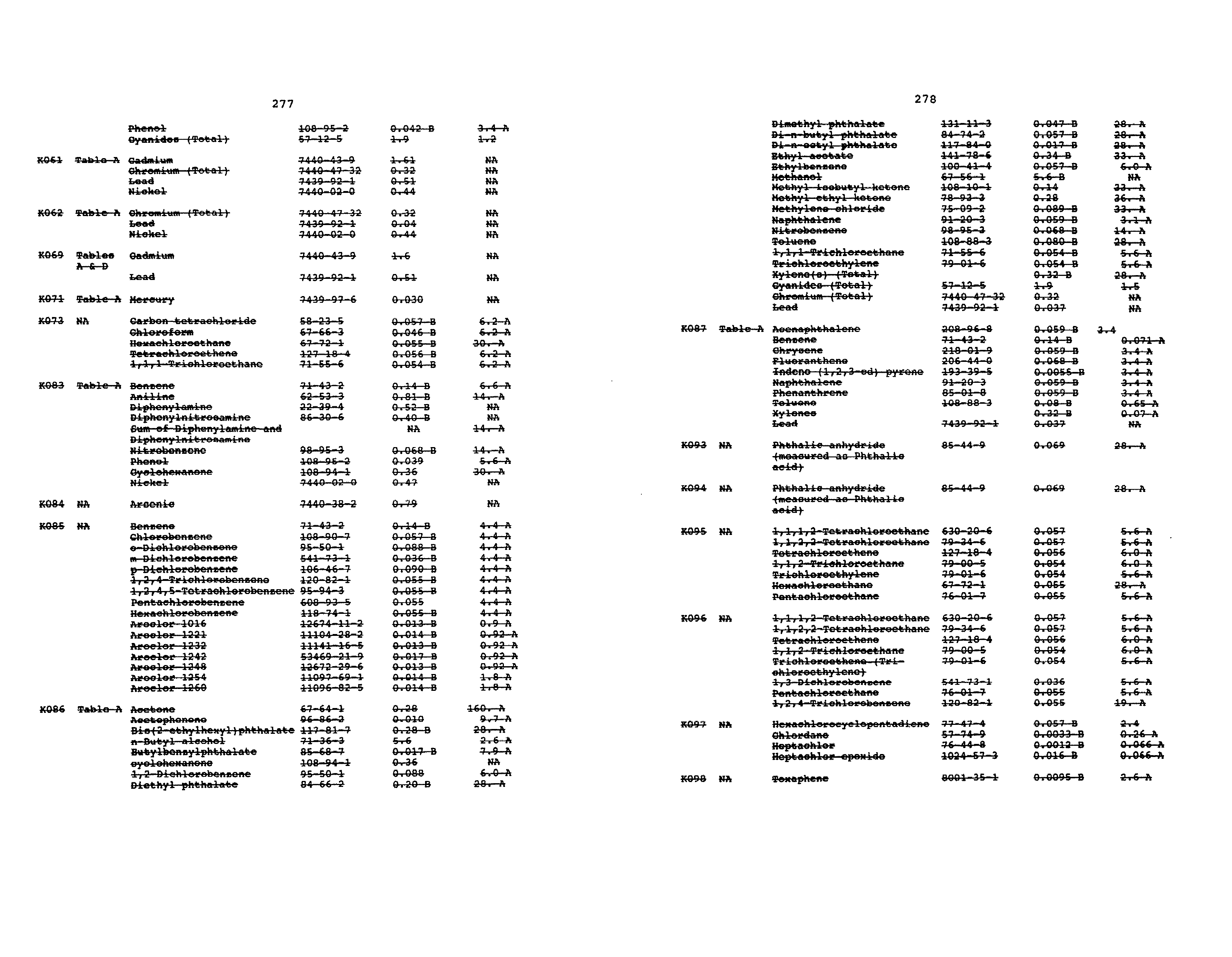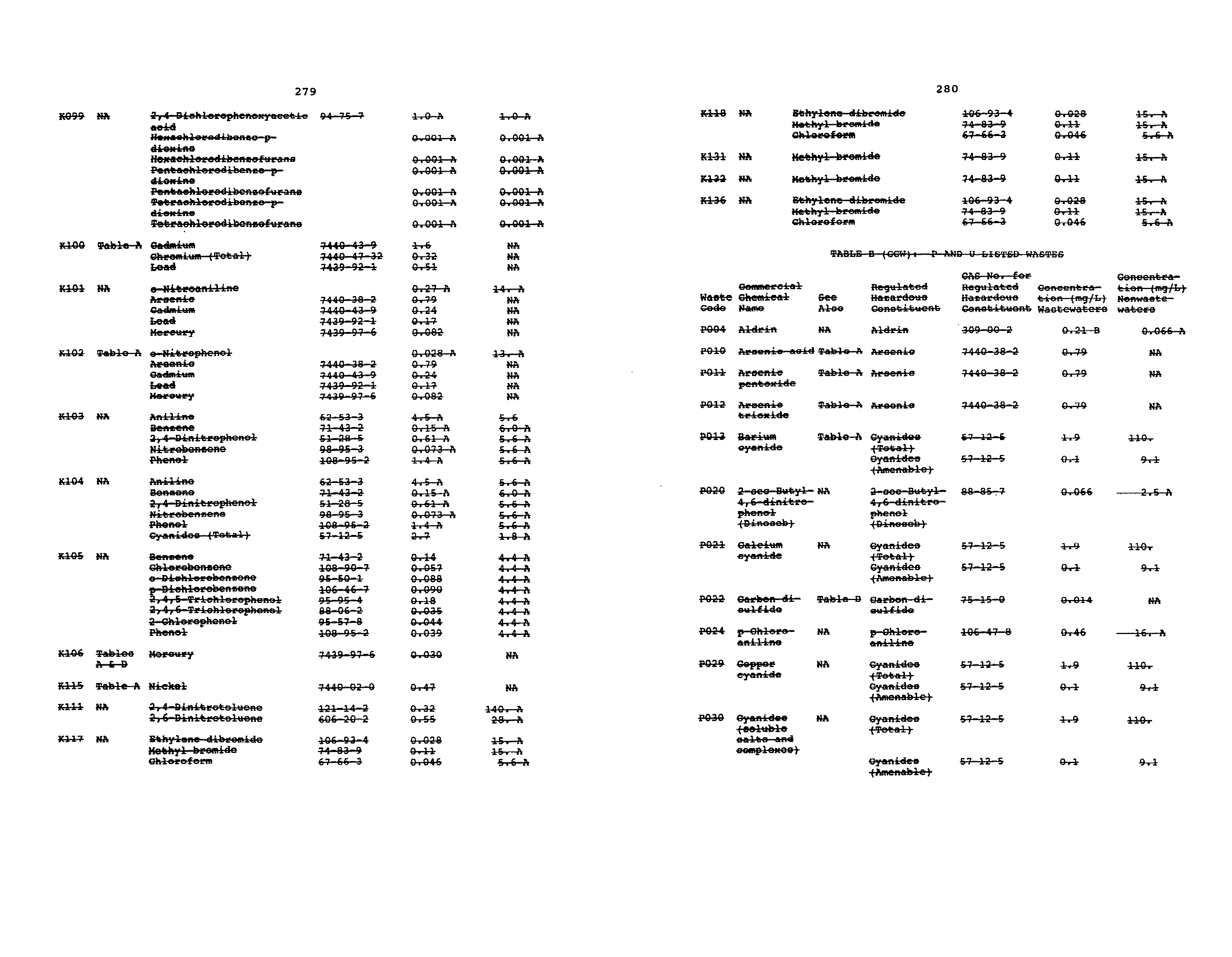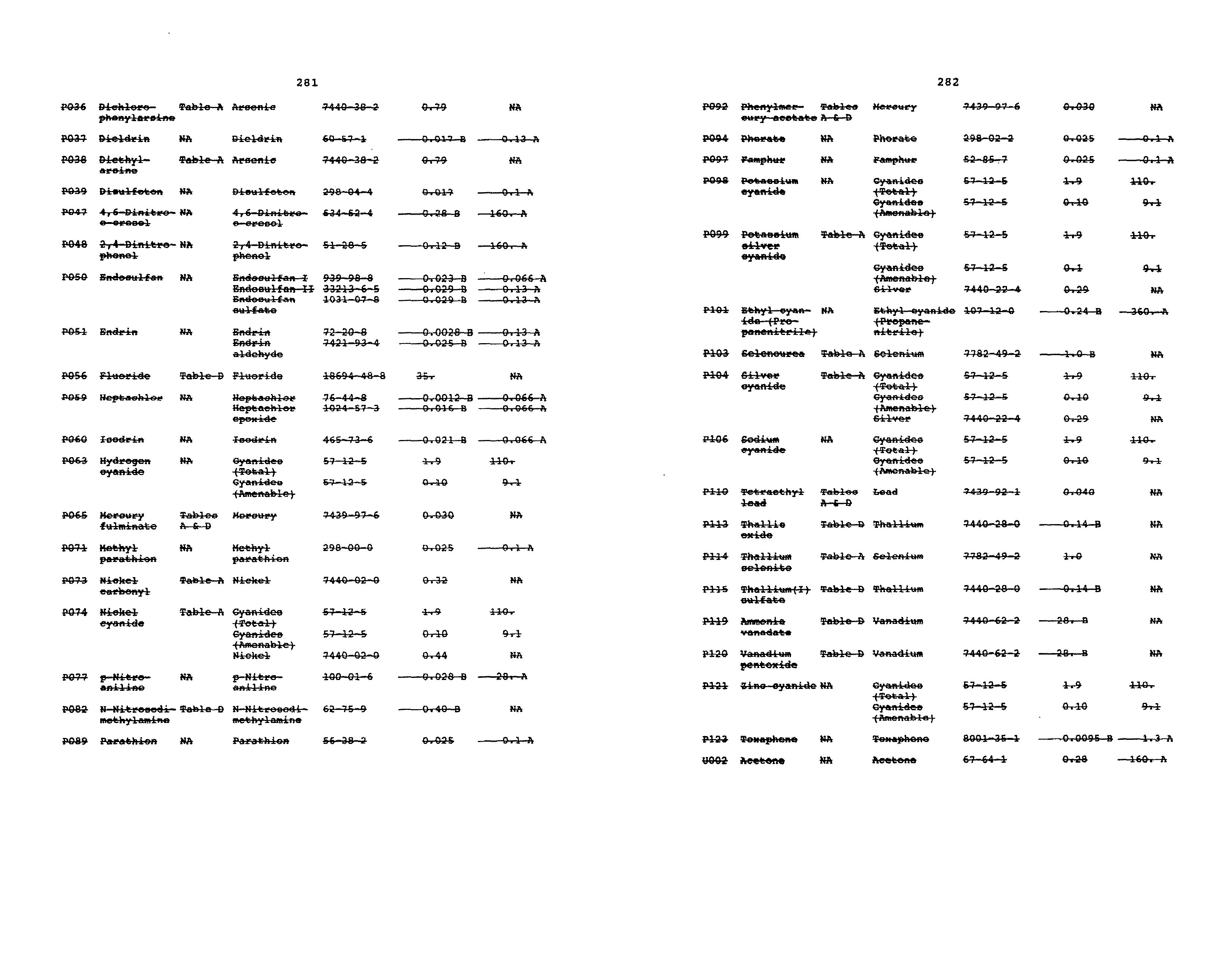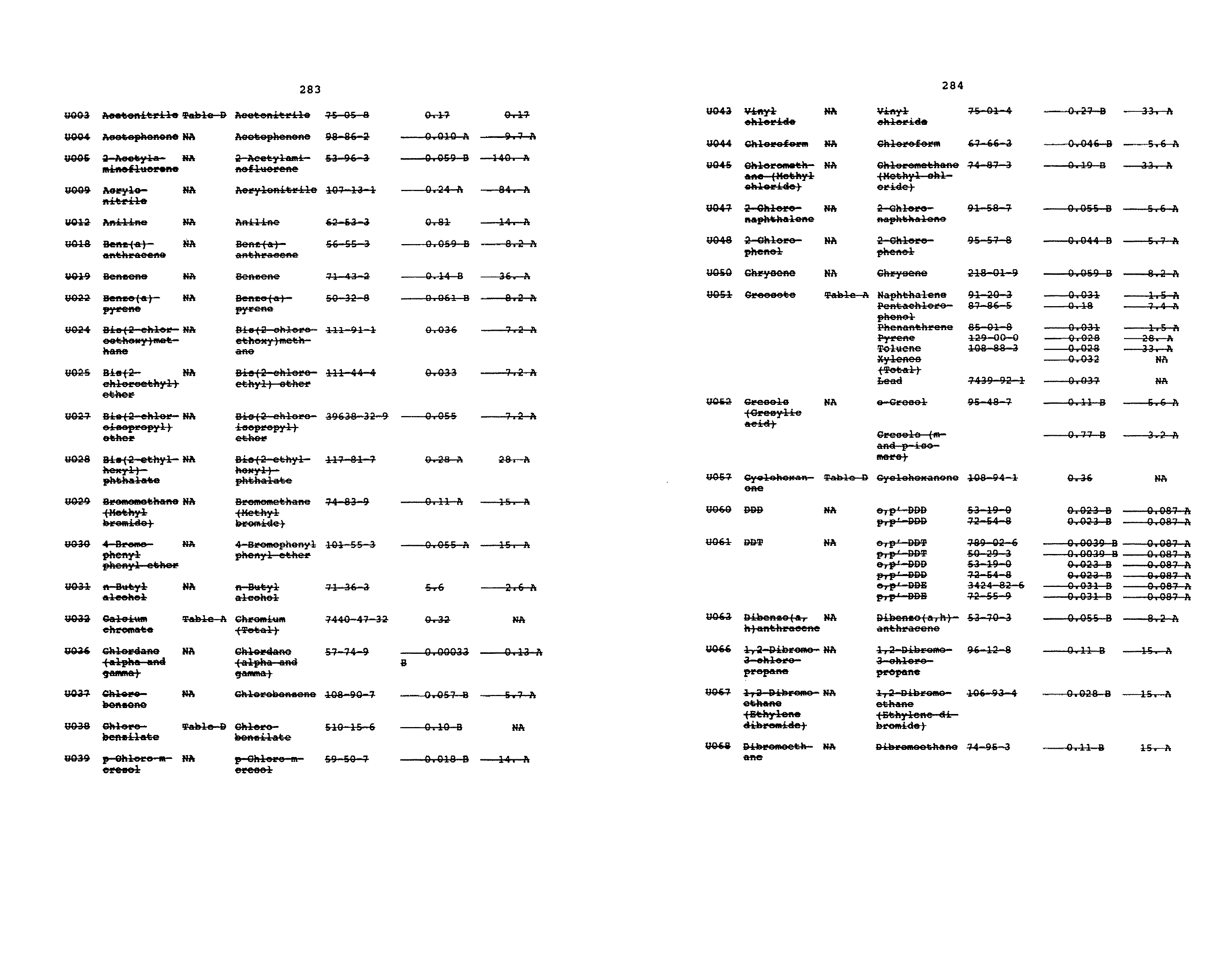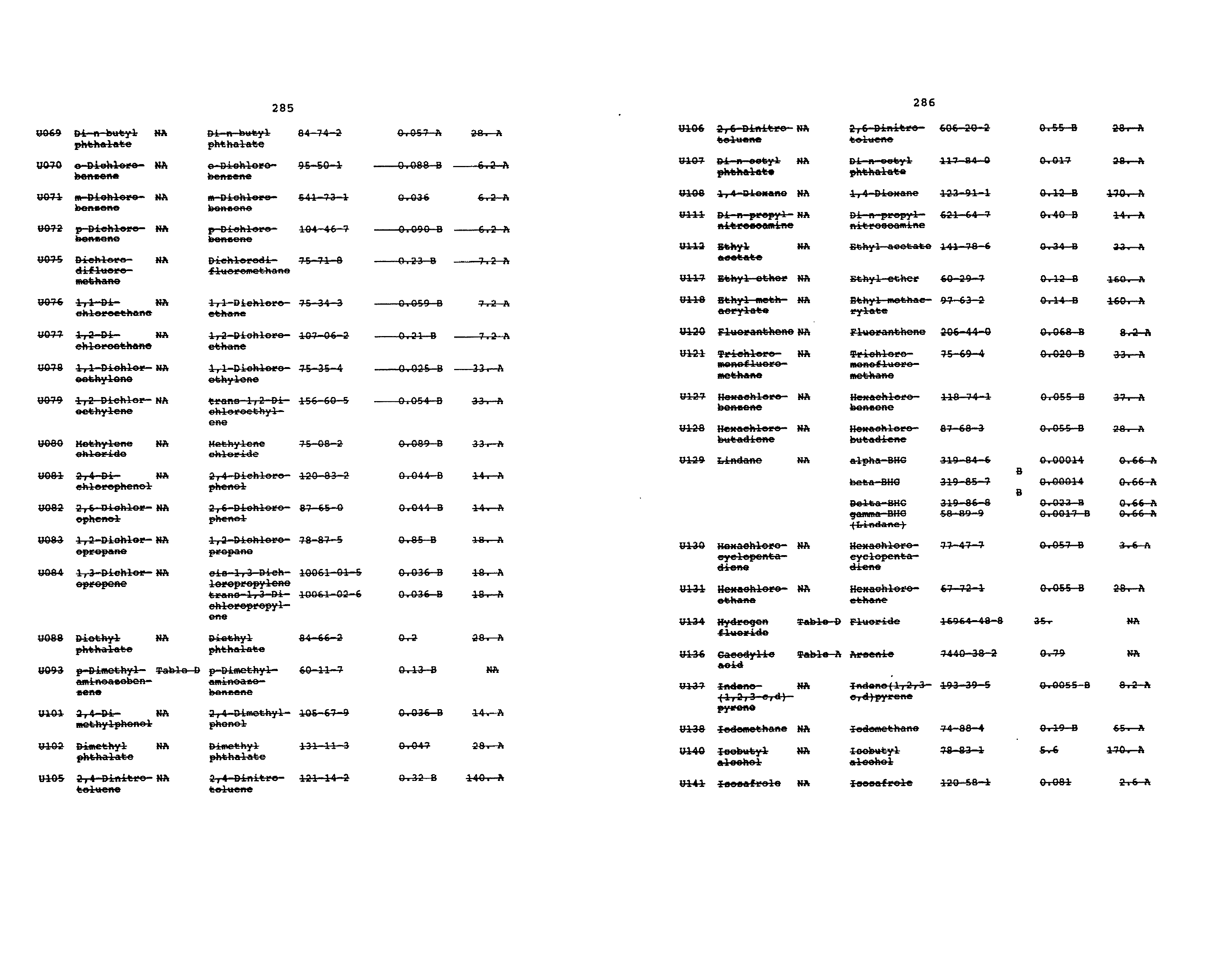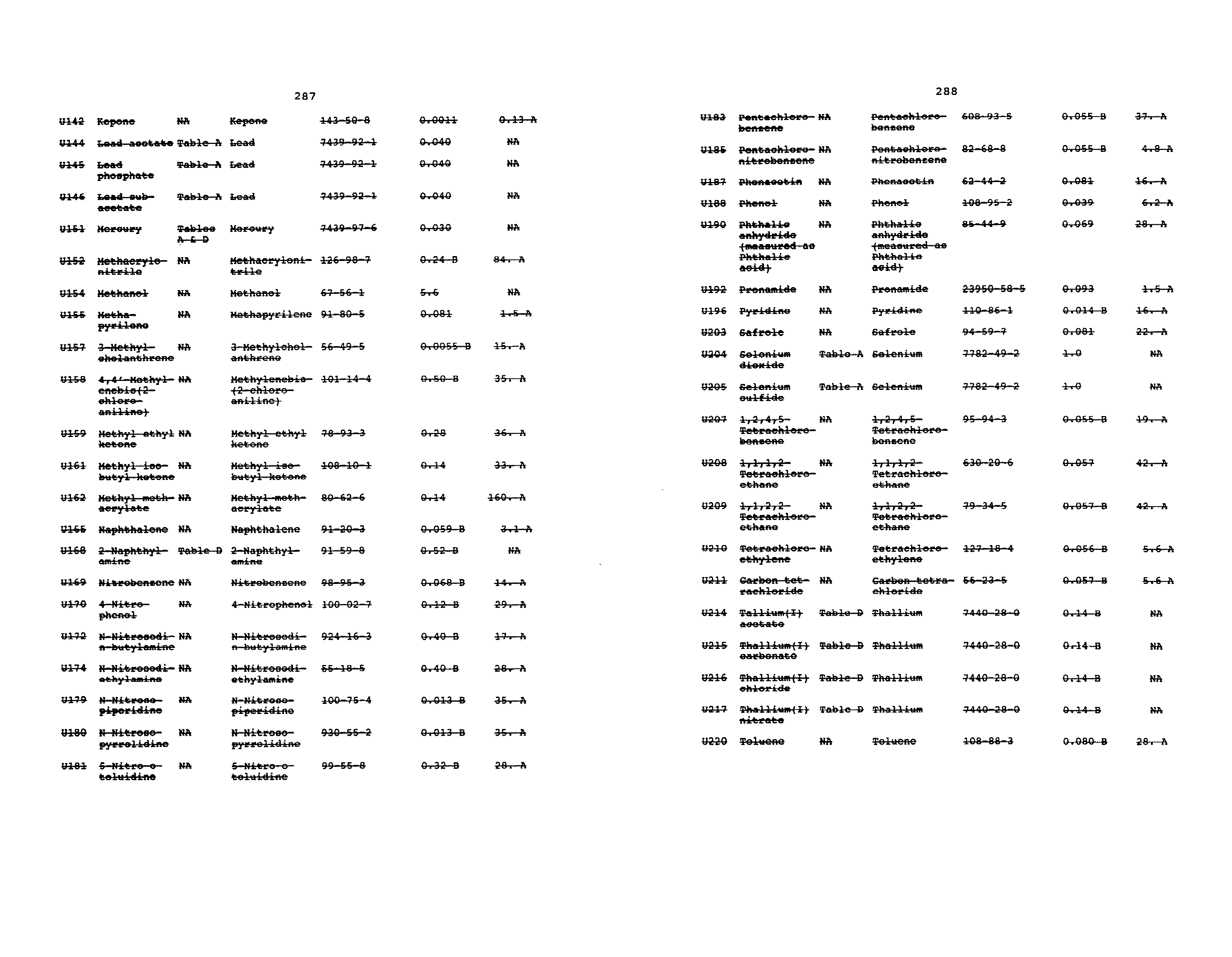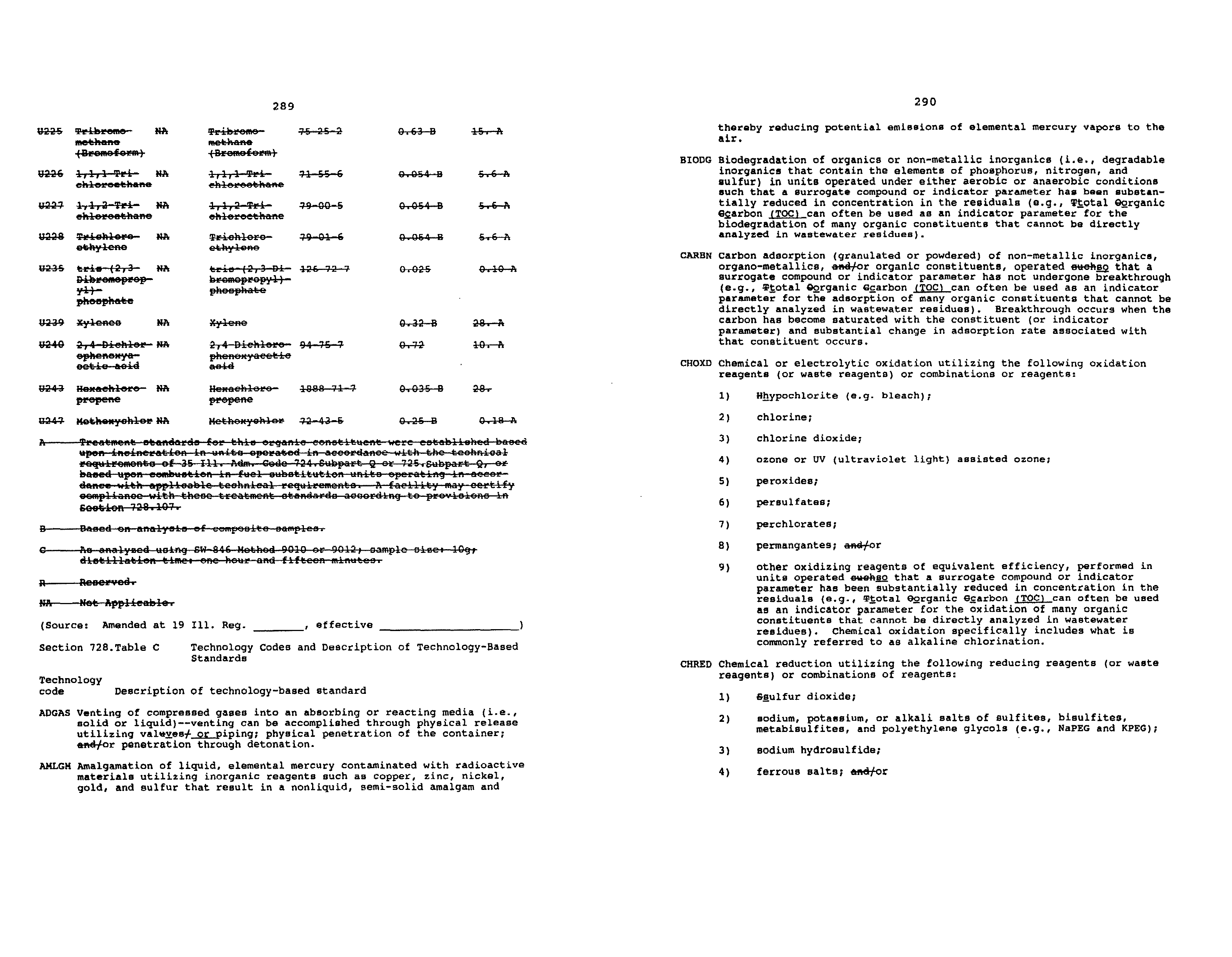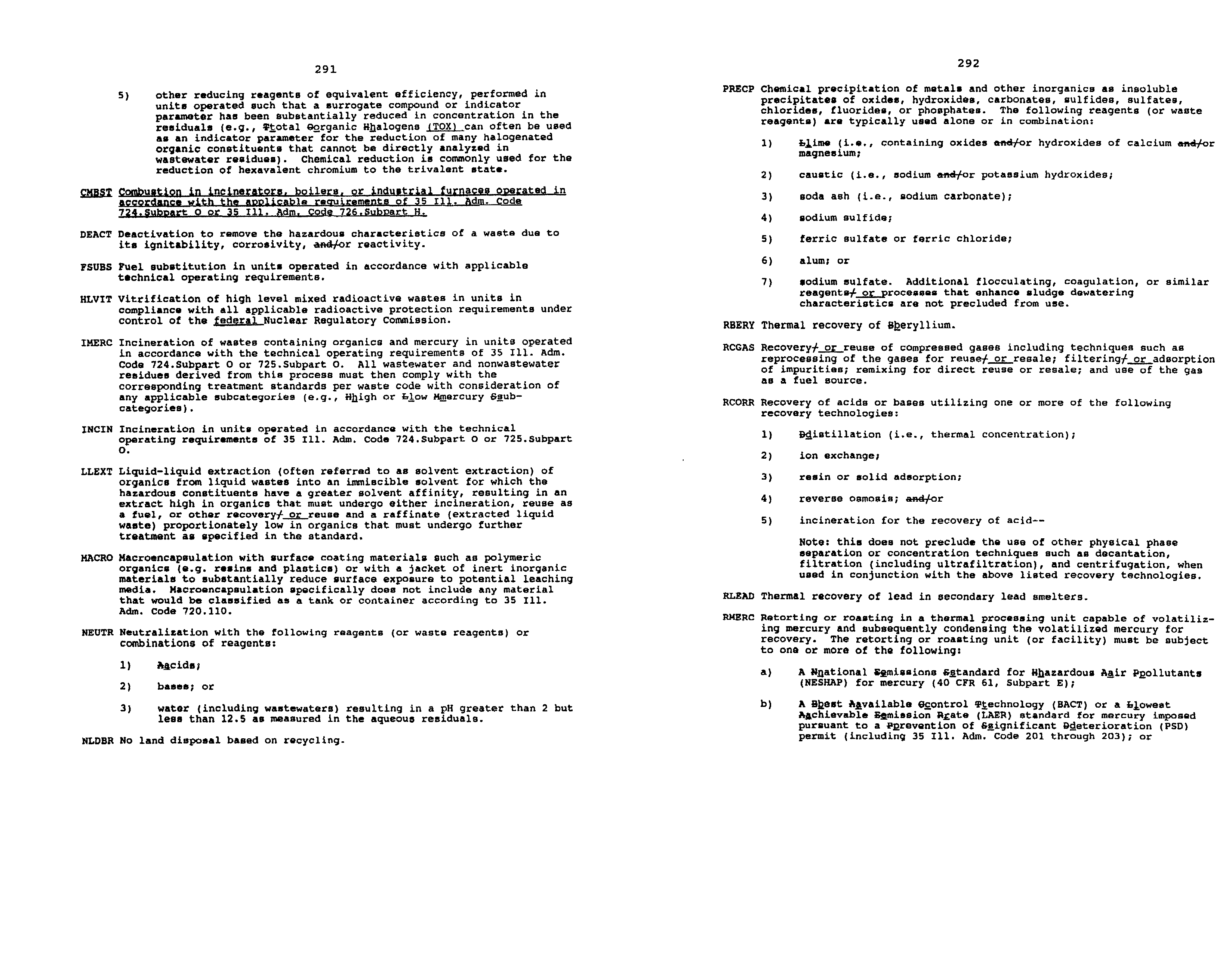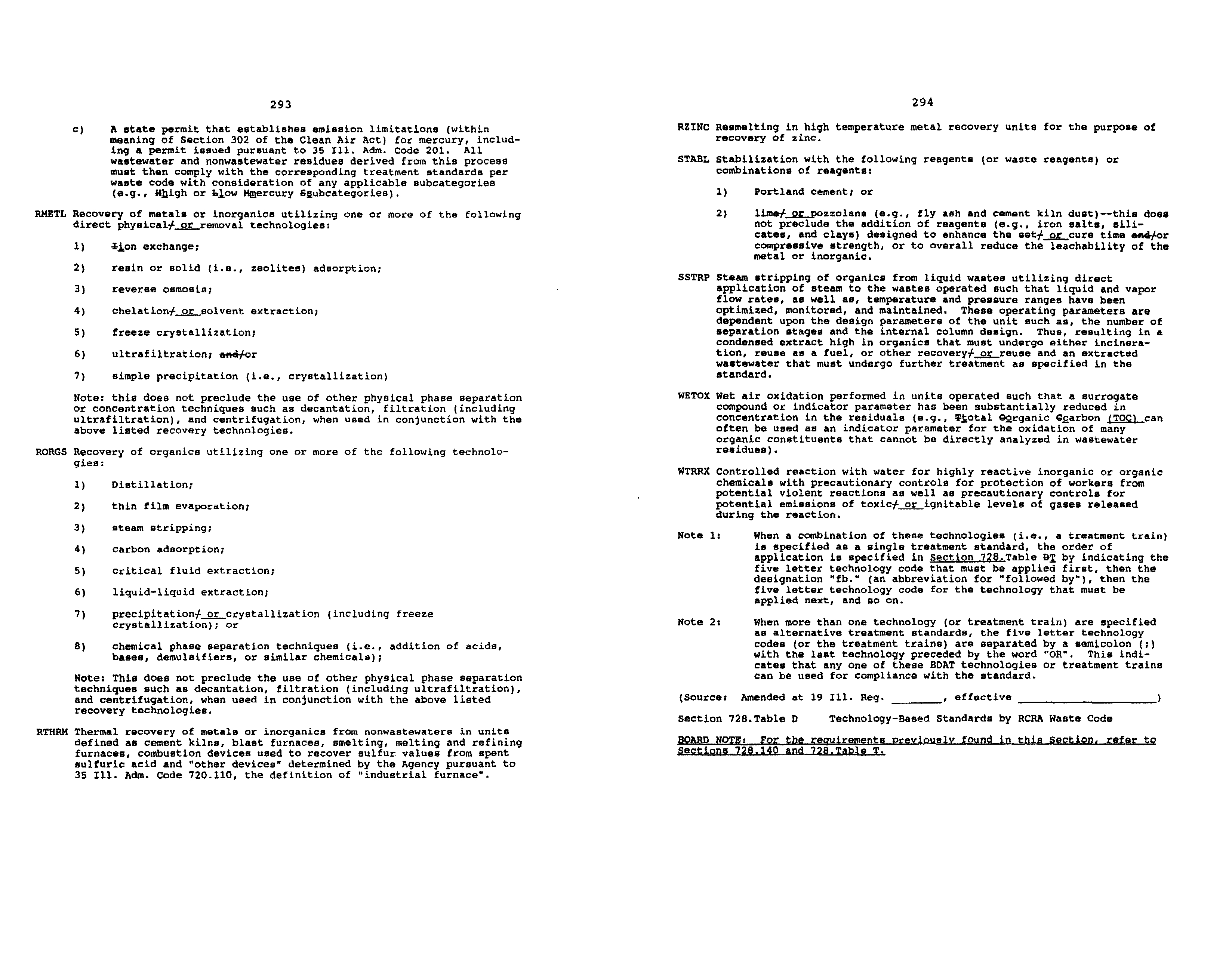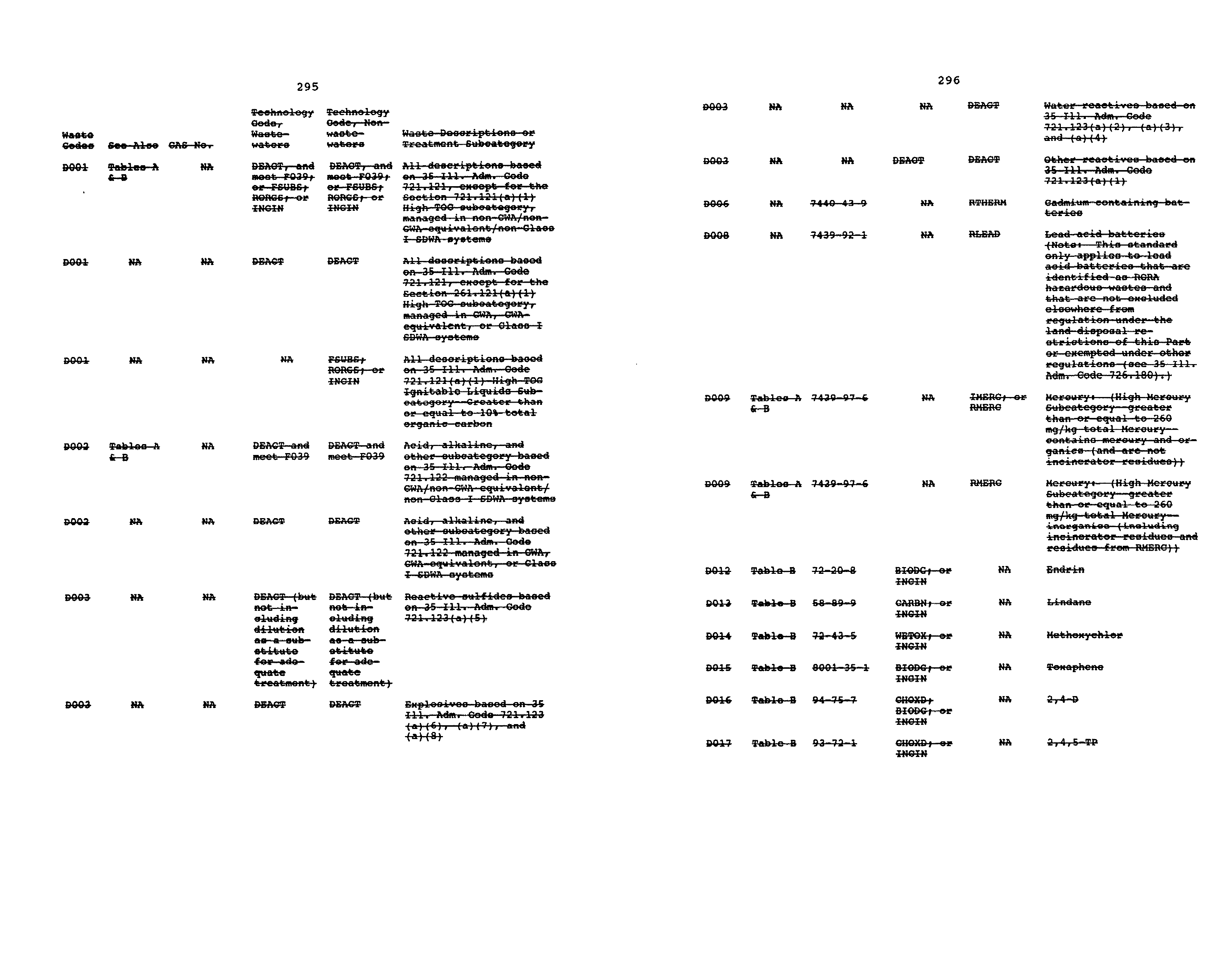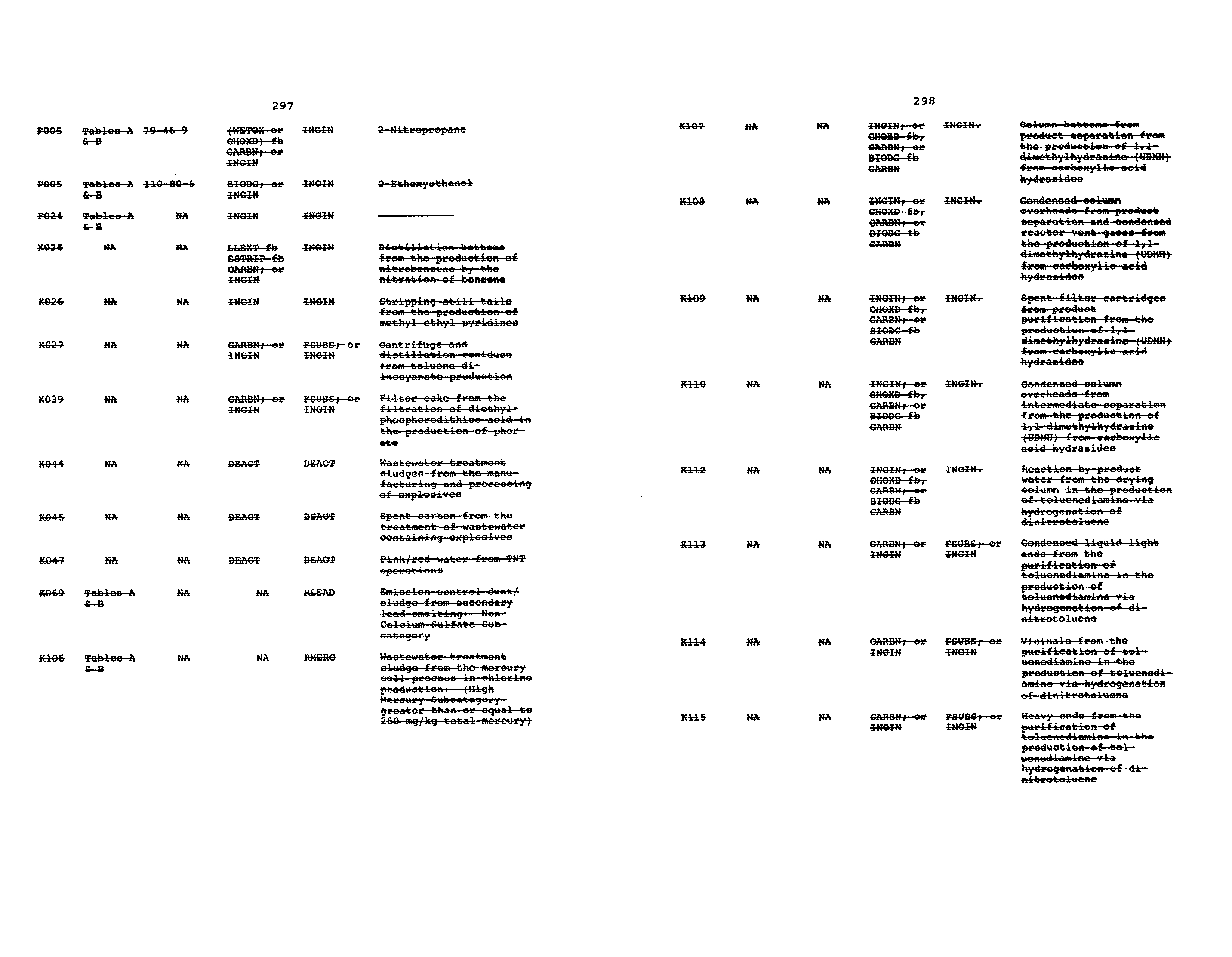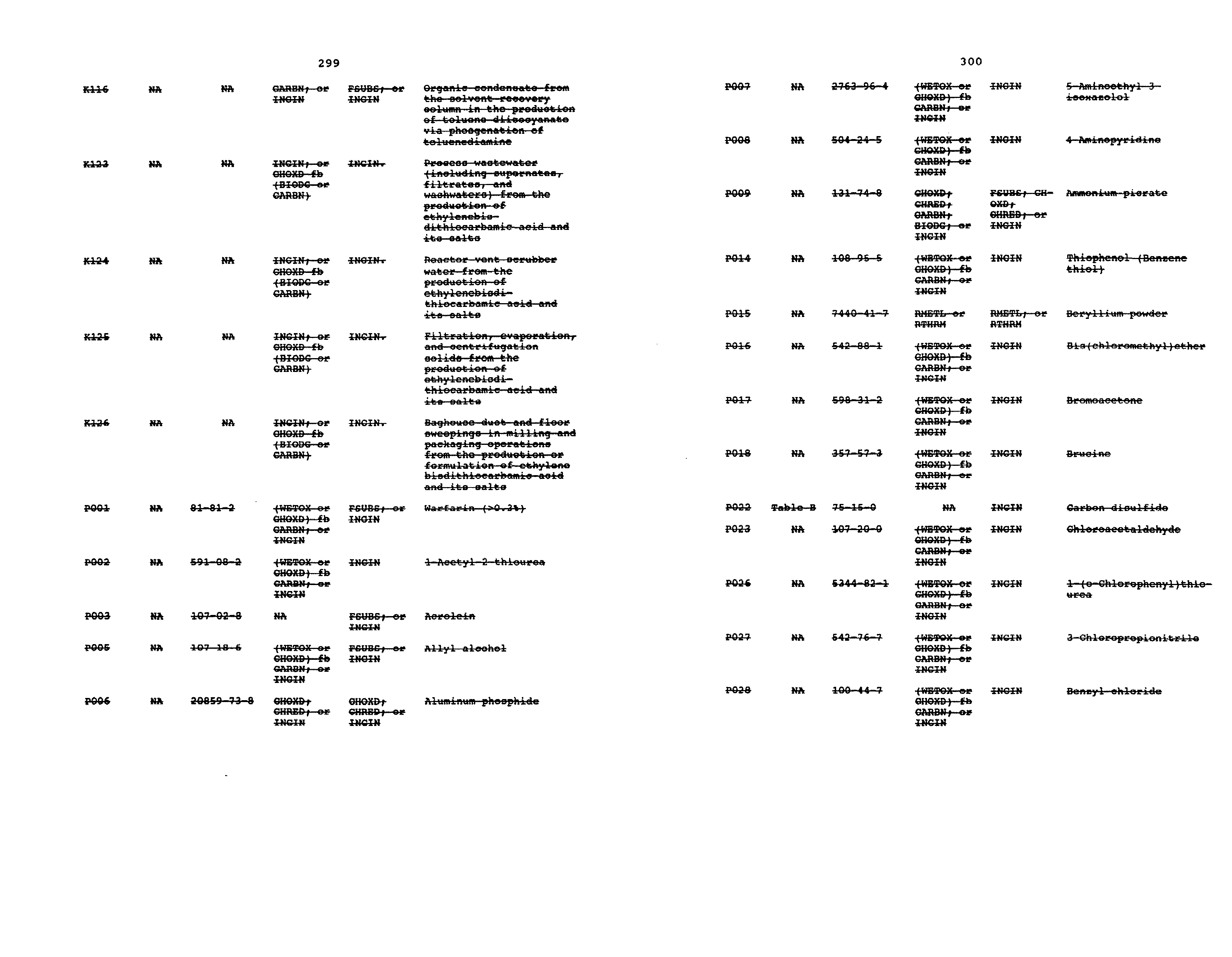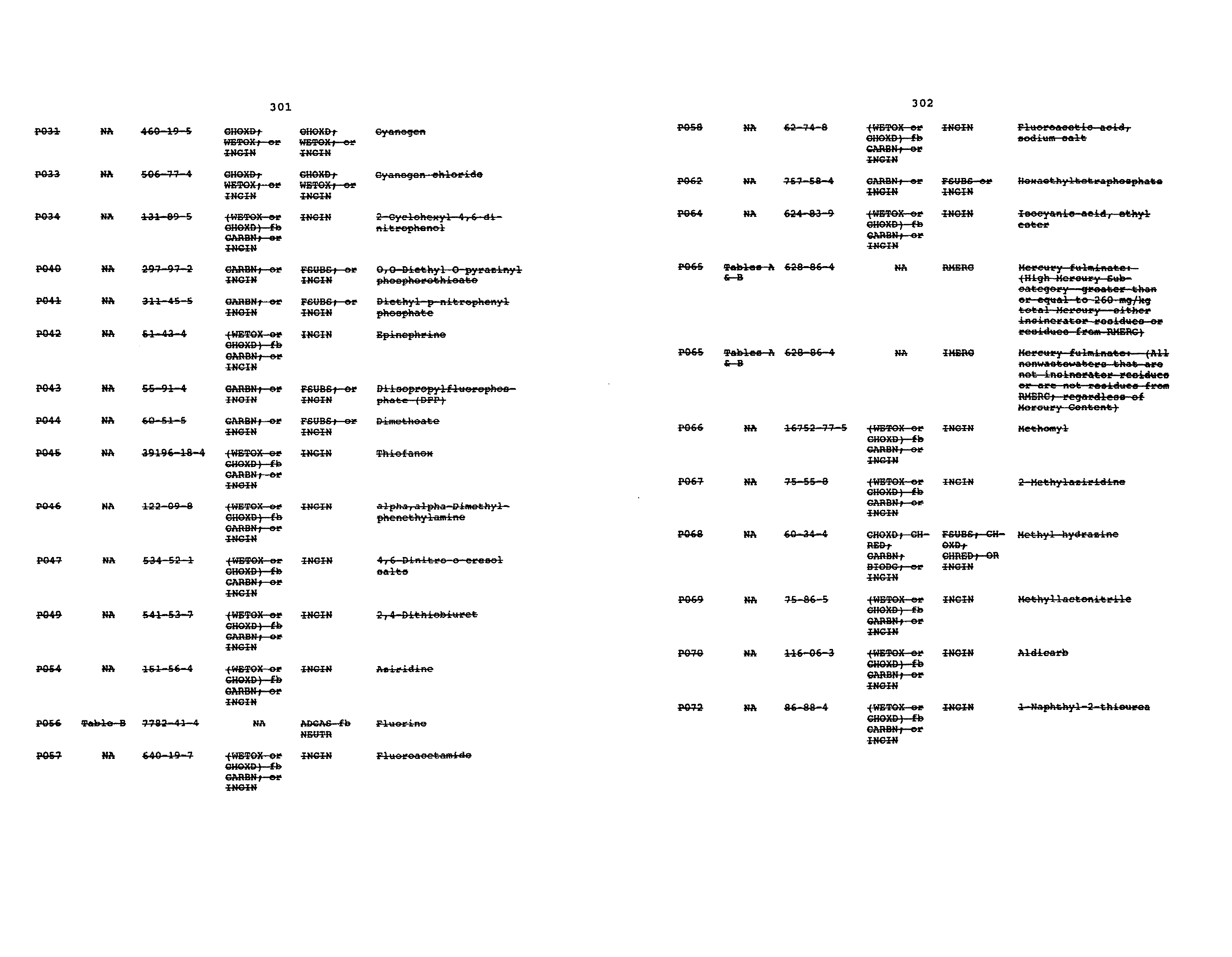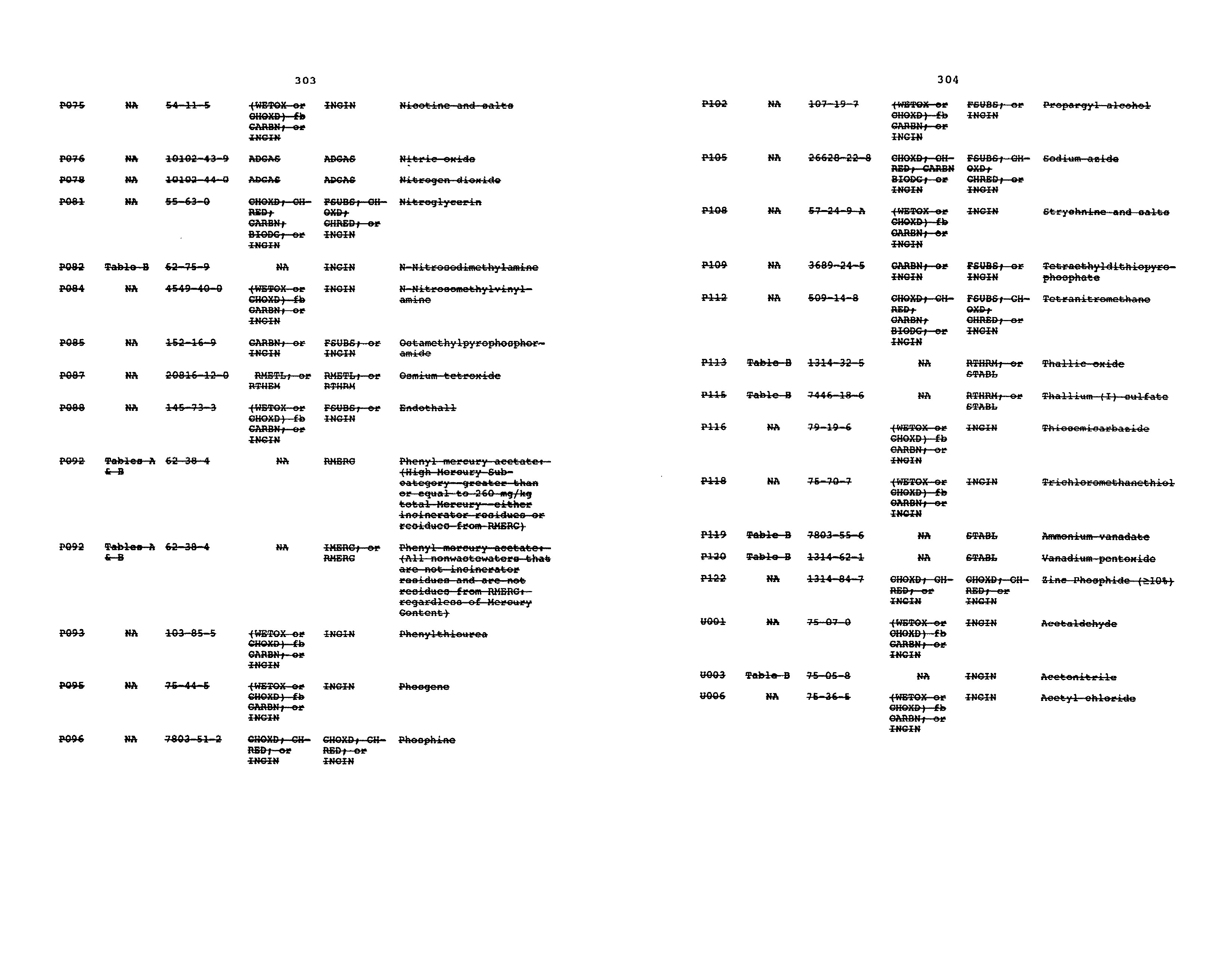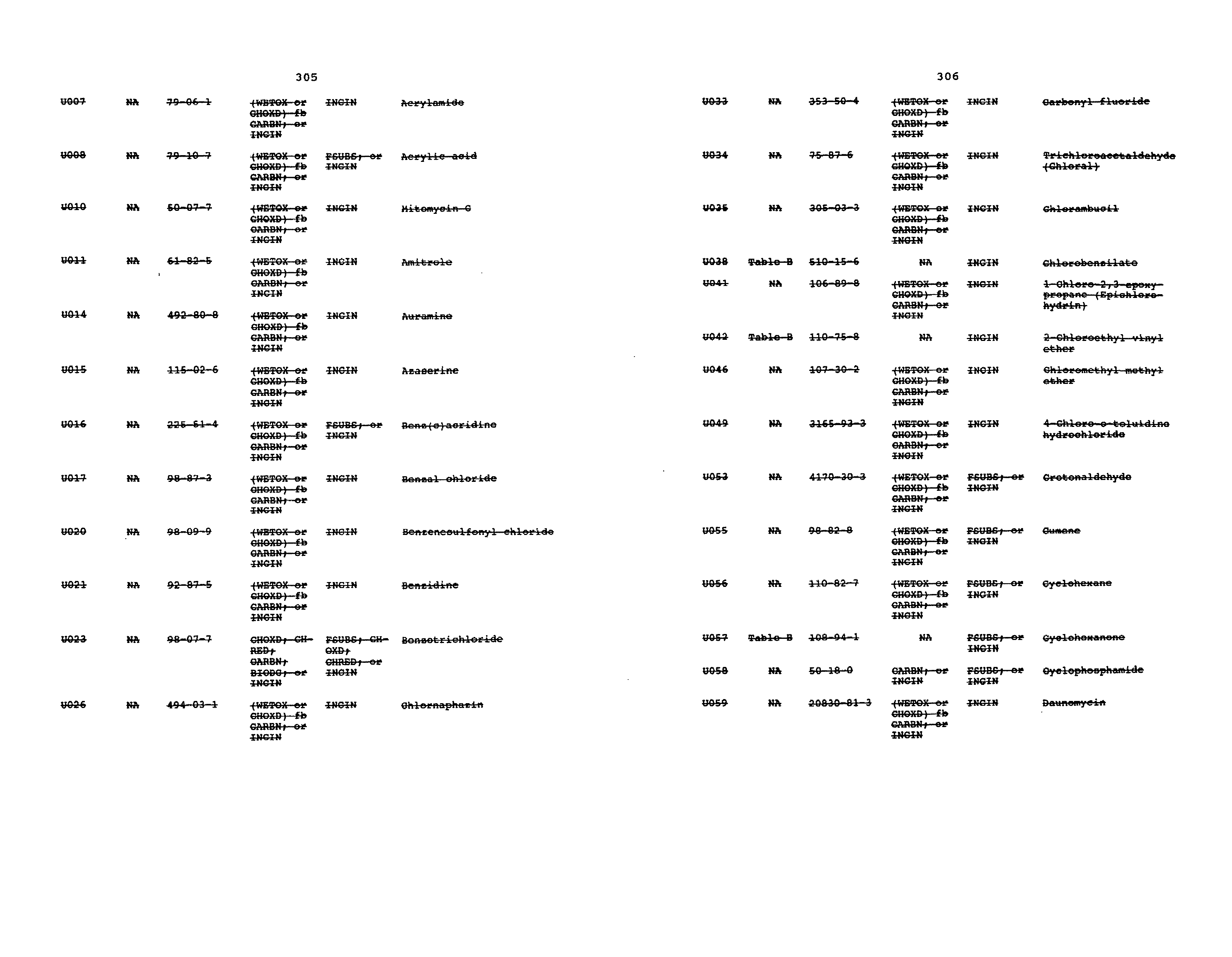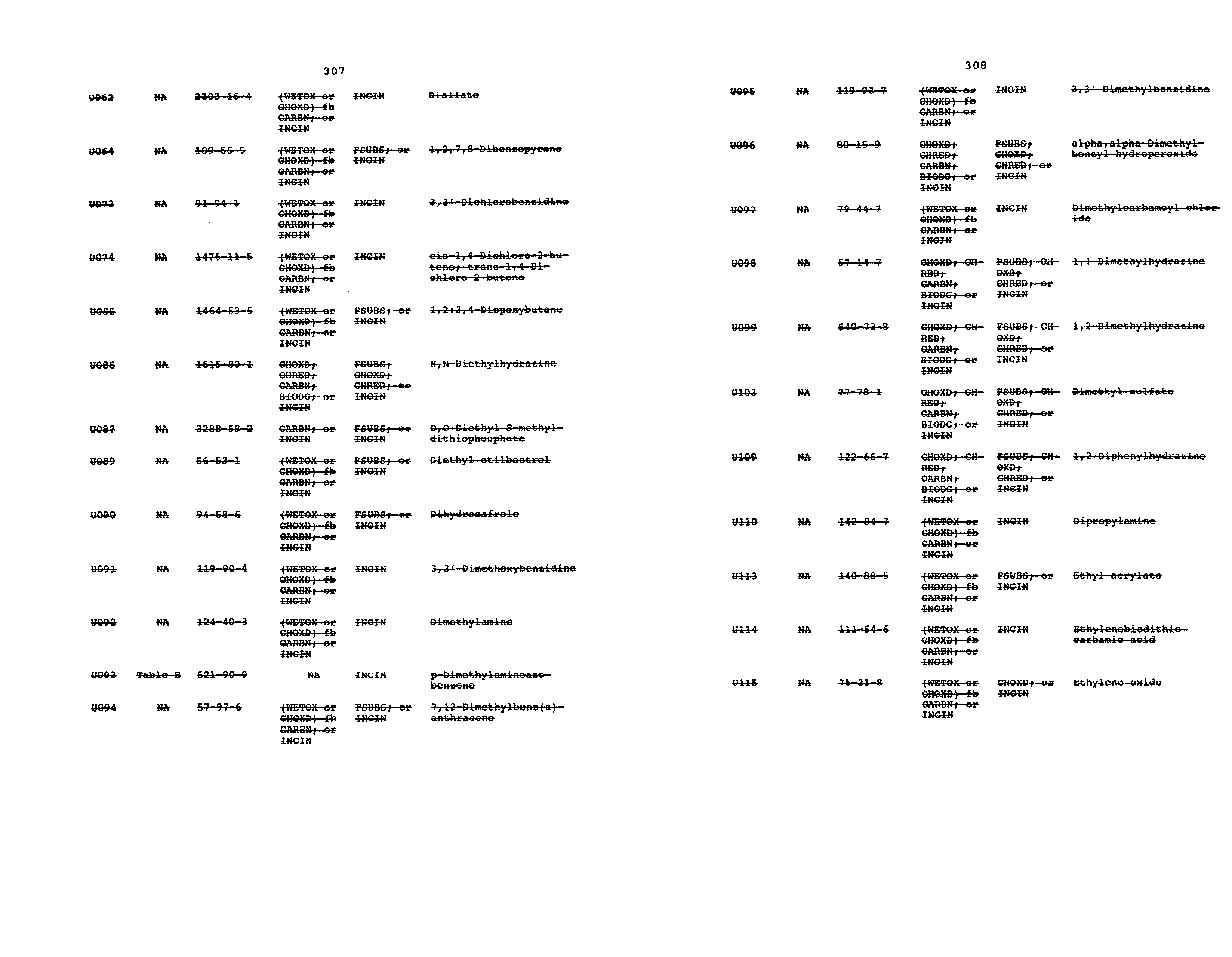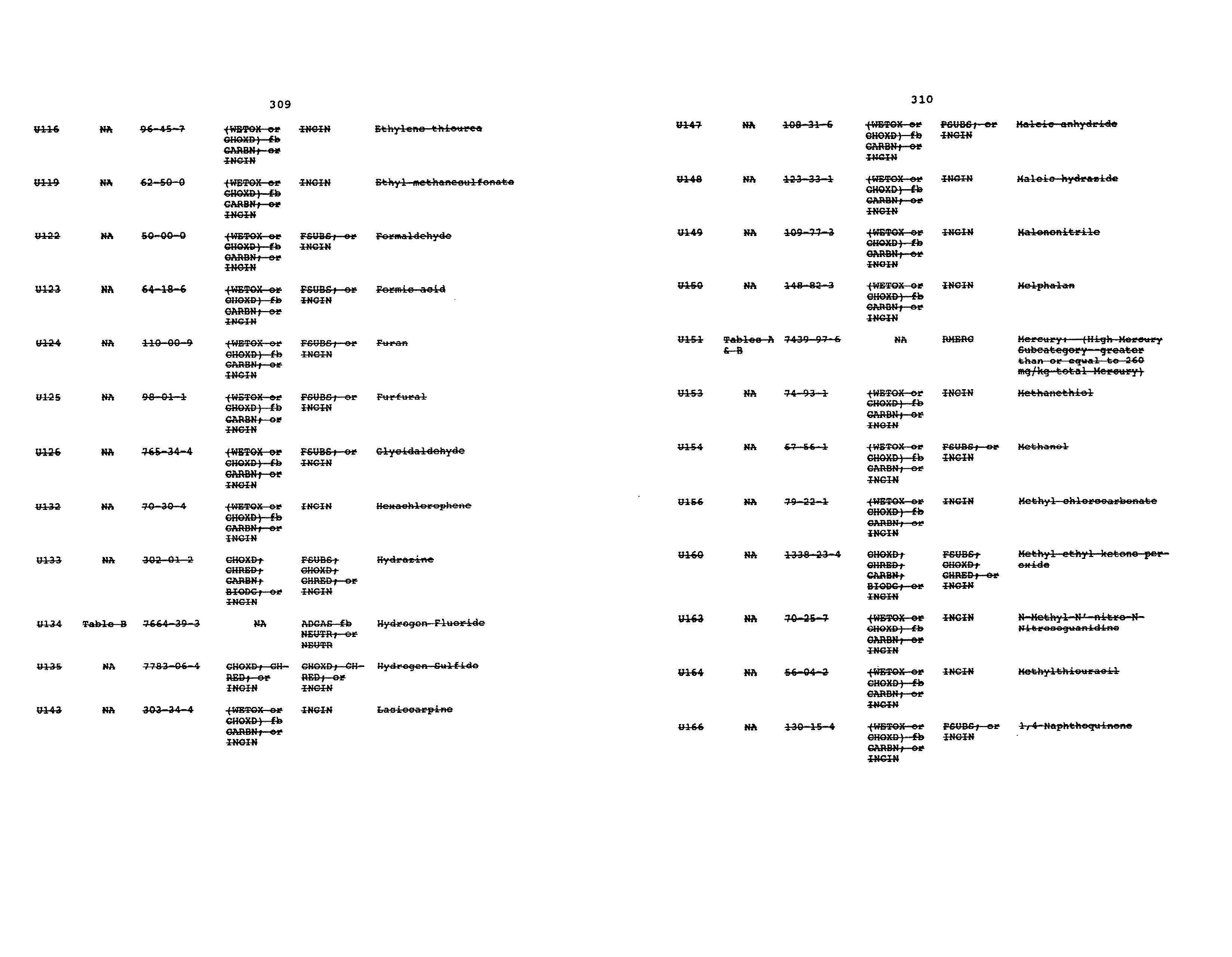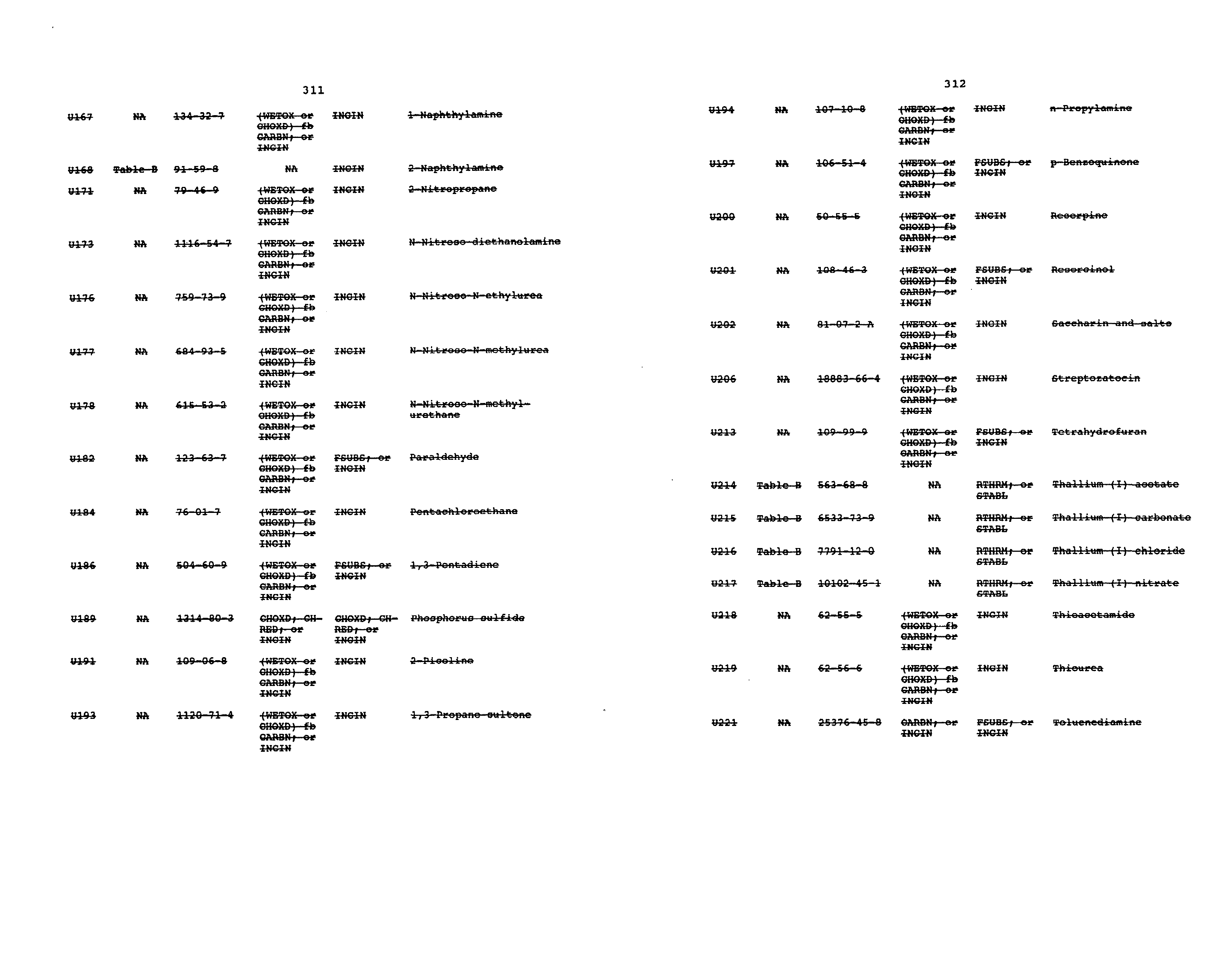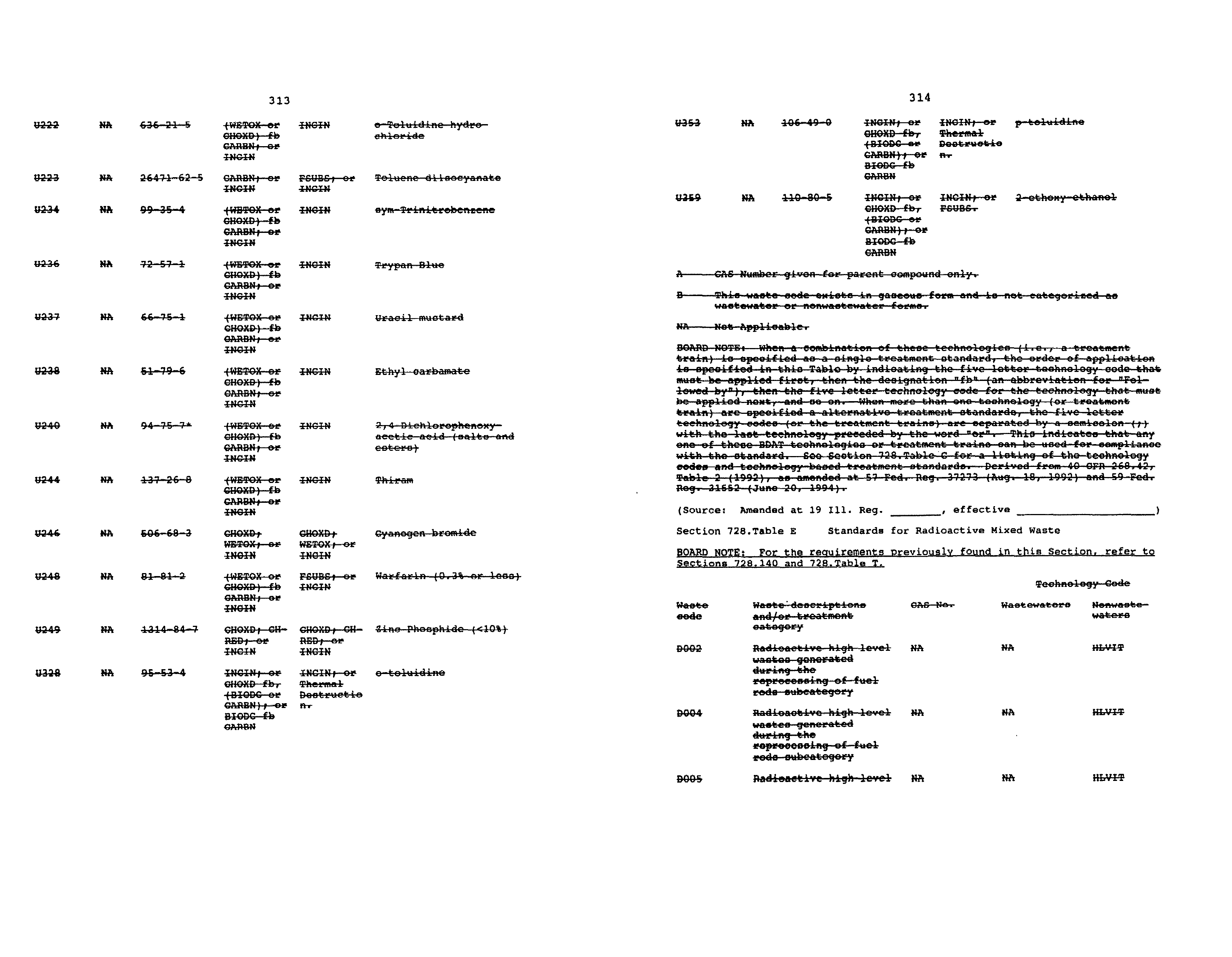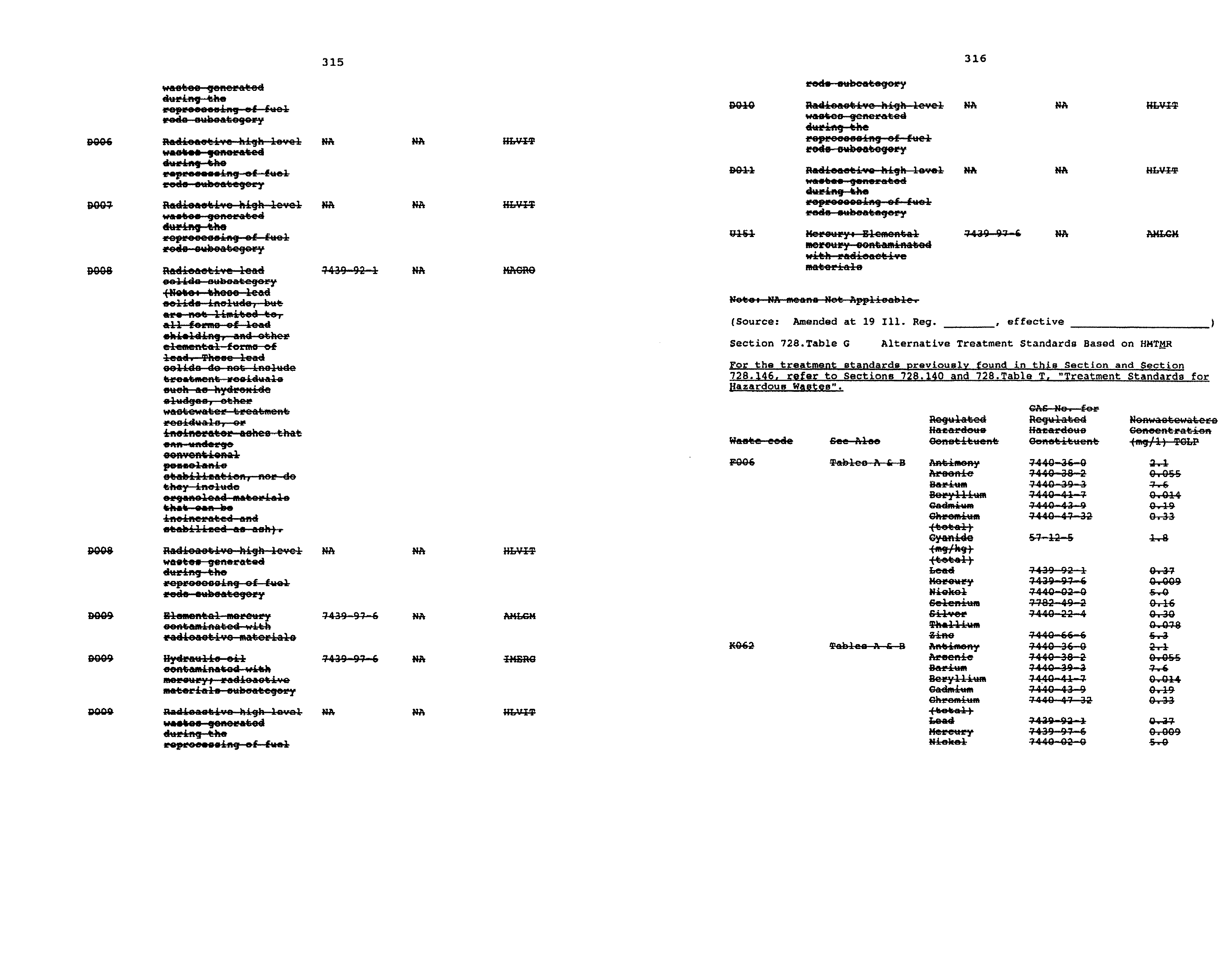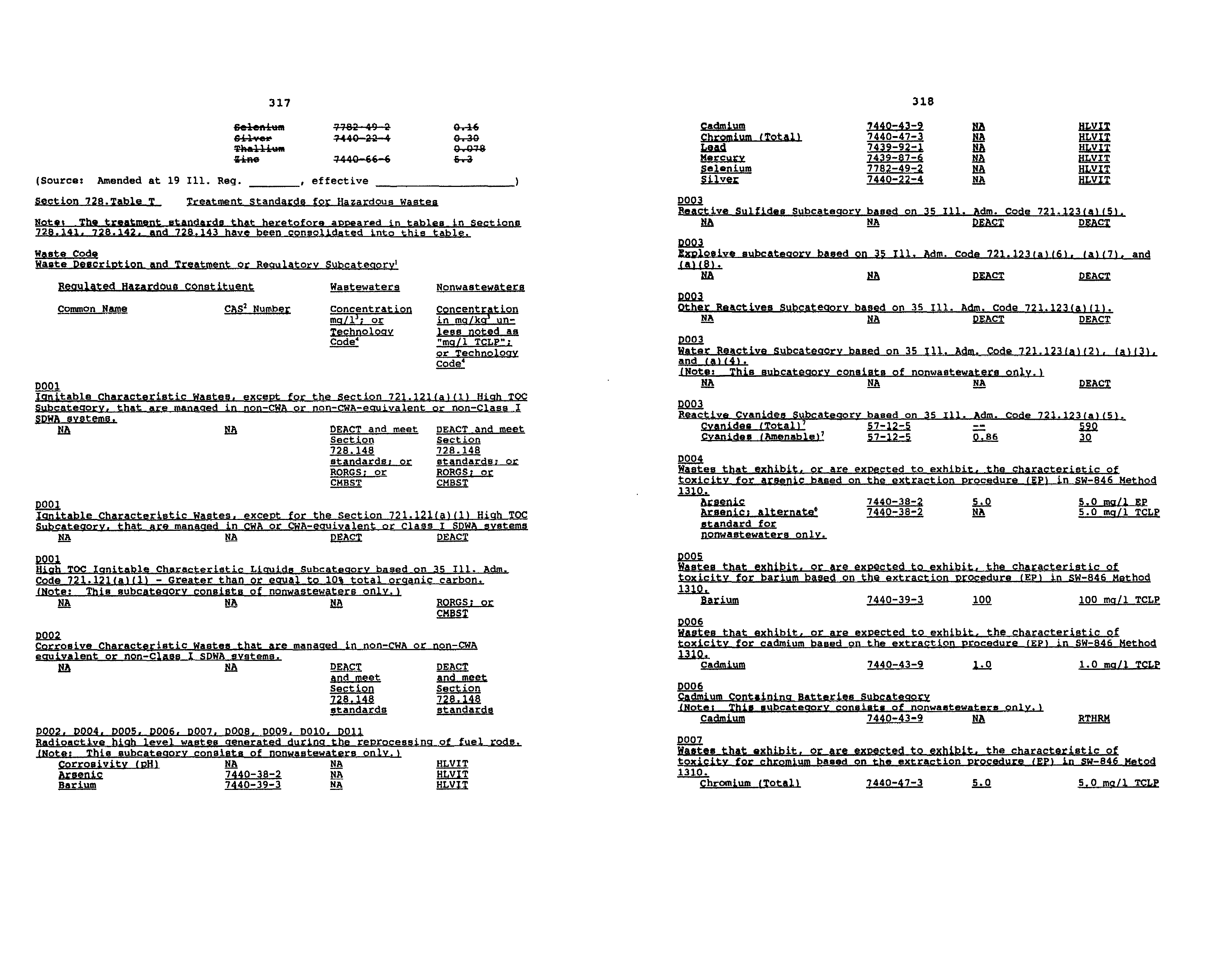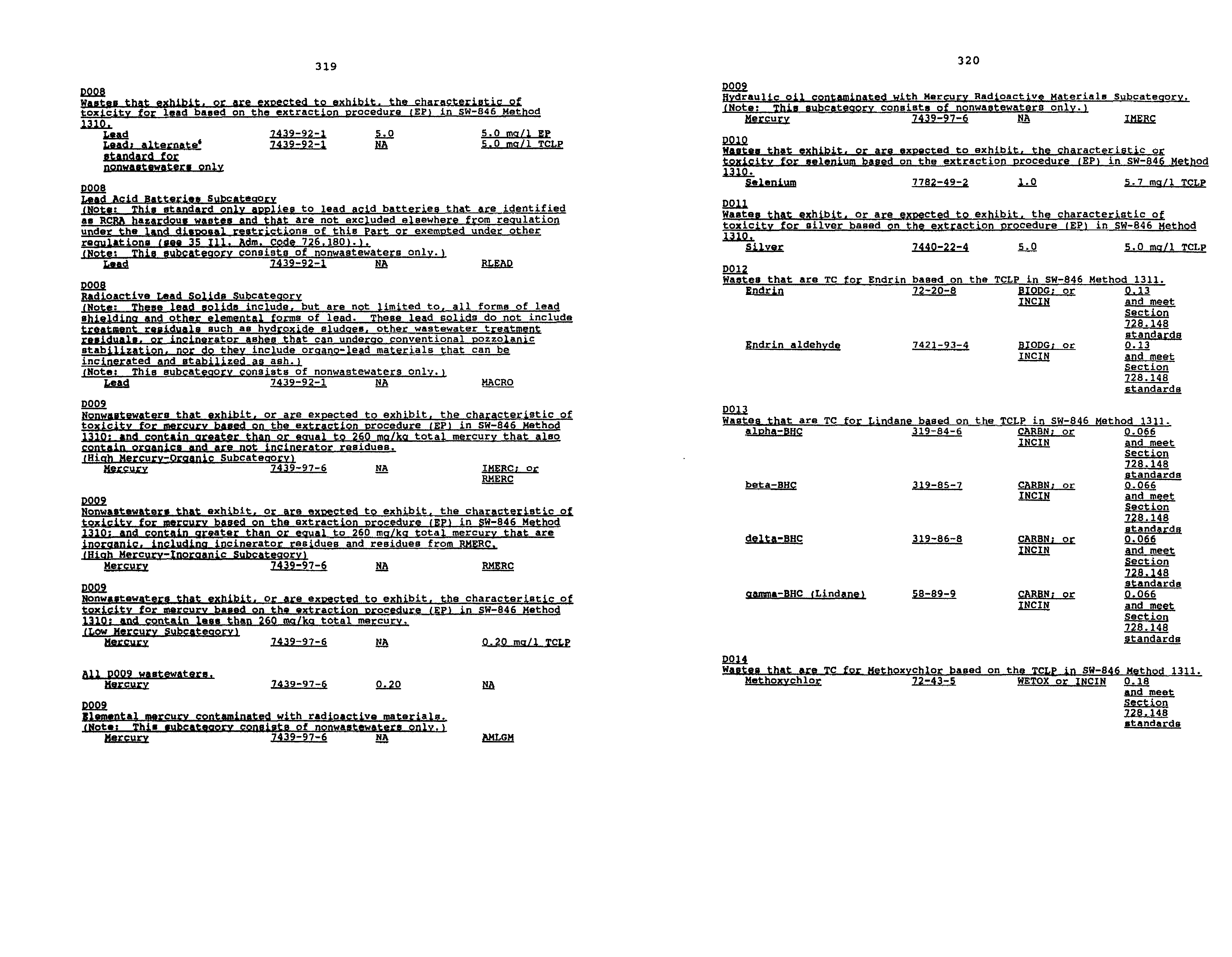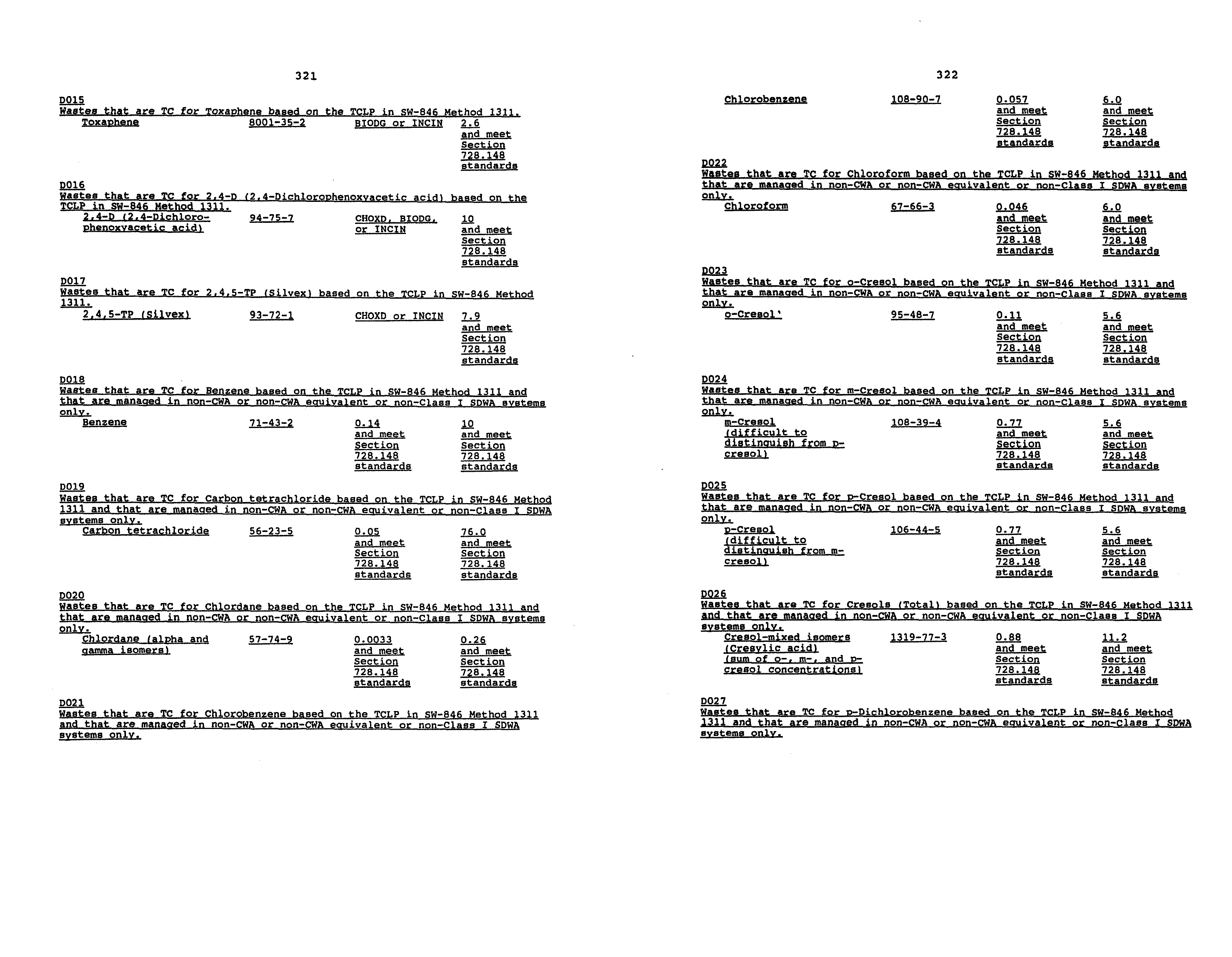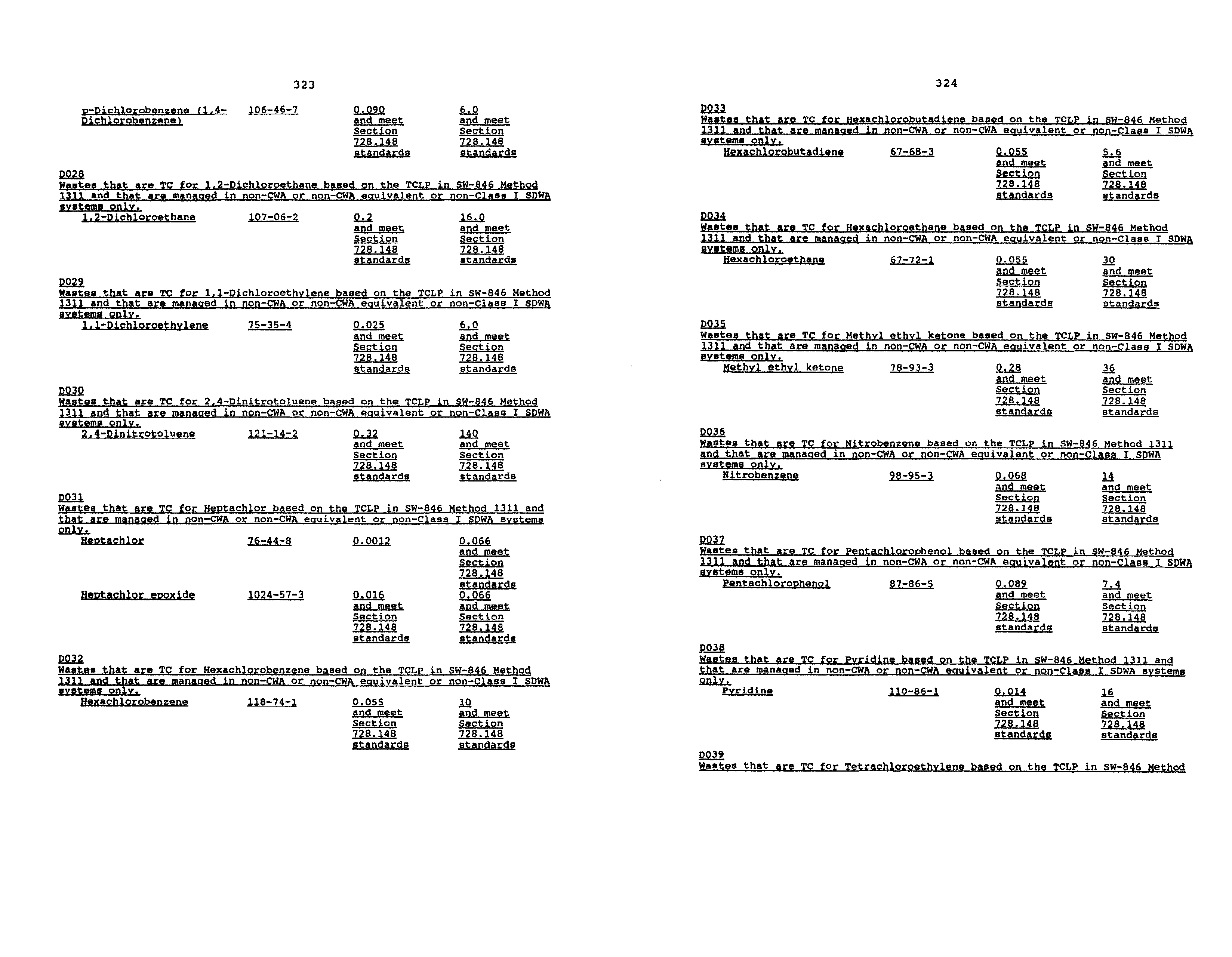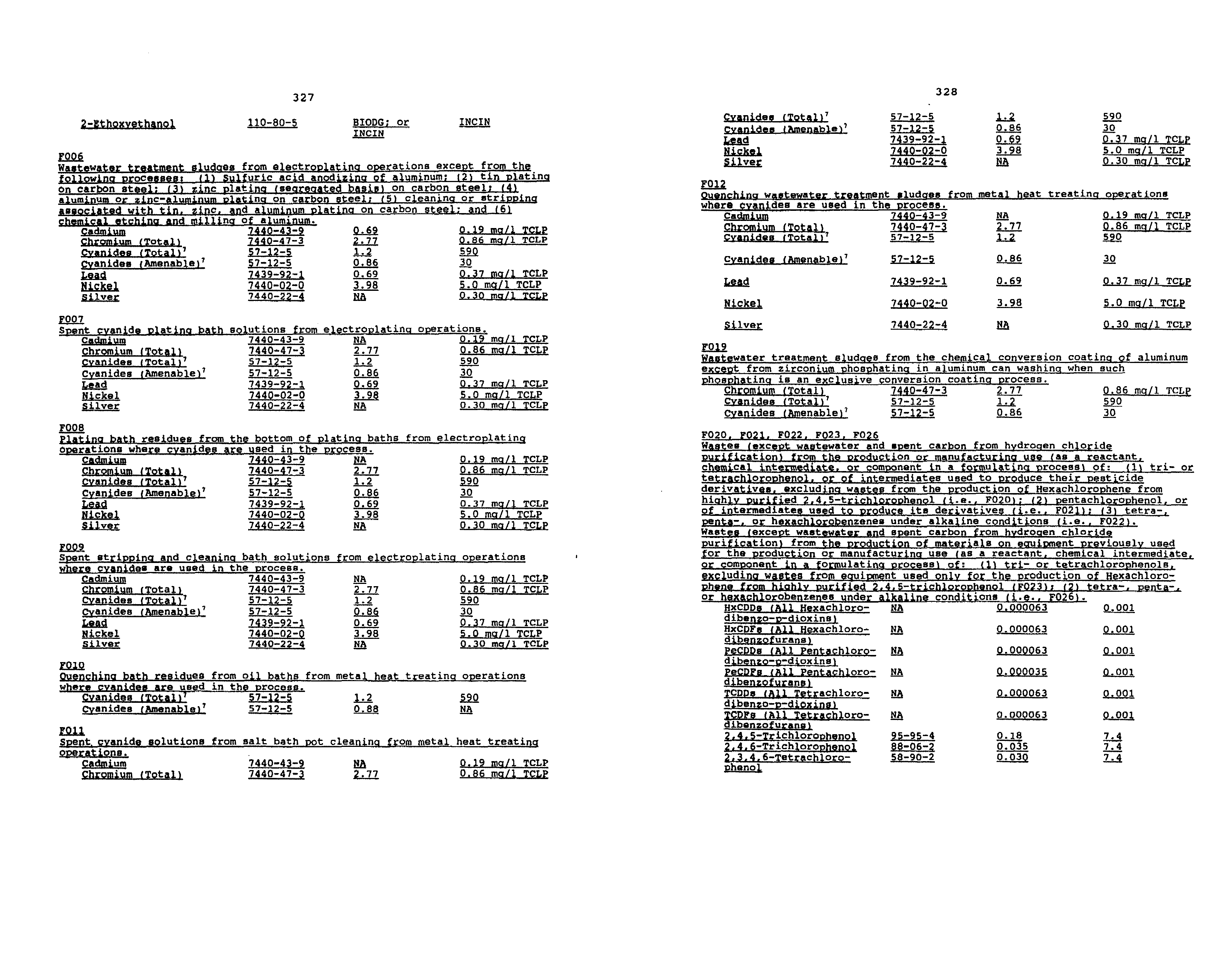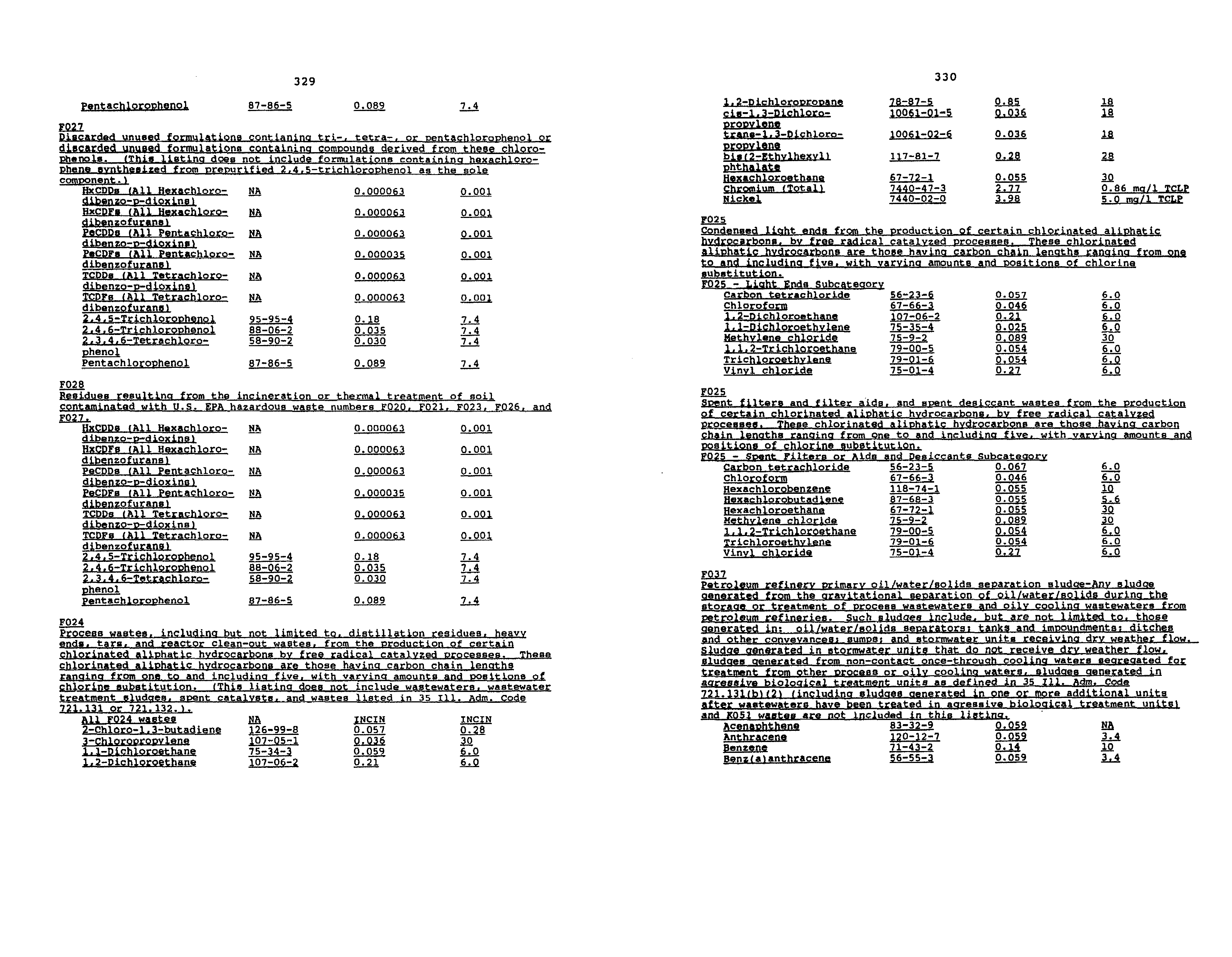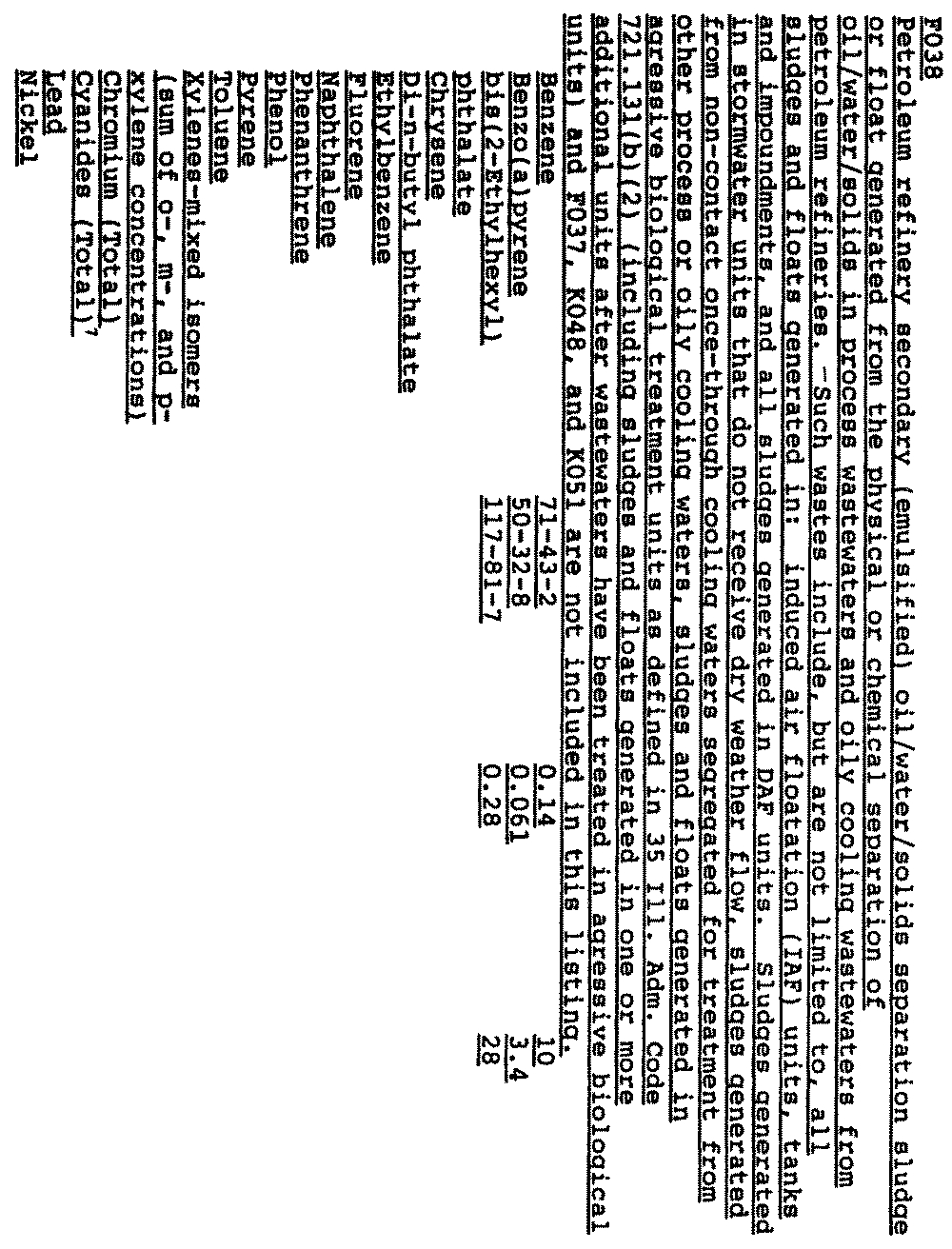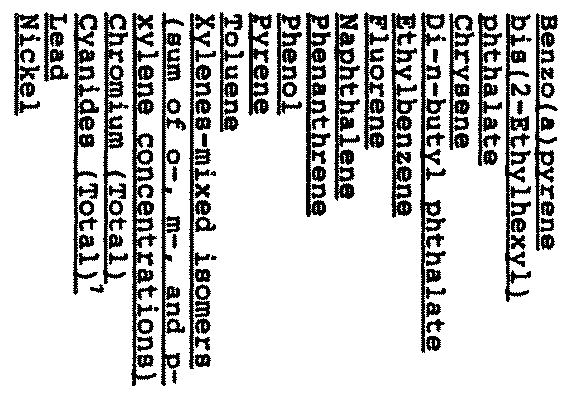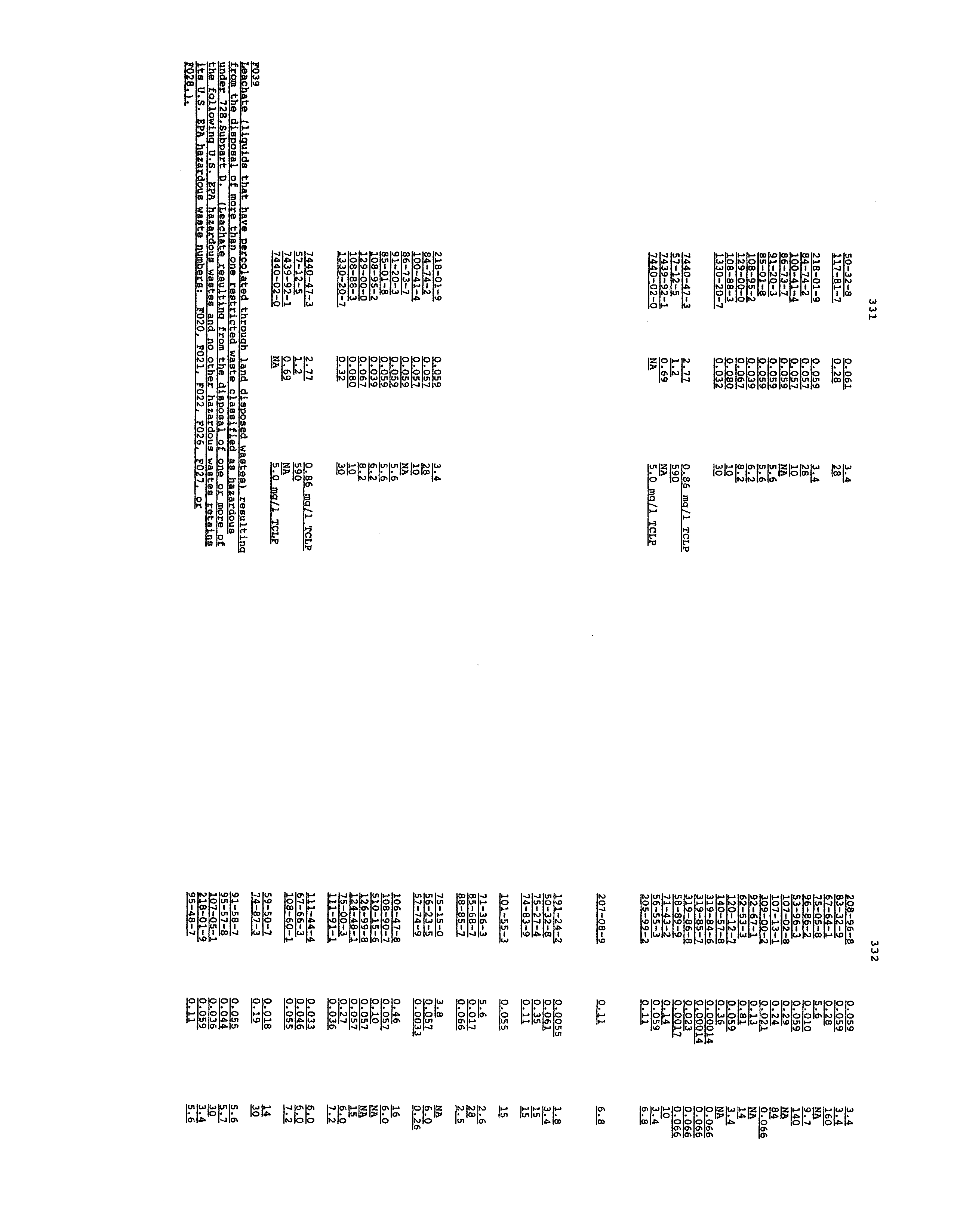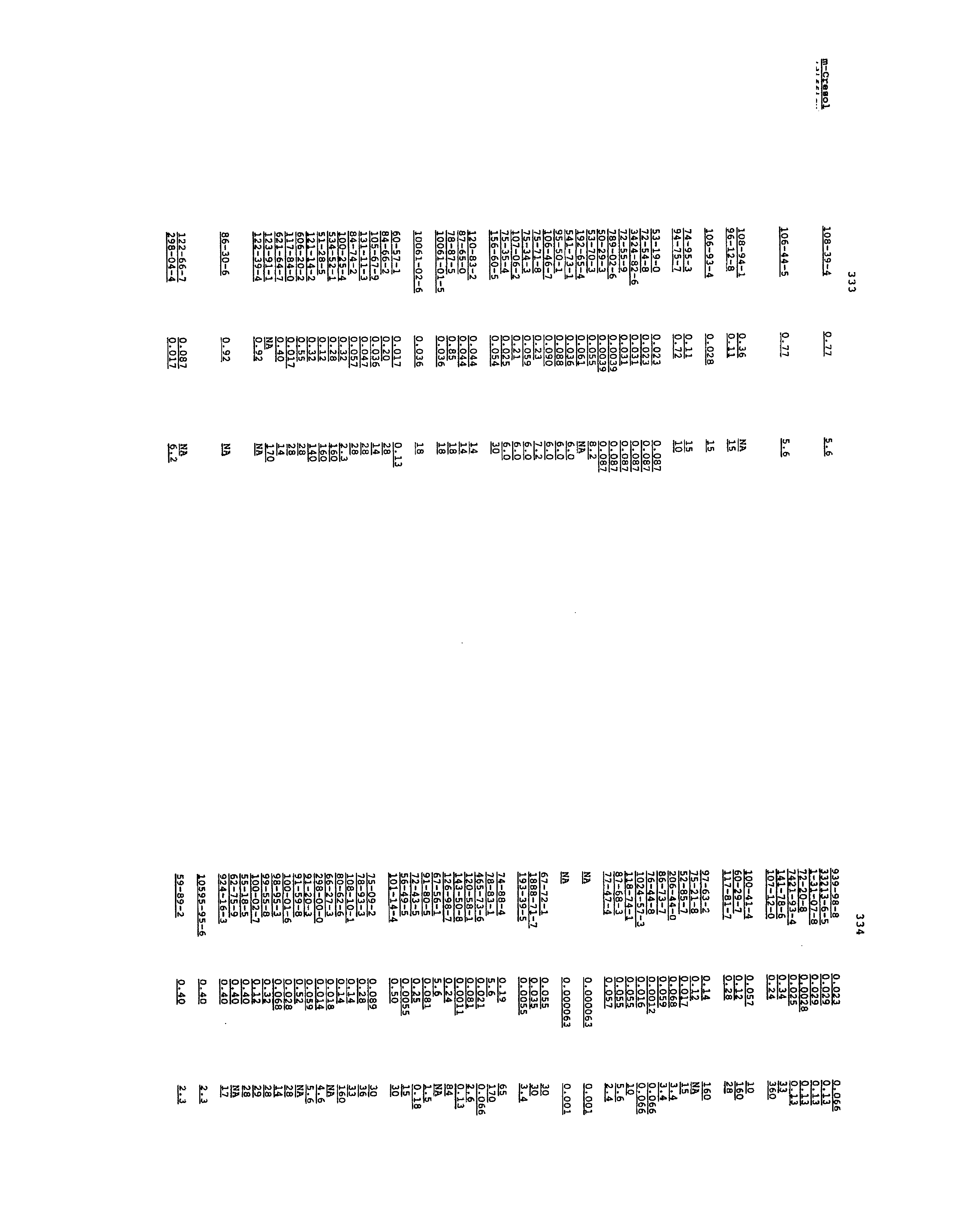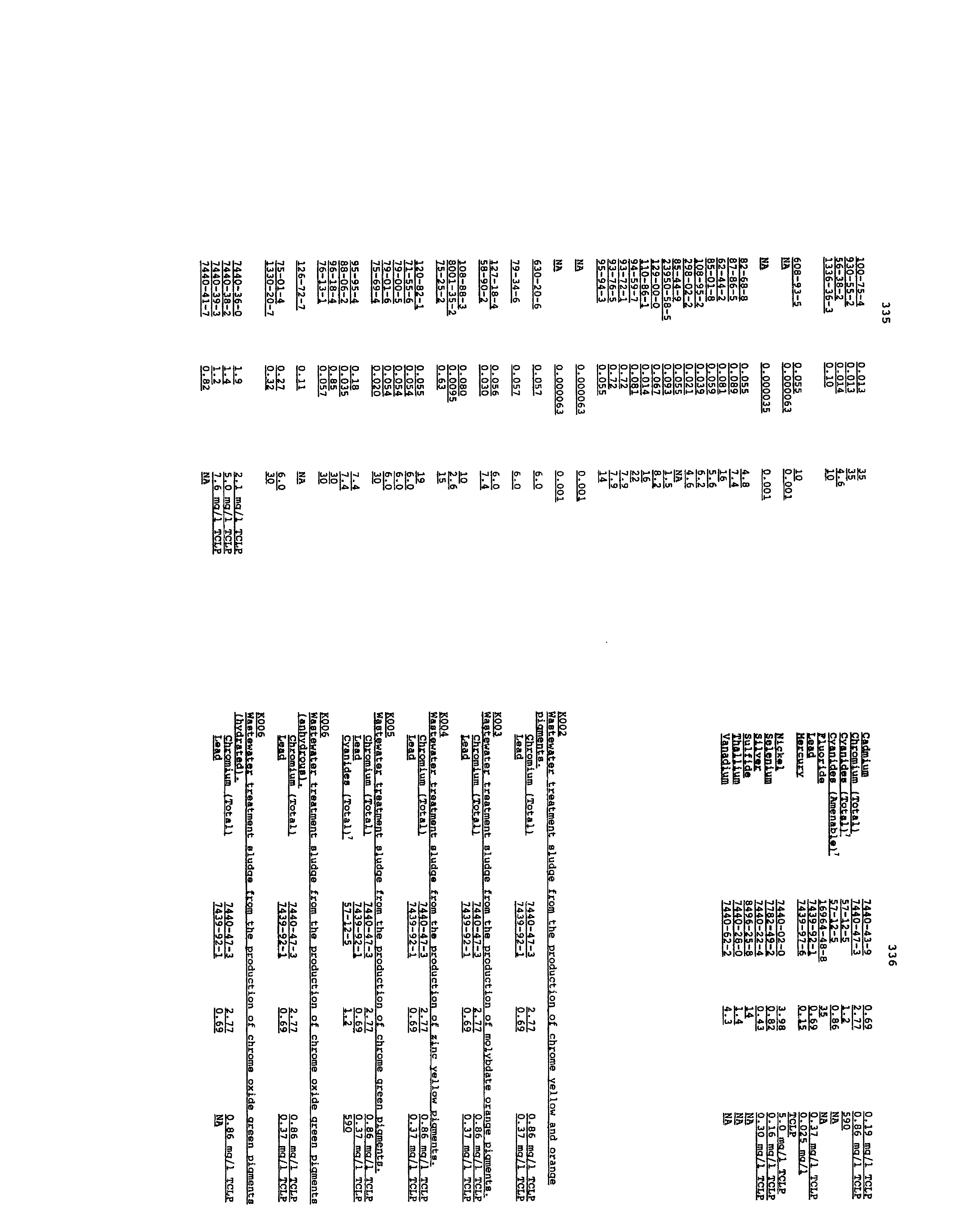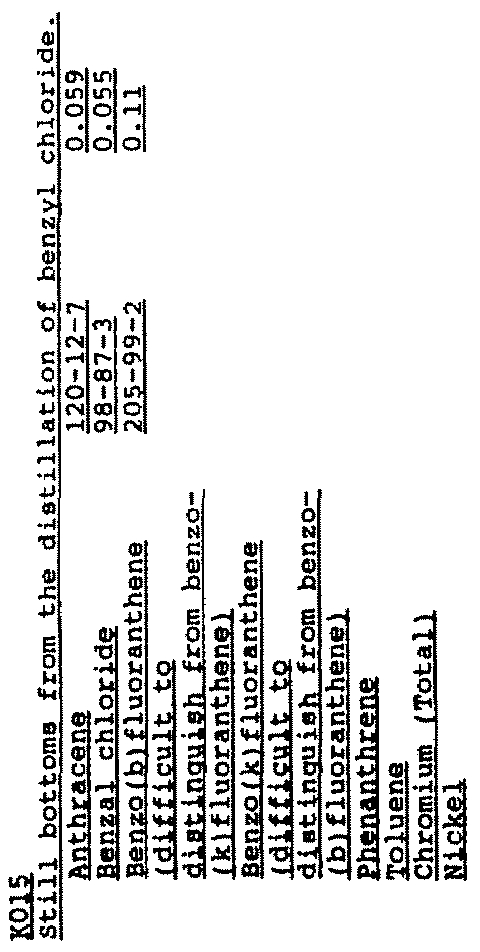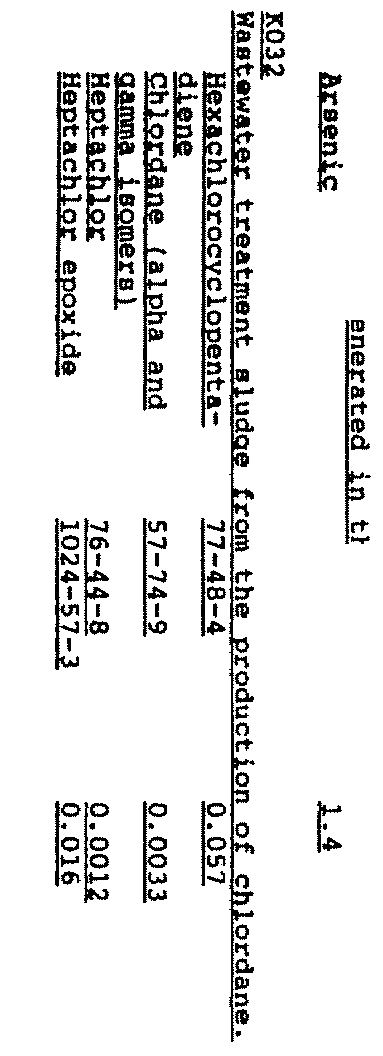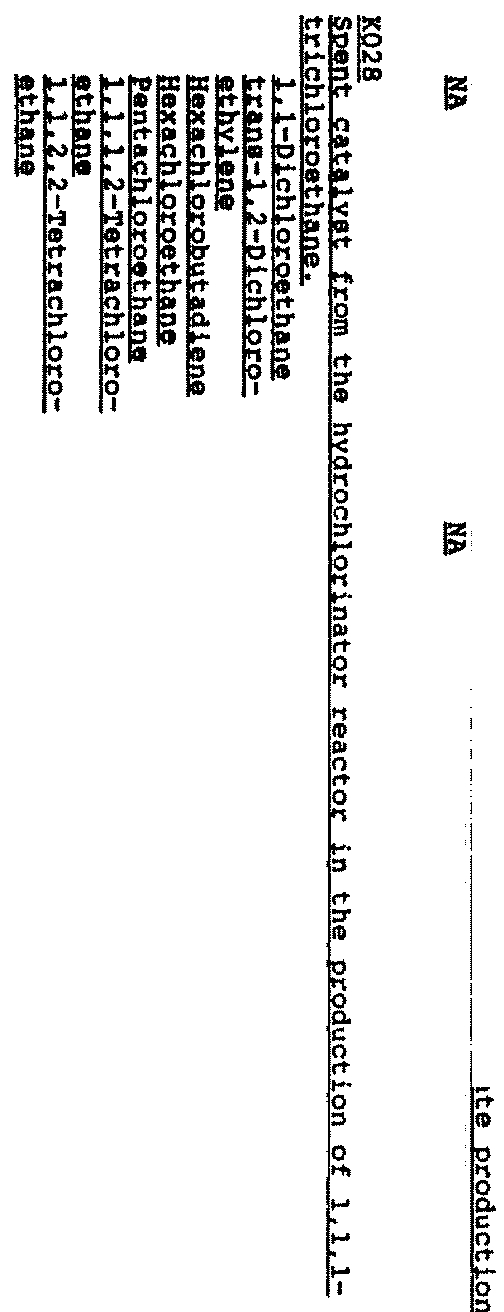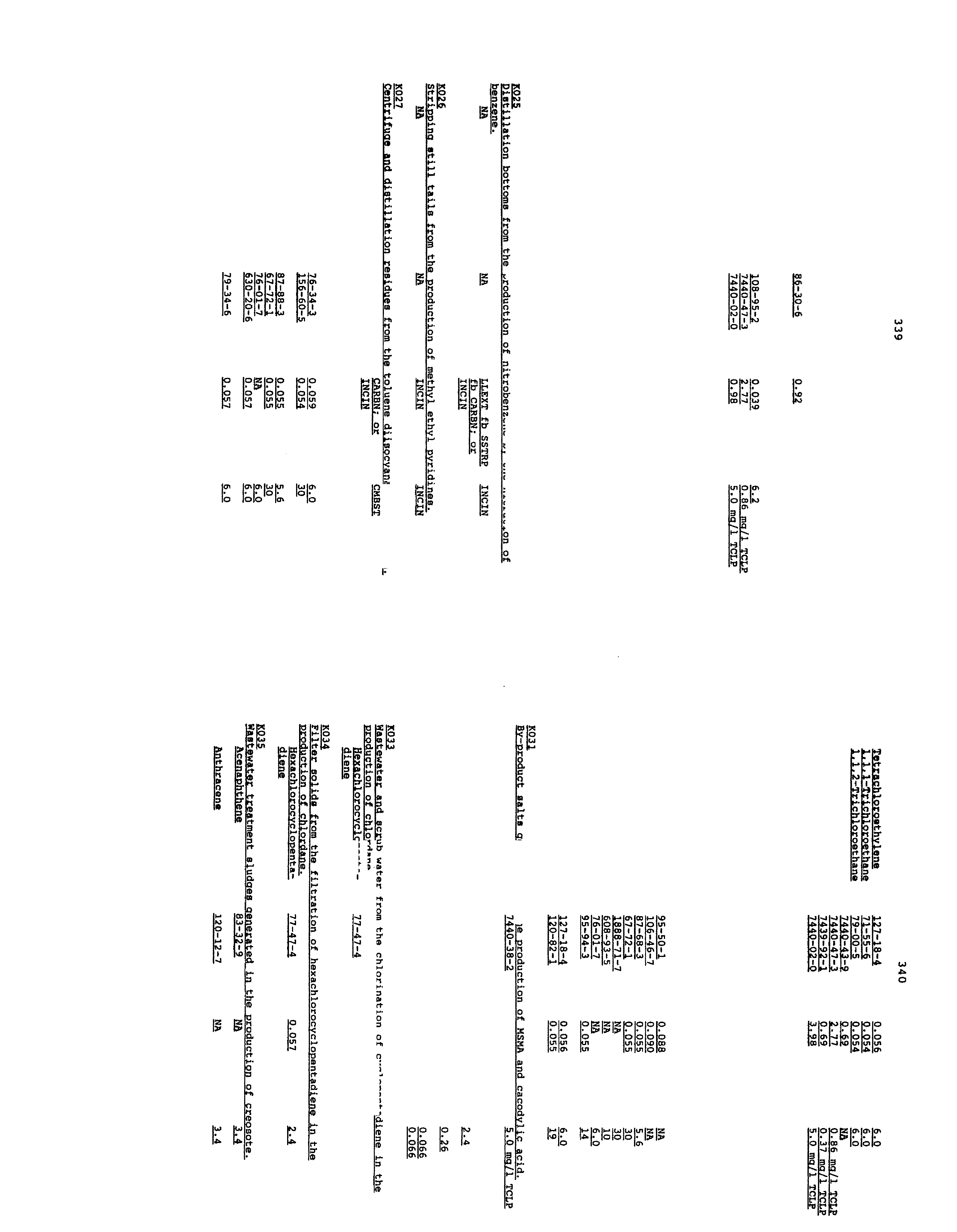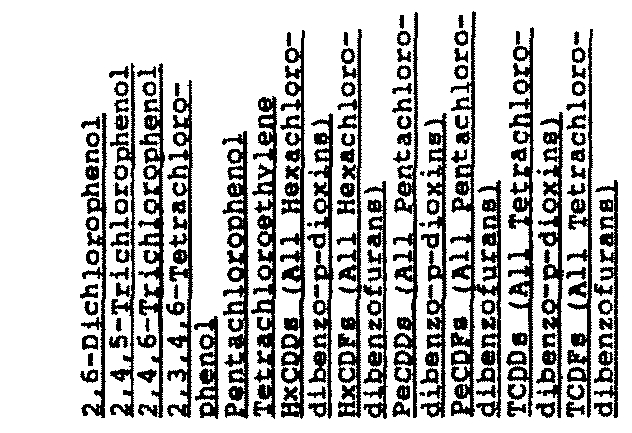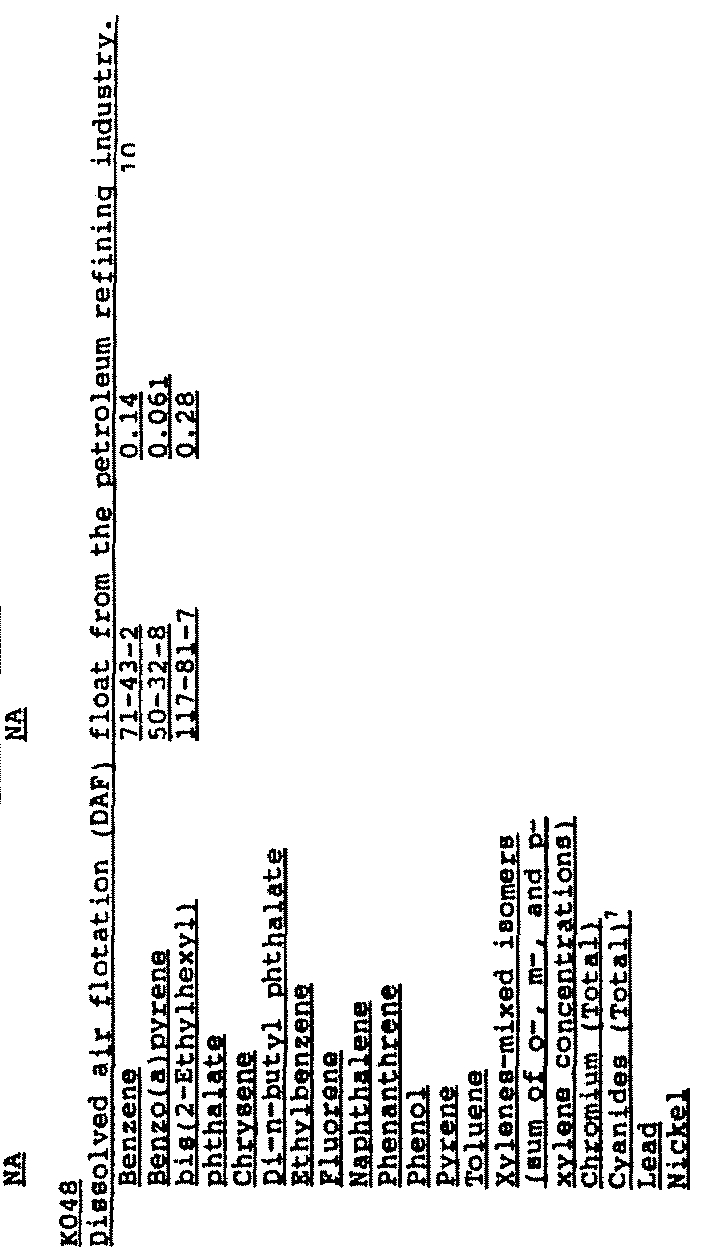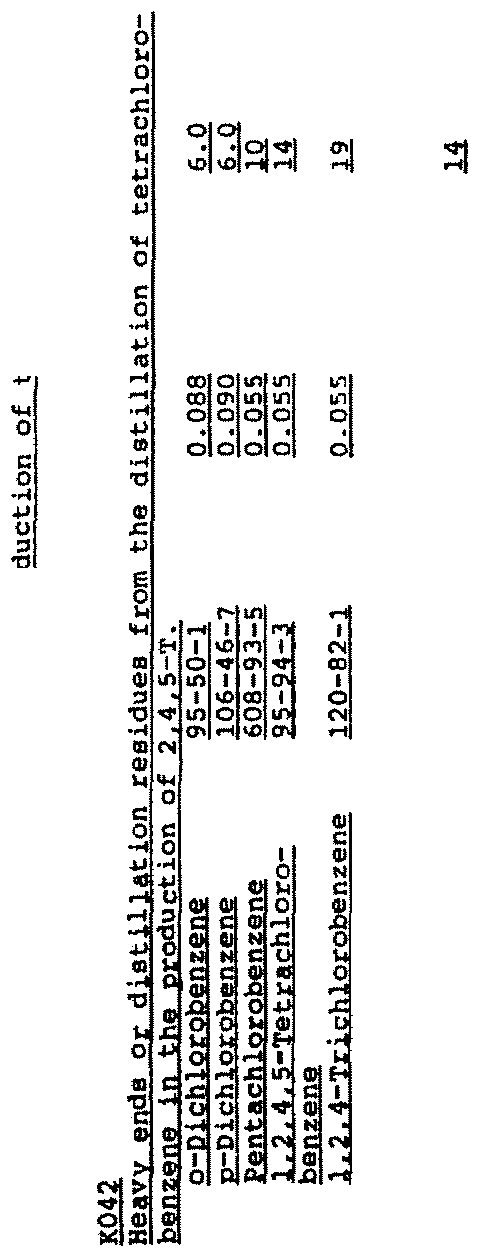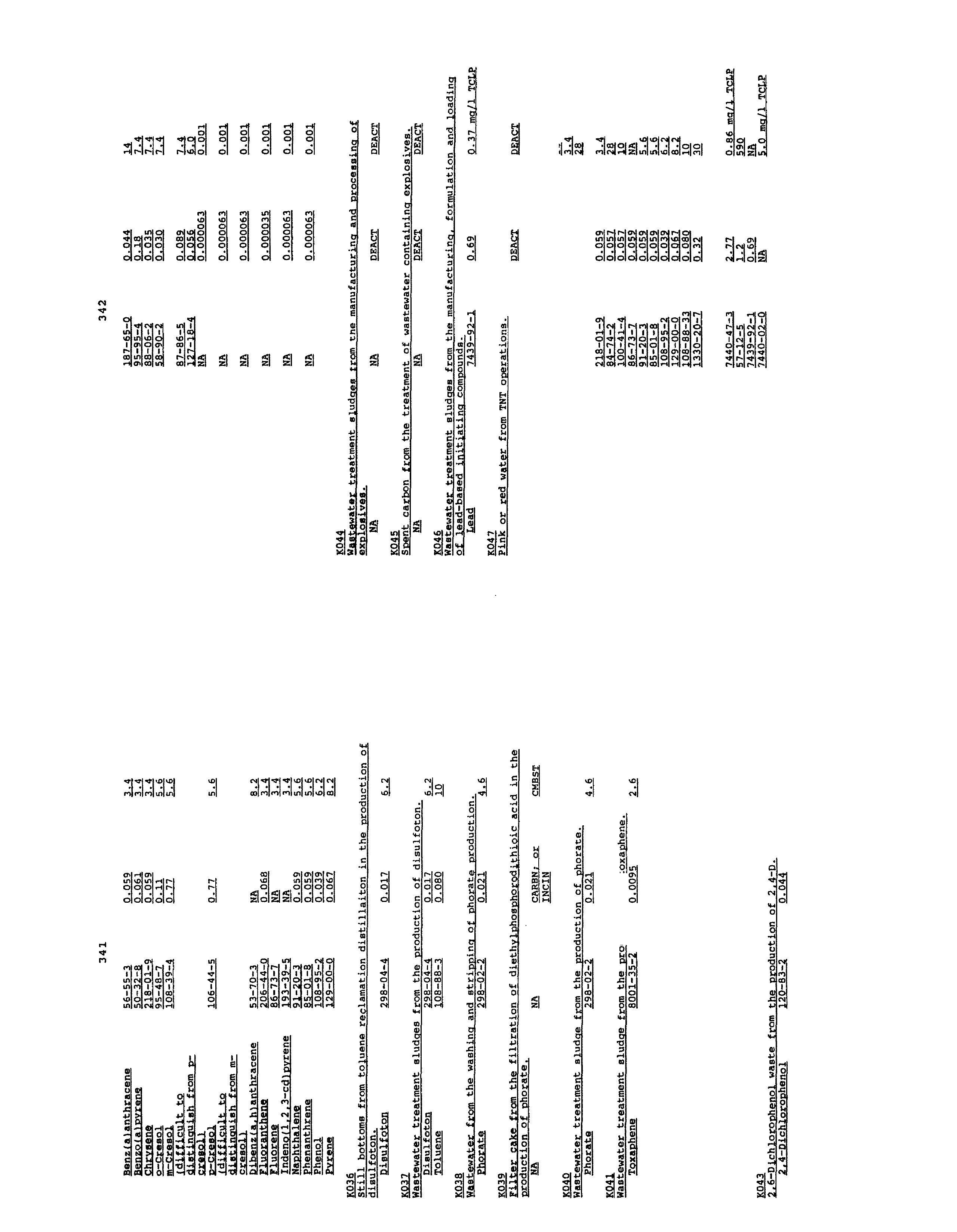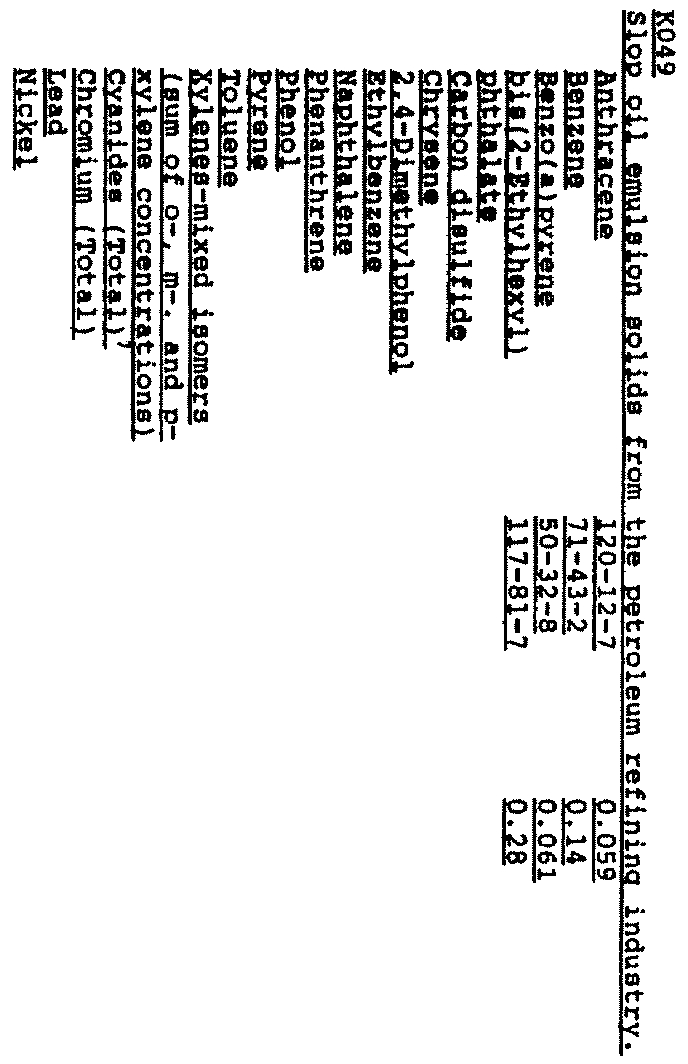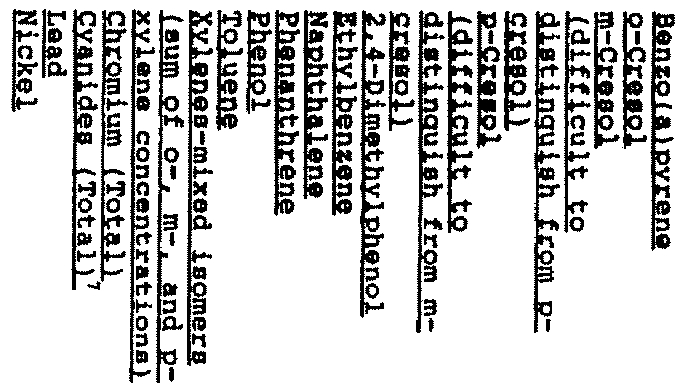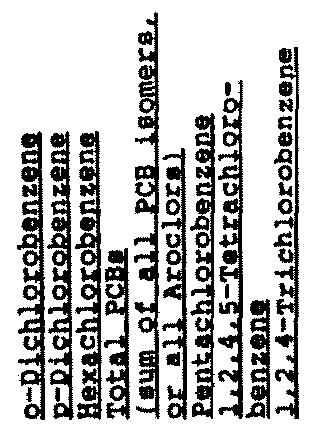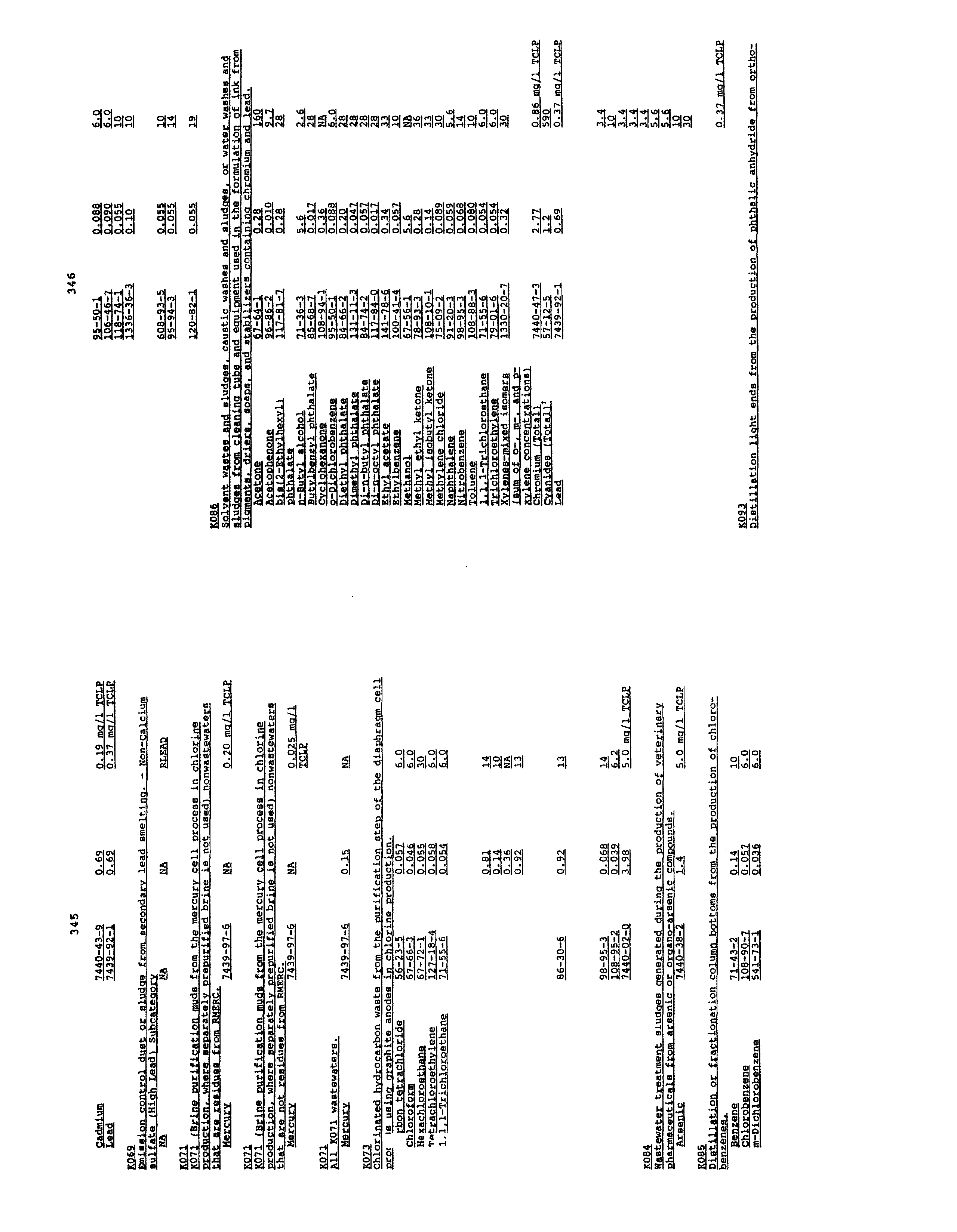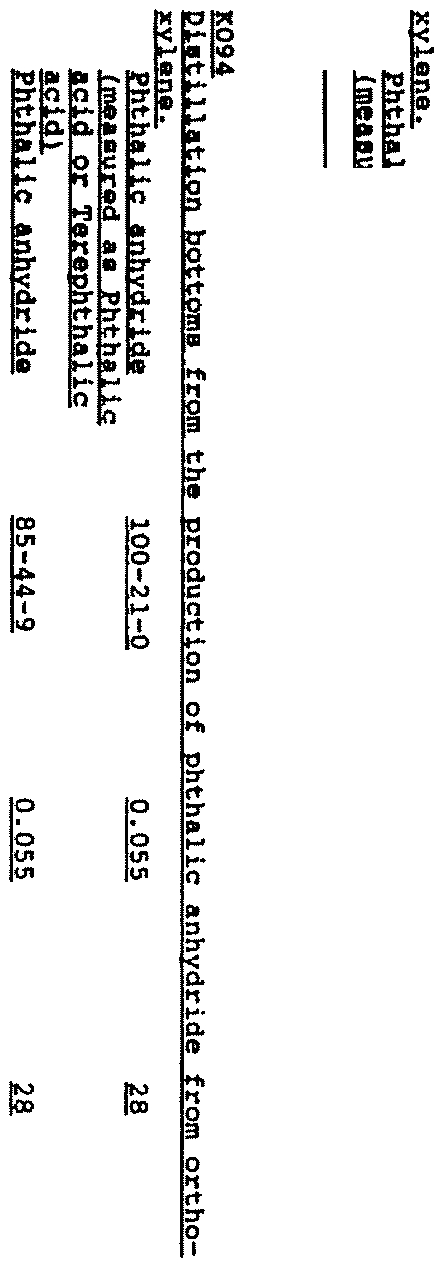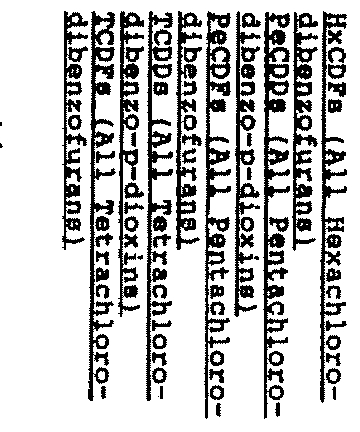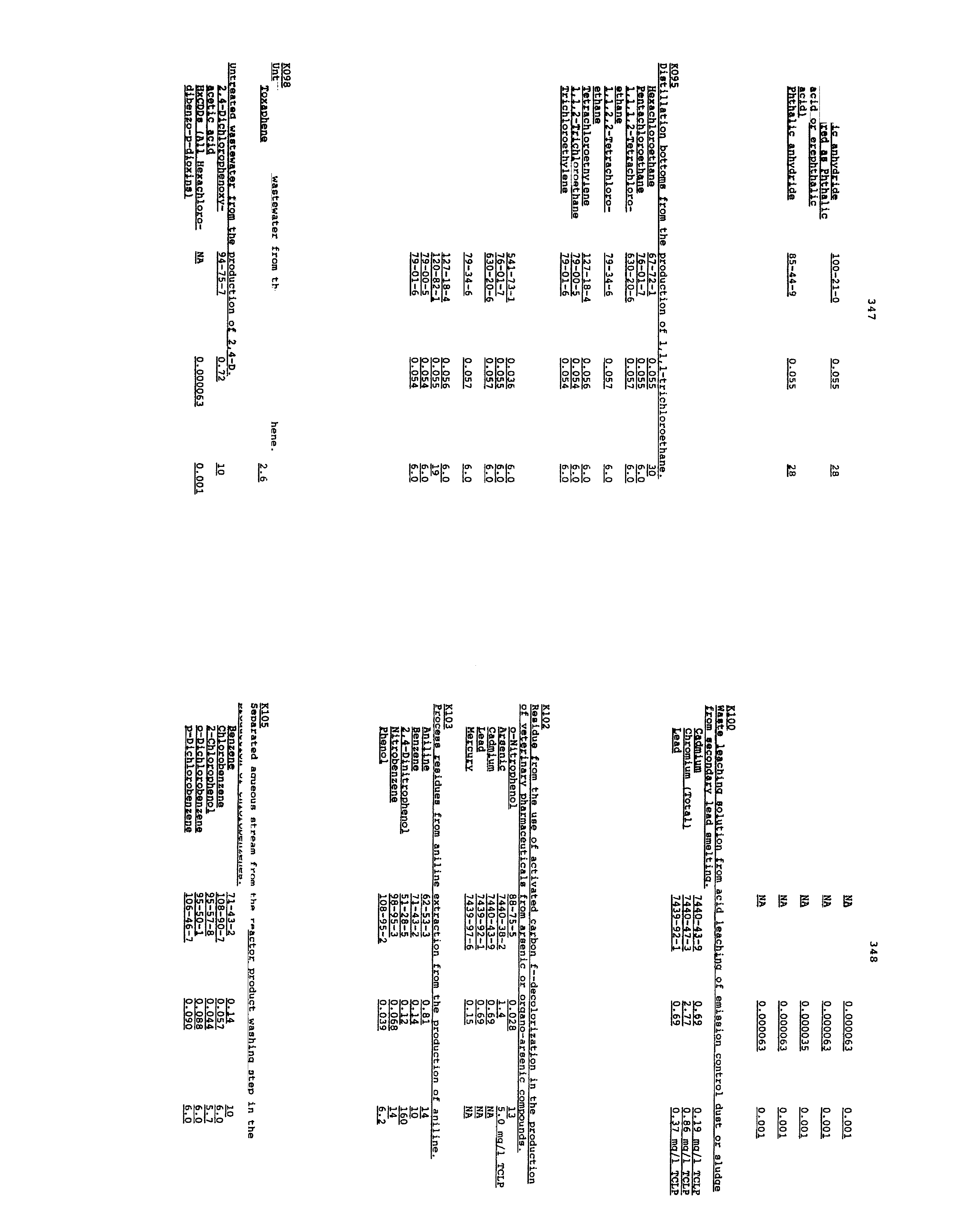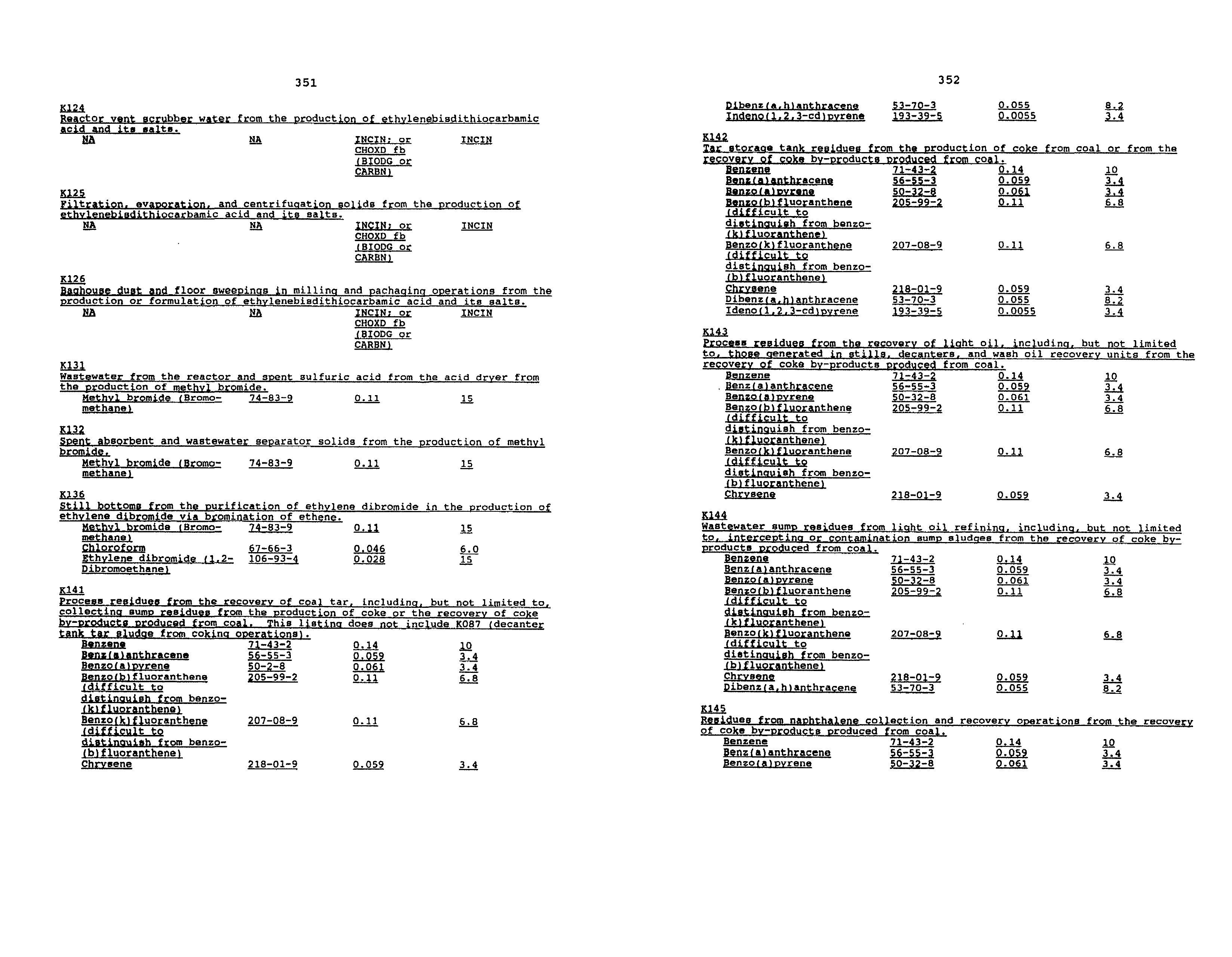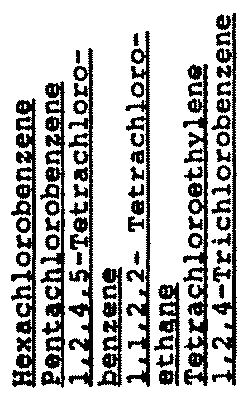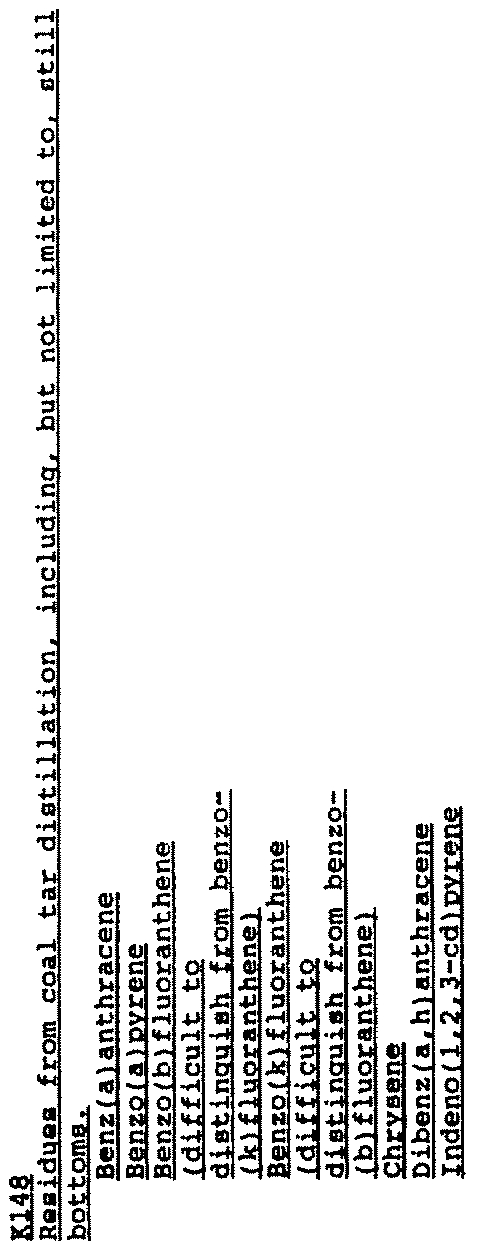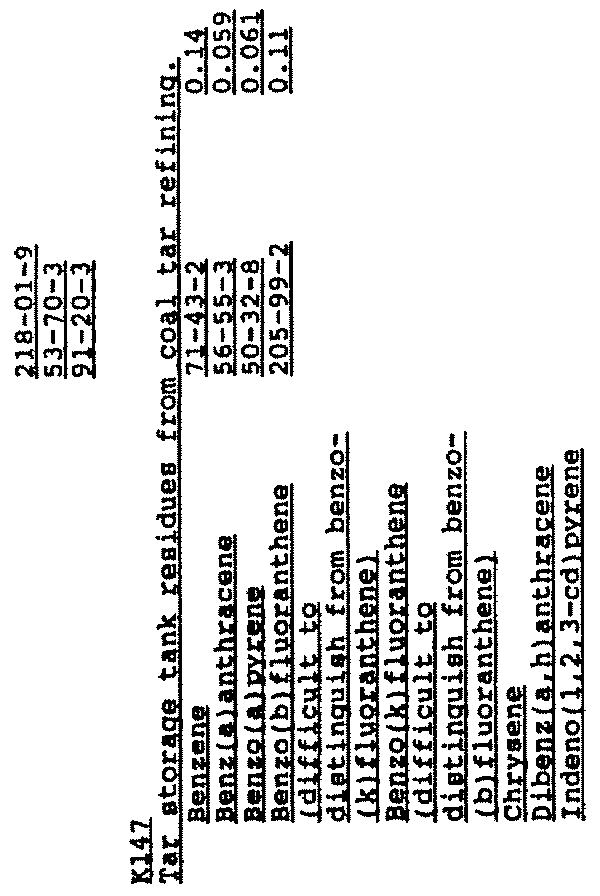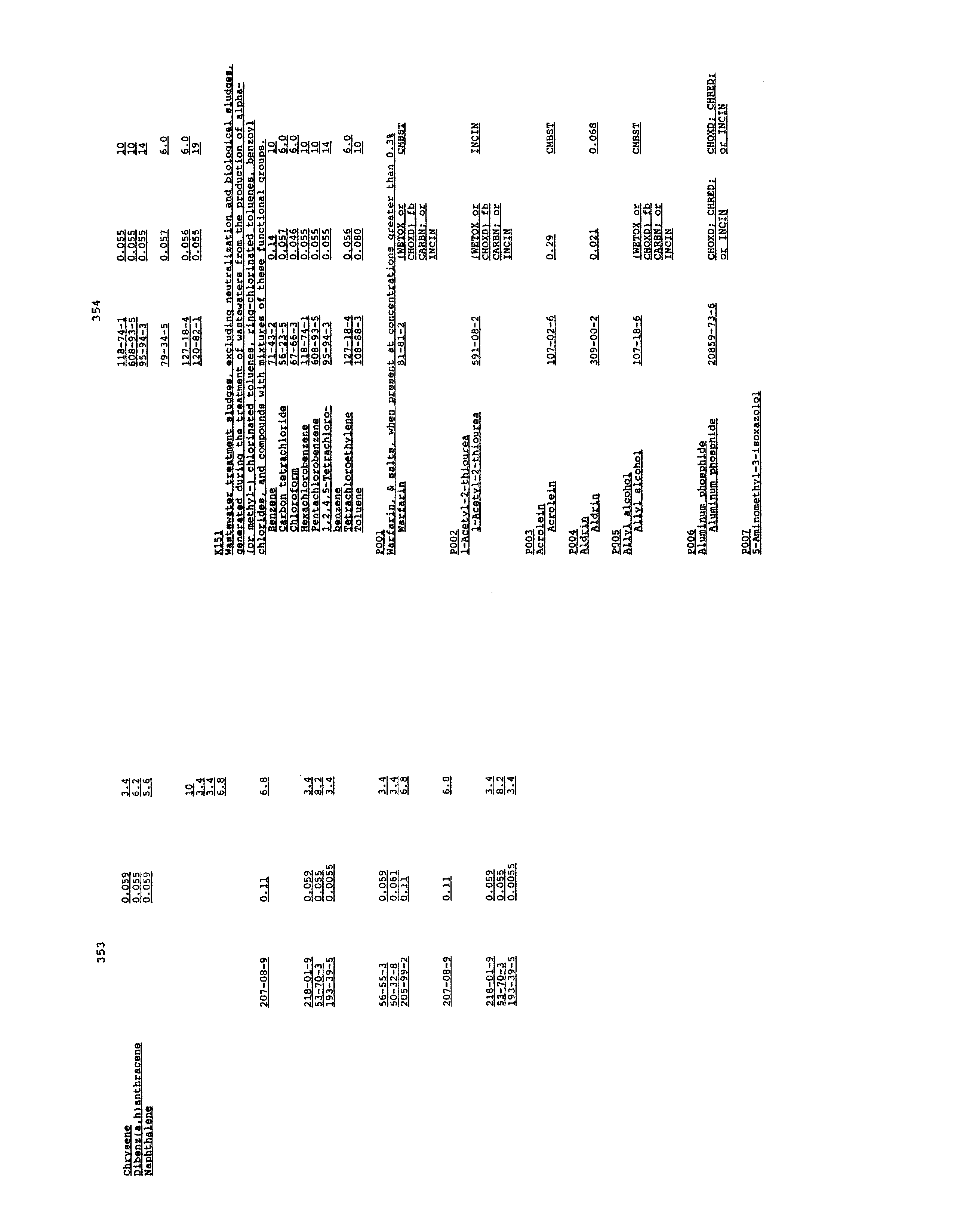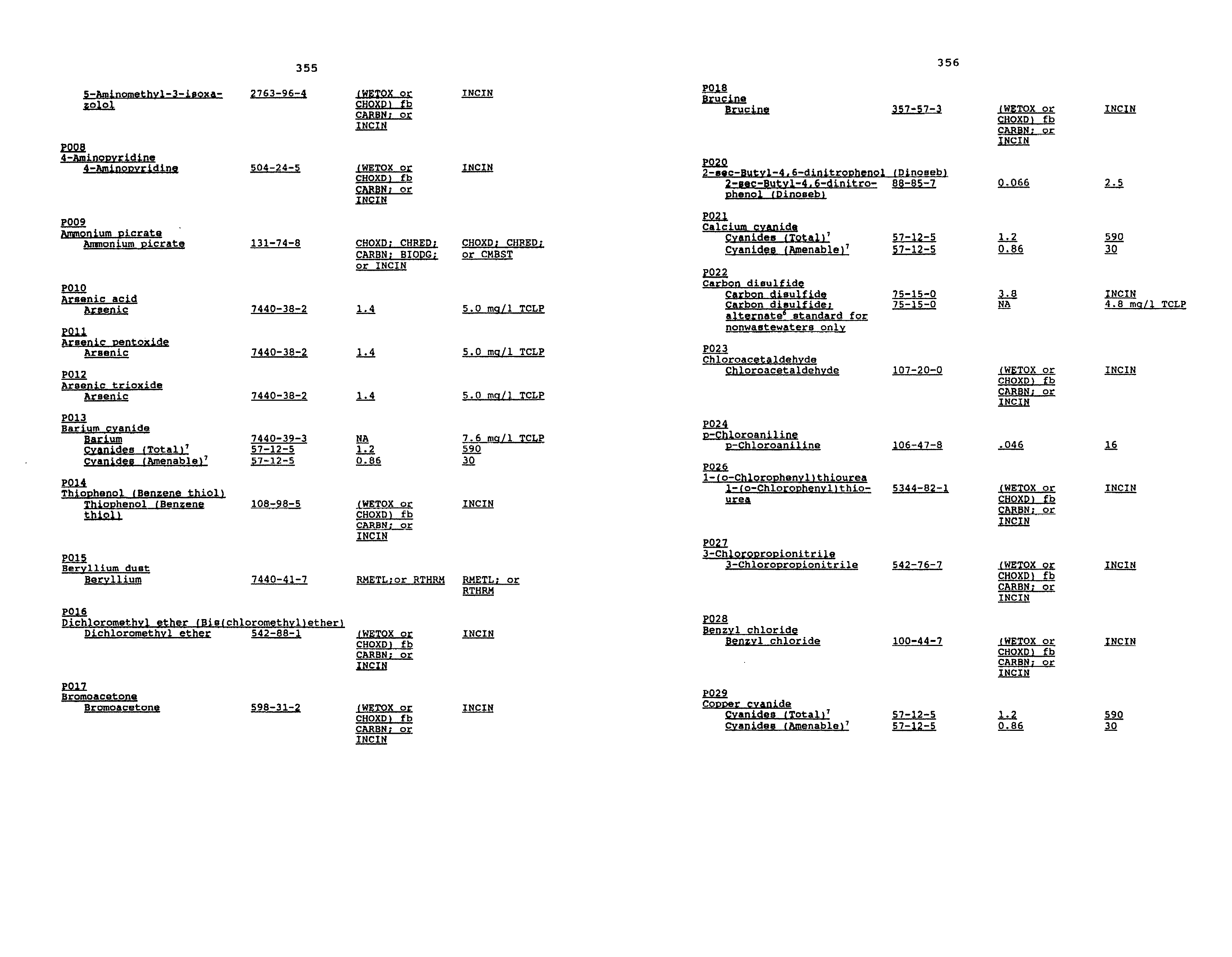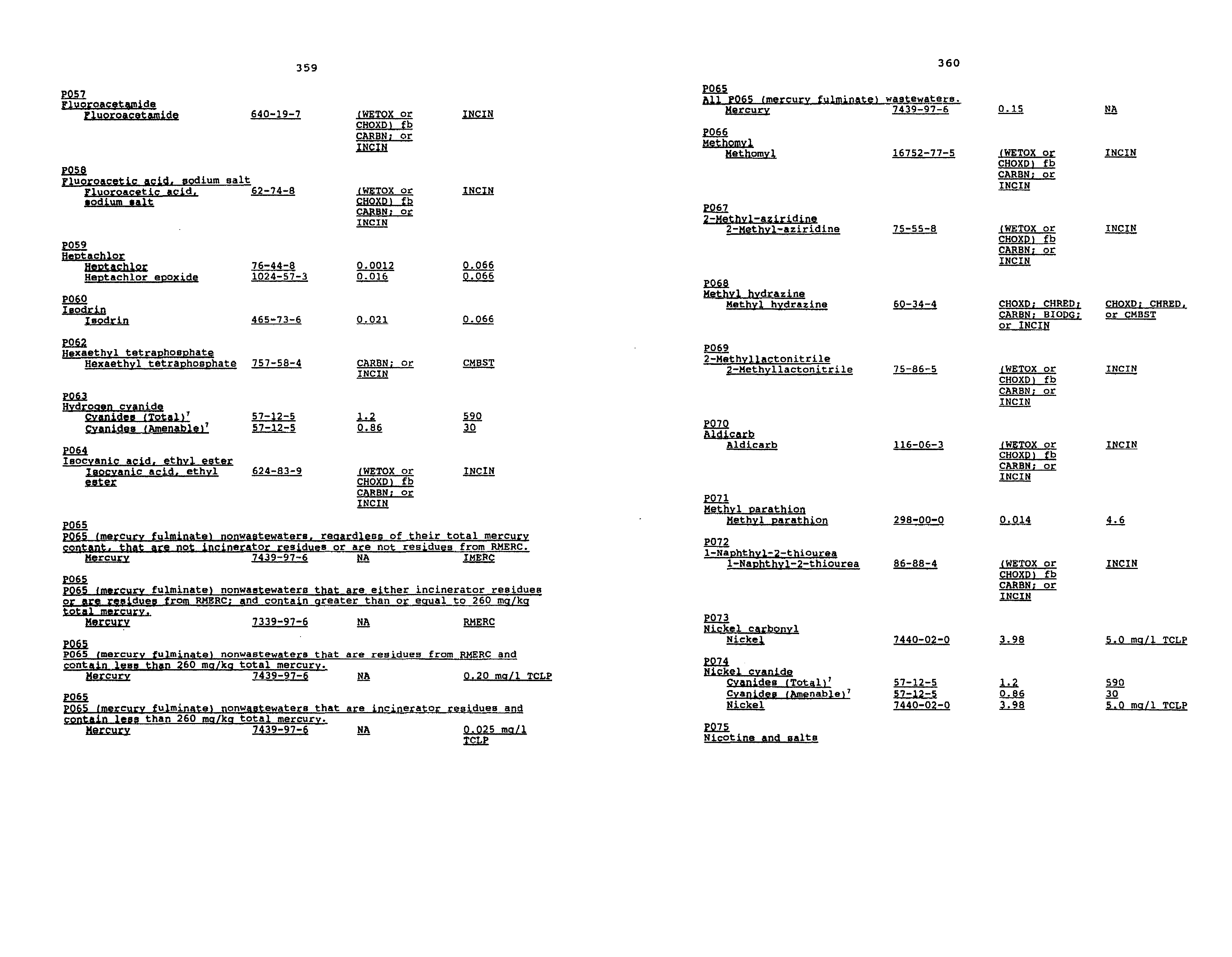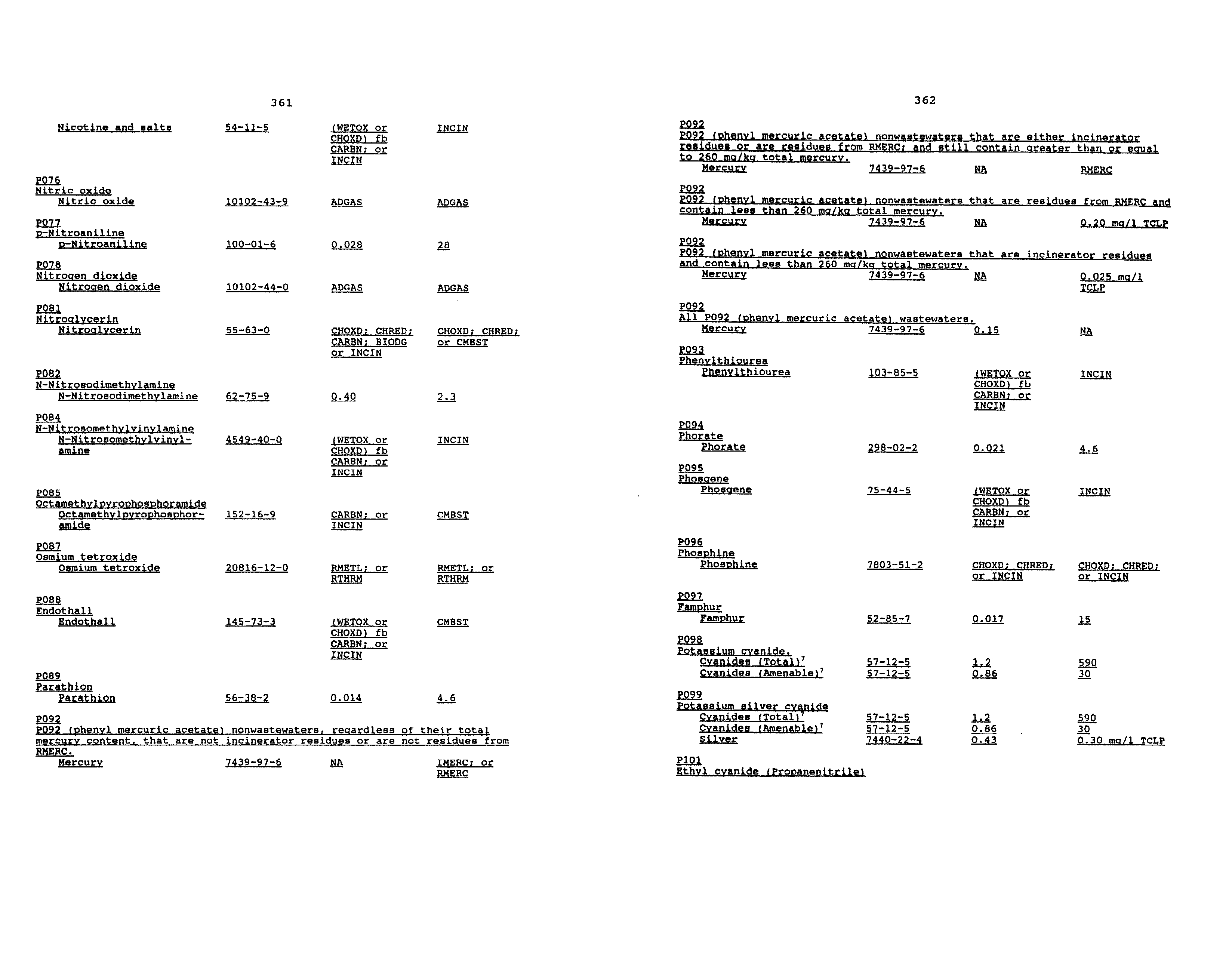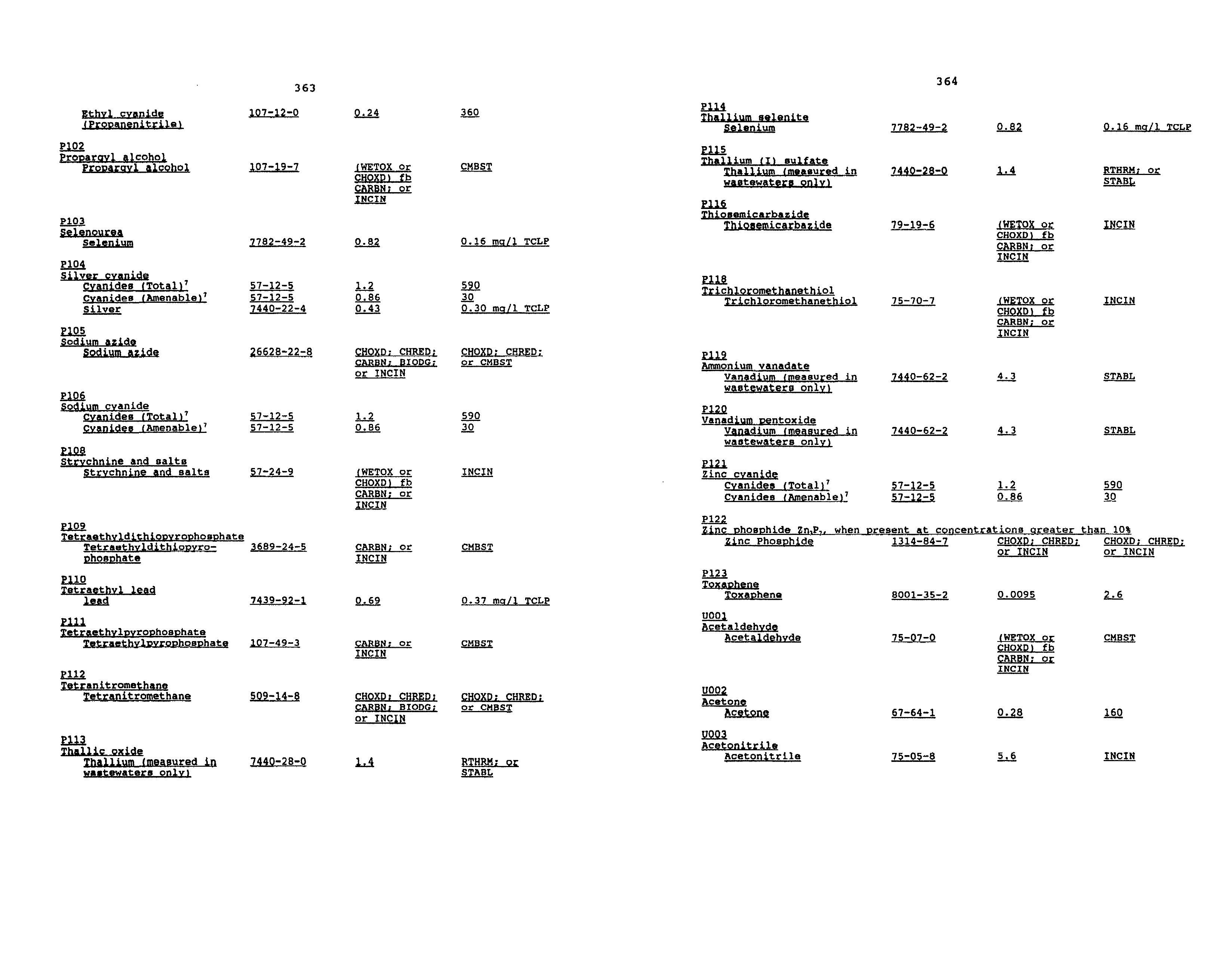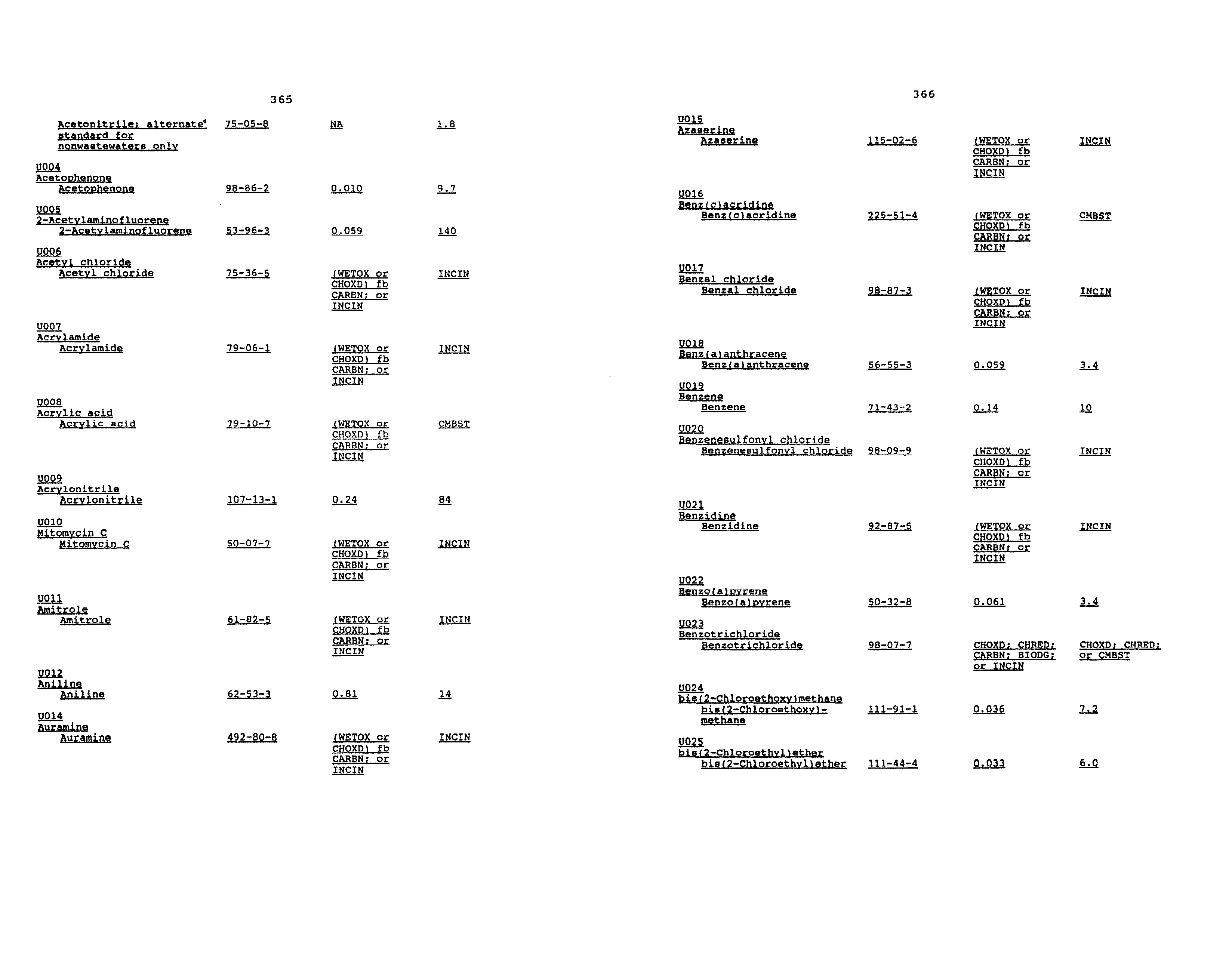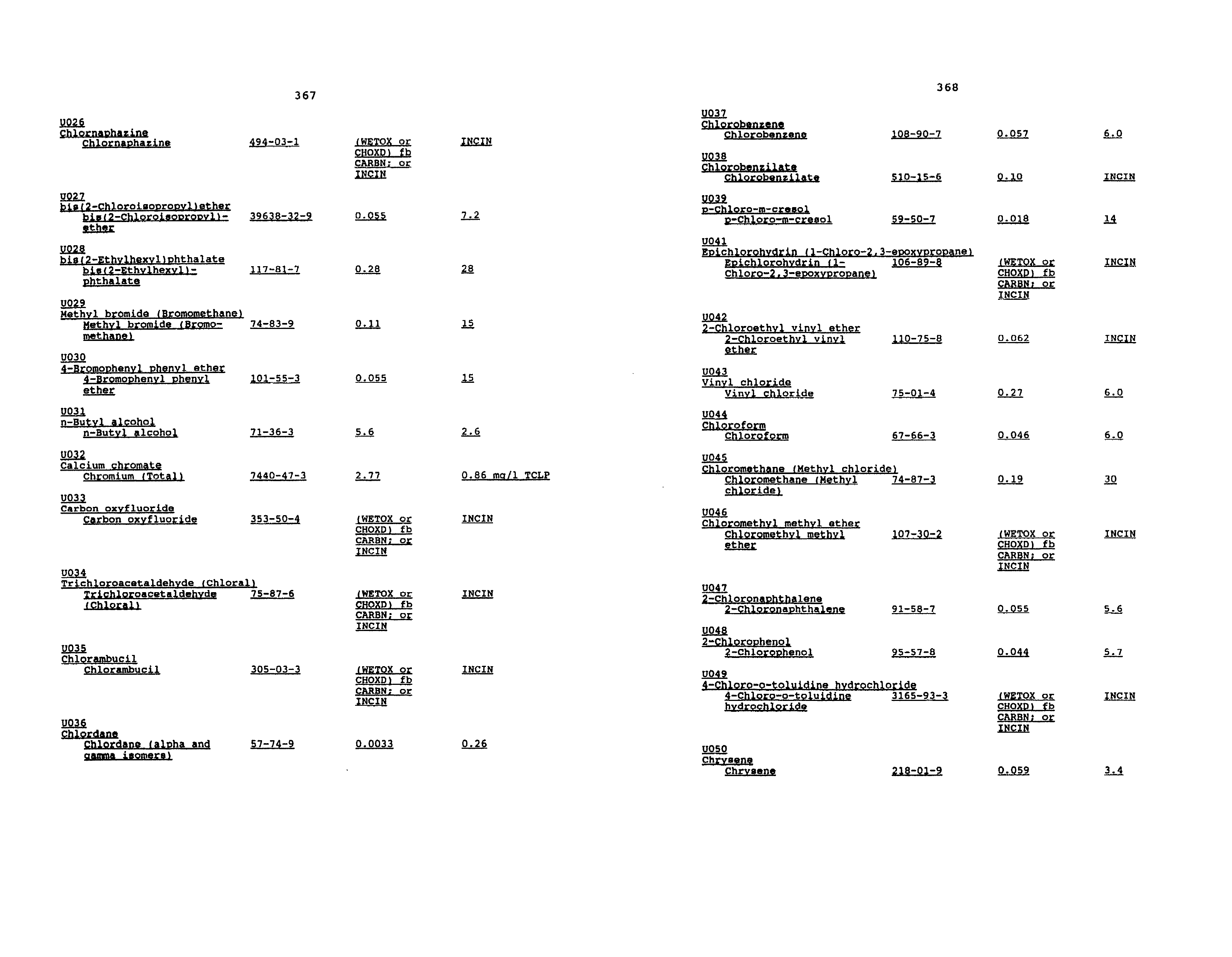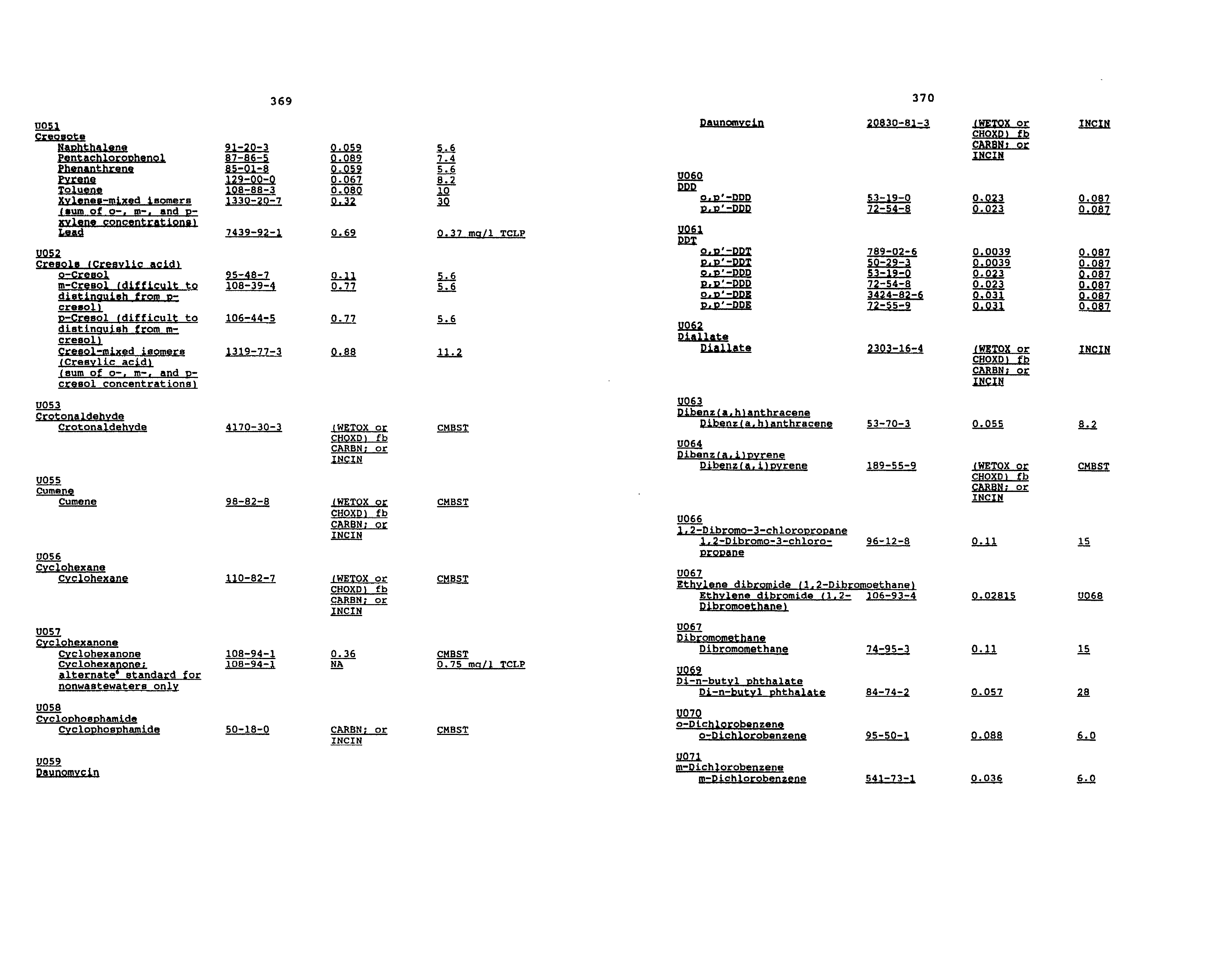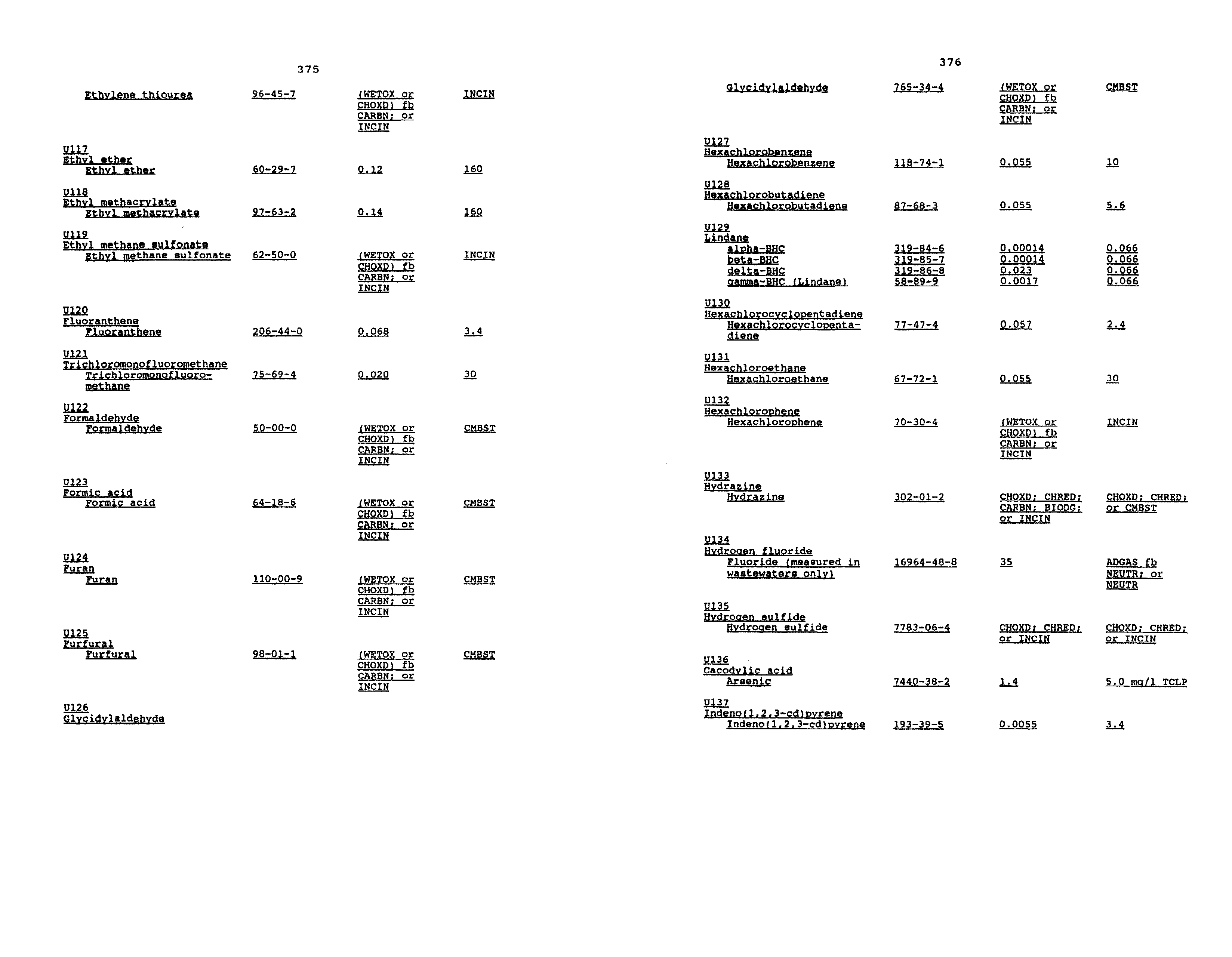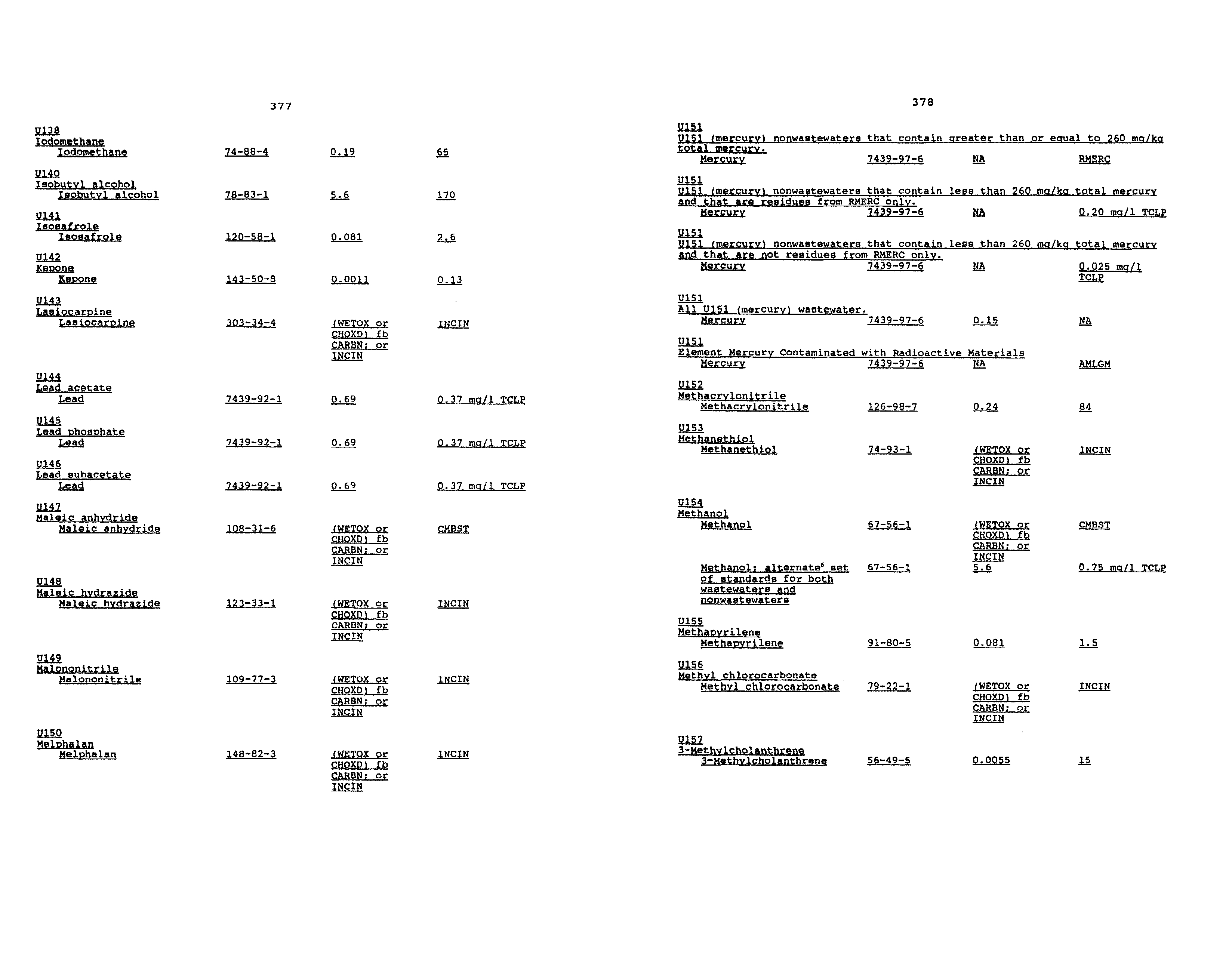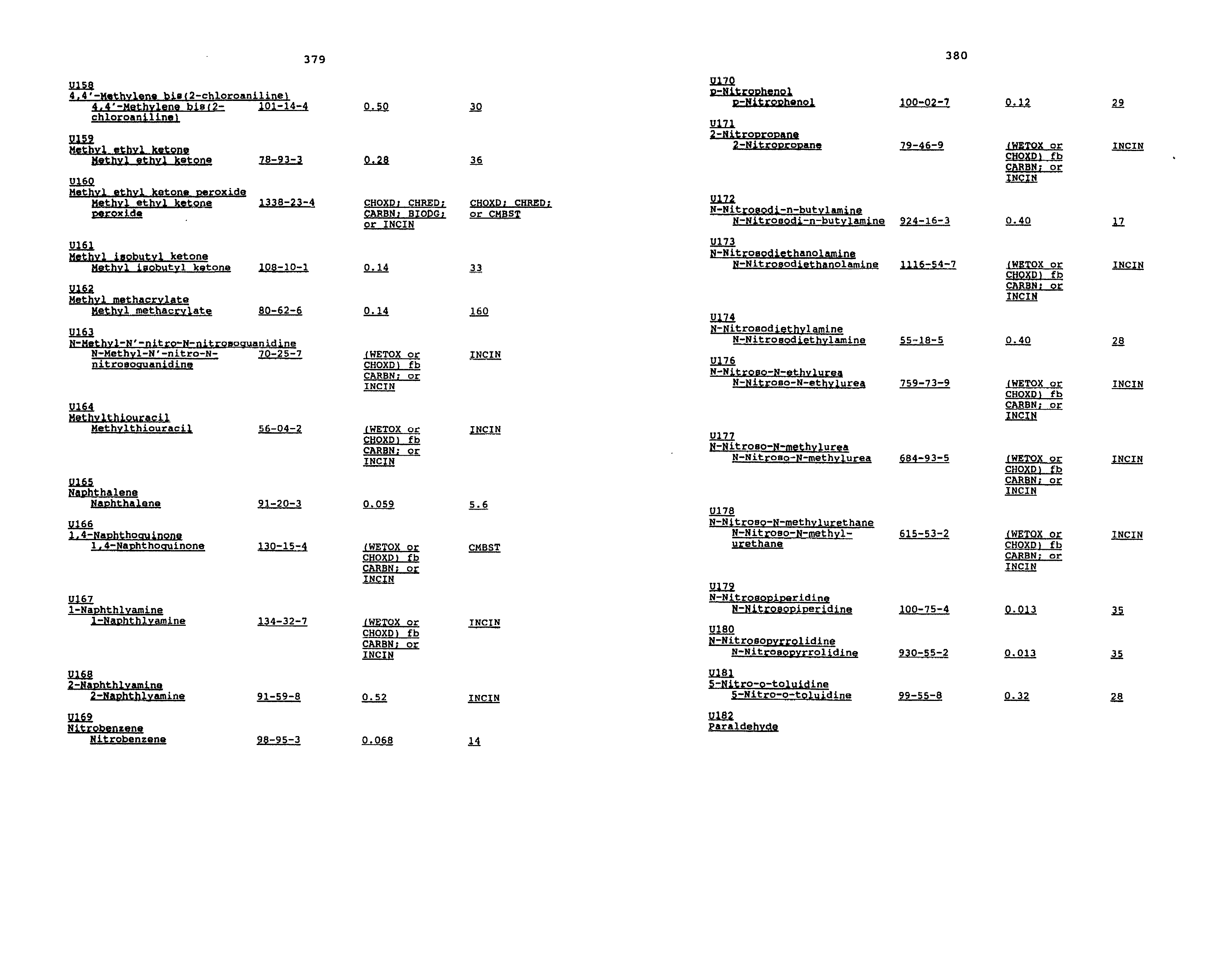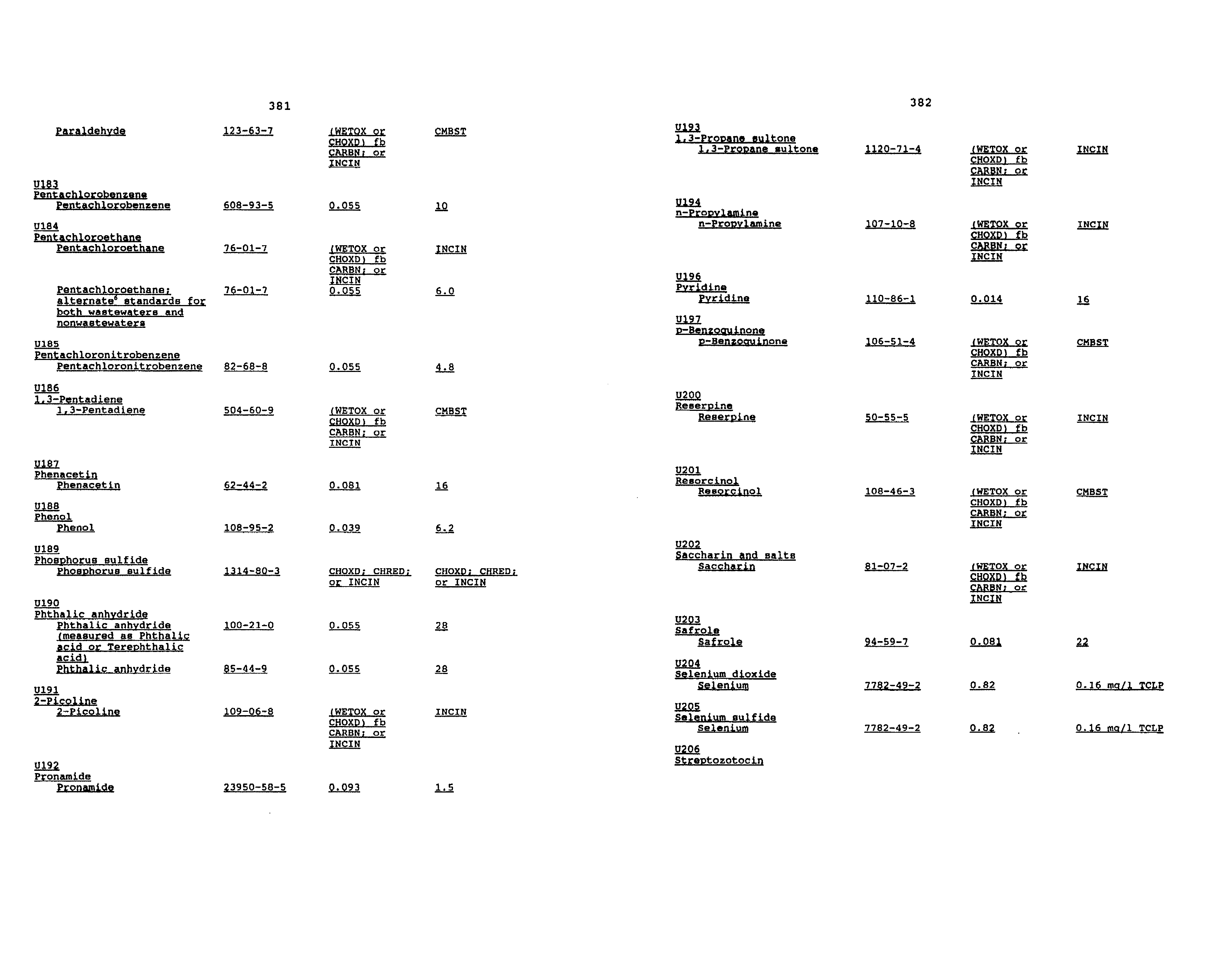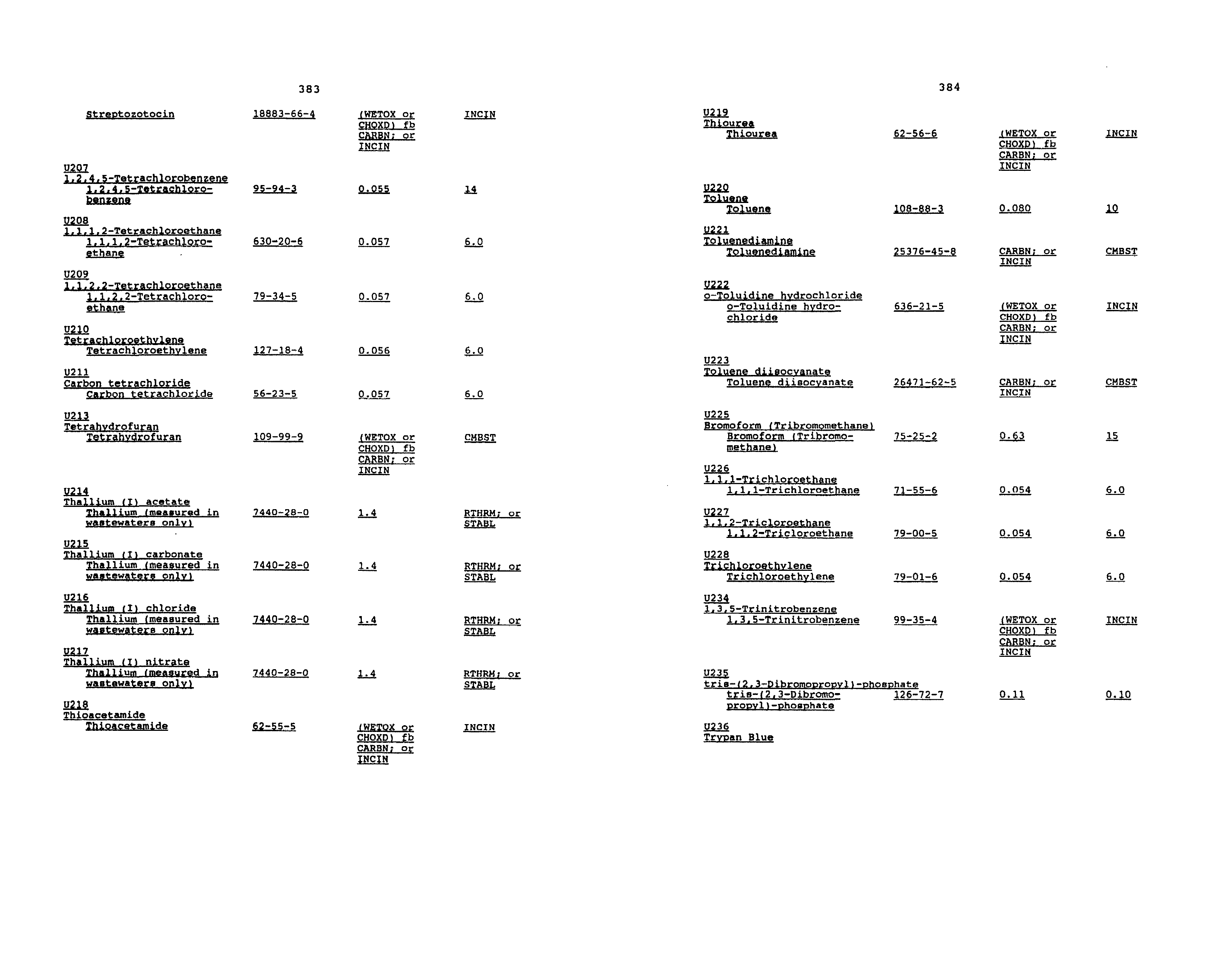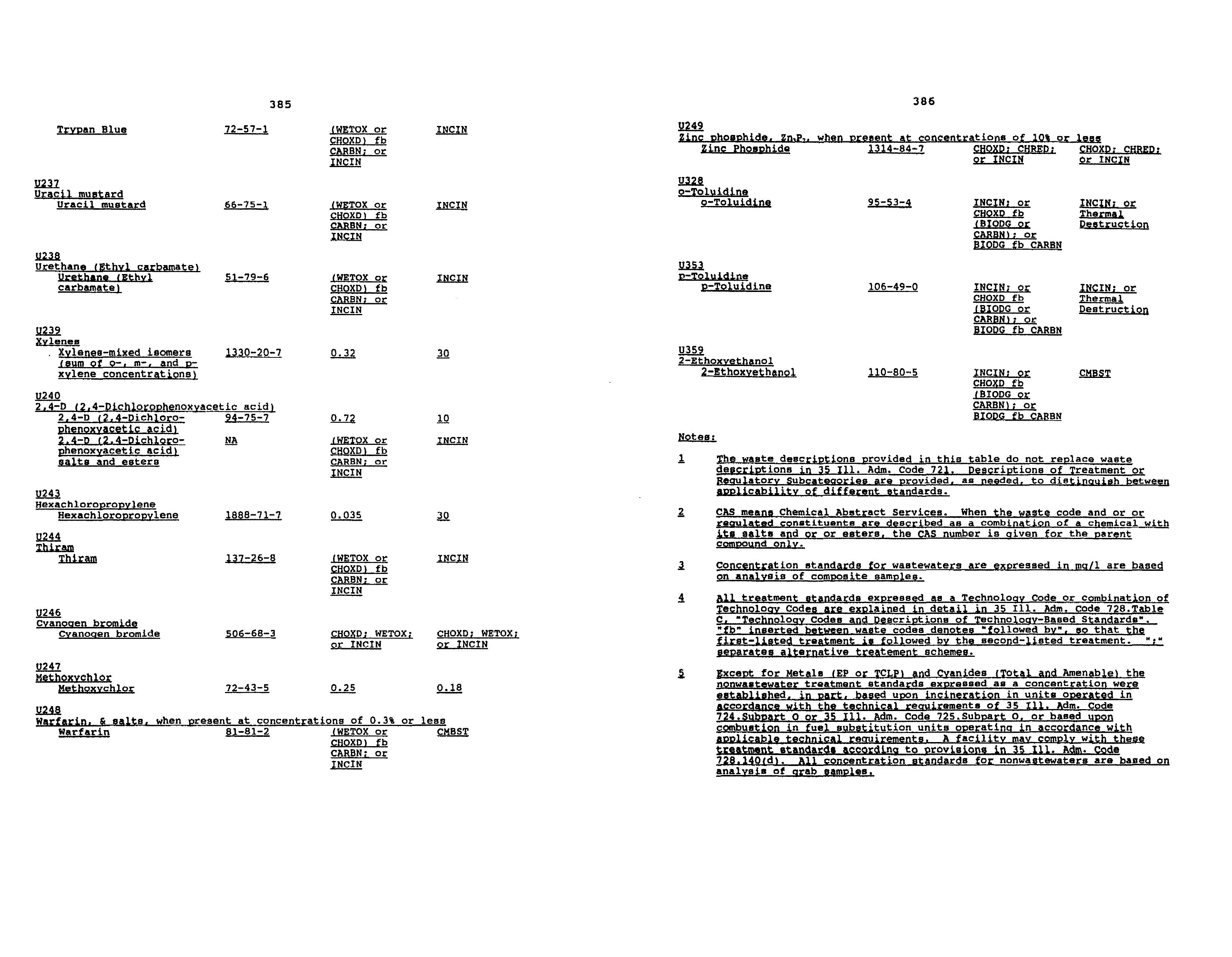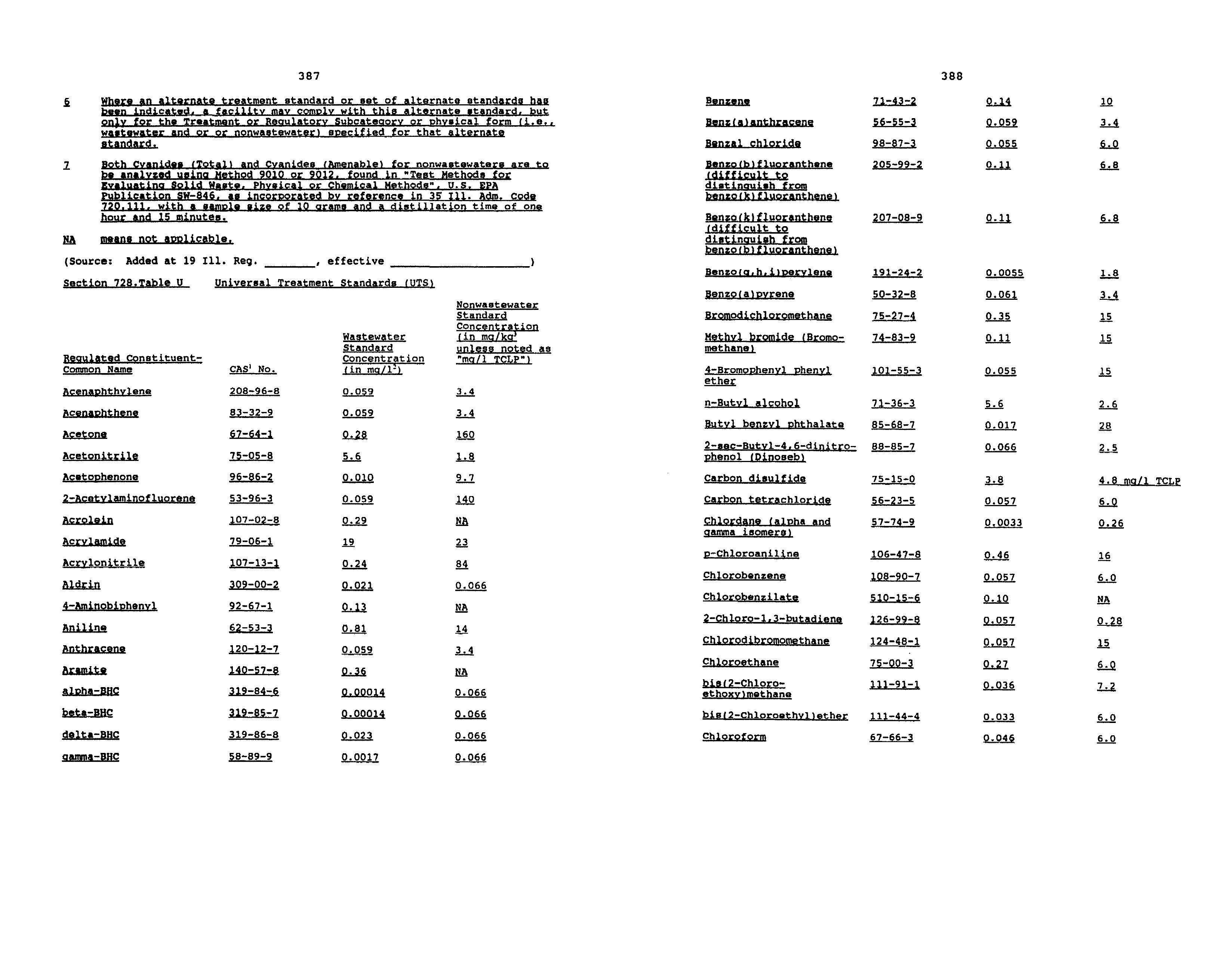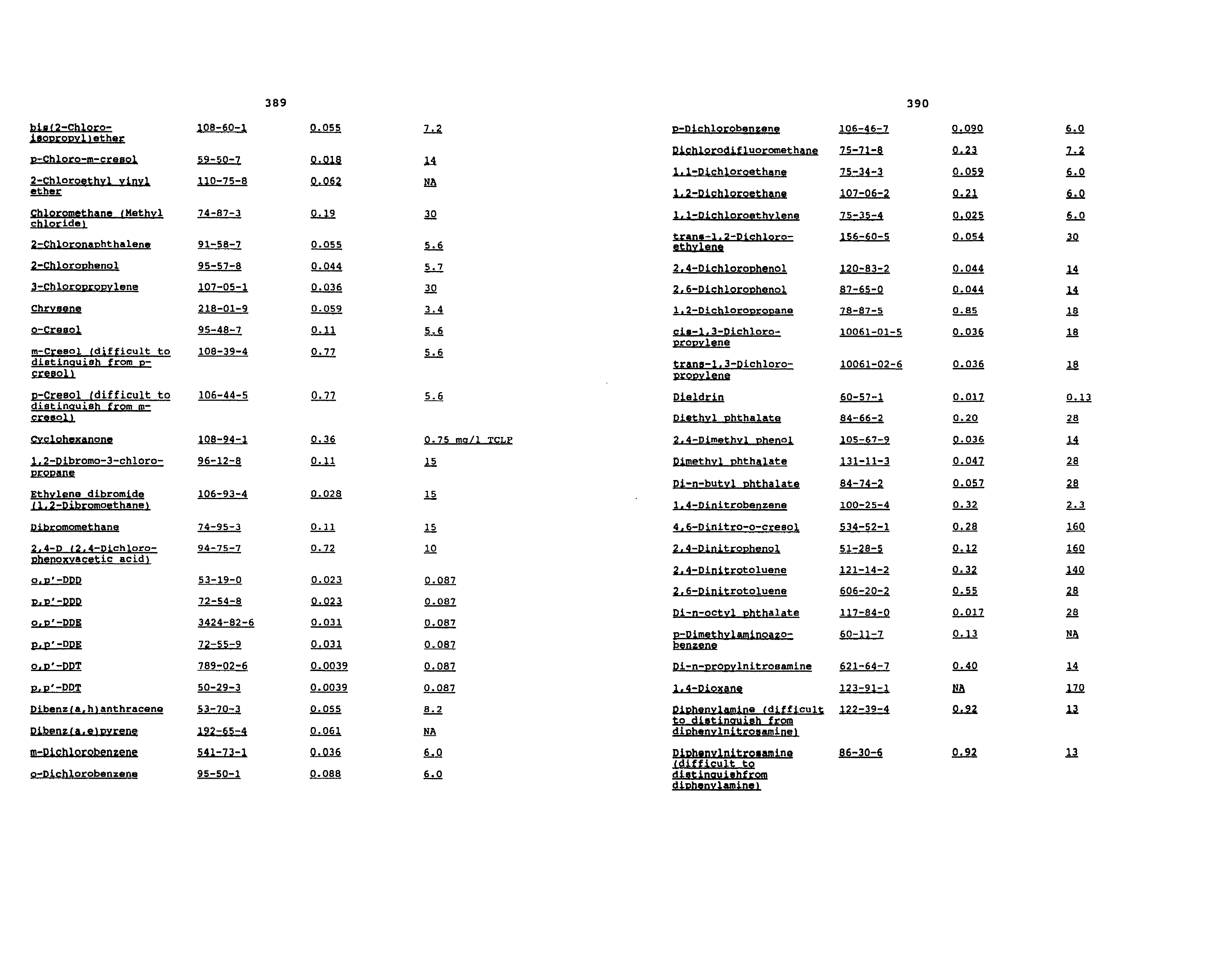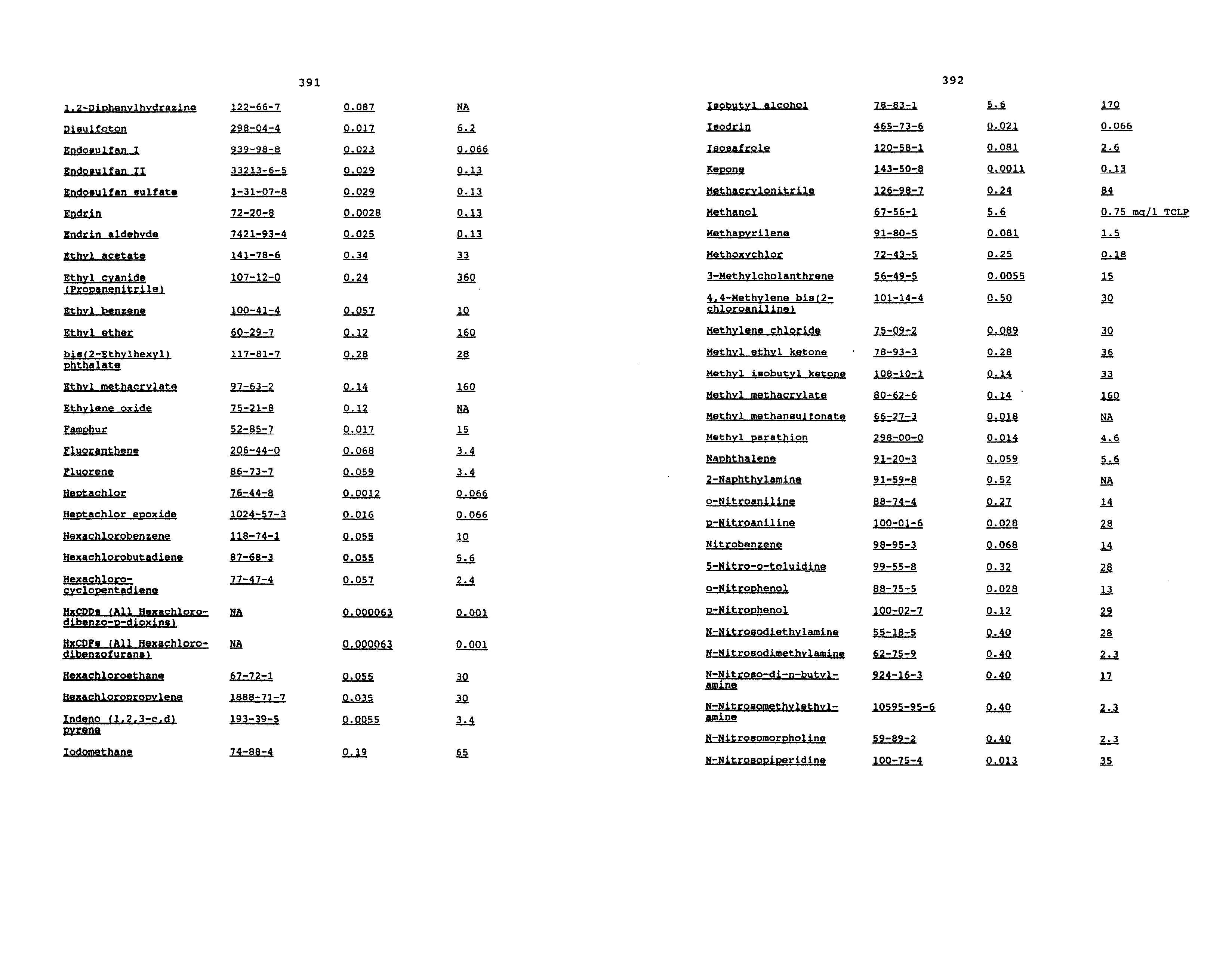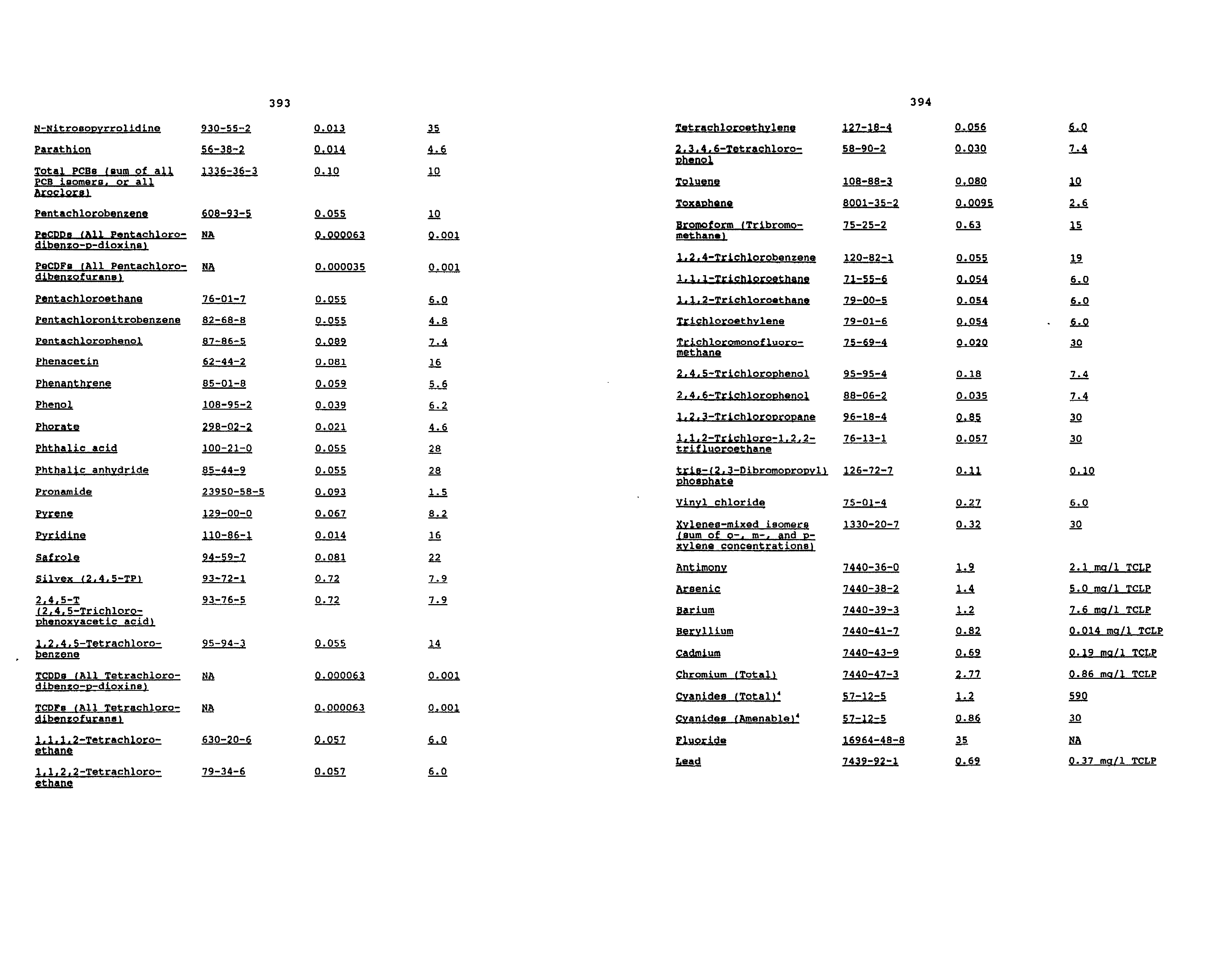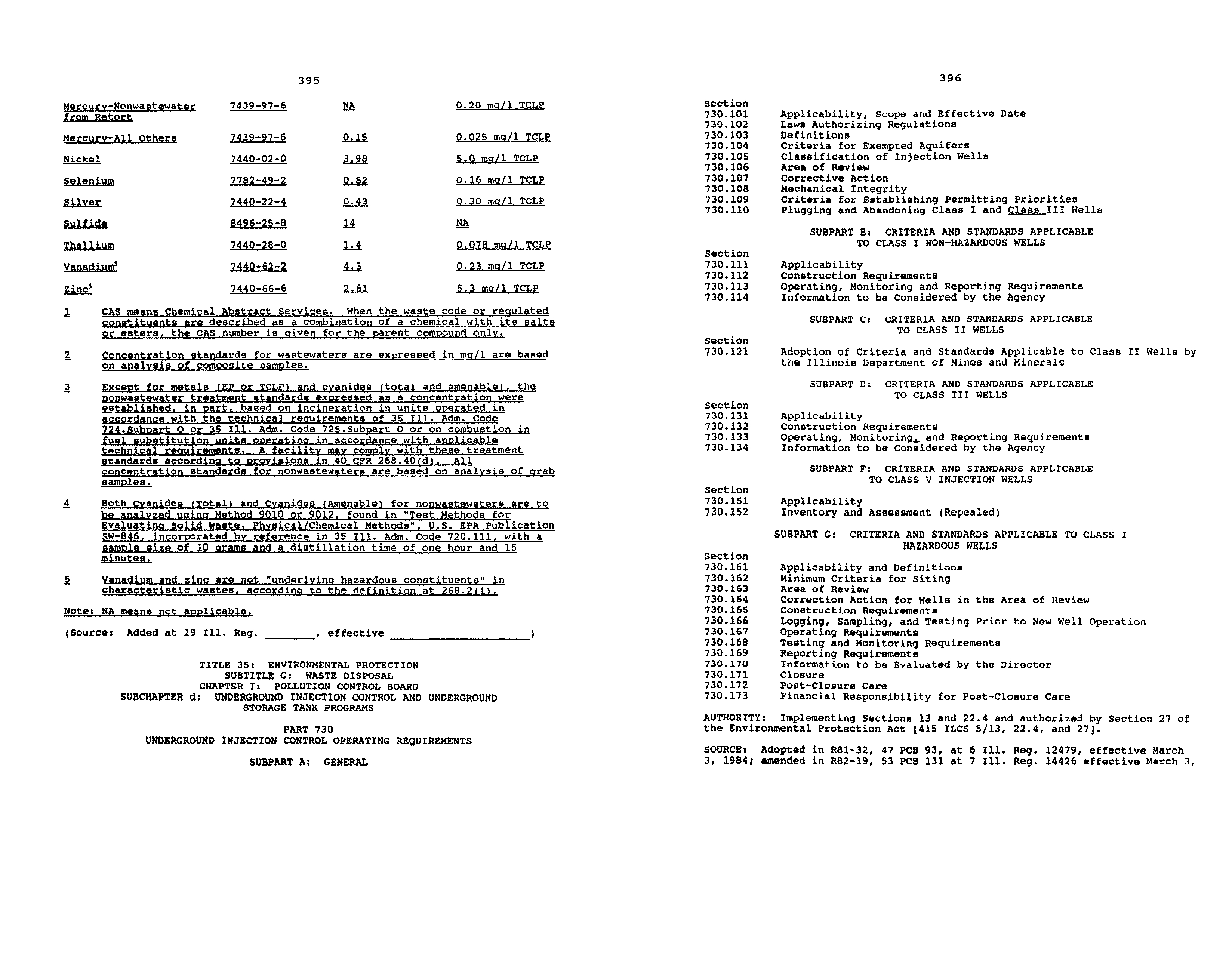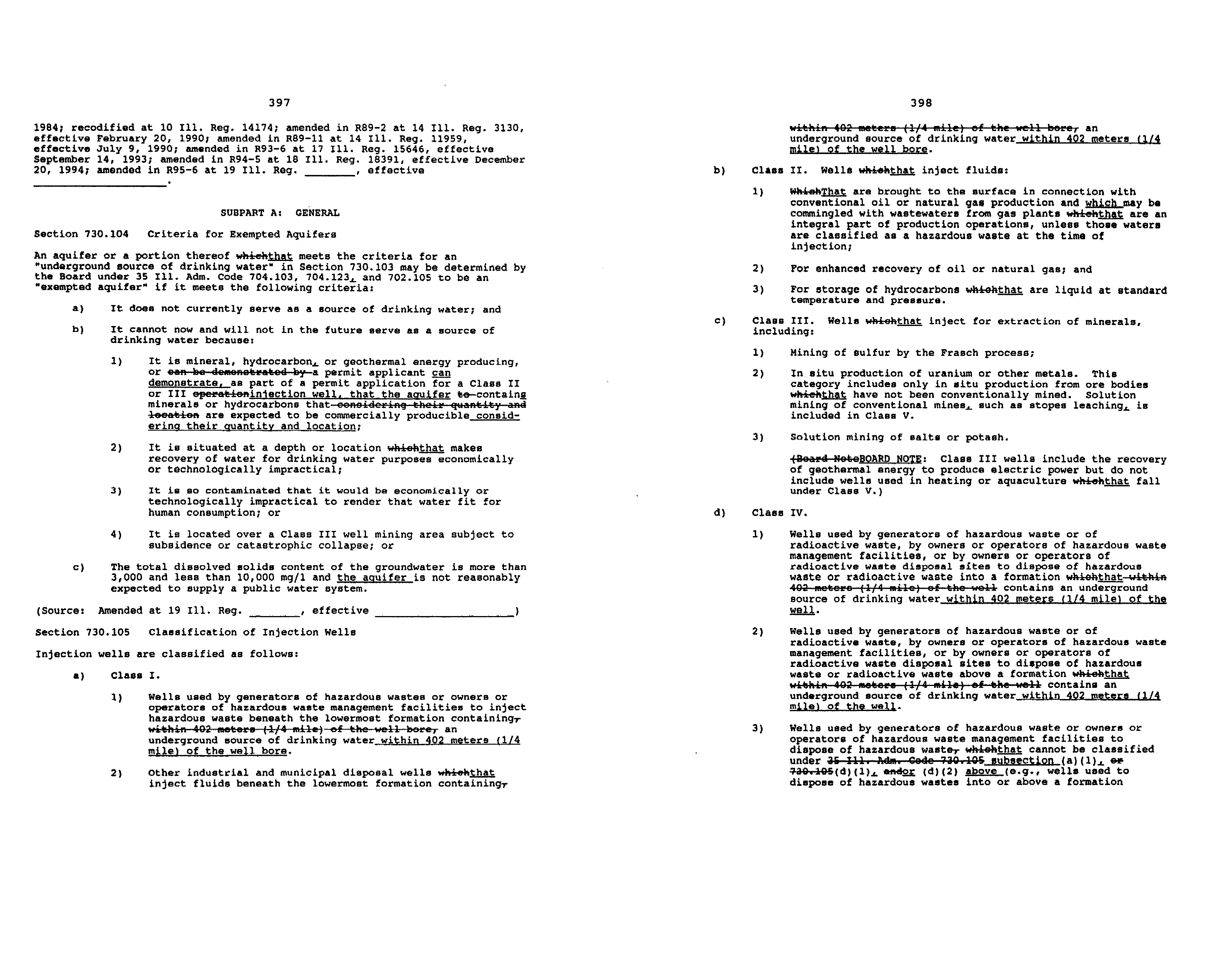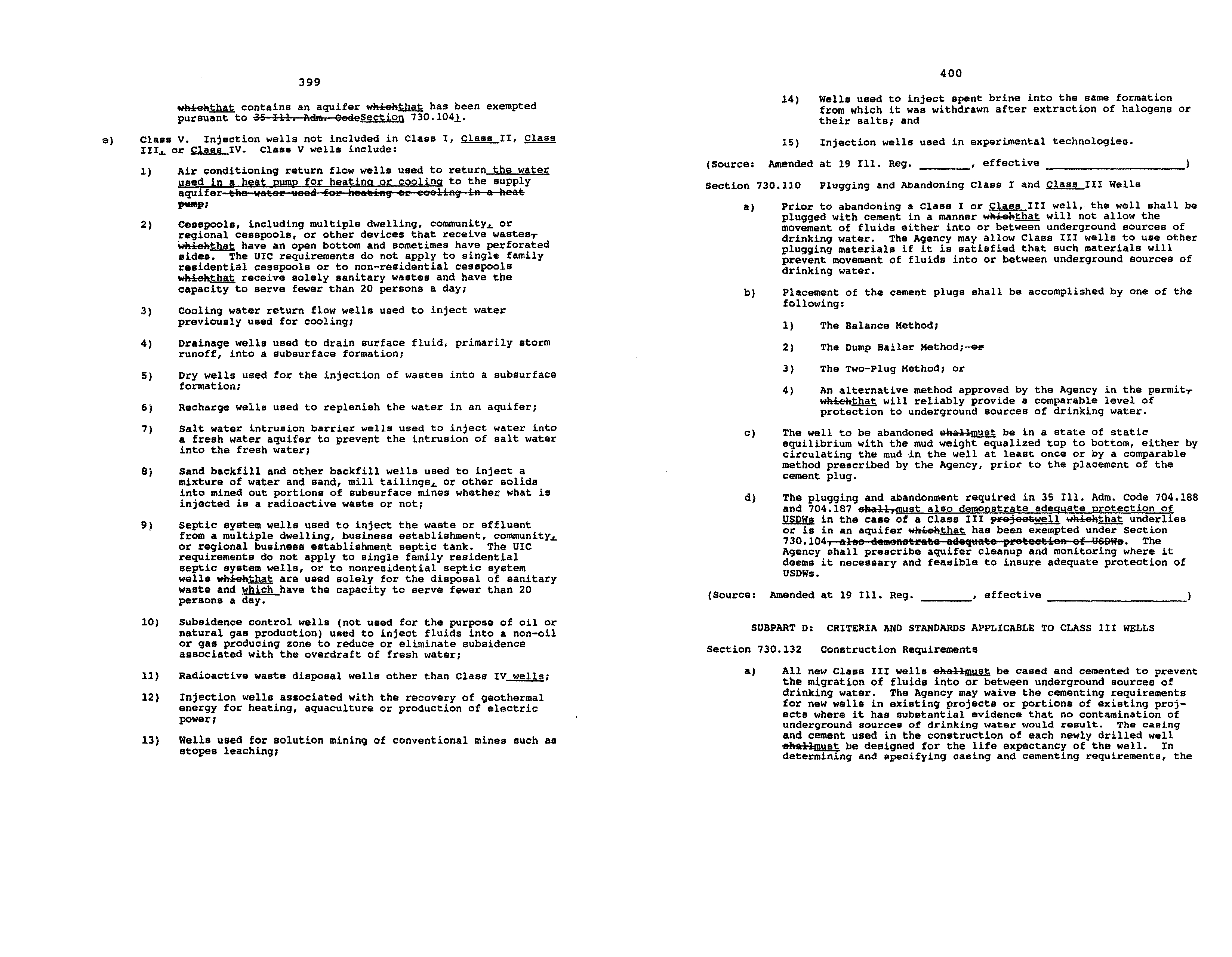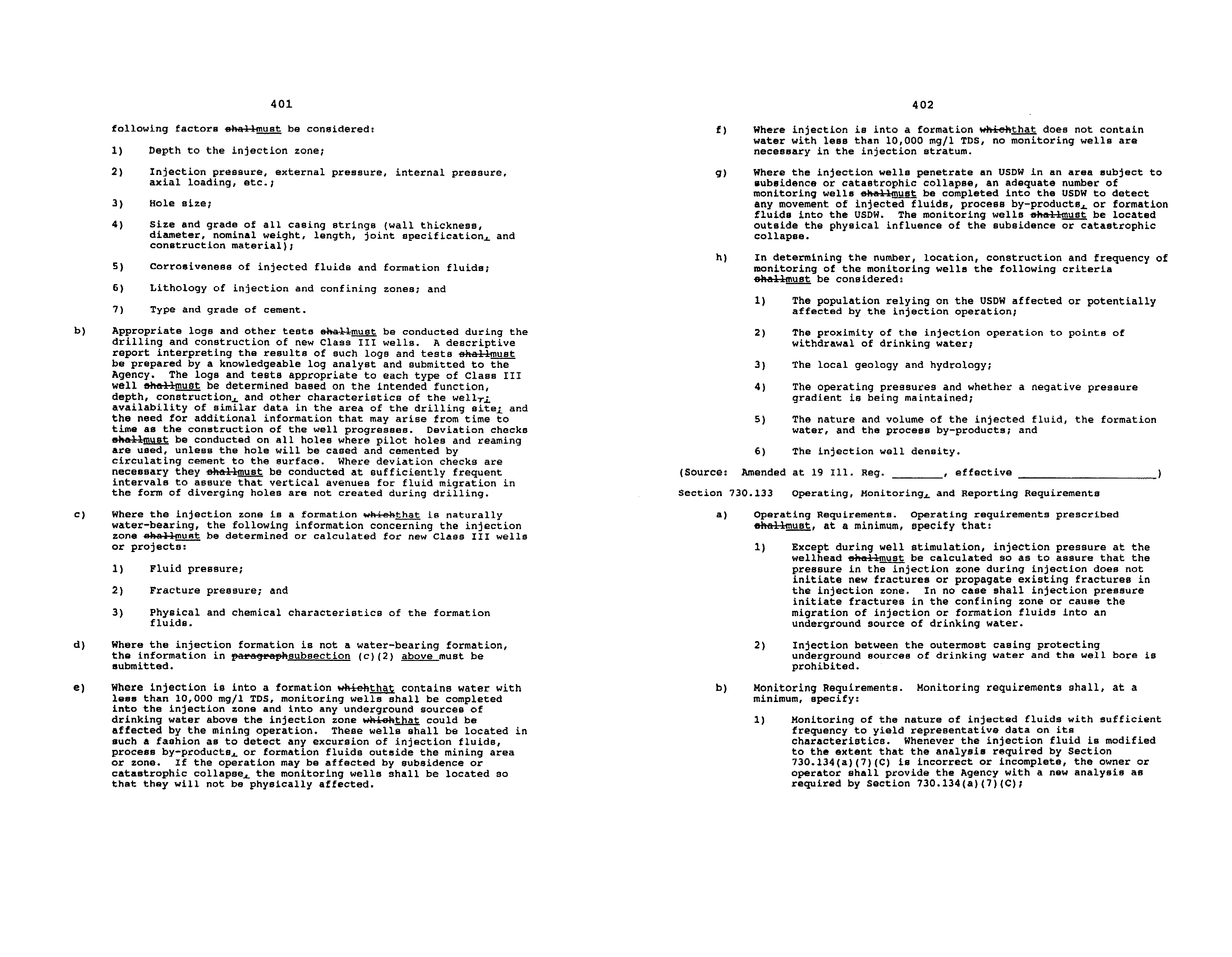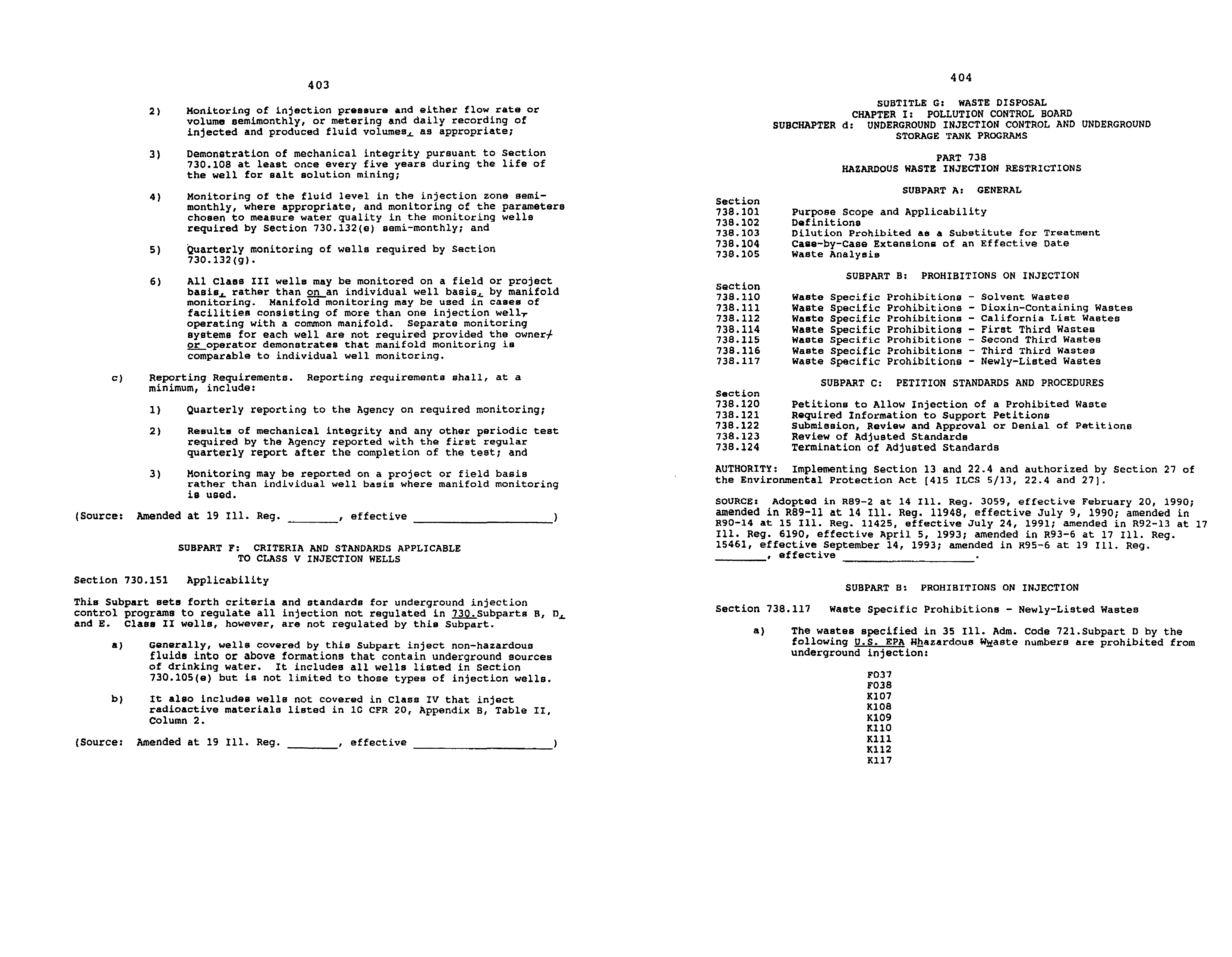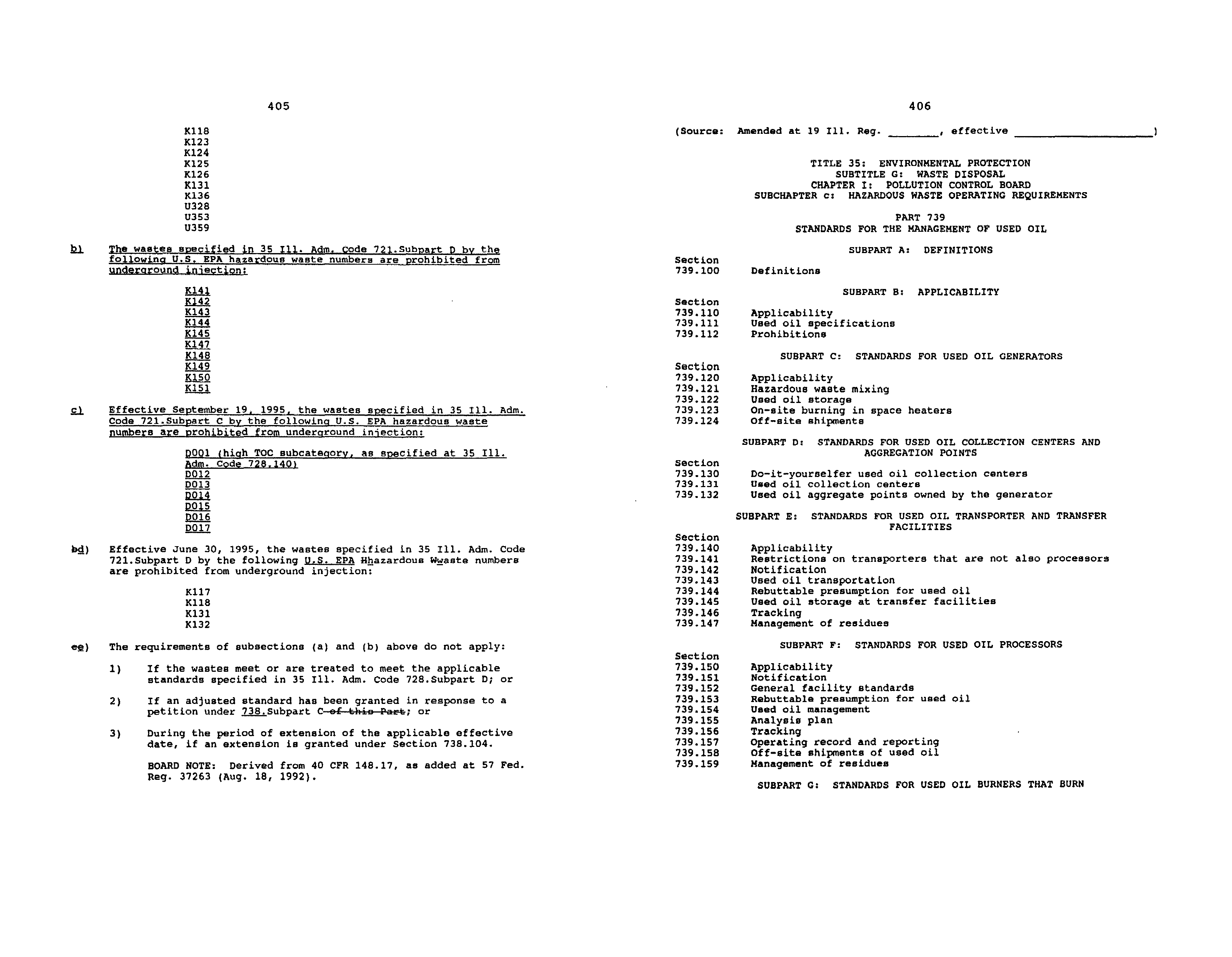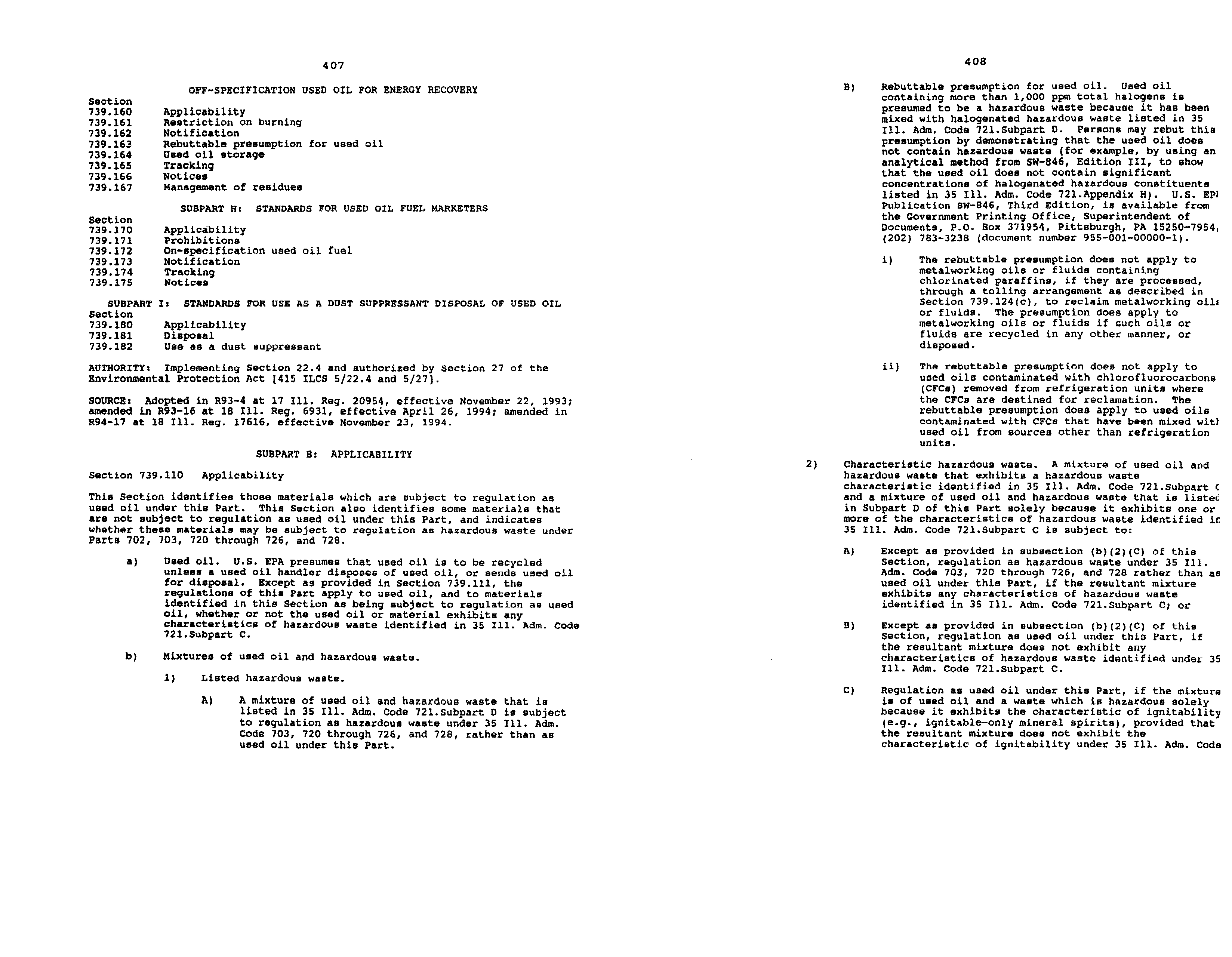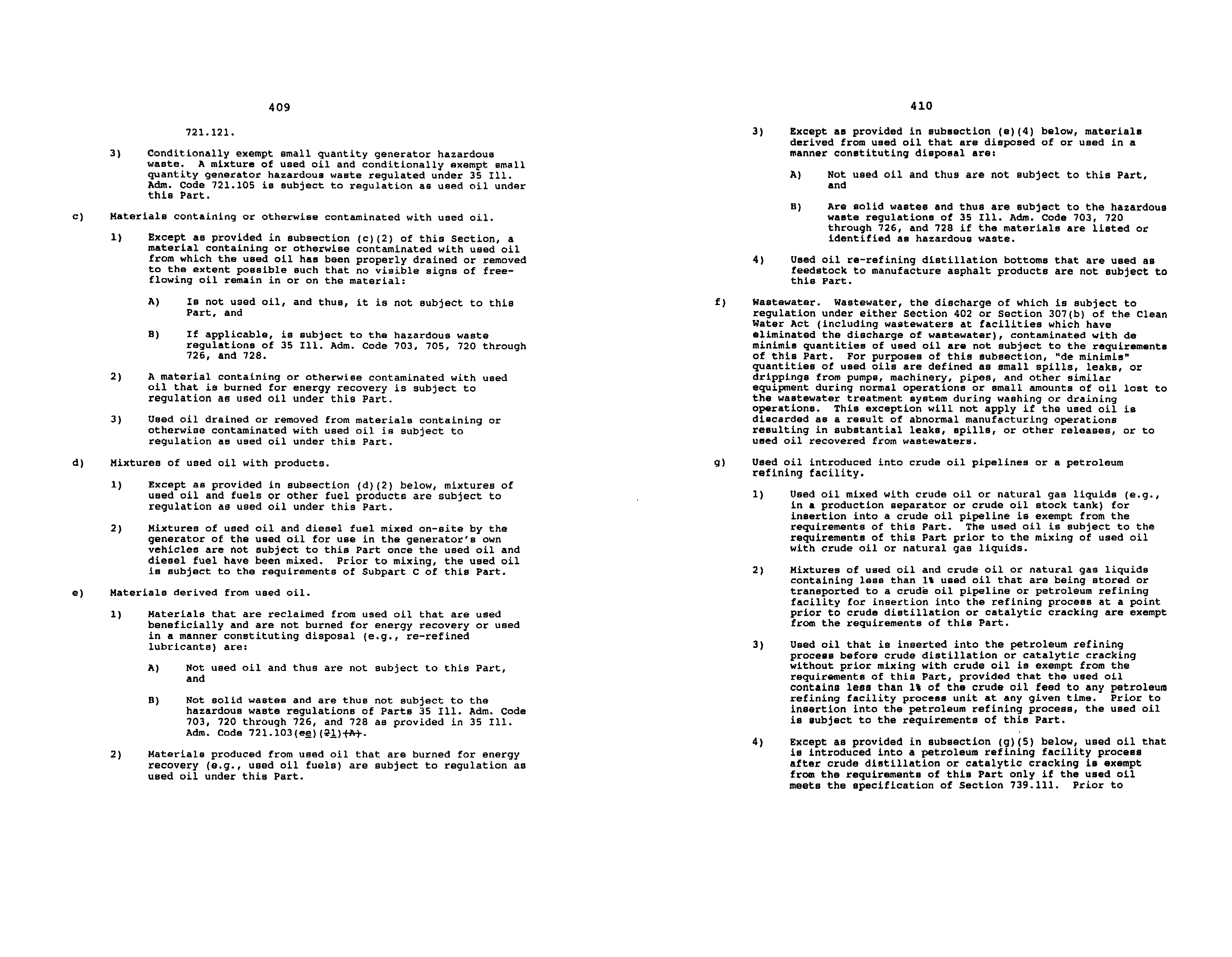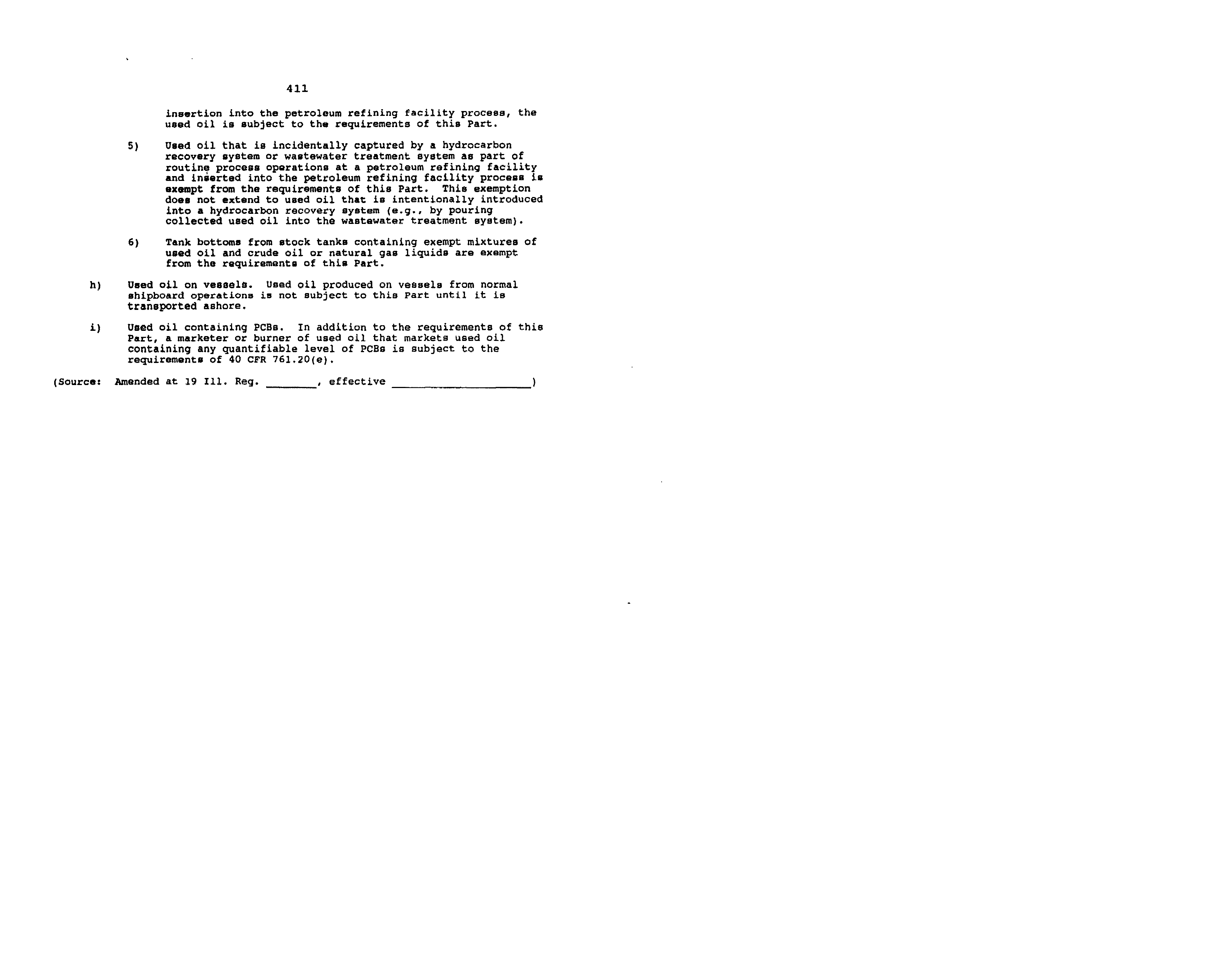ILLINOIS POLLUTION CONTROL BOARD
March
2,
1995
IN THE
MATTER
OF:
)
R95—4
UIC UPDATE,
USEPA REGULATIONS
)
(Identical-in-Substance Rules)
(7—1—94 THROUGH 12—31—94)
)
IN THE
MATTER
OF:
)
)
P95—6
RCRA
UPDATE,
USEPA REGULATIONS
)
(Identical
in Substance Rules)
(7—1—94 THROUGH 12—31—94)
)
Proposal for Public Comment.
PROPOSED ORDER OF THE BOARD
(by E. Dunham):
Pursuant to Section
13(c)
and 22.4(a)
of the Environmental
Protection Act
(Act)
415
ILCS 5/13(c)
& 22.4(a)
(1992)), the
Board proposes amendments to the RCRA Subtitle C hazardous waste
(RCRA)
and underground injection control
(UIC)
regulations.
Section 22.4(a) provides for quick adoption
of regulations
that are “identical
in substance” to federal regulations adopted
by U.S. EPA to implement Sections 3001 through 3005 of the
Resource Conservation and Recovery Act of 1976
(RCRA, 42 U.S.C.
SS
6921-6925)
and that Title VII of the Act and Section
5 of the
Administrative Procedure Act
(APA)
5
ILCS 100/5—35
& 5-40
(1992)
shall not apply.
Section 13(c)
similarly provides with
respect to underground injection control regulations adopted by
U.S.
EPA pursuant to Section 1421 of the Safe Drinking Water Act
(SDWA;
42 U.S.C.
S
300h).
Because this rulemaking
is not subject
to Section
5 of the APA,
it is not subject to first notice or to
second notice review by the Joint Committee on Administrative
Rules
(JCAR).
The federal RCRA Subtitle C regulations are found
at 40 CFR 260 through
268,
270 through 271,
and, more recently,
279.
The federal UIC regulations are found at 40 CFR 144,
146,
and 148.
This order is supported by a proposed opinion adopted on the
same day.
The Board will submit Notices of Proposed Amendments
for publication in the Illinois Register.
The complete text of
the proposed rules follows.
IT IS SO ORDERED.
2
I,
Dorothy M.
Gunn,
Clerk of the Illinois Pollution Control
Board,
certify that the above order was adopted by the Board on
the
,:i~’~~~--
day of
~
,
1995,
by a vote of
~
(/,
/1
-
-
//
•/
~6
-~
~
/
i~
Dorothy M. ,G~1nn, Clerk
Illinois Porlution Control Board
3
TITLE
35:
ENVIRONMENTAL
PROTECTION
SUBTITLE G:
WASTE DISPOSAL
CRAPTER
I:
POLLUTION
cONTROL
BOARD
SUBCHAPTER
at
GENERAL
PROVISIONS
4
p4
AUTHORITY:
Implementing
Sections
13
and
22.4
and
authorized
by
Section
27
of
the
Environmental
Protection
Act
(415 ILCS 5/13,
22.4,
27.
B84—22,
43
rcn
427,
at
S
Ill.
Beg. 9781,
otfeoti~oHay 17,
difi..d
in
081
22,
IS
rca
317,
at
6
Ill.
fle~.
4838,-
82~
amended
in-
081
32,
47
rOD—93,
at
~
Ill.
flcg.
12655,
83,
ameniad-4n-
082
18. 51 P08 31. at 7
Xli..- Req.
3616,
‘457,
),
•ff.stiva
~ivs
Daoee.bee
CCOtioa
£UB?J~flT
t,
CEPIERM,
Section
700-.301
700.303
700.303
700.304
Ccction
~00-~40l
700.-f
02
700.403
700.404
Lootion
toni
GITSS
(Seureet
flepealod at
18 Ill. Beg. 1824i, effoetive
Oeeo,~ber
30,
1094)
Cootion
700.
102
othcr
Regulations
(flcpcalcd)
-(Esupool
flepealod
at
16
Ill.
Bog.
l&34i,
oft~pti~:aDoeo,Mier-30,
1094)
£estion
700.103
-Organiaatien
(Rcpeal-ed-)~
flepoalod at
18 lii. flog.
1B244, effoet.re December 20,
1994)
-~Eourco*
Eeetien
700.104
Intent
and
Purpose
(flepcaled)
Domember
20,
1994)
(Souroot
Repealed
at
18
Ill.
Rag.
10244,
effeet.u-e
Seetion 700.105
Intetim
StaCue
(Bopo&iad)
-(-Ssures.
Repealed
at
15
Ill.
Beg.
18244, effestive Deensher 20,
1094)
PART
700
OUTLINE
OF
WASTE
DISPOSAL
REGULATIONS
1REPEALED~
CUD?AILT
~.
GZNSHAL
Section
00.iGl
Applioability
(Bopealod3
700.103
Other Regulations (flepSaled)
“—-—‘--tien
(Repealed)
~‘
T’urpooc
~flepealsd3
.,.,~tu0 (Ftcmoalet~
.-~atee
lity
(ft
p~
te
Federal
flulee
(flepOplOd)
t’rior
to
T~uthorisation
(Itopealod)
SOURCE:
Z~doptodii
4-98~-eended
and
i
~Rep.al.d
in
R95—6
at
19
Ill.
Reg.
.
effacti’
tionp
flepnaled)
Cootion
0OCI’ITr~L
WZLSTH
U.S.
EPZ~authorisod
the
Illinpip
UIC
program
offoci
1904,
at 49 Fed,
flag.
3991
(Feb.
1,
1004).
1)
The
effective
date
ef
36
Iii.
Adm.
Code
~02,
the
eutent
thoy
apply
to
the
iseuanee
ci
030
5
(May-17,
1902).
U.C.
EPA
granted
final
authoriaation
effective
January
31,
1986,
-at
Si
Fed.
flog.
3778
(Januory
30,
198G).
~-)~
The
otfootivo
date
of
36
Iii.
Mm.
Code
730,
721,
732,
723,
and
725
wan
May
17,
1903.
3-)-—
The effe~tLva date
of
36-Ill.
Ads..
Code
703
and
706,
to
the
netant
they
apply
te
the
insuanee
of
flORA permite, upe Hay
17,
1983k
he~,aver, flORA permite
uere
net
isnuad
prier
to
January
31,
1986-.-
3)
Tha effeetive
date
of
36—111.
Aiim.
Cede
703
and
724
‘.Iae
Oeteter
12,
i983~ he~jarer,
flORA
permits
were
not
ieC~ed
orior
to January 31.
1286.-
6
(tourec.
Eootion
Icloneed
at
ac
a.~i.
Iteg.
Lo..q1,
etsccttve
Uc00000r
700 107
Soverabitity (Ropoalod)-
flopealod
at
18
Ill.
flog.
18244,
effective
Doetmber
.Jt),
20,
1~4-)~
1094-)-
-(So.aree.
Seotiun
700,105
References
to
Federal
RuleS
(Repealed)
-f-Sew-moe.
Bepoaled
at
18
Iii.
flog.
18244,
effootive
December
20.
1994)
&e~tien 700.109
Purmitu
rrier to hutherisatien
(Repealed)
(Decree.
flepealtd
at
18
Ill.
flag.
18244,
effeetive
December
20,
1994)
LUOPAOT
B.
DEFINITIONS
Sestien
700.301
Delinitione
(Repealed)
Repealed
at
16
111.
Beg.
18244-,
effective
Deeember
20,
3994-)-
-fSeuree.
(Soufool
Repealed
at
16
Ill.
Peg.
18341,
effootive
Doposbor-
20,
19-94)-
Seetisu
700.210
Chapter
7
Operating
floguiremonta
(Repealed)
(Setifee.
Repealed
at
18
Iii.
fleg.
18244,
effcetive December-30,
1994*
Caetion
700.215
Ghaptcr
7
rermit~
(Repoa1ed~)-
(Source.
Repealed at
iS Ill. Beg. 18244, offaptiwo
Decumber
20,
1900)
Scotion
700.220
Chapter
9
OF.crating
flcquiromonts
(flepoalod)
(Source.
Repealed
at
16
111.
Hog.
18241,
effootivo
floecabor
20,
1994)-
Ccetion
700.225
Chapter
9
rcrmito
(Repealed)-
-(6eurees
Repealed
at
18
Ill.
flog.
18241,
effeotive
December
20,
1994)
Seat-ion
700.230
Confl~.ct (RepOalad)
(6-eufee,
Pepaaled at
is
Ill.
Req.
18344,
effeetive
Docambor
20,
1994)
Seetien
7-00.235
HW1t (Repealed)
(Sauces.
Repealed
at
18 Ill.
-Req.-
18244,
effective
December
20,
19-94)-
7
8
(Source.
Repealed
at
iS
IH.
Beg.
18244,
effective
December
700.215
Permit
flequtremente
(Repealed)
20,
1994)
Se~tLon
(Se.irre,
Repealed at
iS
Ill,
flag.
18244,
effective
eeercber
20,
1994)
Seedien
700.250
flORA
Operating
nequiremento—Jlepealed)
-(Source.
Section
flepeaied
at
18
Ill.
Reg.
18244,
ef?set4ve
Dseamber
700.355-
flORA
Permit
(Repealed)
Repealed at
18
Iii.
Req.
18244,
effective
December
20,
20,
1994)
1994)
(Se-..rce.
Section
700.260
flORA
Rules
(Repealed)
(Sauces.
Repealed
at
16
Iii.
Req.
18244,
effective
December
700.365
Subject
Tn
(Repealed-)
20,
1994)
Sentien
(Source.
Repealed
at
10
Ill,
flog-.
18244,
effective
December
EUDPA0T C.
CEHERATORS
300.301
Permita
(flopoalod)
Repealed at
18 Ill.
Req.
18244,
effective
Docombor
700.302
operating
flcquiremcnte
(Repealed)
20,
20,
1994)
1994)
Ceetien
(Source,
Section
(Sauces.
Repealed_at
18 Ill.
Beg.
18244, effective December 20,
1994)
Ceuree,
Repealed
at
10
Ill.
fleg.
10244,
effective
Dcocmber
20,
1994)
Sect-Los.
700.304
Small
Quantity
Euceptiono
(Rcp0aled)
(Do~tae, Repealed at 10 111. Beg. 19244,
effective
December 20,
1994-)
Section
S~JBt’ZtRT-D,
TRANSPORTERS
700.401
Pormite
(Repealed)
Repealed
at
18
Iii.
flag.
18244,
effective
December
20,
1994)
(Source,
Section
700.
402
Operating
Reguircmento
(flap-salad)
(Source.
Repealed
at
18
Ill.
Peg.
18214,
offootive
Dopombor
20,
1094)
Section
700.403
flanifeoto
(Repealed)
(Source,
Pepealed
at
18
IlL.
Req.
18214,
effective
December
20,
1004)
Section
700.404
Smaii
Quantity
Liemptians
(Repealed)-
(Seuroot
Repealed
at
18
Iii.
Bog.
18244,
effective
December
20,
1994)
SUBPART
Eu
O44NERC AND OPERATORS-
OF
IIWN SITES
Saetien
700.601
Pecs.Lte
(Repealed)
10
9
(Ceuree.-
viepeajes
St
LU iii.
aeg.
~s.oo.ereeccivo ueeemaar
40,
J4’.tS)
Section 300.503
)4anifcote
(Repealed)
(Ce.tree.
flepealed at
18
Ill.
flog.
16244,
effective
Dac~mhc~
20,
1091)
~uourc..
~cpoaLcc
a~ iu
~
neg.
15444, orroctave ueocmacr .u, riJe,
700.Appendim A
App~loabLlityProeisiono
-(-Repeal-ed-)-
(Source.
Repealed at
16
Ill.
Req.
18244,
effaoti’.e
December
20,
1991)
TITLS
35;
ENVIRONMENTAL
PROTECTION
SUBTITLE
0:
WASTE
DISPOSAL
CHAPTER I:
POLLUTION CONTROL BOARD
SUBCHAPTER
b:
PERMITS
PART
702
RCRA
AND
UIC
PERMIT
PROGRAMS
SUBPART
A;
GENERAL
PROVISIONS
Section
702.101
Purpose,
Scope,
and Applicability
702.102
Purpose and Scope (Repealed)
702.103
Confidentiality
of
Information
Submitted
to
the
Agency
or
Board
702.104
References
702.105
Rulemaking
-
702.106
Adoption
of
Agency
Criteria
702.107
permit
Appeals
and
Review
of
Agency
Determinations
702.108
Variances and Adjusted Standards
702.109
Enforcement Actions
702.110
DefinitionS
SUBPART B:
PERMIT APPLICATIONS
Section
702.120
Permit Application
702.121
Who Applies
702.122
Completeness
702.123
Information
Requirements
702.124
Recordkeeping
702.125
ContinuatiOn of Expiring Permits
702.126
Signatories to Permit Applications and Reports
SUBPART C:
PERMIT CONDITIONS
Section
702.140
Conditions Applicable to all Permits
702.141
Duty to Comply
702.142
Duty to Reapply
702.143
Need to Halt or Reduce Activity Not a Defense
702.144
Duty to Mitigate
702.145
Proper
operation
and
Maintenance
702.146
Permit
Actions
702.147
Property
Rights
702.148
Duty to Provide Information
702.149
Inepection
and
Entry
102.150
MOnitoring and Records
702.151
Signature
Requiramente
702.152
Reporting
Requiremente
702.160
Establishing
Permit
Conditions
702.161
Duration of Permits
702.162
Schoduloa of Compliance
702.163
Alternative Schedules of Compliance
702.164
Recording and Reporting
(EOU~GO.
flepeaLaa—ae--L5
iii.
nag.
£54110,
easeutive
0009015Sf
40,
ira”;(
S~otion700.602
Ccnoral Rule
(Repealed)-
(SourCe,
Repealed at
18 Ill. Req.
18214,
effective
December
30,
1004)
Section 700.603
Cenorate.e
(flapoaled)
effective December
20,
i994)-
(Seurce.
Repealed at
18 Ill, flag.
18244,
11
3.2
AUTHORITY:
Implementing Section
13 and 22.4 and authorized by Section 27 of
the Environmental Protection Act (415 ILCS 5/13,
22.4 and 27).
SOURCE:
BvSopted in P.81—32, 47 PCB 93, at
6 Ill. Req. 12479, effective May 17,
1982; amended in RB2—29, at
53 PCB 131,
7 ILl. Req.
14352, May 17,
1982;
amended in
P.84—9 at 9 Ill. Req. 11926, effective July 24,
1985; amended in
R85—23 at
10 Ill. Req.
13274, effective July 29,
1986;
amended in R86—1 at 10
Ill. Req.
14083, effective August 12,
1986; amended
in
R86—28 at
11
Ill.
Req.
6131, effective
March
24.
1987;
amended in R87—5 at
11 Ill. Req. 19376,
effective NOvember 12,
1987;
amended in P87—26 at 12
Ill. Req. 2579, effective
January
15,
1988; amended in R87—29 at 12 XLI. Req. 6673, effective March 28,
1988; amended in 587—39
at 12 13083, effective July 29,
1988;
amended
in R89—l
at 13
111. Beg. 18452, effective November 13,
1989;
amended
in
R89—2
at
14
Ill. Beg. 3089, effective February 20,
1990; amended in R89—9 at
14 Ill. Req.
6273. effective April
16,
1990;
amended
in R92—1O at
17 Ill. Req.
5769,
effective March 26,
1993; amended in P.93—16 at 18 Ill. Req. 6918, effective
April 26,
1994;
amended
in R94—5 et 18 Ill. Rag.
18284, effective December 20,
1994: amended in R95—6 at
19 Ill. Req.
________,
effective
Section 702.181
Effect of a Permit
a~
The existence of a RCRA or UIC permit does not constitute
a
defense to a violation of the Environmental Protection Act or this
Subtitle, except
for development, modification, or operation
without a permit.
However,
a permit may be
modified,
reissued,
or
revoked during ita term for cause as set forth in 35 Ill. Ada.
Code 703.270 through 703.213
(RCRA)
or
35 Ill. Ada. Code 704.261
through 704.263
(UIC)
and Section 702.186.
BOARD
NOTE;
40 C?R 270.4(a) differs from this subsection
(a)
in
two significant aeoecte~
fl
it atatee that compliance with the
permit is compliance_with federal law, and 2)
it enumeratee
exceptions
When
compliance
with
the
permit
can violets
federal
law.
The ex~eptioneare intervening
1) statutory requirements;
2J
40
CFR
268
land
disposal restrictions;
3)
40 CFR 264
leak
detection reguirement~a~d4)
40 CFR 266. subparts AL
88. and CC
air emissions limitations.
fly not codifying the federal
exceptions,
since they are not necessary in the Illinois program
to eccomolish the intended purpOag-,_~o
Board
doea
not
intend
to
imply that compliance
with a RCRA
permit obviates immediate
compliance with any of the events included jo the federal
excevtions,
b)
The issuance of a permit does not convey any property rights of
any
sort,
or
any
exclusive
privilege.
c)
The issuance of
a
permit
does not authorize
any
injury
to
persons
or property or invasion of other private rights, or any
infringement of
State
or local law or
regulations, except as noted
in subseCtion
(a) above.
BOARD NOTE:
Derived from 40 CFR 144.35 (1993) and 40 CPR 270.4
(l99~&).as amended ft 59 Fed. Req. 62952
(Dec.
6.
1994).
(Source;
Amended
at
19
Ill.
Rag.
_______,
effective
_____________________
TITLE
35:
ENVIRONMENTAL
PROTECTION
SUBTITLE 0: WASTE DISPOSAL
CHAPTER I: POLLUTION CONTROL
BOARD
SUBCHAPTER
b:
PERMITS
PART
703
RCRA
PERMIT
PROGRAM
SUBPART A:
GENERAL
PROVISIONS
Scope and Relation to Other Parts
Purpose
References
SUBPART
B:
PROHIBITIONS
Prohibitions in General
RCRA Permits
Specific
Inclusions
in
Permit
Program
Specific Exclusions
from Pereit Program
Diecharges of Hazardous Wsate
Reapplicatione
Initial
Applicationa
Federal Permits (Repealed)
SUBPART C: AUTHORIZATION BY
RULE
AND
INTERIM
STATUS
Purpose
and
Scope
Permite by
Rule
Application by Existing
HWM
Fecilitiee and
Interim Status
Qualifications
Application
by
New
HWM Facilities
Amended
Part
A
Application
Qualifying for Interim StatuS
Prohibitions During Interim Status
Changee
During
Interim StatuS
Interim
Statue
Standarde
Grounds for Termination of Interim Statue
Permit,
for
Lea, Then an Entire Facility
Closure by Removal
Procedure, for Closure Determination
SUBPART 0: APPLICATIONS
Section
702.181
702.182
702.183
702.184
702. 185
702.186
702
•
187
SUBPART
0;
ISSUED
PERMITS
Effect of
a Permit
Transfer
Modification
Causes
for Modification
Facility Siting
Revocation
Minor Modifications
SUBPART D:
ISSUED PERMITS
Section
703.100
703.101
703.110
Section
703.120
703.121
703.122
703.123
703.124
703.125
703.126
703.127
Section
703.140
703.141
703.150
703.151
703. 152
703.153
703.154
703.155
703.156
703.157
703. 158
703.159
703.160
Section
703.180
703.191
703.182
703.183
703.184
703.185
703.186
703
•
187
703.188
Applications in General
Contents
of
Part
A
Contents of Part 8
General Information
Facility Location Information
Groundwater Protection Information
Exposure
Information
Solid
WaCt.
Management
Units
Other
Information
13
Specific Part B Application Information
Containers
Tank Systeme
Surface Impoundments
Waste Piles
Incinerators that Burn Hazardous Waste
Land Treatment
Landfills
Boilers
and
Industrial
Furnaces
Burning
Hazardous
Waste
Miscellaneous
Units
Process Vente
Equipment
Drip Pads
_______
Air Emission Controls
for Tanks, Surface Impoundments, and
Containers
SUBPART
E;
SHORT
TERM
AND
PHASED
PERMITS
Emergency
Permits
Incinerator
Conditions
Prior
to
Trial
Burn
Incinerator
Conditions
During
Trial
Burn
Incinerator Conditions After Trial Burn
Trial Burns for Existing Incinerators
Land Treatment Demonstration
Research,
Development
and
Demonstration
Permits
Permits
for
Boilers
and
Industrial
Furnaces
Burning
Hazardous
Waste
SUBPART
F:
PERMIT CONDITIONS OR DENIAL
Permit
Denial
Establishing Permit Conditions
Noncompliance
Pursuant
to
Emergency
Permit
Monitoring
Notice
of
Planned
Changes
(Repealed)
Twenty—four Hour Reporting
Reporting
Requirements
Anticipated Noncompliance
SUBPART
G:
CHANGES
TO
PERMITS
Section
703.260
Transfer
703.270
ModifiCation
703.271
Causes
for
Modification
703.272
Causes
for
Modification
or
ReiSsuance
703.273
Facility
Siting
703.280
Permit
Modification
at
the
Request
of the Permittee
703.281
Class
1
Modifications
703.282
Class
2
Modifications
703.283
Class
3
Modifications
703.Appendix A
Claseification of Permit Modifications
AUTHORITY: Implementing Section 22.4 and authorized by Section 27 of the
Environmental Protection Act (415 ILCS 5/22.4 and 27).
SOURCE:
Adopted
in
RB2—l9,
53
PCB
131,
at
7
Ill.
Peg.
14289,
effective
October
12,
1983; amended in
R83—24 at
8
Ill.
Req.
206,
effective
December
27,
1983;
amended in
P84—9
at
9
Ill.
Req.
11899,
effective
July 24,
1985; amended in
P.85—22
at
10
Ill.
Rag.
1110,
effective
January
2,
1986;
amended
in
RBS—23
at
10 Ill. Reg. 13284, effective July 28,
1986;
amended
in P86—1 at 10 Ill. Peg.
14093, effective August 12,
1986;
amended
in R86—19 at 10
Ill. Req. 20702,
14
effective oecember 2,
1986;
amended
in P.86—28 at 11 Ill. Reg.
6121, effective
March 24.
1987;
amended
in P86—46 at
11 Ill. Rag. 13543. effective August
4,
1987; amended in P87—S at 11 Ill. Rag.
19383, effective November
12,
1987,
amended
in
R87—26
at
12
Ill.
Rag.
2584,
effective
January
15,
1988;
amended
in
P87—39 at
12 Ill. Peg.
13069, effective July 29,
1988;
amended
in R88—16
at 13
Ill.
Req.
447,
effective
December
27,
1988;
amended
in
889—1
at
13
111.
Rag.
18477,
effective
NOvember
13,
1989;
amended
in
P89—9
at
14
Ill.
Req.
6278,
effective April
16,
1990; amended in P.90—2 at
14 Ill. Beg. 14492, effective
August 22,
1990;
amended
in R90—ll at
15 111. Req. 9616, effective June 17,
1991;
amended
in
P.91—1
at
15
Ill.
Peg.
14554,
effective
September
30,
1991;
amended
in P91—13 at 16 Ill Peg. 9767, effective June 9,
1992;
amended in 592—
10 at 17 Iii. Peg. 5774, effective March 26,
1993; amended in 893—4 at 17 Ill.
Peg. 20794, effective November 22,
1993; amended in P93—16 at 18 Ill. Req.
6898, effective April 26,
1994; amended in 894—7 at
18 Ill. Reg. 12392,
effective
July
29,
1994;
amended
in
P.94—S
at
18
Ill.
Req.
18316,
effective
December 20,
1994;
amended
in P95—6 at 19 111. Beg.
________,
effective
SUBPART 0: APPLICATIONS
Section 703.183
General Information
The
following
information
is
required
in
the
Part
B
application
for
all
HWH
facilities, except as 35 Ill. Ada. Code 724.101 provides otherwise:
a)
A
general
description
of
the
facility;
b)
chemical and physical analyses of the h~zardouawastes and
hazardous debris to be handled
at the facility.
At
a minimum,
these analyses
must
contain
all
the
information
which
must
be
known to treat,
store or dispose of the wastes properly in
accordance with 35 Ill. Adm. Code 724;
c)
A
copy of the waste analysis plan required by 35
Ill. Ada. Code
724.113(b) and,
if applicable,
35
Ill. Ada. Code 724.113(c);
d)
A description of the security procedures and equipment required by
35
Ill.
Ada.
Coda 724.114, or a justification demonstrating the
reasons
for
requesting
a waiver of this requirement;
a)
A copy of the general inspection schedule required by 35 Ill. Ada.
Code 724.115(b).
Include where applicable,
as part of the
inspection schedule,
specific requirements
in 35 Iii. Ada. Code
724.274,
724.293(i),
724.295, 724.326, 724.354, 724.373,
724.403,
724.702,
724.933,
724.952,
924.953,~ aood—724.958.
724,988,
and
724.99J
f)
A
justification
of
any
request
for
a
waiver
of
the
preparedness
and prevention requirements of
35 Ill. 8dm. Code 724.Subpart
C;
g)
A copy of the contingency plan
required
by
35 Ill. Ada. Code
724.Subpart 0;
BOARD NOTE;
Include, where applicable, as part of the contingency
plan,
specific
requirements in
35
Ill.
Ada.
Code
724.327
and
724.355.
35
Ill.
8dm.
Code
724.355
has
not
yet
been
adopted.
h)
A description of procedures, structures, or equipment used at the
facility to:
1)
Prevent hazards
in unloading operations
(for example, ramps,
703. 200
703.201
703. 202
703.203
703.204
703.205
703. 206
703.207
703.208
703. 209
703.210
703.211
703.212
703.2 13
Section
703.221
703.222
703.223
703. 224
703.22S
703.230
703.231
703.232
Section
703.240
703. 241
703. 242
703.243
703.244
703. 245
703.246
703.247
15
16
91fipecial
forklifta);
2)
Prevent
runoff
from
hazardous
waste
handling
areas
to
other
areas of the
facility
or
environment,
or
to
prevent
flooding
(for example. berms,
dikes, QL..trenches);
3)
Prevent
contamination
of
water
supplies;
4)
Mitigate
effects
of
equipment
failure
and
power
outages;
5)
Prevent
undue
exposure
of
personnel
to
hazardous
waste
(for
example,
protective
clothing);
and
6)
Prevent releases to the atmosphere.
i)
A
description
of
precautions
to
prevent
accidental ignition or
reaction
of
ignitable,
reactive,,
or
incompatible
wastes,
as
required to demonstrate compliance with 35
Ill.
8dm. Code 724.117,,
including documentation demonstrating compliance with 35 Ill.
Ada.
Code 724.117(c);
j)
Traffic pattern, estimated volume (numberr,,5j~types of vehicles),
and
control
(for
example,
show turns
across
traffic
lanes
and
stacking
lanss~ +if
appropriate);
describe
access
road
surfacing
and
load
bearing
capacity;
fi1~,,,showtraffic
control
signals);
k)
Facility
location
information,
as required by Section 703.184;
1)
An
outline
of
both
the
introductory
and
continuing
training
programs
by
~jj~...ownere
or
operators
to
prepare
persons
to
operate
or
maintain
the
HWH
facility
in
a
safe
manner,
as
required
to
demonstrate
compliance
with
35
Ill.
8dm.
Coda
724.116.
A
brief
description
of
how
training will be
designed
to
meet
actual
job
tasks in accordance with requirements in 35 Ii).
Ada. Coda
724.116(a) (3);
m)
A
copy
of
the
closure
plan
and,
where
applicable,
the
post—closure
plan
required
by
35
Ill.
Ada.
Code
724.212,
724.218,,
and
724.297.
Include
where
applicable,
as
part
of
the
plans,
specific
requirements
in
35
Ill.
Ada.
Code
724.278,
724.297,
724.328,
724.358,
724.380.
724.410,
724.451,
724.701,,
and
724.703;
n)
For
hazardous
waste
disposal
units
that
have
been
closed,
documentation
that
notices
required
under
35
Ill.
Ada
Code
724.219
have been filed;
o)
The
most
recent
closure
cost
estimate
for
the
facility,
prepared
in
accordance
with
35
Ill.
Ada.
Code
724.242,
and
a
copy
of
the
documentation required to demonstrate financial assurance under
35
Ill.
Ade. Code 724.243.
For a new facility,
a
copy
of
the
required
documentation
say
be
submitted
60
days
prior
to
the
initial
receipt
of
hazardous
wastes,
if
it
is
later
than
the
submission
of
the
Part
B
permit
application
p)
Where
applicable,
the
most
recent post—closure cost estimate for
the facility, prepared in accordance with 35 Ill. Ada. Code
724.244,
pluS
a
copy
of
the
documentation
required
to
demonstrate
financial
assurance
under
35
Ill.
Ada, Code 724.24Sf.
For
a
new
facility, a copy of the required documentation may be submitted 60
days
prior
to
the
initial
receipt
of
hazardous
wastes,
if
it
is
later than the submission of the part
B permit ar’olicatjon
q~
Where applicable,
a copy of the insurance policy or other
documentation
which
comprises
compliance
with
the
requirements
of
35
Ill.
Ada. Code 724.247.
For a
new
facility,
documentation
showing
the
amount
of
insurance
meeting
the
specification
of
35
Ill. Ada. Code 724.247(a)
and, if applicable,
35 Ill. 8dm. Code
724.247(b),. that the
owner
or operator plane
to
have in effect
before initial receipt of hazardous waste for treatment, storage,
or
disposal.
A
request
for
an
alternative
level
of
required
coverage.- for a new or existing
facility,. may be submitted as
specified
in
35
Ill.
Ada.
Code
724.247(c);
r)
A
topographic
map
showing
a
distance
of
1000
feet
around
the
facility
at
a
scale
of
2.5
centimeters
(1
inch
equal
to
not
more
than 61.0 meters (200 feet).
Contours must be shown on the map.
The
contour
interval
must
be
sufficient
to
clearly
show the
pattern
of
surface
water
flow
in
the
vicinity
of
and
from
each
operational unit of the facility.
For example, contours with an
interval
of
1.5
meters
(5
feet),
if relief
is greater than 6.1
meters
(20
feet).
or
an
interval
of
0.6
meters
(2
feet),
if
relief
is lees than 6.1 meters
(20 feet).
Owners and operators of HWM
facilities
located
in
mountainous
areas
shall
use
larger
contour
intervals
to
adequately
show
topographic
profiles
of
facilities.
The map must clearly show the following:
1)
Map
scale and date;
2)
100—year floodplain
area;
3)
Surface
waters
including
intermittent
streams;
4)
Surrounding
land
uses
(e.g..
residential,
commercial,
agricultural,
recreational._etc.);
5)
A wind rose (i.e., prevailing windapeed and direction);
6)
Orientation of the map (north arrow);
7)
Legal boundaries of the HWH facility site;
8)
Acceas
control
(e.q~,
fences,
gates._etc.);
9)
Injection
and
withdrawal
wells
both
on—site
and
off—site;
10)
Buildings; treatment, etorege,, or disposal operations;
or
other structures
(e.g. ~recreation
areas,
runoff control
systems,
access
and
internal
roads,
storm,
sanitary
and
process
sewage
systems,
loading
and
unloading
areas,
fire
control
facilities,
etc.;
11)
Barriers
for
drainage
Or
flood
control;
12)
Location
of
operational
units
within
the
HWM
facility
site,
where
hazardous
waste
is
(or
will
be
treated,
stored,
or
disposed (include equipment cleanup areas);
BOARD NOTE:
For
large HWM facilities, the Agency shall
allow the use of other scales on a came by case basis.
a)
Applicants shall submit such information as the Agency determines
is necessary for it to determine whether to issue
a permit and
what conditions to impose
in any permit issued.
18
(Source;
Amended at 19
Ill. Req.
________,
effective
_____________________
Section 703.202
Tank Systems
Except as otherwise provided in 35 Ill. Ada. Code 724.290, owners and
operators of facilities that use tanks to store or treat hazardous waste shall
provide the following additional
linformation:
a)
A written assessment
that is reviewed and certified by an
independent, qualified, registered professional engineer as to the
structural integrity and suitability for handling hazardous waste
of each tank system, as required under 35 Ill. Ada. Code 724.291
and 724.292;
b)
Dimensions and capacity of each tank;
c)
Description of feed systems, safety cutoff, bypass systems,, and
pressure
controls
(e.g.,
vents);
d)
A diagram of piping, instrumentation, and process flow for each
tank system;
e)
A description of materials and equipment used to provide external
corrosion protection,
as required under
35 Ill. Ada. Code
724.292(a) (3) (SB);
f)
For new tank systems, a detailed descriptions of how the tank
syatem(s) will be installed in compliance with 35
Ill. Ada. Code
724.292(b),
(c),
(d),, and (e);
g
Detailed plans and description of how the secondary containment
system for
each tank system is or will be designed, constructed
and operated to meet the requirements of
35 Ill. Ada. Code
724.293(a),
(b),
(c),
(d),
(e),, and (f);
h)
For tank systems for which alternative design and operating
practices are sought pursuant to 35
Ill. Adm. Code 724.293(g):
1)
Detailed plans
and engineering and hydrogeologic reports, as
appropriate, describing alternate design and operating
practices that will,
in conjunction with location aspects,
prevent the migration of any hazardous waste or hazardous
constituents into the groundwater or surface water during
the life of the facility, or
2)
A detailed assessment of the substantial
present or
potential hazards posed to human health or the environment
should
a release enter the environment.
3)
A copy of the petition for alternative design and operating
practices or, if such have already been granted, a copy of
the Board Order granting alternative design and operating
practices.
i)
Description of controls and practices to prevent spills and
overflows,
as
required
under
35
Ill.
8dm.
Code
724.294(b);—ae4
j)
For tank systems
in which ignitable,
reactive or incompatible
wastes are to be stored or treated,
a description of how operating
procedures
and
tank
system
and
facility
design
will
achieve
compliance with the requirements of 35 Ill. 8dm. Code 724.298 and
724.299,,..~
17
t)
For land disposal facilities,
if a case—by—case extension has bean
approved
under
35
Ill.
Ada.
Cods
728.105,-
or
if
a
petition
has
been approved under 35 Ill. Ada. Code 728.106,
a copy of the
notice of approval of the extension or of approval of the petition
is required.
BOARD NOTE:
Derived from 40 CFR 270.14(b)
(194.894),
as amended
at
5~ Fed. Beg. 37281,
Z~uguot 18, 199262952 (Dec.
6,
1994).
(Source;
Amended at 19 Ill. Req.
_______,
effective
_____________________
Section
703.201
Containers
For facilities
that store containers of hazardous waste,
except as otherwise
provzded in 35
Ill. Ada. Cods 724.270, the Part
B application must include:
a)
A description of the containment
system to demonstrate compliance
with 35 Ill. Ada. Code 724.275.
Show at least the following:
1)
Basic design parameters,
dimensions,
and materials of
construction;
2)
How the design promotes drainage or how containers are kept
from contact with standing liquids in the containment
system;
3)
Capacity of the containment system relative to the
number
and volume of containers to be stored;
4)
Provisions for preventing or managing run—on;~~
5)
How accumulated liquids can be analyzed and removed to
prevent overflowt,
b)
For storage areas that store containers
holding wastes that do not
contain free liquids,
a demonstration of compliance with 35 Ill.
Ada. Code
724.275(c),
including:
1)
Test procedures and results or other documentation or
information to show that the wastes do not contain free
liquids; and
2)
A description of how the storage area is designed or
operated to drain and remove liquids or how containers are
kept from contact with standing liquids~,
c)
Sketches, drawings, or data demonstrating compliance with 35
Ill.
8dm.
Code
724.276 (location of buffer zone and containers holding
ignitable or reactive wastes) and Section 724.277(c)
(location of
incompatible wamtea), where applicable.
d)
Where incompatible wastes are stored or otherwise managed in
containers,
a description of the procedures
used to ensure
compliance
with
35
Ill.
Ada.
Cods
724.117(b)
and
(c)
and
724.277(a) and (b).
Section 703.213.
BOARD NOTE:
Derived from 40 CFR 270.15 (1994),
as amended at
S9
Fed.
Pea.
62952
(Dec.
6,
1994).
19
)~3,
Information on air emission control equipment,
as required in
Section 703.213.
-(Bo~~rdNgtc~Q~Qj(Q~:See 40 Cr8 270.16
(1944.94),
as amended
at
512 Fed. Bag. 25471, July 14, 1011662952J.Pec.
6,
1994).-).
(Source:
Amended at 19 Ill. Req.
________,
effective
______________________
Section
703.203
Surface Impoundments
For facilities that store, treat, or dispose of hazardous waste in surface
impoundments, except as otherwise provided in
35
Ill. Ads.
Code 724.101, the
Part
B application must include;
a)
A list of the hazardous wastes placed or to be placed in each
aurfaca impoundment-t,
b)
Detailed plane and an engineering report describing how the
surface impoundment is designed and is or will be constructed,
operated, and maintained to meet the requirements
of 35 111. Ada.
Code 724.119,
724.321, 724.322 and 724.323,
addressing the
following items:
1)
The liner system (except for an existing portion
qf
a
surface impoundment).
If an exemption from the requirement
for a
liner is sought, as provided by 35 Ill. 8dm. Code
724.321(b),
submit a copy of the Board order granting an
adjusted standard pursuant to
35 Ill. Ada. Code 724.321(b);
2)
The double liner and leak (leachate)
detection, collection,
and removal syetem,
if the surface impoundment must meet
the
requirements of
35 Ill. Ada. Code 724.321(c).
If an
exemption
from
the requirements for double liners and a ie~k
detection,
collection, and removal System or alternative
design is sought
am provided by 35 Ill. Ada. Code
724.321(d),
(5),
or
(f), submit appropriate
information;
3)
If the leak detection system is located
in a saturated zone,
submit detailed plans
and an engineering report explaining
the leak detection syatem de~iqn~nd operation,. and the
location of the saturated zone in relation to the leak
detection
system;
4)
The construction quality assurance (CQA) plan if required
under 35 Ill. Ada. Code 724.119; and
5)
Proposed action leakage rate, with rationale,
if required
under 35 Ill. Ada. Code 724.322,-i response action plan,
if
required under
35 Ill. Ada. Code
72a.323-,-~
and
a
proposed
pump operating
level,
if
required
under
35
Ill.
Ada.
Code
724. 326( d) (3)
6)
Prevention of overtopping; and
7)
Structural integrity of dikest,
c)
A
description
of
how
each
surface
impoundment,
including
the
double liner system,
leak detection system, cover system and
appurtenances for control of overtopping,- will be inspected in
order to meet the requirements of 35
Ill. 8dm. Code 724.326(a),
(b), and
(d).
This information must be included in the inspection
plan
submitted
under
Section
703.l83(e)t,
20
d)
A certification by a qualified engineer which
atteats to the
structural
integrity
of
each
dike,
as
required
under
35
Ill.
Adm.
Code 724.326(c).
For new
units,
the
owner
or
operator
shall
submit
a
statement
by
a
qualified
engineer
that
the
engineer
will
provide
such
a
certification
upon
completion
of
construction
in
accordance
with
the
plans
and
specifications4-,
a)
A description of the procedure to be used for removing a surface
impoundment from service, as required under 35 Ill. Ada. Code
724.327(b) end
(c).
This information must be included in the
contingency plan submitted under
Section 7O3.183(g)f,
t)
A description of how hazardous waste residues and contaminated
materials will be removed from the unit at closure, as required
under 35 III. 8dm. Code 724.328(a)(1).
For any wastes
not to be
removed from the unit upon closure, the owner or operator shall
submit detailed plans and an engineering report describing how 35
Ill.
Ada. Code 724.328(a)(2) and
(b) will be complied with.
This
information
must
be
included
in
the
closure
plan
and,
where
applicable,
the post—closure plan submitted under Section
703.183(m)i-.
g)
If
ignitable
or
reactive
wastes
are
to
be
placed
in
a
aurtace
impoundment,
an explanation of how 35 Ill. Ada. Code 724.329 will
be complied withf.
h)
If incompatible wastes, or incompatible wastes and materials,
will
be
placed
in
a
surface
impoundment,
an
explanation
of
how
35
Ill.
Ada. Code 724.330 will be complied withi—en4,-,
i)
A
waste
management
plan
for
hazardous
waste
numbers P020,
F021,
P022,
P023,
P026,,
and
P027
describing
how
the
surface
impoundment
is or will be designed,
constructed, operated, and maintained to
meet the requirements of 35 Ill. 8dm. Code 724.331.
This
submiaeion
must
address
the
following
itemS
me
specif led
in
that
Section:
1)
The volume, physical, and chemical characteristics of the
wastes,
including
their
potential
to
migrate
through
soil
or
to volati1iz~or escape into the atmosphere;
2)
The attenuative properties of underlying and surrounding
soils or other materials;
3)
The mobilizing properties of other materials co—disposed
with
these
wastes;
and
4)
The
effectivene~e
of
additional
treatment,
design
or
monitoring techniques.
j~
Information on air emission control equipment, as required in
Section 703.213,
BOARD
HOTE~Derived from 40 CPR
270.17
(1991k), as amended
at S2 Fed. Beg.
3186,
January 29,
199262952 (Dec.~4,1994~.
(Source:
Amended
at
19
Ill.
Peg.
________,
effective
______________________
Section 703.213
Air Emission Controls for Tanks, Surface Impoundments, and
Containers
11
Except as otherwise provided
in
35 111. Ada. code 724.101, owners
21
..,f ~
-
and operatorS
—-
impounumentS, or containers that
use air emission controls in accordance with the reQuirements 35
111. 8dm. Cods 724.Subpart CC shall provide the following
22
SUSCRAPTER b:
PERMITS
PART 705
PROCEDURES FOR PERMIT ISSUANCE
Ii.
P~qugnentationfor each cover metalled on a tank subject to
35
Ill. Ada. Code 724,984(b~2 or 724.984(b)3)
that
includes information prepared by the owner or operator or
pro~idadby the cover manufacturer or vendor describing the
cover
design, end certification by the owner or ooeratot
that the cover meets the applicable design specifications as
liBLed in 35 Ill. 8dm. Code 725.991(c).
21
idmgtification of each container area subject to the
requirements of 35 Ill. 8dm. Code 724.Subpart CC and
certification by the owner or operator that the
egjrepments
of this Subpart are met.
~j.
Documentation for epch cnclos,ire~ueedto control
air
emissions from containers in accordance with the
requirements of
35
Ill.
Ada. Code 724.986(b) (2m (A) that
includes information ~reoared by the owner or operator or
provided by the manufacturer or vendor describiog_~
~p~losure design,
and certification by the owner or operator
that the enclosure meets the specifications listed
in 35
1lL Ada. Code 725.987(b)12)(B).
il
Documentation for each floating membrane cover installed on
a
surface impoundment
in accordance with the requirements of
35 311. Mm. Code 7l4.985(~)that includes information
~reoared by the owner or operator or provided by the cover
manufacturer or vendor describing the cover design, and
certification by the owner or operator that the cover meats
the specifications listed in 35 Ill. 8dm. Code 725.986(e).
~J.
9ocumentation for each closed—vent system and control device
installed in accordance with the requirements
of
35 Ill.
Ada. Code 724.987 that includes design and performance
information as specified in 703.24(c) and
(dl.
~j,
~~aimsion
monitoring plan for both Method 21 and control
device_monitoring methods. This plan muSt include the
~gijowthg information: monitoring points, monitoring methods
for control devices, monitoring frequency,
procedures for
documenting exceedances. and procedures for mitigating
noncompl
iancea.
When en owner or operator of a facility subject to
35 Ill.
Ada. Code 725.Subpart CC cannot comply with 35 IU. 8dm.
Code 724.SubpDrt CC by the date of permit issuance,
schedule of implementation required under 35 Ill.
A
the
da. Code
725. 982.
BOARD
NOTE;
Derived from
40
CFR 270.27,
added at 59
Fed.
Rep.
62952
(Dec.
6,
192ji,
Scope and Applicability
Definitions
Computation of Time
SUBPART C,
APPLICATION REVIEW
Draft
Permits
Statement of Basis
Fact Sheet
Administrative Record for Draft
Permits or Notices of Intent to
Deny
SUBPART
0:
PUBLIC
NOTICE
SUBPART 8;
PUBLIC
COMMENT
Public Comments
and
Bequests for Public Hearings
Public
Hearings
Obligation to Raise
Issues and Provide Information
Reopening of Public Comment Period
SUBPART F:
PERMIT ISSUANCE
Final Permit Decision
Stay
upon
Timely Application for Renewal
Stay for New Application or upon Untimely Application for Renewal
Stay upon Reapplication or for Modification
Stay Following Interim Status
Agency Response to Comments
Administrative
Record
for Final
Permits or
Letters of Denial
Appeal of Agency Permit Determinations
Appendix
Al
Appendix B:
Appendix C:
Appendix D:
Appendix Em
Appendix
F:
procedures for Permit Issuance
Modification Process
Application Process
Application
Review
Process
Public Comment Process
Permit Issuance or Denial
SUBPART
A:
GENERAL PROVISIONS
SUBPART
B:
PERMIT APPLICATIONS
Permit Application
Completeness
Incomplete Applications
Site Visit
Effective Date
Decision Schedule
Consolidation of Permit Proceaeing
Modification of Permits
Section
705. 101
705
.
102
705.103
Section
705.121
705.122
705.123
705.124
705.125
705.126
705.127
705.128
Section
705.141
705.142
705.143
705
•
144
Section
705.161
705.162
705. 163
705.164
705. 165
Section
705.181
705.182
705.183
705.184
Section
705.201
705.202
705.203
705.204
705.205
705.210
705.211
705.212
21
When Public Notice Must Be Given
Timing
of
Public
Notice
Methods of Public Notice
Contents of Public Notice
Distribution of Other Materials
(Source:
Added at 19 Ill. Rag.
_______,
effective
—
TITLE 35:
ENVIRONMENTAL PROTECTION
SUBTITLE 0:
WASTE DISPOSAL
CHAPTER I~ POLLUTION CONTROL BOARD
23
24
AUTHORITY:
Implementing Sections 13 and 22.4 and authorized by Section 27 of
the Environmental Protection Act (415 ILCS 5/13,
22.4 and 27).
SOURCE;
Adopted in P81—32,
47 PCB 93, at 6 Ill. Beg. 12479, effectIve May 17,
1982; amended in P82—19, at
7 Ill. Req. 14352, effective May 17,
1982;
amended
in R84—9, at
9 Ill. Peg. 11894, effective July 24,
1985;
amended in P89—2
at
14 Ill. Req. 3082, effective February 20,
1990; amended in P94—S at 18 Iii.
Peg. 18265, effective December 20,
1994;
amended
in R95—6 at
19 Ill.
Beg.
_________
effective
______________________
SUBPART B:
PERMIT APPLICATIONS
Section 705.128
ModificatiOn of Permits
a)
The Agency may modify a ppermite ma~bc modified—either at
the
request of any interested person (including the permittee) or
upon
the t~cnoyoitsown initiative.
However, the Aosncy may only
modify a permite may enly ~a modified for the reasons specified in
35 Ill. Ada. Code 704.261 through 704.263 or
35 Ill. Ada. Code
703.270 through 703.273. A~ requests for permit modification
e1-imust be
~t.in
writing,, must be addressed to the Agency
(Division of Land Pollution Control), and sha1bii~g~
contain facts
or reasons supporting the request.
b)
If the Agency dsgidoodetermin~~
iLehel
request for modification
is not justified,
it shall
send the requester a brief written
response giving
a reason for the docioiondeterminatiofl.
~
~Denial~ of ~requeste
for modification
a~ejE
not
subject
to
public notice,
comment, or p~~c hearinge reouirements.
3~
requester may appeal
a dpenial
of a
request to modify a psrmitmay
be appualod to the Board pursuant to
35 Ill. Ada. Code 105.
C)
Agency Modification Procedures
1)
If the Agency tentatively decides
to initiate steps to
modify
a permit under this e~ectionand 35 Ill. Ada. Code
704.261 through 704.263 or
35 Ill. Ada. Code 703.270 through
703.273,
it chall,
after
giving public notice pursuant_tQ
Section
7O5.161(al(l’m.
as though an application had been
received
(toe.
705.161(3))?)),
it
shall
prepare a draft
permit under See.-~jqp705.141 incorporating the proposed
changes.
The Agency may request additional
information and
may require the submission of an updated permit application.
For
reissued
permits,
the
Agency
shall
require
the
submission of a new application.
2)
In a permit modification proceeding under this e2ection,
only those conditions to
be modified shall be reopened when
a
new
draft
permit
is prepared.
During any modification
proceeding,
including ~j~,,appsala
4.#-~anyto
the Board, the
permittee shall comply with all conditions
of t4~ej,~~
existing permit
until
a
new final
permit is reissued.
3)
“Minor modifications”, as defined
in
35
Ill.
Ada. Coda
704.264,, and “Class
1 and 2 modifications,’
as
defined in 35
Ill. 8dm. Code 703.281 and 703.282,
are not subject to the
requirements of this s2ection.
If the Agency makes
a minor
modification, the modified permit must be accompanied by a
letter stating the reasons for the minor modification.
d)
To the extent that the Agency has authority to terminate or
TITLE 35;
ENVIRONMENTAL PROTECTION
SUBTITLE 0:
WASTE DISPOSAL
CHAPTER I:
POLLUTION CONTROL BOARD
SUBCHAPTER
c:
HAZARDOUS
WASTE
OPERATING
REQUIREMENTS
PART 720
HAZARDOUS
WASTE MANAGEMENT SYSTEM:
GENERAL
SUBPART A:
GENERAL PROVISIONS
Purpose, Scope and Applicability
Availability of Information; Confidentiality of Information
Use of Number and Gender
SUBPART B:
DEFINITIONS
Definitions
References
SUBPART C:
RULEMASING PETITIONS AND OTHER PROCEDURES
Rulemaking
Alternative Equivalent Testing Methods
Waste Delisting
Procedures for Solid Waste Determinations
Solid Waste Determinations
Boiler
Determinations
Procedures for Determinations
Additional regulation of certain hazardous waste Recycling
Activities on a case—by—case Basis
Procedures
for case—by—case regulation of hazardous waste
Recycling
Activities
72O.Appandix A
Overview of 40 CFR,
Subtitle C Regulations
AUTHORITY:
Implementing Section 22.4 and authorized by Section 27 of the
Environmental Protection Act (415 ILCS 5/22.4 and 27).
SOURCE;
Adopted in R81—22, 43 PCB 427,
at 5 Ill. Beg.
9781, effective me
noted in 38 Iii. Mm. Cede 700.lOGMay
17, 1982 amended and codified in P81—
22,
45 PCB 317, at 6
Ill. Req. 4828, effective as notcd
in 38 Ill. Me. Code
700.lO6May 13, 1982 amended in P82—19
at 7 Ill. Beg.
14015, effective October
12,
1983; amended in R84—9,
53 PCB 131 at 9 Ill. Req.
11819, effective July
24,
1985; amended in P85—22 at
10 Ill. Peg. 968, effective January 2,
1986;
amended
in
P86—i
at
10 Ill. Eeg. 13998, effective August 12,
1986; amended in
P86—19 at 10 Ill. Beg. 20630, effective December 2,
1986; amended in P86—28 at
reissue permits,
if
it doeidco to da eo, it must prepare a draft
permit
or notice of intent to deny in accordance with Section
705.141
if it decides
to
do
Sq.
e)
The Agency or any person may seek the revocation of a permit in
accordance with Title VIII of the Environmental Protection Act and
in aooo~d~noo
uiththe procedure of
35 Ill. Ada. Code 103.
Revocation may RDj~bs sought ea4y.—for those reasons Specified in
3S Ill. Ada. Code 702.186(a) through (d).
(003rd NoteBOARD NOTE:
Derived from 40 CFR 124.5
(198893).,-
amended at 53 Fed. Beg. 37935, Soptombor 26,
1988).
(Source:
Amended at 19 Ill. Beg.
________,
effective
_____________________
Section
720.101
720.102
720.103
Section
720.110
720.111
Section
720.120
720.121
720.122
720.130
720.131
720. 132
720.133
720. 140
720. 141
25
11 Ill. Beg. 6017, affective March 24,
1987; amended
in P86—46 at
11 Ill. Beg.
13435, effective August 4,
1987;
amended in P87—S at 11 Ill. Beg.
19280,
effective November 12,
1987;
amended
in
P87—26 at 12
Ill. Beg. 2450, effective
January 15, 1988;
amended
in
R87—39 at
12 Ill. Req.
12999, effective July 29,
1988; amended
in
R88—l6
at 13 Ill. Beg.
362, effective December 27,
1988;
amended in P89—i at 13 Ill. Beg.
18278, effective November 13,
1989;
amended
in R89—2
at 14 Ill. Beg. 3075, effective February 20,
1990;
amended
in R89—9
at
14 Ill. Beg. 6225, effective April
16, 1990;
amended in B90—lO at 14 Ill.
Req. 16450, effective September 25,
1990; amended in R9O—17 at 15 Ill. Beg.
7934,
effective
May
9,
1991; amended
in P90—11 at 15
Ill. Beg. 9323,
effective
June 17,
1991;
amended
in P91—i
at 15 Ill.
Rag.
14446,
effective
Septembsr 30,
1991; amended in P91—13
at 16 Ill. Beg. 9489,
effective June 9,
1992; amended
in
R92—l
at
16
Ill. Req.
17636, effective November 6,
1992; amended in R92—lO
at
17 Ill. Beg. 5625, effective March 26,
1993;
amended in P93—4 at 17 Ill.
Peg. 2054S, effective November
22,
1993;
amended in P93—16 at
18 Ill. Peg.
6720, effective April 26,
1994; amended
in
P94—7 at
18 Ill. Beg.
12160,
effective July 29,
1994; amended
in
P94—17
at 18 Ill. Peg.
17480, effective
November 23, 1994; amended in R95-6
at
19
Ill.
Beg.
,
effective
SUBPART
B:
DEFINITIONS
Section 720.111
References
a)
The following publications are incorporated by reference:
ANSI.
Available from the American National Standards
Institute,
1430 Broadway,
New York, New York
10018,
212—
354—3300:
ANSI B31.3 and 831.4.
See ASME/ANSI 831.3 and 831.4
Ad.
Available
from
the
Aaerican
Concrete
Institute,
Box
19150, Redford Station, Detroit, Michigan
48219:
ACI 318—83:
“Building Code
Requirements
for
Reinforced Concrete”,
adopted September,
1983.
API.
Available from the American Petroleum Institute,
1220
L Street,
N.W.,
Washington,
D.C.
20005, 202—682—8000:
“Cathodic protection of
Underground
Petroleum
Storage
Tanks
and
Piging
Systems’, API Recommended Practice
1632,
Second
Edition,
December,
1987.
‘Evaporative
Loss
from
External
Floating—Roof
Tanks”,
API
Publication
2517,
Third Edition,
February.
1989.
“Guide for Inspection of Refinery Equipment, Chapter
XIII,
Atmospheric and Low Pressure Storage Tanks,” 4th
Edition,
1981,
reaffirmed December,
1987.
pathedie
I’reteetien ef U,v~crpre..n~r’etralcLm Otorago
Tanks and Piping C/algae,
...
B000mmondod Praptiop
1632,
tooond Edition,
Doooinbor,
1987.
“Installation
of
Underground
Petroleum
Storage
Systems,” API Recommended Practice 1615, Fourth
Edition, November,
1987.
APTI.
Available
from
the
Air
and
Waste
Management
26
Association, Box 2861,
Pittsburgh,
PA
15230, 412—232—3444:
APTI Course 415:
Control
of Gaseous Emissions, U.S.
EPA Publication EPA—450/2-81—005, December, 1981.
ASME.
Available from the American Society
of Mechanical
Engineers,
345 East 47th Street, New York,
NY
10017, 212—
705—7722;
“Chemical
Plant
and
Petroleum
Refinery
Piping”,
ASME/
ANSI
831.3—1987,
as supplemented by B3l.3a—1988 and
B3l.3b—1g88.
Also available from ANSI.
“Liquid Transportation Systems for Hydrocarbons,
Liquid Petroleum Gas, Anhydrous Ammonia, and
Alcohols”, ASME/7~NSI831.4—1986,
as supplemented by
B31.4a—1987.
Also available from ANSI.
ASTM.
Available from American Society for Testing and
Materials,
1916 Race Street, Philadelphia, PA 19103, 215—
299—5400:
ASTM
c_g4—9o,
Standard
Specification
for
Ready—Mixed
Concrete,
approved
March 30,
1990.
ASTM D_88—87,
Standard
Test
Method
for
Saybolt
Viscosity,
April
24,
1981,
reapproved
January, 1987.
ASTM D_93—85, Standard
Test
Methods
for
Flash
Point
by
Peneky—Martens Closed Tooter, approved October 25,
1985.
85TH D_1946—90,
Standard Practice for Analysis of
Reformed Gas by Gas Chromatography, Approved March 30,
1990.
ASTM 02161—87, Standard Practice for Conversion of
Kinematic Viscosity to Saybolt Universal or to Saybolt
Furol Viscosity,
March 27,
1987.
ASTM D_2267-88, Standard Test Method for Aromatics in
Light Naphthas and Aviation Gasolines by Gas
chromatography, approved November 17,
1988.
ASTM D_2382—88, Standard Test Method for Heat of
Combustion of Hydrocarbon Fuels by
Bomb
Calorimeter
(High Precision Method), approved October 31,
1988.
ASTM D_2879—86,
Standard Test Method for Vapor
Pressure—Tempsrature
Relationship
and
Initial
Decomposition Temperature of Liquids by Isoteniscope,
approved October
31,
1986.
ASTM 0 2879—92, Standard Test Method for Vapor
Pressure—Temperature Relationship and InItial
Decomposition Temperature of Liquids
by IsoteniscoDe,
approved 1992.
ASTM D_3828—87, Standard Test Methods for Flash Point
of Liquids by Setaf lash Closed Tester, approved
December 14,
1988.
27
ASTM E~l68—88,Standard Practices for General
Techniques of Infrarad Quantitative Analysis, approved
May 27.
1988.
ASTM E_169—87, Standard Practices for General
Techniques of Ultraviolet—Visible Quantitative
Analysis, approved February
1,
1987.
ASTM E,.260—85, Standard Practice for Packed Column Gas
Chromatography, approved June 28,
1985.
ASTM E926-88
C,
Standard Test Methods for Preparing
Refuse—Derived Fuel (POP) Samples for Analysis of
Metals,
Bomb—Acid Digestion Method,
approved March 25,
1988.
ASTM Method 021—70
(1984a)
——
Standard Practice for
Determining Resistance of Synthetic Polymer Materials
to Fungi
ASTM Method G_22—76
(1984b)
——
Standard Practice for
Determining Resistance of Plastics to Bacteria.
GPO.
Available from the Superintendent of Documents, U.S.
Government Printing Office, Washington,
D.C.
20402, 202—
783—3238:
Standard Industrial
Classification Manual
(1972), and
1977
Supplement, republished in 1983
“Test Methods for Evaluating Solid Waste, Physical!
Chemical Methods,” U.S. EPA Publication number SW-B46
(Third Edition, November,
1986),
as
amended
by
Updates
I and 118 (Document Number 955—001—00000—1
(contact
U.S. EPA, Office of Solid Waste, or MICE,
as indicated
below,
for Update hA).
MICE.
Available from Methods Information Communication
Service, at 703—821—4789:
“Test Methods for Evaluating Solid Waste, Physical!
Chemical Methods,” U.S. EPA Publication number
SW—846
(Third Edition, November,
1986), Update hA (Document
Number
955—001—00000—1)
(contact
GPO,
as
indicated
above,
for SW—846 and Update I).
MACE.
Available from the National Association of Corrosion
Engineers,
1400
South
Creek
Dr.,
Houston,
TX
77084,
713—
492—05 35:
“Control of External Corrosion on Metallic Buried,
Partially Buried, or Submerged Liquid Storage
Systeme”, MACE Recommended Practice BP0285-85,
approved March,
1985.
NFPA.
Available from the National Fire Protection
Association,
Batterymarch
Park,
Boston,
MA
02269,
617—770—
3000 or 800—344—3555:
“Flammable
and
Combustible
Liquids
Code”
NFPA
30,
issued July 17,
1987.
Also available from ANSI.
28
NTIS.
Available from the U.S. Department of Commerce,
National Technical Information Service,
S285 Port Royal
Road,
Springfield, VA
22161, 703—487—4600:
“Generic Quality Assurance Project Plan for Land
Disposal Restrictions Program”, EPA/53O—SW—87—O1i,
March 15, 1987.
(Document number PB 88—170765.)
“Guidance on Air Quality Models”, Revised 1986.
(Document number P886—245—248 (Guideline)
and P888-
1S0—9S8
(Supplement)).
“Methods for Chemical Analysis of Water and Wastes”,
Third Edition, March,
1983.
(Document number Pa 84—
128677).
“Methods Manual for Compliance with BI? Regulations”,
December,
1990.
(Document number P891—120—006).
“Petitions to Delist Hazardous Wastes
——
A Guidance
Manual”, EPA/530—SW—SS—0O3, April,
1985.
(Document
Number PB 85—194488).
“Procedures
Manual
for
Ground
Water
Monitoring
at
Solid Waste Disposal Facilities”,
EPA—530/SW—611,
1977.
(Document number PB 84—174820).
“Screening Procedures for Estimating the Air Quality
Impact of Stationary Sources”, October, 1992,
Publication Number EPA—450/R—92—019.
SrI.
Available from the Steel Tank Institute,
728 Anthony
Trail,
Northbrook,
IL
60062,
708—498—1980:
“Standard for Dual Wall Underground Steel Storage
Tanks”
(1986).
U.S. EPA.
Available from United States Environmental
Protection Agency, Office of Drinking Water,
State Programs
Division,
WI-i SSO E, Washington,
D.C.
20460:
“Technical Assistance Document:
Corrosion,
Its
Detection and Control in Injection Wells”, EPA 570/9—
87—002, August,
1987.
U.S. EPA.
Available from
U.S. EPA, Office of Solid Waste
(Mail Code 5304),
401 H Street
SW,
Washington,
D.C.
20460:
Test Methods for Evaluating Solid Waste, Physical!
Chemical Methods,” U.S. EPA Publication number SW—846
(Third Edition, November,
1986),
Update
118
(Document
Number 955—001-00000—1)
(contact GPO, as indicated
above,
for SW-846 and Update I).
U.S. EPA.
Available from U.S. EPA, Number F-90-WPWF—FFFFF,
Boom M2427,
401 M Street SW. Washington, D.C.
20460, 202—
475—932 7;
“Test Method 8290:
Procedures for the Detection and
Measurement of PCDDB and PCDFs”, EPA/S30—SW-91-O19
(January,
1991)
29
U.S. EPA.
Available from Receptor Analysis Branch,
U.S.
EPA
(MD—14),
Research Triangle Park, NC
27711:
“Screening Procedures for Estimating the Air Quality
Impact of Stationary Sources, Revised”, October, 1992,
Publication Number EPA—450/P—92—019.
b)
Code of Federal Regulations.
Available from the Superintendent of
Documents,
U.S. Government Printing Office, Washington,
D.C.
20401, 202—783—3238:
10 CFR 20, Appendix B (199~)
40 CFR 51.100(u) (1992k)
40 CFR 51, Subpart W,
eq
addod
at
88
Fad.
Rug.
38822
(July
20,
1993)
(19941
40 CFR 60
(19934), as amended
at 59 Fed. Reg.
62924
(0cc.
6,
19941
40 CFR 61, Subpart
V
(i993~)
40 CFR 136 (1994)
40 CFR 142 (1993~)
40 CFB 220 (19934)
40 CFR 260.20 (l993~)
40 CFR 264 (19924)
40 CFR 26B.Appendix IX (19924)
40 CFR 302.4,
302.5 and 302.6 (19924)
40 CFR 761 (19934)
49
CFB
178
(1994)
C)
Federal Statutes
Section 3004 of the Resource Conservetion and Recovery Act
(42
U.S.C.
6901 at seq.),
as amended through December 31,
1987.
d)
This Section incorporates no later editions or smendaonts.
(Source:
Amended at 19 Ill. Peg.
_______,
effective
_________________
SUBPART
C:
RULEMAKING
PETITIONS
AND
OTHER PROCEDURES
Section 720.121
Alternative Equivalent Testing Methods
a)
The
Agency
has
no authority to alter the universe of regulated
wastes.
Modification of testing methods we~,fl~are stated in
P.r43S Ill. Adm. Code 721 requires rulemaking pursuant to Section
720.120.
However, deviation from these methods is allowed under
the ejipreas previsionS of t’art3S
Ill. Ada.
Code 721, as for
example in-Gectionby 35 Ill. Ada. Code 721.120(c).
30
b)
The
Agency
may
approve
alternative
equivalent
testing
methods
te
~efpr
a particular person’s uses by a pertain parsen to determine
whether specified
typos
of waste streams are subject to these
regulations.
This shall be done by permit condition or by.-a
letter directed te the perean.
C)
The
Seafd—doep not intend to require that cithar the—testing
methods specified in
?a*~35
Ill. Ada.
Code 721 or ~e—alternative
equivalent testing methods approved by the Agency shouldneed not
be applied to identify or distinguish waste
streams w
e4~tfl~
are
known,
admitted.,, or assumed to be subject to these regulations.
In this case,
any method may be used,
subject
to the Agency’s
authority over testing procedures
(Section 725.113).
dl
Any petition to the Board or request to the Agency concerning
alternative equivalent testing methods eha1-Msus.~ include the
information required by
40 CFR Section 260.21j~)..
e)
Alternative equivalent testing methods will not be approved if the
result of the approval would
make
the
Illinois
RCRA
Subtitle C
program less than substantially equivalent to the federal.
(Source:
Amended at 19 Ill. Beg.
________,
effective
_____________________
Section 720.130
Procedures for Solid Waste Determinations
In accordance with the standards and criteria in Section 720.131 and the
procedures
in Section 720.133, the Board will determine on a case—by—case
basis
that
the
following
recycled
materials
are
not
solid
wastes:
a)
Materials that are accumulated speculatively without sufficient
amounts being recycled (as defined in Section 721.lOl(c)(8))+1
b)
Materials that are reclaimed and then reused within the original
pe4mary
production process
in which
they were generatad;,.~j~
c~
Materials that have been reclaimed but must be reclaimed further
before the materials are completely recovered.
(Source:
Amended at 19
Ill. Beg.
________
,
effective
______________________
Section 720.131
Solid Waste Determinations
a
The Board will determine that those materials that are accumulated
speculatively without sufficient amounts being recycled are not
solid wastes if the applicant demonstrates that sufficient amounts
of the material will be recycled or transferred for recycling in
the following year.
Such
a determination is valid only for the
following year, but can be renewed, on
an annual basis, by filing
a
new
application.
This
determination
will
be
based
on
the
following criteria;
1)
The manner in which the material is expected to be recycled,
when
the
material
is
expected
to
be
recycled,
and
whether
this
expected
disposition
is
likely
to
occur
(for
example,
because
of
past
practice,
market
factors,
the
nature
of
the
material
or
contractual
arrangements
for
recycling);
2)
The
reason
that
the
applicant
has
accumulated
the
material
for one or more years without recycling 75 percent
of the
volume accumulated at the beginning of the year;
31
3)
The quantity of material already accumulated and the
quantity expected to be generated and accumulated before the
material is recycled;
4)
The extent to which the material is handled to minimize
loss;
~
5)
Other relevant factors,
b)
The
Board
will
determine
that
those
materials
that
are
reclaimed
and then reused as feedstock within the original primary
production process
in which
the materials were
generated
are
not
solid wastes if
the reclamation
operation is
an essential part
of
the production process.
This determination will be
based on
the
following
criteria:
1)
How economically viable the production process would be
if
it were to use virgin materials, rather than reclaimed
materials;
2)
The prevalence of the practice on an industry—wide basis;
3)
The extent to which the material is handled before
reclamation
to minimize loss;
4)
The
time
periods between generating the material and its
reclamation,
and between reclamation and return to the
original primary production
process;
5)
The location of the reclamation operation in relation to the
production process;
6)
Whether the reclaimed material is used for the purpose for
which it was originally produced when it is returned to the
original process, and whether it
is returned to the process
in substantially it~original form;
7)
Whether the person wHe~fl5t.generates the material also
reclaims it; and
8)
Other relevant factors.
c)
The Board will determine that those materials that have been
reclaimed but must be reclaimed further before recovery is
completed are not solid wastes
if, after
initial reclamation, the
resulting material is commodity—like (even though it
is not yet a
commercial product, and has to be reclaimed further.
This
determination will be based on the following criteria:
1)
The degree of processing
the material has undergone and the
degree of further processing
that is required;
2)
The value of the material after it has been reclaimed;
3)
The degree to which the reclaimed material is like an
analogous
raw
material;
4)
The extent to which an end market for the reclaimed material
is guaranteed;
5)
The extent to which the reclaimed material is handled to
minimize loss;
and
32
6)
Other relevant factors,
(Source:
Amended
at
19
Ill.
Beg.
________,
effective
_____________________
TITLE 35:
ENVIRONMENTAL PROTECTION
SUBTITLE 0:
WARTS DISPOSAL
CHAPTER I;
POLLUTION CONTROL BOARD
SUBCHAPTER
c:
HAZARDOUS
WASTE
OPERATING
REQUIREMENTS
PART
721
IDENTIFICATION AND LISTING
OF
HAZARDOUS WASTE
SUBPART A:
GENERAL PROVISIONS
Section
721.101
Purpose and Scope
721.102
Definition of Solid Waste
721.103
Definition
of
Hazardous
Waste
721.104
Exclusions
721.105
Special Requirements for Hazardous Waste Generated by Small
Quantity Generators
721.106
Requirements
for
Recyclable
Materials
721,107
ReSidues
of
Hazardous
Waste
in
Empty
Containers
721.108
PCB
Wastes
Regulated
under
TSCA
SUBPART B:
CRITERIA FOR IDENTIFYING THE CHARACTERISTICS
OF HAZARDOUS WASTE AND FOR LISTING HAZARDOUS WASTES
Section
721.110
Criteria for Identifying the Characteristics of Hazardous Waste
721.111
Criteria
for
Listing
Hazardous
Waste
SUBPART
C:
CHARACTERISTICS
OF
HAZARDOUS
WASTE
General
Characteristic of Ignitability
Characteristic
of
Corrosivity
Characteristic
of
Reactivity
Toxicity Characteristic
SUBPART D:
LISTS OP HAZARDOUS WASTE
Section
721. 120
721.121
721.122
721.123
721.124
Section
721.130
General
721.131
Hazardous
Wastes
From
Nonspecific
Sources
721.132
Hazardous Waste from Specific Sources
721.133
DiScarded Commercial
Chemical Products, Off—Specification Species,
Container
Residues,
and
Spill
Pesidues
Thereof
721.135
Wood Preserving Wastes
721.Appendix A
Representative Sampling Methods
721.Appendix B
Method 1311 Toxicity characteristic Leaching Procedure
(TCLP)
721.Appendix C
Chemical Analysis Test Methods
Table A
Analytical
Characteristics of Organic Chemicals (Repealed)
Table B
Analytical
Characteristics of Inorganic Species (Repealed)
Table C
Sample Preparation/Sample Introduction Techniques
(Repealed)
72l.Appendix 0
Basis
for Listing Hazardous Wastes
72l.Appendix H
Hazardous Constituents
721.Appandix I
Wastes Excluded under £eeti~n720.130 and 72O.122~
Administrative Action
Table A
WSsteS Excluded by U.S. EPA under 40 CFR 260.20 and 260.22
from
Nan—Specific Sources
Table
B
Wastes Excluded by U.S. EPA under
40
CFR 260.20 and 260.22
33
from Specific Sources
Table
C
Wastes Excluded by U.S. EPA under 40 CFR 260.20 and 260.23
~~rom Commercial
Chemical Products, Off—Specification
Species, Container Residues, and Soil Residues Thereof
Table
0
Wastes
Excluded
by
the
Board
by
Adjusted
Standard
721.Appendix J
Method of Analysis for Chlorinated Dibenzo-p-Dioxins and
Dibenzofurans
(Repealed)
721.Appendix Z
Table to Section 721.102
AUTHORITY;
Implementing
Section
22.4
and
authorized
by
Section
27
of
the
Environmental Protection Act 415
ILCS 5/22.4 and 27).
SOURcE;
Adopted in P81—22, 43 PC8 427, at S Ill. Req. 9781, effective e
meted in 35
111.
Mm.
Code 700.1OBMay 17. 1982 amended and codified in P81—
22, 45 PCB 317, at 6 Ill. Beg. 4828, effective as noted in 35
Ill. Ada. Code
as 4oted in
35 Ill. Ada.
Gods
700
(jet
17, 1982 amended in P82—18,
51 PCB
31, at 7
111. Beg. 2518, effective February 22,
1983;
amended
in P82—19,
53
PCB 131, at 7 Ill. Beg. 13999, effective October 12,
1983;
amended
in B84—34,
61 PCB 247, at
8 Ill. Beg. 24562, effective December 11,
1984;
amended
in B84-
9, at
9 Ill. Peg. 11834, effective July 24,
1985;
amended
in P85—22 at
10 Ill.
Beg. 998, effective January 2,
1986;
amended in P85—2 at
10 Ill. Beg. 8112,
effective
May
2,
1986;
amended in P86—1 at 10
Ill. Rag.
14002, effective
August 12,
1986;
amended
in P86—19 at 10 Ill. Beg.
20647,
effective December
2,
1986; amended in P86—28 at 11 111. Peg. 6035, effective March 24,
1987;
amended in P86—46 at 11 Ill. Beg. 13466, effective August
4,
1987; amended in
P87—32 at 11
Ill. Reg.
16698, effective September 30,
1987;
amended
in P87—S
at
11 Ill. Beg.
19303, effective November
12, 1987; amended in P87—26 at
12
Ill. Req. 2456,
effective January 15,
1988; amended in P87—30 at
12
Ill. Beg.
12070, effective July 12,
1988; amended in P87—39
at 12 Ill. Peg. 13006,
effective
July
29,
1988;
amended
in
P88—16
at
13
Ill.
Beg.
382,
effective
December 27, 1988;
amended
in P89—i at 13
Ill. Req.
18300, effective November
13,
1989; amended in P90—2 at
14 Ill. Beg.
14401, effective August 22,
1990;
amended
in P90—10 at 14 Ill. Req.
16472, effective September 25,
1990;
amended
in P90—17 at
15 Ill. Peg. 7950, effective May 9,
1991; amended in P90—11 at
15
Ill. Peg. 9332, effective June 17,
1991; amended
in P91—i at 15
Ill. Peg.
14473, effective September 30,
1991;
amended
in R91—12
at 16 Ill. Beg.
2158,
effective January 27,
1992;
amended
in P91—26 at
15 Iii. Req. 2600, effective
February 3,
1992; amended in P91—13 at 16 Ill. Beg.
9519, effective June 9,
1992;
amended
in R92—1
at
16 Ill. Beg. 17666, effective November 6,
1992;
amended
in
P92—10
at
17
Ill. Peg.
5650, effective March
26,
1993; amended
in
P93—4 at
17 Ill. Peg. 20568, effective November 22,
1993;
amended
in P93—16 at
18 Ill. Peg. 6741, effective April 26,
1994; amended
in P94—7 at 18 Ill. Req.
12175, effective July 29.
1994; amended
in P94—17
at 18 Ill. Peg.
17490,
effective November 23,
1994;
amended in P95—6
at 19 Ill. Peg.
________
effective
SUBPART A
GENERAL
PROVISIONS
Section 721.102
Definition of Solid Waste
a)
Solid
waste.
1)
A solid waste is any discarded material that is not excluded
by
Section
721.104(a)
or
that
is
not
excluded
pursuant
to
35
Ill. Ada. Code 720.130 and 720.131.
2)
A
discarded
material
is
any material
wM4e4~thatis;
A)
Abandoned,
as explained in subsection
(b,-
below; or
B)
Recycled,
as explained in subsection
(c),’ below; or
34
C)
Considered
inherently
waste—like,
as
explained
in
subsection
(d)-r below.
b)
Materials are solid waste if they are abandoned by being:
1)
Disposed
of; or
2)
Burned
or
incinerated;
or
3)
Accumulated,
stored or treated (but not recycled) before or
in lieu of being abandoned
b1 being disposed of, burned or
incinerated.
c)
Materials
are
solid wastes if they are recycled——or accumulated,
stored or treated before recycling——as specified in subsections
(c)(1) through j2~.(4)Tbelow-,- if they are:
1)
Used in
a manner constituting disposal,
A)
Materials noted with a
“yes”
in column
1
of table in
Section 721.Appendix Z
are solid wastes when they are:
i
Applied to or placed on the land in a manner
that constitutes disposal; or
ii
Used to produce products that are applied to or
placed on the land or are otherwise contained in
products that are applied to or placed on the
land (in which cases the product itself remains
a
solid
waste).
B)
However, commercial
chemical products listed
in
Section 721.133 are not solid wastes if they are
applied to the land and that is their ordinary manner
of use.
2)
Burned for energy
recovery.
A)
Materials noted with a
“yes”
in column 2 of table
in
Section 72l.Appendix I are solid
wastes when they are;
i)
burned
to recover
energy;
ii)
Used to produce
a
fuel
or
are
otherwise
contained in fuels (in which case the fuel
itself remains a
solid waste);
iii)
Contain5d
in
fuels
(in which case the fuel
itself remains
a
solid waste).
8)
However, commercial
chemical products lipted
in
Section 721.133 are not solid wastes if they are
themselves fuels.
3)
Reclaimed.
Materials noted with a
“yes”
in column
3 of
table
in Section 721.Appendix Z are solid wastes when
reclaimed.
4)
Accumulated speculatively.
Materials noted with “yes” in
column
4 of table in Section 721.Appendix Z are Solid wastes
when
accumulated
speculatively.
35
d)
Inherently waste—like materials.
The following materials are
solid wastes when they are recycled in any manner:
I)
Hazardous waste numbers F020, F021
(unless used as an
ingredient to make a product
at the site of generation),
P022,
P023,
F02&,. and F028.
2)
Secondary materials fed to
a halogen acid furnace that
exhibit
a characteristic of a hazardous waste or are listed
as a hazardous waste as defined in 3~j,~Subparts
C or D,
except
for
brominated
material
w
e4~hp~
meets
the
following
criteria;
A)
The material must contain a bromine concentration
of
at least
4S;—aad
B)
The material must contain
less than
a
total of
1
of
toxic organic compounds listed
in Section 72l.Appendix
H;
and
C)
The material is processed continually on—Site
in
the
halogen anid furnace via direct conveyance (hard
piping).
3)
The following criteria are used to add wastes to the list:
A)
Disposal method or toxicity.
i)
The materials are ordinarily disposed
of,
burned,, or incinerated; or
ii)
The materials contain toxic
constituents listed
in Section 721.Appendix H
and these constituents
are not ordinarily
found in raw materials or
products for which the materials substitute
(or
are
found in raw materials or products in
smaller concentrations) and are not used or
reused during the recycling process; and
B)
The material may pose a substantial hazard to human
health and the environment when recycled.
e)
Materials that are not solid waate when recycled.
3)
Materials are not solid wastes when they can be shown to be
recycled by being:
A)
Used
or
reused
as
ingredients
in
an
industrial
process
to make a product, provided the materials are not
being
reclaimed;
or
B)
Used or reused as effective substitutes
for commercial
products; or
C)
Returned to the original process from which they are
generated-,- without first being reclaimed.
The
materials
must be returned
as
a substitute for raw
s~ateriplofeedstock mpterlals,—and thc procooo muOt
uee
raw
s~toriaL~
pa
principal
fecdo~o-cks.
In
cases
where the original pz’oceep to which
the
material
Ia
~~rned
is a secondary Proceep.
the
materials must bC
managed
so
there
is no Placement
Ofl
the
land.
36
2)
The
following
materials
are
solid
wastes,
even
it
the
recycling involves use, reuse,, or return to the original
process
(described
in
subsections
(e)(l)(A)
—thr~qh
(a) (11(C)-,’ abovel:
A)
Materials
used
in
a
manner
constituting
disposal,.
or
used
to
produce
products
that
are
applied
to
the
land;
or
B)
Materials burned for energy recovery, used to produce
a
fuel,,
or
contained
in
fuels;
or
C)
Materials
accumulated
speculatively;
or
0)
Materials listed in subsections (d)(1) and (d)(2),’
above.
f)
Documentation of claims that materials are not solid wastes or are
conditionally exempt from regulation.
Respondents in actions to
enforce
regulations
implementing
Subtitle
C of
the
Resource
Conservation Recovery Act or Section 21 of the Environmental
Protection Act w4~e~j~
raise
a claim that a certain material is
not
a solid waster or that the material is conditionally exempt
from
regulation must demonstrate that there
is a known market or
diaposition for the material-,’ and that they meet the terms of the
exclusion
or
exemption.
In
doing
so,
they,,,p~ppsimust provide
appropriate documentation (such as contracts showing that a second
person uses the material as
an ingredient
in a production process)
to demonstrate that the material is
not
a
waste-, or that the
material is exempt from regulation.
In addition, owners or
operators of facilities
claiming that they actually are recycling
materials must show that they have the necessary equipment to do
so.
(Source:
Amended at 19 Ill. Beg.
________,
effective
_________________
Section 721.103
Definition of Hazardous Waste
a)
A
solid Waste,
45 defined in Section
721.102,
is a hazardous waste
if:
1)
It
is not
excluded from regulation as
a hazardous waste
under Section 721.104(b);
and
2)
It
meets
any
of
the
following
criteria:
A)
It
exhibits
any
of
the
characteristics
of
hazardous
waste identified in 221,.Subpart C
of th~.pPort.
i)
Except
that
any
mixture
of
a
waste
from
the
extraction, beneficiation~.or processing of ores
or
minerals
excluded
under
Section
721.104(b)
(7)
and any other solid waste exhibiting
a
characteristic of hazardous waste under
~3j,.Subpart
c—e#----t4~4a—-Par4 is
a
hazardous
waste
only:
if
it
exhibits
a
characteristic
that
would not have been exhibited by the excluded
waste alone
if such
mixture had not occurred,’,,,
or-, if it continues to exhibit
any
of
the
characteristics exhibited by the non—excluded
wastes
prior
to
mixture,
38
37
ii)
Further,
for the purposes of applying the
toxicity characteristic to such mixtures under
subsection
(a)(2)(A)(i) above,
the mixture is
also a hazardous waste:
if it exceeds the
maximum concentration for any contaminant listed
in Section 721.124 that would not have been
exceeded by the excluded waste alone
if the
mixture had not
occurredt,,, or-, if it continues
to exceed the maximum concentration for any
contaminant exceeded by the nonexempt waste
prior
to mixture.
B)
It is listed in 72l.Subpart
0 of thic Part and has not
been excluded from the lists in 721.Subpart D of thin
Part—under
35
Ill. Ada. Code 720.120 and 720.122.
C)
It
is
a
mixture
of
a
solid
waste
and
a
hazardous
waste
that
is listed in
i3~,,Subpart0 ef this
POrt solely
because it exhibits one or more of the characteristics
of
hazardous
waste
identified
in
~j~Subpart
C of
this
Part,
unlessj,
j),
the resultant mixture no longer exhibits any
characteristic of hazardous waste
identifled in
721.Subpart
C
of
this
(‘art,
or
unlcoo
~UJ.
the solid waste-,- is
excluded from regulation
under Section 721.i04(b)(7)f and-,- the resultant
mixture no longer exhibits any characteristic of
hazardous waste identified in ~~Subpart
C—e~
thig Part for which the hazardous waste listed
in 2~j,SubpartD of this Part was listed.
jjjj,
-foevrr,—i~ijonwaatewatermixtures are atill
subject to the requirements of
35
(ii. Ada. Code
728, even if they no longer exhibit
a
characteristic at the point of land dispoaal+.
0)
It is a mixture of solid waste and one or more
hazardous
wastes
listed
in
72l.Subpart
P
of
thin
Port
and has not been excluded from this subsection
(a)(2)
under 35 Ill. Ada. Code 720.120 and 720.122; however,
the following mixtures of solid waStes and hazardous
wastes
listed in 22j,,Subpart 0
of this Part are not
hazardous wastes
(except by application of subsection
(a)(2)(A) or
ls)12)(B)
above)
if the generator
demonstrates that the mixture consists of wastewater
the discharge of which is subject to regulation under
either 35 Ill. Ada. Code 309 or 310 (including
wastewater at facilities wh4~ehthathave eliminated the
discharge of wastewater)
and:
i)
One or more of the following solvents listed in
Section 721.i3lj~
—
carbon tetrachloride, tetra—
chloroethylene,
trichloroethylene,, —~provided
that the maximum total weekly usage
of these
solvents (other than the amounts that can be
demonstrated not to be discharged to wastewater)
divided by the average weekly flow of wastewater
into the headworks of the facility’s wastewater
treatment or pretreatment System does not exceed
1
part
per million; or
ii)
One or more of the
following spent solvents
listed in Section l2l.lll~
—
methylene chloride,
1,1,1
—
trichloroethane, chlorobenzene,
o—dichlorobenzene, cresols,
cresylic acid,
nitrobenzene, toluene. methyl ethyl ketone,
carbon disulfide,
isobutanol,
pyridine, spent
chlorofluorocatbon solvents,, —provided that the
maximum total
weekly
usage
of
these
solvents
(other than the amounts that can be demonstrated
not to be discharged to wastewater) divided by
the average weekly flow of waetewater
into the
headworks of the facility’s wastewater treatment
or pretreatment system does not exceed 25 parts
per
million;
or
iii)
One of the following wastes listed
in Section
72l.132~
—
heat
exchanger
bundle
cleaning
sludge
from
the
petroleum
refining
industry
(U.S.
EPA
l4hazardous
Wwaste
Mao.
1(050); or
iv)
A discarded commercial
chemical product-, or
chemical intermediate listed
in Section 721.133-,-
arising from do minimis losses of these
materials from manufacturing operations
in which
theme materials are used as raw materials or are
produced in the manufacturing process.
For
purposes of this subsection,
“de minimis” 1o~ses
include those from normal material handling
operations (e.g.,
spills from the unloading or
transfer of materials from bins or other
containers,
leaks from pipes, valves, or other
devices used to transfer materials); minor leaks
of
process
equipment,
storage
tanks,,
or
containers;
leaks from well—maintained pump
packinga and seals; sample purginge; relief
device
discharges;
discharges
from
safety
showers
and
rinsing
and
cleaning
of
personal
safety equipment;
and rineate from empty
containers or
from containers
that are rendered
empty by that rinsing; or
v)
Wastewater resulting from laboratory operations
containing toxic
(T) wastes
listed
in
7,~J~,,Subpart0 of this Part, provided that the
annualized average flow of laboratory wamtewater
does not exceed one percent of total wastewater
flow into the headworks of the facility’s
wastewater treatment or pretreatment system,- or
provided that the wastes combined annualized
average
concentration
does
not
exceed
one
part
per million in the headworks of the facility~s
wastewater treatment or pretreatment facility.
Toxic
(T) wastes used in laboratories that are
demonstrated not to be discharged to wastewater
are
not to be included in this calculation.
E)
Rebuttable
presumption
for
used
oil,
Used
oil
containing more than 1,000 ppm total
halogens
is
presumed
to
be
a
hazardous
waste
because
it
has
been
mixed with halogenated
hazardous waste
listed
in
~3J,,SubpsrtD of this Part.
Persons may rebut this
presumption by demonstrating that the used oil does
not contain hazardous waste
(for example, by using an
analytical
method
from
SW—846,
3d
cd.,
incorporated
by
reference
at
35
Ill.
Adm.
code
720.111,
to
show that
the
used
oil
does
not
contain
significant
concentrations of halogenated hazardous constituents
listed in 721.Appendix
H).
i)
The rebuttable presumption does not apply to
metalworking Oils or fluids containing
chlorinated
paraffinsr
if
they
are
processed-,-
through
a
tolling
arrangement
as
described
in
35
Ill. Ada. Code
739.124(c)-,.
to
reclaim
metalworking
oils
or
fluids.
The
presumption
does
apply
to
metalworking
oils
or
fluids
if
such
oils
or
fluids
are
recycled
in
any
other
manner, or disposed.
ii)
The rebuttable presumption does not apply to
used
oils
contaminated
with
chlorofluorocarbons
(CFCS) removed from refrigeration units where
the CFC5 are destined for reclamation.
The
rebuttable presumption does app1y to used oils
contaminated
with CFC5 that have been mixed with
used
Oil
from
sources
other
than
refrigeration
units.
b)
A
solid
waste we~j~
is
not
excluded
from
regulation
under
subsection
(a)(1)
above
becomes
a
hazardous
waste
when
any
of
the
following events occur:
I)
In the case of
a waste listed
in ~~,,Subpart D of this
(‘art,
when
the
waste
first
meets
the
listing
description
set
forth
in fl~,,,Subpart
D—e4-.t~e—P&et.
2)
In the
case
of
a
mixture
of
solid
waste
and
one
or
more
listed hazardous wastes, when a hazardous waste listed in
~~j,,Subpart
0—e4-—thle-—Per4
is
first
added
to
the
solid
waste.
3)
In the case of
any other waste
(including
a waste mixture),
when
the
waste
exhibits
any
of
the
characteristics
:
r~”~’
identified
in
~,~,,Subpart
C—s-f
this-ParS-.
‘‘~
‘“
--
‘
~‘
-
C)
Unless
and
until
it
meets
the
criteria
of
subsection
(d)
below÷,,,,~
hazardous
waste
will remain
a hazardous waste.
BOARD NOTE:
This subsection corresponds with 40 CFR 261.31c)1l).
The Board has codified 40 CFP 261.3(c)(21
at subsection
(e) below.
4+,-
Oerte-tiSupn~
Hasimum
f5r
..ny
1~ng~.e
oeepo.-ite
~amp1e
(m9/L)
gene cia
ene1~sie~
levels fee K0?1
-ree4deee
and-5062
o.s~ó
0.010
0 .-050
39
40
waste,
UI
eristiao
pickic
(SIC-
C~
dog,
as
_ce
‘—
of the mpto~4aIa
720.110 and 720.11+)-.-
~L)
Hastes from burning an~
esemptcd—frem regulatii
7-8+r10.8~a)(3)(E), (F),
iii
Hnnuaateua~ae
rogithips.
L~
.~em-~
-
t_,.
*
Ge
-be
41
-...
HTHA
residues
00C9
42
0.009
1.0
J.l6
0.D20
a
-seGa
UcEP~
Q-~Fr.
e)
ch-ie-
~j,
Except as otherwise provided in subsection (e(2)
bslow,
arrt
solid waste generated from the treatment.
storage, or
disposal
pf
p hazardous weste, including any sludge,
spill
residue,
ash,
emission
control
duet,
or
leachate
(but
not
including precipitation run—off),
is a hazardous waste.
(However,
materials
that are recleimed from solid wastes and
that are used beneficially are not splid wastes and hence
~
not hazardous wastes under this provision unless the
reclaimed
material
is
burned
for
energy
recovery
or
used
in
a manner constituting disposal.)
2i.
The
following
solid
wastes are
npt.
they are generated from the treatmo
of a hazardous waste unless they cx
characteristics of hazardous waSte:
azardpus even though
t,
storage, or disposal.
ibit one or more of the
54
eenetitucnt.
d)
Any
eoiid
waste
described
in
subsection
(C)
above is not a
hazardous
waste
if
it
meets
the
following
criteria:
I)
In the case of any solid waste,
it doss not exhibit any of
the characteristics of hazardous waste identified in
121,Subpart C of this (‘art.
(However, wastes wh~eh~j~
exhibit
a
characteristic
at
the
point
of
generation
may
still
be
subject
to
the
requirements
of
35
I1l~ Ads.
Code
728, even if they no longer exhibit
a characteristic at the
point
of
land
disposal.)
2)
In
the
case
of
a
waste wl~-teh~fl~~
is
a listed waste under
721.Subpart
P of thio Part,
a waete that contains a waste
listed under ~fl,,Subpartp of thip part,, or a waste that
is
derived from
a
waste
listed
in
:j.~.,Subpart
P
of
this
Part,
it also has been excluded from Subsection
(c) above under
35
Ill. Ada. Code 720.120 and 720.122.
n
sorrcoponda
with
deleted
from
kha
tam,,
struetural
p
inclusions
and
eec
4ee
‘H
waste
chaeqee-.-ET?1 w?302 247 m?358 247 l?S?BT?
:ator
nocd
only
11 -basin if
nu~h
..-s—..—_,
‘-‘S
follows,
The
oertitioatloa—i
oignod by
Waste
pickle
liquor
sludge generated by lime
stabilization
of
spent
pickle liquor~fromthe iron
and
~j.
Wastes from burning
any
of
the
materials
exempted
from
requi.ation
by any of Section 72l.l06(a)(3U0)
through
(a) (3)
(F).
hioh
t
no
characteri!
if
unitS
id~nti~
•s. electric fu;
~5,
rotary heart
itione,
or
the
is
~as
defined
!urnaces~smelt~
ta
(including
~r
p.
reverberator
nd
foundry
furs
by
the
Agency
0.10
0.50
7.6
0.010
0.050
0.33
0.15
0.009
1.0
0.16
0.30
0.020
1.26
70.
units.
The
notificat
is placed
in the gpne
must
be updated
if th
generating
the waste
Subtitle
P unit recei-ET?1 w?603 359 m?688 359 l?S?BT?
However, the generate
notify
the Agency on
chanries occur.
Such
fication should
nd of the calen~
ber 31.
The not.
wing information
onhazardous wp~t
sets shioment;
ti
r
and
treatabUil
generation;
tIe to the wasi
on.
The
cert.
rjzed represe
“I
certify under ~
generic exclugi~n
constituents have
0.010
0,33
0.15
0.009
1.0
0.16
0.30
70.
rite,
to
rif U.S.
thorized to implement
or 1(061,
1(062.
or F006
e
generic
exclusion
s
and
do
not
exhibit
ich
are sent to
SCM
d
waste landfill)
nd certification
that
‘a or treater’S files
Cess
or operation
es
or if the RCRA
the waste changes.
need only
isis
if
such
~he Agency
by
the
ltioni
~ve
ant
is
the
tas
of
eivinp
wp~te
al
lty
of law that the
els for all
n
mat
without
azardpue
waste
is
gre
that there are
S.Li.Qr
submitting a
including the
and imprisonment.”
43
stewater residues,
such
as
slag,
resulting
from
metal
recovery
(HTMR) processing of
‘006 wastejj~.the units identified
in
that are disposed of tn non—hazardous
dentified in the tables in
,nstituente
and
the
residues
*
of
hazardous
waste.
The
are rotary kjlne,
flame
s,
plasma
arc
furnaces,
slag
mace/electric furnace
twtng types of industrial
Ill. Adm. Code 720.1101~
melting
apd refining
~talluruical
devices
such
as
-
ntering machines,
nd other furnaces
to that definition.
44
Beryllium
Cadmium
Chromium (total)
Cyanide
(totpl) (mg/kg
)
Lead
Mercury
Nickel
Selenium
Silver
Thallium
Z~n~
.Liiii
A one—time notification and certification must
be placed in the facility’s files ~nd eent to
jj~,
Testing requirements must
be incorporated
in a
facility’s waste analysis plan or a generator’s
self—implementing waSte analysis plan;
at a
minimum,
composite
samples
of
residues
must
be
collected
and
ana.y~ed
quarterly
and
when
the
process or operation generating the waste
chanoes.
£jjj,
Persons claiming this exclusion
in an
enforcement action
will have the burden of
proving
by
clear
and convincing evidence that
the material meets all of the exclusion
requirements.
The generic exclusion levels ~qm~
Constituent
Maximum
for
any
,tnm,,neit-e
caamnle
imnII.t
and
-
r
or
I
iion levels ~gr K061
g~Q~
HTMR residues.
Antimony
prsenic
Barium
Beryllium
Cadmium
Chromium (total)
)
Mercury
Nickel
Selenium
Silver
Thallium
Vanadium
lin~
the
th~
point
01
applicak
generati
an
authc
follows
EPA ~
point of
signed by
Generic
exclusion
levels
for
F006
nonwastewater
HT14R
residues
Antimony
ow
Arsenic
0.50
Barium
BOARD NOTE:
This subsection would
normally correspond with 40 CPA 26.1~3jm),
a
subsection
which
has
been
deleted
and
marked
“reserved”
by
U.S. EPA.
Rather,
tins
subsection
correst,onds
with
40
CFR
261,3(c)(2). which the Board codified here
to comport with codification
reguirements
and enhance clarity.
45
f)
Notwithstanding
subsections
(a)
through
(dg)
above
and
provided
the
debris,,
as
defined
in
35
Ill.
Ada.
Code
728.j,Q2,.,,
does
not
exhibit
a
characteristic
identified
et
721.Subpart
C—s.f
thmn
Fart,
the following materials are not eubject
to regulation under
35
Ill. Ada. Code 720, 721 to 726, 728, or
730:
1)
Hazardous debris
as defined
in 35 Ill. Ads. Code 728jQa
that
has
been
treated
using
one
of
the
required
extraction
or destruction technologies specified in ‘Pable J~c?
35 Ill,
Ads. Code 728.4-4-6Table_F; persona claiming this exclusion in
an
enforcement
action
will
have
the
burden
of
proving
by
clear
and
convincing
evidence
that
the
material
meets
all
of
the exclusion requirements; or
2)
Debris
as
defined
In
35
Ill.
Adm.
Code
728.,j,~Q2.that
the
Agency, considering the extent of contamination, has
determined
is
no
longer
contaminated
with
hazardous
waste.
(Source:
Amended
at
19
Ill.
Req.
—
,
effective
Section
721.104
Exclusions
a)
Materials that are not solid wastes.
The following materials are
not solid wastes for the purpose of this Part:
1)
-
Sewage:
A)
Domestic sewage; and
B)
Any
mixture
of
domestic
sewage
and
other
waste that
passes through a sewer system to publicly-owned
treatment works for treatment.
çj-
“Domestic sewage” means untreated sanitary wastes that
pass
through
a
sewer
system.
2)
Industrial
wastewater
discharges
that
are
point
source
discharges
with
NPDES
permits
issued
by
the
Agency
pursuant
to Section
12(f)
of the Environmental Protection Act and 35
Ill. Adm. Code 309.
BOARD NOTE:
This exclusion applies only to the actual point
source
discharge.
It
does
not
exclude
industrial
wastewaters while they are being collected,
stored, or
treated
before
discharge,
nor
does
it
exclude
sludges
that
are generated by industrial wastewater treatment.
3)
Irrigation
return
flows.
4)
Source, special nuclear, or by—product material as defined
by the Atomic Energy Act of
1954,
as amended
(42 U.S.C. 2011
et
seq.)
5)
Materials subjected to in—situ mining techniques that are
not removed from the ground as part of the extraction
process.
6)
Pulping liquors (i.e., black liquor) that are reclaimed in a
pulping liquor recovery furnace and then reused in the
pulping process, unless accumulated
speculatively,, as
defined
in
Section
721.101(c).
46
7)
Spent
sulfuric acid used to produce virgin sulfuric acid,
unless
it is accumulated speculatively,, as defined in
Section
721.101(c).
8)
Secondary materials that are reclaimed and returned to the
original
process
or
processes
in
which
they
were
generated
where they are reused in the production process, provided:
A)
Only tank storage
is involved, and the entire process
through completion of reclamation is closed by being
entirely connected with pipes or other comparable
enclosed means of conveyance;
B)
Reclamation does not involve controlled
flame
combustion (such as occurs
in boilers,
industrial
furnaces or incinerators);
C)
The secondary materials are
never
accumulated
in
such
tanks for over twelve months without being reclaimed;
and
0)
The reclaimed material is not used to produce
a
fuel-,-~
or used to produce products that are used in a manner
constituting disposal.
9)
Wood preserving wastes.
A)
Spent wood preserving solutions that have been used
and which_are reclaimed and reused for their original
intended purpose; and
B)
Wastewaters from the wood preserving process that have
been reclaimed and which are reused to treat wood,
10)
Hazardous waste
numbers
1(060,
1(087,
1(141,
1(142,
1(143,
K144,
1(145,
K147, and 1(148,
and any wastes from the coke by-
products
processes
that
are
hazardous
Only
because
they
exhibit
the
toxicity
characteristic
specified
in
Section
721.124,
when-, subsequent to generation,- these materials are
recycled to coke ovens,
to the tar recovery process
as a
feedstock to produce coal tar, or are mixed with coal tar
prior to the tar’s
sale or refining.
This exclusion is
conditioned
on
there
being
no
land
disposal
of
the
wastea
from the point
eyj~a*ej~generated to the point
~
ec’ej5
recycled
to
coke
ovens,,,,~
Ge—tar
recovery,,,,.,~
se—the
tar refining processes, or prior to when it is mixed with
coal.
11)
Nonwaetewater splash condenser dross residue from the
treatment of hazardous waste number
1(061 in high temperature
metals recovery units, provided it is shipped
in drums
(if
shipped) and not land disposed before recovery.
hi,
Recovered oil from oetroleum refining, exploration, and
production ~gd from transpprtatj.pjn incident thereto
that
is
to
be
inserted
intp
the petroleum refining process
(SIC Code
2911)
alona with normal process streSms orior to crude
distillation or catalytic
cracking.
ThIs
exclusion
aPPlies
to
recovered
oil
stored
or
transported prior to insertion,
except that the oil muet
not
be stored
in a manner involving
placement on the land and the o11 must not be accumulated
speculstively before being recycled.
Recovered oil
is oil
47
48
that has been reclaimed from secondary materials (such
as
wastewater) oenerated from normal petroleum refining,
exploratipn and production,
and transportation practices.
Recovered
oil
includes
oil,
that
is
recovered
from
refinery
waptewater collection and treatment systems, oil recovered
from
oil and gas drilling operations,
and oil recovered from
waet~eremoved from crude oil storage tanks.
Recovered oil
does not
include
(among
other
things)
oil—bearing
hazardous
wastes listed in 72l.Subpart
P (~0.., 1(048
throuah 1(052.
P037,
and P038).
However.
oil recovered from such wastes
may be considered recovered oil.
Recovered oil also does
not include
ueed
oil
as
defined
in
3S
Ill.
Ads. Code
739.100.
b)
Solid wastes that are
not hazardous wastes.
The following solid
wastes are not hazardous wastes:
1)
Household
waste,
Including
household
waste
that
has
been
collected,
transported,
stored, treated, disposed, recovered
(e.g.,
refuse—derived fuel), or reused,
“Household waste’
means
any
waste
material
(including
garbage,
tr~ah,
and
sanitary wastes in septic tanks) derived from households
(including single and multiple residences,
hotels, and
motels,
bunkhouses,
ranger
stations,
crew
quarters,
campgrounds, picnic grounds, and
day-use recreation
areas).
A resource recovery facility managing municipal solid
waste
shall
not
be
deemed
to
be
treating,
storing,
disposing
of,
or otherwise managing hazardous
wastes
for
the
purposes
of
regulation
under
this
Part,
if
such
facility:
A)
Receives and burns only:
i)
Household waste (from single and multiple
dwellings,
hotels,
motels,
and
other
residential
sOurces)j,
and
ii)
Solid waste from commercial
or industrial
sources that does not contain hazardous waete~,,
and
8)
Such facility does not accept hazardous waste and the
owner
or
operator
of
such
facility
has
established
contractual
requirements
or
other
appropriate
notification or inspection procedures to assure that
hazardous wastes are not received at or burned in such
facility.
BOARD NOTE:
The U.S. Supreme Court determined,
in
City of Chicago v. Envronmental Defense
Fund,
Inc.,
no. 92—1639
(May 2,
1994), that this exclusion and
RCRA
section 3001(i)
(42 U.S.C.
ç 6921(i)) do not
exclude
the
ash
from
facilities
covered
by
this
subsection
from regulation as
a hazardous waste.
At
59 Fed. Req. 29372
(June 7,
1994),
U.S. EPA granted
facilities managing ash from such facilities that is
determined
a hazardous waste under 721.Subpart
C until
December 7, 1994 to file a Part A permit application
pursuant to 35 Ill. Ads. Code 703.181.
2)
Solid wastes generated by any of the following that are
returned to the soil as fertilizers:
A)
The growing and harvesting of agricultural
crope-~.,,,_,g~
B)
The raising of animals, including animal manures.
3)
Mining overburden returned to the mine mite.
4)
Fly ash waste,
bottom ash waste, slag waste,
and flue gee
emission control
waste
generated
primarily
from
the
combustion
of
coal-r
or
other
fossil
fuels,
except
as
provided
in
35
Ill.
Mm.
Code
726.212
for
facilities
that
burn or process hazardous waste.
5)
Drilling fluids, produced waters, and other wastes
associated
with
the
exploration,
development,
or
production
of crude
oil, natural
gas, or geothermal energy.
6)
Chromium wastes:
A)
Wastes that fail the test for the toxicity
characteristic (Sections 721.124 and 721.Appendix B)
because
chromium
is
present
or
which
are
are
listed
in
~~Subpart
P
of
bhio
l’ac~due
to
the
presence
of
chromium, that do not fail the test for the toxicity
characteristic for any other constituent or which are
not
listed
due
to
the
presence
of
any
other
constituent,
and
that
do
not
fail
the
test
for
any
other characteristic,
if it
is shown by a waste
generator or by waste generators that:
i)
The chromium in the waste is exclusively (or
nearly
exclusively)
trivalent
chromium;—and
ii)
The waste is generated from an industrial
process
that
uses
trivalent
chromium
exclusively
(or nearly exclusively) and the process does not
generate hexavalent chromium; and
iii)
The waste is typically and frequently managed in
non—oxidizing
environments.
B)
Specific wastes that meet the standard in subsections
(b)(6)(A)(i), (b)(~)(A)(ii)-,and
(b)?)(A)(ii,)
above
(so long as they do not fail the test
for the toxicity
characteristic
for
any
other
constituent
and
do
not
exhibit any other characteristic) are:
i)
Chrome
(blue) trimmings generated by the
following
subcategories
of
the
leather
tanning
and finishing industry~~,.,
hair pulp/chrome
tan/retan/wet
finiehi’,,
hair
save/chrome
tan/retan/wet
finish.~-,, retan/wet
finishs-,,
no
beainhouee-*.,, through-the-blue-h,
and
shsarling-..j
ii)
Chrome (blue) shavings generated by the
following
subcategories
of
the
leather
tanning
and finishing industry.,.:
hair pulp/chrome
tan/ratan/wet finish.~~,,hair save/chrome
tan/retan/wet
finisht,,,
retan/wet
finieh-r,,
no
beamhouss~.,,through—the—blue-~and shearling’.’.L
iii)
Buffing
dust
generated
by
the
following
subcategories
of
the
leather
tanning
and
49
finishing industry:
hair pulp/chrome
tan/retan/wet
finisht,,
hair
save/chrome
tan/retan/wet
finish~~, retan/wet
finish-i-,,
no
besmhouset.,, through—the-blue...j,
iv)
Sewer screenings generated by the following
subcategories
of
the
leather
tanning
and
finishing industry:
hair pulp/chrome
tan/retan/wet
finish-,’,, hair save/chrome
tan/retan/wet
finish-i-.,, retan/wet finieh~,,,no
beamhouse-t-,,
through-the-blue-,’.,,
and
shearling.r~,
v)
Wastewater
treatment
sludges
generated
by
the
following
subcategories
of
the
leather
tanning
and finishing industry:
hair pulp/chrome
tan/retan/wet
finish-,’,
hair
save/chrome
tan/retan/wet
finish-t~,,,retan/wet
finish-i-.,, no
beamhouse-,’,,,
through—the—blue-,--,, and shearling.,-j,
vi)
Wastewater
treatment
sludges
generated
by the
following subcategories of the leather tanning
and finishing industry:
hair pulp/chrome
tan/retan/wet
finisht,,
hair
save/chrome
tan/retan/wet
finish-i-,, and through—the—blue~.-1
vii)
Waste
scrap
leather
from
the
leather
tanning
industry, the shoe manufacturing industry, and
other leather product manufacturing industries-.-j
and
viii)
Wastewater
treatment
sludges
from
the production
of
titanium
dioxide
pigment
using
chromium—
bearing ores by the
chloride
process.
7)
Solid waste from the extraction, beneficiation,
and
processing of ores and minerals (including coal, phosphate
rock, and overburden from the mining of uranium ore), except
as provided by 35 Ill. Ads. Code 726.212 for facilities that
burn or process hazardous waste.
For purposes of this
subsection, beneficiation of ores and minerals is restricted
to the following activities:
crushing, grinding,
washing,
dissolution,
crystallization, filtration,
sorting, sizing,
drying,
sintering,
pelletizing,
briquetting,
calcining
to
remove water or carbon dioxide, roasting,
autoclaving or
chlorination in preparation for leaching (except where the
roasting or autoclaving or chlorination and leaching
sequence produces
a final or intermediate product that does
not undergo further beneficiation or processing), gravity
concentration, magnetic separation, electrostatic
separation,
floatation,
ion
exchange,
solvent
extraction,
electrowinning, precipitation,
amalgamation, and heap,
dump,
vat tank, and in situ leaching.
For the purposes of this
subsection,
solid waste from the processing of ores and
minerals includes only the following wastes:
A)
Slag from primary copper processing-i-,,
8)
Slag from primary lead processing~.,,
C)
Red and brown muds from bauxite refining~~,,
D)
Phosphogypsum from phosphoric acid production-’,,
50
5)
Slag from elemental phosphorus
production-i-,,
F)
Gasifier ash from coal gasification~,,
0)
ProceSs wastewater from coal gasification~,,
H)
Calcium sulfate wastewator treatment plant sludge from
primary
copper
processing-,’.,,
I)
Slag
tailings
from
primary
copper
processing-,’,,
7)
Fluorogypsum from hydrofluoric acid
production-t-,,
K)
Process waetewater from hydrofluoric acid production,.,,
L)
Air pollution control dust or sludge from iron blast
furnaces~,,
H)
Iron blast furnace
slag-,-,,
N)
Treated residue from roasting and leaching of chrome
ore-f,,
0)
Process wastewater from primary magnesium processing
by the anhydrous process-I-,,
F)
Process wastewater
from phosphoric acid production-,’.,,
Q)
Basic oxygen furnace and open hearth furnace air
pollution control dust or sludge from carbon steel
product
ion-,’,,
A)
Basic oxygen furnace and open hearth furnace slag fros
carbon
steel
production-,--,,
S)
Chloride processing waste solids from titanium
tetrachloride production-i-,, and,-
T)
Slag from primary zinc smelting.
8)
Cement kiln duet waste, except as provided by 35 Ill.
Adsn.
Cods 726.212 for facilities that burn or process hazardous
waste.
9)
Solid waste that consists of discarded arsenical—treated
wood or wood products we~h~
fails the teat for the
toxicity characteristic for hazardous waste codes P004
through 0017 and e-hatj)j,g)~is not
a hazardous waste for any
other
reason if the waste is generated by persons wheth~t
utilize the arsenical-treated wood and wood products for
these materials’
intended end use.
10)
Petroleum—contaminated media and debris that fail the test
for the toxicity characteristic of Section 721.124
(hazardous waste codes 0018 through 0043 only)
and which_are
subject to corrective action regulations under 35 Ill. Ads.
Code 731.
11)
linjooted-grounduater that is hasardouo oe-ly boesupo-it
oshibito tho toxicity oharaotoriotio
waeto codes 0013—through 0024 only)
(U.S.
EFZI
in Caction
hacardouo
721.12i that
4-e—reinjoctod
th.ough an underground injection ucll pureue,*
51
52
petroleum
refineries,
petroleue~marknting
terminals
potrelsum bulk plants, petrslouln—pipulinee, and pcticloum
epi.-14— sites until January 2~, 1993.
This ontensisa
applies
te
eseevery
epsratipns
Ln
seistonsa,
er
far
which
esntraebe
have
been
issued,
an
er
before
Harsh
25,
1901.
For
greund~atsr
tCturnod
thr5sgh
infiltration
galleries
free
~uuh at pstrsleuis refineries,. maekmtin~terminals,
and bulk
plants,
until Oetsbor 2,
1991.
Hew operations involving
injection wells (beginning after March 25,
1091)
will
qualify for this ooetp-lianse date outonoion (until January
25,
1993) only if,This subsection corresponds with 40 CPA
261.4Lb~l1. which expired by its
own
terms on January 25,
1993.
This ~tetementmaintains structural parity with U.S.
SPA
repuistions.
It)
Operations are
performed
pursuant
tm
removal report” pursuant to 3~Ill.
a
“free
product
Ads. Oodo 7fl.l64~
and
B)
product
removal
raport”
-—
pubmjttpd te,
Ohprpptpriotigg
£ootion—~-,.’,.,
...,.,;
U.S.
SPA
401 U Street, SW
Washington,
D-.C.
2O464~
12)
Used chlorofluorocarbon refrigerants from totally enclosed
heat transfer equipment,
including mobile air conditioning
systems,
mobile
refrigeration,
and
commercial
and
industrial
air conditioning and refrigeration systems, that usea
chlorofluorocarbone as the heat transfer fluid
in a
refrigeration
cycle,
provided
the
refrigerant
is
reclaimed
for
further
use.
13)
Non—terne
plated
used
oil
filters
that
are
not
mixed
with
wastes li8ted in ~,~~,,,Subpart
P of—this Part,
if these oil
filters
have
been
gravity
hot—drained
using
one
of
the
following methods:
A)
Puncturing the filter anti—drain back valve or the
filter dome end and hot—draining;
B)
Hot—draining
and
crushing;
C)
Dismantling and hot—draining; or,
0)
Any other equivalent hot-draining method that will
remove used oil.
14)
Used oil re—refining distillation bottoms that are used as
feedstock to manufacture asphalt products.
C)
Hazardous
wastes
that
are exempted from certain regulations.
A
hazardous waste that is generated in a product or raw material
storage tank,
a product or raw material transport vehicle or
vessel,
a product or raw material pipeline, or
in a manufacturing
process unit,
or an associated non—waste-treatment manufacturing
unit,
is not subject to regulation under 35
Ill. Ads. Code
702,
703, 705, and 722 through 725,, and 728 or to the notification
requirements of Section 3010 of RCRA until it exits the unit in
which
it
was generated,
unless
the
unit
is
a
surface
impoundment,
or unless the hazardous waste remains in the unit
more
than 90
days after the unit ceases to be operated for manufacturing-,. or
for
storag,
or
transportation
of product or raw materials.
d)
Samples
1)
Except
as provided in subsection (d)(2)
below,
a sample of
solid
waste or a sample of water,
soil, or
air
that is
collected for the sole purpose
of
testing
to
determine
its
characteristics
or
composition
is
not
subject
to
any
requirements of this Part or 35
Ill. Ads. Code 702, 703,
705,
and
722
through
728.
The
sample
qualifies
when:
A)
The sample is being transported to a laboratory for
the
purpose
of
teeting;—ee
8)
The
sample
is
being
transported
back
to
the
sample
collector
after
testing;—ea.
C)
The sample
is being stored by the sample collector
before transport to a laboratory
for testing;—ee
0)
The
sample
is
being
stored
in
a
laboratory
before
testing;—ee
E)
The sample is being stored in a laboratory for testing
but
before
it
is
returned
to
the
sample
collector;
or
F)
The sample is being stored temporarily
in the
laboratory
after
testing
for
a
specific
purpose
(for
example, until conclusion of a court
case or
enforcement action where further testing of the sample
may
be
necessary).
2)
In order to qualify for the exemption in subsectione
(d)(1)(A)
5sdo~ (d)(1)(B)
above,
a
sample
collector
shipping
samples
to
a
laboratory
and
a
laboratory
returning
samples
to a sample collector shall:
A)
Comply with U.S. Department of Transportation (DOT),
U.s. Postal Service
(USFS), or any other applicable
shipping requirements; or
B)
Comply
with
the
following
requirements
if
the
sample
collector
determines
that
DOT,
USFS,
or
other
shipping
requirements
do
not
apply
to
the
shipment
of
the
sample:
i)
Assure
that
the
following
information
accompanies the sample:
The sample collector’s
name,
mailing
address,
and
telephons
number;
the
laboratory’s
name,
mailing
address,
and
telephone number; the quantity of the sample;
the
date
of
the
shipment;
and
a
description
of
the
sample.
ii)
Package the sample so that it does not leak,
spill,
or
vaporize
from
its
packaging.
3)
This
exemption
does
not
apply
if
the
laboratory
determinee
that the waste is hazardous but the laboratory
is
no longer
53
54
meeting any of the conditions
stated in subsection
(d)(1)
above.
e)
Treatability study samples.
1)
Except
as is provided in subsection (e)(2)
below,
~..,psrson.
whe~,fl~
gonerate~or collect~samples for the purpose of
conducting
treatability
studies,
as
defined
in
35
Ill.
Ads.
Code 720.110, are not subject to any requirement
of 35
Ill.
Ads. Code 721 through 723
or to the notification
requirements of Section 3010 of the Resource Conservation
and Recovery Act.
Nor are such samples included in the
quantity determinations of Section 721.105 and 35 Ill. Ads.
Code 722.134(d) when:
A)
The sample is being collected and prepared for
transportation by the generator or sample collector;
B)
The sample
is
being
accumulated
or
stored
by
the
generator or sample collector prior to transportation
to a laboratory or testing facility; or
C)
The sample
is being transported to the laboratory or
testing facility for the purpose
of conducting
a
treatability study.
2)
The exemption in subsection (e)(l)
above is applicable to
samples of hazardous waste being collected and shipped for
the purpose of
conducting
treatability
studies
provided
that:
A)
The generator or sample collector uses (in
“treatability studies”) no more than 10,000 kg of
media contaminated with non—acute hazardous waste,
1000 kg of non—acute hazardous waste other than
contaminated media,
1
kg
of
acute
hazardous
waste,
or
2500 kg of media contaminated with acute hazardous
waste for each process being evaluated for each
generated wsstestream; and
B)
The mass of each shipment does not exceed 10,000 kg;
the 10,000 kg quantity may be all media contaminated
with non—acute hazardous waste, or may include 2500 kg
of media contaminated with acute hazardouS waste, 1000
kg of hazardous waste, end 1 kg of acute hazardous
waste:
and
C)
The sample must be packaged so that it does not leak,
spill, or vaporize from its packaging during shipment
and the requirements of subsections
(e)(2)(C)(i) or
(e)(2)(C)(ii), below, are
met.
i)
The transportation of each sample shipment
complies with U.S. Department of Transportation
(DOT), U.S. Postal. Service
(USFS), or any other
applicable shipping requirements; or
ii)
If the DOT, USFS, or other shipping requirements
do not apply to the shipment of the sample, the
following information must accompany the sample:
The name, sailing address, and telephone number
of the originator
of
the
sample;
the
name,
address, and telephone number of the facility
that will
perform
the treatabLlity study;
the
quantity of the sample; the date of the
shipment; and, a description of the sample,
including its U.S. EPA hazardous waste number.
0)
The sample is shipped to a laboratory or testing
facility that is exempt under subsection
(f) below,
or
has an appropriate ACRA
permit
or interim status.
E)
The generator or sample collector maintains the
following records for a period ending
JI
years
after completion of the treatability study:
i)
Copies of the shipping documents;
ii)
A copy of the contract with the facility
conducting
the
treatability
study;
iii)
Documentation showing:
The amount of waste
shipped
under
this
exemption;
the
name,
address,
and U.S. EPA identification number of the
laboratory or testing facility that received the
waste; the date the shipment was made;
and,
whether
or
not
unused
samples
and
residues
were
returned to the generator.
F)
The
generator
reports
the
information
required
in
subsection
(e)(2)(E)(iii) above in its report under 35
Ill.
Ads,,
Code 722.141.
3)
The Agency may grant requests on a case—by—case basis
for up
to an additional two years for treatability studies
involving bioremediation.
The Agency may grant requests, on
a case—by—case basis,
for quantity limits
in excess of those
specified in subsection
(e)(2)(A) and (e)(2)(B) above and
(f)(4)
below,
for up to an additional
5000 kg of media
contaminated with non—acute hazardous waste, 500 kg of non—
acute
hazardous
waste,
2500
kg
of
media
contaminated
with
acute
hazardous
waste,
and
1
kg
of
acute
hazardous
waste:
A)
In response to requests for authorization to
ship,
store, and conduct further treatability studies on
additional quantities
in advance of commencing
treatability studies.
Factors to be considered in
reviewing such requests include the nature of the
technology,
the type of process
(e.g., batch versus
continuous), the size of the unit undergoing testing
(particularly in relation to scale—up considerations),
the time or quantity of material required to reach
steady-state operating conditions,
or test design
considerations, such as mass balance calculations.
B)
In response to requests
for authorization to ship,
store,
and conduct treatability studies on additional
quantities after initiation or completion of initial
treatability studies when:
There has been an
equipment or mechanical failure during the conduct of
the treatability
studyi-.,, there is need to verify the
results of a previously—conducted treatability
study-,.,,
there
is a need to study and analyze alternative
55
56
techniques
within
a
previously—evaluated
treatment
process-,-,, or there is a need to do further evaluation
of
an
ongoing
treatability
study
to
determine
final
specifications for treatment.
C)
The additional
quantities
allowed
and
tiseframes
allowed in subsections
(e)(3)(A) and
(e)(3)(B) above
are subject to all the provisions
in subsections
(e)(1) and (e)(2)(B) through (e)(2)(F) above.
The
generator or sample collector shall
apply to the
Agency
and
provide
in
writing
the
following
information:
i)
The reason why the generator or sample coUector
requires additional time or quantity of sample
for
the
treatability
study
evaluation
and
the
additional
time
or
quantity
needed;
ii)
Documentation accounting for all samples of
hazardous waste from the wasteetream that have
been
sent
for
or
undergone
treatability
studies,
including
the
date
each
previous
sample
from
the
waste
stream
was
shipped,
the
quantity
of
each
previous
shipment,
the
laboratory
or
testing
facility
to
which
it
was
shipped,
what
treatability
study
processes
were
conducted
on
each
sample
shipped,
and
the
available
results
of each treatability study;
iii)
A
description
of
the
technical
modifications
or
change in specifications that will be evaluated
and
the
expected
results;
iv)
If such further study is being required due to
equipment or mechanical failure,
the applicant
shall
include
information
regarding
the
reason
for the failure or breakdown and also include
what procedures or equipment improvements have
been made to protect against further breakdowns;
and
v)
Such other information
as the Agency determines
is necessary.
4)
Final Agency determinations pursuant
to
this
eubsection
may
be appealed to the Board.
f)
Samples undergoing treatability studies at laboratories or testing
facilities.
Samples undergoing treatability studies and the
laboratory or testing facility conducting such treatability
studies
(to the extent such facilities are not otherwise subject
to
RCRA
requirements) are not subject to any requirement of this
Part, or
of 35 Ill. Adm. Code 702,
703, 705, 722 through 726, and
728-,- or to the notification requirements of Section 3010 of the
Resource Conservation and Recovery Act, provided that the
requirements
of subsections
(f)(l) through
(f)(ll),- below.,- are
met.
A mobile treatment unit may qualify ss
a testing facility
subject
to subsections
(f)(l) through
(f)(1l)-,- below.
Where
a
group
of
mobile
treatment
units
are
located
at
the
same
site,
the
limitations
specified
in
subsections
(f)(l)
through
(t)(ll)-,’
below,-
apply to the entire
group
of mobile treatment units
collectively as if the group were one mobile treatment unit.
1)
No less than 45 days before conducting treatability studies,
the facility notifies the Agency i~writing that it intends
to conduct treatability studies under this subsection.
2)
The laboratory or testing facility conducting the
treatability study has a U.S. EPA identification number.
3)
No sore than a total
of 10,000
kg of “as received” media
contaminated with non—acute hazardous wsste, 2500 kg of
media contaminated with acute hazardous waste, or 250 kg of
other
“as received” hazardous waste is subject to initiation
of treatment in all treatability studies in any single day.
“As received” waste refers to the waste as received in the
shipment from the generator or sample collector.
4)
The quantity of “as received” hazardous waste stored at the
facility for the purpose of evaluation in treatability
studies does not exceed 10,000 kg, the total
of which can
include 10,000 kg of media contaminated with non—acute
hazardous waste, 2500 kg of media
contaminated with acute
hazardous
waste,
1000
kg
of
non—acute
hazardous
wastes
other
than
contaminated
media,
and
1 kg of acute hazardous waste,
This quantity limitation dose not includetreatment materials
(including
nonhazardous
solid
waste)
added
to
as
received”
hazardous
waste.
5)
No more than 90 days have elapsed since the treatability
study
for the sample was completed, or no more than one year
(two years for treatability studies involving
bioremediation) has elapsed since the generator or sample
collector
shipped
the
sample
to
the
laboratory
or
testing
facility, whichever date first occurs.
up to 500 kg of
treated material from a particular waste stream from
treatabiiity studies may be archived for future evaluation
up to five years
from the date of initial receipt.
Quantities of materials archived are counted against the
total
storage
limit
for
the facility.
6)
The treatability study does not involve the placement of
hazardous
waste
on
the
land
or
open
burning
of
hazardous
waste.
7)
The
facility
maintains
records for
~
years following
completion of each study that show compliance with the
treatment
rate
limits
and
the
storage
time
and
quantity
limits.
The
following
specific
information
must
be
included
for each treatability study conducted:
A)
The name,
address, and U.S. EPA identification number
of the generator or sample collector of each waste
sample;
B)
The date the shipment was received;
C)
The quantity of waste accepted;
D)
The quantity of “as received” waste
in storage
each
day;
E)
The date the treatment study was initiated and the
amount
of
“as
received”
waste
introduced
to
treatment
each day:
57
F)
The date the treatability study was concluded;
G)
The date any unused sample or residues generated from
the treatability study were returned to the generator
or sample collector or,
if sent to a designated
facility, the name of the facility and the U.S. EPA
id~ntjficationnumber.
8)
The facility keeps, on—site,
a copy of the treatability
study contract and all shipping papers associated with the
transport of treatability study samples to and from the
facility
for a period ending
~
years
from the
completion
date
of
each
treatability
study.
9)
The facility prepares and submits
a report to the Agency by
March 15 of each
year
that estimates the number of studies
and the amount of waste expected to be used in treatability
studies
during
the
current
year,
and
includes
the
following
information
for the previous calendar year:
A)
The
name,
address,
and U.S. EPA identification number
of the facility conducting the treatability studies;
B
The types
(by process
of treatability studies
conducted;
C)
The names and addresses of
persons
for
whom studies
have been conducted (including their U.S.
EPA
identification numbers);
0)
The total quantity of waste in storage each day;
5)
The quantity
and
types
of
waste
subjected
to
treatability
studies;
F)
When each treatability study was conducted; and
C)
The final disposition of
residues
and
unused
sample
from each treotability study.
10)
The facility determines whether any unused sample or
residues
generated
by
the
treatability
study
are
hazardous
waste under Section 721.103
and, if so, are subject
to 35
Ill. Adm. Code 702, 703, and 721 through 728, unless the
residues and unused samples are returned to the sample
originator
under
the
subsection
(e)
exemption
above.
11)
The facility notifies the Agency by letter when the facility
is no longer planning to conduct any treatability studies at
the site.
(Source:
Amended at
19 Ill. Reg.
_______,
effective
_____________________
Section 721.106
Requirements for Recyclable Materials
a)
Recyclabls
materials:
1)
Hazardous wastes that are recycled are subject to the
requirements
for generators, transporters, and storage
facilities of subsections (b) and
(c).,- below, except for the
materials listed in subsections
(a)(2
and j~J.(3)-rbelow,
Hazardous wastes that are recycled will be known
as
58
“recyclable materials”.
2)
The following recyclable materials are not subject to the
requirements of this Section but are regulated under 35 Ill.
Ads, Code 726.Subpsrts C through H and all applicable
provisions
in
35
Ill.
Ads. Code 702, 703, and 705.
A)
Recyclable materials used in a manner constituting
disposal
(35
Ill.
Mm.
Code
726.Subpart
C);
B)
Hazardous
wastes
burned
for
energy
recovery
in
boilers
and industrial furnaces that are not regulated under
35 Ill. Adm. Code 724.Subpart p or 725.Subpart 0
(35
Ill.
Ads.
Code 726.Subpart H.)
C)
Recyclable materials from which precious metals are
reclaimed (35 Ill.
Ads.
Code
726.Subpart
F);
0)
Spent lead—acid batteries that are being reclaimed (35
Ill.
Ads. Code 726.Subpart C).
3)
The following recyclable materials are not subject to
regulation under 35 Ill. Ads, Code 122 through 726, 728, or
702,
703,,
or 705 and are not subject to the notification
requirements of Section 3010 of the Resource
Conservation
and Recovery Act:
A)
Industrial ethyl alcohol that is reclaimed except
that, unless provided otherwise in an international
agreement as specified in 35 Ill. Ads. Code 722.158:
i)
A
person initiating a shipment for reclamation
in a foreign country-,- and any intermediary
arranging for the shipment-,- shall comply with
the requirements applicable to a primary
exporter in 35 Ill. Adm. Code 722.lSl-rj
722.156(s)(l) through
(a(4),
(a)(6),, and (b)Tj,
and
722.l57-rj
shall
export
such
materials
only
upon consent
of the receiving country and in
conformance with the U,,S,EPA Acknowledgement of
Consent,, as defined in 35
111. Ads. Code
722.Subpart
E,.j and shall provide a copy of the
U,,S,,,,EPA Acknowledgement of Consent
to the
shipment to the transporter transporting the
shipment for export;
ii)
Transporters transporting a shipment for export
shall
not accept a shipment if the transporter
knows ~j~jthe
shipment does not conform to
the
U,,S,,,,EPA Acknowledgement of Consent, shall
ensure that a copy of the U.S. EPA
Acknowledgement
of Consent accompanies the
shipment, and shall ensure that it
is delivered
to
the
facility
designated
by
the
person
initiating the shipment.
B)
Used batteries
(or used battery cells) returned to
a
battery manufacturer for regeneration;
C)
Scrap metal;
59
60
0)
Fuele produced from the
refining
of
oil—bearing
hazardous
wastes
along
with
normal
process
streams
at
a petroleum refining facility if such wastes result
from
normal
petroleum
refining,
production,
and
transportation
practices
(this
exemption
does
not
~ply
to fuels
produced from oil recovered frg~..gjl—
bearino hazardous waste where such recovered oil i$
already
excluded
under
Section
72l.l04(a;(12))
to, oil we4~j~ is re—refined,
reclaimed, burned for
energy recovery, or reprocessed.
b)
Generators and transporters of recyclable materials are subject to
the applicable requirements of 35 Ill. Ads. Code 722 and 723 and
the
notification
requirements
under
Section
3010
of the Resource
Conservation and Recovery Act, except as provided in subsection
(a), above.
c)
Storage and recycling;
along with
normQl
i~efining fonility,
~E)
Petroleum
refining
wastes.
i)
Hazardous waste fuel produced from oil—bearing
hazardous
wastes
from
petroleum
refining,
production, or transportation practices-,- or
produced from oil reclaimed from such hazardous
wastes, where such hazardous wastes are
reintroduced into a process that does not use
distillation or does not produce products from
crude oil, so long as the resulting fuel meets
the used oil specification under 35 Ill. Adm.
Code 726.140(5)
Mnd so
long as no other
hazardous
wastes
are
used
to
produce
the
hazardous waste fuel;
ii)
Hazardous waste
fuel produced from oil-bearing
hazardous waste from petroleum refining
production, and transportation practices, where
such hazardous wastes are reintroduced into a
refining process
after
a point at which
contaminants are removed, so long as the fuel
meets the used oil fuel specification under 35
Ill.
Ads.
Code 726.140(e); and
iii)
Oil reclaimed from oil—bearing hazardous wastes
from
petroleum
refining,
production,
and
transportation practices, which reclaimed oil is
burned as a fuel without reintroduction to a
refining
process,
so
long
as
the reclaimed oil
meets
the
used
oil
fuel
specification
under
35
Iii. Adm. Code 726.140(e);
and
e~)
Petroleum
coke
produced
from
petroleum
refinery
hazardous wastes containing oil at the swap foeility
at—.wh4eh---ei*ehby the
same
~raon
that
aenerated
the
wastes weeo gonoxatod,
unless the resulting coke
product exceeds one or more of the characteristics of
hazardous
waste
in
721.Subpart
0
of
thip
rart.
4)
Used
oil
that
is
recycled
and
is
also
a
hazardous
waste
solely because it exhibits a hazardous characteristic is not
subject to the requirements of
35 Ill. Ads. Cods 720 through
728, but j~,isregulated under 35 Ill.
Ads,
code
739.
Used
oil that is recycled includes any used oil
we~h~
is
reused
for
any
purpose-,- following its original use, for any
purpoao (including the purpose for which the oil was
originally
ueedj.
Such
term
includes,
but
is
not
limited
1)
Owners or operstors of facilities that store recyclable
materials before they are recycled are regulated under all
applicable provisions of 35
Ill. Adm. Code 702, 703, and
2.Q~J,_724.Subpart5
A
through
L,
M,, and BBj and 725.Subparts
A through
L, AA, and
BB-,-i,
726-rj, 728-,.i, 702,
703 and 705 and
the notification requirement under Section 3010 of the
Resource Conservation and Recovery Act, except as provided
in subsection
(a)-,- above.
(The recycling process itself is
exempt from regulation, except as provided in eubeection
(d)-,- below,)
2)
Owners or operators of facilities that recycle recyclable
materials
without
storing
them
before
they
are
recycled
are
subject
to
the
following
requirements,
except
as
provided
in
subsection
(a)’
above-,-:
A)
Notification requirements under Section 3010 of the
Resource Conservation and Recovery Act-.~,
B)
35 Ill. Ads. Code 725.171 and 725.172 (dealing with
the use of the manifest and manifest discrepancies),
and
C)
subsection
(d)r
below.
d)
Owners
or
operators
of
facilities
required
to
have
a
RCRA
permit
pursuant
to
35
Ill.
Adm.
Code
703
with
hazardous
waste
management
units weh~h~ recycle hazardous wastes are subject to
35
Ill.
Ads. Code 724.Subpart~AA and BR and 725.Subpartg AA and SB.
(Source:
Amended at
19 Ill. Reg.
________,
effective
Section
72l.Appendix
I
Wastes Excluded undee-
Administrative Action
Table A
Wastee Excluded by U.S. EPA under 40 CFR 260.20 and 260.22
fFros
Non—Specific Sources
Facility Address
Waste Description
Envirito
Corp.
Ocuatorod
iiauto;zater
eludgoo
(SPA
Harvey, Illineip
)+asardoua Wuoto NO.
rODS) gcnorated
free
electroplating
opcratienai
opent
eyanida
,.laiing
selutiono
(SPIt
Hasardeus
HOots
No.
Fool)
gonoratod from oleotroplating operations,
plating bath residues from the bottom of plating
bathe
(Et’It Harardoup
Sfpóte—Np.
r008-j--gencrated
free elaokreplatinB epeutiens whore oyanideo
are uood in tho pr00000? opont—otripping and
elsanin~ bath
~olutisns
(EPA
Ilasardous
Hosts
No.
P007) gcnoratcd tree sleotroplating operations
Ldua muot bo
~ toctod ucing
:ocnic, barium,
Icnium.
silver.
if
noedod
t-till
Waste oescription
150 million gallons
of OAF float
from petroleum
refining
contained
in
four
surge
ponds
after
treatment
with
the
Chemfix
stabilization
process.
This waste contains U.S. EPP. hazardour
waste
number
)(048.
This
exclusion
applies
to
the 150 million gallons of waste after chemical
stabilization
as
long
as
the
mixing
ratios
of
the
reagent
with
the waste are monitored
continuously and do not vary outside of the
limits presented in the demonstration samplest
one
grab
sample
is
taken
each
hour
from
each
treatment
unit,
composited,
and
EP
toxicity
tests
performed
on
each
mample.
If
the
levels
of lead or total chromium exceed 0.5 ppm in the
EP extract, then the waste that was processed
44,-
0~~~~~~
61
-ee~
sass
~
whore
icr troal
0.
P017-)-
000ting
10 onouri
aont
in
I
the f
pi
may
bcsI
Thio ti
tollo;:ing
sonditiono
for
the
validi
1)
caen
eaten
et
treatmen
ropr050ntotivoly oampl
the OP Toxicity
toot
f
cadmium,
seroury,
~
conoontrationo for chr
aroonic, and oilvcr c,__,.,
barium levelo exceed 6.3 pp
oclonium
eu000d
0.063
ppm,
0.0126
ppm, or niohol
lovol
ppm,
the
wOotc
must
be
ro—t
mae-aged
and diaposed as
a
h
under
35
Ill.
Itdm.
codo
722
pormitting atandardo
“~
~
~-02,703, and 705.
zoon
eaten
ox treatment
r-es
tootod for reactive and lao
If
the
reactive
cyanide
1ev
ppm or laoahablo cy~nidolo
-
OP Toxicity tn’- without acetic maid
adjustmont)
d 1.26 ppm,
the t,aoto
~e rctrcotoe
-—
-xonogcd and dispoced
.-,axordouo
a,,,. under 35 Ill.
‘“
Code
723
to
725
and
tho
parmitting
“
703,
and 705.
Each batch of wOote
muot
be tootod for tho
~
‘---‘-oific
organic
~ota1 content of
76.9
ppm,
1,2
diphcnyl
.001
ppm, sothyleno
18 ppm, methyl ethyl
pm,
n nitroeodiphonyl
~pm, phenol exceeds
roothylenc oxocods
Lorocthylono cxopedp
ious
,-,aotc under 35
o
725 and the
of
~5
Ill.
Ads.
Codo
62
grab
sample must be eelleetsd free each
~teh
te
fere
ens
monthly
esmpesite
sample
~ieh~M~ must Os tooted uoing gas
~remategraphy,
mass
speetrematry
anslyeis
sr the esepsunde listed in He.3 above as
as the remaining erganies en the
~ierity
Pellutant
List
(insarpsrate-d
by
~ferenee,
see
40
CFR
423
App.
A
(1953-)-
sa adapted at
47 Fed.
fleg.
£2,309
(fla-~.-ET?1 w?639 472 m?795 472 l?S?BT?
)-~
1082)),
not including lot-er
amondmonto.
-
s—---—
conotateng
j
5 must
be
Itemb
facility fee inspsetien
purpesee
and
must
be
eempiled,
summarised.
and
submitted
te
the
Mminietrptsr
of
USSPA b~’certified mail semi annupi-ly.—
review
‘“-
informatiep
an~
propooo
-—
..odify
or
wa-anpraw ane e~slusiep.
£heuld U65’A
propose
to
modify
or withdraw the
exelusian,
Envirits
shall
promptly
previds
notice theroef to
t-ho Bo—~
The deeisies
te
conditionally
oneludo
...
treatment
~e~idue generated
frem
the
wactewatce
treatment
Dystems
at Envi~ite’oHarveyr
Illinois
facility
applies
only
te
the
wastewater and selids treatment systems as
the1 presently exist as described in
the
delisting
petition
submitted
te
the
UaeP~..
The
enelusien
dass
net
apply
te
the
pee
posed
proococ
additions
described
in
the
petition
submitted
te 060” as resevery
including orystalliration, electrolytic
metals rssevery, evaporative resever-y.
an,
ion
oitchango.
effective
(Source:
Amended at 19 Ill. Reg.
,-aciiity ituuress
Section 721.Appendix
I
Wastes Excluded under Sootion 720.120 and 720.l2~~
Administrative Action
Table
B
Wastes Excluded by U.S. EPA under 40 CFR 260.20
and 260.22
fFrom
Specific Sources
Amoco Oil Company
Wood
River,
Illinois
703,
703,
and
705.
f3oility must is
program
for
the
ppmp
Or
the-~
b-be
E
saeess
-~.2O..
r
~—-oyanide
lcvclo
(ufling
‘,oot without
mactip
-ac-id
~d-1.26 ppm, the usate
47
Fed-.
P,e~
i7S3~. net
gcnoratod
-
syntomo
at
acuity
r and solids
acnbly exist
Envirito Corp.
Hoseey,
Illinoio
64
63
during
the compoeiting period is considered
hazardous;
the
treatment
residue
shall
be
pumped
into bermed cells to
ensure
that
the
waste
is
identifiable in the event that removal is
necessary.
-
-pickle liquor (tPA Haesrdouo Waotc No.
gonorattod
from otool
Iiniohing- oparatiss~i
ailitieo uithj~the iron and—oteel
indjot:
Gedep 331 and 332); wastewatcr troatmont
0-
(EPA
Harardous- Wooto- Ho. 1.002)
genoratei
the
productien
of
ohrwne
yellow
and
os-sngi
nto~wootewater treatment oltdgc
(EPA
doug
Waste He. K003) goncratcd Cram the
otion of molybdote
orange
pigmonte~
water treatment pludga (SPA Rasard~uoWal
904)
geneFatcd free th~prsduetien at
ru
w pigmOnto, wantewater
treatment
aludge
W~sardouo
Waato
No.
~Z00S)
ganoratod from
reduction of chrome green pigmonta~
wator treatment sludgc
(Ot’A
Ilamerdoup
44
006)
pencrabcd
fr-mu
tho production at
tad); waotcwatpr troatment Oludgo (EPA
dous WoOtS No. ~tO07)gCnCrat~
etion of iron blun pigeont-cj-ET?1 w?207 370 m?320 370 l?S?BT?
Hamardoup
Waoto
Ho.
KOCS)
go
roduption of ohromc onide gr
No~ombor
14,
19-56-.--
To
angu
deee -constituents arc not pr
-~
“--.-‘-.
of regulatory con
plcmcnt a ecinting
pctit.oned wootco
.,._.,t the following e
~o1•uiio.,o
~,
bc- ~-iid
—gogh batoh of trcatsont—eee
representatively
campled
an
8l~ezr
Toxioty
tcot
for
or.
padmium, oheomium,
lead,
as
mercury, and nickel.
If tb
Coneontratieno for chromium
arsenic,
and
pilver
oxceed
b~riu~1ovcl~cxocod-6-r3-pp
selenium
puoOed
0.063
ppm;
i
0.~126
ppm;
or
nickel
level
ppm,
the waste
mu
managed and diopoo
under
36
Ill.
Ads.
permitting Otandar
702,
703,
and 706.
gogh
batch- of
trap
702,
703,—and
706.-
Iwaste
~nd
the
i.
Cads
as
amniubsOnto).
The-data
~
on
file
el
puep0000
and
cubeil
by pertif~
UStOIt
wul:
fteedCd-i~
the
cutclw
modify or-
shall prot
thc
Board
exclude
ti
from
the-,
EnvLritc~u
applieD
w
treatment
a~des~~
oubsittcd
doee-~
additiona-ET?1 w?622 218 m?660 218 l?S?BT?
submitted-ET?1 w?622 211 m?660 211 l?S?BT?
cryotallji
reoovcry
0
USX Steel Corporation,
Chicago, Illinois
Fully-cured
chemically
Stabilized
electric
arc
furnace duet/sludge (CSEAPD) treatment residue
(U.S.
EPA Hhazardous Wuaste Ne-.-nunther
H061)
generated
from
the
primary
production
of
steel
after
April
29,
1991.
This
exclusion
(for
35,000 tons of CSSAFD per year) is conditioned
upon
the data obtained from USX’e
full—scale
CSEAFD treatment facility.
To ensure that
hazardous constituents are not present
in the
722
4-5-
65
waste
at
levels
of
regulatory
concern
once
the
full—scale treatment facility is in Operation,
USX shall implement a testing program for the
petitioned waste.
This testing program must
meet the following conditions
for the exclusion
to
bo
valid:
1.
Testing;
Sample collection and analyses
(including quality control
(QC)
procedures) must be performed according to
SW—846
methodologies.
EW-SIS
io~
incorporated by reference in 35
Ill. Ads.
Code 720.111.
A.
Initial Testing:
During the first
four weeks of operation of the full
scale treatment system, USX shall
collect representative grab samples
of
each
treated
batch
of
the
CSEAFO
and
composite
the
grab
samples
daily.
The daily composites, prior
to disposal, must be analyzed for
the EP leachate concentrations of
all the
SF toxic metals,
nickel, and
cyanide (using distilled water in
the cyanide extractions), and the
total
concentrations
of
reactive
sulfide and reactive cyanide.
USX
must report the analytical
test
data,
including quality control
information, obtained during this
initial period no later than 90 days
after the treatment of the first
full—scale
batch.
B.
Subsequent Testing:
USX shall
collect
representative
grab
samples
from every treated batch
of CSEAFD
generated daily and composite all
of
the grab samples to produce
a weekly
composite sample.
USX then shall
analyze each weekly composite sample
for all of the 5? toxic
metals-,- and
nickel.
The analytical
data,
including quality control
information, must be compiled and
maintained on site for a minimum of
three years.
These data must be
furnished upon request and made
available
for
inspection
by
any
employee
or
representative
of
U,,,s~
EPA or the Agency.
2.
Delisting
levels:
If
the
SF extract
concentrations for chromius,
lead,
arsenic, or silver exceed 0.315 mg/I;
4e~
barium exceeds 6.3 mg/l;
ler—cadsiuni or
selenium
exceed
0.063
mg/l;
lee.—mecury
exceeds
0.0126
mg/1;
lee--nickel
exceeds
3.15 mg/li or lee--cyanide exceeds 4.42
sg/l--g~total reactive cyanide or total
reactive sulfids levels exceed 250 mg/kg
66
and 500 mg/kg,
respectively, the waste
must
either
be
re-treated
until
it
meets
these
levels or managed and disposed of
in
accordance
with
Subpart
C
of
Resource
Conservation and Recovery Act
(42 U.S.C.
6901 et seq.).
3.
Data submittal to and enforcement by ~
EPA;
Within one week of system start—up
USX oust notify the Section Chief,
Delisting
Section
(see
address
below)
when
their
full—scale stabilization system is
on—line and waste treatment has begun.
The data obtained through condition (l)(A)
shall be submitted to the Section Chief,
Delieting Section, CAD/OSW (OS—333), U.S.
EPA, 401
14 Street, S.W., Washington, DC
20460 within the time period specified.
At 614e—US
EPA’s request, USX must submit
any other analytical data obtained through
conditions (l)(A)
or
llJ,(B) within the
time peirod specified by the Section
chief.
Failure to submit the required
data obtained from conditions (l)(A) or
j)j,(B) within the specified time period or
maintain the required records for the
specified time will be considered by
U,,S0,
EPA,
at its decision, sufficient basis to
revoke USX’s Federal exclusion to the
extent
directed
by
U.,S~EPA. All data
must be accompanied by the following
certification statement:
~Undercivil
and
criminal penalty of law for the making or
submission of false or fraudulent
statements or representations
(pursuant to
the applicable provisions of the Federal
Code which include, but may not be limited
to,
18 U.S.C. Section
6928),
I certify
that the information contained in or
accompanying this document is true,
accurate
and
complete.
Am
to
the
(those)
identified
section(s) of this document for
which
I cannot personally verify its
(their)
truth
and
accuracy,
I
certify
as
the
company official
having
supervisory
responsibility for the persons who,
acting
under my direct instructions, made the
vertifjcation that this information is
true,
accurate and complete.
In the event
that any of this information is determined
by
U~S.,EPAin
its
sole
discretion
to
be
false,
inaccurate or incomplete,
and upon
conveyance
of
this
fact
to
the
company,
I
recognize and agree that this federal
exclusion
of
wastes
will
be
void
as
if
it
never had effect or to the extent directed
by U,S~EPAand that the company will be
liable for any actions taken in
contravention of the company’s RCRA and
CERCLA obligations premised upon the
company’s reliance on the void exclusion.”
68
67
4.
Data Submittal to Agency:
The data
obtained through condition (2)(A) must be
submitted to the Illinois Environmental
Protection Agency, Planning and Reporting
Section, 2200 Churchill Road,
P.O. Box
19276,
Springfield,
IL 62794—9276 within
the time period specified.
At Agency’s
request, USX must submit any other
analytical data obtained through
conditions
(11(A) or .(Jj(B; within the
time period specified by the Agency.
All
data must be accompanied by the following
certification statement:
“Under civil
and
criminal
penalty
of
law
for
the making or
submission of false or fraudulent
statements
or
representations
(pursuant
to
the applicable provisions of Illinois~
Environmental Protection Act),
I certify
that the information contained in or
accompanying this document is true,
accurate and complete.
As
to the (those)
identified
Section(s)
of
this
document
for
which
I Cannot personally verify its
(their) truth and accuracy,
I
certify as
the company official having supervisory
responsibility for the persons who, acting
under my direct instructions, made the
verification that this information is
true, accurate and complete.
5.
Enforcement
by the Agency:
Whenever the
Agency
finds that uSX has violated the
standards in this exclusion, has failed to
submit
the required data obtained from
conditions
(1)(A)
or
jfl(B)
within the
specified time period, has failed to
maintain the required records for the
specified time or has submitted false,
inaccurate or incomplete data, the Agency
may take such action as
is allowed by
Title VIII of the Act.
6.
Notification to the Board:
Upon
modification, termination,
revocation,
or
other alteration of thiø exemption by U~S,
EPA, USX shall
file a petition, pursuant
to Part 102, with this Board requesting
that the Board
follow the U.S. EPA action.
(Source:
Amended at
19 Ill. keg.
,
effective
Section 721.Appsndix
I
Wastes Excluded wades--
Administrative Actio~
Table C
Wastes Excluded by U.S. SPA under 40_CFR~260.20and 260.22 f~rom
Cosasercial Chemical Products, Off—Specification Species, Container
Residues, and Soil Residues Thereof
Facility Address
Waste Description
(source:
Amended at 19 Ill. Reg.
________,
effective
Section 721.Appendix
I
Wastes Excluded ~ndor Ecction
Administrative Action
Table P
Wastes Excluded by the Board by Adjusted Standard
The Board has entered the following orders on petitions for adjusted standards
for delisting,
pursuant to 35 Ill. Ads. Code 720.122.
AS9I—1
Petition of Xoystone Steel and Wire Co, for Hazardoue Waste
Delisting,
February 6,
1992,
and modified at
133 PCB 189,
April 23,
1992.
(treated 14061 waste)
As91—3
Petition of Peoria Disposal Co.
for an Adjusted Standard
from
35
Ill.
Ads.
Code 721.Subpart
0, February 6 and Nareb
11,
1993.
(treated F006 waste)
AS9I-7
Petition of Keystone Steel
& Wire Co.
for an Adjusted
Standard
from
35
Ill.
Ads.
Code
72l.Subpart
0,
February
17,
1994,
as modified
March
17,
1994.
(treated 14062 waste)
(Source:
Amended at 19 Ill. keg.
________,
effective
____________
TITLE
35:
ENVIRONMENTAL
PROTECTION
SUBTITLE
C:
WASTE
DISPOSAL
CHAPTER
I:
POLLUTION CONTROL BOARD
SUBCHAPTER
c:
HAZARDOUS WASTE OPERATING REQUIREMENTS
PART 722
STANDARDS APPLICABLE TO GENERATORS OF HAZARDOUS WASTE
SUBPART A:
GENERAL
Purpose,
Scope
and
Applicability
Hazardous
Waste
Determination
USEPA Identification Numbers
SUBPART
B:
THE
MANIFEST
General
Requirements
Acquisition of Manifests
Number of Copies
Use of
the
Manifest
SUBPART C:
PRE-?RANSF0RT REQUIREMENTS
SUBPART 0:
?.ECOROXEEPXNG
AND
REPORTING
Recordkeeping
Annual
Reporting
Exception
Reporting
Additional Reporting
Special Requirements for Generators of between 100 and 1000
kilograms per month
Section
722.110
722~111
722.112
Section
722.120
722.121
722.122
722.123
Section
722.130
722.131
722.132
722.
133
722.134
Section
722.140
722.141
722.142
722.143
722.
144
Packaging
Labeling
Marking
Placarding
Accumulation Time
70
Section
722.160
Importe of Hazardous Waste
Section
722.170
Farmers
722.Appendix A
Hazardous Waste Manifest
AuTHoRITy:
Implementing Section 22.4 and authorized by Section
27 of the
Environmental
Protection
Act
(415
ILCS
5/22.4
and
5/27.
SOURCE:
Adopted
in
RBl—22,
43
PCB
427,
at
S
Ill.
Reg.
9781,
effective
ee
nokod
in
3~—I-i1. Ada.-
Code
700.lO6Nay
17,
1982
amended
and
codified
in
R81-
22,
45
PCB
317,
at
6
Ill,
keg.
4828,
effective
~o—eotcd
in
36
Ill.
Mm.
Code
aG-.-~46Ma~’17~J9~
amended
in
R82—lS,
51
PC8
31,
at
7
Ill.
keg.
2518,
effective February 22,
1983;
amended in R84—9 at 9 Ill. keg.
11950, effective
July 24,
19851
amended in R85—22 at
10 Ill. Reg.
1131, effective January
2,
1986;
amended
in
R86—1
at
10
Ill.
keg.
14112,
effective
August
12,
1986;
amended in R86—19 at 10 Ill. Rag. 20709, effective December 2,
1986; amended
in R86—46 at
11 Ill. keg. 13555, effective August
4,
1987; amended in R87—S at
11 Ill. Rag. 19392, effective November
12,
1987;
amended in k87—39 at
12 111.
keg.
13129, effective July 29,
1988; amended
in R88—16 at 13
Ill. Req.
452,
effective December 27,
1988;
amended
in R89—l
at 13 Ill. keg.
18523, effective
November 13,
1989; amended in R90—10 at
14 Ill. keg. 16653, effective
September 25,
1990;
amended
in R90—11 at
15 Ill. keg.
9644, effective June 17,
1991; amended in R91—1 at
15 Ill. keg. 14562, effective October 1,
1991;
amended
in R91—13 at
16 Ill. keg. 9833, effective June
9,
1992;
amended
in
R92—l at
16 Ill. Req.
17696, effective November 6,
1992;
amended
in R93—4 at
17 Ill. keg. 20822, effective November 22,
1993;
amended in R95—6 at 19 Ill.
keg.
________,
effective
_____________________
SUBPART B:
THE MANIFEST
Section 722.122
Number of Copies
The
manifest
consists
of
at
least
e~i,
number of copies we~,h~will
provide
the
generatorTj.
each
transporter-,-.1
and the tfl~owneror operator of
the designated
receivino treatment.
storaoe, or disposai.facility RA~iLwith
one copy
eee4~—for
their
recordsL
and
anothcrpius
provide
one
copy
to
be
returned to the generator,
eed~lue
provide two copies to be sent to the
Agency~QnBby each of the generator and by—the WWI45~qjjvinatreatment.
etoraae, or disooeal facility owner or operator.
(Source:
Amended at
19 Ill, keg.
_______,
effective
_____________________
Section
722.134
Accumulation
Time
a)
Except
as
provided
in
subsections
(d),
(e)~ or
(f)-,-
beiow,
a
generator is exempt from all the requirements in 35
Ill. Ads. Code
725.Subparts C and H, except for 35
Ill. Ads, code 725.211 and
725.2l4~,and may accumulate hazardous waste on-site for 90 days or
less without a permit or without having interim status, provided
that:
1)
The waste
is
placed:
A)
In
containers
and
the
generator
complies
with
35
Ill.
Ads. Code 725.Subpart~I,
AR.
SB. and CC or
B)
In tanks and the generator complies with 35 Ill. Ads.
Cods 725.Subpsrt5
1
jexcept 35 Ill. Ads. Code
725.297(c)
and 725.300), AA,
BB. and CC or
C)
On drip pads and the generator Complies with 35 Ill.
Ads. Code 725.Subpart W and maintains the following
records
at the facility:
i)
A description of the procedures that will be
followed to ensure that all wastes are removed
from the drip pad and associated collection
system at least once every 90 dayst,
and
ii)
Documentation of each wacte removal,
including
the quantity of waste removed from the drip pad
and the sump or collection system and the date
and time of removal; or
D)
In containment buildings and the generator complies
with 35 Ill. Ads. Code 725.Subpart DO (has placed its
Professional Engineer (FE) certification that the
building complies with the design standards specified
in 35 Ill. Ads. Code 725,1101 in the facility’s
operating record
no-
later than ?0 dayo sfterorior to
the date of initial operation of the unit).
Aloe*
February 18,
1993,
tho PE ccrtifioation will—be
requ.rcd prior to operation of the unit.
The owner or
operator shall maintain the following records at the
facility;
i)
A written description of procedures to ensure
that each waste volume remains in the unit for
no more than 90 days,
a written description of
the waste generation and management practices
for the facility showing that they are
consistent
with
respecting
the
90
day
limit,
and
documentation that the procedures are complied
with;
or
ii)
Documentation that the unit is emptied at least
once every 90 days.
BOARD NOTE:
The “in addition” hanging
subsection
w
ebtfl~
appears
in the Federal
rules after 40 CFR 262.34(a)(1)(iv)(B) is in the
introduction to subsection
(a)-,- above.
Section
722.150
722.151
722.152
722.153
722. 154
722.155
722.156
722.157
69
SUBPART 5:
EXPORTS OF HAZARDOUS WASTE
Applicability
Definitions
General Requirements
Notification of Intent to Export
Special Msnif eat Requirements
Exception Report
Annual Reports
Recordkeeping
SUBPART
F:
IMPORTS OF
HAZARDOUS
WASTE
SUBPART 0:
FARMERS
SUBPART
C:
P145—TRANSPORT
REQUIREMENTS
2)
The date upon which each period of accumulation begins is
71
72
clearly
marked
and
visible
for
inspection
on
each
container;
3)
While being accumulated on—site, each container and tank is
labeled or marked clearly with the wordsr “Hazardous Waste’,
and
4)
The generator complies with the requirements for treatment,
storaoe, and disposal fpcility owners or operators in
35
Ill. Ads. Code 725.Subparts C and
D--and
with 35 Ill. Ads.
Code 725,116 and 728.l07(a)(4),
b)
A generator wbeiJ1~accumulates hazardous waste for more than 90
days is an operator of a storage facility and is subject to the
requirementm of
3S Ill, Ads. Code 724 and 725 and the permit
requirements of 35
Ill. Ads. Code 702, 703 and 705 unless the
generator has been granted an extension of the 90—day period.
If
hazardous wastes must remain on-mite for longer than 90 days due
to unforeseen,
temporary,
and uncontrollable circumstances,
the
generator may seek an extension of up to 30 days by means of
a
variance or provisional variance, pursuant to Section
37 of the
Environmental Protection Act and 3S Ill. Adm.
code 180 (Aoency
procedural
requlat
ions).
C)
Accumulation near ~flppoint of generation.
1)
A generator may accumulate as much as 55 gallons of
hazardous waste or one quart
of acutely
hazardous waste
listed in 35 IlL Ads. Code 721.133(e)
in containers at or
near any point of generation where wastes initially
accumulate~-w~
is under the control of the operator
of the process generating the
waate-
without
a permit or
interim status and without complying with subsection ia-
above, provided the generator:
A)
Complies with 35 Ill. Adm. code 725.271,
725.272 and
725.273(a)-p~and
B)
Marks
the generator’s containers either with the words
“Hazardous Waste” or with other words that identify
the contents of the containers.
2)
A generator wbe~,fl~~
accumulates either hazardous waste or
acutely hazardous waste listed
in 35 Ill. Adm. Code
721.133(e)
in
excess
of
the
amounts
listed
in
subsection
(C)(l)-r above-,- at
or near any point of generation must, with
respect to that amount of excess waste, comply within three
days with subsection
(a)-~. above-,- or other applicable
provisions of this e~hapter. During the three day period
the generator must continue to comply with subsection
(c)(l)7 above.
The generator must mark the container
holding the excess accumulation of hazardous waste with the
date the excess amount began
accumulating.
d)
A generator
w~e~j~
generates greater than 100 kilograms but less
than 1000 kilograms of hazardous waste
in a calendar month may
accumulate hazardous waste on—site for 180 days or less without a
permit or without having interim status provided that:
1)
The quantity of waste accumulated on—site never exceeds 6000
kilograms;
2)
The generator complies with the requirements of
35 Ill. Ads.
Code 725.Subpart
I-,-
4~exceptthe generater need net comply
w~tb.-35
Ill. Ads. Code 725.276~pji~.78;
3)
The generator complies with the requirements of 35
Ill. Ads.
Code 725.301;
4)
The
generator complies with the requirements of subsections
(a)(2)
and
J~y(3)-,- above,
e4—3S
Ill.
Ads. Code 725.Subpart
C,, and e4—35 Ill. Ads. Code 72B.107(a)(4); and
5)
The generator complies with the following requirements:
A)
At all times there must be at least one employee
either on the prsmissa or on call (i.e., available to
respond to an emergency by reaching the facility
within a short
period of
time)
with the responsibility
for coordinating all emergency response measures
specified in subsection
(d)(S)(D.,-
below.
The
employee is the emergency coordinator.
B)
The generator shall post the following information
next to the telephone:
i)
The
name
and telephone number of the emergency
coordinator-*-i
ii)
Location of fire extinguishers and spill control
material-,- and, if present, fire alarra+j and
iii)
The telephone number of the fire department,
unless the facility has
a direct alarm.
C)
The generator shall ensure that all employees are
thoroughly familiar with proper waste handling and
emergency procedures,
relevant to their
responsibilities during normal facility operations and
amargenciesi-~
0)
The emergency coordinator or designee shall respond to
any emergencies
that
arise.
The
applicable
responses
are as follows:
i)
In the event of a
fire,
call the fire department
or attempt to extinguish it using a fire
extinguisher-e-1
ii)
In the event of a spill, contain the flow of
hazardous waste to the extent pomsible,- and, as
soon as
is practicable, clean up the hazardous
waste and any contaminated materials or soll÷~
iii)
In the event of a
fire, exploaion, or other
release we~Q~
could threaten human health
outside the facility,, or when the generator has
knowledge that
a spill has reached surface
water, the generator shall immediately notify
the National Response Center (using its 24-hour
toll free number BOOf-424—8802.
The report
suet include the following information:
the
name,
address, and U,S~EPRidentification
number (35 Ill. Ads. Code 722.112) of the
generator; ~J~,date, time,, and
type
of incident
73
74
(e.g,,
spill or fire); ~_quantity
and type of
hazardous waste involved in the incident;
~
extent
of injuries, if any;
and,- ~fl~.estimated
quantity and disposition of recoverable
materials,
if any.
e)
A generator wbe~fl~~.
generates greater than 100 kilograms but lees
than 1000 kilograms of hazardous waste in a calendar month and
w9eth~must transport the waste-,- or offer the waste for
transportationr over a distance of 200 miles or more
f
or off—eite
treatment. storage, or dispoeal may accumulate hazardous waste on—
site for 270 days or less without a permit or without having
interim status, provided that the generator complies with the
requirements of subsection
(d),- above.
f)
A generator w)~e~j~
generates greater than 100 kilograms but less
than 1000 kilograms of hazardoue waste in a calendar month and
w~et,)~S~
accumulates hazardous waste in quantities exceeding 6000
kg or accumulates hazardous waste for more than 180 days
(Or
for
more than 270 days if the generator must transport the waste-,- or
offer the waste for transportation,- over
a distance of 200 miles
or more)
is an operator of a storage facility and is subject to
the requirements of 35 Ill- Ads. code 724 and 725 and the permit
requirements of 35 Ill. Ads. Cods 703 unleSS
the generator baa
been granted an extension to the 180—day (or 270—day
if
applicable) period.
If hazardous wastes must remain on—site for
longer than 180 days (or 270 days if applicable)
due to
unforeseen, temporary, and uncontrollable circumstances, the
generator may seek an extension of up to 30 days by means of
variance or provisional variance pursuant to Section 37 of the
Environmental Protection Act.
(Source:
Amended at 19 Ill. Beg.
________,
effective
____________
TITLE 35:
ENVIRONMENTAL PROTECTION
SUBTITLE G:
WASTE DISPOSAL
CHAPTER I:
POLLUTION CONTROL
BOARD
SUBCHAPTER c:
HAZARDOUS WASTE OPERATING REQUIREMENTS
PART 723
STANDARDS
APPLICABLE
TO
TRANSPORTERS
OF
HAZARDOUS
WASTE
SUBPART A:
GENERAL
Scope
USEPA Identification Number
Transfer Facility Requirements
SUBPART B:
COMPLIANCE WITH THE MANIFEST SYSTEM
AND RECORDKEEPING
The Manifest System
Compliance with the Manifest
Recordkeeping
SUBPART C:
HAZARDOUS WASTE DISCHARGES
Immediate Action
Discharge Clean Up
AUTHORITY:
Implementing Section 22.4 and authorized by Section
27 of the
Environmental Protection Act
(415 ILCS 5/22.4 and 27.
SOURCE:
Adopted in R81—22,
43 PCB 427, at
S Ill, keg. 9781, effective ae
ee4ed—?e—-39-—j41-,—adm.-—Gede-3-QG.4Q6tja~jj,,J.j~amended and codified in
1481—22, 45 PCB 17, at
6 Ill. keg. 4828, effective as
noted—ia-
35 Ill. Ads.
Code
700.1Q?Mpv 17, 1982 amended
in R84—9, at
9 Ill. Keg. 11961, effective
July 24,
1985;
amended
in R86—19, at 10
Ill. keg. 20718, effective December 2,
1986;
amended in 1486—46 at
11 Ill. keg. 13570, effective August
4,
1987;
amended
in R87—5 at
11 Ill, keg. 19412, effective November
12,
1987;
amended
in 1495—6 at
19 Ill. keg.
________,
effective
____________________
SUBPART C:
HAZARDOUS
WASTE
DISCHARGES
Section
723.130
Immediate Action
a)
In the event of a discharge of hazardous waste during
transportation, the transporter must take appropriate immediate
action to protect human health and the environment
(e.g.,
notify
local authorities, dike the discharge area).
b)
If
a discharge of hazardous waste occurs during transportation and
an official (q~4tateor
local
government or ~_a
P~ederal
Asgency) acting within the scope of
his or her official
rosponeibilities determines
that immediate removal of the waste is
necessary to protect human health or the environment, that
official say authorize the removal
of the waste by transporters
whe~j~do not have U.S. EPA identification numbers and without
the preparation of a manifest.
c)
An air,
rail, highway, or water transporter
wheiJ~
has discharged
hazardous waste must:
1)
Give notice,
if roguirud by
IP OFTI lll.ltr to the National
Response Center (800—424—8802 or 202—426—2675).
if required
by 49 CFR l7l.15;—emd
2)
Report In writing ae s-oquircd by
19 CFII 171.16 to the
Director, Office of Hazardous Materials Regulations,
Materials Transportation Bureau, Department
of
Transportation, Washington, D.C. 20590,_as required by 49
CFR 171,16
and-,-
3)
give notice to:
Illinois Emergency Management A~encv
110 East Adams
Sprinofield.
IllInois
62106
217—782—7680
d)
A water
(bulk shipment) transporter wheth~has discharged
hazardous waste must give the same notice as required by 33 CFR
153.203 for oil and hazardous substances.
(Source:
Amended at 19 Ill, keg.
_______,
effective
Section
723
•
110
723.111
723.112
Section
723.120
723.121
723.122
Section
723.130
723.131
TITLE 3S:
ENVIRONMENTAL PROTECTION
SUBTITLE G:
WASTE DISPOSAL
75
76
Section
724.150
724.151
724.152
724. 153
724. 154
724. 155
724.156
Section
724.170
724. 171
724. 172
724.173
724. 174
724.
175
724. 176
724. 177
Section
724.190
724.
191
724.192
Applicability
-
Design
and
Operation
of
Facility
Required Equipment
Testing and Maintenance of Equipment
Access to Communications or Alarm System
Required Aisle Space
Arrangements with Local Authorities
724.193
724.
194
724.195
724. 196
724.197
724.198
724.199
724.200
724.201
Section
724.210
724.211
724.212
724.213
724.214
724.215
724.216
724.217
724. 218
724.219
724.220
Section
724.240
724.241
724.242
724.243
724.244
724.245
724.246
724.247
724.248
724.251
Section
724. 270
724.271
724. 272
724.273
724.274
724.275
724.276
724.277
724.278
1~4~79
Section
724.290
724.291
724.292
724.293
724.294
724.295
724.296
Hazardous Constituents
Concentration
Limits
Point of Compliance
Compliance Period
General Groundwater Monitoring Requirements
Detection Monitoring Program
Compliance Monitoring Program
Corrective Action Program
Corrective Action for Solid Waste Management Units
SUBPART G:
CLOSURE AND POST—CLOSURE
Applicability
Closure Performance Standard
Closure Plan; Amendment of Plan
Closure; Time Allowed For Closure
Disposal or Decontamination of Equipment, Structures and Soils
Certification of Closure
Survey P1st
Post—closure Care and Use of Property
Post—closure Plan; Amendment of Plan
Post—closure Notices
Certification of Completion of Post—closure Care
SUBPART
H:
FINANCIAL
REQUIREMENTS
Applicability
Definitions of Terms As Used In This Subpart
Cost Estimate for Closure
Financial Assurance for Closure
Cost Estimate for Post—closure Care
Financial Assurance for Post—closure Care
Use of a Mechanism for Financial Assurance of Both Closure and
Pest—closure Care
Liability Requirements
Incapacity of Owners or Operators, Guarantors or Financial
Institutions
Wording of the Instruments
SUBPART
I:
USE
AND MANAGEMENT OF CONTAINERS
Applicability
Condition of Containers
Compatibility of Waste With Container
Management of Containers
Inspections
Containment
Special Requirements for Ignitable or Reactive Waste
Special Requirements for Incompatible Wastes
Closure
Air Emission Standards
SUBPART
3:
TANK
SYSTEMS
Applicability
Assessment of Existing Tank System’s Integrity
Design and Installation of New Tank Systems
or Components
Containment and Detection of Releases
General
Operating
Requirements
Inspections
Response to Leaks or Spills and Disposition of Leaking or unfit’-
for—use Tank Systems
CHAPTER I:
POLLUTION CONTROL BOARD
SUBCHAPTER
C:
HAZARDOUS
WASTE
OPERATING
REQUIREMENTS
PART 724
STANDARDS FOR OWNERS AND OPERATORS OF
HAZARDOUS
WASTE
TREATMENT,
STORAGE,
AND
DISPOSAL
FACILITIES
SUBPART
A:
GENERAL PROVISIONS
Section
724.101
Purpose,
Scope
and
Applicability
724.103
Relationship to Interim Status Standards
SUBPART
B:
GENERAL
FACILITY
STANDARDS
Section
724.110
Applicability
724.111
Identification Number
724.112
Required Notices
724.113
General Waste Analysis
724.114
Security
724. 115
General Inspection Requirements
724.116
Personnel Training
724.117
General Requirements for Ignitable,
Reactive or Incompatible
Wastes
724.118
Location Standards
724.119
Construction Quality Assurance Program
SUBPART C:
PREPAREDNESS
AND
PREVENTION
Section
724.130
724.
131
724.132
724.
133
724.
134
724.
135
724. 137
SUBPART
D:
CONTINGENCY
PLAN
AND
EMERGENCY
PROCEDURES
Applicability
Purpose and Implementation of Contingency Plan
Content of Contingency Plan
Copies of Contingency Plan
Amendment
of Contingency Plan
Emergency Coordinator
Emergency Procedures
SUBPART E:
MANIFEST SYSTEM, RECORDKEEPING AND REPORTING
Applicability
Use of Manifest System
Manifest
Discrepancies
Operating Record
Availability, Retention and Disposition of Records
Annual
Report
Unsanifested Waste Report
Additional Reports
SUBPART
F:
RELEASES
FROM
SOLID
WASTE
MANAGEMENT
UNITS
Applicability
Required Programs
Groundwater Protection Standard
Section
724.320
724.321
724. 322
724.323
724.326
724. 327
724. 328
724. 329
724.
330
724.331
22~m
Section
724.350
724.351
724.352
724. 3 53
724.354
724.3 56
724.357
724.358
724.359
Section
724. 370
724.
371
724. 372
724. 373
724. 376
724. 378
724.
379
724. 380
724. 381
724.
382
724. 383
Section
724. 400
724. 401
724. 402
724. 403
724. 404
724. 409
724.410
724.412
724. 413
724. 414
724.415
78
724.416
Disposal of Small containers of Hazardous Waste in Overpacked
Drums
(Lab Packe)
724.417
Special Requirements for Hazardous Wastes P020,
P021,
FO22,
F023,
P026 and FO27
Section
724.440
724.
441
724. 442
724.443
724.
444
724,445
724. 447
724.451
Section
724.652
724.653
Section
724,670
724.671
724. 672
724.673
724.
674
724. 675
Section
724.700
724.701
724.702
SUBPART
0:
INCINERATORS
Applicability
Waste Analysis
Principal
Organic
Hazardous
Constituents
(POlICe)
Performance Standards
Hazardous Waste Incinerator Permits
Operating Requirements
Monitoring and Inspections
Closure
SUBPART 5:
CORRECTIVE
ACTION FOR SOLID WASTE MANAGEMENT UNITS
corrective Action Management Units
Temporary Units
SUBPART W:
DRIP
PADS
Applicability
Assessment of existing drip pad integrity
Design
and
installation
of
new
drip
pads
Design and operating requirements
Inspections
Closure
SUBPART
X:
MISCELLANEOUS UNITS
Applicability
Environmental Performance Standards
Monitoring,
Analysis,
Inspection, Response, Reporting and
Corrective Action
724.703
Poet—closure Care
Section
724. 930
724.
931
724. 932
724. 933
724.934
724.935
724. 936
Section
724.950
724.951
724. 952
724.953
724.954
724. 9SS
724.
956
724. 957
724.
958
724. 959
724.
960
SUBPART
AR:
AIR
EMISSION
STANDARDS
FOR
PROCESS
VENTS
Applicability
Definitions
Standards:
Process Vents
Standards:
Closed—vent Systems and Control Devices
Test methods and procedures
Recordkeeping requirements
Reporting Requirements
SUBPART
SB:
AIR
EMISSION
STANDARDS
FOR EQUIPMENT LEAKS
Applicability
Definitions
Standards:
Pumps
in Light Liquid Service
Standards:
Compressors
Standards:
Pressure Relief Devices in Gas/Vapor Service
Standards:
Sampling Connecting Systems
Standards:
Open-ended Valves or Lines
Standards:
Valves in Gas/Vapor Or Light
Liquid Service
Standards:
Pumps, Valves, Pressure Relief Devices and Other
ConnectorS
Standards:
Delay of Repair
Standards:
Closed-vent Systems and Control Devices
724. 297
724.298
724. 299
724.300
77
Closure and Post—Closure Care
Special Requirements for Ignitable or Reactive Waste
Special Requirements for Incompatible Wastes
Special rtpquimomuntp for Hapardous Wastes
P020, FG21,
P022,
F~2-~r
r02~an~FO2TAir Emission Standards
SUBPART
K:
SURFACE
IMPOUNDMENTS
Applicability
Design and Operating Requirements
Action
Leakage
Rate
Response Actions
Monitoring
and Inspection
Emergency Repairs; Contingency Plans
Closure and Post—closure Care
Special Requirements for Ignitable or Reactive Waste
Special Requirements for Incompatible Wastes
Special Requirements for Hazardous Wastes F020,
P021,
F022, P023,
P026
and P027
Air Emission Standprds
SUBPART L:
WASTE PILES
Applicability
Design and Operating Requirements
Action Leakage Rate
Response Action Plan
Monitoring and Inapection
Special Requirements for Ignitable or Reactive Waste
Special Requirements for Incompatible Wastes
Closure and post—closure Care
Special. Requirements for Hazardoua Wastes P020,
P021,
FO22,
P023,
P026
and F027
SUBPART N:
LAND
TREATMENT
Applicability
Treatment Program
Treatment Demonstration
Design and Operating Requirements
Food—chain Crops
Unsaturated Eons Monitoring
Recordkeeping
Closure and Post—closure Care
Special Requirements for Ignitable or Reactive Waste
Special Requirements for Incompatible Wastes
Special Requirements for Hazardous Wastes P020,
P021,
P022,
P023,
P026
and P027
SUBPART N:
LANDFILLS
Applicability
Design and Operating Requirements
Action Leakage flats
Monitoring
and
Inspection
Response Actions
Surveying and Recordkeeping
Closure and Post—closure Care
Special Requirements for Ignitable or Reactive Waste
Special Requirements for Incospatiblm Wastes
Special Requirements for Bulk and Containerized Liquids
Special Requirements for Containers
79
80
Alternative Percentage Standard for Valves
Skip Period Alternative
for Valves
Test Methods and Procedures
Recordkeeping Requirements
Reporting Requirements
SURFACE IMPOUNDMENTS.
________
DsfinitiOn~
________
Standards:
General
_______
Wsste Detgrmination Procedures
________
Standards:
TankE
________
Standards:
Surface
Impoundments
________
Standards:
Containers
________
Standards:
Closed-vent
SvBt~ms
and
Control
Devices
________
InsOectinn and Monitoring Requirements
________
Recordkeepina Recuirements
_________
Rasortina
BeauI resents
Alternative Control. Reouirements for Tanks
SUBPART
DO:
CONTAINMENT BUILDINGS
Recordkeeping Instructions
EPA Report Form and Instructions
(Repealed)
Cochran’s Approximation to the Behrens—Fisher Student’s T—
Teat
Examples of Potentially Incompatible Waste
Groundwater Monitoring List
AUTHORITY:
Implementing Section 22.4 and authorized by Section 27 of the
Environmental
Protection
Act
(415
ILCS
5/22.4
and
271.
SOURCE:
Adopted
in
R82—19,
53
PCB
13;,
at
7
Ill.
keg.
14059,
effective
October 12,
1983;
amended
in R84—9
at 9 Ill. Req. 11964, effective July 24,
1985; amended in RBS—22 at
10 Ill. Reg. 1136, effective January 2,
1986;
amended in
R86—l
at
10 Ill. keg. 14119, effective August
12,
1986; amended in
RB6-’-28
at
11 Ill. Req. 6118, affective March 24,
1987; amended in R86—28 at 11
Ill. Reg. 8684, effective April 21,
1987; amended in R86—46 at 11 Ill. keg.
13577,
effective August 4,
1987; amended
in R87—5 at 11 Ill. keg.
19397,
effective November 12,
1987; amended in R87—39
at
12 Ill.
Req.
13135,
effective July 29,
1988;
amended
in R88—16 at
13 Ill. Req.
458, effective
December 28,
1988;
amended
in R89—l
at 13 Ill.
Req. 18527, effective November
13,
1989; amendsd in R9O—2 at
14 Ill. Req.
14511, effective August 22,
1990;
amended in k9O—10 at 14 Ill. Req. 16658, effective September 25,
1990;
amended
in R90—1l at
15 Ill, keg. 9654. effective June 17,
1991; amended in k9l—1 at
15 Ill. Beg.
14572, effective October 1, 1991;
amended in R91—3
at 16 Ill.
Req. 9833, effective June 9,
1992;
amended
in R92—1
at 16
Ill. Req.
17666,
effective November 6,
1992; amended in R92-lO at
17 111. Req.
5806, effective
March 26,
1993; amended in
R93—4
at
17 Ill, keg.
20830, effective November 22,
1993; amended in R93—16 at 18
Ill, keg. 6973, effective April
26,
1994;
amended in R94—7 at 16 Ill. keg. 12487, effective July 29,
1994; amended in
k94—17 at
18 Ill. keg. 17601, effective November
23,
1994;
amended
in R95—6 at
19
Ill.
Req.
________,
affective
____________________
SUBPART
A:
GENERAL PROVISIONS
section 724.101
Purpose, Scope and Applicability
a)
The
purpose
of
this
Part
is
to
establish
minimum
standards
we~fl5r.define the acceptable management of hazardous waste.
b)
The
standards in this Part apply to
owners
and operators of all
facilities w e4~J~treat, store~or dispose of hazardous waste,
except as specifically provided otherwise in this Part or
35 Ill.
Ads. Code 721.
c)
The requirements of this Part apply
to a person disposing of
hazardous waste by means of ocean disposal subject to
a permit
issued under the Marine Protection, Research and Sanctuaries Act
(16 U.S.C.
1431—1434,
33 U.S.C.
1401) only to the extent they are
included in a RCRA permit by rule granted to such a person under
35
Ill.
Ptdm. Code 703.141.
A “RCRA permit’
is a permit required
by Section 21(f)
of the Environmental Protection Act end 35
Ill.
Adm.
Code 703.121.
BOARD
NOTE:
This Part does apply to the treatment or storage of
hazardous
waste
before
it
is
loaded
onto
an
ocean
vessel
for
incineration or disposal at
sea.
d)
The requirements of this Part apply to a person disposing of
hazardous waste by means
of underground injection subject to a
permit
ineued by the Agency pursuant to Section
12(g) of the
Environmental Protection Act only to the extent they are required
by 35
Ill. Ads. Code 704r—~SubpartF.
BOARD
NOTE:
Thie Part does apply to the above—ground treatment or
storage of hazardous waste before
it
La injected underground.
5)
The
requirements of this Part apply
to the owner or operator of a
POTW
(publicly
owned
treatment
works)
we)~fl~
treats,
storeeL
or
disposes of hazardous waste only to the extent included in a ECRA
permit by rule granted to such a person under 35 Ill. Ads. Code
703.141.
f)
ThIs subsection corresponds with 40 CFR 264.1(f), which provides
that the federal regulations do not apply to T/SID activities in
authorized states, except under limited, enumerated circumstances.
Thi, statement maintains structural consistency with U.S. EPA
rules.
g)
The requirements of this Part do not apply to:
1)
The owner or operator of
a faci1~typermitted by the Agency
undet Section 21 of the Environmental Protection Act to
manage municipal or industrial
solid waste,
if the only
hazardous waste the facility treats, stores~or disposes of
is excluded from regulation under this Part by 3S
Ill. Ads.
Cods
721.105.
BOARD
NOTE:
The owner or operator may be subject to 35
Ill.
Ads. Code
807
and
may
have
to
have
a
supplemental
permit
under 35 Ill. Ads. Code 807.210.
2)
The
owner
or
operator of a facility managing recyclable
materials described in 35 Ill.
Ads.
Code
721.l06(a)(2)-,-
through
(a)(4)
(except to the extent that requirements of
ansosar
,‘,‘.
1~P
PUTScTOC
CPANOAPnc
POP
?5N~~.
724.961
724. 962
724-963
724.964
724. 965
~ct
ion
724. 980
2j4.98l
724.982
724. 984
724. 985
724. 986
724. 987
724.988
724.989
124. 990
Section
724.1100
724.1101
724.1102
Applicability
Design and operating standards
Closure and post—closure
care
724.Appendix A
724-Appendix B
724.Appendix 0
724.Appendix S
724.Appandix
I
81
this Part are referred to
in 35 Ill. Ads. Code 726.Subparts
C,
F,
G,
or
H
or 35
Ill.
Ads.
Coda
739).
3)
A
generator accumulating waste on—site
in compliance with 35
Ill.
Adm. Code 722.134.
4)
A
farmer
disposing
of
waste
pesticides
from
the
farmer’s
own
use in compliance with 35 Ill. Ads. Code 722.170.
5)
The owner or operator of a totally enclosed treatment
facility, as defined in 35
Ill. Ads. Cods 720.110.
6)
The owner or operator of an elementary neutralization unit
or a wastewater treatment unit,
as defined in 35 Ill. Ads.
Code 720.110, provided that if the owner or operator is
diluting hazardous ignitable (DOOl) wastes
(other than the
DOOl High
TOC
Subcategory defined
in 35 Ill. Ads. Code
728.Table 93j,- or ccrrooivcreactiye (D00~3)waster to remove
the characteristic before land disposal, the owner or
operator
must comply with the requirements met out in
Section
124.117(b)
of
this
part
7)
Immediate response:
A)
Except
as provided in subsection
(4g)(8)(8) below,
a
person engaged
in treatment or containment
activities
during immediate response to any of the following
situations:
i)
A
discharge of a hazardous waste;
ii)
An
imminent
and substantial. threat of a
discharge of hazardous waste;
iii)
A discharge of a material weh—w4~ea
dtcoharged-r becomes a hazardous
waste~~fl
discharged.
B)
An owner or operator of a facility otherwise regulated
by this Part must comply with all applicable
requirements of ~j,.Subparts C and D.
C)
Any person w~e~fl~
is covered by subsection (-Sg)(8)(A)
above and whe~fl~continues or initiates hazardous
waste treatment or containment
activities after the
immediate response is over is subject to all
applicable requirements of this Part and 35
Ill. Ads.
Code 702, 703, and 705 for those activitiea.—Qe-r
8)
A
transporter storing manifested shipments of hazardous
waste
in containers meeting the requirements of 35 Ill. Ads.
Code 722.130
at a transfer facility for
a period of ten days
or ieee.
9)
The addition of absorbent meterial~to waste in a container
(as defined in 35
Iii. Ads. Code 720)
or the addition of
waste to absorbent material in a container, provided these
actions occur
at the time waste is first placed in the
containert-,. and Sections 724.117(b),
724.27l, and 724.272
are complied with.
h)
This Part applies to
owners
and
operators
of
facilities
we4~ih5i~
82
treat, store, or dispose of hazardous wastes referred to
in 35
Ill. Ads. Code 728.
(Source:
Amended at 19 Ill, keg.
_______•
effective
_____________________
SUBPART B:
GENERAL FACILITY STANDARDS
Section 724.113
General Waste Analysis
a)
Analyeis:
1)
Before an owner or operator treats, storea~or disposes of
any hazardous wastes,
or non-hazardous wastes
if applicable
under Section 724.213(d), the owner or operator shall
obtain
a detailed chemical and physical analysis of a
representative sample of the wastes.
At
a minimum, the
analyeis must contain all the information we3~h~must be
known to treat, store, or dispose of the waste
in accordance
with this Part and 35
Ill. Ads. Code 728.
2)
The analysis may include data developed under 35 Ill.
Ads.
Code 721,- and existing published or documented data on the
hazardous
waste
or
on
hazardous
waste
generated
from
similar
processes.
BOARD NOTE:
For example, the facility’s
records of analyses
performed on the waste before the effective date of these
regulations,- or studies conducted on hazardous waste
generated from processes similar to that which generated the
waste to be managed at the facility,- may be included in the
data base required to comply with subsection (a)(1)
above.
The owner or operator of
an off—site facility may arrange
for the generator of the hazardous waste to supply part or
all of the information required by subsection
(a)(l) above,
except
as
otherwise
specified
in
35
Ill.
Ads.
Code
728.107(b) and
(C).
If
the
generator
does
not
supply
the
information, and the owner or operator chooSes to accept
a
hazardous waste,
the owner or operator is responsible
for
obtaining
the information required to comply with this
Section.
3)
The analysis must be repeated as necessary to ensure that it
is accurate and up to date.
At
a minimum, the analysis suet
be repeated:
A)
When the owner or operator is notified, or has reason
to believe, that the process
or operation generating
the hazardous waste,
or non—hazardous waste if
applicable under Section 724.213(d),
has changed; and
B)
For off—site facilities, when the results of the
inspection required in subsection
(a)(4) below
indicate that the hazardous waste received at the
facility does not match the waste designated on the
accompanying manifest or shipping paper.
4)
The owner or operator of an off—site facility shall inspect
and,
if necessary,
analyze each hazardous waste
eovoson~shitmentreceived at the facility to determine
whether
it matches the identity of the waste
specified on
the
accompanying
manifest
or
shipping
paper.
83
b)
The owner or operator shall
develop and follow
a written waste
analysis plan ~
describes the procedures w~e~hA5.it will
carry out to comply with subsection
(a) above.
The owner or
operator shall keep this plan at the facility.
At a
minimum,
the
plan must specify:
1)
The
parameters
for
which
each
hazardous
waste,
or
non—
hazardous waste
if
applicable under
Section 724.213(d),
will
be analyzed and the rationale for the selection of these
paraestera
(i.e., how analysis for these parameters will
provide sufficient information on the waste’s properties to
comply with subsection
(a) above).
2)
The test methods we)~fl~will be used to test for these
parameters.
3)
The
sampling
method
w~
will be used to obtain
a
representative sample of the waste to be analyzed.
A
representative sample may be obtained using either:
A)
One
of
the
sampling
methods
described
in
35
Ill.
Ads.
Code 721.Appendix A;
or
B)
An equivalent sampling method.
BOARD
NOTE:
See
35
Ill.
Ads.
code
720.121
fo~ rclated
dieeuee4efi.
4)
The
frequency
with
which
the
initial
analysis
of the waste
will be reviewed or repeated to ensure that the analysis is
accurate
and
up
to
date.
5)
For off—site facilities,
the waste analyses that hazardous
waste generators have agreed to Supply.
6)
Where applicable,
the methods wej~
will be used to meet
the additional waste analysis requirements for specific
waste management methods
as specified in Sections 724.117,
724.414, 724.441,
724.934(d)., eed—724963(d),
and 724.983
and
35
Ill.
Ads.
Code
72B.107,—Aed-~
7)
For surface impoundsents exempted from land disposal
restrictions
under
35
Ill.
Ads.
Code
728.104(a),
the
procedures and schedules for:
A)
The
sampling
of
impoundsent
contents;
B)
The analysis of test data:
and,-
C)
The
annual
removal
of
residues
w~4e)~j~are
not
delisted
under
35
Ill.
Ads,
code
720.122
or
which
exhibit a characteristic of hazardous waste-,- and
either:
i)
Do not meet applicable treatment standards of J5
Ill.
Ads. Code 728.Subpart 0; or
ii)
Where no treatment standards have been
established-.-., S~uchresidues are prohibited
from
land disposal under 35 Ill. Ads. Code 728.132 or
728.l39t or such residues are prohibited from
land disposal under 35 Ill. Ads. Code
84
728.133)f).
~j
For
owners
and
oPerators
seekino
an
exemption
to
the
sir
emission standards of 724.Subpart CC
in accordance with
Section
724.982:
~j
The procedures and schedules for Waste sampling and
analyeis and the analysis of test data to verify
the
exemption, and
~)-
Each qenerstar’s notice and certification of the
volatile organic concentration in the waste if the
waste
is received from off site.
C)
For off—site facilities, the waste analysis plan required in
subsection (b) above must also specify the procedures
whei~,h~
will be used to inspect and, if necessary,
analyze each
w,ovcmcntshiomen~of hazardous waste received at the facility to
ensure
that
it
matches
the
identity
of
the
waste
designated
on
the
accompanying
manifest
or
shipping
paper.
At
a minimum, the plan
must describe:
1)
The procedures w~4e ja
will be used to determine the
identity of each movement of waste managed at the facility;
2)
The
sampling
method
wJ
will be used to obtain a
representative sample of the waste to be identified,
if the
identification method includes sampling--jjj~
3)
The procedures that the owner or operator of
an off—site
landfill receiving containerized hazardous waste will use to
determine whether a hazardous waste generator or treater has
added
a biodegradable sorbent
to the waste
in the container.
BOARD
NOTE:
35 Ill. Ads. Code
703-,- requires that the waste
analysis plan be submitted with Part B of the permit
application.
(Source:
Amended at
19 Ill, keg.
_______,
effective
_____________________
Section 724.115
General Inspection Requirements
a)
The owner or operator shall conduct inspections often enough to
identify problems in time to correct them before they harm
human
health or the environment,
The owner or operator shall
inspect
the facility for malfunctions and deterioration,
operator errors.,
and discharges wh4e
hat may be causing, or
may
lead
to:
1)
Release of hazardous waste constituents to the environment;
or
2)
A
threat to human
health.
b)
Inspection schedule,
1)
The owner or operator shall develop and follow a written
schedule for inspecting monitoring equipment,
safety and
emergency equipment,
security devices, and operating and
structural equipment (such as dikes and eump pumps) that are
important to preventing, detecting, or responding to
environmental, or human health hazards.
85
2)
The owner or operator shall keep this schedule at the
facility.
3)
The schedule must identify the types of problems (e.g.,
malfunctions
or
deterioration)
w1ti~e4~that
are
to
be
looked
for during the inspection (e.g.,
inoperative sump pump,
leaking fitting, eroding dike,
etc..
4)
The
frequency
of
inspection
may
vary
for
the
items
on
the
schedule.
However,
it
should
be
based
on
the
rate
of
deterioration of the equipment and the probability of
an
environmental
or
human
health incident if the deterioration,
malfunction, or any operator error goes undetected between
inspections.
Areas subject to spills,
such as loading and
unloading
areas, must be inspected daily when in use.
At a
minimum, the inspection schedule must include the items and
frequencies called
for in Sections 724.274, 724.293,
724.295,
724.326,
724.354,
724.378,
724.403,
724.447,
724.702, 724.933, 724.952,
724.953., aed—724.9S8,
•
724.988.
and 724.991(b),
where applicable.
BOARD NOTE: 35 Ill. Ads. Code 703 requires the inspection
schedule
to
be
submitted
with
Part
B
of
the
permit
application.
The Agency w4~3jru~
evaluate the schedule
along
with
the
rest
of
the
application
to
ensure
that
it
adequately protects human health and the environment.
As
part of this review, the Agency may modify or amend the
schedule as may be necessary.
C)
The owner or operator shall remedy any deterioration or
malfunction of equipment or structures wM~ehth~the inspection
reveals
on
a
schedule
which
ensures
that
the
problem
does
not
lead
to an environmental or human health hazard.
Where a hazard is
imminent or has already occurred, remedial action must be taken
immediately.
d)
The owner or operator shall record inspections in an inspection
log or summary.
The owner or operator shall keep these
records
for at least three years
from the date of inspection.
At a
minimum, these records must include the date and time of the
inspection, the name of the inspector,
a notation of the
observations made and the date, and nature of any repairs or other
remedial actions.
(Source:
Amended
at
17
Ill,
keg.
5806,
effective
March
26,
1993)
SUBPART 0: CONTINGENCY
PLAN
AND EMERGENCY PROCEDURES
Section
724.156
Emergency
Procedures
a)
Whenever there
is
an imminent or actual emergency situation,
the
emergency
coordinator
(or
the
designee
when
the
emergency
coordinator is on call)
shall immediately:
1)
Activate internal facility alarms or communication systems.
where
applicable,
to
notify
all
facility
personnel;
and
2)
Notify appropriate state or local agencies with designated
response roles if their help is needed.
b)
Whenever
there
is
a
release,
fire,
or
explosion,
the
emergency
86
coordinator shall
immediately identify the character, exact
source,
amount,
and
areal
extent
of
any
released
materials.
The
emergency coordinator may do this by observation or review of
facility records or manifests-,- and,
if necessary, by chemical
analysis.
c
Concurrently, the emergency coordinator shall assess possible
hazards
to human health or the environment that may result from
the release,
fire,
or explosion.
This assessment must consider
both
direct and indirect effects of the release,
fire,
or
explosion
(e.g.,
the effects of any toxic,
irritating,
or
asphyxiating gases
that are generated,
or the effects of any
hazardous surface water run—off from water or chemical agents used
to control fire and heat—induced explosions).
d)
If
the emergency coordinator
determines that the facility has had
a
release,
fire,
or
explosion
that
could
threaten
human
health,
or
the environment,- outside the facility, the emergency coordinator
shall report the findings as follows:
1)
If
the assessment indicates that evacuation of
local areas
may be advisable, the emergency coordinator shall
immediately notify appropriate local authorities.
The
emergency coordinator muet be available to help appropriate
officials decide whether local areas
should be evacuated;
and
2)
The emergency coordinator shall
immediately notify either
the government official designated
as the on—scene
coordinator for that geographical area
(in the applicable
regional contingency plan under 40 CFR Part 300),- or the
National Response Center
(ueing their
24-hour toll free
number
800—424—8802).
The
report
must
include:
A)
Name and telephone number of reporter;
B)
Name
and
address
of
facility;
C)
Time and type of incident (e.g.,
release,
fire);
D)
Name
and quantity of
material-f-a-)- involved, to the
extent
known;
E)
The
extent
of
injuries,
if
any;
and
F)
The
possible
hazards
to
human
health,
or
the
environment,-
outside
the
facility.
e
During
an
emergency,
the
emergency
coordinator
shall
take
all
reasonable measures necessary to ensure that fires,
explosions,
and
releases
do
not
occur,
recur,
or
spread
to
other
hazardous
waste
at
the
facility.
These
measures
must
include,
where
applicable,
stopping
processes
and
operations,
collecting
and
containing
release
waste,
and
removing
or
isolating
containers.
f)
If
the facility stops operations in response to a
fire, explosion,
or release, the emergency coordinator shall monitor for leaks,
pressure
buildup,
gas
generation,
or
ruptures
in
valves,
pipes,
or
other
equipment,
wherever
this
is
appropriate.
g)
Immediately
after
an
emergency,
the
emergency
coordinator
shall
provide
for
treating,
storing,
or
disposing
of
recovered
waste,
88
87
contaminated soil or surface water, or any other material. that
results from a release, fire, or explosion at the facility.
BOARD NOTE:
Unless the owner or operator can demonstrate,
in
accordance
with
35
Ill.
Ads.
Code
721.1O3(e~) or
(~),
that
the
recovered material is not a hazardous waste, the owner or operator
becomes a generator of hazardous waste and shall manage it
in
accordance
with
all
applicable
requirements
of
35
Ill.
Ads. Code
722,
723,
and
724.
h)
The
emergency
coordinator
shall
ensure
that,
in
the
affected
area-f’a-)-
of
the
facility:
1)
so
waste
that
say
be
incompatible
with
the
released
material
is treated, stored, or disposed of until cleanup procedures
are
completed;
end
2)
All
emergency equipment listed in the contingency plan is
cleaned
and
fit
for
its
intended
use
before
operations
are
resumed,
i)
The
owner
or
operator
shall
notify
the
Agency,
and
appropriate
state
and
local
authorities,
that
the
facility
is
in
compliance
with pa-sagr~phsubsection(h) above before operations
are
resumed
in the affected
area-f’s-)- of the facility.
j)
The owner or operator shall note in the operating record the time,
date,
and
details
of
any
incident
that
requires
implementing
the
contingency plan.
Within 15 days after the incident, the owner or
operator shall submit
a
written
report on the incident to the
Agency.
The
report
must
include:
1)
Name,
address, and telephone number of the owner or
operator;
2)
Name,
address,
and
telephone
number of the facility;
3)
Date,
time,
and type of incident (e.g.,
fire, explosion);
4)
Name and quantity of material+s+ involved;
5)
The extent of injuries, if
any;
6)
An
assessment
of
actual
or
potential
hazards
to
human
health
or the environment, where this is applicable;
and
7)
Estimated quantity and disposition of recovered material
that resulted from the incident.
(Source:
Amended
at
19
Ill,
keg.
________,
effective
______________________
SUBPART E:
MANIFEST SYSTEM, RECORDKEEPING AND
REPORTING
Section 724.173
Operating Record
a)
The
owner
or
operator
shall
keep
a
written
operating
record
at
the
facility.
b)
The
following
information
must
be
recorded-,-
as
it
becomes
available-,-
end
maintained
in
the
operating
record
until
closure
of
the facility:
1)
A
description and the quantity of each hazardous waste
received, and the method or methods and date or dates of its
treatment, storage, or disposal at the facility, as required
by
Section
724.Appendix
A;
2)
The
location
of
each
hazardous
waste
within
the
facility
and
the
quantity
at
each
location.
For
disposal
facilities,
the
location and quantity of each hazardous waete must be
recorded
on
a
map
or
diagram
of
each
cell
or
disposal
area.
For
all
facilities,
this
information
must
include
cross—
references to specific manifest document numbers, if the
waste was accompanied by a manifest;
BOARD
NOTE:
See Section 724.219 for related requirements.
3)
Records and results of waste analyses and waste
determinations performed as specified in Sections 724.113,
724.117, 724.414, 724.441, 724.934, 724.963. and 724.98i and
in 35
Ill. Ads. Code 728.104(a)
and 728.107k
4)
Summary reports and details of all incidents that require
implementing
the
contingency
plan,
as
specified
in
Section
724.156(j);
5)
Records and results
of inspections, as required by Section
724.115(d)
(except these data need to be kept only three
years);
6)
Monitoring, testing, or analytical data and corrective
action
data
where
required
by
fl4,Subpart
F
or
Sections
724.119,
724.291,
724.293,
724.295,
724.322,
724.323,
724.326,
724.352
through
724.354,
724.376,
724.378,
724.380,
724.402
through
724.404,
724.409,
724.447,
724.702,
724.934(c)
through
(f), 724.935,
724.963(d)
through (i), ee-
724.964,
724.988,
724.989,
and
724.991.
7)
For off—site facilities, notices to generators em specified
in Section 724.112(b);
8)
All
closure cost estimates under Section 724.242 and, for
disposal
facilities,
all
post—closure
cost
estimates
under
Section
724.244;
9)
A
certification by the permittee, no less often than
annually:
that the permittee has a program in place to
reduce
the
volume
and
toxicity
of
hazardous
waSte
that
the
permittee generates, to the degree the permittee determines
to be economically practicable~-,and that the proposed
method of treatment,
storage, or disposal is that
practicable
method
currently
available
to
the
permittee
wMe4~that
minimizes
the
present
and
future
throat
to
human
health and the environment;
10
Records of the quantities
(and date of placement)
for each
shipment of hazardous waste placed in land disposal unite
under
an
extension
of
the
effective
date
of
any
land
disposal
restriction
granted
pursuant
to
35
Ill.
Ads.
Code
728.105,
a petition pursuant to 35 Ill. Ads. Code 728.106 or
a
certification
under
35
Ill.
Ads.
Code
728.108,
and
the
applicable notice required of a generator under
35 Ill. Ads,
Coda
728.107(a);
89
11)
For
en
off—site
treatment
facility,
a
copy
of
the
notice,
end the certification and demonstration, if applicable,
required of the generator or the owner or operator under 35
Ill.
Ads.
Code
728.107
or
728.108;
12)
For an on—site treatment facility, the information contained
in the notice
(except the manifest number), and the
certification and demonstration,
if applicable,
required of
the generator or the owner or operator under 35
Ill. Ads.
Code
728.107
or
728.108;
13)
For
an
off—site
land
disposal
facility,
a
copy
of
the
notice, and the certification and demonstration, if
applicable,
required of the generator or the owner or
operator
of
a
treatment
facility
under
35
Ill.
Ads.
Code
728.107
or
728.108,
whichever
is
applicable;
and
14)
For an on~-siteland disposal facility, the information
contained in the notice required of the generator or owner
or
operetor
of
a
treatment
facility
under
35
Ill.
Ads,
Code
728.107,
except
for
the
manifest
number,
and
the
certification
and
desonstration_i4_a~piicablc,required
under 35
Ill. Ads. Code 728,108, whichever is applicable.
15)
For
an
off—site
storage
facility,
a
copy
of
the
notice,
and
the certification and demonstration if applicable, required
of the generator or the owner or operator under
35 111. Ads.
Code 728.107 or
728.108; and,
16)
For an on—site storage facility, the information contained
in the notice
(except the manifest number,
and the
certification
and
demonstration
if
applicable, required of
the
generator
or
the
owner
or
operator
under
35
Ill.
Ads.
Code 728.107 or
728.108.
(Source:
Amended
at
17
Ill.
keg.
5806,
effective
March
26,
1993)
Section 724.177
Additional Reports
In addition to submitting the annual report and unmanifested waete reports
described in Sections 724.175 and 724.176, the owner or operator shall
also
report to the Agency:
a)
Releases, fires, and explosions, as specified in Section
724.156(j);
b)
Facility closures specified in Section 724.215; and
c)
Am
otherwise required by ~j,,Subparts F, K through N, AA,
eed—BB.,
and CC.
(Source:
Amended at 19 Ill. keg.
_______
,
effective
_____________________
P.cquircmortta apply to tank’
F022,
F023,
~O26
-and
£027.
SUBPART
,7:
TANK
SYSTEMS
adequately
contain
-~
~-ee-
any
eansatnisana
-system muse seaLees esneLderstien
—.
faptors, including:
4-)-——
Capaeity of tho tanhg
2)
Velumes
e~dehamasteristise ef wastes aterad er treated
in
the tank,
3)
llsthed
ef
sellestian
af
epi~-ke--erleaks,
I)
The design and senetrustien eateriale of—the--tank and
‘o.,ta-i-n..c.~t
5)
—The need ta prevent prseipitatisn and
run
en free
entering
into the
OyOtOn.
..g.~.j
ri....
rsguirae ay muspart
U,
the
8ffieC
er-eperates- shall spe~ifysueh preeeduree fes ..eepending to a
sp441
or leak tram the tank Lnts the oontaineaat
system as may be
fleece-easy -to protect human health and the snvirsnmsnt.
These
preeedurea-must inel.ide measures fet immediate ramsval at the
w55te
frem the
e1etem
end
replacement
he&~
or
repair
of
the
leaking
The
owner
or
operator
shall
manage
all
hazardous
waate
placed
in
a
tank
ig
accordance with the requirements of 724.Subpart CC.
(Source:
Amended at 19 111. Reg.
________,
effective
__________________
SUBPART K:
SURFACE IMPOUNDMENTS
Section 724.332
Air Emission Standards
The
owner or operator shall manage all hazardous waste placed
in a surface
impoundment
in accordance with the requirements of 724.Subpart CC.
(Source:
Added at 19
Ill, keg.
_______,
effective
SUBPART
X;
MISCELLANEOUS
UNITS
Section 724.701
Environmental Performance Standards
A
miscellaneous unit must be located, designed, constructed, operated,
maintained, and closed in a manner that will ensure protection of human health
and the environment.
Permits
for
miscellaneous
units
are
to
contain
such
terse and provisions as are necessary to protect human health and the
environment, including, but not limited to, as appropriate, design and
operating requirements, detection and monitoring requirements, and
90
Section 724.300
£023,
£026
and
FO27Air
Emission
Standards
me desL~nedand eperated to dotoot
Tho design- ted—ope.at-i.
SUBPART I:
USE
AND
MANAGEMENT
OF
CONTAINERS
section 724.219~ Air Emission Standards
The
owner
or operator shall manage all hazardous waSte olaced in a container
in accordance with the requirements of 724.Suboart CC~
(Source:
Added at 19 Ill, keg.
_______,
effective
91
requirements for responses to releases of hazardous waste or hazardous
constituents from the unit.
Permit
terms end provisions must include those
requirements of ~j,Subparts
I through 0 and AR throuqh_~-rand
e4—35
Ill.
Ads. Code 702,
703, and 730,. that are appropriate for the miscellaneous unit
being permitted.
Protection of human health and the environment
includes, but
is not limited to:
a)
prevention of any releases that may have adverse effects on human
health or the environment due to migration of waste constituents
in the groundwater or subsurface environment, considering:
1)
The
volume
and
physical
and
chemical
characteristics
of
the
waste in the unit, including its potential for migration
through
soil,
liners, or other containing structures;
2)
The
hydrologic
and
geologic
characteristics
of
the
unit
and
the
surrounding
area;
3)
The existing quality of groundwater,
including other sources
of contamination and their cumulative
impact
on the
groundwater;
4)
The quantity
and
direction
of
groundwater
flow;
5)
The proximity to and withdrawal rates of current and
potential groundwater users;
6
The patterns of land use in the region;
7)
The potential
for deposition or migration of waste
constituents into subsurface physical structures-,- and
4-nhe
the root zone of food—chain crops and other vegetation:
8
The potential for health risks caused by human exposure to
waste constituents; and
9)
The potential for damage to domestic animals, wildlife,
crops, vegetation, and physical structures caused by
exposure to waste constituents.
b)
Prevention
of
any
releases
that
may
have
adverse
effects
on
human
health
or
the
environment
due
to
migration
of
waste
constituents
in surface water,
eejji wetlands, or on the soil surface,
considering:
I)
The volume and physical and chemical characteristics of the
waste in the unit;
2)
The effectiveness and reliability
of containing,
confining,
and
collecting
systems
and
structureS
in
preventing
migration;
3)
The hydrologic characteristics of the unit and surrounding
area, including the topography of the land around the unit;
4)
The patterns of precipitation in the region;
5)
The quantity, quality, and direction of groundwater flow;
6)
The proximity of the unit to surface waters;
7)
The
current
and
potential
uses
of
the
nearby
surface
waters
92
and any water quality etandards in 35 Ill.
Ads.
Code 302
or
303;
8)
The existing quality of surface waters and surface soils,
including other mources of contamination and their
cumulative
impact on surface waters and surface eoila;
9
The patterns of land use in the region;
10)
The potential for health risks cauSed by human exposure to
waste constituents;
and
11
The potential for damage to domestic animals, wildlife,
crops, vegetation, and physical structuree
casued by
exposure to waste constituents.
c)
Prevention of any release that may have adverse effects on human
health or the environment due to migration of waste conmtituente
in the air, considering:
1)
The volume and physical and chemical characteristics of the
waste
in the unit,
including its potential for the emission
and dispersal of gases,
aerosols, and particulates;
2)
The effectiveness and reliability of systems and structures
to reduce or prevent emissions of hazardous constituents to
the air;
3)
The
operating characteristice of
the
unit;
4)
The atmospheric, meteorologic, and topographic
characteristics of the unit and the surrounding area;
5)
The existing quality of the air, including other sources of
contamination and their cumulative
impact on the air;
6)
The potential for health risks
caused by human exposure to
waste constituents: and
7)
The potential for damage to domestic animals, wildlife,
crops, vegetation, and physical structures caused by waste
constituents,
(Source:
Amended at 19
Ill, keg.
_______,
effective
_____________________
SUBPART AR:
AIR EMISSION STANDARDS FOR PROCESS VENTS
Section 724.933
Standards:
Closed—vent Systems and Control Devices
a)
Compliance Required.
1)
owners or operators of closed—vent systems and control
devices used to comply with provisions of this Part shall
comply with the provisions of this Section
2)
The owner or operator of
an existing facility whe~fl~cannot
install a closed—vent system and control device to comply
with the provisions of this Subpart on the effective date
that the facility becomes subject to the provisions of this
Subpart shall prepare an implementation schedule that
includes dates by which the closed—vent system and control
93
94
device will be installed and in operation.
The controls
must be installed as soon as possible, but the
implementation schedule may allow up to
18 months after the
effective data that the
facility becomes subject to this
Subpart
for installation and startup.
All units that begin
operation after December 21,
1990, must comply with the
rules immediately
(i.e., must have control devices installed
and operating on startup of the affected unit); the 2—year
implementation schedule does not apply to these units,
b)
A
control device involving vapor recovery (e.g.,
a condenser or
adsorber) must be designed and operated to recover the organic
vapors -vented to
it with an efficiency of
95 weight percent or
greater unless the total organic emission limits of Section
724.932(a)(l)
for all affected process vents is attained at
an
efficiency less than 95 weight percent.
c)
An enclosed combustion device
(e.g.,
a vapor incinerator, boiler,
or process heater
must be designed and operated to reduce
the
organic emissions vented to
it by 95 weight percent or greater; to
achieve a
total organic compound concentration of 20
ppmv,
expressed as the sum of the actual comppunds,~~not in carbon
equivalents, on a dry basis, corrected to
3 percent oxygen; or to
provide a minimum residence time of 0.50 seconda at a minimum
temperature of 760~C.
If a boiler or process heater is used as
the control device, then the vent stream must be introduced
into
the flame zone of the boiler or process heater.
(1000
Btu/scf).
C)
A
steam-assisted or nonassisted flare designed for and
operated with an exit velocity, as determined by the
methods specified in subsection
(e)(3)
below, less
than the velocity,
V., as determined by the method
specified in subsection
(e)(4) below and less than 122
s/c (400 ft/s)
is allowed.
5)
An air—assisted flare must be designed and operated with an
exit velocity less than the velocity,
V., as determined by
the method specified in subsection
(e)(5) below.
6)
A flare used to comply with this Section suet be steam—
assisted,
air—assisted, or nonassisted.
e)
Compliance determination and equations.
1)
Reference Method 22 in 40 cFk 60,
incorporated by reference
in 35 Ill. Ads. Code 720.111, must be used to determine the
compliance of a flare with the visible emission provisions
of
this
Subpart.
The observation
period
is
2
hours
and
must
be used according to Method 22.
2)
The net heating value of the gas being combusted in a
flare
must
be
calculated
using
the
following
equation:
d)
Flares:
1)
A flare must be designed for and operated with no vieible
emissions, as determined by the methods specifisd in
subsection
(e)(l), except for periods not to exceed a total
of
5
minutes during any 2 consecutive hours.
2)
A
flare must be operated with a
flame present at
all times,
as determined by the methods specified in subsection
(f)(2)(eC)
below.
3)
A
flare
must
be
used
only
if
the
net
heating
value
of
the
gas being combusted
is 11.2 MJ/scm (300 Btu/scf) or greater
t-e~
the flare
is steam—assisted or air—assistedt or
if the
net
heating
value
of
the gas being
combueted is 7.45 NJ/scm
(200
Btu/sct)
or
greater
44~g~the flare is nonaaaisted.
The net heating value of the gas being combusted must be
determined by the methods specified in subsection
(e(2)
4)
Exit Velocity.
A)
A
steam—assisted or nonassisted flare must be designed
for and operated with an exit velocity, as determined
by
the
methods
specified
in
subsection
(e)(3)
below,
lees than 18.3
5/5
(60
ft/s), except as provided
in
subsections
(d)(4)(B) and fd)f4)(c
below.
B)
A steam—assisted or nonassisted
flare designed for and
operated with an exit velocity, as determined by the
methods specified in subsection
(e)(3)
below,
equal to
or greater than 18.3 m/s (60
ft/a) but less than 122
s/s (400 ft/a)
is allowed if the net heating value of
the gas being combustsd is greater than 37.3 NJ/scm
Where:
C2cH1
N~
is the nat heating value of the sample in 51.3/acm;
where
the
net
enthalpy
per
mole
of
of fgas
is
based
on
combustion at 25~C and 760 mm Hg, but the standard
temperature
for
determining
the
volume
corrersponding
to 1 sole is 20~C.
K
1.74 E
—7
(l/ppm)(g
mol/ecm)(MJ/kcal) where
standard temperature for (g mol/scm) 20~C.
64N4~(Xi)means the sum of the values of X for each
component
i, from i-l to
n.
c+~is the concentration of sample component
i
in
ppm
on a wet basis,
as measured for organics by Reference
Method 18 in 40 CFR 60,
and for carbon monoxide, by
ASTM D1946—9O, incorporated by reference in 35 Ill.
Ads. Code 720.111.
fit1 is the net heat of combustion of sample component
i,
kcal/gmol at 25~C and 760
mm
Hg.
The heats of
combustion muat be determined using
ASTM
D_2382,
incorporated by reference in 35 Ill. Ads. Code
720.111,
if published values are not available or
cannot be calculated.
95
3)
The actual exit velocity of a
flare must be determined by
dividing the volumetric flow rate (in units of standard
temperature and pressure),
as determined by Reference
Methods 2,
2A,
2C, or
20 in 40 CFR 60,
incorporated by
reference in 35 Ill. Ads. Code 720.111, as appropriate,
by
the unobstructed (free) cross—sectional area of the flare
tip.
4)
The maximum allowed velocity in
rn/a, V far a
flare complying
with subsection (d)(4)(C) must be determined
by
the
following
equation:
Where:
H~+28
.8
log10
Vmm=_31
.~
0~OGj2~5
means logarithm to the base 10
H~is the net heating value as determined
in
subsection
(e)(2).
5)
The maximum allowed velocity in m/s, V for an air-assisted
flare
suet be determined by the following equation:
Where:
V=B.706+0
.7084XHr
Sir is the net heating value as determined in
subsection
(e)(2)
below.
f)
The owner or operator shall monitor and inspect each control
device required to comply with this Section to ensure proper
operation and maintenance of the control device by implementing
the following requirements:
1)
Install,
calibrate,
maintain,
and
operate
according
to
the
manufacturer’s
specifications
a
flow
indicator
that
provides
a record of stream flow from each affected process vent to
the control device at least once every hour.
The flow
indicator sensor must be installed in the vent stream at the
nearest feasible point to the control device inlet but
before the point at which the vent streams are combined.
2)
Install, calibrate, maintain, and operate according to the
manufacturer’s specifications
a device to continuously
monitor control device operation as specified below,
A)
For a thermal vapor
incinerator,
a temperature
monitoring device equipped with a continuous recorder.
The device must have accuracy of 441 percent of the
temperature being monitored in ~ C or -4-±~,S.~.
C,
whichever is greater.
*~hetemperature sensor must be
96
installed at a location in the combustion chamber
downstream
of
the
combustion
zone.
B)
For a catalytic vapor incinerator,
a temperature
monitoring device equipped with a continuous recorder.
The device must be capable of monitoring temperature
at two locations and have en accuracy of
-4.±lpercent
of the temperature being monitored in ~ C or
..4Q,~
C,
whichever
is
greater.
One
temperature
sensor
must
be
installed in the vent stream at the nearest fessible
point to the catalyst bed
inlet
and
a
second
temperature sensor must be installed in the vent
stream
at
the
nearest
feasible
point
to
the
catalyst
bed
outlet.
C)
For
a
flare,
a
heat
sensing
monitoring
device
equipped
with
a
continuous
recorder
that
indicates
the
continuous
ignition
of
the
pilot
flame.
0)
For a boiler or process heater having
a design heat
input capacity less than 44 MW,
a temperature
monitoring device equipped with a continuous recorder.
The device must have an accuracy of 441 percent of the
temperature being monitored in
?.
C
or
44Q,~
C,
whichever is greater.
The temperature sensor must be
installed at a location in the furnace downstream of
the combustion zone.
E)
For a boiler or proceas heater having
a design heat
input capacity greater than or equal to 44 MW,
a
monitoring
device
equipped
with
a
continuous
recorder
to measure a.-parameter+s+ that indicates good
combustion operating practices are being used.
F)
For a condenser, either:
i)
A
monitoring device equipped with a continuous
recorder to measure the concentration level of
the organic compounds in the exhaust vent stream
from the condenser; or
ii)
A temperature monitoring device equipped with a
continuous recorder.
The device eust be capable
of monitoring temperature at two locations and
have an accuracy of 441 percent of the
temperature being monitored in
0
C
or
~
C,
whichever
is
greater.
One
temperature
sensor
must be installed at
a location in the exhaust
vent stream from the condenser, and a
second
temperature sensor must be installed at a
location in the coolant fluid exiting the
condenser.
G)
For a carbon adsorption system that regenerates the
carbon
bed
directly
in
the
control
device
such
as
a
fixed-bed carbon adsorber, either:
i)
A
monitoring device equipped with a continuoue
recorder to measure the concentration level of
the
organic
compounds
in
the
exhaust
vent
stream
from
the carbon bed, or
97
98
ii)
A monitoring device equipped with a continuous
recorder to measure a parameter that indicates
the
carbon
bed
is
regenerated
on
a
regular,
predetermined time cycle.
3)
Inspect the readings from each monitoring device required by
subsection
(f)(l)
and j~j(2)at least once each operating
day to check control device operation and, if necessary,
immediately
implement the corrective measures necessary to
ensure the control device operates in compliance with the
requirements of this Section.
g)
An owner or operator using a
carbon adsorption system such as a
fixed—bed carbon adsorber that regenerates the carbon bed directly
onsite in the control device
shall replace the existing carbon in
the control device with fresh carbon at a regular, predetermined
time
interval that is no longer than the carbon service life
established as a requirement of Section 724.935(b)(4)(c)(vi).
h)
An owner or operator using
a carbon adsorption system such as
a
carbon
canister
that
does
not
regenerate
the
carbon
bed
directly
onsite
in
the
control
device
shall
replace
the
existing
carbon
in
the control device with fresh carbon on a regular basis by using
one
of
the
following
procedures:
1)
Monitor the concentration level of the organic compounds in
the exhaust vent Stream from the carbon adsorption system on
a regular schedule, and replace the existing carbon with
fresh carbon immediately when carbon breakthrough is
indicated.
The monitoring frequency must be daily or at
an
interval no greater than 20 percent of the time required to
consume the total carbon working capacity established as a
requirement
of Section 724.935(b)(4)(C) (vii,
whichever is
longer.
2)
Replace the existing carbon with fresh carbon at a regular,
predetermined time interval that is less than the design
carbon replacement
interval established
as a requirement of
Section 724.935(b) (4) (C1(vii).
i)
An alternative operational or process parameter may be monitored
if
the Operator demonstrates that the parameter will ensure that
the control device is operated in conformance with these
standards
and the control device’s design specifications.
j)
An owner or operator of an affected facility seeking
to comply
with the provisions of this Part by using
a control device
other
than a thermal vapor incinerator, catalytic vapor incinerator,
flare,
boiler,
process
heater,
condenser,
or
carbon
adsorption
system is required to develop documentation including sufficient
information to describe the control device operation and identify
the process parameter or parameters
that indicate proper operation
and maintenance of the control device,
Ic)
Closed vent systems.
1)
Closed—vent systems must be designed for and operated with
no detectable emissions,
as indicated by an instrument
reading of less than 500
ppm
above background and by visual
inspections, as determined
by the methods specified at
Section
724.934(b).
2)
Closed—vent
systems
must
be
monitored
to
determine
compliance with this Section during the initial leak
detection monitoring,
which must be conducted by the date
that the facility becomes subject to the provisions of this
Section annually, and at other times as specified in the
RCRA
permit.
For
the
annual
leak
detection
monitoring
after
the
initial
leak
detection
monitoring,
the
owner
or
operator
is not required to monitor those closed—vent system
comoonents
that ooerate
in vacuum service or those closed-
vent system joints,
seams,
or other connections that are
permanently or semi—permanently epaled
(e.g.
•
a welded loint
between two sections of metal oioe or a bolted and qasketed
pipe flange).
3)
Detectable emiasions,
as indicated by an instrument reading
greater than 500
ppm
and
visual
inspections,
must
be
controlled am soon as practicable, but not later than 15
calendar
days
after
the
emission
is
detected.
4)
A first attempt
at repair must be made no later than
5
calendar days after the emission is detected..
1)
Closed—vent systems and control devices used to comply with
provisions of this Subpart must be operated at all times when
emissions may be vented to them.
0LL
The owner or operator usino
a carbon adsorption system
shall
document that all carbon removed from a carbon adsorotion system
to
comply
with
subsections
(a)
and
Ih)
above
is
managed
in
one
of
the followino manners:
fl
It is regenerated or reactivated
in a thermal treatment
unit
that is permitted under
724,S~~boart,
21
It is jnyir.er&ted by a
724.Subpart
0,
or
that is permitted under
~j,
It is burned in a boiler or industrial furnace that is
permitted
under
724.Subpart
H.
(Source:
Amended
at
19 Ill, keg-
______,
effective
__________________
SUBPART SB:
AIR EMISSION STANDARDS FOR EQUIPMENT LEAKS
Section 724.963
Teat Methods and Procedures
a)
Each owner or operator subject to the provisions of this Subpart
shall comply with the test methods and procedures requirements
provided in this Section.
b)
Leak detection monitoring, as required in Sections 724.952 through
724.962,
must
comply
with
the
following
requirements:
1)
Monitoring muSt comply
with
Reference
Method
21
in
40
CFR
60,
incorporated by reference in 35 Ill. Ads. Code 720.111.
2)
The detection instrument must meet the performance criteria
of Reference Method 21.
3)
The instrument must be calibrated before use on each day of
its use by the procedures specified in Reference Method 21.
99
100
4)
Calibration gases must be:
A)
Zero air (less than 10 ppm of hydrocarbon in air).
B)
A mixture of msthane or n—hexane and air at a
concentration of approximately, but less than 10,000
ppm methane or n—hexane.
5)
The
instrument
probe
must
be
traversed
around
all
potential
leak
interfaces
as
close
to
the
interface
as
possible
as
described in Reference Method 21.
c)
When
equipment is tested for compliance with no detectable
emissions,
as
required
in
Sections
724.952(e),
724.953(i),
724.954,
and
724.957(f),
the
test
must
comply
with
the
following
requirements:
1)
The requirements of subsections (b)(1) through
j~1(4)
~b~~is
apply.
2)
The background level must be determined as set forth
in
Reference Method 21.
3)
The instrument probe must be traversed around all potential
leak interfaces as close to the interface as possible as
demcribed
in
Reference
Method
21.
4)
This arithmetic difference between the maximum concentration
indicated by the instrument and the background
level
is
compared with 500 ppm for determining compliance.
d)
In accordance with the waste analysis plan required by Section
724.113(b), an owner or operator of
a facility shall determine,
for each piece of
equipment,
whether the equipment contains or
contacts a hazardous waste with organic concentration that equals
or exceeds 10 percent by weight using the following:
1)
Methods described in ASTM Methods D 2267~, E
168—88, 5
169~j,E 168,~ E 260~, incorporated by reference in 35
Ill. Ads. Code 720.111;
2)
Method
9060
or
8240
of
SW—846,
incorporated
by
reference
in
35
Ill.
Adm. Code 720.111; or
3)
Application of the knowledge of the nature of the hazardous
wastestream or the process by which it was produced.
Documentation of a waste determination by knowledge is
required.
Examples of documentation that must be used to
support
a determination under this provision include
production process information documenting that no organic
compounds are used,
information that the waste is generated
by a process that is identical to a process at the same or
another facility that has previously been demonstrated by
direct
measurement
to
have
a
total
organic
content
less
than
10
percent, or prior speciation analysis results on the same
wastestream where it is also documented that no process
changes have occurred since that analysis that could affect
the waste total organic concentration.
a)
If
an
owner
or
operator
determines
that
a
piece
of
equipment
contains or contacts
a hazardous waste with organic concentrations
at least
10 percent by weight, the determination can be revised
only after following the procedures
in subsection (d)(1) or jgj(2)
f)
When an owner or operator and the Agency do not agree on whether a
piece
of
equipment
contains
or
contacts
a
hazardous
waste
with
organic
concentrations
at
least
10
percent
by
weight,
the
procedures
in
subsection
(d)(1)
or
jg).(2)
above_must be used to
resolve the dispute.
9)
Samples used in determining the percent organic content must be
representative of the highest total organic content hazardous
waste that is expected to be contained in or contact the
equipment.
h)
To determine if pumps or valves are in light liquid service, the
vapor pressures of constituents suet either be obtained from
standard reference texts or be determined by ASTM D—2879~,
incorporated by reference in 35
Ill.
Mm.
Code
720.111.
i)
Performance tests to determine if a control device achieves 95
weight percent organic emission reduction must comply with the
procedures
of
Section
724.934(c)
(1)
through
j~(4).
(Source:
Amended
at
19
Ill.
keg.
________,
effective
_____________________
SUBPART
CC:
AIR
EMISSION
STANDARDS
FOR
TANKS.
SURFACE
IMPOUNDMENTS.
AND
CONTAINERS
Section
724.980
Applicability
~J.
The requirements
of
this
Sub~art apply
to
owners
and
operators
of
all
facilities
that
treat~
store,
or
disoose
of
hazardous
waste
in
t&nks,
surface
impoundments,
or
containers
sublect
to
724.Subo~rte
I,
S.
or K. exceot as Section 724.101 and subsection
fbI below
orovide otherwise.
~
The requirements
of
this
Suboart
do
not
apply
to
the
following
waste management units
at the facility:
A waste manaoeosent unit
that
holds hazardous waste ~1aced in
the unit before June 5.
1995.
and in which no hazardous
waste
is
added
to
the
unit
on
or
after
June
5.
1995.
21
A
container tI~athas a desion caoacitv less than or eaual to
O.l
m1
(3.5
ft
or
26.4
pall.
A
tank in which an owner or Operator has Stopped adding
hazardous
Waste
and
the
owner
or
operator
has
beoun
implementing or completed closure pursuant to en approved
-.
impoundment in which an owner or operator has
stopped_adding hazardous waste (except to is~1ementan
aooroved closure Plan)
and the
owner
or operator ham
begun
implementing or completed closure pursuant to an approved
closure plan.
A waste
management
unit
that
is used solely for on—site
treatment
or
storage
of
hazardous
waste
that
is
aenerated
as
the reeult of implementing remedial activities reouired
pursuant
to
the
Act
or
Board
regulations
or
under
the
closure plan.
101
correctivC action authorities of
RCRA
sections 3004(u).
3004(v) or 3008(h): CERCLA authorities: or similar federal
102
concentration limit
for the process shall be
determined using the procedures specified in Section
724.983(b).
erator of
a facility subject to this Subpart
mel RCRA permit
Suboart
shall
ha
gj.
The process removes or destroys the organics contained
in the hazardous waste to a
level
such that the
,....-.anl.,
,‘~.4,,.-4-4.’.n
~4,’4n.-.,
15
f~~’
~
725.Sgbpart CC,
(Source:
Added at 19 Ill, keg.
Section 724.981
Definitions
effective
of 35 Ill. Adm. Code
QI
The process removes
or destroys th~grqanics contained
in
the
hazardous waste to a level
such
that the actual
oroanic mass
removal
rate
(MB)
for the process
is
nra*tCr
4—han
4-ha
rae,.,
4
.‘aA
,.na,
~
1
(RMR)
I
organic
mass
.ned
using
As used in this Subpart,
all terms shall have the meaning given
to them in 35
Ill.
Ads.
Code 725.981.
RCRA,
and
35
Ill.
Ads.
Code
720.110.
(Source:
Added at
19 Ill. Reg.
_______,
effective
_____________________
The prOcess is a biological process that destroys or
deoradSe the oroanics contained in the hazardous
waste.-
eq that either of the following conditions is
mmii
Section 724982
Standards:
General
This Section e~~lies
to the management of hazardous waste in
tanks, surface impoundments, and containers subject
to this
Subpart.
~J,
The owner or oPerator shall control air emissions from each waste
mapaQement unit
in accordance with standards specified in Section
ii
The or~ani~
reduction
efficiency
(B)
for the
i~
to
or
greater
than
95
percent.
c
biodegradation.
effIcIency
1L_.1
~5_ie
equal
to
or
greater
than
95
oroanic
reduction
of ficisncv
end
.odegradation
efficiency
for
the
be
determined
in
accordance
with
Lmpecified in Section 724~983(b),
A
waste management unit is exemoted from standards specified in
Sections 724.984 through 724.987,
Provided that all hazardous
waete Placed
in the waste management
unit is determined by the
owner
or ocerator to meet either of the following conditione~
~j,
The average Vp concentration of the hazardous waste atthm
jjj.
The total
actual organic mass biodegradation
rate (MB,~.) for all hazardous waste treated by
the
process
is
egusl
to
or
greater
than
the
required
oraanic
mass
removal
rate
(RJ4R).
The
zmquired
organic
mess
removal
rate
and
the
actual organic mass biodegradation rate for the
process shall be determined usino the procedures
2.).
The oroanic content
of
the hazardous waste has been reduced
by an organic destruction or removal process that achieves
any one of the following conditions:
~j
The process removes or destroys the oroanics contained
in the hazardous wapte to a
level such that the
average Vp concentration of the hazardous waste at the
point of waste treatment iø l~aethan the exit
concentration limit
(C.) established for the process.
The average
VO concentration of the hazardous waste at
j~
The process removes or destroys the qrganice contained
in the hazardous waste and meets
all
of
the following
condttion~:
A
waste management unit that is used solely for the
management of radioactive mixed waste
in accordance with all
ao~licabloregulations under the authority of the Atomic
Enercv Act (42 U.S.C. 2011 St
eeo.1
and the Nuclear Wps,~
Policy Act,
VO concentration of the hazardous waste
at the point
using the
a
724.9831aL
‘.tion
fl
All of the materials enterin~the process are
hazardous wastes.
-~
point of waste
:re the hazardoc
the
hazardous
‘,
~n
wpste
n.anage~
controls
in
acc
specified in
as applicable
gination through the
aste enters the
e is continuously
uflits which use air
ance with the
tion 724.984 through
hewasta
management
Mfl~ii
jjj,J,
The
average
VO
concentration
of
the
hazardous
waste at
the
point oi_w&ete_treatmant is less
1~i
The average VO cor
~Cmte at the point o~
stermined using the
In Section 724.983(b)
ttne
fi
A
hazardous
waste
incinerator
for
which the owner or
or
operator
operator has either:
fl
seen issued
a
final
permit
under 35 Ill. Ads.
Code
703
and
705,
and
designs
and
operates,~)~a
unit
in
accordance
with
the
requirements
of
724.Subpart
QLQX
LU
Has certified compliance with the interim status
requirements of
35 IlL, Ads. Code 725~Subpsrt0.
A
boiler
or
industrial
turna~e for
which
the
owner
or
gperator has either:
jJ,
Been issued a
final permit under 35
Ill.
?.thn.
Code 703 and 705. and designs and operates the
~p,j~,inaccordance with the reouirements of 35
Ill. Mm. code 726.Subpart H. or
jJJ.
Has certified compliance with the interim status
~g~j~esents
of 35
Ill. Ads. Code 726.Subpart
H.
~J
Whena process
is used for
the
ourpose,~~
treating a hazardous
waste to meet one of the sets of conditions specified in
subsections (cI(214A) through
(c)(2)(8) above, each material
ehell be
I
~e reauire~:
a
VO ~on.,entrat~ton oi a
of waste origination shall be
with the
he waste
of waste
ion) and recorded in
with
the
and
Section
724.989
together with the~
21
Where the owner or operator
is
reguested to
perform
the
waste determination, the Agency may
elect
to
hays
an
authorized representative observe the collection of the
~J,
An owner or operator shell determine the average
VQ
concentration
at the point of waste origination for
eaph
hazardous waste placed in waste management units e.cespted
103
each~
point
724.91
tiofl of
waste
stream at the
n shall be determined
:n of the
~eatment
104
hazardous waste samples used fQr the analysis.
3j~
Where the results of the waste determination performed or
requested
by
the
Aaencv
do
not
agree
with
the
reeult~
of
a
waste
determination
performed
by
the
owner
or
operator
using
knowledge
of
the
waste,
then
th~ results
of
the
waste
determination
performed
in
accordance
with
the
reauicemeqts
of
subsection
fe)(l)
above
shall
be
used
to
establish
compliance
with
the
requirements
of
this
Subpart.
j,
Where the owner or operator h~eused an averaging gerigd
greater than one hour for determining the average VO
concentration of a hazardous waste at the point of waste
origination, the ,Agency may elect to eatablieh compliance
with this Subpart by performing or requestino that the owner
)erform a waste determination using direct
measurement
based
on waste samoles collected within a
one—
hour ~eriod as follows:
-
~J,
The average VO concentration of the hazardous waste at
the point of waste origination shall be determined by
direct
measurement
in
accordance
with
the
requirements
of Section 724.983(a),
-
Results ~f the waSte determination
performed-or
requested
by
the
Agency
showing
that
the
average
Vp
concentration of the hazardous waste at the point of
waste origination_is equal to or oreater than 100 ppa~
shall constitute noncompliance wj,ih this Subpart.
except
in
a
case
as
provided
for
in
subsection
(e)(4)(C) below.
Qj
Where the average Vp concentration of the hazardous
waste at the point of waste origination oreviously has
been determined by the owner or operator using an
averaging ~eriod greater than one hour to be less than
100
opmw
put
because
of
normal
operating
process
variatione the VP concentration of the hazardous wastS
determined by direct measurement for any given one-
hour
period
may
be
eoual
to
or
greater
than
100
opmw,
information
that
was used
by
the
owner
or
operator
to
determips.t)~ayeregeVp
concentration
of
the
hazardous
waste
(e.g.,
test
results,
measurements.
calculations, and other docusentat
the facility records
in’ accordanc?
requirements of Section 724.983(5)
shall
be
considered
by
the
Agency
reeults_gI
the
waste’determinption
performed
or
requested
by the Agency
in
establishing
compliance
with this Subpart.
(Source:
Added
at
19
Ill.
Rag.
________,
effective
_____________________
Section 724.983
Waste Determigation Procedures
tI
Waste
determination
procedure
for
average
volatile
organic
(vp)
concentration
of
a
hazardous
waste
at
the
point of
WCste
originatjpg~
s.).
The_Mency may
at
any
time
verform
or xeguest
that
the
owner
or
operator
oerform
a
waSte
determination
for
a
hazardous
waste
managed in
a
tank,
surface impoundment,
or container that is
exempted from using air emission controls under the provisions of
1).
The waste
determination
for
;ecti:
2.).
The
VP
concentrstion
at
the
moint
of
waste
orioination
for
a
hazardous waste thall be determined in sccgrdance_ with the
__________________________
I.
Ads.
Code 725.984(5)12)
j),
A Dreeeure tank that
ie
designed to operate as a closed
System such that the tank Operates with no detectable
oroanic emissions at all times that hazardous waste is
in
the tank excePt as provided for in sub~ectionto) below~
çJ,
As
an
alternative
to complying with subsection
(b)
shove,
an,
owner
e placed in
iGione
of
controls in
724.984
nagement unit.
2.),
The waste determination for a trepted hazardous waste shall
be performed in accordance with the procedures specified in
35
Ill.
Ads.
Code 725.984(b) (2) through
(b)(lD),
as
aoolicsble to the treated hazardous waste.
~J.
Procedure
to
determine
the maximum organic vapor pressure of a
hazardous waste in a tank.
jj,
An owner or operator shall determine the maximum organic
vapor pressure for each hazardous waste placed
in tanks
using air emission controls in &ccordance with~tsndard,.
Specified in Jectton 724,954(c).
~J.
The
maximum
organic
vapor
pressure
of
the
hazardous
waste
shall be determined in accordance with the procedures
enecified in 35
Ti),
P~dm,
Code 725.984(c)(2) through
(c)(4).
(Source:
Added at 19 Ill. Beg.
_______,
effective
Section 724.984
Standards:
Tanks
This
Section
abolies
to
owners
and
operators
of
tanks
sub-ect
to
this
Subpart
into
which
any
hazardous
waste
is
placed,
excePt
for
the
following tanks:
~J,
A
tank in which all hazardous waste entering the tank_meets
the conditions soecified in Section 724.982(c). or
2.),
A
tank used for biological treatment of hazardous waste in
accordance
with
the
requirements
of
Section
724.982(c) (2)10).
-
~j,
The
owner or
operator
shall-place
the
hazardous
waste into one of
the followino tanks
-
-
a
.a,d,
a.,..)e,e,a,4
..4.’h
,.a,,ar
:~e,
a
~..a.4
~
-1,a4-
~
below:
n
2i.
A
tank equipped with a fixed roof and internal floating roof
in accordance with the reguiréments of Section 724.991:
operations:
-
process
2.).
The hazardous waSte in the tank is not heated by the owner
or operator except during conditions requiring that th,e
waste
be
heated
to
prevent
the
waste
from
freezing
or
to
maintain adequate waste flow conditions for continuing
normal process operations:
-
fl
The
hazardous
waste
in
the
tank
is
not
treated
by
the
owner
or
overator
using
a
waste
stabilization
process
or
a
process
that
produces
an
exothermic
reaction:
and
j).
The
maximum
oraanic
vapor_pressure_pf,_the
hazardpus
wpste_in
the tank,
as determined using the Procedure specified in
Section 724,983(c).
is less than the following applicable
i.),
~j~he
tanp deeion capacity
is equal to or greater
than
151
m
(5333
ft
or
39.887
gal),
then
the
maximum
organic
vapor
pressure
shall
be
less
than
5.2
kea
(0.75
psia on
39
mm Ha):
~J,
If
the
tapk design
capacity
is
equal
to
or
greater
than
75
m
(2649
ft
or 19.810 cal) but less than
1
~3
(5333
ft’
or 39,887 gal), then the
maximum
organ
vapor pressure shall be less than 27.6 kPa 14.0 psia
-
or 207 me hg)l or
QI
If
the tank de~iancapacity
is less than 75 m (264~
ft’ or 19.810 a~l).then the maximum organic
vapor
pressure shall be less than 76.6 kPa
(11.1 psia or 574
mm
HgI..
~J,
To_comply with subsection
(b)(l)
shove, the owner or operator
shall
design,
install.
operate.
and
maintain
a
cover
that
vents
the
organic
vapors
emitted
from
hazardous
waste
in
the
tank
through-
a
closed—vent
system
connected
to
p
control
device.
fl,
The
cover
shall
be desianed and ooarated to meet the
following requirements:
105
under
the
provisions of Section 724.982(c)(1)
from using air
emission controls in accordance with ptandards specified in
proceaures sflecifiel in 35
Ii
through
(s)(6).
~1
Waste determination procedures
for
21
Atankec
w(th
t-ha
An owner or Operator shall Perform the applicable waste
determinations fo~
106
with an external floating roof in accordance
ments of
Se.-’t inn 774.991,
or
L~
meet
all
of the
I
fl,
The
hazardous
waste
is
not
mixed,
stirred,
agitated,
or
a
The cover and all cover openings (e.g.. access
-
emissions
when
all
cover
openings
are
secured
in
a
closed,_seaj.edposition: end
~j.
Each cover opening shall be secured in a closed.
sealed position (e.g.
•
covered by a gasketed lid or
cpo)
at all times that hazardous waste
is
in the tank
except
as
provided
for
in
subsection
if)
below.
2.).
The closed-vent
syStem and control device shall be designed
and
operated
in
accordance
with
the
requirements
of
Section
724. 987
The
owner and operator shall
install, operate, and maintain
enclosed
pipes
or
other
closed—systems
t~:
BOARD
NOTE:
U.S.
EPA
considers
a
drain
system
that
meets
the
requirements of 40 cr5 61.346(a)(lI
or (b)(l).through (b)(3) to be
a “cloaed—syetes~.
The
Board
intends
that
this
meaning
be
jnc_luded in the use of that term
for the purposes rif this Subpart.
~J.
Transfer all hpzprdou~waSte to the tank from another tank.
surface
impoundment,
or
container
subject
to
thL~ Subpart
except for those hazardous wastes that meet the conditimi~
specified in Section 724.982(c)~
21
Transfer all hazardous waste from the tank to another tan)~,
surface impoundment,
or container 9ub~ectto this Subpart
except for those hazardous wastes that meet t_he conditions
specified in Section 724.982(c).
Li
Each cover opening shall be secured
in a closed, sealed position
fe.~o.
•
covered by a ~asketed lid) at
all
timeS that hazardous
waSte
ie
in
the
tank
except
when
it
im
necessary
to
use
the
opening
to:
~
Add.
remove, inspect, or saaole the material in the tank
21
Inspect,,
maintain,
repair,
or
replace eouicment located
jngi~taj~r
3.).
Vent
gases
or
vanere
from
the
tank
to
a closed—vent system
connected
to
a
control
device
that
is
designed
and
operated
in
accordance
with
the
reggirepents
of
Section
724.981.
gj.
One
or
more
safety devices that vent directly to the atsos_phere
may be used on the tank,
cover, closed—vent system, or control
device_provided each safety-device’meets all of the following
conditions:
-
fl
The safety device is not used for
planned
or
routine
venting
of
organic
vapors
from th,
tMk
or
closed-vent
system
connected to a control device: and
21
The
safety
device
remains
in
a
closed,
sealed
position
at
except
when
an
unplanned
event
requires
that
t
for the
purpose
of preventing physical damaoe
eformation
of
the
tank,
cover,
closed—vent
control device in accordance with good
i
and safety Practices for handling flanus*ble,
3u5 materials.
An
an power outage,
T08
(Source:
Added
at
19
Ill.
Reg.
________,
effective
_______________
_)
Section
724~9I8_,
Standards:
Surfsc~Impoundments
~J.
This
Section
aoolies
to
owners
and
operators
of
surface
~undments
eub~ect to
this
Subpart
into
which
any
hazardous
waste ii Placed except for th~following surface
impoundments:
fl
A
surface impoundment
in
which
all
hazardous
waste
entering
the
surface
impoundment
meets
the
conditions
sPecified
in
Section 724.902(c);
or
-
2.).
A
surface imooundme~tused for biolooicpl treatment of
hazardous waste in accordance with the requirements of
Section 724.982(c) (2)10).
~).
The_owner or operator shall place the hazardous waste into a
surface impoundment equipped with a cover (e.g.
•
an air—supported
structure or a ri~ldcover) that is vented through a cloeed—vent
system to a control device meetipg the requirements soecified in
~g~asction
(d)
below.
~J.
As
an alternative to complying with 5ubgectio~(b) above,
an
owner
Ot
Operator may olace hazardous waStS
in
a surface impoundment
eouiooed with a floatina
membrane
cover
meeting
the
requi-rementa
soecified in subaection
Is) below when the hazardous waste is
determine:
all of the following conditions:
The
hazardous
waste
is
not
mixed,
stirred,
agitated, or
circulated
within
the
surface
imooundment by the ow
-
operator usino
& Process
that reeutte
In splashing.
frothing,
or
vieiblp
turbulent
flow
on
the
waste
su
dunino
normal
Process
operations:
2.).
The
hazardous
w_15_te
in
the
surface
impoundment
-
by
the
owner
or
operator:
3j~
~Jpzardoue
waste
is
not
treated
by
the
owner
or
operator
usino a
wa5te
Stabilization
process
or
a
process
that
produces an exothermic reaction.
device.
-
U
The cover ah~llbe desioned and
ooerate~,~~meet
tts
followino
requirements:
-
closed. sealed
positioni
Each cover oPening shall be secured
in the closed, sealed
position (e.g.
•
covered by a Oasketed lid or cap) at all
times
that
hazardous
waste
is
in
the
surface
impoundment.
except
as
Provided
for
in
Subsection
10)
below:gd
107
I to meet
ner or
rface
and
is
not
heated
~j
To comolv with
subs
shall
design~in~ta
the_organic
vapors
im~o~ndmaoI-
throug)~
action
(b)(1)
above,
the
owner
or operator
lL•
Operate, and maintain a cover that vents
emitted
from
hazardous waste in the surface’
a closed—vent system connected to a control
he
~J
The cover and all cover openings Ie.g.
•
access
hatches, sampling ports. and gauge wells)
shall be
desianed
to
operate
with
go
detectable
organic
are
secured
in
a
Qj.
The closed—vent system and control device shall be -designed
109
and
nnorat~,i
in
arrnrdanra..,
4th
tar*inn
11a.ee-7,
110
(Source:
Added
at 19 Ill. Reg.
_______,
effective
_____________________
~J,
To
comolv
with
subsection
id
above,
the
owner
or
operator
shall
desion. install, operate, and maintain a
fj,gatj.no
membrane cover
that
meets
all_of
the
requirements
specified
in
35
Ill.
Adm.
Codi
72S.986(e)(l)
through
(e)(4).
-
Section
724.988
Standards:
containers
~,j
Thie
Section
applies
to
the
owners
and
oper~tora
of
contal
havina
deeion
caoacitiee
oreater
than
P.1
m
(3.5
ft
or
20
@11
fi
The
owner
or
operator
shall
install.
gperate,
and
maintain
enclosed
pipes
or
other
closed—systems
to:
BOARD
NOTE:
U.S.
EPA
considers
a
drain
system
that
meets
the
requiremente
of
40
crs
6l.346(a)(l)
or
(b)(1)
through
(bI(3)
tg_b~
a
“closed—system”.
The
Board
intends
that
this
meaning
be
included in the use of that term for the purposes of this SubpartS
1).
Transfer
all
hazardous
waste
to
the
surface
impoundment
from
another
tank,
surface
impoundment,
or
container
subject
to
this
Subpart
except
for
those
hazardous
wastes
that
meet
the
conditions
specified
in
Section
724.982(c)j~4
fl
Transfer
all
hazardous
waste
from
the
surface
impoundment
to
another tank,
surface impoundment,
or container subject to
this
Subpart
except
for
those
hazardous
wastes
that
meet
the
conditions
specified
in
Section
72,4,,fl2,ifl.~
gj,
Each
cover
opening
shall
be
secured
in
the
closed,
sealed
positj,~
ie.g..
a
cover
by
a
gasketed
lid or cap) at all times that
hazardous
waste
is
in
the
surface impoundment except when it is
ki.
An Owner or operator shall manage hazardous waste in containers
using the following procedures:
3.),
The owner or operator shall place the hazardous waste
inC.,
gpe_pf the following containers,
except when a contair
ueed
for
hazardous
waste
treatment
as
required
by
sub:
(b)(3)
below
~J,
A container that is e~iipped
w4th
a
cn,,~
p,perateewith,_,no
detectable
testing each openin
accordance
with
Met~
A.
incorporated
by
ately,
the
the container
requirements
of
21
Inspect,
maintain,
repair,
o~_~~~place
equipment
located
fl
Remove treatment residues from the surface impoundment in
accordance
with the reguiremente
of 35 Ill. Adm. Code 728.4
4,
Vent
gases
or
vapors
from
the
surface
impoundment
to
a
-
closed—vent
system
connected
to
a
control
device
that
designed
and
operated
in
eccor,4~nce with
the
reguireme______
Section 724.9$7~
flj
One
or
more
safety
devices
that
vent
directly
to
the
atMosphere
may be installed on the cover, closed”vent system,
or control
device provided each device meets all of the followind conditions:
fl
The safety device is
not
used
for
planned
or
routine
venting
of organic vapors from the surface impoundment or the
closed-vent
system
connected
to
a
control
device:
and
fi
The safety device remains in a closed,
sealed position at
-
-
•~-‘-
when
an
unplanned
event
requires
that
the
e
purpose
of
preventing
physical
damage
or
-ion of the cover, closed—vent system, or
accordance
with
oood
engineering
and
‘or handling flammable,
combustible,
-r
hazardous
materials.
An
example
of
an
fl
A
container having
a
dee\~n capacity
less
than
or
equal
to
0.46
m
(16.2
ft
or
122
gal)
that
is
equ~
with
a cover and comoliee with a)) annlirah)e
720.111.
for
transport
under
49
Cr5
170,
reference
at
35
Ill.
Adm.
code
jJ,
A container that is managed in accord~
the
requirements
of
49
CPR
178.
incorl
______
reference at 35 Ill. Adm. Code 720.1l
_____
purpose
of
complying
with
this
Subpsrl
subiect
to
any
exceptions
t;
the
49
Cl
requlatione,
except
ae
notei.
in
subs,i..__
(b)(l)iB.)(ii)
below.
jj~),
A lab pack
that
is
manege~i~,,,accordance with
the requirements of
49 cm
part 178.
incorporated by reference at 35
Ill. Adm. Code
720,111.
for
the purpose of complying with this
Subpart may comply with the exceptions
for
combination
packaginga
epecified
in
49
CFR
173.12(b).
incorporated
by
reference
at
35
Ill.
Adm.
code
720.111.
3.).
Add,-
remove,
inspect,
or
sample
the
material
inthe.surface
impoundment
e
ta)
i
on the
i
then all
S
ie
that
0
r
for
leaks
in
in
35
-
:ed
into
the
La
nte
of
ted
by
or the
~ngt
Qj,
A
container
that
is
attached
to
or
forms
a
part
of
any
truck,
trailer,
or
railcar
and
that
has
bean
demonstrated within the preceding 22 months to_ke
oroanic vaPor tioht when
all container
openin0t~are_ifl
tightneSs,
I
latched).
For the purpose o~
of this subsection,
a
,or
tight
if
the
container
ipe
of not more
then
0.75
kpa
I within
5 minutes after
it
is
of
4.50
kPa
(0.65
osia
or
;ndition is
st
specifii
A,
end a
~ecieionof
3easurina
a)
La
to
he
Fe;
21
An
owner
or
operator
treating
hazardous
waste
in
a
container
by
either
a waste
stabilizat&on
Process.
any
process
that
requires
the
addition
of
heat
to
the
waste,
or
any
Process
that produceS an exothermic
reaction
shall
meet
the
foliowini.
requirements:
~j.
Whenever it
is
necessary
for
the
container
to
be
oPen
durino
the
treatment
process,
the
container
shall
be
located
inside
an
enclosure
that
is
venimil
throuah
a
closed—vent
system
to
a
control
device.
~j,
The
enclosure shall be a structure that is designed
and
operated
in
accordance
with
the
following
~em;
-
fl
The
enclosure
shall
be
a
structurm
that
is
desianed
and
operated
with
eufficia
into
the
Structure
to
capture
the
c
emitted
from
the
hazardous
waste
ir
container
and
vent
th~
yapors
throu
closed—vent
system
to
j~
The enclosure
may
have
permanent
or
temporary
~nina~
to
allow
worker
access,
passaoe
of
containers
throuah
the
enclosure
by
conveyor
or
other mechanical means. entry of
Permanent.
_____________
direct
droP
112
11.
An ownar
or
operator
transferring
hazardoup
Waste
into
a
container haying
a design capacity greater than 0.46
is
(16.2
ft
or
122
cal)
shall
meet
the following requirements:
~,
Hazardous
waste
transfer
by
pumping
shall
be
~erformed
During transfer of th. waSte
into th~container, the
cover
shall
remain
in
place
and
all
container
openings
so
that:
~ection
Inner
U
The tuba
outlet
continuously
remains
submeraed
below
the
waste
eurf~ce at
all
times
waste
is
flowinO
through
the
tubs
jj),
The
lower bottom edae of the
tube
outlet
is
located
at
a
distance
no greater than two inside
diameters
of
the
tube
or
25.25
cni_(6.0
in-),
-
whichever distanèe is greater, from the bottom’
of the’container
at- all
times
waste
is
flowing
bottom.
the contpiner so that
t
opening
inside
the
distance
eouai
to
-or
n)
from the container
capt
for
those:
a waSte ie adds:
L(d)
helow.
2.).
InspeCt,
maintain,
repair.”
or
inside
the container: or
3.3,
Vent
oases
or
vapors
from
a
cover
located
over
or_enc~oming
an
open
container
to
a
closed-vönt
system
connected
to
a
control
device
that
is
designed
and
operated
in
accordance
the
reouirement;
Section
724,987.
~,j
One
or
more
safety
devicee
that
vent
directly
to
the
atmosphere
may_be
used
on
the
container,
cover,
Onclosure,
closed—vent-ET?1 w?540 141 m?781 141 l?S?BT?
ey~tem.
or
control device provided
each
device
meet,
all
of
the
111
meet
in~thex.e
container
is
0
suataine
a
pre
(0.11 psig or
pressurized
to
33.7
san
HO).
usina
the
Pres
OFR
Dart
60.
a
0
-nt
airflow
-rganic
yapora
ghthe
-
the
control
device.
3,3,3,3,
The
tuba
is
connected
to
a
Permanent
Port
mechanical
a
airflow into
across
each
Hazardoue wsste transferred by a means other than
....,.oInn
h.ul
~
.,.-f,-.,..ae.4
....nI,
Cl.....
,l..,’i.,.,
~
; the snclosuxe
a
ire
below
atmospf
a so that whenever an
open
cOntainer is
Inside
the
enclosure
no
oraanic
vapors
d
from
the
container
exit
the
enclosure
the
opening.
The
owner
or
ooerato~
etermine
that
an
enclosure
achieves
this
on by measur~na the Pressure
dron across
n
pressure
then
the
guiraments
of
this
~,
The
closed—vent
system
and
control
device
shall
be
deeioned
and
operated
in
accordance
with
the
requirements
of
Section
724.987.
~j,
Each container opening shall be-maintained in
a
closed,
sealed
position
(e.g..
covered
by
a
aasketed-
lid)
at
all
times
that
hazardous
waste
is
in
the
container
except
when
it
is
necessari
use
the
opening
to:
-
-
U
Add.
remove,
inspect,
or
samole
the
material
In
the
container
ater
thsn
does
not
113
114
LI.
The safety device is not
used
torn,lanned
or
routine
venting
of organic vapors from the-container, cover, enclosure,
or.
closed—vent
Svetee
connected
to
a
control
device:
and
2.1.
The safety device remains
in a closed, sealed pomition at
all
times
except when an unnlanned event requires that the
device
oPen
for the purpose of preventing physical damace or
permanent deformation of the container,
cover, enclosure.
c1o~ed—vent system,
or
control
device
in
accordance
with
oood engineering and safety practices for handling
flanasable,
combustible,
explosive,
or
other
hazardous
materials.
An example of
an unplanned event is a sudden
nower
outage.
-
Li
The control device shall
be one
of
the following devices:
A
control
device
designed
and
operated
to
reduce
the
total
organic
content
of
the
inlet
vapor
stream
vented
to
the
control
device
by
at
least
95 percent by
weight
pj
An enclosed combustion device deSigned and oneratsd
in
accordance
with
the
requirements
of
Section
724.933(c):
or
S
desig~dand operated in accordance with the
reauirementa of Section 724.9331d1.
(Source:
Added at
19
Ill.
Reg.
_______,
effective
_____________________
Section 724.987
Standards:
closed—vent
SyStems and control Pevices
~j
This Section a~Pliesto each closed—vent system and control device
in~ta1ledand operated by the
owner
or
operator
to
control
air
emissions in accordance with standards of this Subpart,
k.).
The cloeed—vent
pystem shall meet the following reguirementa:
3..),
The closed—vent
system shall route the gases, vapors, and
fumes emitted from the hazardous waste in the waste
management unit to a control device that meets the
requirements specified in subsection ~c: below.
21
The control
device
shall
be
operating
at
all
times
when
oases,
vapors,
or
fumes
are
vented
from
the
waste
management
unit through the closed—vent system to
the
control
device,
II.
The
owner
or
operator
using
a
carbon
adsorption
system
to
comply with subsection
I c)(l) ebove shall operate and
maintain the control device in accordance with the following
requirements:
~
Following
the
initial
startup
of
the
control
device,
all
activated
carbon
in
the
control
device
shall
be
replaced
with
fresh
carbon
on
a
regular
basis
in
accordance
with
the
requirements
of
Section
724.933~g)
or
Section
724.933ih;.
2.).
The
closed—vent
system
shall be designed and operated in
accordance with the requirements specified in Section
724.933(k) of this part.
~j
All
carbon
removed
from
the
control
device
shall
be
manaoed
in
accordance
with
the
requirements
of
Section
724.933(m).
3,).
If the closed—vent syctem contain~one
or
more
bypass
devices
that
could
be
used
to
divert
all
or
a
portior
aasea,
vapors,
or
fuñes from entering the control den
the owner or operator shall meet the followino requi:
~3,
For
each
bypass
device,
except
as
provided
for
in
subsection
lb)13)IB) below,
the owner
or operator
shall_either
LI.
Install, calibrate, maintain, and operate a flow
indicator
at
the
inlet
to
the
bypass
device
that
indicates at least once every 15 minutes whether
pas. vapor,
or fume flow is oresent
in the
bypass device: or
iii.
Secure
a valve installed at the
inlettp
the
bypass device in the closed position using a
car—meal or a lock—and—key type configuration.
The owner or operator shall visually inspect the
seal or closure mechanism at least once every
month to verify that the valve is maintained in
the closed position.
~3,
Low leg drains. hiah point bleeds, analyzer vents,
open—ended valves or lines,
and safety devices are not
subject to the requirements of subsection
(b’,13)(A)
4i.
An owner or operator using
a control device other than
a
thermal
vapor
incinerator,
flare,
boiler.
process heater,
condenser,
or carbon adsorption system to comply with
subsection (c)(l) above
shall oPerate and maintain the
control
device
in
accordance
with
the
requirements
of
Section
724.933(1).
-
-
~1
The owner or ooerator shall demonetrate that a control
device achieves the performance reguirements of’subsection
fc)(1)
above,
as follows:
~
An owner or operator shall demonstrate using either a
performance test,
as specified in subsection (cUS)(C)
below, or a design analysis, as specified in
subsection
(cUS)(D)
below,
the
Performance
of
each
control device except for the following:
-
LI.
A
flare:
3,3,3,
A boiler br process heater with a de~iqnheat
input capacity of
44 megawatts or greater
Liii
A
boiler or process heater into which the vent
stream
is introduced with the Primary fuel:
A boiler or process heater burning hazardous
waste
for
which the owner or operator has been
issued
a
final permit under 35 Ill. Adm.
Code
703 and 705 and designs and operates the unit in
I pf the
emente:
above.
~J,
The control device shall meet the following
accordance with the requirements of 35
Ill. Mm.
Code 726.Suboart
fj
or
A boiler or process heater burning hazardous
waste for which the owner or operator has
certifipd
compliance
with
the interim stp~~
requirements of
35 111. Mm.
Code 726.Subpart N.
~3,
Rn owner or operator shall demonstrate the performance
of
each
flare
in
accordance
with
the
reouirement~
specified
in
Section
724.933(e:.
~j
For a performance teet conducted to
meet
thg
requirements of subsection
(c’IIS)(A)
above,
the
owner
or operator shall use the test methods and procedures
specified in Section 724.934(c)(l) through
IC)(41.
A tank external
floating roof that is inspected and
monitored in accordance with the requirements of
section 724.991.
-
2.).
If
p
tank
is
buried
partially-or
entirely
underground,
an
owner or operator is required to Perform the cover
inspection and monitoring reonirements sPecified in
35
Iii.
Adm.
Code 725..9891f)Il) through (f)7
only
for those
portions of the tank cover and those cgnnection~to the tank
cover or tank
body
e.g.
fillports,
access hatches. gauge
wells.
etc.)
that extend ~o or above the
ground
surface and
can be opened to the ats~pspher~.
3.).
An owner or operator is exemoted from merforming the cover
inspection and monitoring requirements specified in 35 Ill.
Adm. Code
72S.989(fI(l(
throuah
(fI(7I
for
a container that
~3..
It
the owner or operator and the ?toencv do not agree on a
demonstration
of
control
device
performance
using
a
deslon
analysis then
the
disaoreement shall be resolved usino the
IC) (5)
I
suthori
(Source:
Added
at
19
Ill.
Reg.
_______,
effective
Ce..4-I,,n
1)A
055
Tnafla.’finn
and
~),
This Section anoltes to
an owner or Operator using air emission
controls in accordance with the requirements of Sections 724.984
through 72498~L,
(tU7).
except
as
(ance with requirements of Section 724,984
511
be visually inspected and monitored fo~
-_emisaions
by
the
owner
or
operator
using
the
-p
in. 35
Ill. Mm.
Code
725.98T(f)(11 through
U
An
owner
or operator is exempted from performing the cover
insPection
and
monitorina
requirements specified in 35
Ill.
Mm.
Code
725.989(f)(l) throuah (f)(7a
for the following
tank coverpt
-
A
tank internal floatino roof that is inspected and
monitored in accordance with the requirements of
Section
724.991:
Pr
4,).
An
owner
or
operator
is
exempted
from performing the cover
inspection
and
monitoring
reouirecienta
-specified
in 35 Ill.
Ada. Code ‘72S.9891f)IlI throuth If)17) for an enclosure used
to
control
air
emissions
from
containers
in
accordance
with
th~jeguirementc-of Section J24.986thj4~
q~
Each closed-vent system used in accordance with the requirements
of
Section
724.987
shall
be
inspected
and
monitored
by
the
owner
or operator in accordance with the procedure specified in Ssotj,gn
724.933(k).
~3,
Each control device used in accordance with the requirements of
Section 724,9a7 shall be inspected and monitored
b,y
the owner or
oPerator
in
accordance
with
the
nrocedures specified
in Sections
724.933(f) and 724.933(i).
Section
724.US~
-
implement
~
written
~1an
and
monitoring requirements
shall incorporate this
apection
plan required under
(Source:
Added at 19 Ill. Reg.
_______,
effective
_____________________
Section
724.989
Recordkeepinq
Requirements
pj,
Each
owner
or
ooerator
of
a
facility
aublect
to
requirements
in
thie
Subpart
ahall
record
and
maintain
the
following
informatipg
as
applicabls~
-
U
Documentation
for
each
cover
installed
on
a
tank
in
accordance
wttb
the
reguirements
of
Section
724.984(b)
(2)
724.984bu3)
that
includes information prepared by the
ir
operator
or
orovide&by
the
cover
manufacturer
or
describing
the
cover
design,
and
certification
by t
r
operator that the cover meets the a~~licable
dcci
rations
as
listed
in
35
Ill.
Mm.
Code
725.991(c).
__________________________
ambrane cover installed on
~e
with
the
reguirements
of
information
nreoared by th~
115
-
116
the desiqq
ied in
~J,
For
a
design
analysis
conducted
to
meet
the
requirements of subsection
(c)IS)(A)
-
analysts shall meet the requirements
Section ,24.935b)(-4)(c).
~
The owner or operator shall demonstra~
a~e~Pt
ion system achievea the
na,-fnr~
requirements of subsection
(L
total quantity of orqanics ye
from
all
carbon
adsorption
ey
used
for
organic
adsorption.
carbon
regeneration.
oroanic
disposal.
I.
b...+ara..hnn
~I(1)
above
based
on
the
a with the_requirements of
p3,
The
owner
or
operator
shall
a4e.....h~.n
nd
and schedule to
Perform
all
vendor
2.1
Documentation for each-floating
owner
or
-
vendor de
r design, and
724.987(c) (31(8).
ili
Records for eli ineoectione of each cover ina~alledon a
tank in accordance with the requirements of Section
724,984(bu2)
or Section 724.984(b)(3) that includes
information
p~listed
in
35
Iii,
Mm.
Code
7a5.99l(ci.
-
Il,).
An owner or operator electing to use air emission
cgntrpj.s
for
a
tank in accordance with the conditions specified in Section
724,984(c)
shall record the following information:
U
Date and time each waste sample is collected for direct
measurement of maximum organic vapor pressure in accordance
with Section 724.983(c).
j),
Results
of each determination of the maximum organic vapor
pressure of the waste in
a
tank
performed
in
accordance
with
Section
724.983(c).
I
(a)(4)(B)
3,3.
Records specifying ~
dimensions and design capacity.
21
An owner or operator electing to use air emission controls for a
tank
in
accordance
with
the
requirements
of
Section
724.991
sh~fl,
record
the information required by Section 724.99l1c).
~).
An
owner
or
operator
electing
not
to
use
air
emiesion
controls
for
a particular tank,
surface impoundment,
or container subject to
this
Subpart
in
accordance
with
the
conditions
specified
in
Section
724,982(c)
shall
re~d
the information used by the owner
or operator for each waste determination
(e.g.. test~~3,t~
~J,
If performance tests
are. used,
then a performance test
plan
as
specified
in
Section 724.935(b)(3(
and all
test
results.
-
~j.
Info’rmation
an
required
by
Section ?24,935(c)(l) and
(c) (21.
-
41
Records for all Method 27 -teats performed
by
the owner or
operator for each container used to meet the
reguirements_p~
41
Records for all visual inspections conducted in accordance
with the requirements of Section 724.988.
all
monitoring
for
detectable
organic
accordance
wit-h the reouirements of
emiasione
Section
Records
for
conducted in
724~988.
43.
Records
of
the
date
of
each
attempt
to
repair
a
leak,
repair
pethods apolied, and the date of succeseful repair.
2.3.
Records
for
all
continuous
monitoring
conducted in
accordance with the requirements of Section 724.988.
waSte is treated.
cover
is
unaal
schedule
for
j
118
-
117
owner
or
operator
that
the
cover
meets
the
specifications
listed in 35
Ill. Ada. Code 725.986(e).
41
Documentation for each enclosure used to control air
emissions from contalnere in accordance with the
requirements
of
Section
724.986(b)(2)(A)
that
includes
information prepared by the owner or operator or provided
iheeanutacturer
or
vendor
describing
the
enclosure
desiqr
and
certification
by
the
owner or operator that thE
enclosure, meets the specifications listed in Sectic~~.
724.986b (2)18).
ii.
Documentation for each closed—vent
System and control device
installed in accordance with the requirements of Section
724.987 that includes:
4),
Certification
that is signed and dated by the owner or
operator stating that
the
control
device
is
designed
to
operate
at
the
performance
level
docume,
-
-
deoian analysis am specified in subeectior
~p3,2vpr
by
performance
tests
as
specified
subsection
(a)(4)(C) below when the tank,
impoundment,
or container
is
or
would be o
capacity
or
the
hioheat
level
reasonably
e:
occur.
4).
If
a
design
analysis
is
used,
then
design
documentation as specified in Sd
The
documentation
shall
include
-
to
4~c,ha
:5,
device design in accordance
b)(4((C) and certification
that the control eo~uipment
:le specifications.
with
by the
meets
Sectiop
owner
or
the
taclitry
oper~tjng
log.
used
for
the
waste
record the date,
time,
-
collected
in accordance
If
analysis
results
for
wpate
samples
are
determination,
then
the
owner
or
operator
shall
end location that each waste sample in
with applicable requirements of Section
11
724.983.
93,
An owneror_gperator electing to comply with reguirementein
accordance with Section 724.982(c)(2)(E
or Section
724.982(c)12)(F)
shall record the identification number for the
incineratpr,
boiler,
or
industrial
furnace
in
which
the
hazardous
fi
An
owner
or operator designating a cover as unsafe to inspect and
monitor
pursuant to
35 Ill. Adm. Code 725.989(f)(5) or difficult
to inspect and
m~nit~r
pursuant to 35
Ill. Adm.
Code 725.989(f)(6)
shall record
in a
log
that is kept in the facility operating
record the following inform~tipn:
-
11
A list of identification numbere for tanks with covers that
are
designated
as
unsafe
to
inspect
and
monitor
in
accordance
with
the
requirements
of
35
Ill.
Man. Code
725.989(f)(5), an explanatipn for each cover stating why the
a to inspect and monitor,
and the plan and
nepecting and monitoring each cover.
3.3,
A
list
of
identification
numbers
for
tanks
with
covers
that
are
designated
as
difficult
to
inspect
and
monitor
in
accordance
with
ti-ie
reguirements
of
35
Ill. Ada. Code
72S.989(f)(6),
an
explanation
for
each
cover
stating
why
the
cover
1.s ditficulttQ inspect and
monitor,
and
the
plan
and
3,Q3,
Records
of
the
management- of
carbon
removed
from
a
carbon
adsorption system conducted in accordance with Section
119
2).
All records required by subsections
(a)
through
If)
above, except
as required in subeections (a)(l) through (aI(4l~shslibe
maintained in the operating record for a minimum of 3 years.
All
records required by subsectiona
(a)(l) through (a)(4) above shall
be_maintained
in the operating record until the air emission
control
eguigezent is replaced or otherwise no longer in sarvice.
41
The
owner
or
operator
of
a
facility
that
is
aublect
to
this
Suboart
and
to
the
control
device
atandardsth_40_Cfl_oart
60.
ance
auant
to
this
Subpart,
or
qursuant
to
the
provisions
of
t
60,
euboart
VV
or
40
CFR
part
6i,
subpart
V.
to
She
it the documentation required by 40 CFR parts 60 or 61
the documentation required by this Section.
of the
4)
~
reoort to the Agency in accordance with the
r’equirementa_of
during
ated by
nI
Lance
(Source:
Added
at
19
Ill.
Peg.
_______,
effective
SectiOn
724.990
Repqrtina
Requirements
-
fl
Each owner or operator manaoinO hazardous
waste
in a tank,
surface
4mn.,,ndmant
nrrnntalner
avamnred
From
using air emission
tori
724.982(c)(1)
or
(c((2),
occurrences
include placing
ii
hazardous
waste havtno an
avi
I
e~al to or greater than 100 ppew
-
it
Ion or placing in the waste manegei
rdous
waste which fails to
meet
the
Ii
of
the
noncompliance,
and
the
actions
taken
to
i
noncompliance and prevent reoccurrence of the
pi
rerort shall be aiqned and dated by an authoriz
of the owner or operator.
Ic)
shall
report
te
La
placed
in
41
Each owner or operator using air emission controls on a tank in
accordance with the requirements Section 724.984(c)
shall report
t~ the
Aoenneacjnccurrence,when
hazardous
waste_is
managed
in
724.984(c)(l) throuah
(c)(4I.
the owner or
the noncompliance, and the
omoliance and prevent
The
report shall be signed and
tine_of_the
owner
or
operator.
41
Each owner or ooerator usina a control device in accordance with
(Source:
Added at 19 Ill. Reg.
-
,
effective
________
Section 724.991
Alternative Control Requirements for Tanks
pj
This Section aonliee to owners and operators of tanks that elect
to
comply
with
Section
724.984(b)
(2)
or
Section
724.984(b)
(3).
U
The owner or operator that elects to comply with Section
724.984(bH2i shall design,- install, omerate, and maintain a
-
fixe&
roof
and
internal
floatine
roof
that
meet
the
requirements specified in 35
Iii. Ada. Code 72S.99l)a)(l)(A)
throuoh (aIIl)(I).
41
The owner or operator that elects to comply with Section
724.984(bH3) ehall design,
install, operate, and maintain
an
external
floating
root that meets the reouirements
specified in 35 Ill. Ads. Code 725.991(a)I2HA) through
(a)
(2) (C).
pj,
The
owner
or
operator
shall
inspect
and
monitor
the
control
eguiraaent
in
accordance
with
the
followino
requiremanta:
3.,),
For
a tank equipped
with
a
fixed
roof
and
internal
floating
root
in
accordance
with
the
requirements
of
subsection
(e)(1)
above,
the
owner
or
operator
shall
perform the
inspection and monitoring requiremente specified in 35 Ill.
Ada.
Code
725.991 (b)
(1).
41
For
a
tank
e~i~oedwith an external
floating_roof in
accordance with
the
requirements
of
subsection
(a)(2)
above,
the owner or operator shall
oerform
the inapection and
monitoring
requl~pmenta e~cified
in
35. Ill,
Pida.
Code
725. 99)
(h(
(21.
41
The
owner
or
operator
shall record the following information in
the operating record in accordance with the requiremente of
Section
724.989(a)Qj_~nd
(a) Ill):
41
For_a tank equipped with a
fixed roof and inte~p3,jj~,ating
-
roof in accordance with the re~irementeof subeection
(a)Il)
above,
the
owner
Or
operator
shall
record
the
information
listed
in
3S
Ill.
Ada.
Code
725.99l(c)(3).
120
durina the previous 1—month
neriod
when
a
control
deyice
is
operated continuously for 24 hours or longer in noncompliance with
the antlicable oomratina
values defined in Section 724.93Slc)i4~
or
when a flare
is operated
with visible emissions
as defined
in
Section
724.933(d).
The written
report
shall
include
the
U.
S.
SPA Idantificatipn number,
the facility name and address. and an
why the control device
to
the
Agency
the waste mana
eoecified
in
S
thQ~
i2nssi
with
lin
an
it_the ooint
of
7ent unit
a
(P01
icable
throuob
written
report
~r
or operator
‘ort shall
contain
name
and
address.
cause, the dates
rrect the
representative
-
the
c
on
t
i
of the
authori
(dl
below.
1
i
occurrence
121
41
For a tank equipped with an external
floating roof in
-
accordance with the requirements of subsection
(a)(j) above,
the owner or operator shall record the information
listed
in
35
Ill. Adm. Code 725.991(c)(2).
(Source:
Added at
19 Ill. Req.
________,
effictive
______________________
SUBPART PD:
CONTAINMENT BUILDINGS
Section
724.1102
Closure
and
post
closure
care
a)
At
closure
of
a
Containment
building,
the owner or operator must
remove or decontaminate all waste residues, contaminated
containment system components
(liners, etc.), contaminated
sub~oile,and structures and equipment contaminated with waste and
leachate,
and
manage
them
as
hazardous
waste
unless
35
Ill,
Ada.
Code 721.l03(ee)
applies.
The closure plan,
closure activities,
cost estimatee for closure, and financial responsibility for
containment buildings must meet all of the requirements specified
in 739.Subparts C and H.
b)
If, after removing or decontaminating all residues and making all
reasonable efforts to effect removal
or decontamination of
contaminated components,
subsoils,
structures,
and equipment as
required in subsection
(a)
above, the owner or operator finds that
not all contaminated subsoils can be practicably removed or
decontaminated, he must close the facility and perform
poet—
closure care in accordance with the closure and post—closure
requirements that apply to landfills (35 Ill. Ads. Code 724.310).
Zn
addition,
for
the
purposes
of
closure,
poet—closure,
and
financial
responsibility, such a containment building is then
considered
to
be
a
landfill,
and
the
owner
or
operator must meet
all
the
requirements for landfills specified in 739.Subparts G and
H.
-
(Source:
Amended
at
19
Ill.
Beg.
______,
effective
_____________________
TITLE 35:
ENVIRONMENTAL. PROTECTION
SUBTITLE 0:
WASTE DISPOSAL
CHAPTER
I:
POLLUTION CONTROL BOARD
SUBCHAPTER
c:
HAZARDOUS WASTE OPERATING REQUIREMENTS
PART 725
INTERIM
STATUS
STANDARDS
FOR
OWNERS
AND
OPERATORS
OF
HAZARDOUS
WASTE
TREATMENT,
STORAGE,
AND
DISPOSAL
FACILITIES
SUBPART
A:
GENERAL
PROVISIONS
Section
725.101
Purpose, Scope and Applicability
725.104
Imminent Hazard Action
-
SUBPART B:
GENERAL
FACILITY
STANDARDS
Section
725.110
Applicability
725.111
USEPA
Identification Number
725.112
Required Notices
-
725.113
General
WaSte Analysis
725.114
Security
725.115
General
Inspection
Requirements
725.116
Personnel
Training
1-22
General Requirements for Ignitable,
Reactive,, or Incompatible
Wastes
Location
Standards
Construction
Quality
Assurance
Program
SUBPART C:
PREPAREDNESS AND PREVENTION
Applicability
Maintenance
and
Operation
of
Facility
Required
Equipment
Testing
and
Maintenance
Of
Equipment.
Access
to Communications or Alarm System
Required Aisle Space
Arrangements with Local Authorities
SUBPART 0:
CONTINGENCY PLAN
AND
EMERGENCY PROCEDURES
Applicability
-
Purpose
and
Implementation
of
Contingency
Plan
Content of Contingency Plan
-
Copies of Contingency Plan
Amendment of Contingency Plan
Emergency Coordinator
Emergency Procedures
SUBPART
5:
MANIFEST SYSTEM, RECORDESEPING AND REPORTING
Applicability
Use
of Manifest System
Manifest Discrepancies
-
Operating
Record
Availability, Retention and Disposition of Records
Annual
Report
Unxnanifested Waste Report
Additional Reports
-
SUBPART F:
GROUNDWATER MONITORING
Applicability
Groundwater Monitoring System
Sampling
and
Analysis
Preparation,
Evaluation
and
Response
Recordkeeping
and
Reporting
SUBPART
G:
CLOSURE
AND
POST—CLOSURE
Applicability
Closure Performance Standard
Closure Plan; Amendment of Plan
Closure; Time Allowed for Closure
Disposal or Decontamination of Equipment,
Certification
of
Closure
Survey Plat
Poet—closure care and Use of Property
Poet—cloeure Plan;
Amendment of
Plan
Post—Closure Notices
Certification
of
Completion
of
Post-Cloeure
Care
SUBPART
H:
FINANCIAL
REQUIREMENTS
Appl icebi
1 ity
Definitions of Terms
as Used in this Subpart
725.117
725.118
725.119
Section
725.130
725. 131
725.
132
725.133
725.134
725.135
725.137
Section
725.150
725.
151
725.152
725.153
725.154
725.155
725.156
Section
725. 170
725.171
725.172
725.
173
725.174
725.
175
725.176
725. 177
Section
725.190
725.191
725.192
725. 193
725.194
Sect ion
725.2 10
725.2 11
725.212
725.213
725.214
725.215
725.216
725. 217
725.218
72S. 2 19
725.220
Section
725. 240
725.241
Structures and Soils
123
124
72S. 242
725.243
725.244
725.245
725.246
725.2 47
725.
248
725.251
Section
725.270
725.271
725.2 72
725.273
725.274
725.276
725. 277
725.278
Section
725.2 90
725.291
725.292
725. 293
725. 294
725. 295
725.296
725.297
725.298
725.
299
725.
300
725.
301
725.302
Section
725.320
725.
321
725.322
725. 323
725.324
725.
325
725. 326
725. 328
725.
329
725.
330
Section
725. 350
725. 351
725. 352
725. 3 53
725.354
725. 355
725. 356
725. 3 57
725. 358
725. 359
725.360
Section
725. 370
725.372
725.373
725.376
725. 378
725.379
725. 380
725. 381
725. 382
Section
725. 400
725. 401
725. 402
725. 403
725.404
725. 409
725. 410
725.
412
725.413
725.414
725.415
725.
416
Section
725.440
725.441
725.445
725.447
725.451
725.452
Section
725. 470
725. 473
725. 475
725. 477
725.
481
725.
482
725. 483
Section
725. 500
725.501
725.
502
725. 503
725. 504
725.505
725. 506
cloaure ~nd Post—Closure care
Response Actions
Monitoring
and
Inspection
-
SUBPART
H:
LAND
TREATMENT
Applicability
General Operating Requirementa
Waste Analysis
Food
Chain
Crops
Unsaturated
Zone
(Zone
of
Aeration)
Monitoring
Recordkeeping
Closure and Post—closure
-
Special Requirements for Ignitable or Reactive Waste
Special Requirements for Incompatible Wastes
SUBPART N:
LANDFILLS
Applicability
Design Requirements
Action Leakage Rate
Response Actions
Monitoring and Inspection
Surveying and Recordkeeping
Clogure and Poit—Closure
Special Requirements for Ignitable or Reactive
Waste
Special Requirementi for Incompatible Wastes
Special Requirements for Liquid
Wastes
Special Requirements for Containers
Disposal of Small
Containers of Hazardous Waste in Overpacked
Drums
(Lab Packs)
SUBPART
0:
INCINERATORS
Applicability
Waste Analyeis
General
Operating Requirements
Monitoring and Inspection
Closure
Interim Status Incinerators Burning Particular Hazardous Westei
SUBPART
P:
THERMAL
TREATMENT
Other
Thermal
Treatment
General
Operating
Requirements
Waite Analysis
Monitoring
and
Inspections
Closure
Open
Burning;
Waste
Explosives
Interim
Status
Thermal
Treatment
Devices
Burnifig
Particular
Hazardous
Waste
SUBPART Q:
CHEMICAL, PHYSICAL
AND
BIOLOGICAL
TREATMENT
Applicability
General
Operating Requireespts
Waste
Analysis
and
Trial
Tests
Inspections
Closure
special
Requirements
for
Ignitable
or
Reactive
Waste
Special Requirements for Incompatible W5~tes
cost Estimate for Closure
Financial
Assurance
for
Closure
Cost Estimate for Post—closure Care
Financial Assurance for Post—closure Monitoring and Maintenance
Use of a Mechanism for yinan~ialAssurance of Both Closure and
Poet—closure Care
Liability Requirements
-
Incapacity of
Owners or Operators, Gu8rantore or Financial
Institutions
Promulgation of Forms
(Repealed)
-
SUBPART I;
USE
AND
MANAGEMENT
OF
CONTAINERS
Applicability
Condition
of
ContainerS
-
Compatibility
of
Waste
with
Container
Management
of
Containers
Inspections
Special Requirements for Ignitable or Reactive Waste
Special Requirements for Incompatible Wastes
Air Emission Standard~
SUBPART 3:
TANK
SYSTEMS
Applicability
Assessment of Existing Tank System~sIntegrity
Design and Installation of New Tank Systems or Components
Containment
and
Detection
of
Releases
General
Operating Requirements
Inspections
Response to leaks or spills and disposition of Tank Systems
Closure and Post—Closure Care
Special Requirements for Ignitable or Reactive Waste
Special Requirements for Incompatible Wastes
Waets
Analysis
and
Trial
Tests
Generators of IOU to 1000
kg/mo-..
Air
Emission
Standard~
-
SUBPART
K:
SURFACE
IMPOUNDMENTS
Applicability
Design
and
Operating
Requirements
Action Leakage Rate
Response Actions
Containment System
Waste Analysis and Trial Tests
Monitoring and Inspections
Closure
and
Poet—Closure
Care
Special Requirements
for
Ignitable or Reactive
(‘Mete
Special Requirements for Incompatible Wastes
Air Emission Standards
-
SUBPART
I,:
WASTE
PILES
Applicability
Protection
from
Wind
WaSte Analysis
Containment
Design and Operating Requirements
Action
Leakage
Rates
Special Requirements for Ignitable or Reactive Waste
Specisl
Requirements for Incompatible WaStes
125
126
Section
725.530
Applicability
Section
725.980
725.981
725.982
725. 983
725.984
725. 985
725.9M
725.987
725.988
725. 989
725.990
725.991
Applicability
Aseesement of existing drip pad integrity
Design and installation of new drip pads
Design and operating requirements
Inspections
-
Closure
-
SUBPART AA:
AIR EMISSION
STANDARDS
FOR PROCESS
VENTS
Applicability
Definitions
-
Standards:
Process Vents
Standards:
Closed—vent Systems and Control Devices
Test methods and procedures
Recordkeeping Requirements
SUBPART SB:
AIR EMISSION STANDARDS FOR EQUIPMENT
LEAKS
Applicability
Definitions
Standards:
Pumps
in Light Liquid Service
Standards:
Compressors
Standards:
Pressure Relief Devices in Gas/Vapor Service
Standards:
Sampling Connecting Systems
Standards:
Open—ended Valves or Lines
Standards:
Valves in Gas/Vapor or Light Liquid Service
Standards:
Pumps,
Valves, Pressure Relief Devices, Flanges and
Other Connectors
Standards:
Delay of Repair
Standards:
Closed—vent Systems and Control Devices
Percent Leakage Alternative for Valves
Skip Period Alternative for Valves
-
Test Methods and Procedures
Recordkeeping Requirements
SUBPART CC:
AIR EMISSION SThNDMOS FOR TANKS.
SURFACE
IMPOUNDMENTS. _AND
CONTAINERS
Applicability
Definitions
Schedule for Implementation of Air Emission Standards
Standards:
General
Waste Determination Procedures
Standards:
Tanks
Standards;
Surface
Impoundments
Standards;
Containers
-
Standards;
Closed—vent Systems and Control
Inspection and Monitoring Requirements
Devices
AUTHORITY:
Implementing Section 22.4 and authorized by Section 27 of the
Environmental Protection Act (415 ILCS 5/22.4 and 27).
SOURCE:
Adopted in R81-22, 43 PCB 427,
at
5
Ill, keg. 9781,
effective ee
~
amended and codified
in P81—
22,
45 PCB 317, at
6 Ill. Reg. 4828, effective as noted in lB
Ill.
tdm.
Cede
~
amended
in RB2—l8,
51 PCB 831, at
7 Ill. Req. 2518,
effective
February
22,
1983;
amended
in
R82—19,
53 PCB 131,
at
7
Ill.
Req.
14034, effective
October
12,
1983; amended in P84—9,
at 9 Ill. Req.
11869,
effective July 24,
1985; amended
in
R85—22 at 10 .111.
Peg. 1085, effective
January 2,
1986; amended
in
R86—1 at
10 Iii. Peg.
14069, effective August 12,
1986;
amended
in P86—25 at 11
Ill. Beg.
6044, effective March 24,
1987;
amended
in
P86—46
at
11
Ill.
Peg.
13489,
effective
August
4,
1987;
amended
in
R87—5 at
11 Ill. Req.
19338, effective November 10,
1987; amended in P87—26 at
12 Ill. Req. 2485, effective January
15,
1988;
amended
in
R87—39 st 12
Ill.
Req.
13027, effective July 29,
1988; amended
in P88—16 at
13 Ill. Peg. 437,
effective December 28,
1988;
amended
in P89—i
at 13
Ill. Req. 18354, effective
November
13, 1989;
amended in R90-2 at
14
Ill. Req. 14447, effective August
22,
1990; amended in R90—lO at
14 Ill.
Rag.
16498, effective September 25,
1990;
amended in
R90—li
at
15
Iii. Req. 9398,
effective
June
17,
1991;
amended
in
P91—1
at 15 Ill. Peg.
14534, effective October 1,
1991; amended in R91—13
at
16 Ill. Req. 9578, effective June 9,
1992; amended in P92—i
at 16 Ill. Req.
17672,
effective November 6,
1992; amended in P92—10 at
17 Ill. keg. 5681,
effective March 26,
1993;
amended in R93—4 at
17 Ill. Peg.
20620, effective
November 22,
1993;
amended
in
P93—16
at
18
Ill.
Req.
6771,
effective
April
26,
1994; amended in R94—7 at 18 Ill. keg.
12190, effective July 29,
1994;
amended
in R94—l7 at
18 Ill. keg.
17548, effective November
23,
1994; amended in P95—6
at
19 Ill. Req.
________,
effective
_____________________
SUBPART A:
GENERAL PROVISIONS
Section
725.101
Purpose.
Scope
and Applicability
a)
The purpose of this Part is to establish minimum standards
we4~h~define the acceptable management of hazardous waste
during the period of interim status and until
certification of
final
closure or, if the facility is subject
to post—closure
requirements,
until poet—closure responsibilities are fulfilled.
b)
~
as
arovided
in Section 72S.980(b.
t~hestandards in this
Part and
e4.-35
Ill. Adm. ,Code 724.652 and 724.653 apply to owners
and operators of facilities
w
e~tth~
treat,
store,, or dispose of
hazardous waste ~
have fully complied with the requirements
for interim status under Section 3005(5) of the Resource
Conservation and Recovery Act (RCRA)(42 U.S.C. 6901 et seq.) and
35
Ill.
Adm.
Code
703, until either
a permit
is issued under
SectiOn 3005 of the Resource Conservation and Recovery Act or
Section 21(f)
of the Environmental Protection Act,
or until
applicable closure and poSt—cloaure responsibilities under this
Part are fulfilled, and to those owners and operators of
facilities
in existence On November 19,
1980, w+~etJ~have failed
to provide timely notification as required by Section 3010(a) of
RCRAT
or that have failed to file Part A of the Permit
Application.,,
am
required
by 40 CFP 270,10(e) and
(g) or 35
Ill.
Adm.
Code 703.150 and 703.152.
These standards apply to all
SUBPART R:
UNDERGROUND
INJECTION
SUBPART W:
DRIP PADS
725.Appendix
A
725.Appendix
B
725.Appendix C
725.App.ndix D
725.Appendix E
Section
725.540
725. 541
725. 542
725.543
725.544
725.545
Section
725.930
725.931
725.932
725.933
725.934
725.935
Section
725.9 50
725.9 51
725.952
725.9 53
725.954
725.955
725.9 56
725.9 57
725.958
725.959
726.960
725.961
725.962
725.963
725.964
Recordkeeping Instructions
EPA Report Form and Instructions (Repealed)
EPA Interim Primary Drinking Water Standards
Tests for Significance
Examples of Potentially Incompatible Waste
Section
725.1100
725.1101
725.1102
TanK
SUBPART DO:
CONTAINMENT BUILDINGS
Applicability
Design and operating standards
Closure and pEoSt ecloeure-’eçare
127
treatment,
storage,, or disposal of hazardous waste at theme
facilities after November 19,
1980, except as specifically
provided otherwise in this Part or
35 111.
Adm.
Code 721;
BOARD NOTE:
As stated
in Section 3005(a) of PCRA,
after the
effective date of regulatione under that SectiOn’r ji.e.,
40 CFR
270 and
124,’,). the treatment,
storage, or disposal of hazardous
waste is prohibited except
in accordance with a permit.
Section
3005(e)
of
RCRA
provides for the continued operation of an
exieting facility w
e4~ha~t
meets certain conditions until
final
administrative disposition of the
owner’s
and operator’s permit
application is made.
35 Ill. Adm. Code 703.140 et seq. provide
that a permit is deemed issued under Section 21(f(1)
of the
Environmental Protection Act under conditions similar to federal
interim status.
C)
The requirements of this Part do not apply to:
1)
A person disposing of hazardoum waste by means of ocean
disposal subject to a permit issued under
the Marine
Protection, Research and Sanctuaries Act
(16 U.S.C. 1431—
1434;
33 U.S.C.
1401);
-
BOARD
NOTE:
This Part applies to the treatment or storage
of hazardous waste before it
is loaded into an ocean vessel
for incineration or disposal at sea, as provided in
subsection
(b)
above.
3)
The owner or operator of a POTW (publicly owned treatment
works) wej~l, treats, stores or disposes of hazardous
waste;
-
BOARD NOTE:
The owner or operator of
a facility under
•
subsections
(c)(1) through
(c)(3)
~S Subject
to
the
requirements of
35 Ill. Mm. Code 724 to the extent they are
included in a permit by rule granted to such
a person under
35
Ill.
Mm.
Code 702 and 703 or are required by
35 Iii.
Adm. Code 704.Subpart
F.
5)
The
owner
or operator of a facility permitted,
licensed,, or
registered by Illinois to manage municipal or industrial
solid waste,
if the only hazardous waste the facility
treats,
stores,,, or disposes of is excluded from regulation
under this Part by 35 Ill. Adm. Code 721.105;
6)
The owner or operator of a facility managing recyclable
materials described in 3S Ill. Adm. code 721.206(a)(2)-,.
through
(a)(4)., -i-except to the extent that requirements of
this Part are referred to in 35
Xli. Adm. Code 726.Subparts
C,
F,
0, ~or H or
35 Ill. Adm. Code 739+;
7)
-
A generator accumulating waste on—site in compliance with 35
Ill. Mm. Code 722.134, except to the extent the
requirements are included-in 3S Ill.
Adm.
Code 722.i34~
B)
A farmer disposing of waste pesticides
from the farmer’s own
use in compliance with 35
Ill. Adm. Code 722.170;
9)
The owner or operator of a totally enclosed treatment
facility, as defined
in 35
Ill. Adm. Code 720.110;
10)
The owner or operator of an elementary neutralization unit
128
or
a wastewater treatment unit as defined in 35 111. Adm.
code 720.110, pr~videdthat if the owner or Operator is
diluting hazerdoua ignitable (9001) wastes
(other than the
DOOl Nigh TOC Subcategory defined in 35 Ill. Adm. Code
728.Pable9~)~
or corrosive (DDO2) waster in order to remove
the characteristic before land disposal, the owner or
operator must comply with the requirements set out in
Section
725.117(b);
11)
Immediate response:
A)
Except
as
provided
in
subsection
(c)(11)(B).,.
below,
a
person engaged in treatment or containment activities
during immediate response to any
Of
the following
situations;
i)
A discharge of a hazardous waste;
ii)
An imminent and subetantial
threat of a
discharge of a hazardous waste;
iii)
A discharge of a material which,
w)~em
diechargcd, Q1~,,,becomesa hazardous waete,jj)~~
discharged.
B)
An owner or operator of a facility otherwise regulated
by this Part must comply with all applicable
requirements of 2,Z.~.SubpertaC and D.
C)
Any person ~
is covered by subsection
(c)(ll)(A)~above and
-o~J35~
continues
Or initiates
hazardous waste treatment
or
Containment activities
after the immediate response is over is subject to all
applicable
requirements of this Part
and
35
Ill.
Adm.
Code 702,-
703,, and 705 for those activities.
12)
A transporter storing manifested shipments of hazardous
waSte in containers meeting the requirements of 35
Ill.
Adm.
Code
722.130 at a transfer facility for a
period of ten days
or less.
13)
The addition of absorbent material to waste in a container
(aS defined in 35
Iii.
Mm.
Code 720.110).,’ or the addition
of
waste
to the absorbent materiel in a container,
provided
that these actions occur at the time that the waete i~first
placed in the containers~and Sections 725.117(b),
725.271,,,
and 725.272 are complied with.
d)
~he
following
hazardous
wastes
must
not
be
managed
at
facilities
subject to regulation under this Part:
hazardous waste numbers
P020,
F021,
P022,
P023,
F026,,, or P027 unless:
1)
The wastewater treatment sludge is generated in a surface
impoundment
as
part
of
the
plant’s
waetewater
treatment
system;
2)
The waste is stored in tanks or containers;
3)
The waste
is
stored
or
treated
in
waste
piles
that
meet
the
requirements
of
35 Ill.
Adm.
Code 324.350(c) pa
wcl-1 ae~
all other applicable requirements of
j,~,,.subpartL;
129
130
4)
The waste is burned in incinerators that are certified
pursuant to the standards and procedures in Section
725.452;
or
5)
‘i~hewaste
is burned in facilities that thermally treat the
waste in a device other than an incinerator and that are
certified pursuant to the standards and procedures
in
Section 725.483.
e)
This Part applies to owners and operators of facilities we4~fl~
treat,
Store,, or dispose of hazardous wastes referred to in 35
Ill.
Ada,.
Code 728, and the 35 Ill. Adm. Code 728 etandards are
considered material conditions or requirements of the interim
statue standards of this Part.
3)
The analysis must be repeated as necessary to ensure that it
is accurate and up to date.
At a minimum, the analysis must
be repeated;
A)
When the owner or Operator is notified-,- or has reason
to believer that the process or operation generating
the hazardous waste, or non—hazardous waste if
applicable under Section 725.213(d),
has changed; and
B)
For off—site facilities, when the results of the
inspection
required in subsection
(a) (4),’ below,’
indicate that the hazardous waste received at the
facility does not match the waste designated on the
accompanying manifest or shipping paper.
-
bpdieo
0
requ~.ation8
n~ayapply, a
person, facility, or activity, such as 35 Ill. Adm. Code 809
(specisi wpste hauling), 35 Ill. Adm. Code 807 or 810 through 817
(solid waste landfills),
35 Iii. Ada. Code 848 or 849 (used and
scrao
tires),
or 35 Ill. Ada. Code 1420 throuoh 1422
(ootenyially
infectious medical waste), depending on the provisions of those
other regulations.
Before an owner or operator treats,
stores,, or disposes of
any hazardous wastes, or non—hazardous wastes if applicable
under Section 725.213(d), the owner or operator shall obtain
a
detailed chemical and physical analysis of
a
representative sample of the wastes.
At
a minimum, the
analysis must contain all the information we)~J~must be
known to treat,
store,, or dispose of the waste in accordance
with
this
Part
and
35
Ill.
Adm.
Code
728.
2)
The analysis may include data developed under 35 Ill. Adm.
Code 721 and existing published or documented data on the
hazardous waste or on waste generated from similar
processes.
-
BOARD NOTE:
For example, the facility’s
record of analyses
performed on the wasfe before the effective date of these
regulations
or
studies conducted on hazardous waste
generated from processes similar to that which generated the
waste to be managed at the facility may be included in the
data bees required to comply with subsection
(a)(1),- above,
except as otherwise specified in 35
Ill. Adm. Code
728.107(b)
and
(c).
The owner or operator of an off—sits
facility may arrange for the generator of the hazardous
waste to supply part or all of the information required by
subsection
(a)(1),
above.
If the generator does not supply
the information and the owner or operator chooses to accept
a hazardous waste,
the owner or operator is responsible
for
obtaining the information required to comply with this
Section.
4)
The owner or operator of an off—site facility shall inspect
and,
if necessary, analyze each hazardous waste movement
received at the facility to determine whether it matches the
identity of the waste specified on the accompanying manifest
or
shipping
paper.
b)
The owner or operator shall develop and follow
a written waste
analysis plan w.1~J~describes the procedures we~fl,~the
owner
or
operator
will
carry
out
to
comply
with
subsection
(a),’
above.
The owner or operator ahall keep this plan at the
facility.
At
a minimum, the plan must specify:
1)
The parameters for which each hazardous waste, or non—
hazardous waste if applicable under Section 725.213(d), will
be analyzed and the rationale for the selection of these
parameters
(i.e., how analysis for these parameters will
provide sufficient
information on the waste’S properties
to
comply with subsection
(a),’ above.
2)
The test methods wh-i’ehthat will be used to test for these
parameters.
-
3)
The sampling method wh e4~jia~will be used to obtain
a
representative sample of the waste to be analyzed.
A
representative sample-may
be obtained using either;
A)
One of the sampling methods described in 35 Xli. Adm.
Code 72l.Appendix
A,,, or
8)
An equivalent sampling method.
BOARD
NOTE;
See 35 Ill. Adm. Code 720.120(c)
for
related discussion.
4)
The frequency with which the initial analysis of the waste
will be reviewed or repeated to ensure that the analysis is
accurate and up—to-date.
-
5)
For off—site facilities,
the waste analyses that hazardous
waste
generators
have
agreed
to
supply.
6)
Where applicable, the methods wi~iehthatwill be used to meet
the additional waste analysis requirements for specific
waste management methods, as specified in Sections 725.300,
725.325,
725.352,
725.373,
725.414,
725.441,
725.475,
725.502, 725.934(d),, a*~—725.963(d),and 725.984. and 35
Ill.
Ada.
Code 728.1U7.—Aad~,-
f)
(Source:
Amended at
19 Ill, Peg.
_______,effective
SUBPART 8; GENERAL FACILITY
STANDARDS
Section 725.113
General Waste Analysis
a)
Waste analysis:
1)
131
7)
For surface impoundments exempted from land disposal
restrictions under 35 Ill.
Mm.
Code
728.104(a),
the
procedures and schedules for;
A)
The sampling of impoundment contents;
B)
The analysis of test data; and,-
C)
The annual removal of residues w
t~i4i,are not
delisted under
35 Ill. Adm. Code 720.122 or w~e4~j~.
exhibit
a
characteristic
of hazardous waster and
either:
i)
Do
not
meet
iJ~,.applicab1e
treatment
standards
of
35 Ill.
Ada-
Code
728.Subpart
D-~-,,or
ii)
Where no treatment standards have been
established:
Such residues are prohibited
from
land disposal under 35 Ill. Ada. Code 728.132 or
728.139,—Of Bush seeiduee are prehL~Lted4rem
land aiapesal un~sr38
Iii-.
1~dm. Oede
~2~4~4+.
a,),
For owners and operators seeking
an exemption to the air
emission standards of 724.SubPart CC of this part in
accordance -with Section 725.983t
~3,
The procedures
Cnd schedules
for waste sampling an~
analysis, and the analysis of test date to verify the
fl),
Each oenerator’s notice and certification of the
~gj,~ttleorganic concentration in the waste if_the
waste
is received from otfsite.
C)
For off—site facilities,
the waste analysis plan required in
subsection
(b)-r above-, must also specify the procedures we4~1fl~
will be used to inspect and,
if necessary, analyze each movement
of hazardous waste received at the facility to ensure that it
matches the identity of the waste designated on the accompanying
manifest or shipping paper.
At
a minimum, the plan must describe:
1)
The procedures w~h~l,will be used to determine the
identity of each movement of
waste
managed
at
the
facility;
and
2)
The sampling method w
eh~9jjwill be used to obtain a
representative sample of the waste to be
identified-,- if the
identification
method
includes
sampling.
3)
The procedures that the owner
or operator of an off—site
landfill receiving containerized hazardoue waste will use to
determine whether a hazardous waste generator or treater has
added a biodegradable sorbent to the waste in the container.
(Source:
Amended at 19 Ill. Peg.
_______,
effective
Section 725.114
Security
a)
The owner or operator cult prevent the unknowing entry and
minimize the possibility- for the unauthorized entry of persons or
livestock onto the active portion of his facility, unless:
132
1)
Physical contact with the waste,
structures,, or equipment of
the active portion of the facility will not injure unknowing
or
unauthorized
persons
or
livestock
w~i~
say
enter
the
active portion of &~gfacility; and
2)
Disturbance of the waste or equipment-, by the unknowing or
unauthorized entry of persons or livestock onto the active
portion of a facility will not cause
a violation of the
requirements of this pfart.
b)
Unless exempt under paragraphesubseCtions (a)(1) and (a)(2) e~
this pppEien~~g~5,
a facility must have:
1)
A 24-hour surveillance system (e.g., television monitoring
or surveillance
by guards or facility personnel) whh~fl~
continuously monitors and controls entry into the active
portion of the facility;
or—Q’)’
2,
Controlled access, including th~following minimum elements:
A)
An artificial or natural barrier
(e.g.,
a
fence in
good
repair
or
a
fence
combined
with
a
cliff),’
we4~j~completely surrounds the active portion of
the facility; and
B)
A means to control entry et
all times through the
gates
or
other
entrances
to
the
active
portion
of
the
facility
(e.g.,
an
attendant,
television
monitors,
locked entrance,, or controlled roadway access to the
facility).
BOARD
NOTE:
The
requirements
of
paragrapheubeection
(b)
e4—~4~ie—see4~ie
~gv
are satisfied if the facility
or plant within which the active portion is located
itself
has
a
surveillance
system
or
a
barrier
and
a
means to control entry w.4~3~ complies with the
requirements of paragrophsubeection (b)(1) or
(b)(2)
,~—~h-io
ocetion.
c)
Unless exempt under paragrephssubsectioi~ (a)(1)
eedO~
(a)(2)
e-4~
t~-ip
occtien~g~g,a
sign with the legend, “Danger——Unauthorized
Personnel Keep Out,” must be posted at each entrance to the active
portion
of
a
facility
and
at
other
locations-,-
in
sufficient
numbers to be seen from any approach to this active portion.
The
sign must be legible from a distance of
at least 25
feet.
Existing signs with a legend other than “Danger——Unauthorized
Personnel Keep Out” may be used if the legend on the sign
indicates that only authorized personnel are allowed to enter the
active portion and that entry Onto the active portion can be
dangerous.
BOARD
NOTE:
See Section 725.217(b)
for discussion of security
requirements at disposal facilities during the post—closure care
period.
(Source:
Amended at
19 Ill. Peg.
________,
effective
Section 725.115
General Inspection Requirements
a)
The owner or operator shall inspect the facility for malfunctions
and deterioration, operator errors and discharges w el~J2~
may be
causing——or may lead to——the conditions listed
below.
The owner
133
OF
Operator
shall
conduct
these
inspections
often
enough
to
identify problems in time to correct them before they harm human
health or the environment.
1)
Release
of hazardous Waste constituents to the environment,,
or
2)
A threat to human health.
b)
Written schedule.
-
1)
The owner or operator shall develop and follow
a written
schedule for inspecting all monitoring equipment, safety and
emergency equipment,
security devices, and operating and
structural equipment (such as dikes
and sump pumps) that are
important to preventing, detecting, or responding to
environmental or human health hazards.
2)
The owner or operator shall keep this schedule at the
facility.
3)
The schedule must identify the types
of problems (e.g.,
malfunctions or deterioration) wh4re~ithatare to be looked
for during the inspection (e.g., inoperative aump pump,
leaking fitting,
eroding dike,
etc.).
4)
The frequency of inspection may vary for the items on the
schedule.
However,
it should be based on the rate of
deterioration of the equipment and the probability of an
environmental
or human health incident if the deterioration,
malfunction, or any operator error goes undetected between
inspections.
Areas
subject to spills, such as loading and
unloading
areas,
must
be inspected daily when in use.
At a
minimum, the inspection schedule must include the items and
frequencies
called
for
in
Sections
725.274,
725.293,
725.295, 725.326, 725.360,
725.378, 725.404,
725.447,
725.477, 725.503, 725.933, 725.952,
725.953,, aed—725.958,
i25~89, and 725.991(b), where applicable.
C)
The owner or operator
shall remedy any deterioration or
malfunction of equipment o~structure
w
e+~~h~
the inspection
reveals on a schedule which ensures that the problem does not lead
to an environmental or human health hazard.
Where
a hazard is
imminent
or
has
already
occurred,
remedial
action
must be taken
immediately.
d)
The owner or operator shall record inspections in an inspection
log or summary.
The owner or operator shall keep these records
for at least three years from the date of inspection.
At a
minimum,
these records must include the date and time of the
inspection, the name of the inspector,
a notation of the
observations made end the date, and nature of any repairs or other
remedial actions.
(Source: Amended at 17 Ill. Peg.
5806, effective March 26,
1993)
Section 725.117
General Requirements for Ignitable,
Reactive,,, or
Incompatible Wastes
a)
The owner or operator must take precautions to prevent accidental
ignition or reaction of ignitable or reactive waste.
This waste
must be separated and protected from sources of ignition or
134
reaction,,,
including,
but
not
limited
to,,
open
flames,
smoking,
cutting and welding, hot surfaces, frictional
heat,
sparks
(Static, electrical or mechanical),
spontaneous ignition (e.g.
f
roe
heat—producing chemical reactions),
and radiant
heat.
While
ignitable or reactive waste is being handled, the owner or
operator must confine smoking and open
flame to
specially
designated locations.
“No Smoking” signs must be conapicuously
placed wherever there is a hazard from ignitable or reactive
waste.
b)
Where specifically required by other e~,ectionaof this pl’art, the
treatment,
storage,, or disposal of ignitable or reactive waSte and
the mixture or commingling of incompatible waste or incompatible
wastes and materials, must be conducted so that it does not:
1)
Generate extreme heat or pressure, fire or explosion, or
violent reaction1
-
2)
Produce uncontrolled toxic mists,
fumes,
dusts,,, or gases
in
sufficient quantities
to
threaten human health;
3)
Produce uncontrolled flammable fumes or gases
in sufficient
quantities to pose a risk of fire or explosions;
4)
Damage the structural integrity of the device or facility
containing the waste; or
5)
Through other like means, threaten human health or the
environment.
(Source:
Amended at 19 Iii. Peg.
________
,
effective
______________________
SUBPART D: CONTINGENCY
PLAN
AND
EMERGENCY
PROCEDURES
Section
725.150
Applicability
The regulations in this e~ubpartapply to owners and operators of all
hazardous waste
facilities,
except as Section 725.101 provides otherwise.
(Source:
Amended
at
19 Ill. Peg.
________,
effective
_____________________
Section 725.156
Emergency Procedures
a)
Whenever there
is
an imminent or actual emergency situation,
the
emergency coordinator
(or his designee when the emergency
coordinator is on
call)
shall immediately:
1)
Activate internal facility alarms or communication systems,
where applicable,
to notify
all
facility
personnel;
and
2)
Notify appropriate state or local agencies with designated
response roles if their help is needed.
b)
Whenever there is a release,
fire, or explosion, the emergency
coordinator shall
immediately identify the character, exact
source, amount,
and a real extent of any released materials.
He
or
she may do this by observation or review of facility records or
manifests and,
if necessary,
by chemical analysis.
c)
Concurrently, the emergency coordinator shall assess possible
-
hazards
to human health or the environment that may result from
135
the
release,
fire,
or
explosion.
This
assessment
must
consider
both
direct and indirect
effects
of
the
release,
fire,
or
explosion
(e.g.,
the
effects
of any toxic,
irritating,
or
asphyxiating
gases
that
are
generated,
or
the
effects
of
any
hazardous surface water runoffs from water or chemical agents used
to control fire and heat—induced explosions).
a)
If the
emergency
coordinator
determines
that
the
facility
has
had
a
release,
fire, or explosion that could threaten human health or
the environment outside the facility, he or she shall report
his
findings as follows:
1)
If his assessment indicates that evacuation of local
areas
may be advisable,
he or she shall immediately notify
appropriate local
authorities.
He or she must be available
to help appropriate officials decide whether local
areas
should be evacuated; and
2)
He or she shall
immediately
notify
either
the
government
official designated as the on—scene coordinator for that
geographical area (in the applicable regional contingency
plan under 40 CFR Part 300),
or the National Response Center
(using their 24—hour
toll
free
number
800—424—8802).
The
report must include:
A)
Name and telephone number of reporter;
B)
Name and address of facility;
C)
Time and type of incident (e.g.,
release,
fire);
9)
Name and quantity of material+s* involved, to the
extent known;
E)
The extent
of injuries,
if any; and
8’)
The possible hazards to human health or the
environment outside the facility.
e)
During an emergency the emergency coordinator shall take all
reasonable measures necessary to ensure thst fires, explosions,
and releases do not occur,
recur, or spread to other hazardous
waste at the facility.
These measures must include, where
applicable,
stopping processes and operations, collecting and
containing released waste, and removing or isolating containers.
f)
If the facility stops operations in response to a
fire, explosion
or release, the emergency coordinator shall monitor
for leaks,
pressure buildup, gas generation, or ruptures in valves, pipes,
or
other equipment,
wherever this is appropriate.
9)
Immediately after an emergency, the emergency coordinator shall
provide for treating,
storing, or disposing of recovered waste,
contaminated
soil, or surface water, or any other material that
results from a release, fire, or explosion at the facility.
OonlnonbBOAP,D NOTE:
Unless the owner or operator can demonstrate-,
in accordance with Section 72l.l03(e~)or (de) that the recovered
material is not
a hazardous waste,
the owner or Operator becomes a
generator of hazardous waste and shall manage it in accordance
with all applicable requirements of Parts
‘722,
723, and 725.
136
-
-
h)
The emergency coordinator shall ensure that,
in the affected
area-fe-)’
of the facility:
1)
No waste that say be incompatible with the released material
is
treated, stored, or disposed of until cleanup procedures
are
completed; and
2)
All emergency equipment listed in the contingency plan is
cleaned and fit for its intended use before operations are
resumed,
i)
The
owner
or operator shall notify the Director and other
appropriate state and local
authorities that the facility is in
compliance with paragropheubsection (h) ef this eeetionabove
before operations are resumed
in the affected area+e* of the
facility.
j)
The owner or operator shall note in the operating record the time,
date, and details of any incident that requires implementing the
contingency plan.
Within 15 days after the incident,
it shall
submit
a written report on the incident to the Director.
The
report
must include:
1)
Name,
address, and telephone number of the owner or
operator;
2)
Name,
address, and telephone number of the facility;
3)
Date, time,
and type of incident (e.g.,
fire, explosion);
4)
Name and quantity of material-fe-). involved;
5)
The extent
of injuries, if any;
6)
An assessment of actual or potential hazards to human health
or the environment, where this is applicable; and
7)
Estimated quantity and disposition of recovered material
that reculted from the incident.
(Source:
Amended at
19 Ill. Peg.
________,
effective
_____________________
SUBPART E: MANIFEST SYSTEM, RECORDKEEPING AND REPORTING
Section 725,171
Use of Manifest System
-
a)
If a facility receives hazardous waste accompanied by a manifest,
the
owner
or operator or his agent must:
1)
Sign and date each copy of the manifest to certify that the
hazardous waste covered by the manifest was received;
2)
Note any significant discrepancies in the manifest,,, fae
defined in Section ‘25.l72(a)-j’, on each copy of the
manifest;
-
oonyrmntaoARD NOTE:
The-Beard deco net intend that the~
owner or operator of a facility whose procedures under
Section 725.113(c) include waste analysis meebnasd not
perform
that analysis before signing the manifest and giving
it to the transporter.
Section 725.172(b),
however,
137
requires the owner or omerator to report4n~anx unreconciled
discrepancy discovered during later
analysis.
3)
Immediately give the transporter at least one copy of the
eigned manifest;
4)
Within 3D days aftom the delivory, o~enda copy of the
manifest to each of the generator and to—the Agency within
30
dayS
of the date of delivery and
5)
Retain at the facility a copy of each manifest for at leaet
three years
from the date of delivery.
b)
If a facility receives from a rail or water (bulk shipment)
transporter hazardous waste w-e,h~j,is accompanied by a shipping
paper containing all the information required on the manifest
(excluding the U.S. EPA identification numbers, generator’s
certification and signatures), the owner or operator or h4-eits
agent must:
1)
Sign and date each copy of the manifest or shipping paper
(if the manifest has not been received)
to certify that the
hazardous waste covered by the manifest or shipping paper
was received;
2)
Note any significant discrepancies,,
-f-as defined in Section
725.172(a)’)-,,, in the manifest or shipping paper
(if the
manifest has not been received) on each copy of the manifest
or shipping paper;
~ummontBOARD
NOTE:
The Beard doss not
iv,tond
that
the owner
or operator of a facility whose procedures under Section
725.113(c)
include waste analysis ew-e8need not perform that
analysis before signing the shipping paper and giving it
to
the transporter.
Section 725.172(b),
however, requires
reporting an unreconciled discrepancy discovered during
later analysis.
3)
Immediately give the rail or water (bulk
shipment)
transporter
at
least
one
copy
of
the
manifest
or
shipping
paper
(if
the
menifeet
has
not
been
received);
4)
W4,thth
20
dayc
aftor
tho
doli,vory,
o~end a
copy
of
the
signed and dated
manifest
to
the
generator
and
to
the
Agency
Within 30 days after the delivery however, if the manifest
has
not
been
received
within
30
days
after
delivery,
the
owner
or
operator,
or
his
agent,
must
send
a
copy
of
the
shipping
paper
signed
and
dated
to
the
generator;
and
CammentBOARD
NOTE:
Sectjpn35
Ill.
Mm.
Code 722.123(c)
requires the generator to mend three copies of the manifest
to the facility when hazardous waste
is sent by rail or
water (bulk
shipment).
5)
Retain at the facility a copy of the manifest and shipping
paper (if signed in lieu of the manifest at the time of
delivery) for at least three years from the date of
delivery.
C)
Whenever a shipment of hazardous waste is initiated from a
facility, the owner or operator of that facility must comply with
the requirements of Pe~43S
Ill.
Adm.
Code
722.
-
138
Oemm.ntBOMW
NOTE:
The provisions of Ecction35 Ill. Adm. Code
722.134 are applicable to the on—site accumulation of hazardous
wastes by generators.
Therefore, the provisions of
Coptjpn35
Ill.
Mm.
Code
722.134
ee3.y~.apply
~
owners
or
operators
wh~~
are shipping hazardous waete weh~J~they generated at that
facility.
(Source:
Amended
at
19 Ill. Peg.
________,
effective
_____________________
Section 725.173
Operating Record
a)
The owner or operator shall keep a written operating record at the
facility.
b)
The following information must be recorded as
it becomes available
and maintained
in the operating record until closure of the
facility.
1)
A description and the quantity of each hazardous waste
received and the method or methods and date or dates of its
treatment,
storage, or disposal at the facility as required
by
~mction
725.Appendix
A;
2)
The location of each
hazardous
waste
within
the
facility
and
the quantity at each location.
For
disposal
facilities
the
location
and
quantity
of
each
hazardous
waste
must
be
recorded
on
a
map
or
diagram
of
each
cell
or
disposal
area.
For all facilities
this information must include cross—
references to specific manifest document numbers
if the
waste was accompanied by a manifest;
BOARD
NOTE:
See
Sections
725.219, 725.379,, and 725.409
for
related requirements.
3)
Records and results of waáte analysis,
waste
determinations,
and trial tests performed am specified in Sections 725.113,
725.300, 725.325,
725.352, 725.373, 725.414, 725.441,
725.475,
725.502,
725.934,,
amd—725.963,
and
725.984
and
35
Ill.
Adm. Code 728.104(a)
and 728.107;
4)
Sussnary reports and details of all incidents that require
implementing
the
contingency
plan
as
specified
in
Section
725.156(j);
5)
Records and results of inspections as required by Sections
725.115(d)
(except
these
data
need
be
kept
only
three
years);
6)
Monitoring,
testing,, or analytical data and corrective
action data where required by ~~,,Subpart P or Sections
725.119, 725.190,
725.194, 725.291, 725.293, 725.295,
725.322,
725.323,
725.326,
725.355,
725.359,
725.360,
725.376, 725.378, 725.380(d)(1), 725.402 through 725.404,
725.447, 725.477, 725.934(c)
through
(f), 725.935,
725.963(d) through (i), or 725.964 725.989 through 725.991
BOARD NOTE:
As required by Section 725.194,
monitoring data
at disposal facilities must be kept throughout the post—
closure period.
7)
All closure cost estimates under Section 725.242 and, for
disposal facilities,
all poet—closure cost estimates under
119
140
Section 725.244~
8)
Records of the quantities
(and
date of placement)
for
each
shipment of hazardous waete placed in land disposal units
under an extension of the effective date of any land
disposal restriction granted pursuant to 35 Ill. Mm. Code
728.105,
a petition pursuant to 35 In.
Mm.
Code 728.106,,
or a certification under 35 Ill. Mm. Code 728.108,. and the
applicable notice required of a generator under 25
Iii. 11dm.
Code 728.107(a);
9)
For an off—site treatment facility,
a copy of the notice-,-
and the certification and degsonetration,
if applicable,
required of the generator or the owner
or operator under 35
Ill. Adm. Code 728.107 or 728.108;
10)
For an on—site treatment facility, the information contained
in the notice
(except the manifest number),- and the
certification and demonstration,
if applicable,
required of
the generator or the owner or operator under 35
Ill. Adm.
Code 728.107 or 728.108;
11)
For an off—eite land disposal facility,
a copy of the
notice, and the certification and demonstration,
if
applicable;
required of the generator or the owner or
operator of
a treatment facility under 35 Ill,
Ads.
Code
728.207 or 728.108, i~hichcvoris app1ica~e
and
12)
For
an
on—site
land
disposal
facility,
the
information
contained
in
the
notice
required
of
the
generator
or
owner
or operator
of
a
treatment
facility
under
IS
Ill.
11dm.
Code
728.107,
except
for
the
manifest
number,
and
the
certification
and
demonstration,
if
applicable,
required
under 35 Ill.
11dm. Code flLj~7or72$.1O8~w)~ichcvcris
aoa~4e.
13)
For an off—mite storage facility,
a copy of the notice,- and
the certification and demonstration, if applicable,
required
of the
generator
or
the
owner
or
operator
under
35
Ill.
Adm.
Code
728.107
Or
728,108;
and,.
14)
For
an
on—site
storage
facility,
the
information
contained
in
the
notice
(except
the
manifest
number),
and
the
certification
and
demonstration,,
if
applicable,
required
of
the
generator
or
the
owner
or
operator
under
35
Ill.
Adm.
Code
728.107
or
728.108.
(Source:
Amønded
at
17
Ill.
Peg.
5806,
effective
March
26,
1993)
Section 725.177
Additional Reports
In
addition to submitting the annual report and
unmanifested
waste
reports
described
in
Sections
725.175
and
725.176,
the
owner
or
operator
ahall
also
report
to the Agency:
a)
Releases, fires, and explosions, as specified in Section
725.156(j);
b)
Groundwater
contamination
and
monitoring
data,,,
as
specified
in
Section 725.193 and 725.194;
C)
Facility
closure,
as
specified
in
Section
725.215;
and
d)
As otherwise required by ~~Subparte
All,, eed—8B~and_Cc.
(Source:
Amended at 19 Ill. Req.
________,
effective
______________
SUBPART F: GROUNDWATER MONITORING
Section 725.192
Sampling and Analysis
a)
The
owner
or operator
m~fl
obtain and
analyze
samples
from
the installed groundwater monitoring system.
The owner or
operator mee~)~fldevelop and follow a groundwater sampling and
analysis plan.
ReThe
owner or ooerator e~3,j
keep this plan
at the facility.
The plan must include procedures and techniques
for:
1)
Sample
collection;
2)
Sample
preservation
and
shipment;
3)
Analytical
procedures;
and
-
4)
Chain of custody control,,
CcesaentBOARD NOTE
See “Procedures
Manual
For
Groundwater
Monitoring At Solid Waste Disposal Facilities,.”
rr~S3O,’sW—611, i~uguet1977 and ‘Methodm for Chemical
Analysis of Water and
Wastes-,.’~,,, PA 600/4-79
020, narph
4~~incorporatedby reference in 3S Ill.
11dm, Code 720.111,
for discussions of sampling and analysis procedures.
b)
The owner or operator Mwek~~Udetermine the concentration or
value of the following parameters in groundwater samples
in
accordance with paragraphesubsections
(C)
and (d)
of thic
cootionbelow:
1)
Parameters characterizing the suitability of the groundwater
as a drinking water Supply, as specified in Section
j,~,~Appendix
4~3Q.
2)
parameters extablishing groundwater qualityt~
A)
Chloride,
B)
Iron,,
C)
Manganese,,
0)
Phenols,,
B)
Sodium,,,jj~4
F)
Sulfate.
ce~eseet5Q~p
NOTE:
These parameters are to be used as
a basis for comparison in the event
a groundwater
quality assessment is required under Section
725.193(d).
3)
Parameters used me indicators of groundwater contamination:
A)
pH,
141
142
B)
Specific Conductance,
C)
Total Organic Carbon,,,,~~
D)
Total
Organic
Halogen.
c)
Establishing backqrpgnd
1)
For all monttoring wells,
the owner or operator mee~~jJJ,
establish initial background concentrations or values of all
parameters specified in paragraphsubsection
(b)
of thia
ppetion~~.
l4eThe
owner
or
operator
ss.e~shall
do
thie
quarterly
for
one
year.
2)
For
each
of
the
indicator
parameters
specified
in
paragr-aphsubsection
(b)(3)
pbove,
the owner or operator
shall obtain at least four
replicate
measurements,
must
bc
obtained for each sample and determine the initial
background arithmetic mean and variance suet bo determined
by pooling the replicate measurements for the respective
parameter concentrations or values in samples obtained from
upgradient wells
during the first year.
d)
After the first year,
the owner or ooerator shall
samole all
monitoring wells muot be
sampled
and analyze the samples analyzed
with the following frequencies:
1)
Samples collected to establish groundwater quality must be
obtained and analyzed for the parameters specified in
paragraphsubsection
(b)(2)
of thia aeotion~q~5
at least
annually.
2)
Samples collected to indicate groundwater contamination must
be obtained and analyzed for the parameters specified in
paragraphsubsection (b)(3)
of thia oootion5~g~
at least
semi—annually.
e)
The owner or operator shall determine the e8levation of the
groundwater surface
at each monitoring well auot be dotcrminod
each time a sample
is obtained.
(Source:
Amended at
19 Ill. Reg.
_______,
effective
_____________________
Section 725.194
Recordkeeping and Reporting
well,
within
15
days
after
completing
each
quarterly
analysis.
The
owner
or
operator
eee~~fl
separately
identify for each monitoring well any parameters whose
concentration or value has been found to exceed the
maximum contaminant levels listed in Section
liL,Appendix -544ç.
B)
Annually:
concentrations or values of the parameters
listed
in Section 725.l92(b)(3) for each groundwater
monitoring well,
along with the required evaluationa
for these parameters under Section 725.193(b).
The
owner or operator mi&et~j~fl
separately identify any
significant differences from initial background found
in the upgradient wells,
in accordance with Section
725.193(c)(l).
During
the active life of the
facility, the owner or Operator shall
submit this
information muot be cubmittcd as part of the annual
report required under Section 725.175.
C)
As part of the annual report required under Section
725.175:
results of the evaluation of groundwater
surface elevations under Section 725.193(f)
and a
description
of the response to the evaluation, where
applicable.
b)
If the
groundwater
is monitored to
satisfy
the
requirements
of
Section 725.193(d) (4),, the owner or operator eeetshall,
1)
Keep records
of the analyses and evaluations specified in
the plan,- we~h~.satisf-ie.~the requirements of Section
725.193(d)(3)
throughout the active life of the facility
and,
for disposal facilities, ~,3,,~g,throughout
the
post—closure care period as well and
2)
Annually, until
final closure of the facility, submit to the
DirpoterApency a report containing the results
of h-4~-e~J~
groundwater quality assessment program wh-i-eh1Jl5~includes,
but is not limited to, the calculated
(or measured) rate of
migration of hazardous waste or hazardous waste constituents
in the groundwater during the reporting period.
The owner
or operator shall submit tehie
report must ho oubmittcd as
part of the annual report required under Section 725.175.
(Source:
Amended at 19
Ill.
Peg.
________,
effective
a)
Unless the groundwater is monitored to satisfy the requirements of
Section 725.193(d) (4), the owner or operator eeet~pfl:
1)
Keep records of the analyses required in Section 725.192(c)
and
(d), the associated groundwater surface elevattons
required in Section 725.192(e),, and the evaluations required
in Section 725.193(b) throughout
the active life of the
facility and, for disposal facilities, ~,~g,,,throughout
the
post—closure care period as wcll and
2)
Report the following groundwater monitoring information to
the Dircotorllgency:
A)
During the first year when initial background
concentrations are being established for the facility:
concentrations or values of the parameters listed
in
Section 725.192(b)(l) for each groundwater monitoring
SUBPART
I:
USE
AND
MANAGEMENT
OF
CONTAINERS
Section 725,271
Condition of Containers
If a container holding hazardous waste
is not in good condition or if it
begins to leak, the owner or operator muet~j~)J.
transfer the hazardous waste
from this container to a container that is in good condition or manage the
waste
in some other way that it complies with the requirements of this Part.
(Source:
Amended at
19 Ill. Peg.
_______,
effective
_____________________-
Section
725.272
Compatibility
of
Waete
with
Container
The
owner
or
operator
meet~j~fl
use
a
container
made
of
or
lined
with
materials w e+s~j~
will
not
react
with
and are
otherwise
compatible
-with
the
hazardous waste to be stored, so that the ability of the container to contain
143
the waste
is not impaired.
(Source:
Amended at 19
Ill. Peg.
_______,
effective
Section 725.274
Inspections
The owner or operator me
li~J,
inspect areas where containers are stored
at
least weekly, looking for leaks and
for deterioration caused by corrosion or
other factors,
CowisontBQARD
NOTE:
See Section 725.271 for remedial action required
if
deterioration or leaks are detected.
(Source:
Amended at 19 Ill. Peg.
_______,
affective
Section 725.278
Air Emission Standards
The owner or oper5tor shall manage all
in accordance with the reouirements of
,.,snfc.
ni
,.rari
4
,,ar’r.nt-n
4
nar
cc.
(Source:
Added at 19 Ill. Peg.
_______,
effective
SUBPART
.1: TANK SYSTEMS
Section 725.301
Generators of 100 to 1000
kg/mo-,-
a~
The requirements of thim Section apply to small quantity
generators e4that Qenerate more than 100 kg but less than 1000 kg
of hazardous waste
in a calendar month, that accumulate hazardous
waste in tanks for lese than 180 days (or 270 days if the
generator must ship the waste greater than 200 miles),. and ths~_do
not accumulate over 6,000 kg on—site at any time.
b)
~Generatore
of between
100 and 1000 kg/mo hazardous waste shall
comply with the following general operating requirements:
1)
Treatment or storage of hazardous waste in tanks must comply
with Section 725.117(b)..’2,
2)
Hazardous wastes or treatment reagents must not be placed in
a
tank if they could cause the tank or its inner
liner to
rupture,
leak,
corrode, or otherwise fail before the end of
its intended
life-.’j
3)
Uncovered tanks must be operated to ensure at least 60
centimeters
(2
feet)
of
freeboard,-
unless
the
tank
is
equipped
with
a
containment
structure
(e.g.
dike
or
trench),
a drainage control system, or
a diversion structure (e.g.,
standby
tank)
with
a
capacity
that
equals
or
exceeds
the
volume of the top 60 centimeters
(2
feet)
of the tank-..j~
4)
Where hazardous waste is continuously fed into a tank,
the
tank must be equipped with a means to stop this inflow
(e.g., waste feed cutoff system or by—pass system to a
stand—by tank).
BOARD NOTE:
These systems are intended to be used in the
event
of a leak or overflow from the tank due to a
system
failure
(e.g.,
a malfunction in the treatment process, a
crack in the tank,
etc.,),
-
144
C)
~,,,,gGeneratoreof between
100 and 1000 kg/mo
accumulating hazardous
waste
in tanks
shall inspect, where present:
1)
Discharge control equipment (e.g., waste feed cutoff
systems, by—pass systems, and drainage systems) at least
once each operating day, to ensure that it is in good
working order;
2)
Data gathered
from
monitoring equipment (e.g., pressure and
temperature gauges) at Leaat once each operating day to
ensure that the tank is being operated according to
its
deeign;
3)
The level
of waste
in the tank at least once each operating
day to ensure compliance with subsection
(b)(3) above
4)
The construction materials of the tank at least weekly to
detect corrosion or leaking of fixtures or seams;
and
5)
The construction materials
of-,. and the area immediately
surrounding,- diecharge confinement structures
(e.g.,. dikes)
at least weekly to detect erosion or obvious signs of
leakage (e.g., wet spots or dead vegetation).
BOARD
NOTE:
As required by Section 725.115(0),
the owner or
operator must remedy any deterioration or malfunction the
owner or operator finds.
d)
~,,,geeneratOre
of
between 100 and 1000 kg/mo accumulating hazardous
waste in tanks shall, upon closure of the facility,
remove all
hazardous waste from tanks, discharge control
equipment
and
discharge confinement structures.
BOARD
HOTS:
At closure, as throughout
the operating period,
unless the owner or operator demonstrates,
in accordance with 35
Ill. Mm. Code 72l.103(ed)
or
(da), that any solid waste removed
from
the tank is not a hazardous waSte, the owner or operator
becomes a generator of hazardous waste and must manage it in
accordance with all applicable requirements of
35 Ill.
Adm.
Cpde
722,
723,, and 725.
e)
~g~eneratore
of between 100 and 1000 kg/mo shall
comply with the
following special requirements for ignitable or reactive waste:
1)
ignitable or reactive waste must not be placed in a tank,-
unless:
A)
The waste is treated, rendered, or mixed before or
immediately after placement in a tank so that;
i)
The resulting waste, mixture, or dissolution of
material no longer meets the definition of
ignitable or reactive waste under 35
111. 11dm.
Code 721.121 or 721.123, and
ii~
Section 725.117(b)
is complied with;~—ee
B)
The waste is stored or treated in such a way that it
is protected from any material or Conditions that may
cause the waste to ignite or react;
or
C)
The tank is used solely for emergencies,,
145
2)
The
owner or
operator
of
a
facility
wb(~j~
treats
or
stores ignitable or reactive waste in covered tanks shall
comply with the buffer zone requirements for tanks contained
in Tables 2—1 through 2—6 of the National Fire Protection
Association’s ‘Flammable and Combustible Liquids Code,’
incorporated by reference in 35 Ill. Adm. Code 720.111.
f)
~,,,gGeneratore
of between 100 and 1000 kg/mo shall comply with the
following special requirements for incompatible wastes:
1)
Incompatible wastes, or incompatible wastes and materials
(see Appendix S
for examples) must not be placed in the same
tank, unless Section 725.117(b)
is complied with,
2)
Hazardous waste must not be placed in an unwashed tank
wh4ei~~,~j~
previously held an incompatible waste or material,-
unloeg
Section
725.117(b)
is
complied
with.
(Source:
Amended at 19 Ill. Peg.
_______,
effective
_____________________
Sectic.n_,7,25..,102
Air Emission Standards
-
The owner or operator shall manage all hazardous waste placed
in a tank in
accordance with the requirements of 724.Subparts AR.
BB.
and CC.
(Source:
Amended at 19 Ill. Peg.
_______,
effective
_____________________
SUBPART K:
SURFACE IMPOUNDMENTS
Section 725.325
Waste Analysis and Trial Tests
In addition to the waste analyses required by Section 725.113, whenever a
surface
impoundment
is to be used to:
a)
chemically treat
a hazardous waste w~&e4~5,be2,is substantially
different from waste previously treated in that impoundment; or
b)
Chemically
treat
hazardous
waste
with
a
substantially
different
process than and previously used in that
impoundment-s.,, the owner
or
operator must,
before treating the different waste or using the
different
process:
-
1)
Conduct waste analyses and trial treatment tests
(e.g.,
bench scale or pilot plant
scale tests); or
2)
Obtain written, documented information e*gj~similar
treatment of similar waste under similar operating
conditions~,,to show that this treatment will comply with
Section 725.117(b).
CosvnontBOMD
NOTE:
As
required
by
Section
725.113,,
the
waste analyses plao must include analyses needed to comply
with Sections 725.329 and 725.330.
Am required by Section
725.173, the owner or operator m.etRh~JJ.place the results
from
each waste analysis and trial test, or the, documented
information
in the operating record of the facility.
(Source:
Amended at
19 Ill. Peg.
_______,
effective
_____________________
Section
725.331
Air
Emission Standards
146
The owner or operator shall manage all hazardous waste placed in a surface
imooundment
in
accordance
with_the
requirements
of
724. Subpart
Cc.
(Source:
Added at
19 Ill. Peg.
________,
affective
_____________________
SUBPART L: WASTE PILES
Section
725.352
Waste
Analysis
a)
In addition to the waste analyses required by Section 725.113, the
owner
or
operator mee~shsflanalyze a representative sample of
waste from each incoming movement before adding the waste
to
any
existing pile unless:
1)
The Only wastes the facility receives we~,fl~are amenable
to piling are compatible with each other, or
2)
The waste received is compatible with the waste in the pile
to which
it
is to be added.
b)
The analysis conducted must be capable
of differentiating between
the
types of hazardous waste the
owner
or operator places in
piles, so that mixing of incompatible waste does not inadvertently
occur.
The analysis must include a visual comparison of color and
texture.
CoeusontBOARD
NOTE:
As~required
by Section 725.113,, the waste
analysis plan must include analyses needed to comply with Sections
725.356 and 725.357.
As required by Section 725.173, the owner
or operator must place the results of this analysis in the
operating record of the facility.
(Source:
Amended at
19 Ill. Req.
_______,
effective
_____________________
SUBPART
Mr
LAND TREATMENT
Section 725,378
Unsaturated Zone (Zone
of Aeration) Monitoring
a)
The owner or operator mh~J,j. have in writing, and muet~fl
implement,, an unsaturated zone monitoring plan w+~-iel~thatis
designed to:
1)
Oetect the vertical migration of hazardous waste and
hazardous waste constituents under the active portion of the
lend treatment facility, and
2)
Provide information on the background concentrations of the
hazardous
waste
and
hazardous
waste
constitients
in
similar
but untreated soil nearby-s.,,
tlhia background monitoring
must be conducted before or in conjunction with the
monitoring required under paragraphsubsection (a)(1) of this
Scot ion~Q~5.
b)
The unsaturated zone monitoring plan must include, at a minimum:
1)
Soil monitoring using soil cores, and
2)
Soil—pore water monitoring using devices, such as
lysimeters.
147
c)
To comply with paregraph~)~~,iQfl
(a)(1) of thip ocstien~g3~,
the owner or operator must demonstrate in his unsaturated zone
monitoring plan that:
1)
The depth at which soil and soil-pore water samples are to
be taken is below the depth to which the waste is
incorporated into the 0011;
2)
The number of soil and soil—pore water samples
to be taken
is based on th9 variability of:
A)
The hazardous waste constituents
(as identified in
Section 725.373(a)
and(b))
in the waste and in the
eoili-, and
B)
The soil
type-(-e-)-; and
3)
The frequency and timing of soil and soil-pore water
sampling is based on the frequency,
time, end rate of waste
application, proximity to ground water,
and soil
permeability.
d)
The owner or operator meet~fl~),
keep at the facility
ej~
unsaturated zone monitoring plan and the rationale used in
developing this plan.
e)
The owner or operator mee
hajj, analyze the soil and soil—pore
water samples for the hazardous waete constituents that were found
in the waste during the waste
analysis under Section 725.373(a)
and (b).
ComrontBpA,RD
NOTE:
As
required
by Section 725.173, the owner or
operator must olace all data and information developed by-the
.,..ncr or e~esate,e—underthis e~ectionm.i5t bo
plaeed
in the
operating
record
of
the
facility.
(Source:
Amended at 19 Ill. Peg.
_______,
effective
_____________________
SUBPART P: THERMAL TREATMENT
Section
725.477
Monitoring
and
Inspections
The owner or Operator mwee~Mflconduct, as a minimum, the following
monitoring
and
inspections
when
thermally
treating
hazardous
waste:
~)
Existing instruments w
ehr,fl~,
relate to temperature and emission
control
(if
an
emission
control
device
is
preeent)
must
be
monitored
at
least
every
15
minutes,
Appropriate
corrections
to
maintain
steady
state
or
other
appropriate
thermal
treatment
conditions must be made immediately either automatically or by the
operator.
Instruments w e1~fl~~
relate to temperature and
emission control would normally include those measuring waste
feed, auxiliary fuel feed, treatment process temperature and
relevant process flow and level controls.
b)
The atack plume (emissions), where present, must be observed
visually
at
least
hourly for normal appearance (color and
opacity).
The
operator must immediately make any indicated
-
operating corrections necessary to return any visible emissions to
their normal appearance.
148
c)
Th, complete thermal treatment process and associated equipment
(pumps, valves, conv$yors, pipes,
etc.) must be inspected at least
daily for leeks, spills and fugitive emissions. and all emergency
shutdown controls and system alarms must be checked to assure
proper Operation.
(Source:
Amended at 19 Ill. Peg,
_______,
effective
_____________________
SUBPART Q:
CHEMICAL,
PHYSICAL
?~J5D BIOLOGICAL
TREATMENT
Section 725.501
General Operating Requirements
a)
Chemical, physical or biological tr6atment of hazardous waste must
comply with Section 725.117(b).
b)
Hazardous waste or treatment reagents must not be placed in the
treatment process or equipment if they could cause the treatment
process or equipment to rupture, leak, corrode, or otherwise fail
before the end of its intended life.
c)
Where hazardous waste is continuously fed into a treatment process
or
equipment,
the process or
equipment
must
be
equipped with a
means
to
stop this inflow (e.g.,
a waste feed cutoff system or
bypass system to a standby containment device).
COi~oat8OARDN~2’!:
These syetema are intended to be used in the
event of a malfunction in the treatment process or equipment.
(Source:
Amended at 19 Ill. Req.
________,
effective
_____________________
Section 725.502
waste Analysis and Trial Tests
a)
In addition to the waste analysis required by Section 725.113,
paeaeea~aubsection(b) above applies whenever:
1)
11
hazardous waste weh~)~is substantially different from
waste previously treated in a treatment process or equipment
at the facility is to be ‘treated in that process or
equipment, or
2)
A substantially different process from any previously used
at the facility is to be used to chemically treat hazardous
waste.
b)
To
show that this proposed treatment will meet all epplicsble
requirements of Section 725.501(a) and (b), the owner or operator
must,
before treating the different waSte or using the different
process or equipment:
1)
Conduct waste analyses and trial treatment tests (e.g.,
bench scale or pilot plant scale testS)-,-, or
2)
Obtain written, documented information on similar treatment
of similar waste under similar operating conditions.
eeees,etBOA_BD NOTE:
As required by Section 725.113, the
waste analysis plan muSt includ* analyses needed to comply
with Sections 725.505 and 725.506.
Au required by Section
725.173, the owner or operator eee~)~fl
place the results
from
each waate analysis and trial test, or the documented
information,
in the operating record of the facility.
149
150
(Source:
Amended at 19 Ill. Req.
_______,
effective
_____________________
Section 725.503
Inspections
The owner operator of a treatment facility ee.t~)~J~
inspect, where present:
a)
Discharge control and safety equipment (e.g., waste feed cutoff
systems, bypass systems, drainage systems, and pressure relief
systems) at least once each operating day to ensure that it is
in
good working order;
-
b)
Data gathered from monitoring equipment (e.g., pressure and
temperature gauges)
at
least
once
each
Operating
day
to
ensure
that the treatment process or equipment is being
operated
according to its design;
C)
The
Construction
materiale
of the treatment process or equipment
at
least
weekly
to
detect
corrosion
or
leaking
of
fixtures
or
seams;
and
d)
The construction materials of,
and the area immediately
surrounding, discharge confinement structures
(e.g.,
dikes) at
least weekly to detect erosion or obvious signs of leakage
(e.g.,
wet spots or dead vegetation).
ConmientBOARD NOTE:
As required by Section 725.115(c),
the owner
or operator must remedy any deterioration or malfunction 4~e~
find..
(Source:
Amended at 19 Ill. Peg.
_______,
effective
_____________________
Section 725.504
Closure
At closure, all hazardous waste and hazardoue waste residues must be removed
from treatment processes or equipment, discharge control equipment, and
discharge confinement structures.
OoesnontBoAPp NOTE:
At Closure,
as throughout the operating period, unless the
owner or operator can demonstrate,
in accordance with &ootion3s Ill. Adm. Code
721.103(c) or (d), that any solid waste removed from
his
treatment process or
equipment is not a hazardous waste,
the owner or operator becomes a generator
of hazardous waste and must manage it ib accordance with all applicable
requirements of Pas~e3SIll. Adm. Code 722,
723,, and 725.
(Source:
Amended at 19 Ill. Req.
_______,
effective
_____________________
Section 725.505
Special Requirements for Ignitable or Reactive Waste
Ignitable or reactive waste must not be placed in a treatment process or
equipment unless:
a
The waste is treated, rendered or mixed before or immediately
after placement in the treatment process or equipment so that
1)
The resulting waste, mixture or dissolution of material no
longer meets the definition of ignitable or reactive waste
under Section 721.121 or 721.123, and
2)
Section 725.117(b)
is complied with; or
b)
The waste
is treated in such a way that it
is protected from any
material or conditions w~e4~that
may cause the waste to ignite or
(Source:
Amend.d at 19 Ill. Peg.
________,
effective
_____________________
Section 725.506
Special Requirements for Incompatible Wastes
a;
An owner or operator shall
not place i~ncompatiblewastes or
incompatible wastes and materials (see Section 725.Appendix V~for
examples)
eust
net So plasod in the same treatment process or
equipment unless it complie. with Section 725.117(b)
io eampl..ed
b)
An owner or ooerator shall
not place hHazardoue waste must net be
placcd in unwashed treatment equipment ~
previously held
an
incompatible waste or material, unless it complies with Section
725.117(b) ie compliod with.
(Source:
Amended at 19 Ill. Req.
________,
effective
___________________
SUBPART AA: AIR EMISSION STANDARDS FOR PROCESS VENTS
Section 725.933
Standards:
Closed—vent Systems and Control Dsvice~
a)
Compliance Required.
1)
Owners or operators of closed—vent systems and control
devices used to comply with provisions of this Part shall
comply with the provisions of this Section.
2)
The owner or operator of an existing facility we~h~Cannot
install a closed—vent system and control device to comply
with the provisions of this Subpart on the effective date
that the facility becomes subject to the provisions of this
Subpart shall prepare an implementation schedule that
includes dates by which the closed—vent system and control
device will be installed and in operation.
The controls
must be installed as soon as possible, but the
implementation schedule may allow up
to
18 months
after
the
effective date that the facility becomes aubject
to this
Subpart for installation and startup.
All units that begin
operation after December
21,
1990, must comply with the
rules immediately
(i.e., must have control devices installed
and operating on startup of the affected unit); the 2—year
implementation schedule does not apply to these units.
b)
A control device involving vapor recovery (e.g.,
a condenser or
adsorber) must be designed and operated to recover the organic
vapors vented to it with an efficiency of 95 weight percent or
greater unless the total organic emission limits of Section
725.932(a)(1)
for all affected process vents is attained at an
efficiency leeø than 95 weight percent.
c)
An enclosed combustion device
(e.g.,
a vapor incinerator,
boiler,,
or process heater) must be designed and operated to reduce the
organic emissions vented to
it by 95 weight percent or greater; to
achieve a total organic compound concentration of 20
ppnv,
expressed as the sum of the actual compounds, not carbon
equivalents, on a dry basis corrected to 3 percent oxygen; or to
provide a minimum residence time of 0.50 seconds at a minimum
temperature of 76O~,C.
If a boiler or process heater is used as
the control device, then the vent stream must be introduced into
react.
Velocity.
A
steam—assisted
or
nonassieted
flare
must
be
designed
for an~operated with an exit velocity, as determined
by the methods specified in subsection (e)(3)
below,
less than 18.3 m/s (60
ftJe),
except as provided in
subsections
(d)(4)(B) and (dU4j(C) below.
8)
A steam—assisted or nonassi~tedflare designed for and
operated with an exit veloCity, as determined by the
methods specified in subsection (e)(3)
below,
equal
to
or greater than 16.3 m/s
(60
ft/s)
but
less than 122
rn/s (400 ft/a) is allowed if the net heating value of
the gas being combusted is greater than 37.3 M.7/scm
(1000 Btufecf).
C)
A steam—assisted or nonassistsd flare designed for and
operated with an exit velocity, as determined by the
methods specified in subsection (e)(3)
below, lees
than the velocity, V as determined by the method
specified in subsection
(e)(4)
and lesa than 122 m/s
(400 ft/s
is
allowed.
5)
An air—assisted flare must be designed and operated with an
axit velocity less than the velocity,
V
as determined by the
method specified in subsection (e)(5),pj~p~.
6)
A flare used to comply with this Section must be steam—
assisted, air—aasiated, or nonasaiated.
e)
1)
Reference Method 22 in 40 CFR 60, incorporated by reference
in 35 Ill. Ade. Code 720.111, must be used to determine the
compliance of a flare with the visible emission provisions
of this Subpart.
The
observation
period
i~ 2
hourø
and
must
be used according to Method 22.
2)
The net heating value of the gas being combueted in a
flare
must be calculated using the following equation:
Where:
8~is the net
heating
value
of
the
sample
in
NJ/scm;
where the net enthalpy per mole of offgas is based
on
combustion at 25~C and 760 mm Hg, but the standard
temperature for determining the volume corrersponding
to 1
mole
is
2D~C.
K
=
l.74~iQ~
m—’--~-(l/ppm)(gmol/ecm)(M3/kcal) where
standard temperature for (g rnol/scm) 2O~,C.
£UIi(Xi-)EX~means the sum of the values of X
for each
component
i, from i-1 to n.
Ca, is the concentration of sample
component
i
in
ppm
on a wet basis,
as measured for organics by Reference
Method 18 in 40
CPA
60,
and
for
carbon
monoxide,
by
ASTM D_l946~Q,incorporated by reference in 35 III.
Adm.
Code
720.111.
H4~,is the net heat of combustion of sample component
I, kcal/gmol at 25~C and 760 mm Hg.
The heats of
combustion
must be determined using
ASTM
D_2382~5,
incorporated by reference in 35 Ill. Adm. Code
720.111, if published values are not available or
cannot be calculated.
3)
The actual exit velocity of a
flare must be determined by
dividing
the
volumetric
flow
rate
(in
units
of
standard
temperature and preesure)i
as determined by Reference
Hethod~2, 2A, 2C, or
2D in 40 CER 60,
incorporated by
reference in 35
Ill.
Adm.
Code 720.111, as appropriate, by
the unobstructed
(free) Cross—sectional area of the flare
tip.
4)
The
maximum
allowed
velocity
in
mis,
V
for a
fiare complying
with subsection (d)(4)(CLaboye must be determined by the
following equation:
7j1+29.8
Log10V5~,,
31.7
151
the flame comiustion zone ot the boiler or process heater.
d)
Flares
1)
A flare must be designed for and operated with no visible
emissions
as
determined by the methods specified in
subsection (e)(1)_
~
except for periods not to exceed
a
total of
5 minutes during any
2 consecutive hours.
2)
A flare must be operated with a flame present
at ~ll times,
as determined by the methods specified in subsection
(f)(2)(c) below.
3)
A flare must be used only if the net heating value of the
gas being combusted
is 11.2 NJ/scm
(300 Btu/ecf) or greater
if the flare is steam-assisted or air—assimted-t’, or if the
net heating value of the gas being combusted is 7.45 HJ/scC
(200 Btu/scf) or greater
if the flare is nonassisted.
The
net heating value of the gas being combusted must be
determined by the methods specified in subsection
(e)(2)
4)
Exit
A)
152
C3xH~
Where:
aee~qg,,means
logarithm
to
the
base
10
MT
is the net heating value as determined
in
subsection
(e) (2)above.
5)
The maximum allowed velocity in rn/a, V
for an air—assisted
flare must be determined by the following equation:
Where:
153
V8.7O6+O.7O84H~
NT
ie the net heating value as determined
in
subsection (e)(2)
above.
f)
The owner or operator shall monitor and inspect each control
device required to comply with this Section to ensure proper
operation and maintenance of the control device by implementing
the following requirements:
1)
Install, calibrate, maintain, and operate according to the
manufacturer’s specifications a flow indicator that provides
a record of vent Stream flow from each affected process vent
to the control device at least once every hour.
The flow
indicator sensor must be installed in the vent stream at the
nearest feasible point to the control device inlet but
before being combined with other vent streams.
2)
Inatall, calibrate,
maintain, and operate according to the
manufacturer’s specifications a device to continuously
monitor control device operation as specified below:
A)
For a thermal vapor
incinerator,
a temperature
monitoring device equipped with a continuous recorder.
The device must have accuracy of
~
1
percent of the
temperature being monitored in ~C
or
4±
0.5°C,
whichever is greater.
t~hetemperature sensor muet be
installed at a location in the combustion
chamber
downstream of the combustion zone.
8)
For a catalytic vapor incinerator,
a temperature
monitoring device equipped with a continuous recorder.
The device moat be capable of monitoring temperature
at two locations and have an accuracy of 4L..l percent
of the temperature being monitored in C or
4±
D.5~.C,
whichever is greater.
One temperature sensor must be
installed in the vent stream at the nearest feasible
point to the catalyst bed inlet and a second
temperature sensor must be installed in the vent
stream at the nearest feasible point to the catalyst
bed outlet.
C)
For
a
flare,
a heat sensing monitoring device equipped
with a continuous recorder that indicates the
continuous ignition of the pilot flame.
0)
For a boiler or process heater having a design heat
input capacity lees than 44
(4W,
a temperature
monitoring device equipped with a continuous recorder.
The device must have an accuracy of
+~
1 percent of
the temperature being monitored in ~C
or
4±
0.5~C,
whichever is greater.
The temperature sensor must be
installed at a location in the furnace downstream of
the combustion zone.
E)
For a boiler or process heater
having
a design heat
154
input capacity greater than or equal to 44 MW,
a
monitoring device equipped with a continuous recorder
to measure e—parameter+s-)- that indicates good
combustion operating practices are being used.
F)
For a condenser,
either:
i)
A monitoring device equipped with a continuous
recorder to measure the concentration level of
the organic compounds in the exhaust vent stream
from the condenser; or
ii)
A temperature monitoring device equipped with a
continuous recorder.
The device must be capable
of monitoring temperature at two locations and
have an accuracy of
+~
1 percent of the
temperature being monitored in ~C
or
+~
O.5~.C,
whichever is greater.
One temperature sensor
must be installed at
a location in the exhaust
vent stream from the condenser,
and a second
temperature sensor must be installed at
e
location in the coolant fluid exiting the
condenser.
G)
For
a carbon adsorption syatem such as
a fixed—bed
carbon adeorber that regenerates the carbon bed
-
directly
in
the
control
device,
either:
i)
A
monitoring device equipped with a continuous
recorder to measure the concentration level of
the organic compounds in the exhaust vent stream
from the carbon bed; or
ii)
A
monitoring device equipped with a continuous
recorder to measure
a parameter that indicates
the carbon bed is regenerated on
a regular,
predetermined time cycle.
3)
Inspect the readings from each
monitoring device required by
subsection
(f)(1)
and ~~j(2) above
at
least once
each
operating day
to check control device operation and,
if
necessary,
immediately implement the corrective measures
necessary to ensure the control device operates in
compliance with the requirements of this Section.
g)
An owner or operator using
a carbon adsorption system auch as a
fixed—bed carbon adsorber that regenerates the carbon bed directly
onsite in the control device shall replace the existing carbon in
the control device with fresh carbon at a regular, predetermined
time interval that is no longer than the carbon service life
established as
a requirement of Section 725.935(b) (4)(C) (vi).
h)
An owner or operator using
a carbon adsorption system, such as a
carbon canister, that does not regenerate the carbon bed directly
Oneite in the control device shall
replace the existing carbon in
the control device with fresh carbon on a regular basis
by using
one of the following procedures:
1)
Monitor the concentration level
of the organic compounds in
the exhaust vent stream from the carbon adsorption system on
a regular schedule, and replace the existing carbon with
fresh carbon immediately when carbon breakthrough
is
155
indicated.
The monitoring frequency must be daily or at
an
interval no greater than 20 percent of the time required to
coneume the total
carbon working capacity established as
a
requirement of Section 725.935(b) (4) (C) (vii), whichever is
longer.
2)
Replace the existing carbon with fresh carbon at a regular,
predetermined time interval that is less than the design
carbon replacement interval established as a requirement of
Section 725.935(b)(4) (C) (vii).
i)
An owner or operator of an affected facility seeking to comply
with the provisions of thie Fart by using
a control device other
than a thermal vapor incinerator, catalytic vapor incinerator,
flare, boiler, process heater, condenser, or carbon adsorption
syatem is required to develop documentation including sufficient
information to describe the control device operation and identify
the proceas parameter or parameters that indicate proper operation
end maintenance of the control device.
j)
Closed vent systems.
1)
CloSed—vent systems must be designed for and operated with
no detectable emissions,
as indicated by an instrument
reading of lees than 500 ppm above background and by visual
inspections,
as determined by the methods specified at
Section
725.934(b).
2)
Closed-vent systems must be monitored to determine
compliance with this Section during the initial leak
detection monitoring,
which must be conducted by the date
that the facility becomes subject to the provisions of this
Section annually, and at other times as specified by the
Agency pursuant to Section 725.930(c).j’or the annual leak
detection rnonitorino after the initial leak deteg~o
monitoring,
the owner or operator is not required to monitor
those closed—vent
system components that continuously
operate in vacuum service or those closed—vent system
joints, seams,
or
other
connections that are permanently or
semi-permanently sealed
(e.g.
•
a welded
jOint
between two
sections of metal
pipe
or a bolted and gasketed pipe
flange).
3)
Detectable emissions,
as Indicated by an instrument reading
greater than 500 ppm and visual inspections,
must be
controlled as soon ae practicable, but not later
than 15
calendar days after the emission is detected.
4)
A
first
attempt
at repair must be made no later than
S
calendar days after the emiasion is detected.-.-
k)
Closed—vent systems and control devices used to comply with
provisions of this Subpart must be operated at all times when
emissions say be vented to them.
j,J
The owner or operator using
a carbon adsorption system shell
document that all, carbon removed from the control device is
managed in one of the following manners:
j).
It is regenerated or reactivated in a thermal treatment unit
that is oermitted under 36 Ill.
Adm. Code 724.Subvart X g~
i25~SuboartP~
156
1).
It
is incinerated by a process that ie permitted under 35
ill. Adn. Cod. 724.Subpart
0
or
725,$ubp~rt0; or
~J.
ltlaburned
in a boiler or industrial furnace that is
permitted under 35 Ill.
Adm,
Code
726.Subpart H.
(Source:
Amended at
19 Ill. Req.
________,
effective
_____________________
SUBPART B9: AIR EMISSION STANDARDS FOR EQUIPMENT LEAKS
Section 725.963
Test Methods and Procedures
a)
Each owner or operator Subject to the provisions of this Subpart
shall comply with the test methods and procedures requirements
provided in this Section.
b)
Leak detection monitoring,
as required in Sections 725.952 through
725.962, must comply with the following requirements:
1)
Monitoring muSt comply with Reference Method 21 in 40 CFR
60,
incorporated by reference
in
35 Ill. Adm. Code 720.111.
2)
The detection instrument must meet the performance criteria
of Reference Method 21.
3)
The instrument must be calibrated
before use on each day of
its use by the procedures specified in Reference Method 21.
4)
Calibration gases must be:
A)
Zero air (less than 10
ppm
of hydrocarbon in air).
B;
A mixture of methane or n—hexane end air at a
concentration of approximately, but less than, 10,000
ppm
methane or n—hexane.
5)
The instrument probe must be traversed around all potential
leak interfaces as close to the interface as possible as
described in Reference Method 21,
c)
When equipeent is tested
for compliance with no detectable
emissions,
as required in Sections 725.952(e),
725.953(i),
725.954, and 725.957(f),
the test must comply with the following
requirements:
1)
The requirements of subsections
(b)(l) through j~(4)~
apply.
2)
The background level must be determined as aet forth in
Reference Method 21.
3)
The instrument probe must be traversed around all potential
leak interfaces as close to the interface as possible as
desoribed in Reference Method
21.
4)
This arithmetic diffsrenc~between the maximum concentration
indicated by the instrument and the background level is
compared with 500
ppm
for determining compliance.
d)
In accordance with the waste analysis plan required by Section
725.113(b),
an owner or operator of a facility shall determine,
157
for each piece of equipment,
whether the equipment contains or
contacts a hazardous waste with organic concentration that equals
or
exceeds
10
percent
by
weight
using
the
following:
158
tanks, surface imooundmente. or containers subject to either
725.Suboarte I,
J.
or K. except as Section 725.1
and subsection
fbL below provide otherwise.
1)
Methods described in ASTM Methods P 2267~, E
168-SB.
S
l69~7~,E
1E~B-,-o
S 260~,incorporated by reference in 35
Ill. Mm. Code 720.111;
2)
Method 9060 or 8240 of SW—846,
incorporated by reference in
35
Ill. Ads. Code 720.111; or
~3.
The requirements of this Subpart do not apply
to the following
waste
management
units
at
the facility:
A waste manaoement unit that holds hazardous waste placed in
the unit before .Iuns
5,
1995 and in which no hazardous waste
j~addedto the unit on
or after June
5.
1995.
3)
Application of the knowledge of the nature of the hazardous
wasteatream or the process by which
it was produced.
Documentation of
a waste determination by knowledge is
required.
Examples of documentation that must be used to
support a determination under this provision include
production process information documenting that no organic
compounds are used,
information that the waste
is generated
by a process that is identical to a process at the same or
another facility that has previously been demonstrated by
direct
measurement
to
have
a
total
organic
content less than
10 percent, or prior speciation
analysis results on the same
wastestream where it
is also documented that no process
changes have occurred since that analysis that could affect
the waste
total organic concentration.
e)
If an owner or operator determines that a piece of equipment
containe or contacts a hazardous waste with organic concentrations
at least
10 percent by weight,
the determination can be revised
only after
following the procedures in subsection
(d)(1) or j~j(2)
~
f)
When an
owner
or operator and the Agency do not agree on whether a
piece of equipment contains or contacts a hazardous waste with
organic concentrations at least
10 percent by weight, the
procedures in subsection (d)(l)
or j~j(2)above must be used to
resolve the dispute.
g)
samples used in determining the percent organic content must be
representative of the highest total organic content hazardous
waste that is expected to be contained in or contact the
equipment.
A container that has a desion capacity less than or equal
to
0.1 m
(3.5 ft~or 26.4 gal).
~J.
A tpnk in which an owner
or operator has ~toyoed adding
hazardous waste and the owner or Operator has begun
implementing or completed closure pursuant to
an approved
closure plan.
j)
A surface impoundment
in which en owner or operator has
stooped adding hazardous waete
(except to implement an
approved closure plan)
and the owner or operator has begun
implementing or completed closure pursuant to
an approved
closure plan.
A waste management unit that is used solely for on—site
treatment or storage of hazardous waste that is generated as
the result of implementing remedial activities required
pursuant
to the Act or Board regulations or under the
corrective action authorities of RCRA sections 3004(u),
3004(v) or 3008(h); CERCLA authorities:
or similar federal
or state authorities.
~j
A waste mansoement unit that is used solely for the
management of radioactive mixed waste in accordance with all
applicable regulations
under the authority of the Atomic
Energy Act
(42 u.s.C.
2011 et
seq.)
and the Nuclear waste
Policy Act.
~j.
For the owner end
operator
of
a
facility
pub-(pct to this Subpart
who ha~received a
final RCRA permit prior to June 5, 1995~the
followino requirements
apply:
h)
To determine if pumps or valves are in light liquid service, the
vapor pressures of constituents must either be obtained froe
standard reference texts or be determined by ASTM D—_2879~~
incorporated by reference in 35 Ill. Adm. Code 720.111.
i)
Performance tests to determine if a control device achieves 95
weight percent organic emission reduction must comply with the
procedures of Section 725.934(c)(1) through
j~j(4).
(Source:
Amended at 19 Ill. Reg.
,
effective
~J
The requirements
of 35 Ill. Mm. Code 724.Subpart CC must be
incorporated into the
permit
when the permit
ie reissued,
renewed, or modified in sccprdsnce with the requirements
of
35 Ill. Adm. Code 703 and 705.
~j
Until the date when the permit is reissued, renewed, or
modified in accordance with the requirements of
35 Ill.
Adm~
Code 703 and 705, the owner and operator is suh(ect to the
requirements of this Subpart.
(Source:
Added at
19 Ill. Reg.
________,
effective
______________________
SUBPART CC:
AIR EMISSION
STANDARDS
FOR
TANKS,
SURFACE IMPOUNDMENTS, AND CONTAINERS
Section 725.980
Applicability
~J.
The requirements of this Subpart apply to owners and operators of
all facilities that treat,
store,
or dispose
of hazardous waste
in
Section 725981
Definitions
As used in this Subpart and in 35 Ill. Ads. Code 724,
a.U
terms not defined
herein shall have the meaning given
to them in the Act and 35
Ill. Adm, Code
720 through 726.
°Averagevolatile organic concentration” or
‘average VO
“External floating roof”
means
a
pontoon
or double—deck
type
floating roof that reats on the surface of a hpzardous waste beino
160
fittino, ~nd seal, when measured in accordance with the
re~irement~
of Method 21
in
40 CFR part 60, aooendix A.
and
~
visible ooeninos or defects in the device or system
øuch as ripe,
tears, or gaps,
“Point of waste origination” mean. as fo11pw~:
When the facility owner or o~ratoris the generator of the
hazardous waste, the “point of waste origination” means the
“Floating membrane cover” means a cover consisting of a synthetic
flexible membrane mpterial that rests upon and is supported by the
hazardous
wastC
beinci
managed
in
a
surface
impoundment.
When the facility owner and operator are ~ot the generator
of the haz~rdouswaste.
“point of w~stporigination” means
the point where the owner or ooerator CCcepts delivery or
takes possession of th. hazardous waste.
“Floating roof” means a pontoon-type
or double—deck—type cover
that reet~uoon and Is supported by the hazardous waste
bmj.ag
maneped inc tank, and is eguipped with
a
closure
seal
or
seals to
close
the
poace
between
the
Cover
edge
and tha tank wall.
“Internal floating roof” means
a floating roof that rests or
floats
on the surface
(but not necee~ari1vin complete contact
with it)
of
a
hazprdous
waste
being
manaoed
in
a
tank
that
has
a
fixed roof.
“Liquid—mounted seal” means
a foam or liquid—filled
orimarv
meal
mounted in contact with the hazardous waste between the tank waU
and the floating
roof,
continuously around the circumference of
th~
tank.
“Maximum organic vapor presBure” means the equilibrium partial
pressure
exerted
by
the
hazardous
waste
contained
in
a
tank,
determined
at
the
temperature
equal
to
either:
The
local
maximum
monthly
average
temperature
am
reported
by
the National Weather Service, when_the hazardous waste
je
stored_or_treated
at ambient temoerature~or
The hi~he~tcalendar—month average temperature of the
hazardous waste, when the hazardous waste
is stored at
temperatures above the ambient temperature or when the
hazardous
waste
is
stored
or
treated
at
temperatures
below
“Vapor—mogntad seal” means a foam—filled primary seal mounted
continuously
around
the
circumference of the tank so that there is
an annular vapor eoace underneath the
seal.
The
annular
vapor
soace
is
bounded
by
th~bottom of
the
primary
seal,
the
tank
wall,
the hazardous waste surface, and the floating roof,
“Volatile oroanic concentration” or “VO concentration” means the
fraction by
weight
of
organic
compounds
in
a
hszardou~ waSte
expressed
in
terms
of
tarts
per
million
(opmw).
as
dstermined
by
direct
m5asurement,
using
Method
250,
or
by
knowledge
of
the
waste,
in
accordance
with
the
requirements
of
Section
725.984.
,,rfprming all
apolioable
Procedures
~ementsof SeCtion 725.984 to
L waste meets
standards specified
in
waete
determination
include
accordance
with
the
reguitements of
the
average
Vp conCentration of a
of waste origipatjpn,
determining the
ed
to
treat
the
ion efficiency and
Logical process
:a
results
to the
hazardous
we
Lcable standar
“Waste
stabilization
process”
means
any
physical
or
Chemical
Process
used
to
either
rpduce
the
mobility
of
hazardous
gonatituente
in
a
hazardous
w55te
or
eliminate
free
liquids
as
determined
bY
Test
Method
9095
(paint
Filter
Liquids
TeetL
in
concentrat
with the
I
159
means
the
maps—weighted
average
volatile
organic
a hazardous waste.
as determined
in accordance
~
,.f
~
~P)aO5&
“Cover”
means
a
device
or
system_that
Le
olaced on or over a
a waste such that the entire hazardoue.~
)aed
and
sealed
to
reduce
air
emissions
I
may
have
openings
such
as
access
hatche:
is
well.
that
are
necessary
for
ooeratioi
LncC. or repair of
the
unit
on
which
the
that each opening i~closed ~nd
sealed
of
covers
include
a
fixed
roof
instell~
membrane cover installed on~asurface
i
id on
a drum,
or
an
enclosure
in
which_er
Lee.
~1id
ieris
“Fixed roof” means a
rigid cover that is installed in a etationary
position
eq
that
it
does
not
move
with
fluctuations
in
the
level
BOARD
NOTE:
In this
case,
this
term
is
beino
used
in
a
60.
61,
and
63.
Clean
Air
Ac
I
e
“Point of waste treatment” means
the point where
exits a waste manaoemsnt unit used to destrov
d~
~dous waste
,‘,r
remnua
a
device
or
system
to
the
ctmosnhere.
me
“Waste
determination”
mean,
in
accordance
with
the
reaui
determine
whether
a
hazacdqu
this
Subpart.
Examolee
of
a
o.rformina
the
orocedur.s
in
Section
725.984
to
determine
hazardous
waSte
at
the
point
~
VO
concentration
of
cQn~
the
maanflr,
a~,..*,,c
~
4
ra
By
an
instrument
read~no lass
than_ 500
parts
~er
million by
volume
(ppev)
above
the
backoround
level,
at
each
joint.
or
other
materials
a
fl
When control
equ
installed and in
operator shall:
LtC
of section 725.173, U
r
the
implementation
sch:
(aU2fl8)
above
in
the
June
5,
1995.
•
A
waete
ite
with
:ardoue
to
refer to
~ama
ncsuues
the
dates
for
a
orders
for
:
of
on—sIte
sent,
completion
of
rmance
of
facility
ndment,
Lea ions
from
each
waste
Is
specified
in
sections
this
to
the waste
subsection
(C)
below.
arms
specified
in
on
725.988.
provided
that
all
waste
management
unit
is
determinad
:eet
either
of
the
followin
161
“Test
Methods
for
Evaluatino
solid
Waste. Physical/Chemical
in Section
he
.,f
54..
t.,4,,,,4,.,.,
~
this
process
are
“waste
fixation”
or
“w:
(Source:
Added
at
19 Ill.
Reg.
________,
effective
_______
section
725.982
Schedule
for
Implementation
a
Owners or operatore of facilities existing on June 5,
1995 and
eub~ectto 725.subparte
I.
3.
and
K
ehall
meet
the
following
requirements:
fl
The
owner
or
operator shall install and begin operation of
all
control
equipment
required
by
this
subpart
by
June
5,
1995. except as provided in subsection
(aH2) below.
pment required by this Subpart cannot
be
operation by June 5,
1995, the owner or
hi.
Install and beoin operation of the control equipment
am_soon as possible, but in no case later than
December
8,
1997.
fl).
Prepere
an implementation schedule that
i
following information
:oecific calenda:
award of cpntractm or
:uance of purcha:
the control equipment
:itiatior
-
installation of the control
eguiT
the control equipment installation, and
oerfc
any_testing to demonstrate that the installed
equipment meets the applicable standards
oi
subpart.
fl
For
facilities
subject
to
the
recordkeeping
reguiremer
:e owner or operatc
shall ente
:dule specified in
subeectior
,perating
record
no
later
thar
QJ,
For facilities not eublect to Section 725.173 above,
the
owner
or operator
shall
enter
the
implementation
schedule
sPecified
in
subsection
(a’j(2)(8)
of
this
section
in
a
permanent.
readily
available
file
locate:
at_the facility no later than June 5.
1995.
k).
Mt owner or op~ratorof facilities in existence on the effective
date
of
statutory
or
requlatory
amendments
under
the
Act
that
render
the
facility
subiect
to
725.Subparts
I,
3, or K
shall meat
the
following
requirements:
fl
The owner or onerator shall
install and begin operation of
all
control
e~ivemntrequired by this suboart by the
effective
date
of
the
amendment,
except
as
orovided
in
subsection
(b)(2) below.
162
amendment.
the owner or operator shall:
a
Install and gperate the control eouiomen:
possible, but in no case later than 30 months after
the_effective date of the amendment.
ft),
For
facilities
subject
to
the
recordkeeping
requirements of Section 725.173,
enter
and
maintain
the
implementation
schedule
specified
in
subsection
(a)(2U8)
above in the o~ratin~record no later than
the
effective
date
of
the
amendment,
or
Qj
For facilities not subject to Section 725.173. the owner or
operator shall enter end maintain the implementation
schedule specified in subsection
(al(2)(8) above in a
permanent,
readily available file,
located
at the
site,
no later than the effective date of the ame
si.
The Agency may elect to extend
the
implementation
date
for
control
equipment at a
facility, on a case by came basis,
to
a date later
than December 8.
1997:
fl
When special circumstances that are beyond the facility
owner’s or operator’s control delay inetallatipn or
operation
of
control
equipment,
and
fl
The
owner
or
operator
has
made
all
reasonable
and
orudent
attempts to comply with the requirementa of this Subpart.
(Source:
Added
at
19 Ill. Reg.
________,
effective
_____________________
section 725.983
Standards:
General
fl
This section ao~liesto the management of hazardous waste in
tanks, surface impoundments, and containers mub-(ect to this
subpart.
~j.
The owner or operator shall
control air em
management
unit
in
accordance
with
atandar,
‘121.985 through Section 725.988, as aoplici
management
unit, except as provided for in
____________________
fl
A waste management unit is exempted from stand
Section 725.985 through Secti
hazardous
waste
placed
in
th:____________________________________
by
the
owner
or
operator
to
5
9
conditions:
fl
The averaoe VO concentration of the hazardous waste at the
ooint
of
waste
orioination
is
lees than 100 parts
per
million by weioht
(poeaq).
The average VO concentration most
be
determined
by
the
oroceduree
specified
in
Section
725.984(al.
fl
The organic content of the hazardous waste has been reduced
by an organic destruction or removal process that achievee
any
one
of
the
following
conditione:
a
The
~roceee
removes
or
destroys
the
grganics
contained
in
the hazardous waste tg such
a
level, that the
averaoe
sin
rnncentraton
of the
hs,ardrn,e
.a~.eteat the
fl
When control equipment required by this Suboart cannot be
installed and begin operation by the
effectiye
date
of
the
point
of
waste
treatment
ie
le
conceptration limit (~)established for the Process.
The
average
Vp
concentration
of
the
haz~rdoue
waste at
the ooint of waste treatment and the exit
concentration limit
for the process must be determined
using the procedures specified in Section 725.984(b).
hi.
The process removes or destroys the oroanics
contained
in
the
hazardoue
waste
to
such
a
level
that
the
oroanic
reduction
efficiency
(B)
for the process i~
equal to or greater than 95 percent
average
Vp
concentration
of
the
hazardous
w
a
point
of
waste
treatment
is
less
than
50~
organic
reductior
efficiency
fo:____________________
average
VO
concentration
of
the
~he
point
pets
treatment
mus
~j.
The process removes or destroya the oroanica containfig
in the hazardous w*pte to such a level
that the actual
organic_mass removal rate
(MB)
for the procesm is
greeter
than
the
required
organic
mass
removal
(8MB) established for the process.
The requiz
organic
actual grgar
removal
rate
for
the
process
must be determins
the procedures specified in Section 725.984(b).
Qj
The process
is a biological process that destroys or
degrades the organica contained in the hazardous waste
sp
that
either
of
the
following
conditions
is met:
i.I
The organic reduction efficiency
(R)
for the
process
is
equal
to
or
greater
than
95
perre,,~
and
the
otganic
biodegradation
efficiency
j~,j
for
the
process
is
equal
to
or
greater
than
95
percent.
The organic reduction efficiencv~~
or
destroys
the
Pus waste and meets
lee
air
Section 725.985 through
plicable.i.pthe w5pte
164
management unit.
j,ijj.
The average VO concentration of the hazardous
waste at the Point of waste treatment is less
than the lowest average
sip concentration
~int
of waste origination determined fo
ndividupl hazardous Waste stream
I the process or 100 ppmw, which~
lower.
The average VP concentr.
lividual
waste Stream
a-
_______
waste
origination
must
:e
procedure
specified
a).
~or
is
waste
at
the
point
of
fetermined
usij~g the
or
n
725.984(b).
fJ.
A
hazardous
waste
incinerator
for
which
the
owner
or
oper~gtp~he~e~ther:
Li.
Seen issued
a final permit under 35 Ill. Adm.
Code 703 and 705, and the owner or operator
designs and
operatea
the
unit
in
accordance
with
the
requirements
of
35 Ill. Ada. Code
224.Subpart 0: or
iJJ
The
owner
or
operator
has
certified
compliance
for the unit with the interim statue
requirements of 725.Subpart 0.
A
boiler
or
industrial
furnace
for
which
the
owner
or
operator ha~either:
jJ~
Been issued a
final
permit
under 35 Ill.
Ada.
Code 703 and 705. and th~owner or opetator
designs
and
operates the
unit
in
accordance
with
the
reouiremeots
of
sc
Tll,.
Adm.
Code
163
of w
• ~nd the
Sate
at
th
opew.
The
the
orocese
and
the
-
hazardoum
waste
at
I
t_be determj~edusina
Ce~.4.4-.~)725984(b)
•mass removal rate and the
of the
I
-.,~tarinc
value
ji
each inc
point
of
u~inoU
725.984~
hazardo~
must be
in
Sectic
ed
ic
mase
d
using
The average Vp
at the
5
tEE
etion of
be determined
.n_Sect ion
centralion of the
ocedurs specified
the organic biodegradation efficiency
I
process
m’ist be determined in accordan:
the procedures specified in Section
72’
Lii.
The total
apise~lorganic mass biodegradation
rete (MR.~lfor all hazardous waste treated by
th~process
is equal to or greater than the
required organic mass removal rate (8MB).
The
reauired organic mass removal rate and the
actual organic ease biodegradation rate for the
process
must
be
determined
using
the
procedures
specified in Section 725.984(b).
The process is one thet
removea
organice
contained
in
the
hazard
all
of
the
following
conditions:
jJ~
All of the materials entering the process are
haaar_dous wastes.
Lii.
From the point of waetC origination through the
point
where the hazardous waste enters the
process,
the hazardous w4ste
is
continuously
in waste management unite that
______
n controls in accordance with
726.Subpart H,or
Li.).
The
owner
or
operator
has
Certified
compliance
for
the unit with the interim Status
requirements of 35 Iii.
Me.
Code 726.Subpart
K.
~
When a process La used for the purpose of treating a hazardous
waSte to
meet
one
of
the eete of conditions specified in
su~secti.ons(c)(2)(A) through (c)(2)(E) above, each material
removed from or exitinq the process that is not a hpzardous waste
but_which has en averaq~ V0 concentration equal to or greater than
100
onasw
most
be
managed in a waste management
unit in accordance
With
the
requirements_of
subsection
(b) above.
-
~3
The Agency may at any time perform
or
request thpt the owner or
operator
perform
a
waSte
determination
for
a
hpza~rdgus
waste
manemed in a tank,
surface impoundment,
or conteiner that is
exemPted
from
u~ina air
emimsion
controla
under
the
provisions
of
this
Section
cc
follows:
~
The waste
determination
for avprege V0
concentration
of
a
hazardous
waste
at
the
ooint
of
waste
origination
must
be
merformed
using
direct
measurement
in
accordance
with
the
applicable
requirements
of
Section
725.984(a).
The
waSte
determination for a hazardous waste at the point
of waste
165
treatment muSt be
performed
in
accordance with the
applicable
requirements
of
Section
725.984(b).
concentration
of
a
origination.
166
waste
at
the
ooint
of
waste
2..).
Where
the
owner
or
operator
is requested to perform the
waste determination, the Agency may elect to have
an
authorized representative observe the collection of the
hazardous waste samples used for the analysis.
~j
Where the results of the waste determination
requested by the Agency do not aoree with the reoult~
waste determination performed by the owner
or
operat~
knowledoe of the waste, then the results of the wasts
determination
performed
in accordance with the requix
of_subsection
(e)(l) above must be used to establish
.compliance with the requirements of this Subpart.
j~,
Where the owner or operator has used an averaging period
greater than one hour
for
determining the average VO
concentration of a hazardous waste at the point of waste
origination,
the
Agency
may
elect
to
establish
romplianc~
with this Subpart by
performing
or requesting that the
0
:rator oerform a waste determinatioxi
~ement,based on waste
samolee coils
:eriod aa
follows:
Al
The
average VO concentration of the hazardous waete at
the point of waste origination must be determined by
direct measurement
in accordance with the requirements
of Section 725.984(a).
~).
Results pf the waste determination performed or
requested bY the Agency showing that the average VP
,,on,.enp,-aP)nn
of
I-h.
ha~ardoua
waste at the point of
_____________________
than 100 ppmw
____________________
Subpart.
(e)(4)fC)
below.
is equal
to or area
noncompliance with
as provided for in
çj~
Where the average VO concentration of the hazardous
waste
at
the
point
of
waste
origination
previously
has
been determined
by
the
owner
or
operator
using
an
averaging period greater than one hour to be less than
100 pgmw but because of normal operating process
variations
the VU concentration of the hazardous waste
determined by direct measurement for any given
1—hour
period may be equal
to or greater than 100 ppmw,
information that was used by the owner or operator tO
determine the average VO concentration of the
hszardou~waSte
(e.g.
•
test results, measurements.
calculations. and other documentation) and recorded in
the facility records in accordance with the
reguirementa of Sections 725.984(a) and 725,990 must
be considered by the Agency together with the results
of the waste determination performed or requested by
the
Agency
in
eetablishin~
compliance
with
thie
Subpart.
~j.
An owner or operator shall determine the average VP
concentration
at
the ooint of waste origination for each
hazardous waste placed in a waste manaoement unit exempt
under the provisions of Section 725.983(c)(l) from using
emission controls
in
accordance
with
standards
specified
Section 725.985 throuah Section 725.988,
as applicable t~
the waSte management unit.
2.1.
When
the
fa~i1itv
owner or operator ie the generator of the
hazardous waste, the owner or operator shall determine the
average Vp concentration of the hazardous waste usino either
direct measurement,
as specified in eubeection
(a)(5) below.
or knowledge of the waste,
as specified in Subsection
(a)f6)
~3~pw,
for each hazardous waste generated as follows:
izardou~____________________________________
proceee,
-
-
j,j.
Perform an initial waste determination of the
average VO concentration of the waste stream
before the first time any portion of the
material in the waste stream is placed
in a
waste management unit eubiect to this Subpart
and thereafter update the information used for
the
waste
determination
Ct
least
once
every 12
months
following
the
date
of
the
initial
waste
determination;
~nd
),JJ.
Perform
a
new
wapte
determination
whenever
chanoee
to
the source generating the waete
stream
are reasonably likely to cause the
average Vp concentration of the hazardous wsstg
to increase to a
level that is equal to or
greater
than
the.
applicable
VO
concentration
limits specified in Section
125.983.
~j
When the hazardous waste
is
generetsd
as
part
of
a
batch process that is oerformed repeatedly but not
necessarily
continuously,
the
owner
or
operator
shall:
~).
Perform
an
initial
waste
determination
of
the
average
VP
concentration
for
one
or
more
representative
waste
batches
generated
by
the
process,
before the first time any portion
of
the material
in the batches is placed in a waste
management
unit
subject
to
this
Subpart,
and
-
I-he,’eafI-er
undate
the information
used
for
the
_______
s
at least once
every
12
______
:e
date
of
the
initial
waSte
waste
months
-
determination: and
iLl.
Perform
a
new
waste
determination
whanever
changes
to
the
process
generating
the
waste
batches
are
reasonably
likely
to
cause
the
avera~
VU concentration of the hazardous
~
to,.increae8
to
-a~
greater than the app:
limits
specified
in
I
nerformed or
of
a
r using
ements
or
001
using direct
!ctod within
a 1—
LAn
C’
waste
6.1.
When the
hi
,,nnt
Inunus
w5ste
is
generated
as
part
c.f~
the owner or onerator shall:
(Source:
Added
at
19
Ill.
Beg.
________,
effective
Section
725.984
Waste
Determination
Procedures
l
725.983.
ai
Waete
for
v~1atile
oroanic
(VO)
167
3j
When
the
facility
owner
and
operator
is
not
the
generator
of
the
hazardous
waste,
the
owner
or
operator
shall
determine
the average Vp concentration of the hazardous wast. using
ncl-i.n,.
,II.’~,-I.
~
~
,
e,,l,nn~,,,,
!~tt~
(af(6) beluw,
for each hazardous waste
as
follows
Al
When the
hazeraque
continuous
flow
pf
other
meana
(e.g.,
operator shall:
a waste manaoement u
and
thereafter
updat
the
waste
determinat
j~nth~
following
the
determination;
apd
Lii.
Perform a new
waste
determination
whepey~
changes to the source generating the waste
stream
are
reasonably
likely
to
cause
the
average
VP concentration of the hazardous waste
to increase to a level that is
equal,
to
or
greater
than
the
applicable
VP concentration
All
waste
samples
uaed to determine the average Vp
concentration of the hazardous waste must be collected
at this point.
Al
The owner or operator ehail designate and record the
averaaino
period to be used for determining the
average
VP concentration
for
the
hazardous
waste.
The
averaging
period
must not exceed one year.
An injtjsl
waste
determination
must
be
performed for each
averaoin~
period,
gj.
The owner
or
operator shall
identify each discrete
quantity
of the material
composinq
the
hazardous
waste
represented by the averaging seriod designated In
subsection (a)(5)(S1 above,
An example of
a discrete
quantity of material composing a hazardous waste
nn~r~t.el
an
nart
of
*
tantti n,,n,,a
nr-nraan
In
I—la
rating
,osing a
that is performed repeatedly but not necee
contigugugly is the total quantity of mate~
-
-
comooein~a einale batch generated by the orocess.
An
example
of
a
discrete
quantity of material composinc a
hazardous waste delivered to a facility in a container
ie
the
total
quantity
of
material
held
in
the
container.
When the hazardous waste enters the facility in a
container, the owner or operator shall perform a waste
determination for-the material held in each container.
fl
Where the average
vo
concentration of th~hazard~ouewaste ~s
determined
by
the
owner
or
operator
to
be
less than 100
ppew,
but
bpcauae
of
normal
operating
variations
in
the
ISneratin:
~e
hazard:
or
lens at
an’
veraging
_________________
c
in
the
reco
~
the hazardous waste that occur during
th..
averaging
~EEjpd
used
for
the
waste
determination,
~j
The
operating conditions or circumetances under which
the VP concentration of the hazardous waste will be
equal
to
or
greater
than
100
ppow;
and
çj
The information an’S galculationa used by the owner or
operator to determine the average VP concentration of
the hazardous waste.
~j,
procedure for using direct measurement to determine average
VP concentration
of
a
hazardous
waste
at
the
point
of
waste
ori~inction
Li
A
sufficient
number
of samples, but in no c~e
fewer
than
four,
must
be
collected
to
represent
the oroanic enmonsitino for I-ha
ant’re
~4In,.,’~$’e
within
a 1—hour
must
be oreoared
as aoolf
:e
source
is
waste
~fl
Tach
sample
must
be
collected
in
accordance
with
the
requirements
specified
in
“Test
Methods
for
720.111.
in Section
iLl-I.
Each
collected
sample
must
be
preppred
~nd
anal.yzed
in
accordance
with
the
requirements
of
Method
250
in
40
CFR
part
60.
appendix
A.
jpcorporated
by
reference
in
35
111.
Mm.
Code
-
720.111.
-
An).
The
measured VP concentration for the discrete
guantj.ty
oL
hazardous waste must be determined
..anI-n
e.-.I-nrs
the
facility
as
a
~hrougha pipeline
or
stream), the owner or
168
Li
Perform an initial Waste determination
of
the
-iect to
:teo
in
every
12
.ial waste
source
Pr
procaas
I
concentration
of
ti
grc~er
than
100
P1
seriod~
the
owner
following
61
)~ha~.~4ou
sw~et~e VP
uu
waste
may
be
equaL
to
given
time
during
the
a
erator
shell
oreoare
and
ente
rd
information
that
specifies
The maximum and minimum VO concentration values for
Ri.
The
following
procedure
must
be
uped
measure
the
VP
concentration
for
each
discrete
quantity
of
material
identified
in
subsection
(e)(S)IC)
above:
f of hazardous waste
hi.
Th~owner or operStor shall identify and record the
point
of
waste
origination
for
the
hazardous
waste.
~he
results
for
all
samples
analyzed
iq
iwithi
-
-
-
CI
~
1=1.
Measured
VP
concentration
of
the
discrete
quantity
of
hazetdqus
waste,
in
ppew.
io
Individual
sample
“i’
of
the
seflte of
p~
~
number of samples of hazardous
waste collected
(at
least
4)
wj~hjn
a
1—hour
period.
~
VO concentration measured by Method
250 for sample
‘i”
•
in
pprnw.
~j
The average VP concentration of the hazardous waste
mugt
be determined ueino the following procedure
A).
When
the
facility
owner
or
operator
i~sthe
ganerator
of
the
hazardous
waetp,
a
el
number of VP
concentration
measuremen
hazardous waste must be performed in
170
E
(Q~xC3)
or
ji=i
Where:
c,...~
Average
VP concentration
of
the
hazardous waste at the point
of
Waste
origination.
in
pranw.
j~
Individual discrete quantity
“j” of
the hazardous waste
for which aVO
concentration
measurement
is
determined in accordance with the
requirements of subsection
(a)(5UD
above.
8L~
Total number_pL VO concentration
EEUprementm determined
in
accordance
with the requirements of
cilk~action
(al(5)(0)
above
for
the
averaging period.
Q~
Mass of the discrete guantity of
the
hazardous waste represented by
C,,
in ko~
Q1—
Total mass of the hazerdoua waste
for
the
averaging
period,
in
kg.
~
Measured
VP concentration of
dimcrete
ouantitv
‘i”
for
the
nts of
p ppew.
Al
Procedure
for
using
knowledge
of
the
waste
to
determine
the-
average VP concentration of
a hezardous waste at the
point
~wa5te
origination.~
hi.
The owner or operator shall identify and record the
point of waste originst.ion for the hazardous waste,
All information used to determine the average VO
concentration of the hazardous waste must b~baeedgp
tI’e iazardous
waste composition
at
this
point.
the
hazardous
waste
as
_________________
~during the ent$~o
iLLi
The average VP
concentration
of
the
hazardous
waste at the point of waste origination must be
calculated
by using the results for alLVP
measurements performed ip accordance
!~4~
auksection
(a)(S)(D) above and
the
follot.’jrig
61
The owner or operator shall designate and record the
averaging period to
be need for determining the
-
average VP concentration for the hazardous waste.
The
~veraoing period must not exceed one year.
An initial
__________________
must be performed for each
waste determlnati,c
averaging period.
may be used that is oreoared by either the facility
generator of the hazardous
:ion_that
may
be
used
as
:he
waste
include:
organic
169
and the following equation:
Where:
SW-846.
hazardous waste organic compositions and
quantities
that
occur
during the entire
averaging
period
due
to
normal
variations
in
the
operating
conditions
for
each
process
operating
mode
identified
for
the
source
or
process
generating
the
hazardous
waste.
iLl
When the
facility
owner
or
operator
is
not
the
generator
of
the hazardous
waste,
a
suffinjent
number
of VP
concentration
measurements
f
or
the
hazardous waste must be performed in accordance
received at the f~
averagIng -period.
equation:
Q).
The owner or operator mball prepare and record
able
to
the
umeptatiofl
t~
waste is generated b~a process for which
oc
containing
materials
are
u~ed; previous
test
other
locations
managing
the
same
type
of
wi
nowledee base:
~ttmanifests.
ahiooinc
e
certificati:
notices.
R).
If
test
data
other
then
Vp concentration measurements
performed
in
accordance
with
the
procedure
specified
in
subsection
~a5)lD~
above
are
used
as
the
basis
for
kn~w1edos of
the
waSts,
then
the
owner
or
operator
shall
document
the
test
method,
sampling
protocol,
and
the
means
bv_
which
sampling
variability
and
analytical
variability
are
accounted
for
in
the
determination
of
the
average
VP
concentration.
For
example.
an
owner
or
operCtpr
may
use
individual
organic
constituent
concentration
test
data
that
ralidatec
iccordance
with
Method
301
in
40
CFR
part
63,
ao~ndix
A.
incorporated
by
reference
in
35
311.
Adm.
Code
720.111,
as
the
besi~
for
knowledge
of
the
waste.
~
Waste
determination
procedures
for
treated
hazardous
waste.
172
continuously,
the
owner
or
operator
shaLll
A).
Perform
an
initial
waste
determination
for
the
trlated
hazardous
waste
in
one
or
more
re~re..ntative
batches
trepted
by
the
process.
and
thereafter
uodate
the
,intormation
used
for
eonths following
the
date
of
the
determination,
and
ii).
Parfnrm.na...,aa’a
wee
the
lets
at
the
t~J.evela
conditions
The
owner
or
oPerator
shell
designate
and
zecord
the
specific
orovision
in
Section
725.9831c)(2~
for
which
the
waste
determination
is
beino
performed.
The
waste
determination
far
the
treated
hazardoge
waste
muet
be
oerformed
using
the
applicable
Procedures
specified
in
subsections
fb)14)
through
1b110
below~
Al
Procedure
to
determine
the
average
yo
Concentration
of
a
h*z~rdous waste
at
the
point
of
waste
treatment.
jJ.
An owner or operator shall perform the applicable waste
determination for each treated hazardous waste placed in a
waste management
unit exemoted under the provisions of
Section
725.983fcU2)
from using air emipaion controls in
accordance
with
standards
soecified
in
Section
725.985
throuah
Section
725.988.
as
applicable
to
the
waste
management unit,
~J,
The owner or operator shall perform a waste determination
for
each
discrete
quantity
of
treated
hazardous
waste
as
followe:
fi.
When
the
hazardous
treated
by
a
conti~~uo~5
Proceaa~the
owner
or
operator
shall,
Li
~rforiu
an
initial
waSte
determination
for
the
treated waste Stream before the first time any
portion
of
the
material
in
the
waste
stream is
placed in a waste maj~ementunit subject to
this
Subpart,
and
thereafter
update
the
--
-
--~-~-
~‘iation
at
least
once
every
Pnrfnrman.wL.aa
I-n
,Inrar.,.
nat
to
change to levels
soDlicable conditions
Al.
The
owner or
poerator
shall
identify
and
record
the
point
of
waste
treatment
for
tbe
hazardous
waste,
All,
waste
samples
used
to
determine
the
average
VP
concentration
of
the
hazardous
waste
must
be
collected
at this point.
Al
The
owner
or
operator
shall
designate
and
record
the
averaging
period
to
be
used
for determining~,~
average
Vp
concentration
for
the
hazardous
waste.
The
averaging
Period
must
not
exceed
one
veer.
Iui
inj,tjAl
waate
determination
must
~erformed
for
each
averaging
period,
-
~).
The
owner or
operator
ehall
identify
each
discrete
Quantity
of
the
material
composing
the
hazardous
waste
represented
by
tha
averaging
oeriod
desionated
in
subsection
lb)14)18)
above.
Ill.
The
following
orpcedure
•hall
be
used
measure
the
VP
concentration
for
pach
discrete
ouantitv
of
material
identified
in
subsection
(b)f41(C)
above:
A
sufficient
number
of
samples,
but
in
no
case
fewer
thaz~four
samples,
must
be
collected
to
repceeent
the
organic
composition
for
the
entire
discrete
quantity_of
hazardous
waste
being
imt5t
be
collected
~ficientinformation
d
to
document
the
_______
:v
the
aamDl~g and.
Lconditipna
for
th~
171
material
balances
for
the
source
or
process
generating
the
WC.tei
VP
concentration
mea~uremente toy
the
same
gther~
or
wast
are
~
in
ooint
of
:
u~waste
likely
hazardo
nt
to
ch
Lto
achieve
the
~ in
Section
725.~
5
characteristics
point
of
waste t
to
1—hour
w*ste
61
When the
hazardoua
waste
is
treated
by
a
batch
ni
that
is
nerformed
reneatedlv
but
not
naeeaaarilv
by
the
gamplea.
-
A)J,
Each
samole
must
be
collected
in
accordance
with
the
reauirementa
specified
in
“Test
Methods
for
5valuatj~
Solid
Waste.
Phvsical/Chemicel
Methods”,
incorporated
by
reference
in 35 Ill.
Mm.
Code
720.111.
.kLU,
Each
collected
aaisple
m~at be
prepared
and
analyzed
in
accordance
with
the
reguixem~
~(ethod_250
in
40
CFR
part
60,
appendix
A
incorporated
by
reference
in
35
Ill.
Mm,
720.111.
j~.3.
The
measured
VO
concentration
for
the
discrete
~,te,ntity
of
hazardous
waste
must
be
determipet
by
using
the
results
for
all
samoles
analyzed
in
ac~cordance with
subsection
(b~(4~fE~
fiifl
above
and
the
following
equation:
-
174
~1
~
(Q~xC1)
w~.j).
Where:
~
Averaoe
VP
concentration
of
the
hazardops
waste
at
the
ooint
of
waste
originatj.g,~
1...!
Xndividual
discrete
quantity
“1”
of
the
hazardous
waste
for
which
a
VP
concentration
measurement
is
determined
in
accordance
with
the
reguirements
of
sMbsection
(b)(4UD~ above.
ia~
Total
number
of
VP concentration
measurements
determined
in
accordance
with
the
requirements
of
subsection
(b~4I(P~
above
far
the
averaging
period.
-
Mass
of
the
diecrete
quantity
of
the
hazardous
wastp
represented
by
C1.
in
kg.
C..
Measured
VP
concentratiop
of
the
-
discrete
guantity
of
hazardous
waste,
in
ppflw.
j~
Individual
sample
“i
of
the
hazardous
waste
collected
in
accordance
with
the
reguirements
of
Total
mass
of
the
hazardous
waste
for
the
averaoino
period,
in
kg.
ç~
Measured_VP
concentration
of
discrete
~antitv
fo:
determined
in
ac
_______
~j~5nt__
above,
in
nomw.
n~
Total number
of
s~mple~
of hazardou:
waste
collected
(at
least
4~within
a
1—hour
period.
Q,,~
vo
concentration
measured
by
Method
250
for
sample
“i’,
in
poem,.
~3,
Procedureto
determine
the
exit
concentrption
limit
:c,
for
a
treated
hazardous
waste.
hi.
The
coint
of
waste
origination
for
each
hazardous
waste
treated
by
the
process
at
the
same
time
must
be
identified.
61
The
average
VP
concentration
of
the
hazardous
waste
at
the
Doiflt
of
waste
treatment
must
be
determined
using
If
a
single
hazardous
waste
stream i~ identified
in
£1.
When
the
facility
owner
or
operator
is
the
generator
of
the
hazardous
waste,
a
sufficient
number
of
Vp
concentration
measurements
for
the
flizardous
waste
must
be
performed
in
accordance
with
the
requirements
of
eubamotion
!b~i4HD~
entire
by
the:
eriod.
L
during
the
~j
If_more
than
one
hazardous
waste
stream
is
identified
in
subsection
fb~l5~(A~
above,
then
the
VP
concentration
of
each
hazardous
waste
stream
at
the
point
of
waste
orioination
must
be
determined
in
accordance
with
the
reouirements
of
subsection
1a~
-
•bove.
Th.
exit
concentration
limit
(c~ must
be
calculated
by
using
the
results
determined
for
each
individual
hazardqus
waste
stream
and
the
following
equation,
~JJ.
The
averaQe
V~concentration
of
the
hazardous
waste
at
the
point
of
waste
treatment
must
be
calculated
by
usino
the
results
for
all
VP
measurements
performed
in
accordance
with
‘~‘‘~
173
lflt$ of
.Code
C=!x
~
Cj
fl
11.
Where:
in o~nw.
SW—846.
•1
-
-ith
the
of
subsection
fb~(4~IP~
eguation,
175
In
n
E
(Q~x~,)
+
E
(Q~xl00ppinw)
y~l
Ifl
fl
E Q~E
Q7
x~l
y=1
Q,~
Exit
concentration
limit
for
treated
hazardous
waste,
in
ppmw.
&~
Individual
hazardous
waete
stream
“x”
that
hae
a
VP concentration
less
than
lop
o~uw
at
the
point
of
waste
origination~
45
determined
in
accordance
with
the
requirements
of
Section
725.984(al.
~
Individual
hazardous
waste
stream
“y’~that
ha,
a
VP concentration
equal
to
or
greater
then
100
v~mw
at
the
point
of
waste
origination
~jned
Iccordance
with
the
re
sent,
of
S
72S.984(a~.
~
Total
number
of
“x’~hazardous
waste
streame
treated
by
procma.~,.
n...~
Total
number
of
“v’ hazardous waste
streams
treated
by
process.
Q,_~
Annual
mass
quantity
of
hazardous
wamte
stream
“x’
•
in
kg/yr.
Q,..~
Annual
mass
quantity
of
hazardous
waste
stream
“y”,
in
kg/yr.
procedures:
Li
The
mase
cuentitv of each hazardous waste stream
entering
the process (Pd and tug mass quantity
of each hpzardous waste stream exiting the
Procees
(0.)
must
be
determined.
LU.
The
VP concentration of each hazardous wastS
stream entering the process
(C..)
during the run
must
be
measured
in
acpprdan~e with
the
reauireeents of subsections (aU51(0)(i) thronob
(a)15)(D)(jv)
below.
The
VO
concentration
of
each
hazardous
waste
stream
exiting
the
process
LCd during the run
must
be
determined
in
accordance with the requirements of subsection
Th1L4J (D1_be1ow~__6smpJes
must
be
collected
as
after
the
time
when
the
i
or
the
final
treatment
ci
• samoles
wies
of
must
be
~ocess,
trina
the
The waste volatile organic mass flow entering the
process
~L~
and
the
waste
volatile
organic
mass
flow
exiting
the
process
(5~) must
be
calculated
by
using
the results determined
in accordance with ~ubaection
1bU6)(C1
above
and
thefollowino
equations,
Average VP concentration o~
~
mined
__________
of
(Q4~xC’~~)
IL
Procedure to determine the organic reduction efficiengyJ~l,
f
or
a
treated
hazardous
waste.
Al.
The organic reduction efficiency for a treatment
orocess
must
be
determined
based
on
results
for
a
minimum of three consecutive runs.
The ~ampljng time
for
each
run
must
be
one
hour.
~j
The
point
of
each
hazardous
waste
stream entering the
proces,_and
each
hazardous
waste
Stream
exiting
the
process
that
is
to
be
inc)uded
in
the
calculation
of
the
organic
reduction
efficiency
for
the
process
must
be
identified.
-
Qj
For
each
run.
the
following
information
must
be
determined
for
sach
hazardous
waste
stream
identified
in
subsection
(b)(6((8)
above,
using
the
following
5,~
Waste volptile organic mass- flow
~
process,
in
kg/hr.
-
~
Waste volatile organic mass flow entering
process,
in
kg/hr.
Total number of runs
iat least
3j~
j~
Individual run “1”
Mass
quantity
of
hazardous
waate
entering
Process durina
run ‘i”.
in
1,nlh.-
Whsre:
176
‘as:
noire:
ecti
of the
:us waste
•
waste
Cxii
:urrent lv,
the
haze:
I waste
725.984(a
racticable
operation
m
~
(Q~1xC~j)
106
j
man,
mu ant-
It-u
ni
ijant
4+-I
p~p~mss
during
run
“1”. in kg/hr.
~
Measured VO concentration of hazardous
waste exiting
ifl_momw.
I
during run
“-i”.
as
mn,
,~+-1., 4-h,
725.984(b) (4) (0),
Measured VO concentration of hazardous
LliIfl_”i”. as
the
(84
iv).
in
I.
Procedure
to
determine the required oroanic maas removal
rate (RI4R)
for
a
treated hazardous waste.
Al.
The point of waste origination for each hazardous
waste treated by the process at the same time must be
ident~
Al.
Thr~each hazardous waste stream identified in
subsection
(b)(8)(A) abo
-______
the hazardous waste ~tre
Al.
The_organic reduction efficiency of the process must
be
calculated
by
using
the
results
determined
in
acco,’dsnc,e with
s,,haant-,nn ,h~i8’.:nIahnue
an,i
determined
in
subsection
Ib)
flow rate of h
~rioination ani
Al
Where:
8
35
stream in accordance with the
~ubeectjons (b)(8HB)
and (bUI
followina eg~ation~
12
1
R7-looppmw)
1
Rt’IR=
E
lV,xk~x
106
J
y—1~
Where:
Al.
The
oroanic
biodegradation
efficiency
must
be
calculated by using the following equation:
9~
Total
number of
“y’
hazardous
waste
streams
treated by process.
Where
RbjO=Fb~Oxl0O
~
Organic biodegradation efficiency,
in
perç~p~
~
Fraction of organic biodegraded as
Average
volumetric
flow
rate
of
hazardous
waste
stream “y” at the
point
of waste
origination,
in
L..~
Density of hazardous waste
Stream
“y”,
in
~g/(5
~
Averaoe VO concentration of hazardous waste
stream
“y”
at
the
point
of
waste
origination
pp
determined in accordance with the requirements
177
p~w.
178
mmii
mmonta
nf
above.
-
following egustion:
E -E
R=—~----~
xlOO
tion of
with the
61
For
each
individual
hazardous
waste
stream
that
has
a
volatile
oroanic
concentration
eoual
to
or oreater
fl=
Organic reduction efficiency,
percent.
~
Waste volatile organic sass flow ent~~~g
process a~determined
in accordance with
the requirements
of subsection (bU6)(0)
above,
in kg/hr.
~
Waste volatile organic mass flow exiting
process as determined
in accordance with
the requirements of subsection (b)(6UD)
above,
in kg/hr.
4-.,
dnt-,mminz
4-h,
ni-nan
~
hinrinnm~a,i~+-inn
mffi,-imn,~,,
stream
we:
) For
a
tsot
metric
waste
waste
waste
-
Al.
The
required
organic
mass
removal
rate
f
or
the
hazardous
wpste
must
be
calculated
by
using
the
results
determined
for
each
individual
hazardous
waste
____________________________
of
__________________________________
and_the
‘i’hn
,“..a,-t-4 .,n.,Fn...-..m .n
nmm,,.a~(m,1
,z’..
I
m,,~t-
hz
EhL~
Required
organic
mass
removal
rate,
in
kg/hr.
~
Individual hazardous waste stream
y”
that
has
a
volatile orpanic concentration equal
to or
greater
than 100
ppew
at the
point
of waate
origination,
as
determined
in accordance
with
the requirements of Section 725.984(a).
determined in accordance with the
61
(UR) for a
179
•n
.int-nrminn
4-h,
actUal
oman
in
maca mamnva
1
rat-n
vast
n
-
180
MRbjo~EbxFbjO
Al
The actual organic maearemoval rate must be
determined based on results
for a minimum of three
con,ecutive
runs.
The
sampling
time
for
each
run
must
be one
hou~,
~J
The waste volatile organic mass flow entering the
process
(E~) and
the
waste
volatile
organic
mass
flow
exiting
the
process
(5.)
must
be
determined
in
accordance with the requirements of subsection
________________________
repents ot subsecti:
oilowing equation:
mg
-
minec
iccordance
___~
jQ~
Procedure to determine the actual organic mass
biodegradation rate
(MR.~) for
a~~p~ted
hazardous waste.
~
The actual organic mass biodegradation rate must be
determined based
on
results
for
a
minimum
of
three
coneeoutive_rune,~ The
sampling time
for
each
run
must
be
one
hour.
The waste organic mass flow entering the
1
must be determined
in accordance with the
of
sukp~~tion
(b)6)(D) above.
(El. I
61
The
fraction
of
organic
bipdeoraded
(F,.~) mUst
be
determined
using
the
procedure
specified
in
40 CFR
part 63, Appendix C,
incorporated by reference in
35
Ill. Adm. Code 720,111.
Al.
The actual organic mama biodegradation rate must be
calculated by using the mass flow rates and fractigp
of
organic
biodegraded
determined
in
accordance
with
the requirements of sub~~etigna
(b)(1Q)lS) and
(b)(1OHC) above an~
the
following equation:
Actual
organic
mass
biodegradation
rate,
in
kg/hr.
L...~
Waete oroanic mass flow entering procees,
as
determined
in
acrprdance
with
the
requirements of subsection
(b)(6)(Dt
above,
in kg/hr.
Lia..
Fraction
of
organic
biodeoraded,
as
determined
in
accordance
with
the
reonirements
oL
subsection
(bHlO)(C)
~9X~
pi,
Procedure to determine the maximum organic
. ......
pressure
of
a
hazardous waste in a tank,
Li
An
owner
or
operator
shall
determini
-
vapor
pressure
for
each
hazardous
waste
placed
in
a
tank
using
air
emission
controls
in
accordance
with
standards
epecified in Section 725.985(c).
21
An
owner
or
operator
shall
use
either
direct
measurement.
ep
specified in subsection
(c)(3)
above,
or kno~4~geof the
waate.
as
specified
by
subsectigit
(cU4)
above,
to
determine
the
maximum
organic
vapor
preseure
that
is
representative
of
the
hazerdqus_yaste_cpepositipn
stored
or
treated
In
the
tank.
21
IP_determine
the
maximum
hazardous
waste
by
direct
procedure must be
used:
Al.
Representative samples of the waste contained in the
tank must be collected.
Sampling must be conducted in
accordance
with
the
requirements
specified
in
“Teat
Methods for Evaluating Solid Waste._Phyeical/Chem~ca1
Methods”,
incorporated
by
reference
in
35
Ill.
Adm.
code
720.111.
Al.
Any
of
the
following
methods
may
be
used
to
analyze
the samples and compute the maximum organic vapor
pressure,
as
appropriate:
Li
Method 25B
in
40
cFR
Part
60, appendix A.
incorporated
by
reference
in
35
Iii-.
Adm.
Code
720.111
j,jj.
Methods described in American Petroleum
Institute
Publication
2517,jrtcorporated
by
reference
in
35
Ill.
Adm.
Code
720.113
Liii.
Methods obtained from
standard
reference
texte
jy).
ASTM
Method
0
2879—92,
incorporated
by
reference
in
35
111.
Adm.
Code
720,11);
or
Whers~
(bH6)tD)
above.
~1.
The actual organic mass removal rate must
be
calculated
by
using
the
results
determined_4j3
accordance
with
the
requi
-
-
Lb)(9H8)
above
and
the
MRmEt~EÔ
MR=
Actual
organic
mass
removal
rate.
in
kg/hr.
~
Waste volatile organic mass flow entering
process, as determined
in accordance with
the
requirements
of
subsection
(b)(6)(D)
above,
in
kg/hr.
~
Waste volatile organic mass flow evit
process,
as
gee
the
requirements
~nkhr.
I
in
bsecl
-
with
2161
of the
the
fnllnv(n,,
y~,
Any
other
method
approved
by
the
Agency
for
this
use
by
the
owner
or
operator.
-
may be used
i
a maximum
r the tank
documen-
waste
is
generated
I
it previously has
It
the
waste
maximum
laximum vapor
capacity category
182
21
The hazardous waste in th, tank
i~
not heated by the owner
or
operator
except
during
conditions
requiring
that
the
waste
be
heated
to
prevent
the waste from freezing or to
maintain
adequate
waste
flow conditions
for contij,~
normal
process
operations
11
The
hazardous
waste
in
the
tank
i~
not
treated by the owner
or
operator using a waste stabilization process
or a process
that oroducea an exothermic reaction; and
~.
The
maximum
oroanic
vapor
pressure
of
the
hazardous
waste
in
the
tank
as
determined
using
the
procedure
specified
in
Section
725.984(c’i
is
less
than
the
following
applicable
value
hi.
If
the
tank
design
capacity
is
equal
to
or
greater
than 151 m1
(5333
ft3 or 39,887 gal),
then the maximum
ommanic venom
n,-esrn,re
must
be
less
than
5.2
kpa
(0.75
~).
This Section applies to owners and operators of tanks subject to
this Subpart into which any hazardous waste is placed except
for
the
following
tanks:
ii
A tank in which all hazardous waste entering the tank meets
the conditions specified in Section 725.983(c):
or
21
& tank used for biological treatment of hazardous waste
in
accordance
with
the
requirements
of
Section
725.983(c)
12)
ID).
~j
The owner or operstor shall place the hazardous
waste
into
one
of
the
following
tanks:
ii.
A tank equipped with a cover
(e.g.
•
a
fixed roof)
that is
vented through a closed-vent system to p control device in
accordance
with the requirements specified in subsection
(dj
below:
2.1.
A tank equipped with a fixed roof and internal floating roof
in accordance with the requirements of Section 725.991
21
A
tank
equipped
with
an
external
floating
roof
in
accordance
with the requirements of Section 725.991: or
4j.
A
pressure tank that is designed
to
operate as a
closed
system
such
that
the
tank
operates
with no detectable
organic emissions at all times that hazardous waste is in
the tank except as provided for in subsection
(2j
below.
~J,
Ag
an
alternative
to
complying
with
subsection
(bI
above,
an owner
or operator may place hazardous waste
in
a tank equipped with a
cover (e.g.,
a fixed roof)
meeting the requirements specified in
subsection
(d)fl)
below when the hazardous waste
is determined
to
meet
all
of
the
following
conditions:
3J~
The hazardous waste is neither mixed,
stirred, agitated,
nor
circulated
within
the
tank
by
the
owner
or
operator
using
a
process that results in splashing.
froth~j~g~_o_r
viaible
4-,,mh,,lnnt
flow on the waste surface during normal process
Al.
If the tank design capacity ic equal to or greater
than 75 m3 but less than
151
m
(5333
ft
or 39.887
gal),
then
the
maximum
organic
vapor
pressure
must
be
less than 27.5 kPa (4.0 psia or 207 mm Hg); or
~j
If the tank design capacity is
lea, than 75 m
:2649
ft
or 19.810 gal),
then the maximum organic y~pp~
pressure must be lees than 76.6 kPa
11.l psia or 574
mm
Na).
-
~J.
To comply with subsection (b)(lL~kove,the owner or operator
shall
design,
install.
Operate,
and
maintain
a
cover
that
vents
the
organic
vapors
emitted
from hazardous waste
in the tank
through a closed—vent system connected to
a control device.
~
The
cover
must
be
designed
and
operated
to
meet
the
following requirements:
hi.
The cover and all cover openings (e.g.,
access
hatches,
sampling
ports,
and
gauge wells)
must
designed to operate with no detectable
organic
emissions
when
all cover
openings
are secured
closed, sealed position.
~j
Each cover opening must be secured
in e closed,
sealed
position (e.g., covered by a gamketed lid or cap) at
all
times
that
hazardous
waste
is
in
the
tank
except
as provided for in subsection
(f
below.
2.1.
The closed—vent system and control device must be designed
and operated in accordance with the requirements of Section
725.988.
~j
The owner and operator shall install, operate,
and maintain
enclosed
pipes
or
other
closed
systems
for
the
transfer
of
hazardous waste as described in subsection
(clii)
or
(01(21 below.
DOARD
NOTE;
U.S. EPA considers
a drpjn my~~pthat meets the
requirements of
40 CFR 61.346(aUl) or
(b)(1) through
(b)(3) to be
a
“closed—system”
-
The Bo~4~jof
ends that this meaning be
included in the use of that term for the purposes of this
Subpart.
181
4~1.
To
determine
the
maximum
organic
vapor
pressure
of
4-h,
ust be
Li
amoles
-n that
by
a
process
for
which
at
other
location
been determined by direct measurement th
organic
vapor
pressure
is
less
than
the
pressure
limit
for
the
appropriate
desiq
specified for the tenk.
(Source:
Added at 19 111. Reg.
_______,
effective
______
~ecti.on725.985
standards:
Tsnka
psia or 39 mm Hg):
be
~ina
operations
183
2.1.
Transfer all hazardous waste to the tank from angther tank
surface
impoundalent. or container subject to this Subpart.
except for thoee hazardous wastes that meet the conditions
specified in Section 725,983(c):
and
22.
,.~uswaste from the tank to another
tank
subsection
(dl
below.
fl
As
an alternative to complying with aubsection
(b) above,
an owner
or
ogerator
may
olace
jwzardoue waste in a aurface imnoundment
fl.
Each cover ooenina must be secured
in a closed,
sealed position
(e.o., coyered by a gaaketed lid) at
all times that hazardous
waste
is
in
the
tank
except
when
it
ie
necessary
to
use
the
cover
PESDLD2SQI
Li
Add.
remove,
inapect.
or aaaole the material in the tank
fl
Inspect, maintain, repair, or replace eouipment located
inside the tank:
or
fl
Vent
oases
or
vapors
from
the tank to a closed-vent syetem
connected to a control device that is deeigned and operated
in accordance with the reguirements of Section 725J1L.
gj
one or more aafetv devicee that vent directly to the atmosphere
may be used on the tank.
cover, closed—vent system, or control
device provided each safety device meets all pf the following
conditions:
Li
The safety device is not used for planned
or routine ventipo
of
oroanic
vapors
from
the
tank
or
the
closed—vent
system
connected
to
a
control
device;
and
Li
fl~
safety device remains
in a closed,
sealed position at
all times except when an unplanned event
requires that the
device
ooen
for
the
purpose
of
preventing
physical
damage
or
permanent
deformation
of
the
tank.
cpver,
closed—vent
evatee,
or
control
device
in
accordance
with
good
engineering
and
safety
practicea
for
handling
flammable,
combustible.
exploaive.
or
other
hazardous
materials.
An
example
of
an
unplanned
event
is
a
pudden
power
outaqe,~
Li
The
hazardous
waste
ia
neither
mixed,
stirred,
agitated,
nor
circulated
within
the
surface
im~undment by
the owner
or
operator uaino a process that results in eplashing.
frothina,
or
visible
turbulent
flow
on
the
waste
surface
during
normal
process
operations
22.
The
hazardous
waate
in
the
surface
impoundment
is
not
heated
by
the
owner
or
operator;
and
Li
The hazardoua waste in the surface impoundment is not
treated by the owner or operator using a waste stabilization
Prgceae or a process that produces an exothermic reaction.
di
To comply with eubeection
(biLl)
above, the owner or operator
shall
design,
install,
operate,
and
maintain
a
cover
that
ye;
the organic vapors emitted from hazardous waste in the surfcc
impoundment
throuoh
a
closed—vent
eyatem
connected
to
a
cont;
device,
-
Li
The cover must be deeioned.
installed,
operated, end
maintained
to
meet
the
following
requirements:
Al
The cover
and
all cover openings (e.g., acceea
hatches,
sampling
ports,
and
gauge
wells)
must
be
designed to operate with no detectable orcenic
emissions
when
all
cover
openings
are
secured
in
a
closed, sealed position.
Al.
Each cover opening must be secured
in the closed,
sealed position (e.g.
•
covered
by
a
gaeketed
lid
or
cap) at all times that hazardous waste is in the
surface_impoundment,
except
as
provided
for
in
LSi
(Source:
Added
at
19
Ill.
Reg.
_______,
effective
Section 725.986
Standards;
Surface Iapoundsents
Al.
The closed—vent system and control device must be
desioned and operated in accordance with Se,ç~jçp
725.988.
al.
This
Section
aoolies
to
owners
end
operators
gf
surface
impoundments subject to this Subpart into which any hazardous
waste
is
Placed
exceot
for
the
following
surface
impuundmente:
Li
A
surface
impoundment
in
which
all
hazardous
waste
entering
the_aurface impoundment meets the conditiona specified in
Section 725.983(c
22.
A surface impoundment used for biological treatment of
hi
The owner or operator shall place the hazardous
waste
into
a
surface
impoundment
equipped with a
cover
(e.g.
•
an
air—supported
structure
or
a
rigid
cover)
that
is
vented through a closed—vent
system
to
a
control
device
seating the reguiremente specified
in
fl
The
floatino
membrane
cover
and
all
cover
openings
(e.g.,
access hatches, sampling_porte.
and
gauge
wells)
must
be
designed
to
operate
with
no
detectable
organic
emissions
when
all
novae
nnnninpe are secured in a closed, sealed
184
inc
I
(e)
below
WI
of the foitol
LII
:5
-21
with the
requirements
of
pj,
to com~lvwith subsection
Ic) above, the owner or operator shall
design,
install,
operate,
and
maintain
a
floating
membrane
cover
that meets all of the following requirements:
Li
The floating membrane
cover
must
be
designed,
installed,
and
opereted such that at all times when hazardous waste ie in
the_eurface_impoundment, the entire
surface
area of the
hazerdoue waste is enclosed by the cover,
and any air apace.
underneath the cover are not vented to the atmosphere except
during conditions specified
rubsectign
(hi
below.
position.
186
185
22.
Each cover opening must be secured
in a closed, sealed
position (e.g.. covered by
a
gasketed
lid
or
cap)
at
all
times
that hazardoue wa~tpis in the surface impoundment
except
as provided for in subsections
(o)(1) through
(0)
below;
and
4j,
The synthetic membrane material used for the floating
membrane
cover
must
be
either
Al
High d~naitypolyethylene with a thickness no lean
than 2,5 mm; or
~J.
A material or
a
composite of different materials
determined to have the following properties:
Li
Organic permeability properties that are
e~uivalentto those of the material specified in
subsection (e)(4)(A) above; and
iii
Chemical and nhvaical nrooarties that eaintain
closed-vent syStem connected to a control device that is
desioned and operated
in accordance with the requirements of
Section 725.988.
hi.
One or more anf~ty
devices
that
vent directly to the atmosphere
may be installed on the cover, closed—vent system,
or control
device provided each device meets all of the following conditions:
Li
The safety d.vLc~is not used for planned or routine venting
of organic vapors from the surface impoundment or the
closed-vent system connected to
a control device; and
22.
the
safety device remains in a closed, sealed position at
all times excePt when an unolanned event requires that the
device ocen for the PurPose of preventing ohysical danaoe
Or
permanent
deformation of the cover,
closed—vent system.
or
c~ntro2.device th_aocorden~ewith ao~dengineering
an,4
_
____
-of
an
(Source;
Added at
19 Iii.
Reg.
________,
effective
_____________________
Section
725.987
standards:
Containers
I and
fl
The owner or operator shall install, operate, and maintain
enclosed
pipes
or other closed
systems
for
the
tranmfer
of
hazardous waste as described in subsection
(fy(l)
or
(f)(2) below.
BOARD
NOTE:
U.S.
EPA
considers
a
drain
system
that
meets
the
requirements of
40 CFR 61,346(ah’l) or (b)(l)
through
(b)(3
to be
a
cloaed—syetem~, The Board intends that this meaning be
ixicluded in the use of that
term
for
the
purposes
of
this
Subpart.
Li
Transfer_all hazardous waste to the aurf~ceimpoundment from
another tank,
surface imgoundment,
or container subject to
this Subpart, except
for those hezerdou~wastes that meet
:onditionc
section 725.983(c); and
22.
Transfer all hazardous waste from the surface impoundment to
another tank,
surface impoundment,
or container subject to
this Subpart, except for those hazardous wastes that meet
the conditions specified in Section 725.983(c).
g,~,
Each cover opening must be secured in the closed,
sealed position
(e.g., covered by
a gasketed
lid or cap) at all times
that
hazardous wCste is in the surface impoundment except when it is
necessary to use the cover opening
to:
fl.
Md.
remove,
inspect,
or
sample the material in the surface
impoundment
22.
Inspect, maintain, repair, or replace
eguipoent
located
underneath
the cover
22,
Remove
treatment
residues from the surface impoundment in
accordance
with the requirements of
35
Ill. Mm. Code
~j,
ThiS Section applies to the owners and operators of~containers
having design caoacities greater than 0.1
~3
(3.5
ft1 or 26.4 gal)
~ub1ect to this Subpart into which any hazardous waste
is
placed.
except for a container in which all hazardous waste entering the
container meete the condition~apecifLed in Section 725.9871cLi
hi
An
owner
or
operator
shall
manage
hazardous
waste
in
containers
~
the
following
procedures
Li
The owner or Operator shall
place the ha;ardous waste into
one of the following containers,
except when a container i
used
for hszerdoue waste treatment as reguired by aubsecti
1b)(2)
below:
?i container that is equipped
with
a
cover
that
operates with no detectable organic em~_______________
container openings (e.g..
lids,
bunga,
____________
sampling
ports)
are
secured
in
a
clos~i
position.
The owner or operator shell
_____________
a
container
operates with no detectpblc
temtino
~ach opening on the container
I
accorda
~q with Method 21 in 40
CFR
oat
~oratedby reference in 35 Ill,_~m
t.he
first
time
any portion of the
placed
into
the
container.
If
a
-
and
cannot be repaired
iisnediate_i~,
waste must be removed from the
~
:o meet the requirements of
this
subi
_.
.:e leak is repaired and the
containsi
~etested.
Al.
A container havg.no a des\on capacity less than o~
equal to 0.46 m
(16.2
ft or 121.5
gal)
that
is
e~iooed
with a cover and comolie~with all applicable
U.S.
Department of Transportation regulations on
packaging hazardous waste for transport under 49 CPR
na,.t-
VIA.
lnnn,-nnrmted
by
reforence
in 35 111
ive~or
I
lIed eveni
hazardous materials.
L51)dden power outage,
5
PA
7~B.lO4;
or
~ssionswhen all,
hatches, a~d
I,
sealed
determine that
I emissions by
~or
leaks_in
A,
incori
720.111.
waste i~
detected
hazardoui
the container not used
_________
,,n1i1
t(
•
Code
hazardo~
Leak
i~
L~
.-,,---~
j,)~
Vent gases
or vapors from the surface impoundment to~
Code 720,111.
fl
A container that is managed in accordance with
the requirements of
49 CPA part 178 for the
,-u,rnnaa
nf
rnenlvinn
with
this Subpart
is not
________
to the 49 CFR part 178
t-,.rI
in
q,,hsectinn
to any
‘
2.gfla.
cxi
8)(ii)
a)
flj
A
lab oack that is managed in accordance with
the requirements of 49 CFR part 178 for the
purPose of complying with this Subpart may
comply
with
the
exceptions
for
combination
packaginga
specified
in
49
CPA
173.12(b).
Qj
A container that is attached tp or forms
a part of
truck, trailer, or railcar and that has been
damnnntrated
within the precedinn 12 ennths
to be
aoor tioht when all
s
a Pressure change of not more than 0.75 kPa
sig
or
5.6
nan Ho) within
5 minutes after it
La
med to a minimum of
4.5
çf~jP.6Spaig or 33.7
demonstrated
uain~
thod 27 of
40
cPA
Ibyreferenceinls
t of ±
2~Smm water and that
~ye the pressure at which
Li
An owner or operator treating hazardous
waste
in
a
container
by either
a waste stabilization process. any process that
requires the addition
of
heat to the waste,
or any pro~n
that produces an exothermic reaction must meet the following
requirements;
Whenever it is necessary for the container to be open
during the_trj
~t_Process,the container must be
located
insids
snclosure that is
yented
throuOj~ a
domed—vent a~
to_a control device,
fl
The enclosure must be a atructure that
is designed and
o~ated in accordance
with the following
requirements:
fl
The enclosure must be a etructure_that
La
designed and operated with sufficient airflow
j~_~hestructure to capture the organic vapors
emitted from the hezardous waste in the
container
and
vent the vapors through the
closed—vent system to the control device.
jJ,J.
The enclosure may have permanent or temporary
:0
allow
worker
access.
Paai
;
thrnuch the encinsure by
i
across each opening in the enc.oaur~jtI~tbe
-
maintained at a preeaure below atmospheric
pressure auch that whenever an oPen container_is
olaced inside the enclosure no oroanic vaoorj
-
that an
is equal to or greeter than
•
then
the enclosure doee~pot
a
of
this Section.
-
The
domed-vent
system
and
control
device
moat
be
designed
and
oPerated
in
accordance
with
the
reguirements
of
Section
725.988.
Li
An
owner
or
oPerator
transferring
hazargous
container
havino
a
design
capacity
oreater
t
(1L2
ft’
or
121.5
oat)
shall
meet
the
followjpg
requirements:
Al
Hazardous waste transfer by pumping must be perforiseg
us inn
a
conveyance
system
that
uses
a
tube
(e.g..
either
the:
ii.
Tube outlet continuouelv remains submerged below
the waste_surface at all times waste is flowino
through
the tube
UI
Lower bottom edge of the
tube
outlet
is
located
at a distance no greater than two inside
diameters
of
the
tube
or
15,25
cm
(0.50
ft
or
6,fr in(. whichever distance Ic areater, from the
bottom of the container at all times waste ia
flowing through the tube; or
JJJ.J,
Tube is connected to a permanent Port
mounted
on
the
bottom
of
the
container
so
that
the
lower
edge
of
the port
ooenin~
ineide the container is
located at a distance equal to or less than
15.25 cm (0.50
ft or 6.0
in) from the container
9j,
Hazardotxa waste transferred by a means other than
pumping must be performed such that during tranefer of
the_waste_into the container, the cover remains
in
vlaca and all container openings are maintained in a
closed,_sealed position except for those npeninoa
through which the hazardous waste is added and as
provided
for
in
subsection
(di below.
pj
Each container opening must be maintained in e c2.oeed, sealed
position
(e.p., covered by a oaeketed lid) at all times that
hazardous waste is in the container except when
it
is neceseerv_to
187
188
L
i
shall deter
condition b
each ooenin
within_the
atmospheric
meet
the re
liner openings are in
he
container
hatches
For the purpose of
5 this
ass HgL.
This
the
pressure
t-ET?1 w?175 356 m?232 356 l?S?BT?
oart
60.
anOen
ix
A.
-
720.11:
a
Ore
le~
the
-
-
waste
into
a
han
0.46 m
Al
cover must remain
i;
must be iaaintained
-
for those openings
I
container
and
as
pr:
The tube must be on;
LA0~
ste
into
the
container1__tha
and all container ooeninns
Losed,
sealed position except
which
the
tube
enters
the
for
in
subsection
(ci below,_
;d in a manner such that
bottpni~
i~ox
or
it
,direct
use
the
opening to:
A.),
?~dd,
remove,
inspect, or sample the material in the
container
21
Ina~,ect.maintain, repair. or replace eguipeent bc;
ina~dethe container; or
Li
)~entgases
or
vapors
from
a
cover
located
over
or
enclosing
an ooen container to a closed—vent system connected to a
control device that is designed and operated in accordance
indjcsteg
at
least once every 15 minutes whether
gas.
~apQr;
pr
fume
flow
ia
present
in
the
bypass device: or
iLl.
Secure the valve
installed
St
the
inlet
to
the
thmae. device in the closed position using
a
car—seal or a tock—ap~—key
type
conf),gurpt ion.
The owner
or
operator
shall
visually
insPect
the
seal ~r closure mechanism at least once every
month to verify that the valve is maintained in
the closed position.
One or
more
safety devices that vent directly to the atmosphere
may be used on the container,
cover, enclosure, closed~—j~~
!Y!~i~Or control device provided each device meets
all of the
~j
Low lea drains, high point bleeds, analyzer vent,,
open—ended valves or lines.
and
safety devices are not
subject to the requirements of subspction (b)(3)(h)
above,
Ii.
The safety device is not used for planned or routine venting
of organic vapors from the container,
cover, enclosure.
or
closed—vent
system connected to
a control device;
and
21
The safety device remains in a closed,
sealed position at
all times
except when an unplanned event
requires that the
device open for the purpose of preventing physical damage or
~J,
The control device must meet the following requirements
11
The control device must be one of the following devjcee:
~j
A control device designed and operated to reduce the
total
organic
content
of
the
inlet
vapor
stream
vented
to the control device by at least
95 percent
by
weight
~j.
An_eacbosed combustion device designed and operated in
accordance with the requirements of Section
725.933(c); or
A flare designed and operated in accordance with the
requirements of Section 725,933(d_i_,,
2-i
The control device must be operating at all time, when
~j
This Section applies to each cloeed—vent system and control device
installed and operated by the owner or operator to control air
emissions in accordance with standards of this Subpart.
)j.
The cbosed—ve~tsystem must meet the following reauirsment~:
A.).
The closed—vent System must route the gases,
vapors, and
fume,
emitted from the hazardous waste in the waste
management
unit
to
a
control
device
that
meets
the
requirements specified
in eub~ection
(C)
below.
21
The closed—vent system must be designed and operated in
accordance with the reguirsment~specified in Section
225~_933(1l.
31
If the closed—vent
system contains one or more bypass
devices that could
be used to divert all or
a portion of the
gases, vapors, or fumes from enteriflg the control device,
the Owner or
ooeretor
shall
meet
the
following
regu~rements
Al.
For
each
bypass
device
except
as
provided
for
in
subsection (b)(3)(B)
below,
the owner or operator
shall
either
-
U
Install, calibrate,
maintain, and operate a flow
indicator at the inlet
to the bypass device that
31
The
owner
or
operator using
a carbon adsorption system to
comply_with Subsection (c)(l)
above
shall
operate
and
maintain the control device in accordance with the following
requirements:
Al.
Following
the
initial
startup
of the control devjce,
all activated carbon in the
cuntrot
device
must
be
replaced
with
fresh
carbon
on
a
regular
basis
in
pccordance with the requirements of Section 725.933qi
g125.933h.
~j.
All carbon removed from the control device must be
managed in accordance with the requirements of Section
725.93311.
-
j,
Afl owner or operator using
a control device other than a
thermal vapor
incinerator,
flare, boiler, procese heater,
cgndense.r, or carbon adsorption system to comolv with
subsection
(cull
above shall operate and maintain the
______________________
~eguirementa
~1
The
owner
or
oPerator shall demonstrate that
a control
device achieves the performance reguirements of subsect~ofl
(_c)(l) above as follows
189
190
materials. An
~er
outage.
eafety practices for handling
e,
explosive,
or
other
hazardous
of
an
unplanned event is a sudden
(Source:
Added
at
19
Ill.
Reg.
_______,
effective
_______________
Section
725.988
Standards:
Closed—vent
SyStems
and
control
Devices
control device
in accordance with the
Section 725,933(i).
of
191
Al.
An
owner
or
operator
shall
demonstrate
u~ino either
a
performance test,
a. specified
in eubsection
(c)(5)(Ci
192
controls in accordance with the requirements of
Sections
725.98~
through
725.988~
U
A fiaret
rptor
has
been
m.
code
703 and
rated
in
of
35 I1~ Adm.
A
boiler
or
process
heater
burning
hazardous
waste
for
which
the owner
or operator has
certified
complience
with
the
interim
status
requirements of 35
Ill. Adm. Code 726.Subpart IL
~j
An owner or operator shall demonstrate the performance
of each flare in accordance with the requirements
specified
in
Section
725.933(e).
ci.
For a performance teat conducted to meet the
requirements
of
subsection
(c)(51(A)
above,
the owner
or operator
shalt
use
the
test
methods
and
procedures
aoecified in Section 725.934ic)(l) through
(cl(4).
For a desi~nanalysis conducted to meet the
the desion
edin
~3.
Each
cov.r
used
in
accordance
with
requirements
of
Sections
725.985
through
725.987
must
be
visually
ineoected
and
moni
for
detectabl,
organic
emissions
by
the
owner
or
operator
u;
the
Procedure
sPecified
in
subsection
(f
1
below,
except
as
follows:
31
An
owner
or
operator
is
exempted
from
performing
the
cover
inspection
and
monitoring
reguiremsnte
eoecif Led
in
subsection
(f)
below
for
the
following
tank
covers:
A tank internal floating roof that ia_inspected and
monitored
in
accordance
with
the
requirements
of
Section
725,991;
or
A
tank
external
fboatina
roof
that
is
inspected
and
monitored in accordance with the requirements of
Section
725~~L
21
If
a
tank
is
buried
partially
or
entirely
underground,
an
owner
or
operator
is
required
to
perform
the
co~ter
insoection
and
monitorino
reouirements
specified
in
subsection
If)
below
only
for
those
portions
of
the
cover and those connections to the tank cover or tank boc
(e.g.
fill
ports,
access
hatches,
oauoe wells,
etc.) that
extend to or above the around surface and can be opened
t
the atmosphere,
3.),
An
owner
or
operator
is
exempted
from
performing
the
cover
inspection
and monitoring
reouirements
specified
in
subsection
Lf)
below
for
a
container
that
meets
all
reo~irementa
specified_in
either
Section
725.987(b) (l)(Rl
or
El.
The owner or operator shall demonstrate that
a carbon
adsorotion system
disposal.
the per
i
(c)(l)
I vented
system
~j
If th~
owner
or
operator
and the
Agency
do
not
agrsó
on
a
demonstration
of
control
device
performance
using
a
design
‘agreement
must
be
resolved
using
the
~
performed
by
the
owner
or
with
the
requirements
of
subsection
~J.
~ach closed—vent evstea, used in accordance with the requi
oi
Section
725.988 must be insoected and monitored by the
operator in accordance with the procedure specified in Se
725.933 (
ii
~j,
Each control device used in accordance with the requirements of
Section
725.988
must
be
inspected
and
monitored
by
the
owner
or-ET?1 w?544 214 m?800 214 l?S?BT?
OPerator
in
accordance
with
the
orocedure
specified
in
Section
725. 933 ( f I.
~j
The
owner or
operator
shall
develop
and
implement
a
written
plan
~nd
schedul*
to
perform
all
ineoection
and
mpnitorino
requirements
of
this
epotion.
The
owner
or
oPerator
shall
ineor~orate
this
plan
and
schedule_into
the
facility
inspection
Plan
required
under
3~SIll.
Adm.
Code 725.115.
£3.
InsPection
and
monitoring
of
a
cover
in
accordance
with
the
reouiremente
of subsection
(b) above must be performed
as
follows~
L,J
Lii
A boiler or
~nn.,t
ransri
t-v
nf
44
g,
the
performance
of each
the following:
heater with a design heat
a,’
oreat-ar,
Liii.
A boiler or
stream
in
I,
heater into which the vent
I
with
the
orimarv
fuel,
i~1
A boiler or process heater burning bazardou.
waste
for
which
the
owner
or
with
the
uboart Hz
from all carbon
ii
An_owner or
inspection
725.935(bi(~
subsection
operator is exemotsd from
and monitorina requirements
(fi
below
for
an
encloaurø
Performing
specified
used
to
the cover
in
control
ait
/25.987(b)
ti)ici.
sed on the
tmoeohere
t
that is
otion or
(Source:
Added at 19
Iii. Reg.
_______,
effective
sectiOn
72S.989
Inspection
and
Monitoring
Requirements
test.
Al
This Section apPlies to an
11
The
and
all
cover
openings
must
be
initially
visually
inenected
and
monitored
for
detectable
organic emissions on
or
before
the
date
that
the
tank,
surface
impoundment,
pr
container using the cover becomes subject to the provisions
of this Subpart and at other times as requested by the
Mencv.
21
At least once every 6 months following the initial visual
inspection and monitoring for detectable organic emissions
required under subsection
(f)(l) above,
the owner and
operator shall visually inspect and monitor the cover
and
each
cover
Opening
except
for following cover Openinonj
Al.
A cover Opening that baa continuously remained in a
closed, sealed position for the entire period since
the last time the cover opening was visually i~epected
and monitored for detectable emissions
194
hi.
An owner or operator may designate a cover as
an unsafe to
inspect and monitor cover
if
all of the following conditions
are
met:
hi.
The owner or operator determines that
i
monitoring of the cover would expose
a
danaeroita. hazardous,
or
other
unsafe
c
Al
The owner or operator develops and i_eplementn
a
written plan and schedule to inspect the cover using
Qi~procedurespecified in subsection
ff113) above and
monitor the cover using the procedure specified in
subsection
(f)(4(
below
as
frequently
pa
practicable
during those times when a worker can aafely access the
cover.
Li
An
owner
or
operator
may
designate
a
cover
installed
and
placed in operation before Pecemher 6,
1994,
as a difficult
to inspect and monitor cover if all of the followino
Li
A cover opening on a cover
installed and placed in
operation
before December 6,
1994 that is designated
ae difficult to inspect and monitor in
accordance
with
subsection
(f)(6)
below.
.)J,
To
vi5ually
inspect a cover,
the owner or operator shall
view the entire cover surface and each cover opening in
closed, sealed position for
evidence
of any
defect
that
may
pffect the ability of the cover or cover opening to continue
to
operate
with no detectable organic emiasione.
A vjsible
hole,
gao. tear,
or
split
in
the cover surface or a
cover
openino is defined as a leak that must be repaired
in
accordance with subsection
(fu~)
below,
4.).
To
monitor
a cover for detectable organic emissions, the
owner
or
operptor
shall
uee
the
following
procedure:
Al
Method 21 in 40 cFR part 60,
appendix A,
incorporated
by reference in 35 Ill. Adm. Code 720,111, to test
each cover seal and cover connection for ~flectpMa
apart.
0
thi
El.
For all
cover
connections and seals except for the
seals
around
a rotatino shaft
that passes through a
cover opening,
if
the monitoring instrument indicates
detectable organic emissions
(i.e.,
an instrument
concentration
reading
oreater
than
500
ppev
plus
the
-
-
nd level),
then a leak
ie
(
-
-
leek must be repaired in
on
(f)17)
below,
Al
The
owner
or
Operator
determines
that
inspection
or
monitoring the cover
requires elevating a worker toa
height
greater
than
2 meters
(6.6 ft) above
a auoport
surface;
and
5J.
The ownex and operator develops and implements
a
written
plan and schedule to inspect the
con
the
procedure
eoecified
in
subsection
(f)(3)
and to monitor the cover using the procedure
in subsection
(fyf4) above at least once per
~fl
fl
When a leak is detected by either of the methods specified
in
subsection
(f)(3)
or
111(4)
above,
the owner or operat2~
shall repair the leak in the followino manner:
Al
The owner Or
operator
ahall
make
a first
attempt
at
repairing the leak no later
than 5 calendar days after
the leak ie detected.
Repair of the leak must be
completed as soon as practicable,
but no later than
15
calendar days after the leak is detected.
If repair
of the leak cannot be completed within the 15—day
period, except as provided in subsection
(f)(7)fB_)
below, then the owner or operator shall
not add
j~i,~rdoue
waste to the-tank, eurface impoundment,
or
container on which the cpver is installed until the
repair of the leak is completed.
5i
Repair pf
a leak detected on a cover
installed on a
tank or surface impoundment may be delayed beyond 15
calendar days
if
the owner or operator determines that
both of the following conditions occur:
~
Repair of the leak requires first emptying the
contents of the tank or surface impoundment; and
ji,J~
Temporary removal
of the tank or surface
impoundment
from service will result in the
unscheduled cessation of oroduction from the
process unit or operation of the waste
management unit that is generating the hazardous
193
Dl,
A
cover
openi
inspect ~
lfU5) below
as
unsafe
to
with subsection
re
e
er
uaing
above,
-
calendar
with
For the seals around
a rotating shaft
that passes
through a cover opening,
if the monitoring instrument
indicates a concentration reading greater than 10,000
ppev,
then a leak is detected.
Each detected leak
must be renaired in accordance with subsection
ifjjjj,
below.
Li
Repair of a leak determined by the owner or operator
to meet the conditions specified in subsection
(f(7(B1
above must be performed at the next time the
process, system, or waste management unit that is
generating_the hazardous waste managed_in the tank or
(Source:
Added at 19 Ill. Rep.
_______,
effective
Section
725.990
Recordkeeping keguiremente
or
~j,
EaCh owner
or
operator of
a facility aub~)ectto reguirements in
this Subpart shall record and maintain the_following information
as applioab)~
JJ.
Documentation for each cover installed on
a tank in
owner or ooerator or provided by the cover manufacturer or
196
control device design in accordance with Section
725.935(b141(c
and certification by the
owner
or
operator that the control equipment
meats
the
apolicabie specifications.
Li
If
narformance teats
are used,
then a performance test
plan as specified in Section 725.935(b) 13) and all
test r.~ults,
flJ,
Information as reguired by Sections 725.935(c)(1) and
725.935(01 (2.
Al
Re~prdsfor all
Method
27 test. performed bv4he owner or
operator for each container used to meet the reguire~ent~
gf
Section 725.987(b(1(C).
Li
Records for all visual inspections conducted in accordance
with the reguiremente of Section 725.989.
21.
Records for all monitoring
for detectable organic emissions
conducted in accordance with the requirements of Section
725.989.
as listed in
725.991(c).
21.
Documentation for each floating membrane cover
installed_na
a surface
impoundment
in accordance with the requirements of
Al
21
Records of the date of each attempt to repair a 1eak~repair
methpds *ppuied, *nd the date of successful repair.
Records
accorda
for all
nec with
continuous monitoring conducted in
the requirements of Section 725.989.
owner
or
operator
that
the
cover
meets
the
specificati
listed
in
Section
725.986(e).
~
Documentation
for each enclosure used to control air
emjs~jonafrom containers
in accordance with the
requirements
of Section
725.987(b(2(A)
that includes
information
prepared_by
the
owner
or
operator
or
pro
the mangfacturer or vendor describinQthe enclosure
-
and certification by the owner or operator that the
eneloaure meets the specifications listed in Section
725.987(b) (2 (8).
Ldfd by
4.),
Documentation
for
each
closed—vent
system
and
control
device
installed in accordance with the reguiremonte of Section
725.988 that includes:
Al
certification that is aigned
a~ddptmd
by
the
owner or
oPerator
stating that the control device
is designed
to
operate at the oerformance
level documented by
a
-
-
-
-
~ified~riaubeection(a)(4.)(E)
Cte5ts~aBs)~cifiedin
__________
n~.,
,.th~.n
4.b~ i-~n~
below,
or
subeection
impoundmen
capacity o~
occur.
i,~j
Re0prds of the mar
_____________________________
adsorption System
715.988(0
(31(8.
1.).).
Records for all inspections
of
each cover installed on
a
tank in accordance with the requirements of Sectipn
725.985b12)
or Section 725.9$5(b)13) that inelude~
information as listed in Section 725.991(c),
)J.
An owner or operator electing to use air emIssion controls for a
tank in accordance with the conditions soecified_in Section
72S.9851e~shall record the following informstio
-
~J.
The date and time each waste sample is collected for direct
measurement of maximum organic vapor pressure in accordance
with
Section
725.984(c).
2.1.
The results of each determination for the maximum organic
vaner pressure of the waate in the tank
performed
in
ac~ordan~e
with Section 725.984(c).
~
The records specifying the tpnk dimensions and design
capacity.
£).
An_owner or operator electing to use air emission cOntrols for
ft
tank in accordance with the requirements of Section 725.991 shall
record the information required by Section 725.991(c).
DI
Yf
~
~
4,~
~
4’k~n
~
.9351b) (4).
n prepared
by
gi.
An owner or operator electing not to use air emission controls
for
a_particular tank,
surface
impoundment,
or container sub-lect tO
this Subpart in accordance with the conditions specified in
Seqtion 725.983(c) shall record
the
information
used
by
the
owner
or operator for each waste determination
(e.g., teat results,
195
waste managed in the tank or surface
impoundment.
owner or
or provided by the cover
or
of carbon removed from a
carbon
el
in
aere~relanra
wll’h
Rant-inn
7:
device menufacturer or vendor that
the
197
measurements, calculation.,
and other documentation) in the
facility operating log.
If analysis results for wad
used
for the waste determination, then the owner or
Al
The fixed roof must coeolv with the_requirement. of
Section
725,9851d(ll.
The
internal_floating
roof
must
rest
or
float
on
the
waste
surface
(but
not
necessarily in comolete contact Mitb it) inside
a tank
that has
a fixed roof.
The internal floating roof
muat be tlostinn_on_the waeta_euxfaca at all times,
ose
intervals
ubseguenttv
flgn
the
ptyino, or
accomplished
An
owner or operator designating
a
cover as unsafe to inaoect and
monitor oureuent to Section 725.989f(5
or difficult to inspect
end monitor pursuant to Section 725.9$9(f)(6) shall
record in a
lpo that is kept in the facility operating record the following
information;
fl
A list of identification numbers for tenks with covers that
ate deaionated as unsafe to inspect and monitor in
accordance with the requirements of Section 725.989(f)(S).
an explanation for each cover stating why the cover is
unsafe to inspect and monitor, and the plan and achedule
for
inapectinc
nonitgring each cover.
fl
A list of identification numbers for tanks with covers that
are designated as difficult to inspect and monitor in
accordance with the requirements of Section 725.989(f)(6).
an explanation for each cover stating why the cover is
difficult to inspect and monitor, and the plan and schedule
for inspecting and monitoring each cover.
-
91
All records requiretby eubsectiona
(a) through
If)
above, except
aa required in subsections
(a)(1) through
la)(4)
above, must be
maintained in the operating record for a minimum of 3 years.
All
records required by subsections
(afll) throuoh
(a(4
above must
be maintained
in the operating
record
until the air emission
control equipment is replaced
or
otherwise no longer in service.
hJ~
the
owner or operator of_a facility that is subject
to ~
Submart and to the control device standards in
40
CaR
part SO.
Subpart VY. or 40 CFR
part
61.
Subpart
V,
incorporated
by
reference
in
35
Ill.
Ada.
code
270.111.
may
elect
to
demonstrate
comoliance
with
the
applicable
aectiona
of
this
Subpart
by
documentatio;
-
surauant
to
thia
Subpart,
or vureuant
to
the
provisions
01
)_CFR_cart
SO,
euboart
V~/or
40
CaR
part
61.
eubcart
V.
tc
:e
extent
that
the
documentation
required
by
40
cFR
luplicete:
iocumentation
required
by
this
(Source:
Added
at
19 ill. Rep.
________,
effective
______________________
Section
725.991
Alternative
Tank
Emission
control
Requirementa
91
This
Section
apolies
to
owners
and
operators
of
tppks
electing
to
comply
with
Section
725.985(b)
12)
or
(b)(3).
tank.
jfl
Two seals mounted one above the other so that
each forms
a continuous closure that completely
soxete the
space
between
the
wall
of
the
tank
and the edge of the internal floating roof,
The
lower
seal
may
be vapor—mounted, but both must
be continuous.
Ull
A mechanical shoe seal,
A mechanical
shoe aeal
is a metal
sheet held vertically
againmt the
wall of the tank by springs or weighted levers
and is connected by bracea to the floating roof.
A flexible coated fabric
(envelope)
epans the
annular
space
between
the metal eheet and the
floating roof.
Li
Each ooenino
in
a
noncontact
internal
floating
roof
except for automatic bleeder yenta tyacuum breaker
yenta)
and the rim space vents is to provide a
p~mj#ction
below
the
waste
surface.
fl
Each opening in the internal floating roof except
for
leo
sleeves,
automatic
bleeder
vents,
rim
space
vente..
column
wells,
ladder
wells,
eamole
wells.
and
stub
drains is to be equipped with a cover or lid that_ia
to be
maintained
in
a
closed
position
at
all,
time_a
(i.e.,
no
yieibls gap), exceot when the device is in
actual
use.
The
cover or
lid_mijfl be eouiooed with a
gasket,
Covers
on
each access hatch and automatic
oaugp float well must be bolted. except when they are
in use.
£1.
Automatic
bleeder
yenta
must
be
equipped
with
a
gasket
and are to be closed at all times when the roof is
floatino. except when the roof is beina floated off or
is beinolanded on the roof leo auoporta.
725.984.
91
An owner or onerator electing to comolv with requirements in
Lee are
shall
Is
198
shall
when
‘I
Di.
Each internal floatino roof must be equipped with ppe
of
the following closure devices between the wall of
the
tank
and
the
edge
of
the
internal
floating
roof:
jJ,
A foam- or liquid—filled seal mounted in contact
with the waete (liguid—mounted
seafl.
A
liquid—
mounted
seal
means
a
foam—
or
liquid—filled seal
mounted
in
contact
with
the
waste
between
the
of
the
L~ther
I
oarts 60
or
61
Section.
: the
21
The owner or operator electing to comolv with Section
725.985(b)
(2)
shall
design,
install,
operate,
and
maintain
a
fixed roof end internal floating roof that meet the
following requirem~iSs,
fl
Rim aosce vents must be equipped with a gasket and are
to
be Set
t.
open
only when the internal floating roof
is
not
floating
or
at
the
manufacturer’s
recommended
setting.
~J,
Each penetration of the internal floating roof for the
oornose of sampling must be
a sam~lswell.
The sample
well muet have a slit fabric cover that covers at
least 90 percent of
the
opening.
)j),
Each penetration ~f the internal floating roof that
allows for passage of a column supporting the fixed
roof
must havC a flexible fabric sleeve aeal or a
ii.
Each penCtration of the internal floating roof that
allows
for passage of a ladder must have a gasketed
sliding
cover.
fl
The owner or operator electing to comply with Section
725.985b) (3) shall design, install, operate,
and maintain
an external floatino roof that nieetm the following
requirements:
fi,).
Each external floating roof must be equipped with a
closure device between the wall of the tank and the
roof
edge.
The
closure
device
is
to
consist
of
two
peals, one
above
the other.
The lower
seal is
referred
to as
the
primary seal,
end the upper seal 1e
referred to as the secondary sealS.
ii
The
primary
spa_I
must be either
a mechanical
ahoe
seal
or
a
liquid—mounted
seal.
Except
as
nrovided
in
subsection
(b)12)(D)
below,
the
seal
must
completely
cover
the
annular
space
between
the
edge
of
the
floating
roof
and
tank
w~).l,,
ill
The secondary
seal
must
completely
cover
the
annular
sbace
between
the
external
floating
roof
and the wall of the tank in a continuous fashion
except
as
allowed
in
subsection
(b)12)(Dl
below.
Di.
Except
for
automatic
bleeder
vents
and
rim
space
xeJlta~
mach
opening
in
a
noncontact
external
floating
roof
must
provide
a
projection
below
the
waste
surface.
ExcePt
for automatic bleeder vents, rim
_leg sleeves, each
~iooed
with a oasketed
____________~a._~aintained
in a
.e.. no visible
gap),
_________
:ual
use.
Automatic
_________
at ~il tines when the
___________
is
beino
__________
roof lea
___________
_______________________
~oen
when
the
__________
______________________
supports or et.
__________
______________________
Automatic
__________
______________________
~o
be gask,ted.
rided with a
:re
at least 90
199
200
slidino cover.
(i.e.~off the roof leg supportel, except durinO
initial
fill
until
the
roof
is
lifted
off
leg
supports
and when the tank La
comoletelv
emptied and
aubsequently refilled.
The Process
of filU.ng.
emptying, or refilling when. the
roof
is resting on the
lao
supports
must be continuous and
must
be
accomplished as rapidly as oos~ibla.
,~).
The owner or operator may elect to comnlv with Section
725.985(b) (2)
or
(b)(3) usina an alternative means of
emission limitation
for which U.S. EPA
has
published
Federal Register notice in accordance with the requirements
of 40 CaR 60.114b permitting it. use as an alternative means
for the purpoee of
compliance
with
40 CaR 60.112b.,
fl,),
Nonitoring and insPection of the control equipment described in
subsection
(a) above must be conducted as follows:
ii.
After installation, owners and operators of internal
floatina
roofs
shall:
~,j,
Visually inspect the internal floatina roof, the
orimsrv seal,
and the secondary seal (if on.
is
in
eervi,ce).
prior to filling
the
tank with waste.
If
there
are holes,
tears,
or
other openings in the
primarY seal,
the secondary seal,
pr the seal fabric,
or
defects
in
the
internal
floating
roof,
or
both,
the
owner
or
operator
shall
repair
the
items
before
filling
the
tank,
flj,
For
tanicL_e_gpipped
with
a
liquid-mounted
or
mechanical
ahoe
primary
seal,
visually inspect the internal
floatino
roof
and
the
Primary
seal
or
the
secondary
eeal
(if
one
Is
in
service)
through
manholes
and
roof
hatches
on
the
fixed
roof
at
least
once
every
12
months
after
initial
fill,
If
the
internal
floatina
roof
is
not
restinc
on
the
eurfece
of
the
wsate
ineide
the
tank,
or
there
is
liould
accumulated
on
the
roof.
or
the
seal
is
detached,
or there
are
holes
or
tears
in
the
seal
fabric,
the
owner
or
operator
shall
repair
the
items
or
empty_and
remove
the
tank
from
service
y~j,~J~jp
45
dave.
If
a
failure
that
is
detected
during
inspections
reouired
in
this
subsection
cannot
be
repaired
within
45
days
and
if
the
tank
cann~t~
emPtied
within
45
days.
the
Agency
may
grant
the
owner
or
operator
a_provisional
variance
Pursuant
to
Sectioi
35(b)
of
the
Act
that
extends
this
time
for
up
to
30
days.
Such
a
request
for
en
extension
must
comply
with
35
Ill.
~Adm,
Code
180,
and
it
must
document
that
alternate
capacity
is
unavailable
and
ececify
a
schedule
of
actions
the
owner
or
operator
will
take
that
will
assure
that
the
control
equipment
will
be
renaired
or
the
tank
will
be
emptied
as
soon
as
possible.
Li
For
tanks equipped
with a
double—seal
system
as
specified
in
subsection
(a)(l)(A)(ii)
above:
I:).
Visually
inspect
the
tank,
as
specified
in
Subsection
(b)(1)ID)
below.
at
leaet
every,,~fl
years:
or
is to be
eg
that
is to
:lltimes(i,
ce
is in aol
except whe
bleeder ye
roof is
fl
floated
of
aupoorta.
roof
is
be
the
manufa
bleeder
ye
Each emero
vents
are
to
be
sat,,,,)
floated_off
the
roof
I
rer’e
recommended
eetti
and rim soace
vents
ax
roof drain is to
be
çj.
The roof must be floating on the waste at all times
jj),
Visually inspect the tank as specified in
~~ection
(bUl(B)
above,
Q),
Visually inspect the internal floating roof,
the
orimarv seal,
the secondary seal (if one is in
service),
gaskets, slotted membranes,
and sleeve seals
(if any) each time the tank is emptied and deoaseed.
If the internal floating roof has defects; the primary
os in the seal 0r the seal
longer
close
off
the
waste
sphere:
or th~ slotted
membrane
nt
open
area,
the
owner
or
th~
items am necessary,
so that
specified
in
this
subsection
the
tank
with
waste.
In
no
conducted in accordance with
this provision occur at intervals greater than 10
years,
in the case of tanks conducting the annual
visual inspection as specified in subsection (b)ij’1(8l
above,
or
at
j~tervals
no
greater
than
S years,
in
the
case
of
tanka
specified
in subsection
(bi(lu(C) above.
~i.
Notify the Agency in writing at least 30 days prior to
the filling or refilling of each tank for which an
In!paction_is
required
by
subsections
fb(f1l(Ai
and
~eIik!ing.
ii
After installation, the owner or oRerator of an external
floating roof shall:
~J.
Determine
the
gap areas and maximum gap widths between
the_primary seal and the wall of the tank and between
the secondary meal and the wall of the tank according
to
the
following
frequency:
LI.
Measurements
of
gaps
between
the
tank
wall
and
the primary seal (seal gaps) must be performed
during the hydrostatic testj,ng of the tank or
within
60
days
of
the
initial
fill
with
waste
and at least once every five years thereafter.
IL).
Measurements of gaps between the tank wall and
one year or more,
subsequent
introduction of
wsete
into
the
tank
must
be
considered
en
initial
fill
for
the
purposes
of
~ubsectigna
(b)(2)LAUi)
and
(b)(2((A)(ii)
above.
flu,
Determine
the
gap
widths
and
areas
in
the
primary
and
secondary seals individually by the follo~u,~g
miicb_location,
J.JJJ.
Determine the
total
surface
area
of
each
gap
deacribed
in
subsection
(b)(2)(R)lii)
sbove
by
usino probes of various widths to measure
accurately
the
actual
distance
from
the
tank
wafl ~o the seal and multiplvjng each such width
by it, respective circumferential distance.
s,),
Add
the
g~p
surface
area
of
each
gap
location
for
the
~jmarv
seal and the secondary seal individually and
divide the sum
fpr each seal
by
the
nominal
diameter
of~
the
tank
and
compare
each
ratio
to
the
respective
standards
in
eubeection
(b)(2)(p)
bel~w~,
~J,
Make
necessary
repairs
or
empty
the
tank
within
45
days of
identification
in
any
inspection
for
meals
not
meeting
the
following
requirements:
I),
The
accumulated
area
of
gaps
between
the
tank
wall
and
the
mechanical
shoe
or
liguid—mounted
primary
seal
muSt
not
exceed
212
cm
per
~
(10.0
in:
per
foot)
of
tank
diameter,
end
the
width
nf
pin,, nnrl’inn
nf
an,,
nxn
must’
nfl’
avr’a~
3.81 cm
(1.
aete
contained
in
is_to
extend
a
61 cm
(24.0
in)
tre
are
to
be no
ngs in the ahoe,,
~),
The secondary
Seal
is
to
meet
the
following
requirements:
The
secondary
seal
is
to
be
installed
above
the
primary
seal
so
that
it
completely
covers
the
eoace
between
the
roof
edge
and
the
tank
wall
except
as
provided
in
subsection
(b)(2)(R)(iii)
above.
The
accumulated
area
of
oaps
between
the
tank
wall
and
the
width
of
any portion of any gap must got
exceed 1,27 cm (0.500
in).
There are to be no
201
202
procedures:
J,J,
Meaeureeeal gape,
if any, at one or more
floating roof levels when the roof is float4~
off
the
roof
leo
mupports.
JJ.),
Measure
meal
gaps
around
the
ep~j~
-
‘
Lls,An
each p~çe ‘~b~
a
probe
passes
freely
ring
against
the
sea),,)
wall
of
the
tank
and
ial
distance
of
each
to have an observer present.
If the inspection
required
by
sub~ectjon
(h’,(l’.(P)
above
is
nOt, planned
and
the
owner
or
operator
could
not
have
known
about
the
inspection
30
dave
in
advance
of
refilling
the
tank,
the
owner
or
operator
shall
notify
the
Agency
at
1ea~t 7
dave
prior
t0
the
refilling
of
the
tank.
~ation
must
be
made
by
telephone
immediateiy
td
by
written
documentation
demonmtrating
Why
ipection
was
unplanned.
Alternatively,
this
ration.
including
the
written
documentation,
may
in
writing
and
sent
by
exprees
mail
so
that
it
~jyed
by
the
Agency
at
least
7
days
prior
to
the
~een~
ince
holes,
tears, or other
seal
fabric,
or
seal
em
jjJJ,
If any tank ceases to hold waste
for a period of
203
holes,
tears,
or
other
openings
in
the
seal
or
seal
fabric,
If
a failure that is detected durino insoections
204
~u,
Documentation
that
describes
the
control
equipment
desian and certifie,
that
the
control
eguipment
meets
the
coscifications
pf
subsections
(a)(1)
and
(b)(l)
above.
~j,
Becorda
of
each
inaoection
performed
as
reauired
by
n 45 dave, the Agency may grant the owner
provisional variance pursuant to Section
Act
that
extends
this
time
for
uP
to
30
reaucat
for
ar
~xt~neion
must
romolv
Adm.
Code
180.
and
t
must
include_fl
navailabil
t~
elternati
a
specification
oL~
schedule
that
he
control
equip~ner~
will be repai:
~s
possible.
fi
Notify
the
Agency
3p
days
in
advance
of
any
aap
measurements
required
by subsectj,un
(b’,(2’)(A)
a
to
afford
the
Agency
the
opportcnity
to
have
an
observer
present.
gj,
Visually
inspect
the
external
floating
root,
the
primary
seal,
secondary
seal,
and fittings each time
roof, and fittings).
s,),
If any of the
conditions
described in subsection
:1
~nd the
date
the
tank
was
empt,
and
date
the
repair
was
made.
visual
)ove,
the
or
th~e
~j.
fitter
each insPection
reouired bY
eubsection
(b)(1)(C)
above that finde holes or tears In the seal or seal
fabric,
or
defects
in
the
internal
floatino
roof,
or
j),
If the external floating roof has defect~’.
l’hm
primary
seal
haS holes.
tearm. or other
~,,,Q.~ratar
snaiL
notify
i least
30 days Prior to
~ of
each
tank
to
afford
itv
to
ina~ect
the
tank
the inspection required
ot planned and the
owner
~filling
the
iotifv the
n
must
be
pwed
by
why the
~
~
notification.
including the written
documentation. may be made in writing and sent
by express mail so that
it
is received by the
Agency at least esven day, prior to the
tefill
ing±.
~,
Owners
and operators that elect to install and operate the
control
equipment
in subeection
(a) above ahall
include the following
information
in the operating record in accordance with the
reguiremente
of
Section
725.990(aUl)
and
(a)(ll):
and
the
reason
it did not meet the
1
Subsection
(a)(l) or (b)t1)(C) abovt
repair made.
21
External
floatino
roof.
fij,
~cumentat ion that describes the control
equipment
deeion and certifies
that
the control
equipment
meets
the specificationa of subsection,
(p1(2) and (bI(2)(m)
throuah (b)(2)(D) above.
record m
wae
oerf
obtained
describe
Cl above.
days.
Such a
of the
I of
ill
‘edor
was
x
I and must contain thi
11
an
U
5ealor
the ,eal fabric, the owner or opa
shall
repair the itemS
as necessary so t~
of the conditions specified
in this suk~j
exist before fillino or refilling the tar
waste.
u,fl,
For all
the
inspections
ramlired
by
thie
191
In
by this
30 dave in
~Q1
of
I
and the
I
flu,
~J,
Record.
for
each
seal oao mea
gape exceeding the limitation
(b)(2))DLaboye that identif),
tank was
emotied
or
the repai
of the repair,
rement
that
detecte
specified bY subaection
the
tank,
the
data the
made,
and
the nature
(Source:
Added
at
19
Ill.
Rag.
_______,
effective
_____________________
SUBPART
DO:
CONTAINMENT
BUILDINGS
Section
725.1102
Closure
and p!ost
elosure—ecare
a)
At
closure
of
a
containment
building,
the
owner
or operator must
remove or
decontaminate
all
waste
residue,,
contaminated
containment
system
components
(liners,
etc.),
contaminated
eubeoils,
and
structures
and
equipment
contaminated
with
waste
and
leachate,
and
manage
them
as
hazardous
waste
unless
35 Ill. Mm.
Code
721.103(ee)
applies.
The closure plan, closure activities,
U
205
206
cost estimates for closure, and financial responsibility for
containment buildings must meet all of the requirements specified
in 725.Subperts C and H.
b)
If, after removing or decontaminating all residues and making all
reasonable efforts to effect removal or decontamination of
contaminated components,
subsoils, structures,
end equipment as
required in subsection
(a)
above,
the owner or operator finds that
not all contaminated subaoilm can be practicably removed
or
decontaminated, he muSt close the facility and perform post—
closure care in accordance with the closure and post—closure
requirements that apply to landfills (35 Ill. Ads. Code 725.310).
In addition,
for the purposes of closure, post—closure, and
financial responsibility,
such a containment building is then
considered to be a
landfill, and the owner or operator must meet
all the requirementm for landfills specified in 725.Subparts G
and
N.
TITLE 35;
ENVIRONMENTAL PROTECTION
SUBTITLE G:
WASTE DISPOSAL
CHAPTER
I;
POLLUTION
CONTROL
BOARD
SUBCHAPTER
c:
HAZARDOUS WASTE OPERATING REQUIREMENTS
PART
726
STANDARDS
FOR
THE
MANAGEMENT
OF
SPECIFIC
HAZARDOUS WASTE
AND
SPECIFIC
TYPES OF HAZARDOUS WASTE
MANAGEMENT
FACILITIES
SUBPART C:
RECYCLABLE
MATERIALS
USED
IN
A
HAMMER
CONSTITUTING DISPOSAL
Section
726.120
Applicability
726.121
Standards applicable to generators and transporters of materials
used in a manner that constitutgs disposal
726.122
Standards applicable to storers, who are not the ultimate users,
of materials that are to be used in a manner that constitutes
disposal
726.123
Standards
aA~ppiicab1eto
e~sers of
eMateriais
that
are
~sed
in
a
eflanner that e~onstitutesdQisposal
SUBPART 0:
HAZARDOUS WASTE BURNED FOR ENERGY RECOVERY
Section
726.130
Applicability
(Repealed)
726.131
Prohibitions (Repealed)
726.132
Standards applicable to generators of hazardous waste fuel
(Repealed)
726.133
Standards applicable to transporters of hazardous waSte fuel
(Repealed)
726.134
Standards applicable to marketers of hazardous waste fuel
(Repealed)
726.135
Standards applicable to burners of hazardous waste
fuel (Repealed)
726.136
Conditional exemption for spent materials and by—products
exhibiting
a characteristic of hazardous waste (Repealed)
SUBPART B:
USED OIL
BURNED
FOR ENERGY RECOVERY
(Repealed)
Section
726.140
Applicability
(Repealed)
726.141
Prohibitions
(Repealed)
726.142
Standards applicable to generators of used oil burned for energy
recovery
(Repealed)
726.143
Standards applicable
to marketers of used oil burned for energy
recovery
(Repealed)
726.144
Standards applicable to burners
of used oil burned for energy
recovery
(Repealed)
SUBPART
F~
RECYCLABLE
MATERIALS
UTILIZED
FOR.
PRECIOUS
METAL
RECOVERY
Applicability and requirements
SUBPART
C:
SPENT LEAD-ACID BATTERIES
BEING RECLAIMED
Applicability and requirements
SUBPART
H:
HAZARDOUS
WASTE
BURNED
IN
BOILERS
AND
INDUSTRIAL
FURNACES
Applicability
Management prior to Burning
Permit
etandarde for Burners
Interim Status Standards for Burners
Standards to Control Organic Emissions
Standards to control PM
Standards to control
Metals
Emimeiona
Standards to control
MCi
and Chlorine Gas Emissions
Small
quantity On-Site Burner Exemption
Low risk waste Exemption
Waiver of
DRE
trial
burn
for
Boilers
Standards
for
direct
Transfer
Regulation of Residues
Extensions
of
Time
Tier I and Tier It Feed Rate and Emissions Screening Limits
for Metals
Tier I Peed Rate Screening Limits for Total Chlorine
Tier XI Emission Rate Screening Limits
for Free Chlorine and
Hydrogen Chloride
Reference Air Concentrations
Risk Specific Doses
Stack
Plume
Rise
Health—Based Limits for ExcluSion of Waste—Derived Residues
Potential PICe for Determination of Exclusion of Waste—
Derived Residues
Methods Manual for Compliance with SIP Regulations
Guideline on Air Quality MOdglS
Lead—Bearing Materials That May be Processed in Exempt Lead
Smelters
Nickel
or
Chromium-Bearing
Materials
that
may
be
Processed
in
Exempt
Nickel—Chromium
Recovery
Furnaces
Mercury—Bearing Wa~teeThat May Be Processed in Exem~
Mercury
Recovery
unite
Exempt Quantities for Small Quantity Burner Exemption
AUTHORITY:
Implementing Section 22.4 and authorized by Section 27 of the
Environmental Protection Act (415 ILCS 5/22.4 and 27).
SOURCE:
Adopted in R85—22 at
10 Ill. Req. 1162, effective .January 2,
1986;
amended in R86—1 at 10 Ill. Req.
14156, effective August 12,
1986;
amended
in
R87—26 at
12 xli. Req. 2900, effective January
15,
1988; amended in R89—l
at
13 111. Reg.
18606, effective November
13,
1989; amended in R90—2 at
14 Ill.
Req. 14533, effective August 22,
1990;
amended
in R90—ll at 15
Ill. Reg. 9727,
effective June 17, 19~1;amended in R9l—13 at 16
Ill.
hog.
9858,
effective
(Source:
Amended
at
19
Ill.
Req.
_______,
effective
_____________________
Section
726. 170
Section
726.180
Section
726. 200
726. 201
726.202
726. 203
726. 204
726.205
726.206
726.207
726. 208
726.209
726.
2
10
726.211
726.212
726.219
726
.Appendix A
726.Appendix B
726.Appendix i~
726.Appendix 0
726.Appendix S
726.Appendix
F
726.Appendix C
726.Appendix
(4
726.Appendix I
726.Appendix 3
726.Appendix
I(
726.Appendix
L
726.Appendix N
726.Table A
207
208
Juno 9,
1992; amended in 592—10 at 11 Ill. Rag.
5865, effective March 26,
1993k amended in R93—4 at 17
Ill. Rag.
20904. effective November 22,
1993;
amended in R94—7 at
18
Ill.
Rag. 12500, effective July 29,
1994;
amended
in
R95—6 at 19
Iii. Req.
________,
effective
_____________________
SUBPART
C:
RECYCLABLE
MATERIALS
USED
IN
A
MANNER
CONSTITUTING
DISPOSAL
Section 726.120
Applicability
a)
The regulations of this Subpart apply to recyclable materials that
are applied to or placed on the 1and~~
1)
Without mixing with any other substance(s); or
2)
After mixing or combination with any other substance(s).
These materials will be referred to throughout
this Subpart
as “materials used in a manner that ccnstitutes
disposal.’
b)
Products produced for the general public’s uoe that are used in a
manner that constitutes disposal and that contain recyclable
materials are not presently subject to regulation under this
Subpart
if the recyclable materials have undergone a chemical
reaction in the course
of producing the products eo as to become
inseparable by physical means
and if such products meet the
applicable treatment standards in 35 Ill. Adm. Code 728.Subpart
P
(or applicable prohibition levels in 35 Ill. Adm. Code 728.132 or
728.139, where no treatment standards have been established)
for
each recycable material
(i.e. hazardous waste) that they contain.
Commercial fertilizers that are produced for the general public’s
use that contain recyclable materials also are not presently
subject
to regulation, provided they most the same treatment
standards or prohibitions levels for each recyclable material they
contain.
However, zinc—containing fertilizers using hazardous
waste XO61 that are produced for the general public’s use are not
presently subject to regulation under this Subpart.
~
Anti’ekid and deicirig uses in a manner constituting disposal of
elaas that are generated
from
hiah temperature metals recovery
(HTMR)
processing of hazardous wastes KQ6I.
K062,
and F006 are not
covered by the exemption in subsection
(b)
above,
and such uses of
these materials remain
subject tp regulation.
(Source:
Amnded at
10 Ill. Rag.
_______,
effective
_____________________
Section 726.123
Standards e~pplicab1eto w~sersof mMateriala that are ~gsed
in a m)janner that eçonstitutea dgieposal
a)
Owners or operators of facilities that use recyclable materials in
a manner that constitutes
disposal are regulated under all
applicable provisions of
35 Ill. Ads. Code 702,.
Q.3
and 705; 35
Ill.
Ads.
Code 724,Subparts A through N; aed—35 Ill. Ads. Code
725.Subparts A through N-ri 35 Ill. Ads. Code 728; and 3~Ill.
Adn~.-ET?1 w?306 166 m?353 166 l?S?BT?
Cede 703,
703
and
705,
and
the notification requirement under
Section 3010 of the Resource Conservation and Recovery Act.
(These requirements do not apply to products w~4e4~fl~
contain
these recyclable materials under
the provisions of Section
726.120(b)).
b)
The use of waste or uaed oil or other
material-,- w)~4o4~that
is
contaminated with dioxin or any other hazardous waste (other than
a waste identified solely on the basis of
ignitability)-,- for dust
suppression or road treatment is prohibited.+
(Source:
Amended at 19 Ill. Req.
________,
effective
_____________________
SUBPART
H:
HAZARDOUS
WASTE
BURNED
IN
BOILERS
AND
INDUSTRIAL
FURNACES
Section
726.200
Applicability
a)
The regulations
of
this
Subpart
apply
to
hazardous
waet,
burned
or
processed in a boiler or industrial
furnace
(BIF)
(as defined in
35 Ill.
Ads.
Code 720.110) irrespective of the purpose of burning
or
processing, except as provided by subsections
(b),
(a),
(d),,
and
(f),- below.
In this Subpart, the term “burn” means burning
for energy recovery or destruction-,- or processing
for materials
recovery or
as
an ingredient.
The
emissions standards of Sections
726.204, 726.205,
726.206.,. and 726.207 apply to facilities
operating under interim status or under
a RCRA permit,,
as
specified
in Sections 726.202 and 726.203.
b)
The following hazardous wastes end facilities are not subject to
regulation under this Subpart:
1)
Used oil burned for energy recovery that is also
a hazardous
waste solely because it exhibits a characteristic of
hazardous waste identified in 35
Ill. Ads. Code 72l.Subpart
C.
Such
uaed
oil
is
subject to regulation under 35 Ill.
Ads. Code 739, rather than this Subpart;
2)
Gas recovered from hazardous Or solid waste landfills, when
such gas is burned for energy recovery;
3)
Hazardous wastes that are exempt from regulation under 35
Ill. Ads. Code 721.104 and 721.106(a) (3) (BQ) through
1a~i3)(4fl.,.and hazardous waates that are subject
to
the
special requirements for conditionally
exempt
small
quantity
generators under 35 Ill. Ads. Code 721.105; and
4)
Coke ovens,
if the only hazardous waste burned is U.S.,,_EPA
I4hazardous W~aste
*100.
K087,- decanter tank tar sludge from
coking operations.
C)
Owners
and operators of smelting, melting, and refining furnaces
(including pyrometallorgical devices such as cupolas, sintaring
machines, roasters and foundry furnaces, but not including cement
kilns, aggregate kilns,, or halogen acid furnaces burning hazardous
waste) that process hazardous waste solely for metal recovery are
conditionally exempt from regulation under this Subpart, except
for Sections 726.201 and 726.212.
1)
To
be exempt from Sections 726.202 through 726.211, an owner
or operator
of
a metal recovery furnace or mercury recovery
furnace shall
comply
with the following requirements, except
that
an
owner
or operator of
a lead or a nickel—chromium
recovery furnace,, or
a
metal
recovery
furnace
that
burns
baghouse bags used to capture metallic dust emitted by steel
manufacturing,
shall comply with the requirementa of
subsection
(c)(3)-,- below:
A)
Provide
a one-time written notice to the Agency
209
210
indicating the following:
i)
The owner or operator claims exemption under
this subsection;
ii)
The hazardous waste is burned solely for metal
recovery consistent with the provisions of
subsection
(c)(2)-,- below;
iii)
The hazardous waste contains recoverable levels
of metals; and
iv)
The
owner or operator will comply with the
sampling and analy~iøand recordkeeping
requirements of this subsection:
B)
Sample and analyze the hazardous waste and other
feedstocke
as
necessary to comply with the
requirements of this subsection under procedures
specified by Test Methods for Evaluating Solid Waste,
Physical/Chemical Methodø, SW—846,
incorporated by
reference in 35
Ill. Acls. Code 720.111,, or alternative
methods that meet or exceed the SW—846 method
performance capabilities.
If SW-846 does not
prescribe a method for a particular determination, the
owner or operator shall use the best available method;
and
C)
Maintain at the facility for at least three years
records to document compliance with the provisions of
this subsection including limits on levels of toxic
organic constituents and Btu value of the waste,
end
levels of recoverable metals in the hazardous waste
compared to normal nonhazardous waste feedstocke.
2)
A hazardous waste meeting either of the following criteria
is not processed solely for metal
recovery:
A)
The hazardous waste has
a total concentration of
organic compounds listed in 35 Ill. Ads. Code
721.Appendix
H-,- exceeding 500
ppm
by weight,
as
fired,
and so is considered to be burned for destruction.
The concentration of organic compounds in a waste as~-
generated may be reduced to the 500 ppm limit by bona
fide treatment that removes
or destroys organic
constituents.
Blending for dilution to meet the 500
ppm
limit is prohibited, and documentation that the
waste has not been impermissibly diluted must be
retained in the records required by subsection
(c)(1)(C)i- above;
or
B)
The hazardous waste has a heating value of 5,000
Stu/ib or sore,
as—fired, and is so considered to be
burned
aø
fuel.
The heating value of a waste as—
generated may be reduced to below the 5,000 Btu/lb
limit
by bona fide treatment that removes or destroys
organic constituents.
Blending for dilution to meet
the 5,000 Btu/lb limit is prohibited and documentation
that the waste has not been impermissibly diluted must
be retained in the records required by subsection
(c)(l)(C),- above.
3)
TO
be
exempt from Sections 726.202 through 726.211,
an owner
or
operator
of
a
lead,
ee—nickel—chromium,_or_mercur~
recovery
furnace,,
or
a
metal
recovery
furnace
that
burns
a
baghouss
bags
used
to
capture
metallic
dusts emitted by
steel
manufacturing
must
provide
a
one—time
written
notice
to the Agency identifying each hazardous waste burned and
specifying
whether th, owner or Operator claims an exemption
for
each
waste
under
this
subsection
or
subsection
(c)(1)-p-
,bove.
The owner or operator shall comply with the
requiremente
of
subsection
(c)(1)-,-
above,’
for
those
wastes
c1~imedto
be
exempt
under
that
subsection
and
shall
oomply
with
the
followina
requirements
below
for
those
wastes
claimed
to
be
exempt
under
this
subeection,-~
A)
The
hazardous
wastes
listed
in
Sections
726~Appendicea
K,.
eed—L.
and
14
and
baghouse
bags
used
to
capture
metallic
dusts
emitted
by
steel
manufacturing
are
exempt
from
the
requirements
of
subsection
(c)(1),-
above,
provided
that:
i)
A waste listed
in Section 726.Appendix K must
contain recoverable levels of
lead-.-; Aa
waste
listed
in
Section
726~Appendix
L must contain
recoverable
levels
of
nickel
or
chromium,~
waste
listed
in
Section
l26Aooendix
Mmu~Et
contain recoverable levels
of
mercury
and
contain
less
that
500
ppm
of
35
IlL. Ads. Code
261.Aopendix H organic constituents, and
baghouss bags used to capture metallic dusts
emitted by steel manufacturing must contain
recoverable levels of metsl;—aed
ii)
The waste does not exhibit the Toxicity
Characteristic of
35 Ill.
Ads.
Code 721.124 for
an organic constituent;—aed
iii)
The waste
is not a hazardous waste listed in 35
Ill. Ads. Code 72l.Subpart
P
because it is
listed for an organic constituent, as identified
in 35 Ill. Ads. Code 72l.Appendix G; end
iv)
The owner or operator certifies in the one—time
notice that hazardous waste is burned under the
provisions of subsection
(c)(3),- above,- and that
sampling and analysis will be conducted or other
information will be obtained as necessary to
ensure continued compliance with these
requirements.
Sampling and analysis must be
conducted according to subsection
(C)(l)(B)-,-
above, and records to document compliance with
subsection (c)(3),- above-,- must be kept for at
least three years.
B)
The Agency may decide, on a case-by—case basis, that
the toxic organic constituents
in a material listed in
Section 726.Appendix
Ic,,
or lootip.. 726.Appendix L,,,~
726.Append~~that contains a total concentration of
sore
than
500
ppm
toxic organic compounds listed
in 35
Ill.
Ads.
Code
721.Appendix
H
may
pose
a
hazard
to
human
health
and
the
environment
when
burned
in
a
metal
recovery
furnace
exempt
from
the
requirements
of
this Subpart.
In that situatienUnder these
211
circumstances, after adequate notice and opportunity
for comment, the metal recovery furnace will become
subject
to the requirements of this Subpart when
burning that material.
In making the hazard
determination, the Agency shall consider the following
factors:
i)
The concentration and toxicity of organic
constituents
in the material;—ee4
ii)
The level of destruction of toxic organic
constituents provided by the furnace; and
iii)
Whether the acceptable ambient levels
established in Appendices D or E will be
exceeded for any toxic organic compound that may
be emitted based on dispersion modeling to
predict the maximum annual average off—Bite
ground level concentration.
d)
The standards for direct transfer operations under Section 726.211
apply only to facilities
subject to the permit standards of
Section 726.202 or the interim status standards of Section
726.203.
e)
The management standards for residues under Section 726.212 apply
to
any
SIP burning hazardous waste.
f)
Owners and operators of smelting, melting, and refining furnaces
(including pyrometallurgical devices such as cupolas, aintering
machines, roasters, and foundry furnaces) that process hazardous
waste
for recovery of economically significant amounts of the
precioua
metals
gold,
silver,
platinum,
palladium,
iridium,
osmium,
rhodium, ee—ruthenius, or any combination of these metals,-ET?1 w?326 309 m?354 309 l?S?BT?
are conditionally exempt from rag ulation under this Subpart,
except
for
Section
726.212.
To
be
exempt
from
Sections
726.202
through 726.211, an ownsr or operator shall:
1)
Provide a one—time written notice to the Agency indicating
the
following:
A)
The owner or Operator claims exemption under this
Sectiont,
B)
The hazardous waste
is burned
for legitimate recovery
of precious metalt, and
C)
The owner or operator will comply with the sampling
and analysis and recordkeeping requirements of this
Section-.-~
2)
Sample and analyze the hazardous waste, as necessary, to
document that the waste is burned for recovery of
economically significant amounts of precious metal, using
procedures specified by Test Methods for Evaluating Solid
Waste, Physical/chemical Methods, SW-846, incorporated by
reference in 35 Xli. Ads. Code 720,112,, or alternative
methods
that
meet or exceed the SW—846 method performance
capabilities.
If SW—846 does
not
prescribe a method for a
particular
determination,
the
owner
or
operator
shell
use
the
beet
available
method;
and
212
3)
Maintain,
at
the
facility
for
at
least
three
years,
records
to document that all hazardous wastes burned are burned for
recovery of economically significant amounts of precious
metal.
9)
Abbreviations and definitions. The following definitions ~nd
abbreviations
are
used
in
this
Subpart:
“APCS”
means
air
pollution
control
system.
“BIF” means boiler or industrial
furnace.
“Carcinogenic metals” means arsenic, beryllium, cadmium- and
chromium.
“CO” means carbon monoxide.
“Continuous monitor” is a monitor weh~~ continuously
samples the regulated parameter without interruption,
4~fl~
evaluates the detector response at least once each
15 seconds, and
~~computes
and records the average value
at least every 60 seconds.
“DRE” means destruction or removal efficiency.
“Cu
5”
or
“5”
means cubic meters.
“E” means
“ten to the_power”.
For example, “XE—Y” means
“X
times ten to the —Y power”.
“Feed
rates”
are
measured
as
specified
in
Section
726.202
( e) (6)
“Good engineering practice stack height”
is as defined by
40
CPA 51.100(u),
incorporated by reference in 35 Ill. Adm.
Code
720.111.
“HO”
means
hydrocarbon.
“Nd”
means
hydrogen
chloride
gas.
“Hourly
rolling
average”
means
the
arithmetic mean of the 60
most recent l-o~--sinuteaverage values recorded by the
continuous monitoring system.
“K” means Kelvin.
“kVA” means kilovolt amperes.
“MEl”
means
maximum
exposed
individual.
“NEZ location” means the point with the maximum annual
average off—oite (unless on—site is required) ground level
concentration.
“Noncarcinogenic metals” means antimony, barium,
lead,
mercury,
thallium,,
and
silver.
“One
hour
block
average”
means
the arithmetic seen of the
one minute averages recorded during the 60—minute period
beginning at one minute after the beginning of preceding
clock hour
213
214
“PlC” means product
of incomplete combustion.
8
7-,-6,4-Gl
l-r3000.E+0
4
2-.-3.B+G#
7-=6,E+G6
7-6Q,,E-44G
7-.-6.S-446
“PH”
means
particulate
matter.
10
8-.-6,fr146
l-,-4QQQ,.E.44
4
2-.-6,.E±04~
8~6,S+G~
8.-6Q,.8+01
8-.6,,B404
POHc” means principal organic hazardous constituent.
12
9,,5,.E+Ga
l~’7QQQ,E44
4
30.B+04~
9,-6,B+06
9-.-5Q~ft+Ga
9-.6,.B+06
“ppmv” means
parts per million by volume.
14
l.-lQ,E+0~ l~8QQJ4’0
4
3-.-4.S+01
l-.-lQ,e.4.0~
1.1QQ,,fr4-S~3 l,-l0.84Ga
“Qh/QC” means quality assurance and quality control.
16
i-.-3Q,.E-4’G~
2,-1QQQ.,.B-’-O
4
3-6,E’04~
l.-30&~.Op
l-3QQ,5443
l-.-30.a-+-Ga
“Rolling average for the selected averaging period” means
the arithmetic mean of one hour block averages for the
averaging period.
“ARC”
means reference air concentration, the acceptable
ambient level for the noncarcinogenic metals for purposes of
this Subpart.
RACe are specified in Section 726.Appendix D.
18
20
22
24
i-.-4Q,.B+Ga
l-,-64’Ga
l--8Qj+G~
2-.-O40~
2.-4000.6’4
4
2-,-7000.5-44
4
3.-QQQQ,E4-0
4
3.4~0
4
4-.-3,~E+O-l
4-.-6.s-..G4~
5.-4,,.5404
6.-0.5+S+
l.-4Q,E+Ga
l-,-60.B-.-0~
l-.-BQ,.B4-OG
2”00~8+Ga
l,-4QQ,E’.-03
l~-6QQ,,~1.O3
l--8QQ,.~4a
2OQQ,.B+03
l-.-40.E~’4~
l-6Q~s’4-GG
l-,-8~,E44G
200.B+OG
“RSD” means
risk-specific dose, the acceptable
ambient level
for the carcinogenic metals for purposes of this Subpart.
ASDe are specified in Section 726.Appendix
E.
26
28
2-.-3Q,54Ga
2-,-6Q,.B+OG
3.-gaO
4
4-~-3QQQ,a44
4
6..-8,Ea06
7-r8,.5404
2-.-3Q,.S.’-Ga
2-~-6Q~E+Ga
2-.-3QQ,.E--’4~
2-.-600.E.4-G
2-.-3Q,.a+0~
2~-60.B-i-Ga
“SSU” means “Saybolt Seconds Universal”,
a unit of viscosity
measured by ASTM D_88~ or D2l61~i, incorporated by
reference in 35 Iii. Ads. Code 720.111.
30
35
3..-00.E4.O~
4,-09,E-440
5-.-0000S4G
~
6,,6QQQ,.544
4
9-.-0.E+G4-
l.-l+Q1
3-.-0QE+Q-
4~0Q,.S+OO
3-,-09~.,EaO3
4,-OQ~,.B+03
3-.-O0.E-+G~
4~00.E4O~
“TCLP test” means
the toxicity characteristic leaching
procedure of 35
Ill.
Ads.
Code 721.124.
40
4--6Q,E+0
7.-8QQQ,.E44
4
1,4Q,E+0~ 4-r6Q~6+0~4-.-6Q,54O3
4~6Q,,E+O~
“TESH” means terrain—adjusted effective stack height
(in
meters).
45
SO
6-.-00.B+0~
7.-BQ,5404
1-rOQQQQ,,B-s-
06
l-.-3QQQQ,,E-4’
05
l~80.B+O2
2-.-3Q,F~-3-O~
6--0#O~
7-.-BQ,,E-1.06
6--0+0~
7-.-8QQ~8’4.06
6,-00.m-4-Ga
7-80.EaGa
“Tier
I”.
See Section 726.206(b).
55
9-~-6Q,B-4’05
1r7QQQQ,?4’
Ga
3-rOQ,,B+05
9.’6Q,fr’05
9,’62Q~B+03 9,-60,S405
“Tier II”.
See Section
726.206(c)
-
60
l-.-200.5405
2..-00000.ea
06
3-.-6O.E-~-05
l-.-200.E4-05
l-.-2QQQ,.E-44
4
l-,-299,E”03
“Tier III”.
See Section 726.206(d).
65
1-~-5Q~,E’-O3
2-r5~Q~Q~fr4’
Ga
4-r3Q,,e-+-05
l.-SQQ,,a.e-04
l.-5QQQ,m’.-O
4
l.-5Q~,E’+03
“Toxicity equivalence”
is estimated, pursuant to Section
70
l-7QQ,,6403 2.8QQQQ,E” 5.-0Q,S+05
17QQ,&+G3 1.-7Q~Q,S+0
4
1,’700.E+05
726.204(e), using “Procedures for Estimating the Toxicity
Equivalence of Chlorinated Dibenzo-p—Dioxin and Dibenzofuran
75
l-.-9QQ,6+03
06
32QQQQ,B+
5.89,,m+06
1-r999~54GB
lr9QQQ,,6+0
l~9QQ,B+03
Congeners” in Section 726.Appendix I
(“cyc”).
80
2.-29Q~E’4.05
04
3r6QQ~Q,E4.
6-.-4Q,6+05
2~-2m+03
2,-2Q~Q,,5*0
2.-2~9,.B-4’O3
means microgram.
(Source:
Amended at
19 Ill. Reg.
effective
85
90
2r5QQ~E+G~
2-..8QQ,s44a
04
4~0QQQQ,B+
06
4..-6QQQQ,,m-4.
7.-60.8+05
8-.-2Q,,S-4’05
2-r5QQ,,m+03
2.-8QQ,.64-05
4
2-r5QQQ,B+O
4
2-.-BQQQ,6+0
2~S+~3
2..-8~Q,,s44a
Section 726.Appendix A
Tier
I and Tier II Feed Rate and Emissions screening
06
4
Limits
for Metals
95
3-,-2QQ,B+G3
5~4QQQQ,,8+
04
9’r69,B4’06
3.2QQ,.B+06
3.-2QQQ,fr44
4
3.-2QQ,,E-+’03
I-A
100
3-,-SQQ,,B4’03
6-.-OQQQ~,S4.
i-.-lQQ,.&~05 3-.-6QQ,8+93 3.6QQQ~E4O 3-.-600.&443
Tier I and Tier II Feed Rate and Emissions Screening Limits
for
NoncarCinogenic Metals for Facilities
in Noncomplex Terrain
(Values for urban areas)
105
110
4.-0~Q,E+06
4,-6&*’04
06
6.-8+
06
7.-8.4.
1-.-2QQ~B+O3
1-4
6+04
4~OQQ,B4’06
4-.-6QQ,,E+03
4
4~0~QQ,fr44
4
4~6QQQ,,E4O
4
4~OQQ,B+01
4-.-6QQ~6+04
TESH (m)
Antimony
Barium
Lead
Mercury
Silver
Thallium
(g/hr)
(g/hr)
(g/hr)
(g/hr)
(g/hr)
(g/hr)
115
5-.-4~Q,B+04
06
8-,-6~~QJ’
l-6QQ,.6405
5-.-4QQ,6-4-05
S,-4~9Q,.S-4-0
5-~-49Q,~B4-06
4
6Q.6446
1-.-OQQQ,6+0
l-.-8,,E.t06
6-.-O,,fr~’G6
6-.-0Q,E.44~
6.-0,,6446
4
120
6-.-OQQ,fr441
l-.-000000.6
+04
1~8QP~6-436.-0~&’-G3
6-.-0QQQ~E+0
4
6-.-O~QJ-e-Ga
6
6~B,B+O6
1-1QQQ,.6’4’0
2-.-0,E-446
6-.-8,B+06
6,-8Q,.S+04
6-,-8.S+Gl-
4
215
216
4
+04
4
04
4
I-B
115
2-.-6QQQj+G
4-.-400000.3
7-.-8QQ,,8+03
2-.-6QQQ,,6+O 2-6QQQQ,fr4’
2-~-6QQQ~B+0
Tier I and Tier II Peed Rate and Emissionm Screening Limits for
4
.4-06
4
06
4
Noncarcinogenic Metals for Facilities
in Noncomplex Terrain
120
3-.-1QQQ,&44
5.-000000.E 9-.-2QQ,6+00
3-.-1QQQ,,E.4.0
3-.-1QQQQ,6+
3-.-lQ~Q,.6+G
(Values for rural areas)
4
+94
4
04
4
TESH
(5)
Antimony
Barium
Lead
Mercury
Silver
Thallium
(g/hr)
(g/hr)
(g/hr)
(g/hr)
(g/hr)
(g/hr)
Tier
I-C
I and Tier II Feed Rate and Emismiona Screening Limits
NonCarcinogenic Metals for Facilities in Complex Terrain
for
4
6
3.-i
•
6+06
5~.-2Q~,,e+039.46+00
3-.-l,5’4-06
3--1Q,,m+0G
3-.-l,,a+94
3.-6,,B+06
6.,-OQQJ+0I
l-.-l,B-#G6
3,~6,,B+04,
3-.-6Q,B+06
3.-6,6+’G4,
Values for urban and rural areas
8
10
12
14
4~.-O,B+06
6-,-8QQ,,E+00 1.-2,.6+G6
4.-O,,&4.0-6
4.-OQ,&4.00
4.-0,,6+G6
4-,-6.6+9&
7.-8QQ,6+04
1.4,6+00
4-.-6,B4.46
4--6Q,,64-GG
4-.-6,,&e46
5-~-8,,E+06
9’.-6QQ,6+05 1.7,6+04
S-.-8,6+04
5.-8Q,E+04
5.8,8+04
6-.-8.8406
l-.-1QQQ,,8+0
2-.-l.m-4-04,
6-.-8,8+G4
6-.-80.g+04
6.-8,,6+04,
—
-
TESH (m)
Antimony
Barium
Lead
Mercury
Silver
(g/hr)
(g/hr)
(g/hr)
(g/hr)
(g/hr)
Thallium
(g/hr)
4
4
l-.-4,6404
2.-4QQ,6+03
4.38400
1-,-4,8406
l.-4~,6+00
l-.-4,E+04
16
8-.-6,E4G-l-
l,-4QQQ,,8+0 2.6.6+04
8.6.8+04
8.-6Q,8+04
8.6,8+06
—
—
6
2-~-1,+G4
3.SQQ,E.l.01 6.28+00
2-.-l,s406
2.-1Q,8+06
2-.-l,6+G4
4
8
3-,rO,,6+06
5.-OQQ,6+04
9.28+00
3+0,6+06
3.-OQ,6+04
3.-0,8+04
18
l,’l2,6+01
l.r8QQ~j4’0
3.2.8+04
l-1Q,6404
l-rl~Q,8+03 1.-lQ,8+05
10
4-.-3.8404
7-.-6QQ,8+06
1.3,8404
4.3,8+04
4.-30.E+04
4.3.6+04
20
4
l.~.3Q~,8+00 2.~-2QQQ,8+04-.-OJ+06
1-.-3Q,6+O4
i-.-39Q,,8-443
l.-3Q,,6405
12
14
5-,-4.8+94
9,-OQQ,8+00
1.7,6404
5-.-4,8+G6
5~-4Q,8#00.
6.8,6+46
l-.-1QQQ,64.0
2-.-O,8+04
6-.-8,6+04
6.89,8+04
5-.-4.8+06
6-8.8+06
4
4
22
l.-7Q,8+04
2-,-8QQQ,,.8+0 5+0.6+04
l-,-7Q,8+04
1-.-79Q,6-4-03
l.-79,6+04
16
7-~-8.6-+04
l-.-3QQQ,6+0
2.-4,E-443~
7.-8,8+G6
7-r8Q,6+03
7-.-8.8+04
4
4
24
2-.-29,8403
3-.-6999,,644 6-,-4.8+04
2-.-28403
2-.~299,E+03 2-.-2Q_6406
18
8.-6.8+04,
l-.-4000.8+0 2.-6J+04
8-.-6,8+06
8,-68404
8-~-6,6+06
4
4
26
2-~-8Q,B+03
4,-6QQQ,B4-0
8-~-2.8-+-G6
2--89,6-444
2-,-89Q,6-+’93
2.-8Q,6.44-5
20
9.6,8401-
l-~-6QQQ,.6+0 2.-9,EaG4
9.6,8441-
9-.-6Q,,E+03
9--6.6+04
4
4
28
3-.-SQ,8+06
5.-BQQQ,,,,8+0
l-r0Q,E4.04
3~,-5Q,E+G3
3--599,fr+’04
3.-59,64’OQ-
22
1-r09,8-4-03
l-.-899Q,6+G
3-.-2,6-4-G1-
1-0Q,E-4-04
l-.-OQQ,E4-O3
l.-OQ,,6+02
4
4
30
4.39,8401
7.6999,6+0
1.30.6+03
4-,-3’#G5
4--3QQ,6’4-43
4.-39,8-4-03
24
l.-29,6+03
1.9999,4+0
3,-5.4-446
l-.-2Q,8403
l.-299,6’#03
l-,-20.8+03
4
4
35
7.-2Q,&4-O3
l.,.2QQQQ,8-4. 2-.-1Q,8+05
7-.-29,E+04
7-.-299,8+G1-
7-.-29,8+03
26
l.-3Q,6+01
2-.-299Q,6+0
3-.-6,6-4.01-
l-.-39,6-444
1-3Q9,8403
l-,-30.8+01
04
4
40
1.-lQQ,6+03 1-884
3.29,8-4-01
l.-1QQ,6+01
l.-1QQQ,8+4
l.1QQJ-443
28
1-.-49,8404
2.-4Q99,j-44
4.-3,m+04
l-,-49,E~4-G1
1.-49Q,6+46
1-.-49,,E-i4l
04
4
-
4
.
45
l-.-SQ9,6+03 2.59999,6+ 4.-60.8403
1.5+03
1.5999,8+0 l.-59Q,84-04
04
4
30
l.-60.8+01
2.-7999,8+0
4-,-6.8+04
l-.-6Q~fr441
l-.-69Q,6+03
—
4
1-.-60.6+01
50
2.099,6+03 3.39999,8+
6.-0Q,6+03
2-.-OQQ,6+03
2.-OQQQ,8+0
2.-09Q,8-+-03
04
4
35
2.-DO.8+01
3,-3QQ9,,8+0
5.8,6.4.06
2.09,6+01
2.099,8+03
—
4
2.09,8+01
55
2.699,6403 4.49999,6+
7-.-89,.E401
2-.-69Q,E+G1-
2.-6999,&4-4
2.-6Q9,&443
04
4
40
2.-4Q,6+01
4.-O9QQ,8-4-0
7.2,4+46
2-~-4Q,8+03
2.-499,6+03
4
2.-49,E+G1
60
3.-4QQ,6*03
5.-8QQQQ,6-#
l-,-099,8-4-01
3.-4Q9,8-4’01
3-.-4999,,fre-0
3-.-4Q9,,,6+03
04
4
45
3.-OQ,8+01
5.0999,4+0
9.0,6+05
3.09,8+05
3.099,6+04
4
3.09,6+03
65
4-,-699,E+G3 7.6~4.
1.499,6403
4-.-699,8+01
4.6QQ9,,8+0
4-.-6QQ,E+03
94
4
SO
3.69,8403
6-~-QQ9Q,8+G 1.19,6+03
3.69,6+04
3-.-68*06
4
3-~-6Q,,6+0.1
70
5,-4Q9,8+06
9-.-OQQQQ,,E-4-
1.699,84-03
5.-499.,.8+46
5-.-49Q9,,8+0 5.499,6+03
04
4
55
4-.-6Q,j+01
7.6QQQ,,6+0
1--49,6+94
4-.-6Q,8+01
4.699,6+03
4
4.69,8+01
75
6-.-49Q,8+03 1.100000.6
l-.-99Q,6-+93
6.-4QQ,m’e’03
6.-499Q,$+0
6.499,8403
+06
4
60
5.89,8+03
9.4999,6-44
l-,-79,$+01
5-.-89,84-03
5-.-8QQ,$+03
4
5-.-89,84-03
80
7.-6Q9,6+93
1.300000.8
2.-3Q9,6+03
7.-699,B+03
7,-6Q99,84.0 7.600.8+03
4.04
4
65
6.89,8493
1.19999,84.
2.19,8403
6.89,6+03
6-.-899,fr4-03
94
6.-8.6403
85
9.499,8401 1.500000.8 2.899,8+03
9-.-49Q,8+G3
9.4999,6.44
9.-499,,.8+0’
+06
4
70
7-,-80.84-01
l-.-30000.8+ 2.49,8+03
7-.-8Q,E-441
74099,6-441
44
7.89,8+01
90
1.1999,8+0
1.800000.6
3.399,6.4.06
l-.-l9QQ,644
1.19999,84
1.-i
6+0
4
+06
4
44
4
75
8.69,8403
l.-49999fr4-
2-.-6Q,6*91
8r6Q,8+02
8-r699,8403
44
8.69,8+03
95
l.-39Q9,6+G 2.200000.8 3.900.8+01
i.-399Q,$+G
l.-39999,84.
1.-3Q99,,,840
4
+96
4
94
4
80
9.-6Q,6-+-01
l-.-60000.6+ 2.99,8-401
9-~-6Q,8-4-04
9,-6
94.03
04
9.-69,8403
100
1.5999,8+4 2.600000.8 4.699,8+94
1,-5QQ9,6+G l.-59999,,6+
1.5999,840
4
+06
4
04
4
85
1-.-lQ9,8+01
1-.89999,6+
3.-39,8+01
l.-lQQ,,8-4-03 1.1999,8+0
04
4
l--lQ9,6+03
105
1+0999,8+0 3..’OOOOOD~85-.-4Q9,8-+03
l-40QQQ,,fr44
l-r8Q999,,6+
1+0999,6+0
4
+06
4
04
4
90
1.299,6-4-01 2+09999,84 3.69,8401
1.299,8401
1.2999,840
94
4
1.299,6+93
110
2.-2999,8+0
3.600000.8
6.-6Q9,8+91
2.-2999,E+0 2.-2QQQQJ+ 2.2999,4+0
217
218
95
100
1.-499,6+01
2-~-399Q9,8+4.09,8-403
l,-4
-e-44
l-,-4000.m+0
1,-400.m-441-
94
4
l-,-5Q9,8443
2.69999,4+
4-.-60.8+01
1.500.6441
1-.-58+8
1.500.6-4.01
44
4
—
60
65
9
•
45+00
2.2,84-4
3.46-4-99
1,-7,84-0
2-.~7,4-44 6~-4,444 9.68-400
4.-8.8-14
4,
4~
.4-
4,
4,
l-.-l,,8+0
2.8.6+9
4.26+09
2.1,844
3.6,6+0
8-.-6,,E-44
l--3.g4O
6.4,9+4
4
-3
-3
4
4
1
4
lOS
1.799,6401 2.-89Q99,E+
5,-O0.6-4-Q3
1-.-700.g+93
l-~-7000.8-+-01.700.8401
94
—
—
4
—
70
1.3,8+0
3.1,8+0
4.66+94
2~4,E+G 4.3,8-4-0
1+09,8+
1.5,844
7.6.6+0
4
1
-3
1
02
-4-
4
110
1.999,8+03
3.-29999,84. 5,-89,64.03
1.999,8+93
1-~9000.6-4.0 14000.8+01
04
4
75
1.5.840
3-.-6,6+0
5.48440
2.7,944
5.0,444
1.29,4+
1.8,6+0
9-.-O,844
4
3,
-2~
4
03
4
1-
115
2-lQ9,6-4.G1
3-.-69999,84.
6-.-49,84-03
2.-199,8-s-43
2-.-1000.E+0
2-rlOO.E-+41
01-
4
80
1.7,8+4
4-,-0,8+9
6.094-94
3.0,5+0
6-.-O,444
1-.-49,8+
2.2,8+0
1-~-lO.8+
-3
4
4
4-
01
1-
03
120
2.499,8+01 4+09999,4+
7-.-2Q,8-4.03
2-,,400.m-t03
2-.-4000.4+9
2.48401
44
4
85
90
1.9.8+9
4.6,6+0
6.88+99
3.-4,,444
7.2,6+9
1..79,8+
2.6,8-44
1.39,6+
4
1-
1-
4
93
4
03
2.2,8-44
5.0.6+4
7.86+04
3.-9.6-4.9
8-,-6,84-0
2.09,64
3-.-O,644
1.59,4+
1-0
4
4
4-
4
01
4
91
Tier
I
and
Tier
II
Feed
Rate
and
Emissions
Screening
Limits
for
Carcinogenic
Metals
for
Facilities
in
Noncomplex
Terrain
.
95
100
2-.-5.&4-9
5-.-8,649
9.06-4-00
4.-4.E--44
1.09,64
2.49,6+
3-.-6,,E-4-4
1.89,4+
4
4
4
03
05
-1-
03
2.8,6+9
6--8,8-4-O
l-.-O,s+0
5.0,6+9
l’.-29.,fr4.
2.99,84
4.3,8-44
2-.-20.8+
Values for use in urban areas
Values for use in rural
areas
~
105
4-
4-
4-
4-
4-
3.2,8*0
7.6,6.44
1.-1,6.14
5-.-6644
l-.-49,6-4.
3.49,6+
S-.-0.4+0
2.69,6+
-1-
4
1-
4
01
03
4
03
TESH
(m)
Arsenic
Cadmium
Chromiu
Berylli
Arsenic
Cadmium
Chromiu
Berylli
(g/hr)
(g/hr)
5
urn
(g/hr)
(g/hr)
m
us
(g/hr)
(g/hr)
(g/hr)
(g/hr)
110
115
3.6,6+9
8.6,6*0
140,6-44
6.4,8-44
1.79,6-4-
4..-O9,s--e.
6.0,8+0
3.09,4+
4
4
4-
4-
4-
01
4-.-0.844
9.6,8*0
l-.-5,E40
7-r2.8+0
2-,-O9,8-4.
4-.-8Q,E4.
7-.-2.6+0
3-.-60.6+
3,
4,
4
4
03
03
4
93
4
0.4.66—
1.16-409
9,1-.-78-
9,8~264 9,2.48+
0.5.88-
9,Q8r68
9,4.38-
0-4-
04
04
03
04
-93
94
120
4.6.44-9
1.19,6+
l.-7,6+9
8-,-2,,S-e-0
2-,-49,8-4-
5-.-89,6-+
8.6,64-0
4409,44-
4
01
3,
4-
91
02
4
03
6
8
10
9,5.48+
1.38+99
0.14084
0.9-.-46”-
9,2.86—
0.6-~-6E— 9,i-.-0E—
9,5.08—
94
94
04
94
04
94
94-
0.6+084
1.44+99
9,2.284
1.184-90
Q,3-.-26—
0.7.66—
9,1.164
9,5.68+
04,
41-
G1~
06
04
0-4
9,6.86—
1.68+99
9,2.46—
1.24+00
9,3.68-.
9,8.-ta—
9,1.-3m-—
9,6-.-48—
1-6
Tier I
and
Tier
II
Feed
Rats
and
Emissions
Screening
Limits
for
Carcinogenic
Metals
for
Facilities in Complex Terrain
Values
for
use
in
urban
and
rural
areas
12
04
04
04
04
44
44
7-.-66-”
1.88+09
0.2.79-
1.46+04
9,4.36-
1.16-4.00
9,1,-tm--.
0.7.-SB—
44
94
94
TESH (m)
Arsenic (g/hr)
Cadmium (g/hr)
Chromium
seryllium
(g/hr)
(g/hr)
14
16
18
20
22
24
26
28
30
35
40
45
50
55
9,8.68—
2.
18-4-99
0.3.16—
1.
58+00
9,5-.-46--.
1
.
38400
9,2.-Gm—
0.9.68—
94,
94
0-4
04
Q,9,-68—
2.36448
0,3.564
1.78-440
9,6.864
1.664-09
9,2-.-46—
1.26-4-00
04
94
94
94
1.18+00
2.68+09
0.4.06-
2.094-00
9,8.-28--
2
.06-4.80
9,3-408-.
1. 594-09
04
04
94
1.28494
3.08-00
0. 4-.-46—
2
.26440
1.08+09
2
.
584-90
0. 3.76—
1.994-09
~
1 .46.404
3.46490
0.5..-O8—
2. 5B-~-00
1.
394-04
3.28400
9,4.-Sm—
2. 46-4~94
04
94
1.68-4-00
3.96-409
0.5.86—
2. 86-i-GO
1.76-4-00
4
.08-400
9,6.08-
3.08-4-08
44
04
1.
88-400
4.384-00 9,6.48-
3.28400
2.
18+00
5.06400
9,7.68-
3
.98409
94
94
2.08+09
4.88-4.09
0.7-,-28—
3.68400
2.76-4-0-0
6.48440
9,9.88-
s.o~-+-oo
04
04
2
.36-4.00
5.46-4.00
0.8.26—
4.08-1.04
3. 58-4-88
8.28480
1.
2E~-09
6.294-00
~
3.08+99
6.86-4-00
1.044-09
5, 48+49
5.
49444
1.3 .8-40
1
.964-04
9.64449
4
—
3.68400
9.08400
1.36-4-09
6.86400
8.28+00
2-.-0,8-l4
3.094-98
1.-S
.6-4-0
4
4
—
4.68+00
1.1,6+0
1.76-4-00
8.68-4-00
l-.-1.B-s-O
2-.-8.m-i-0
4.26440
2-.-l.6-44
1
4
—
4
—
4
—
6.06.4.09
l-.-4.6+0
2.28-4.09
1.1.840
1-,-5.6-44
3-.-7.a--e-0
5.46-i-04
2.-8.8-4-0
4
—
-3
—
4
—
—
-~
7.66+99
1.8.6+0
2.78-400
1.4,840
2.0,840
5.0.64-9
7.28409
3~-6.S-4-0
4
—
4,
4
4
—
4
-
4
6
8
10
12
14
16
18
20
22
24
26
28
30
35
40
45
50
5S
60
65
70
75
80
85
90
OS
9,l-.-la—O4
9,2-.-66.-04
9,94.08—43
9,2-.-OE-—-0-1-
9,1.66-04
9,3.96—94
-
9,95.86—01
9,2.98—06
9,2.48-04
9,S-.-88--01
9,Q8-.-68—G1
9,4.38—04
9,3.-SE—-Ol
9,8-.-26—G4
9,1.36-04
9,6--2E-.0-4-
9,4.38—04
1.08+00
9,1.58+94
9,7.68—04
Q,5.-Om—04
I
.
38-~04
9,l.-98-—04
9,9.46-04
9,6.06400
l,48~-00
9,2-~26--04
1.18+00
9,6-408—94-
1. 66400
9,2-.-48—04-
1.28+00
O.7-.-68—43,
1.86400
9,2.78—04
1.36+00
9,8.28—94
1 .98-490
9,3rO601-
1.
58+00
9,9.-06--04
2.16-4-99
9,3.38-04
1.644-00
1.
094.00
2
.48+90
9,3..-66-—0-4,
1. 544.99
1.14+00
2.78+00
Q,4.-O6—0-4
2.06494
1.28-400
3.06-404
9,4.-46--0-6
2.28.4-00
1.58+00
3.78+00
9,5.48—04
2.78+00
1.98-4-40
4.664.0-0
9,6-~8B—-04
3.48+00
2.46-04
5.46-4-00
9,8.48—41-
4.29440
2.96+00
6.894-00
1.08+99
5.08449
3. 58+00
8. 494-90
1,36+00
6.494.00
4.384-04
1.0,8404
1.
58404
7.88-400
5.46-440
l~3.4+04
1.94+09
9.68400
6.06.409
1.4,8+04
2.28+00
1.1,64-04
6.84449
l-r6,8+G-lr
2.44+00
1-.-2,E-444
7.68-4-09
l-.-8j4-04
2.78-4-00
1.3,8.444
8.28+04
2.0,4+04
3.06400
1.5,8+84
9.46-440
2-~-3.849-4-
3.48-4-08
1.7.5-404
1.0.4+46
2.5,6+0+
4. 06-i-GO
l.-9,4+04
219
220
100
105
110
115
120
1-.-2,,8-444
1-.-5,8-4.04
1-.7,6444
140,8+94
2+0,8+0-3
3.2.8+04
4-.-O,8404
4.-4,8+04
4.364-GO
4.86-4-90
5,48-4-00
6.06.4-00
6.46.4-00
2-.-1,8+O1
2.4,6-444
2-.-7,84-04
3.0,6404
3.-3,8+04
(Source:
Amended at
19 Ill. Peg.
_______,
effective
_____________________
Section 726.Appendix B
Tier I Feed Rate Screening Limits for Total Chlorine
Tier
I Feed Rate Screening
Limits
for Total chlorine
TESH
(5)
NoncOmplex
Terrain
Urban
(9/br)
Noncosplex
Terrain
Rural
(g/hr)
Complex Terrain
(g/hr)
4
6
8
10
12
14
16
18
20
22
24
26
28
30
35
40
45
50
55
60
65
70
75
80
85
90
95
100
105
110
113
120
8-r2,fr+04
9-.-l,8-4~G3,
1.-O9,8-441
1.-29,E-403
1-r39,B+01
1.-59,8-4’91
1..79,8+03
1.99,6+03
2,-1Q,6+91
2.-49,8-l-03
2.-79,8.4.G1
3-..l9,8493
3.59,8+01
3-.-9Q,5+01
5-.-3QJ4.03
6.-29,6#G3
8.29,8+03
1.-199,64-93
l.-399,E441
1.-699,E.143
2..0Q9,8+G3
2.-399,8+03
2-.-599,8+-G6
2.-999,8-441
3.-3Q9,8+91
3-..799,8+03
4.-2QQ,8+03
4-~8QQj-441
5.-3Q9,8+03
6-.-299,8+03
7-.-2Q9,&4.05
8-.-29QJ.4.06
4-.-2.8444
4-40,8-4G4
5-3,S.444
6-.-2,6.143
7.-7.m-’-GI-
9-,-1.44-04
1.-29,8403
1.49,6.4-01
1.-89,E-441
2-,-39,8-+93
2409,6401
3.-79,8.443
4-.-79,8-4-41
5.-8Q,,6-4-O3
9.-69,&4.03
l.-400.a#G3
2-.-OQ9,8-4.01
2-.-699,6-4-43
3-.-5Q9,E.4--G-3
4-,-6Q9,6.441
6.299,8-4.93
7-.-28+04
8-699,E-4--94
l..OQQ9,6-4.04
l.-2999,8444
1-.-4QQ9,8+04
1-.-7QQ9,6404
2-.-1000.&444
2-.-4QQ9,E-4.04
2-.-9000.8404
340999,94-04
4-.-1QQ9,94-04
l.-9,8+04
2-.-8,8+04
4~.-1,6+04
5-40,8-404
7-.2,8-+-94
9-.-l,64-G4
1.-19,~
1.-29,6-443
1.-39,8+01
1-r49,8+03
1-.-69,4+01
1-.-79,6403
1-r99,8493
2-.-1Q,8+O1
2-.-69,4+01
3-..39,6-4.G1
4-.-09,5-s-02
4-r89,84-G1
6-.-29,64-G1
7.-79,84.01
9409,8+01
1-r1Q9,8-443
1-.-2Q9,8-’-G~3
l-.-399,E+-43
1,-499,8+03
l.-6Q9,?-l-03
1-4099,8+01
2-r099,8-443
2-r3Q9,8-s’03
2-.-59Q,8+01
2-.-8Q9,8+Ga
3-r2Q9,8-443
6
8
1.09,9+41
10
1r29,8442
12
l.-39,6441
14
1-.-59,8+02
16
1-.-79,6493
18
l.-99,8+06
20
2-.19,8+03
22
2.49,8-4-01
24
2-.-79,6403
26
3.-19,64.O1
28
3-.-59,6.443
30
3.99,8-4-00
35
5.-39,8403
40
6-,-2Q,8#03
45
8.29,8-443
50
4,
55
1-.-3Q9,6.44
I
60
l.-6QQ.,8-s4
‘3
65
2-.OQQ,844
‘3
70
2-e399,B+G
3
75
2.599,8+0
3
80
2-.-999,644
4,
85
3.-39Q,844
I
90
3-.-799,8-i4
3
95
4-.-29Q,6-+4
3
100
4--89Q,8+G
I
105
S..3Q9,84-0
4-
110
6-.-2Q9,8+G
I
115
7,-2QQ,8-44
-3
120
8-.-29Q,8-*-0
3
1-.-SQ9,8+G
3
1-4000
•
844
I
2.-OQ9,8+9
I
2.-300.8-44
3
2.600.5+0
I
2.-9Q9,8-44
I
3.-3Q9,8+0
‘3
3-.-700.8+0
I
4-.-200.6+G
4-4000.84.9
I
5-.-4Q9,6.49
I
6-.-OQQ,6-44
I
6,-900.a+0
‘3
9-.-299,840
‘3
1.-1QQ9,E-#
04
1-.-4000.6-4.
04
1-,-8000.8+
04
2-.-3999,6.’.
04
2.-9QQ9,S+
04
3.-4QQQ.,8+
04
3-.9999,E+
94
4-.-5Q99,a+
94
5.0999,8-4-
04
5.-8QQQ,84.
04
6-.-6QQ9,6÷
04
7.4000.61.
04
8.4999,8-4.
04
9-.-2000.8-4.
04
1.-l0000.8
408
l-.-30000.&
445
1.-49999,8
4-.-$,84-94
S-.-3,8#04
6,-2,8+04
7,-i
.
8+04,
9.1,5+06
1.-29,8+03
1-,.49,84-02
1.89,8+03
2-.-39,8-4-03
2-..99,5405
3-..79,8-443
4.79,6-4-01
9-.-69,8-441
3
2..-000.6-4-Q
I
2-.-600.6+0
‘3
3-.-59Q,E-4-G
-3
4-.-699,8-44
-3
6-r299,814
I
7-.-200.6+0
I
8-.-600.84-Q
I
1.0999,84
04
1-.-2999,64
04
1-.-4000.6-l-
04
1.-7000
.8.1.
04
2.1999,8+
04
2-.-4000.6-+
04
04
3-.-5000.E+
94
4-.-l000.8-4-
9-.-29,6+93
I
1.399,8-4.9
I
1,-600.a+0
3
2.-000. 8.44
I
2.-S00.6-s-0
I
3-.-100.8-i0
4,
3,-g008-4-0
I
5.-COO
.
84-0
I
64000.64-0
-3
8-.-100.E-44
‘3
1-.-0000 .8+
04
1.-7Q99,84.
04
2-.-5Q99,5+
04
3-.-SQQQ,64.
04
4-r6000.6+
04
6-.-1QQ9,E-4-
94
540999,8-4.
04
1400000.8
+04
l-.-3Q999,8
+08
1.-500008
+94
1.80000.6
+04
2-.-29999,6
+05
2.-5Q999,8
#04
3-.-0QQQQ,8
+04
3-r699Q9,8
+04
4-.-399Q9,;
+04
5.-10000
.
a
+04
6-.-1QQQ9,8
+04
7-.-20000 .6
2-.-8,8-4-04
4-.-l.E-444
5.8,8-4-0-3
7.-2,6+04
l.-29,E+01
l,-39,8-4.G3
i-.-49,6.4-42
1.-69,&40I
1-r79,6-4O2
1-.-99,6.4-00
2-rl9,6+01
2-.-69,6--441
3-.-38-4--9-3
4.09,8403
4-.-89,S-441
6-.-29,B-s.03
7-~79,~~6-+04
9-.-19,8-4-03
I
1-.-200.64.0
I
l.-300.8+0
‘3
1.400.6+9
-3
1-.-600.8-’4
3
1.800.8+0
I
2.-000.84-G
3
2.-300.8-4-O
-3
2.500,8+0
‘3
2-800.6-44
I
3.200.84-0
(Source:
Amended
at
19 Ill. Reg.
-
effective
_____________________
Section
726.Appendix
C
Tier
II
Emission Rate Screening Limits
for
Free
Chlorine and Hydrogen Chloride
4.-9Q,6-4-GI
7.10.8+03
1-.-000.8-e-G
I
14000.64-0
I
l-.-600.B-.-0
a
l-.-89Q.,8-44
3
2-.-OQQ,64-4
3
2--399,&e-9
I
2.400.8-44
I
2r800.?44
I
3--000.8-44
I
3.400.944
I
3-.700.8-4-0
I
4-.-600.S+0
I
5-,-700.
8-44
I
7--000.
8-44
I
8-,-400.E-+-9
I
1-.-1000.E-e.
04.
140999,84
04
1-.-6Q99,8-’
04
1-.-8000.8+
04
2-.-OQQQ,6.4.
04
2-40000.8+
04
2.-5QQQ,84.
04
2.-9000.8+
04
3.2000.6+
84
3.-5000
.8-1-
04
3-.-9QQQ,E.e-
04
4.5000.8+
04
S-.-09QQ,84.
94
5.-6000.8+
Nonconiplex
Terrain
Urban areas
rural
areas
TESU (m)
Chlorine
MCi
Gas
(9/br)
(9/br)
Noncosplsx Terrain
Complex Terrain
Rural
areas
Urban
and
Chlorine
MCi
Chlorine
MCI
Gas
(9/br)
gas
(9/br)
(g/hr)
(g/hr)
8.-2,8+04
1-.-499,6.+0
4.-2,6.s-04~
7409,8+02
1-.-9,8+G4,
3.-39,a.s-e2
221
222
Acrylamide
Acrylonitrile
Aldrin
Aniline
Arsenic
Benz(a)anthracene
Benzene
Benzidine
Benzo(a)pyrene
Beryllium
Bis(2—chloro—
ethyl)ether
Sie(chloromethyl )
—
ether
8i5(2—ethylhexyl)—
phthalate
1,3—Butadiene
Cadmium
Carbon Tetra—
Chloride
Chlordane
Chloroform
Chiorosethane
Chromium VI
DOT
Dibenz(a,h)anthra—
cene
1,2—Dibromo—3—
chloropropane
1,2—Dibromoethane
1.l—Dichloroethane
1,2—0ichloroethane
1,l—Dichloro—
ethylene
1,3—Dtchloro—
propene
Oialdrin
Diethylatilbestrol
Diinethylnitros—
amine
2
•
4—Dinitrotoluene
1,2—Diphenyl—
hydrazine
1,4—Dioxane
Epichlorohydrin
Ethylene Oxide
Ethylene Dibromide
Formaldehyde
BeptaChior
Noptachlor Epoxide
NsxaChiorobenzane
Nexachiorobuta—
diene
Alpha—h.xachlOro—
cyclohexane
Beta—hexachlOro—
cyclohexane
Gamma—hexachloro—
cyclohexane
Maxachloroeyclo—
hexan.,
Technical
Hexachlorodibenzo—
p—dioxin
(
1,2
Mixture)
Hexachloroethane
Hydrazine
Hydrazine Sulfate
3-Methylohol—
anthrenu
Methyl Hydrazine
I4ethylene Chloride
4,4’—Methylene—
biu—2—chloro—
aniline
Nickel
Nickel Refinery
Oust
Nickel Suboulfide
2-Nitropropane
N—Nitroeo—n—butyl—
amine
N—Nitroso-n-
sethylurea
N-Nitrosodiethyl--
amine
N—Nitroeo-
pyrrolidina
Pentachloronitro—
benzene
PC8s
Pronaxnide
Resarpine
2, 3, 7,8—Tetra—
chlorodibenzo—p—
dioxin
1,l,2,2—Tetra--
chloroethane
Tetrachloro—
ethylene
Thiourea
1,1,2—
Trichioroethane
Trichloroethylene
2,4,6-Trichloro—
phenol
Toxaphene
Vinyl Chloride
67—72—1
302—01—2
302—01—2
56—49—5
60—34—4
75—09—2
101—14—4
I
+04
04
+96
(Source:
Amended at
19
Ill. Peg.
_______
effective
Section 726.Appendix E
Risk Specific Doses
BOARD
NOTE:
These are risk specific
104000 (lX19~j.
Constituent
CAS
No.
94
doses
(RSDe) based on a risk of
18—04..jj~
87—68—3
Q.,99002-rOS—OS
9,5-.-08--G4
319—84—6
9,Q91.-88—-03
Q,9Q5-.-68--43
319—85—7
Q,9995-..36—04
9,Ql.-98-—0I
58—89—9
Q,,9,9Q3-.-88-44
9,92.68-03
Q..,99Q5.-18—04
Unit risk (e~
m3~/~jg)
RSD
(e~g/e4*—m3)
79—06—1
101—13—1
309—00—2
62—53—3
7440—38—2
36-5S-3
71—43—2
92-87-S
50—32—8
7440—41-7
111-44—4
Q,9Q1-.-3E—9-3
0.00006-.-86.-05
O.004-,-98—01
O.000007-.-48-—G6
9,9Q4-.-38—OI
9,QQQ8..96—04
O.000008-.-36-—G-6
9,Q6~-78-G3
9,9Q3.-38—-0-I
9,QQ2.-48—43
9,Q9Q3-.-3E—-0-4
9,QQ7-.-7E-.03
9,1-.-58---04
9,992-.-08—01
1.46-4-90
9,QQ2-..36—03
9,Ql.-16—0I
1.26+00
Q,QQQlr56-04
9,993.08—01
9,Q94.-28—GI
9,93.08—01
542—88—1
9,96-.-2E--03
9,QQQ1.-66—04
117—81—7
0.0000002-.-46—04
4-.-2,8-4-04
106—99—0
7440—43—9
56—23—5
0.0002-.-86.—-04
O.OOl-.-88-—G-3
0.00094-,-56’-88
0.O3--68-—01
9,QQS-.-68—0-I
9,6-r-7S-—G+
57—74—9
67—66—3
74—87—3
7~44O-47-3
50—29—3
53—70—3
9,99Q3-.-76—04
O.00002-.-36—G4
O.000003-.-68—G6
9,Ql.-28--01
0.00009-.-7E-—-04
Q,Q1.-46-—GI
Q,92-.-7E—G1
9,4-.-38--0-3
2.86+00
9,QQQ8-.-38—04
9,l-.-0E—-04
9,9997-,-l8-—94
96—12—8
0.006-.-38---0I
Q,QQ1-.-68-—-GI
106—93-4
75—34—3
107—06—2
75—35—4
9,Q992.-28--04
0.00002--68—0&
0
00002-.-68—9-4
0.00005-.-06.—04-
Q~,~94-.SE—03
9,3-.-86-44
Q,3-.-8a-44
9,2-.-0E—04
542—75—6
9,3-r58-—94
0.00002-.-96—94
60-57-1
56—53—1
62-75-9
9,QQ4-.-68—01
9,1.-48—04
O.01-r48—01
Q.,.992.-26--03
0.00007.18—04
9,Q997.-16--94
121—14—2
122—66—7
0.00008.-SE-—OS
Q,9992-r28—04
9,l.-lE-—04
Q,94.-56—01
123—91—1
106—89—8
75-21-8
106—93—4
50—00-0
76—44—S
1024—57—3
0.000001.48—94
0.000001-.-26—04-
9,QQQ1.’08—G4
9,QQQ2.-26—94
O.00001-.-38—04
O.OOl-.-38—OI
Q,9Q2.-68--OI
7.144-09
8.38-4.00
9,l-.-08—04
Q,94-.-5E—01
9,7-.-78—G4
9,9Q7-.-7E—9I
9,QQ3-.-88---03
0.
000004.-08—06
2
•
58-4.08
9,992408-9-I
9,9Q3.-46—0I
9,9Q3.-48-0I
9,9Q2.-78--93
9,993408—03
0.0003-.-l6—04
O.03-..26-—01
O.000004-.-18—-94
2.48+00
O
.
00004-.-78—04
Q,9992.-48--G4
9,94-.-28—GI
Q,9QQ2-.-48—04
9,94.-28--01
9,Q994-.-88-—04
9,92.18—03
9,Q2.-78—GI
Q,9993.-78—04
9,QQ1-.-68-4-3
0.006-.-38—03
9,9991.28—04
9,94.-36—93
9,9992.-38--04
O.0006-.-lE—94
001-.-68-—04
00007.-3m--OS
9,QQ1-.-26—OI
9,9Q8-.-38-OI
0. 000804.-68-—04
2. 28400
9,993-.-O8—0I
9,9Q3-r36—01
0. 0000002-.-28—04
7440—02—0
7440—02—0
12035—72—2
79—46—9
924—16—3
684—93—S
55—18—5
930—55—2
82—68—8
1336—36—3
23950—58—5
50—55—5
1746—01—6
79—34—5
127—18—4
62—56—6
79—00—S
79—01—6
88—06—2
8001—35—2
75—01—4
0.00005.-SE--OS
0.0000004-408—03
9,Q9Q5-.-SE—0
0.00001.66—94
0.000001.35—06
O.000005.-7?—0S
9,QQQ3-.-28--04
0.000007-.-18-—G-S
2-.-1,8-144
0. 01.-BE-—Ol
Q,6...38-’44
7.76-1.00
1
•
88499
Q,93-.-lE-—02
1.48-4-00
(Sourcel
Amended at
19 Ill. Rag.
________,
effective
Section
726.Appendix
M
Hercury—Bearina
Wastes
That
May
Be
Processed
in
Exempt
Mercury Recovery Unit8
223
224
The following materials are exempt mercury—bearing materials containing lees
than 500 ppm of 35 Ill. Ads. Code 721.Appendix H orasnic constituents, when
generated
by
manuf~cturere
or
users
of
mercury
or
mercury
products:
Activated carbon
Dacomposer
araohite
Protective clothing
Sweepings
D..~.’.4,.,4’...’.,
~
Ffll-...-.,
Cleanu~articles
Plastic baos and other contaminated containers
Laboratory and orocese control sasplee
K106 Cnd other wastewater treatment plant
sludoe and filter cake
Mercury
cell
cusp
and
tank
sludge
Mercury
call process solids
Recoverable levels or mercury contained in soil
(Source:
Added at 19 Ill. Reg.
_______•
effective
_____________________
TITLE 35:
ENVIRONMENTAL PROTECTION
SUBTITLE 0:
WASTE
DISPOSAL
CHAPTER
I:
POLLUTION
CONTROL
BOARD
SUBCHAPTER
C:
HAZARDOUS
WASTE
OPERATING
REQUIREMENTS
PART 728
LAND DISPOSAL RESTRICTIONS
SUBPART A:
GENERAL
Purpose, Scope and Applicability
Definitione
Dilution Prohibited as
a Substitute for Treatment
Treatment
Surface
Impoundment
Exemption
Procedures
for case—by—case Extensions to an Effective Date
Petitions to Allow Land Disposal of a Waste Prohibited under
Subpart C
Waste
Analysis
and
Recordkeeping
Landfill and Surface Impoundment Disposal Restrictions (Repealed)
Special Rules for Characteristic Wastes
SUBPART B: SCHEDULE FOR
LAND
DISPOSAL PROHIBITION
AND
ESTABLISHMENT OF TREATMENT STANDARDS
SUBPART
C:
PROHIBITION
ON
LAND
DISPOSAL
Waste Specific Prohibitions
——
Solvent Wastes
Waste
Specific
Prohibitions
——
Dioxin—Containing Wastes
Waste Specific Prohibitions
——
California List Wastes
Waste
Specific
Prohibitions;
—First
Third
Wastea
WARtS
Specific
Prohibitions
——
Second
Third
Wastes
Waste Specific Prohibitions
——
Third Third Mactea
Waste Specific Prohibitions
——
Newly Listed Wastes
Waste Specific Prohibitions
—-
Ignitable and Corrosive
Characteristic Wastes Whose Treatment Standards Were Vacated
728.138
Waste—Specific Prohibitions:
Newly—Identified Oroanic
Toxicity
Characteristic WasteS and Newly—Listed Coke By—Product
and
Chiorotoluene
Production
Wastes
728.139
Statutory
Prohibitions
SUBPART
0:
TREATMENT
STANDARDS
Applicability
of
Treatment
Standards
Treatment
Standards
Expresasd
as
Concentrations
in
Waste
Extract
Treatment Standards Expressed as Specified Technologies
Treatment Standards expressed as Waste Concentrations
Adjustment
of
Treatment
Standard
Treatment Standards for Hazardous Debria
Alternative Treatment Standards Based on HTMR
Universal Treatment Standards
SUBPART 5:
PROHIBITIONS ON STORAGE
Section
728.150
Prohibitions
on
Storage
of
Restricted
Wastes
Toxicity
Characteristic
Leaching
Procedure
(TCLP)
Treatment Standards
(As concentrations in the Treatment
Residual
Extract)
List of Halogenated Organic Compounds
Organomcta11~,e
Lab
PackoWasteS
Excluded
from
Lab
Packs
Organic
Lab
Packs
fRepsaled~
Technologies
to
Achieve
Deactivation
of
Characteristics
Federal Effective Dates
National Capacity LDR Variances for UIC Wastes
EP
Toxicity
Test
Method
and
Structural
Integrity
Test
Recordkeeping.
Notification,
and
ceptification
Requirements
728.Table A
Constituent Concentrations in Waste Extract
(CCWE)
728.Tahle B
Constituent
Concentrations
in
Wastes
(CCW)
728.Table
C
Technology
Codes
and
Description
of
Technology—Based
Standards
728.Table
D
Technology—Based
Standards
by
RCRA
Waste
Cods
728.Table E
Standards for Radioactive Mixed Waste
728.Table F
Alternative Treatment Standards for Hazardous Debris
728.Table 9
Alternative Treatment Standards Based on HMTR
728.Table H
Wastes Excluded from
CCW
Treatment Standards
728.Table
1’
Treatment
Standarde
for
Hazardous
Wastes
728.Table U
Universal Treatment Standards (UTS~
AUTHORITY:
Implementing
Section
22.4
and
authorized
by
Section
27
of
the
Environmental Protection Act (415 ILCS 5/22.4 and 5/27).
SOURCE:
Adopted in P87—S at 11
Ill. Peg.
19354, effective November 12,
1987;
amended
in P87—39
at
12
Ill.
Rag.
13046,
effective
July
29,
1988;
amended
in
R89—1
at 13
Ill. Req. 18403, effective
November
13,
1989; amended in P89-9
at
14 Ill. Peg. 6232, effective April 16,
1990; amended in R9O—2 at
14 Ill. Req.
14470, effective August 22,
1990; amended in 890—10 at 14 Ill. Peg.
16508,
effectivs
September
25,
1990;
amended
in
P90—il
at
15
Ill. Peg. 9462,
effective June 17,
1991;
amended
in P92—10 at 17
Ill. Peg. 5727, effective
March 26,
1993; amended in R93—4 at 17
Ill. Peg. 20692, effective November
22,
1993; amended in P93—16 at 18
Ill. Peg. 6799, effective April 26,
1994;
amended in R94—7 at
lB Ill. Peg.
12203, effective July 29,
1994;
amended
in
P94—17 at
18 Ill. Reg. 17563, effective November 23,
1994; amended in P95—6 at
19 Ill. Peg.
________,
effective
____________________
Section
728.140
728.141
728.142
728. 143
728.144
728. 145
728.146
728.148
728.Appendix A
728.Appendix B
728.Appendix C
728.Appendix 0
728.Appendix
S
728.Appendix F
728.Appendix G
728.Appendix H
728.Appendix
I
728.Appendix J
Section
728.101
728.102
728.103
728.104
728.105
728.106
728.107
728.108
728.109
Section
728.110
728.111
728.112
728.113
728.114
Section
728.130
728.131
728.132
728.133
728.134
728. 135
728.136
728.137
First Third
Second Third
Third Third
Newly
Listed
Wastes
Surface
Impoundment
exemptions
225
SUBPART A:
GENERAL
Section
728.101
Purpose,
Scope
and
Applicability
a)
This
Part identifies hazardous wastes that are restricted from
land
disposal
and
defines
those
limited
circumstances under which
an
otherwise
prohibited
waste
may
continue
to
be
land disposed.
b)
Except
as
specifically
provided
otherwise
in
this
Part
or
35
Ill.
Adm.
Code
721,
the
requirements
of
this
Part
apply
to
persons
we~j~
generate
or
transport
hazardous
waste
and
to
owners
and
operators
of
hazardous
waste
treatment,
storage,
and
disposal
facilities.
C)
Restricted wastes
may
continue
to
be
land
disposed
as
follows:
1)
Where persons have been granted an extension to the
effective date of
a prohibition under Subpart C or pursuant
to
Section
728.105,
with
respect
to
those
wastes
covered
by
the
extension;
2)
Where persons have been granted an
exemption
from
a
prohibition pursuant to a petition under Section 728.106,
with respect to those wastes and unite covered by the
petition;
3)
Wastes that are hazardous
only
because
they
exhibit
a
hazardous characteristic,- and w~e4~thatare otherwise
prohibited from land disposal under
this
Party are
not
prohibited from land disposal if the wastes:
A)
Are disposed into a nonhazardoue or hazardous waste
injection well, as defined in 35
Ill.
Ads.
Code
704. 106(a)
;—end
8)
Do
not
exhibit
any
prohibited
characteristic
of
hazardous
waste
at
the
point
of
injection.-j~p~
çj.
If.
at
the
point
of
generation,
the
injected
wastes
include
0001
Niah
7’DC
subcateoory
wastes
or
0012—0017
pesticide
wastes
that
are
prohibited
under
Section
728.117(c),
those
wastes
have
been
treated
to
meet
the
treatment standards of Section 728.140 prior to
iniection~
d)
This Part does not affect the availability of
a waiver under
Section
121(d) (4)
of
the
Compreheneive
Environmental
Response,
Compensation,
and
Liability
Act
of
1980
(CERCLA)
(42
U.S.C.
$j96O1
at
eeq).
e)
The
following
hazardous
wastes
are
not
subject
to
any
provision
of
this
Part:
1)
Wastes
generated
by
small
quantity
generators
of
less
than
100
kg
of
non—acute
hazardous
waste
or
less
than
1
kg
of
acute
hazardous
waste
per
month,
as
defined
in
35
Ill.
Ads.
Code
721.105;
2)
Waste
pesticides
that
a
farmer
disposes
of
pursuant
to
35
Ill.
Ads.
Code
722.170;
3)
Wastes
identified
or
listed
am
hazardous
after
November
8,
226
1984,
for which U,S,...EPA has not promulgated land diepoeal
prohibitions or treatment standards.
4)
De minimie losses to wactewater treatment systeme
of
co~cuercial
chemical
product
or
chemical
intermediates
that
are ignitable (0001)-r or corrosive
(0002),- or that are
organic constituents that exhibit the characteristic~~f
toxicity (0012—00431 and that contain underlying hazardous
constituents,
as
defined
in
Section
728.102
of
thie
Part,
are
not
considered
to
be
prohibited
wastes.
~.De
minimis”
is
defined
as bases
from normal material handling operations
(e.g. spills from the unloading or transfer of materials
from bins or other COntainers-r~leaks from
pipes,
valves,
or other devices used to transfer materials);
minor leaks of
process equipment,
storage tanks, or containers; 1e&k~from
well—maintained pump packings and seals; sample purging; ae4
relief
device
discharges;
discharges
from
safety
showers and
rinsing and cleaning of personal safety eauipment;
and
ri~atafrom eSoty containers or from containers that ~ze
rendered empty by that rinsing.
5)
Land disposal prohibitions for hazardouc characteristic
wastes
do
not
apply
to
laboratory
wastes
displaying
the
characteristic of ignitab~ejj,.j~
(DOO1). aed—corroeivej~
(0002),
or
organic
toxicity_JD012
through
0043)
laborotery
wastes
centaining
underlying
hacard~uo censtitucnt~
tram
laboratory
eporationo-,-
that
are
mixed
with
other
plant
wastewatera
at
facilities
whose
ultimate
discharge
is
subject
to
regulation.
under
the
CWA
(including
wastewatera
at
facilities
w4
t~.
have
eliminated
the
discharge
of
wastewater),
provided
that
the
annualized
flow
of
laboratory
wastewater
into
the
facility’s
headwork
doss
not
exceed
one
percent-,.
or
provided—that
the
laboratory
wastes’
combined
annualized
average
concentration
does
not
exceed
one
part
per
million
in
the
facility’s
headworkE.
f)
This
Part
is
cumulative
with
the
land
disposal
restrictions
of
35
Ill.
Ads.
Code
729.
The
Environmental
Protection
Agency
(Agency)
shall
not
issue
a waetestream authorization pursuant to 35
Ill.
Adm.
Code
709 or
Sections
22.6
or
39(h)
of
the
Environmental
Protection
Act
(Ill.
Rev.
Btat.
1987,
eh.
111’,,
pars.
1822.6
em
i039(h))14l5
ILIS
5/22,6
or
39.61
unless
the
waste
meets
the
requirements
of
this
Part
as
well
as
35
Ill.
Ads.
Code
729.
(Source:
Amended
at
19
Ill.
Peg.
________,
effective
_____________________
Section
728.102
Definitions
When
used
in
this
Part,
the
following
terms
have
the
meanings
given
below.
All
other
terms
have
the
meanings
given
under
35
Ill.
Ads.
Code
702.110,
720.102,
or
721.103.
“Agency”
means the
Illinois
Environmental Protection Agency.
“Board”
means
the
Illinois
Pollution
Control
Board.
CERcLAz
means
the
Comprehensive
Environmental
Response,
Compensation,
and
Liability
Act
of
1980
(42
U.S.C.
9601
St
seq.)
“Debris”
means
eolid
material
exceeding
a
60
mm particle
size
that
is
intended
for
disposal
and
that
is:
A~manufactured
object;
ee
plant
or
animal
matter;
or
natural
geologic
material,
However,
227
228
the following materials are not debris:
A~nymaterial for which
a
specific treatment standard is provided in 728.Subpart D, namely
lead acid batteries,
GCdmium batteries,
and
radioactive
lead
solids
P~roceee residuals,
such
as
smelter
slag
and
residues
from
the
treatment
of
waste,
wastewater,
sludges, or air emission
residues;
and
intact
containers
of
hazardous
waste
that
are
not
ruptured
and
that
retain
at
least
75
of
their
original
volume.
A
mixture
of
debris
that
has
not
been
treated
to
the
standards
provided
by
Section
728.145
of
this
Part
and
other
material
is
subject
to
regulation
as
debris
if
the
mixture
is
comprised
primarily
of
dsbri~,
by
volume,
based
on
visual
inspection.
“Nabogenated
organic
compounds”
or
“HOC5”
means
those
compounds
having
a carbon—halogen bond
weh~h~
are
listed
under Section
728.Appendix
C.
“Hazardous
constituent
or
constituents”
means
those
constituents
listed
in
35
Ill.
Ads.
code
721.Appendix
H.
“Hazardous
debrie”
means
debris
that
contains
a
hazardous
waste
listed in 35
Ill. Ads. Code 72l.Subpart Dr or that exhibitS a
characteristic of hazardous waste identified
in
35
Ill.
Ads.
Code
721.Subpart C.
Inorganic
Solid
DebriS
are
nonfriable
inorganic
solids
that
are
incapable
of
passing
through
a
9.5
mm standard
sieve,-
and
that
require
cutting-,-
or
crushing
and
grinding-,-
in
mechanical
sizing
equipment
prior
to
stabilization,
limited
to
the
following
inorganic or metal materials:
Metal
slags
(either
dross
or
scone).
Glasaified
slag.
Glass.
Concrete
(excluding
cementitious
or
pozzolanic
stabilized
hazardous
wastes).
Masonry
and
refractory bricks.
Metal
cane,
containers,
drums,
or
tanks.
Metal
nuts,
bolts,
pipes,
pumps,
valves, appliances, or
industrial
equipment.
Scrap
metal,
as
defined
in
35
Ill.
Ads.
Code
721.101(c)
(6).
“Land
disposal”
means
placement
in
or
on
the
land,
except
in
a
corrective
action
management
unit,
and
includes,
but
is
not
limited
to,
placement
in
a
landfill,
surface
impoundment,
waste
pile,
injection
well,
land
treatment
facility,
salt
dome
formation,
salt
bed
formation,
underground
mine,
or
cave-,-
or
placement
in
a
concrete
vault
or
bunker
intended
for
disposal
purposes.
“Nonwaetewaters”
are
wastes
that
do
not
meet
the
criteria
for
“wastewatere”
in
this
Section.
-
“Polychloninated
biphenyls”
or
“PCBs”
are
halogenated
organic
compounds
defined
in
accordance
with
40
CPR
761.3,
incorporated
by
reference
in
35
Ill.
Adm.
Code
720.111.
“ppm” means parte
per
million.
“RCRA
corrective
action”
means
corrective
action
taken under 35
Ill.
Ads,
Code
724.200
or
725.193,
40
CFR
264.100
or
265.93
(l99~4),
or
similar
regulations
in
other
States
with
RCRA program
authorized
by
U.S.
EPA
pursuant
to
40
CFR
271
(l99~4).
~Under1ying
hazardous
constituent”
means
any
regulated
constituen
li.te~
in
Section
728.Table
U.
“Universal
Treatment Standards
(UTS1”.
except
vanadium
and
zinc,
that
can
reasonably
be
exoect~
to
be
present,
at
the
Point
of
generation
of
the
hazardous
waste,
at
lovolea
concentration
above
the
P~1—constituent—epecific
~
treatment
standard
at-the
point
of
generation
ef
the
haea.-4sue
wae~e.
“U.S.
EPA”
or
“USEPA”
means
the
United
States
Environmental
Protection
Agency.
“Wastewaters”
are
wastes
that
contain
less
than
1
by
Weight
tote
organic
carbon
(TOC)
and
less
than
1
by
weight
total
suspended
solids
(TSS), with the following exceptions:
FOOl,
P002,
P003, P004, ~njF00S
solvent—water mixtures the
contain
less
than
1
by
weight
TOC
or less than 1
by
weigI~
total FOOl,
P002,
P003,
F004, 5p~y005 solvent constituent,
listed in Table A.
ROll,
1(013,
and 1(014 wastewaters (as generated)
that contal
less than 5
by weight
TOC
and less than 1
by weight TSS.
1(103
and Kl04 wastewaters thet contain less than 4
by
weight TOC and less than 1
by weight TSS.
(Source:
Section
Amended at
19 Ill. Peg.
effective
728.107
Waste
Analysis
and
Recordkeeping
5)
Except
as
specified
in
Section
728.132,
where
a
generator’s
wastE
is listed
in 35
Ill. Ads. Code 721.Subpart 0 or if the waste
exhibits
one
or
more
of
ths
characteristics
set
Out
at
35
Ill.
Ads.
Code
721.Subosrt
C,
the
generator
~ha11
test
its
waste,
or
test
an
extract
using
the
Toxicity
Characteristic
Leaching
Procedure, Method 1311,
in “Teat Methods for Evaluating Solid
Waste, Physical/Chemical Methods”, U.S. EPA Publication SW—846,
incorporated by reference in 35
Ill. Ads. Code 720.111, or use
knowledgs
of
the
waste,-
to
determine
if
the
waste
is
restricted
from land disposal under this Part.
Becept as opooifiod in
Seutien 739.132.~if a generates’s uaote eshL~itsens em mare eS
the sh~ragter.-atkes.et cut- at
35 Ill. Ads. Code 72l.Cubpprt
0-,-
the
~ensratsr
phall
tact—an eutmast using th~SI’ T5..ie.tl Test,
Heths~
1310,
in
“Teat
Mothodo
for
Evaluating
Solid
Macto,
Phyoieal/Chomioal
Hothoda”,
U.S.
E~’A
Pubiioation
Cli
846,
es
ineerperated—ty
reference
in
36
Ill.
Me.
Code
720.111,
or
woe
knewledge of
the
.jasta,
to
determine
it
the
waste
La
restricted
from
land
dispooal
under
this
Port.
If
the
generator
determines
that its waste displays the characteristic of ignitability (0001:
(and is not in the High TOC Ignitable Liquids Subcategory or is
not treated by INOIN, FCUDE,~/f~3
or RORGS of Section 728.Table
of this Part),
e—the waste displays the characteristic oe~
corrosivity
(D002)-,. and is prohibited under Section 728.l37,g~
the waste displays
the
characteristic of organic toxicity 10012—
0043)
and is prohibited under Section 728.138, the generator she:
229
determine
what
underlying
hazardous
constituents
(as
defined
in
Section
728.102
ef
thio
Part),
are
reasonably
expected
to
be
present
in
the
0001,
ec—D002.
or
D012
through
DO4_~waste.
1)
If
a
generator
determines
that
the
gcncratcnj~
is
managing
a
restricted
waste
under
this
Part
and
dptormineo
that
the
waste
does
not
meet
the
applicable
treatment
standards
set
forth
in
728.Subpart
0
of
thic
rart
or exceeds the
applicable prohibition levels set forth in Section 728.132
or 728.139, with Cach shipment of
aote the generator shell
notify
the
treatment
or
storage
facility
in
writing
of
the
appropriate treatment etandard—eet forth
in Subpart
D of
this Part and any
appliesbis
prehibitien levels set forth
in
Geet~en—424-.4-33~--ee—-7~28-,4-34
with each shipment of waste.
The
notice must include the following information:
A)
U.S. EPA hazardous waste number;
B)
The corrooponding troatment ctanthrdowas~
constituents that the treater will monitor, if
monitoring_will not include all regulated
constituents,
for
wastes
FOOl through
P005,
P039,
DOO1, 0002,
D012 through D043,~~~wastes
prohibited
pursuant
to
Section
728.132
or
Section
3004(d)
of
the
Resource Conservation and Recovery Act,
referenced in
Section 728.139. —Trcatmcnt standardo fo~all other
restricted waotco meet either bo ingludcd, or be
moforonood by inoluding on the notification thc
applieable waotcwaten
(no defined in Section
728.102(f))
c
nenwOQtcwatCm (as defined
in Ceatien
728.lOI(d34
category, tha-appliooblc ouboatogony made
within
a
ulOtc
code
bacod
on
I-saUte
opooif
10
ontario
(ouch
go
0003
reactive
cyanidco)-,
and
the
Ecctiono
anti
ouboO~tiono
whore
the
~pplionb1e
troatmont
etandec-d
appears.
lihere
the
applicable
troatmont
otsnd-ardo
are
eupreouod
so
opooiuicd
toohnologico
in
S-cation
728.1-42, the appbi0abbc
five
letter
treatment-code
foe,’sd in Section 728.Table 0
(e.g.,
11(01W,
IICTOX) aloe
suet
be liatod on the notification.
The generator
must also include whether the waste_~jea nonwastewater
or waetewater
(as defined
in Section 728.102
(d) and
(f)) and indicate the mubcateopry of the waSte (such
as
“0003
reactive
cyanida”)
if aoplicable:
C)
The manifest number associated with the shipment of
waste ;—aed
D)
For hazardous debris, the contaminants subject to
treatment, as provided by Section 728.145(b), and the
following statement:
“This hazardous debris is
subject to the alternative treatment standards of 35
Ill. Ads, Code 728.145;—mfi4
E)
Waste analysis data, where available.LjJ~
fi
The_date
on
which
the
waste
is
sub~sect_to_tPe
g~phj.bitiQns.
2)
If
a
generator
determines
that
the
gonoratonj~
is
managing
a
restricted
waste
under
this
Part-,-
and
determines
that
the
waste
can
be
land
disposed
without
further
treatment,
with
each
shipment
of
waste
the
generator
shall
submit,
to
the
treatment,
Storage,
or
lend
diopogal
facility,
a
notice
and
a
certification
to
the
treatment,
storage,
or
land
disoosal
faci1it~etating
that
the
waste
meets
the
applicable
treatment
standards
set
forth
in
~~Subpart
D
of
this
rest
and setting forth_the applicable prohibition bevels set
forth in Section 728.132 or RCRA Section 3004(dL.referenced
in Section 728.139.
~gGenerators
of hazardous debris that
is excluded from the definition of hazardous waste under 35
Ill. Ads. Code 72l.lO3(eg)jli,
35 Ill. Ads. Code
728.103(f)(2), eedg~35 Ill. Ads. Code 720.122
(i.e. debris
that is debisted), however, eseji not subject to these
notification and certififcation requirements.
A)
The notice
muSt
include the following information:
i)
U.S. EPA hazardous waSte number;
ii)
The
corresponding
treatment
otandardc~5~
constituents
that
the
treater
will
monitor,
if
monitonino will not include all reoulated
constituents, for wastes FOOl through P005,
FO39~_O00i,0002, D012 throuah 0043,
and wastes
prohibited
pursuant
to
Section
728.132
or
Section 3004(d) of the Resource Conservation and
Recovery Act, referenced in Section 728.139.
Treatment
ctandavde
fer
all
other
restricted
wastes muet either h~included em referenced by
including
on
the
notification
the
app1ioo~lo~
generator
muSt
plop
include
whether
the
waste
is
wastewater or nonwaetewater (as defined
in
Section
728.102(d)
and
If))
pategory,
and
indicate the pubcatego~yof ~e, wa~te~pp~4~eab4-e
subdivipione—mado
within
a
waste
code
based
on
w&Sto cpcoifio criteria (such as D003,
reactive
cyanides),
and
the
Eoetie-n
and
ouboeptian
where
the
applicable
treatment
ot~ndard
oppoarcjf
applicable.
(There
the
applioablc
treatment
etandard,
ore
expressed
am
spce~tied
tcohnologico
in
Section
728.14p,
the—appijoeble
fivo-lottot
trcatmont
coda
found
in
Section
728.Tablc C
(e.g.,
Sf0311,
WTOX)
alop—muet be
1-iatcd
on
the
notiEication.~
iii)
The manifest number associated with the shipment
of
waste;
and
iv)
Waste
analysis
data,
where
available,
B)
The
certification
must
be
signed
by
an
authorized
representative
and
suet
state
the
following:
I certify under penalty of law that
I personally have
examined
and
am
familiar
with
the
waste
through
analysis
and
testing
or
through
knowledge
of the waste
to
support
this
certification
that
the
waste
complies
with
the
treatment
standards
specified
in
35
Ill.
Ads.
Code
728.Subpart
0
and
all
applicable
prohibitions
set
forth
in
35
Ill.
Ads.
Code
728.132,
728.139,
or
Section
3004(d)
of
the
Resource
Conservation
and
Recovery
Act.
I
believe
that
the
information
I
-
submitted
is
true,
accurate,
and
complete.
I
am
aware
that there are significant penalties for submitting
a
230
false
certification,
including
the
possibility
of
a
fine
and
imprisonment.
3)
If
a
generator’s
waste
is
subject
to
an
exemption
from
a
prohibition on the type of land disposal method utilized for
the
waste
(such
as,
but
not
limited
to,
a
case—by—case
extension under Section 728.105, an exemption under Section
728.106, an extension under Section 728.101(c) (3),
or
a
nationwide capacity variance under 40 CPR 268.Subpart C
(199P~)j,
with
each
ehipeent
of
waste,
the
generator
shall
submit
a
notice
with
with
each
shipment
of
the
waste
to
the
facility
receiving
the
generator’s
waste-,-
stating
that
the
waste is not prohibited from land disposal.
The notice must
include the following information:
A)
U.S. EPA hazardous waste number;
F2)
The
date
on
which
the
waste
is
subject
to
the
prohibitions.
If a generator is managing
a prohibited waste
in tanke, or
containers,
or containment buildings regulated under 35
Ill.
Ads. Code 722.1347- ~nd is treating such waste in oreh~-tanks,
containers, or containment buildings to meet applicable
treatment
standards
under
22~,Subpart
D
of
thio
Pant,
the
generator shall develop and follow
a written waste
analysis
plan that describes the procedures the generator will carry
out to comply with the treatment standards.
(A oene5p
treatmo hazardous debris under the alternative treatment
standards of Section 728.Table p. however,
is not subject to
these waste analysis reouirements.)
The plan must be kept
On—site
in
the
generator’s
records,
and
the
following
requirements must be set:
B)
The
eorrcoponding
troatmcnt
otandgrdo~~ji
constituents that the treater will monitor, if
monitoring will not include all regulated
constituents, for waStes FOOl through P005,
P039,
nofli
000’)
and’”
”
“‘‘‘—uuaaanu waptus pronloteom
purouant to Section 728.122 or Section 3OO~(d)sf the
Reppurse Conservation and
Recovery
Mt,
referenced
-in
Caption
720.139.
Treatment
otpndardo
for
all
other
rastristad
wagers suet either be ineludod or be
rcforonoed
by
ineluding
on
the
notifioaticn
the
,
and
the Csetien
and
cub~e~tionwhore
tho
applicable
roatmont standard-appears.
Where the applicable
reatment standards are e..preesssd as
5,-Ceified
pohnobpgion
in
Laotian
728.142,
the
applicable
five
Ottsr treatment podo feund in Section 728.Table 0
notification.
The oenerato~must also include whether
the
waste
is
a
nonwastewater
or
wastewater
(as
defined
In
Section
7281021d’,
and
IfS).
and
indicate
the
eubcategory
of
the
waste
(such
as
“D003 reactive
cyanide”),
if
applicable
C)
The manifest
number
associated
with
the
shipment
of waste;
0)
Waste analysis data, where available;
E)
For hazardous debris, twhen using the alternative
treatment technologies provided by Section 728.145:
U.
Ihe
contamineAnets
subject
to
treatment,
as
provided
by
Section
728.145(b)i.
An
Indicatlnn
that
these
-
contaminants
are
be
mo
treated tp comply with Section 728.145. and the
following
etatamcnti
“Thip
harardous
debris
is
cubjeot— 45
the
alt-eraa~ive—tre-e4ment~etandards
..cnyllt-_r.-.
4.
‘flU
1Af!’~_.~4
For hazardous debris
when
using
the
treatment
standards
for
the
contaminating
waste(s)
in
Section
728.140:
the
regujrempnts
described
in
subsections
(a)(31(A1 through
(p1(31(0)
above and subsection
A)
The waste
analysis
plan
must
be
based
on
a
detailed
chemical and physical analysis of
a representative
sample
of
the
prohibited
wastes
being
treated,
and
it
~~~j,.containall information necessary to treat the
wastes in accordance with the requirements of this
Part, including the selected testing frequency.
B)
Such
plan
must
be
filed
With
the
Agency
a
minimum
of
30
days
prior
to
the
treatment
activity,
with
delivery
verified.
C)
Wastes
shipped
off—site
pursuant
to
this
subsection
must
comply
with
the
notification
requirements
of
Section
728.107(5)
(2).
5)
If a generator determines whether the waste is restricted
based
solely
on
the
generator’s
knowledge
of
the
waste,
the
generator
shall
retain
all
supporting
data
used
to
make
this
determination
on—site
in
the
generator’s
filec.
If
a
generator
determines
whether
the
waste
is
restricted
based
on testing the waste or an extract developed using the test
method described in Section 728.Appendix A, the generator
shall
retain all waste analysis data on site in the
qencrator’cj~~
files.
6)
If a generator determines,
subsequent
to the time of
generation, that tho goncratorj~is managing a restricted
waste that is excluded from the definition of hazardous or
solid waStO or exempt from regulation as a RCRA hazardous
waste under 35 Ill. Ads. Code 721.102 through 721.106, the
generator shall place,
in the facility’s
file,
a one—time
notice stating such generation, ~J~...subsequent
exclusion
from the definition of hazardous or solid waste or exemption
from regulation as a RCRA hazardous waste, and the
disposition of the waste.
7)
~gGeneratore
shall retain on—site a copy of all notices,
certifications, demonstrations, waste analysis data, and
other documentation produced pursuant to this Section for at
least
five years from the date that the waste that is the
subject of such documentation was last sent to on—site or
off—site treatment, storage,, or disposal.
‘lbs five year
record retention period is automatically extended during the
course of any unresolved enforcement action regarding the
regulated activity, or as requested by the Agency.
The
231
232
4)
fi
(a)(3)(G) below; pOd,
233
234
requirements
of
this
subsection
apply
to
solid
wastes
even
when the hazardous characteristic is removed prior to
disposal, or—when the waste is excluded
from
the
definition
of hazatdous or solid waste under 35
Ill.
Ads.
Code
721.102
through 721.106,
or when the waste is exempted from
regulation as a RCRA
hazardous
waste
subsequent
to
the
point
of generation.
8)
If a generator
is
managing
a
lab
pack
that
contains
wastes
identified in Section 728.Appendix
0 and wishes to use
the
alternative treatment standard under Section 728.142J,gi,
with
each
shipment
of
waste
the
generator
shall
submit
a
notice
to
the
treatment
facility
in
accordance
with
subsection
(a)(l) above,
exceot that underlying hazardous
constituents
need
not be determined.
The generator shall
also
Comply with
the
requirements
in
subsections
(a)(5)
and
(a)(6) above and shall
submit
the
following
certification,
which must be signed by an puthorizsd representative:
I
certify
under
penalty
of
law
that
I
personally
have
examined
and
am
familiar
with
the
waste
and
that
the
lab
pack does not containe
en-)3’anv
of
the
wastes
epctcificdidentified
in
35
Ill.
Ads.
Code
728.Appendix
D—eo
ool)4 Sapteo not—oubjoot
to
rogulation
under
35
Ill.
Ada.
Code 721.
I
am aware that
there
are
significant
penalties
for
submitting
a
false Certification, including the
possibility
of
fine
or
imprisonment.
9)
If
a
generator
io
manoging
a
lab
pack
that
cont~t-nsorganic
woot-ta
specified
in
Caption
72U..’~ppcndi8F
and
wiahco
to
uac
the- altornoto
trcatmcnt
otandarda
undor
Suction
72&.349~
with
pooh
nhipmont
of
waato
tho
gonoratOr oh~llpubmit
a
notice t~the treatment facility in aecerdancc with
eubo~~tiona)(1)
above.
The
generator
else
shall
comply
with- tho roquircmonto
in oubooctiono (o)(S)
And (o)(6)
above
and
oholl
aubmit
the
following
certification
that
moot
be
signed by an autherizcd rcprcocntotivc.Thia subsection
corresponds with 40 CFR 268.7(a)(g). marked “reserved” by
U.S.
EPA
at
59
Fed.
Recl.
48045
(Sept,~l9,
1994).
This
etatement maintains strtictural consistency with federal
regulations.
I mortify
under
penalty
of
law
that
I pcrconally have
ou~ntLnod-
anti
am f~uailiar
with
the
waotct
through
anülysie
and
testing
or
through
knOwledge
of
the
waste
and
that
the
lab
pack
contains
only
organic
wapte
opeol-fiod
in
1~Ill.
Mm.
Code
728~.AppcndieE
or
polid
t,aatoo not oubjoot to regulation under -35
Ill.
Zdm.
Code 71.
I
am—awaro
that thcrc are oignifieant
powaltico
for
oubmitting
c
false
centi?ieat4eni-
including
the
p000ibility
of
fine
or inspnioonment.
10)
Small quantity generators with tolling agreements pursuant
to 35
Ill. Ads. Code 722.120(e)
shall comply with the
applicable notification and certification requirements of
subsection
(a) above
for the initial shipment of the waste
subject to the agreement.
Such generators shall retain on—
site a copy of the notification and certification, together
with the tolling agreement,
for at least three years after
termination or expiration of the agreement.
The three—year
record retention period is automatically extended following
notification pursuant to Section 31(d)
of the Environmental
Protection Act,’ until either any aubsequent enforcement
action is resolved, or until the Agency notifies the
generator documents need no~be retained.
b)
Treatment
facilities
shall
test
their wastes according to the
frequency specified in their waste analysis plans,, aa required by
35 Ill. Ads. Code 724.113 or 725.113.
Such testing must be
performed
as
provided
in
subsections
(b)(l),
(b)(2),
and
(b)(3)
below.
1)
For
wastes
with
treatment
standards
expressed
as
concentrations in the waste extract (Section 728.141), the
owner or operator of the treatment facility shall test the
treatment residues or an extract of such residues developed
using the test method described in Section
728.Appendix
A
to
assure
that
the
treatment
residues
or
extract
meet
the
applicable
treatment
standards.
2)
For wastes prohibited under
Section 728.132
or 728.139 that
are not subject to any treatment standards under 231,.Subpart
D
a-f thie Part, the owner or operator of the treatment
facility shall test the treatment residues according to the
generator testing requirements specified in Section 728.132
to assure that the treatment residues comply with the
applicable
prohibitions.
3)
For
wastes with treatment standards expressed as
concentrations in the waste
(Section 728.143), the owner or
operator of the treatment facility shall test the treatment
residues (not an extract of such residues) to assure that
the
treatment
residues
meet
the
applicable
treatment
standards.
4)
A
notice
must
be
sent
with
each
waste
shipment
to
the
land
disposal facility that includes the following information,
except that debris excluded from the definition of the
hazardous
waste
under
Coction35
SiLl.
Ads.
Code
728i~.103(f~)-f~’
(i.e., debris treated by an extraction or
destruction technology provided by Section 728.Table F,
and
debris that is delisted) is subject
to the notififcation and
certification requirments of subsection
(d) below rather
than these notification requirnsentc:
A)
U.S.
EPA
hazardouS
waste
number;
B)
The cerrcoponding ttcatmpnt etandardswasji
co~stituentato be monitored.
if monitoring will not
include all regulated constituents, for wastes FOOl
through P005,
P039,
0001,
0002.
0012 through 0043, and
wastes prohibited pursuant to Section 728.132 or
Section 3004(d) of the Resource Conservation and
Recovery
Act,
referenced
in
Section
728.139-,—-and
for
undcrlying hosardouC ponotituante
(as defined
iii
Seetien 728.102 of this Pa,rt,
in 0001 end 0002--wastes
tz
~nuuu
waeto-o ore prohibited
sneer
moue~on
of thin Part.
Troatment otandardo for afl~
728.137
reatr~ccco
wactco
ept
oither
bc
ine1uded,—o~ be
referenced by Including on the notifiCation -the
applicabboThe generator must also include whether the
waste
is
a
nonwastewater
or
wastewater
(as
defined
in
Section 728.102(d) or
(f)), and indicate the
aubcateaorv of the waste or—nenuastawater
(50
defined
235
oubdiviojena
sods
within
a wOpto code booed on waste
specific
criteria
(such
as
0003
reactive
cyanides),
and
the
Cootieno
and
oubeoutiono
~:hore
the
appliosblo
treatment etandard appear-sif applicable.
Shore the
applicable
truatmont
etanda~de
are exprcoocd as
specified
tochnelogioc
in
faction 728.142, the
applicable
fiye
latter
treatment
cede ?eursd in Leetian
0
tc.e..
1110111.
11STOXS
alco
moot
be
listed
state the
following:
I certify under penalty
of
law
that
the
waste
has
been
treated
in accordance with the requirements of 35 Ill.
Ads. Code 728.142.
I as aware that there are
significant penalties for submitting
a
false
certification,
including
the
possibility
of
fine
and
imprisonment.
C)
The manifest number associated with the shipment of
waster
and
D)
waste
analysis
data,
where available.
5)
The treatment facility owner or operator shall submit
a
certification with each shipment of waste or treatment
residue of
a restricted waste to the land disposal facility
stating that the waste or treatment residue has been treated
in compliance with the treatment standards specified in
~~Subpart
0
of
this
Part
and the applicable prohibitions
set forth
in Section 728.132 or
728.139.
Debris
excluded
from the definiton of hazardous waste under
Scotion35 Ill.
Ads. Code 72~.l03(4~)-(2-).(i.e., debris treated by an
extraction
or
destruction
technology
provided
by
Section
728.Table F, and debris that ie delisted),
however,
is
subject to the notififcation and certication requirmenta of
subsection
(d) below rather than the certification
requirements of subsection (b)(5).
A)
For
wastes
with
treatment
standards
expressed
as
concentrations
in
the
waste
extract
or
in
the
waste
(Sections
728.141
or
728.143),
or
for
wastes
prohibited
under Section 728.132 or 728.139 that are
not subject to any treatment standards under
2~i,SubpartP of this Part,
the
certification
must
be
signed by
an authorized representative and muSt state
the following:
I certify under penalty of law that I have
personally
examined
and
em
familiar
with
the
treatment technology and operation of the
treatment
process
used
to
support
this
certification and that,
based on my inquiry of
those individuals immediately responsible for
obtaining this information,
I believe that the
trsatment
process
has
been
operated
and
maintained properly, so as to
comply
with the
performance levels
apecified
in
35 Ill. Ads.
Code 728.Subpart 0
and all applicable
prohibitions
set
forth
in
35
Ill.
Ads.
Code
728.132 or 728.139 or Section 3004(d) of the
Resource Conservation and Recovery Act without
impermissible
dilution
of
the
prohibited
waste.
I
am
aware
that
there
are
significant
penalties
for
submitting
a
false
certification,
including
the possibility of fine and imprisonment.
B)
For wastes with treatment standards expressed as
technologies (Section 728.142), the certification must
be signed by an authorized representative and must
C)
For
wastes
with treatment standards expressed as
concentrationo in the waste pursuant to Section
728.143,
if
compliance
with
the
treatment standards in
1~.,SubpartD
of this Part is based in part or in
whole on the analytical detection limit alternative
specified in Section 728.143(c),
the certification
also
most
state
the
following:
I
certify
under
penalty
of
law
that
I have personally
examined
and
am
familiar
with
the
treatment technology
and
operation
of
the
treatment
process
used
to
support
this certification and that,
based on my inquiry of
those individuals immediately responsible for
obtaining this information.
I believe that the
nonwaetewater organic constituents have been treated
by incineration in units operated in accordance with
35
Ill.
Ads.
Code
724.Subpart
0
or
35
Ill.
Ads.
Code
725.Subpart 0,
or
by combustion
in
fuel substitution
units operating in accordance with applicable
technical requirements, and
I have been unable to
detect the nonwaatewater organic constituents despite
having used best good faith efforts to analyze for
such constituents.
I am aware that there
are
significant penalties for submitting
a
false
certification, including the possibility of fine and
imprisonment.
g,~,
For characteristic WastO~ 0001, D002,
and 0012 through
0043
that
are
subject
to
the
treatment
standards
in
Section 728.140
(other than those expressed ap a
reguired method of treatment),
that are reasop~.y
exoected to contain underlying
hazardous
conatjtuOnts
as defined in Section 728.lQ~Jj,1~
that
are treated on—
aite to
remove
the hazardous chara~terjstic,and that
are then sent off—site for treatment of underlying
hazardous
constituents,
the
certification
must
state
the followjnpj
I certify under penalty
of law that the waste has been
treated in accordance with th~reouirements of 35
Ill.
Ads. Code 728.140 to remove the hazardous
characteristic.
This dechptacterized waste containm
underlying hazardous constituents that reouire
further
treatment to meet universal treatment standards.
I am
aware
that there are significant penalties
for
submitting
a false certification,
including the
poe~ibilityof fine and imprisonment,
6)
If the waste or treatment residue will be further managed at
a different treatment or storage facility, the treatment,
storage, or disposal facility sending the waste or treatment
residue off—site must comply with the notice and
certification requirements applicable to generators under
236
238
thim Section.
237
7)
Where the wastes are recyclable materials used in a manner
constituting disposal subject
to the provisions of
35 Ill.
Ads. Code 726.120(b), regarding treatment standards and
prohibition levels, the owner or operator of a treatment
facility
(i.e.
the recycler)
is not required to notify the
receiving facility pursuant to subsection
(b)(4)
above.
With each shipment of such wastes the owner or operator of
the
recycling
facility
shall
submit
a
certification
described
in
subsection
(b)(5)
above
and
a
notice
that
includes
the
information
listed
in
subsection
(b)(4)
above
(except the manifest number) to the Agency.
The recycling
facility
also
shall
keep records of the name and location of
each entity receiving the hazardous waste—derived product.
C)
Except
where
the owner or operator is disposing of any waste that
is a recyclable material used in a manner constituting disposal
pursuant to 35 Ill. Ads. Code 726.120(b),
the owner or operator of
any
land
disposal
facility disposing any waste subject to
restrictions under this Part shall:
1)
Have copies of the notice and certification specified in
subeection
(a)
or
(b)
above
and the certification specified
in
Section
728.108,
if
applicable.
2)
Test the waste,
or an extract of the waste or treatment
residue developed using the test method described in Section
728.Appendix A or using any methods required by generators
under Section 728.132, to assure that the wastes or
treatment residuee
at’ej~
in compliance with the applicable
treatment standards set forth in ~~Subpart
0 of thin Port
and
all
applicable
prohibitions
set
forth
in
Sections
728.132 or 728.139.
Such testing must be performed
according to the frequency specified in the facility’s waste
analysis
plan
as
required
by
35
Ill.
Ads.
Code
724.111
or
725.113.
3)
Where the owner or operator is disposing of any waste that
is subject to the prohibitions under
Section 728.133(f) but
not subject to the prohibitions set forth in Section
728.132, the owner or operator shall
ensure that such waste
is the subject of a certitication according to the
requirements of Section 728.108 prior to disposal in a
landfill or aurface impoundment unit, and that such disposal
is in accordance with the requirements of Section
728.105(h)(2).
The same requirement applieD to any waste
that
is
subject
to
the
prohibitions
under
Section
728.133(f)
and also is subject to the statutory prohibitions in the
codified prohibitions
in Section 728.139 or Section 728.132.
4)
Where the owner or operator is disposing of any waste that
is a recyclable material used in a manner constituting
disposal subject to the provisions of 35 Ill. Ads.
Code
726.120(b),
the owner or operator is not subject
to
subsections
(c)(1) through (c)(3) above with respect to much
waste.
d)
~,gGeneratore or treatere that first claims that hazardous debris
is excluded from the definition of hazardous waste under 35 Ill.
Ads. Code 7283..lO3(4~)-~2-)-(i.e., debris treated by
an extraction
or destruction technology provided by Section 728.Table F, and
debris
that
has
been
delisted)
*rej~ subject
to
the
following
notification and certification requirements:
1)
A one—time notification must be submitted to the Agency
including the following information;
A)
The name and address of the RCRA Subtitle 0
(municipal
solid waste landfill~facility receiving the treated
debris;
8)
A description of the hazardous debris as initially
generated, including the applicable U.S. EPA hazardous
waste numbers; and
C)
For debris excluded under 35
Ill.
Ads,
code
728.103(f)(2), the technology from Section 728.Table
F’,~used
to
treat
the
debris.
2)
The notification suet be updated if the debris is shipped to
a different
facility.7- and,
for debris excluded 35
Ill. Ads.
Code 721.2(d)(l),
if a different type of debris is treated
or if a different technology is used to treat the debris.
3.)
For debris excluded under 35 Ill. Ads. Code 728.103(f)(2),
the owner or operator of the treatment facility shall
document and certify compliance with the treatment standards
of Section 728.Table F,
as follows:
A)
Records must be kept of all inspections, evaluations,
and analyses of treated debris that are made to
determine compliance with the treatment standards;
B)
Records must be kept of any data or information the
treater obtains during treatment of the debris that
identifies key operating parameters of the treatment
unit;
and
C)
For
each
shipment
of
treated
debris,
a
certification
of compliance with the treatment standards must be
signed by an authorized representative and placed
in
the
facility’s
files.
The certification must state
the following:
“I certify under penalty of law that
th. debris has been treated
in accordance with the
requirements of 35 Ill. Adm. Code 728.145.
I am aware
that there are significant
penalties for making a
false
certification, including the possibility of
fine
and imprisonment.”
(Source:
Amended
at
19
Ill.
Reg.
______
,
effective
—
Section 728.109
Special Rules
for Characteristic wastes
a)
The initial generator of a solid waste shall determine each U.S.
EPA
hazardous
waste
number
(waste
code)
applicable
to
the
waSte
in
order to determine the applicable treatment standards under
~~.,Subpart0—of
this
Past.
For purposes of thia Part,
the waste
must carry the waste code for any applicable listing under 35 Ill.
Mm.
Code 721.Subpart 0.
In addition, the waste must Carry one or
more
of
the
waste
codes
under
35
Ill.
Ads.
Code
721.Subpart
C
where
the
waste
exhibits
the
relevant
characteristic,
except
in
the case when the treatment standard for the waste code listed in
35 Ill. Ads. Code 72l.Subpart
P operates in lieu of the standard
239
for
th.
waits
cods
under
35
Ill.
Ads. Code 721.Subpart C,
as
specified
in
subsection
(b)
below.
If
the
generator
determines
that
it,
waste
displays
the
characteristic
of
ignitability
(0001)
(and
is
not
in
the
High
Toe
Ignitable
Liquids
Subcategory
or
is
not
treated
by
INCIN,
~
or
RORGS-oE
faction
728.Tahl-e
0
of
thio
rart),
ee—that
its
waste
displays
the
the
characteristic
of corrocivity
(0002) and is prohibited under Section 728.137, g~
that its waste displays the characteristic of toxicity (0012—0043)
and is orohibited under Section 728.138. the generator shall
determine what underlying hazardous constituents (as defined in
Section 728.102) are reasonably expected to be present in the
0001,,,
ee—0002,
or
P012
through
0043
waste.
b)
Where
a
prohibited
waste
is
both
listed
under
35
Ui.
Ads.
Code
721.Subpart V and exhibits
a characteristic under 35 Ill. Ads.
Code 721.Subpart C, the treatment standard for the waste Code
listed in 35 Ill. Ads. Code 721.Subpart
0 will operate in lieu of
the
standard
for
the
waste
code
under
35
Ill.
Ads.
Code
72l.Subpart C, provided that the treatment standard for the listed
waste includes a treatment standard for the constituent that
causes the waste to exhibit the characteristic.
Otherwise, the
waste must meet the treatment standards for all applicable listed
and characteristic waste codes.
c)
In addition to any applicable standards determined from the
initial
point
of
generation,
no
prohibited
waste
wh~e1~h3~
exhibits a characteristic under 35
Ill. Ads. Code 721.Subpart C
ehall
be
land
disposed
unless
the
waste
complies
with
the
treatment standards under ~~,Subpart
P of this Part.
d)
Wastes that exhibits a characteristic eeeJ,~also subject
to
Section 728.107 requirements, except that once the waste
is
no
longer hazardous,
a one time notification and certification must
be placed in the generator’s or treaterLs files end sent to the
Agency.
The notification and certification that is placed in the
generator~eor ~
files must be updated if the process or
operation generating the waste changes or
if the subtitle 0
facility receiving the waste changes.
However, the generator or
treater need only notify the Agency on
an annual basis
if such
changes occur.
Such notification and certification should be sent
to the Agency by the end of the year., but no later than December
31.
1)
The notification suet include the following information:
A)
The name and address of the eea—~RCRA
Subtitle
D
hasardoup wapte (municipal solid waste landfill)
facility
receiving
the
waste
shipsent;..,~~
B)
A deecription of the waste as initially generated,
including the applicable U.S. EPA
hazardous waste
numbers, the applioablo w2otow3tor or
nonwastewateetreatability crouo(S). and the underlying
hazardous
constituents
(as
defined
in
Section
728.1O2j~.)
eataCary,
and the 5ubdiri~isna
mada
within
a waste
cede based en waste epeekfi.e efitefLa (sueh aa
0003,
Cepetiva
eyanidss),in 0001 and 0002 waetes
orohibited
under Section 728.137 or 0012 through 0043
wastee Drohibited under Section 728.138.
240
2)
The certification suet be signed by an authorized
repreeentetive and must state the language found in Section
728.107(b)(5)(A).
If treatment removes the characteristic
but does not treat underlying hazardous Cogetituents, then
the certification found in Section 728.107(b)(5)(D)
applies.
(Source:
Amended at 19 Ill. Rag.
________,
effective
_____________________
SUBPART C:
PROHIBITION ON LAND DISPOSAL
Section 728.130
Waste Specific Prohibitions——Solvent
WasteS
a)
The
spent
solvent
wastes
specified
in
35
Ill.
Ads.
Code
721.131
as
U,S,,,,SPA Hazardous Waste Numbers
FOOl,
F002,
P003, F004, and P005
are prohibited under this Part from land disposal (except in an
injection well) unless one or more of the following conditions
apply:
I)
The generator of the solvent waste
is
a small quantity
generator of 100 to 1000 kilograms of hazardous waste
per
month;
or
2)
The solvent waste is generated from any response action
taken under CERCLA or from RCRA
corrective
action_r
except
where the waste is contaminated soil or debris; or
3)
The initial generator’s solvent waste is a solvent—water
mixture, solvent—containing sludge or solid, or solvent—
contaminated soil (non-CERCLA or non—RCRA corrective action)
containing less than 1 percent total FOOl through P005
solvent constituents listed in Table A~.
4)
The solvent waste is a residue from treating a waste
described in subsectione (a)(1),
(a)(2), or (a)(3)_above~.,
or the solvent waste is a residue from treating a waste not
described in eubsectione (a)(1),
(a)(2), Or (a)(3), provided
such residue belongs to a different treatability group than
the waste as initially generated and wastes belonging to
such treetability group are described in subsection (a)(3).
b)
The FOOl through F005 solvent wastes listed
in eubsections
(a)(l),
(a)(2),
(a)(3), or
(a)(4) above are prohibited from land disposal.
c)
8f?aotivi Nevasbee
8,
1990,
tThe P001 through P005 solvent wastes
wh4rebthat are contaminated
soil and debris resulting from a CERCLA
response or RCRA corrective action or the residue from treatment
of these wastes are prohibited from land disposal.
Until
(Jsvon,bcr
0,
1988, -these waites may be diepeeed in a landfill pp sur?aee
Lmpeundeent
enly if scab
unit
is in eemplianee with
b-he
re~uisementsspecified in 40 CPA 2f8.S(h)(a), ineerparated by
reference in foution 728.108.
.d)
The requirements of subsections
(a),
(b), and (c)tkg~edo not
apply if:
1)
The wastes sect the standards of 1j8.,Subpart 0; or
2)
Per-gong -havo boon granted- aan
exemption
ladlusted
standard)
w&e oranted from a prohibition pursuant to a petition under
Section 728.106,- with respect to those wastes
and
unite
and
the activity is covered by the petition; or
241
242
3)
Persons
have
been
granted
an
extension
to
the
effective
date
of
a prohibition by U.S. EPA pursuant to Section 728.105,-
with respect to those wastes
and units
and the activity is
covered by the extension.
(Source:
Amended at 19
Ill. Rag.
_______,
effective
_____________________
Section
728.133
waste
Specific
Prohibitions:
—First
Third
Wastes
a)
The wastes specified in 35 Ill. Ads. Code 721.132
as U,,.S.EPA
hazardous wastes numbers listed below are prohibited
from land
disposal (except in an injection well).
wastes specified in Section Sections 728.l4O.(-a.3~and
22.~,,.TableSI
(nonwastewater)
nOnwastewatere specified in Sections 728.l430j-e-$~and
22L.Table
ST
(nonwamtewater)
(nonexploeive)
(nonwaatewater)
(nonwastewater)
(nonwaeteweters containing
less than 15
zinc)
(non CaSO,)
(nonwaetewater)
(solvent washes),
b)
The waste specified in 35 Ill. Ads. Code 721.132 as U,,S,,EPA
Hazardous Waste No.
1(071 is prohibited
from land disposal.
C)
The wastes specified in Section 728.110 having
a treatment
standard in ~~Subpart
0 based on incineration and which are
contaminated soil and debris are prohibited from land disposal.
e~
The requirements
of subsection (a),
(b), and
(C),
above, do not
apply if:
1)
The wastes meet~the applicable standards specified in
2.28.,Subpart D;—es
2)
roroono h.~vobeen grantcd u~nexemption
(ad’(asted standard)
was
granted
from
a
prohibition
pursuant
to
a
petition
under
Section 728.106, with respect to those wastes and units and
the activity is covered by the petition; or
3)
Persons have been granted an extension to the effective date
of a prohibition by U.S. EPA purSuant to Section 728.105,-
with respect to those wastes and units 8nd the activity is
covered
by the extension.
L)
This subsection corresPonds with
40
CFR 268.33(f),
a Provision
whoee effectiveness baa expired.
This statemeOt maintains
structural
consistency
with
U.S.
EPA
regulations.
9)
To determine whether a hazardous waste
listed in Section 728.110
exceeds the applicable treatment standards specified in Sections
728.131, aed—728.14~0,and 728.Table T, the initial generator
shall
test
a
representative
sample
of
the
waste
extract
or
the
entire waste depending on whether the treatment standards are
expressed as concentrations in the waste extract or the waste,
or
the
generator
say
use
knowledge
of
the
waste.
If
the
waste
contains constituents
in excess of the applicable ~L~,.Subpart0
levels, the waste is prohibited from land disposal and all
requirements of this Part are applicable except
as otherwise
specified.
(Source.
Amended
at
19
Ill.
Rog.
________,
effective
_)
Section 728.138
Waste—Spe”~’-”
-‘‘“
~
Th~~jeetee
coecified in 35 Ill. Ads. Code 721.132 as
U.S.
EPA
hazardous waste numbers 1(141,
1(142.
1(143,
1(144.
1(145.
1(147. X14R_~
Kl49.
1(150.
and 1(151 are prohibited
from land disposal.
In
addition,_debris contaminated with U.S. EPA hazardous waste
numbers
P037.
P038,
1(107 thrgugh 1(132,
1(117. Kl18~1(123 through
1(126.
1(131.
1(132,
1(136. U328. U353. U3S9 aod_~piland debris
contaminated with 0012 through_0043.
1(141 through 1(145,
and
1(147—
1(151 are prohibited
from land disposal.
The following wastes that
are specified in the table at 35
IU.
Mm. COde 721.124(b)
as U.S.
EPA hazardous
waSte
numbers 0012, 0013,
0014.
DO15. 0016.
00.11,.,
0018,
0019. 0020.
0021. 0022. 0023,
0024, 0025. 0026. 0027.
0028,
0029.
0030. 0031.
0032.
0033. O~._DO35. 0036.
0037. 0038.
0039.
0040,
0041.
0042.
and
0043 that are not radioactive, that are
menaced
in~
svetem~
other
then those whose
discharge is
regulated
under the federal Olsen Watør Act WWA; 33 U.S.C.
SS 1251 et
sea.), that are zero dischargsra that do not engage in CWA—
ecuivalent
treatment
before
ultimatC
land
dieposal, or
that
are
injected
in
Class
I
deep wells regulated under the Safe Drinking
Water Act
(SOWA) are prohibited from land disposal.
“CWA—
ecuivalent treatment”
•
A5
used in this Section, means biological
treatment_for erganigs, alkaline chlorination or ferrous sulfate
precipitation for cvanide~precipitation and sedimentation for
metals, reduction for bexevalent
chromium,
or_another
treatment
technology that can be demonstrated to perform egually to
or
(nonwastewater)
wastes specified in Sections
728.14~O-(-a-~-
and
728.Table
wastes
specified
in
Sectionp
728.l4Q-(.ej-
and
~~Tab1e
B’
P006
1(001
1(004
1(008
1(015
1(016
1(018
1(019
1(020
1(021
1(022
1(024
1(025
1(030
1(036
1(037
1(044
1(045
1(046
1(047
1(060
1(061
1(062
1(069
1(086
1(087
1(099
1(100
1(101
1(101
1(102
1(102
1(103
1(104
Si.
nonwastewaters specified in Section~728.140.fe4-
and
22~.,Table
~‘p
(wastewater)
-
(nonwastewater,
low arsenic subcategory
——
less than
1
total
areenici
(wastewater)
(nonwastewater,
low arsenic subcategory
——
less than
1
total armenici
wnaracteristic_Mamtea and Newly—Listed Coke By-ET?1 w?561 305 m?750 305 l?S?BT?
Product and Chlorotplueno Production wastes
243
~j
On September 19.
1996,
radioactive wastes that are mixed with any
of U.S. EPA hazardous waste number 0018 throuoh 0043 waste that
are
managed in systemS other than those whose discharge is
reaulated coder the Clean Water Act
(CWA1,
in systems that inject
the
,-taoto
or-
of
the
either method 1310,
244
number
1(141
through
1(145
and
1(147
disposal.
Tb.
rat,..
ramnfn
nf
apply if
i.).
The wastes meet the applicable
in 728.Subpart 0
728.144
3,
I
•nd all reauiremente p
wise
specified.
in excess of the
is prohibited from land
are applicable, except
Wasto,
ifloorpo~
identified
in Section 728.Table T,
Hazardous Wastes”. may be land diem
e—Idu. 1-ii.-A waste
Standards
for
if it meets the
waste. Section
treatment standard
cified teShflolegy or
an
ed by the—Agenoy under the
8.142(b).
Far-
.jastp dioplaying
—(-BOOl)
and resetivity
(0003),
~
~
from land di~poea1.
hazardous waste
I are also prohibited
ria contaminated
ited from land
~j
Between December 19,
1994 and September 19,
1996, the wastes
included in subsection
(bI above may be disposed in a landfill or
sur_face impoundment only if such unjt jam
compliance with the
ia).
~
~nd
it-:
above
tin
not
~j,
PerSOns have been granted an exemption from a prohibition
purSuant to a petition under Section 728.106, with re~~g~
to those wastes and units covered by the petition
I.
The
wastes meet the applicable alternate treatment standards
established
pursuant
to
a. petition
granted
under
Section
j),
Persona have been granted an extension to the effective date
of a prohibition pursuant to Section 728.105, with respect
to theee wastes Covered by the extension.
~J,
To determine whether a hpzardous waste identified
in this section
exceeds the applicable treatment standards specified in Sections
728.140 and 728.Table T, the initial generator must test a sample
of the waste extract or the entire waste.
~(ependingon whether the
reguiremente:
~J,
AJ.1 hazardous constituentS in the waste or
in the treatment
residue must be
at or below the values found in that Section
for thpt waste
(“total waste standards”,
21
The hazardous constituents in the extract of the waste or in
the extract
of the treatment residue must be at or below the
values
found
in
that
Section
(“waste extract standards”);
or
21
The waSte must be treated using the technology specified in
thet Section (“technology standard”),
which
is described in
detail in Section 728.Tabl_e C. “Technology Codes and
Description of Technology—Based Standards”.
b)
(Source:
Added
at
19 Ill. Rag.
-
,
effective
SUBPART
0:
TREATMENT
STANDARDS
Section 728.140
Applicability of Treatment Standards
a)
Eeetien 728.Tabl.e p and P
(DEACT), the treater ohall
eempiy with
the preea,.tienary meaeuree sposified in 38—Ill. Ma.
Otde
?i4-r~-17fb)
and 35
Ill. Mm.
Coda 728.1l7(b).For waetewaters,
~mel_iance with concentration level standards is based on maximums
for any one day, except fop 0004 through DOll waetee for which the
previously promulgated treatment standards based on grab samples
remain_in_effect.
For all nonwasteweters, compliance with
concentration
level standards is based on grab sampling.
For
wastes covered by the waste extract standards,
the test Method
1311. the Toxicity Characteristic Leaching_procedure. found
‘~
-—
‘
‘
Evaluating Solid W
-
-
Publication SW—84
must be used to
i
-jOn 720.
on is ma
~av be
re Toxic
~
Ph
corporat
by a to
after beino
by
:
,
in
which
either
of
two
test
hod 1310. the Extraction
Methods for Evaluating
U.S. EPA Publication SW—
o 720.111.
For wastes
etee may b~land disposed
technology or an
by the Agency pursuant to
in tefLon 728.Tabls ~fer
any
liotcid
in
246
c)
245
Section 728.141
Treatment Standards Expressed as Concentrations in Waste
Extract
standards for a
of treatment,
the
standard for the
scottona
1Js-.-~-4-1
~oclfpub~eott
andardo
for- hasardous dsbr-js
mo the Prohibitions specified
__________
and disPosal facilitiea.~mav
__________
to 7238 Ill. Ads. Code
treatment Standards for organic
~ection 728.Table T,
______________________~isfied:
3~j
The tre4tsent standards for the oceanic constituentS were
established
based
on
incineration
in
unite
operated
in
accordance with the technical requirements of
38
Iii. Ads.
Code 724.Subpart 0,
or based on combustion in fuel
gubstitution units operating in accordance with applicable
technical requirements:
2.1.
The
treatment
or
disposal
facility
ha~uced
the
methods
referenced in subsection
(d)(1) above to treat the organic
21
The treatment or disposal facility may demonstrat
compliance with organic conmtituent9 if good—faij
treatment stpno~
728.Table T by
~J,
For characteristic wastes
(U.S. EPA hazardous waste numbers 0001.
0002,
and 0012 through 0043
that
are
subject
to
treatment
a4-~n.4r.4
i..C~.-ti
1~D’T’.h~I’
“
~
f,-..’
disposal.
all underlying hazardous constituents
ice
728.102(i))
must meet universaLi
Ln Sections 728.148 and 728.Tabls
fi
The treatment standards for U.S. EPA hazardous waste numbers FOOl
through P005 nonwastewater constituents c3rbon di~u1.fide.,
cyclohexanone, or methanol aoolv to wastes that contain only one,
two. or three of these ppngtjtuents.
Compliance is measured for
these constituents in the waste extract from test Method 1311,
the
Toxicity
Characteristic
Leachino
Procedure
found
in
“Test
MethodS
for Evaluatino Solid Waste.
Physical/Chemical Methods”, U.S. EPA
Publicetion SW—846.
incorporated by refepence in Section 721~.1U~
If the waste contains any of theee three
constituents
along
with
any
of
the
other
25
conetituents
found
in
U.S.
SPA
hazardouS waste
I
are not
ama
1(061.
leweet” treatment standard for the
oseopt—that misturea of high--and low iins
oubioct to the—tr-opteent otandard for hiah
appiy
to
wastop
which
titucnt~. If the
to
along
wIth
any
ef
ugh
FOOS,
then
only
C A pro roquirod~
(Source:
Amended at
19 Ill. Peg.
________,
effective
_____________________
Section 728.142
Treatment Standards Expressed as Specified Technologies
a~
The following wastes in subsections
(a)(l)
and (b)(2) below and
Section. 728.Table PT, “Treatment Standards for HazardouS Wastes”.
for which standards are expressed as
a treatment method
rather
than a concentration leveL and
729.Teble
£
must
be
treated
using
the technology or technologies specified in subsections
(a)(l) and
(a)(2)
below
and
Section
728.Table
G~.
1)
Liquid hazardous wastes containing PC8s at concentrations
greater than or equal to 50
ppm
but less than 500
ppm
suet
be incinerated
in accordance with the technical requirements
of 40 CFR 761.70,
incorporated by reference in 35 Iii. Ada.
Code 720.111, or burned in high efficiency boilers
in
accordance
with
the
technical
requirements
of
40
CFR
761.60.
Liquid hazardous wastes containing PCBe at concentrations
greater than or equal
to 500 ppm must be incinerated in
accordance with the technical requirements of
40 CFR 761.70.
Thermal treatment in accordance with this Section must be in
compliance with applicable regulations in 35 Ill. Ads. Code
724, 725, and 726.
2)
Nooliquid hazardous wastes containing halogenated organic
comp000de (HOC5)
in total concentrations greater than or
equal to 1000 mg/kg and liquid HOC—containing wastes that
are prohibited under Section 728.l32(e)(l) must be
incinerated in accordance with the requirements of 35
Ill.
that
va~ta.When
w5etes
with
differino
fr
d)
in eubeecti
deinonotrat,
728.107(b)
(a) above
-B
bY a footnote in
conditions are sat
For
the
requirements
previously
found
in
this
Section
and
for
treatment
Standards
in
Section
728 .Tabls
A,
“Table
CCWE—Constituent
Concentrations
in
Waste
Extracts”,
refer
to
Section 728.140
and
72B.Table
T.
“Treatment
Standards
for
Hazardous
Wastes”.
a)
Leetien
728.Table
IL
identifies
the
reotrieted
..__..
and
the
ss~isenbrabian~af
their
ecassiated
eanetituonto
that
moy
net
be
ou.ecded
by
the
estr-aot
of
a
waste
or
waste
treatment
residual
e~traatpd
using
Hothed
‘‘‘-
TeciQity
Oharautoriotie
Loashi,
Psee.duro,
for
th~ oLl,..,~...........,.
disposal
of
ouch
-wastes..
Oe.plianee
with
these
eeneontration~
-i-e
reçuired b&ocd upon grai
sples,
‘“‘~-.‘-
,therwiee
nete-’~~’Spetion
718.Table
IL.
Method
11
Ia
..~_..
“Tcot Hcthodc
Evaluat..ng Solid
ilpet
yaioal/Ohoeieal
flathads”,
U.e.
uczi
Publication
0)1
046,
serporated
‘~‘
reference
‘
is
with
differing
troatmcnt
standards
for-
a
-
-
-
‘it—.
____t_t
‘3
(the
I
Section
the -oti
tho
tn
found
in
in
Coatjot
o
land
~pg~j~red.
(Source:
Amended at
19 Ill. Req.
_____._,
effective
247
Ads.
Code
724.Subpart
0
or
35
Ill.
Ads.
Code
725.Subpart
0.
These
treatment
standards
do
not
apply
where
the
waste
is
subject
to
a
treatment
standard
codified
in
7.2.~,,,SubpartC—e4
this
t’art
for
a
specific
HOC
(such
as
a
hazardous
waste
chlorinated solvent for which
a treatment standard is
established under Section 728.141(a)).
3)
A mixture consisting of wastewater,
the dischargs of which
is subject to regulation under 35 Ill. Ads. Code 309 or 310,
and do minimis losses of materials from manufacturing
operations
in which these materials are used as raw
materials or are produced as products in the manufacturing
processr sad—that meets the criteria of the 0001 ignitable
liquids containing greater than 10
total
organic
constituents
(TOC)
subcategory.,. 4,e~subject
to the DEACT
treatment standard described in Section 728.Table C.
For
purposes
of
this
subsection,
“de
minimis
losses”
include:
A)
Those
from
normal
material
handling
operations
(e.g.,
spills from the unloading or transfer of materials
from bins or other containers, or leaks
from pipes,
valves, or other devices used to transfer materials);
8)
Minor
leaks from process equipment,
storage tanks,
or
containers;
C)
Leaks
from
well—maintained
pump packings
and
seals;
0)
Sample purginga; and
E)
Relief device discharges.
b)
Any person may Submit an epplication to the Agency demonstrating
that an alternative treatment method can achieve a level
of
performance equivalent to that achievable by methods specified in
aubeectione
(a) above and
(c) and
(d) below for wastes or
specififod in Section 728.Table F for hazardous debris.
The
applicant shall submit information demonstrating that the
applicant’s treatment method is in compliance with federal and
state requirements, including this Party~35 Ill. Ads. Code 709,
724,
725, 726, and 729j~and Sections 22.6 and 39(h) of the
Environmental Protection Act 415
ILCS 5/22.6 and 39(h)
J~
and that
4tthe treatment method is protective of human health eeand the
environment.
On the basis of such information and any other
available information, the Agency shall
approve the use of the
alternative treatment method
if the Agency finds that the
alternative treatment method provides a measure of performance
equivalent to that achieved by methods specified in subsections
(a)
above and
(c) and (d) below and in Section 728.Table F, for
hazardous debris.
Any approval must be stated in writing and may
contain such provisions and conditions as the Agency determines to
be appropriate.
The person to whom such approval is issued shall
comply with all limitations contained in such determination.
c)
As an alternative to the otherwise applicable treatment standards
of fl~.~,SubpartD—ef--thip Part,
lab packs are eligible for land
disposal provided the following requirements are met:
1)
The lab packs comply with the applicable provisions of 35
Ill. Ads. Code 724.416 and 725.416;
BOARD NOTE:
35
Ill. Ads. Code 729.301 and 729.312 include
248
additional restrictions on the use of lab packs.
2)
All haurdoue upotep sontained in cash Lab paoko
ar-p
spesifiod in CastLeS ~3Litppondix 0 or Leotion 728.Appondis
~The lab oack does not contaj.n any of the wastes
listed in
Section 728.Attoendix 0;
3)
The
lab
packs
are incinerated in accordance with the
requirements of 35 Ill. Ads. Code 724,Subpart 0 or 35
Ill.
Ads. Code 725.Subpart 0; and
4)
Any incinerator residues from lab packs containing 0004,
p005,
0006,
8007,
0008,
0010,
and DOll are treated in
compliance with the applicable treatment standards specified
for such wastes in j2,~,,$ubpartD.
d)
Radioactive hazardous mixed wastes with trcatmcnt etandardp
specified in Seetie.. 728.Table C are not subject
to any treatment
standards specified in Esotion 729.111, 725.113,
or 729.Tablo U.
fladiuSotive hamardous mimed waStes net oubjoet
to
treatment
standards in Ce~tien728.Toble S remain subjeet to all applicable
treatment standar-do epeeified
in
Sections 728.181, 72G.143,
and
738.Txblg D.are pub-iect to the treatment
standards in Sections
728.140
and
728.Table
T.
Where
treatment
standards
are
specified
for radioactive mixed wastes in Section 728.Table T, “Table of
Treatment Standards”
•
those treatment standards will govern.
Where there is no specific treatment standard for radioactive
mixed waste,
the treatment standard for the hazardous waste (as
designated by EPA waste cod.)
applies.
Hazardous debris
containing radioactive waste is not aubjeet to the treatment
ptandardp opoeifiod in Sootion 725.Tablo
r
but is subject to the
treatment standarda specified in Section 728.145.
(Source:
Amended
at
19
Ill.
Reg.
________,
effective
______________________
Section 728.143
Treatment Standards expressed as Waste Concentrations
For the reguireinents previously found
in this Section and for treatment
standards in Section 728.TebJe A,
“COW—Constituent Concentrations in Wastes”.
refer to Section 728.140 and 728.Table T.
“Treatment Standards for Hazardous
~utes”.
a)
F-able 8 identifiep the restricted wastes and the esneentratiens of
their asesejat-ed hasardeus constituents whieh suet nOt be essueded
by the waste or treatmant residual
(flat an eetraet ef such waste
er
treatment
residual)
far
the alle-iable land dispscsi ef
eu-ph
waSte
cc
residual.
Gomplianee—uith these eeneantr-at~,onsi.e
reguired
based upon grab samples,
unloes ether-wipe noted in Table
e~
b)
When wastos with different treatment etandarde for a eenstituent
ef
eeneern
are
eeabined far purpesee
of
treatment,
the
treatment
rooiduo
must
mcct
thc
lo~cottreatment otandard for—the
~enutitu.nt cf-censor-n.
e)
tlstwithatanding
the
prehibitiens
epesified
in
subseetien
(3) and
Table 8,
treatment -e.nd—diepesal facilities may demenstrats (and
sertify
pursuant
to
Caption
728.107(b)(S))
compliance-with
the
treatment standards fec organic constituents speeif
Led—by—a
ieetnste
in
Table
B,
by satisfying the fe-1lewing
conditions.-
1)
The treatment standards for the er-genie senetituonto were
249
250
.—.
ane
sr-panic
eens~Lsuento eosp&~e using
ias sees
efforts
as
defined
by
appliesble
standards.
standards
are
deweleped,
the
treatment
or
disposal
tauiui.ty
may
dcmonotr-ato
oueh
good-faith
efforts
by
cohioving
doteotión
1-Lr5itu
for
the
regulated
for
the
regulated
organic
eenatituente
which
arc
lose
than
ten
times
the
treatment
standard
spacifiod
in
this
Ce-etien~
(Source:
Amended
at
19
Iii.
Rag.
_______,
effective
_____________________
Section
728.145
Treatment
Standards
for
Hazardous
Debris
a)
Treatment
standards.
Hazardous
debris
must
be
treated
prior
to
land
disposal
as
follows
unless
the
Board
has
determined,
under
35
Ill.
Ads.
Code
721.103(d)
(2),
that
the debris
is no longer
contaminated with hazardous waste or the debris
is
treated
to
the
waste-specific
treatment
standard
provided in this Subpart for the
waste
contaminating
the
debris:
1)
General.
Hazardous
debris
must
be
treated
for
each
“contaminant subject to treatment”1, defined by subsection
(b)
of
this
Cootionbelow.
using
the
technology
or
technologies identified in Section 728.Table F.
2)
Characteristic debris.
Hazardous debris that exhibits the
characteristic of ignitability, corrosivity,
or reactivity
identified
under
35
Ill.
Ads.
Code
721.121,
721.122,
~ndo~
721.123,
respectively,
must
be
deactivated
by
treatment
-
using
one of
the
technologies
identified
in
Section
72B.Table
F.
3)
Mixtures
of
debris
types.
The
treatment
standards
of
Section 728.Table F must be achieved for each type of debris
contained in a mixture of debris types.
If an
immobilization
technology
is
used in a treatment train,
it
must be the last treatment technology used.
4)
Mixtures of contaminant types.
Debris that is contaminated
with
two
or
more
contaminants
subject
to
treatment
identified
under
subsection
(b)
of
this
£eutLonk~~ suet
be
treated
for
each
contaminant
using
one
or
more
treatment
technologies
identified
in
Section
728.Table
F.
If
an
immobilization
technology
is
used
in
a
treatment
train,
it
muSt
be
the
last
treatment
technology
used.
5)
Waste
PCB5.
Hazardous
debris
that
ia
also
a
waste
PCB
under
40
CFR
761
is
subject
to
the
requirements
of
either
40
CFR
761
or
the
requirements
of
this
Section,
whichever
are
more
stringent.
b)
Contaminants
subject
to
treatment.
Hazardous
debris
must
be
treated
for
each
-contaminant
subject
to
treatment”
•
The
contaminants
subject
to
treatment
must
be
determined
as
follows:
1)
TOxicity
characteristic
debris.
The
contaminants
subject
to
treatment
for
debris
that
exhibits
the
Toxicity
Characteristic
(TO)
by
35
Iii.
Adm.
Code
721.124
are
those
59
constituents
for
which
the
debris
exhibits
the
TC
toxicity
characteristic.
2)
Debris
contaminated
with
listed
waste.
The
contaminants
subject
to
treatment
for
debris
that
is
contaminated
with
a
prohibited
listed
hazardous
waste
are
those
constituents
~
wastap
for
which
B9Actreatment
standards
are
established
for
the
waste
under
Sections
728.14~
and
728.I-4Tpble_T.
3)
Cyanide
reactive
debris.
Hazardous
debris
that
is
reactive
because
of
cyanide
muSt
be
treated
for
cyanide.
C)
Conditioned
exclusion
of
treated
debrL~.
Hazardous
debris
that
has
been
treated
using
one
of
the
specified
extraction
or
destruction
technologies
in
Section
728.Table
F
and
that
does
not
exhibit
a
characteristic
of
hazardous
waste
identified
under
35
(11.
Ads.
Code
721.Subpart
C after treatment is not a hazardous
waste
and
need
not
be
managed
in
a
subtitle
C
facility.
Hazardous
debris
Contaminated
with
a
listed
waste
that
is
treated
by
an
immobilization
technology
specified
in
Section
728.Table
F
is
a
hazardous
waste
and
must
be
managed
in
a
RCRA
Seubtitle
C
treatment,
storage,
or
disposal
facility.
d)
Treatment
residuals
1)
General
requirements.
Except
as
provided
by
subsections
(d)(2)
and
(d)(4)
below:
A)
Residue
from
the
treatment
of
hazardous
debris
must
be
separated
from
the
treated
debris
using
simple
physical
or
mechanical
means;
and
B)
Residue
from
the
treatment
of
hazardous
debris
is
subject
to
the
waste—specific
treatment
standards
provided
by
~~Subpart
0
of
thin
Part
for
the
waste
contaminating the debris.
2)
Nontoxic
debris.
Residue
from
the
deactivation
of
ignitable,
corrosive,
or
reactive
characteristic
hazardous
debris
(other
than
cyanide—reactive)
that
is
not
contaminated
with
a
contaminant
subject
to
treatment
defined
by
subsection
(b)
above,
must
be
deactivated
prior
to
land
disposal
and
is
not
subject
to
the
waste—specific
treatment
standards
of
flg~,.Subpart 8-of
this
rare.
3)
Cyanide—reactive
debris.
Residue
from
the
treatment
of
debris
that
is
reactive
because
of
cyanide
must
meet
the
standards
for U.S EPA hazardous waste number
0003
under
section
728.143.
4)
Ignitable
nonwastewater
residue.
Ignitable
nonwaetewater
residue
containing
equal
to
or
greater
than
10
total
organic
carbon
is
subject
to the technology—based standards
for
U.S
EPA
hazardous
waste
number
0001:
“Ignitable
Liquids
based
on
35
Xli.
Ads.
Code
72l.121(a)(l)”4
under
Section
728.142.
establiohed
based
an
ineineratien
in
units
eperated
in
aeeerdanea
with
th.
technical
req..ir-em~nts af
35
Ill.
Mm.
Cede
7~1.Eubpart 0
or
35
Ill.
Ads.
Cede
725.Subpact
0,
cc
based
on
combustion
in
fuel
eubotitutien
units
operating
in
aeserdansa
with
aaeliea?ele
technical
reeuiremcnte
yaferonood
in
ouboo.tien
(o)(1)
to
treat
the
ergSnLe
eenstitu*ot•; and
has- beOn
unable
to
dote-ct
_
0210,
0311,
0213,
-02-14,
0215,
021?,
0217,
0219,
0335,
0336,
U227,
0239-,-
0234,
0325,
0336,
.0237,
U24?
U2VI.
0215.
u2i9
(Source:
Amended
at
19
IlL.
Reg.
________,
effective
_________
Section
728.146
Alternative
Treatment
standarde
Based
on
HTMR
P001,~ P002, P003,
FOOl-,
P036.
P027.
P93-s.
£039
stan~
(Source:
Added
at
19
Ill.
Reg.
Section 728.Appendix 0
Organo~
U01?,
001?,
0017:
11018;4
003.4,
0035,
U030,
0031,
U042,
0043,
00-44,
0045,
0056,
0057,
0058,
0052,
0070,
0071,
5072, -5073,
,-
R013,
K014,
MOlt,
5017,
5018,
5019
K037,
1t038,
K039,
5040,
5093.
1.096. 5095. 5005
253.
5)
Residue from spalling.
Layers of debris removed by apalling
are hazardous debris that remain subject
to the treatment
standards of this Section.
Section
738.Tabl,
5062 nonwastowati
728.Table 9.
as
J
and
728.Table
T.
the
treatment
standards
previously
found
in
.v referenced in this SectIon~refer to Sectio~
252
(Source:
Amended
at
19
Ill.
Reg.
________,
effective
______________________
Section 728.148
~)nj~ygrpai
Treatment Standards
$ecti.cn 728.Table U,
“Unjvorpai Treatment Standards (UTS)’.
identifies the
hazardous constituents. ~lonpwith the nonwastewater and wastewater treatment
standard levels, that are used to regulste most prohibited hazardous waStes
-‘andards
__________________
U;, these
____
ment
____
_____________________
se
noted
~-,
0220,
0221,
0222,
0223,
1,— 0339,
0210,
U343.
0311.
uents,
as defined ir
,xceeded.
Comalianca
.vsia
of
grab samplen
effective
5001,
5002,
5008,
KO0~, 5010,
MUll,
5013,
5014,
5015,
5016,
50_
,.
5020,
5021,
5023-,—K022,
m024,
5025,
K02e,
5027,
11038,
5029,
5030, son,
sO3g-,-
5033,
5034,
5035,
-5036,
5037,
5036,
5039,
504-0,
5043.,
K043,
5013,
5041,
5045,
1.0-46, 5047,
5048,
5042,
5050,
5051,
5052,
5060,
5061,
1.049,
5071,
5073,
5092-,-
5084,
5085,
5095,
-50-07,
5093,
5094,
5091-,—-5096,
5097,
5098,
5029, ~lol, 5102,-
x1n~.xmL
t;in~.
-KI’~. ~‘1’
‘fl’s. 5115
Hazardous
waste
with
the
following
U.S.
EPA
hazardous
waste
codes
may
not
be
plpced
in
lab
packs
under
the
alternative
lab
pack
treatment
standards
of
Section 728.1421c;:
D009.
p019,
5003.
5004,
5005,
5006, 5062,
1(071, 5100,
5106. POlO.
P011.
P012,
P076.
P078. 0134.
and U151.
e.1..A.~,4
e....,..
t.~.
n,.~
Pool,
P002
P017, 0018
0033,
003-4
),
0101,
0102,
P069,
0069
-P087,
0088,
1
0103,
0104,
1
1JUl11,
L...J.i~
1JUl14,
UIIU’I,
LMIJJD,
nJ-Ire,
.mJuI,
UIJUS,
1)111.11,
lUlL,
hULl,
1(114.
0(114,
0016, DOlS, 0017
BOAFfi NOTE;
35
Ill.
Ads.
Code
729.301
and
729.312
include additional
limitations on the use of lab packs.
(source;
Amended at
19 Ill. meg.
effective
Section 728.Appendix K
Organic Lab Packs
(Repealed;
Haeardeue wastes with the following Haeardeue Waste Cede He.
ma1 be placed
in
an
“er-genie” or
‘Appendi.. 5” lab pack.
Pool,- r002,
0003,
0001,
roes,
0007,
roos,
‘0-09,
0014,
0016,
0017,
rois, ro~o,
0021,
P032,
0023,
P024,
0036,
0027,
0029,
0030,
0031,
0033-,—0034,
0037,
P039.,
P040,
0041,
P042,
P043,
0044,
0045,
P046,
P047,
0010,
0019,
0050,
0061,
PQ-6-4-,~
poii,
ross,
roso, ~o6o, 0063,
0063,
0064,
0066,
0967,
9068,
0069,
0070,
0071,
0072,
0075,
£077,
0093.,
0092,
0084,
rODS,
0988,
0089,—0093,
0094,
0026,
0007,
0098,
0101,
0102,
P106,
0106,
0108,-
0109,
0111,
0112,
rllC,
0119,
0123
0091,
5002,-
5903,
0004,
u005,-0096,
0007,
0008,
0009,
(1010,
0011-,
0012,
0014,
0015,
093.6,
593.7,
0019,
0919,
0020,
1021,
1022,
1023,
0024,
0025,
0926,
(1027,
(1028,
0022,
U0~0, 0033.,
0033.
0034,
0035,
0036,
0037,
(1038,
(1029,
0041,
0042,
0943,
1044,
0015,
0046,
11047,
0048,
0049,
(1050,
0062,
0053,
0055,
1066,
0057,
0988,
0059,
11060,
0061,
(1063-,
(1063,
(1064,
11066,
0067,
(1068,
0069,
U070,
093-3.-,-
59-7-3, 0072, 0074,
U07C,
0076,
0077, 0078,
0079,
0080,
11091,
0092,
U003,
U084,
0998,
098?,
0087,
0089,
(1089,
11090,
0091,
0092,
0093,
11094,
11095,
0096,
0097,
5999,
0999,
5191,
0103,
11193,
11198,
11106,
11107,
13.99,
(13.09,
113.3.0,
0111,
11113,
11113,
0114,
013.5,
5116,
13.17,
11119,
013.9,
(1129,
11121,
11112,
olga, 0124,
0125,
012?,
0127,
0128,
03.29,
03.30,
0133.,
1132,-
0133,
0135,—013?,
0139,
0149,
11141,
9142,
0143,
03.17,
0148,
03.49,
0150,
0152,
1153.
0164,
1155-,
016?,
0157,
11168,
9169,
0168,
53.61,
0162,
53.63,
03.64,
11165,
0166,
0167,
03.68,
U1?9,
0170,
u171,
113.73,
0173,
03.74,
0176.
11177,
03.78.
0179,
0180,
0181,
(1192,
11183,
(1184,
11385,
019?,
113.97,
9188,—UlSO,
11190,
5191,
53.92,
11-3.93,
(1194,
0196,
0197,
1200,
0201.,
0395,
0203,
5306,
0297,
0298,
0209,
5210,—0211,
11213,
0218,
0219,
0229,
0321,
0222,
0223,
0225,
0336,
0227,
0338,
(1234,
03-1-8,
0236,
02-37,
1238,
0339,
0240,-
0213,
0211,
U216,
0247-,—-U348,
11249
£991,
£902,
F003,
1904,
£095,
0019,
0020,
0033.,
0022,
£033,
£025,
£026,
0027-,-
F024
L?7,
UlSO,
0169,
LOl, 0192,
11183,
1
t,IAO
thEn
t,ICfl,,,t,
502?,- 5027-,--!
0.011,
5042,
~O~’
5090
253
254
Entity and
Scenario
__________
I.
Generator
A.
Wp~tedoep not
_____________
meet applicable
treatment
standards or
exceeds applicable
prohibition levels
(see Section
728.10’fla) (1)).
B,
Waste
can
be
Each
~hip~nent
disposed of
without further
treatment
(meets
applicable
treatment stan-ET?1 w?39 277 m?98 277 l?S?BT?
dards or does not
g,ccse4g~t~ç~
levels upon pen—
er~tion)(see
Section 728.107
(al(211.
Recordkeepjng~,.
Notification,
and
Certification
_____________
repuirement.e
~pp~ep~_
Notice must
storage
include:
~t.
.U.S. EPA hazardous
waste number.
•Conetituents
.f
concern.
•Treatability
group.
•Manifest number.
sWeatS analysis
data (where
available).
____________
Notice and certi-ET?1 w?276 313 m?345 313 l?S?BT?
________
fication
Statement
that
waste
meets
applicable treat-ET?1 w?276 290 m?345 290 l?S?BT?
ment standards or
applicable prohibi-ET?1 w?276 276 m?353 276 l?S?BT?
tion levels,
Notice must
include:
.0.8. EPA hazardous
waste number.
.Conptituents of
concern,
±Treatabilitv
group.
.Manifeet numbpr.
‘Waste analvais
data (where
available;.
Certification
statement required
C.
Waste
is
sub—
Each
ehipsent
ject to execmtion
from
a prohibition
on_the
type
pf
land die~e~al
utilized for the
waste, such as
a
extension under
Section
726.
105,
an exemption under
Section 728.106.
or
a
nationwide
capacity variance
ieee Section
728. 107(e)
1311.
0. Waste is being
__________________
accumulated in
__________________
tanks Or
_________
containers
regulated under 35
Ill.
Ads.
Code
722.134
and
is
being treated
1*.
such
tanks
or
con-ET?1 w?451 258 m?523 258 l?S?BT?
tainers
to
meet
applicable treat-ET?1 w?450 244 m?519 244 l?S?BT?
ment standards
(see Section
728.107
(.11411.
under Section
728.107(.) (21(8)
that waste complies
with treatment
standards and
prohibitions.
l4otice must
include;
~St~tement that
waste
is
not
prohibited
from
land disposal.
‘U.S.
EPA
hazardous
waete number.
‘Constituente of
concern.
•Treatebjjity
group.
•Manifest number.
•Waøte
analysis
data
(where
avail-ET?1 w?689 360 m?760 360 l?S?BT?
able;.
‘Date
the
waste
is
sublect to the Pro-ET?1 w?689 333 m?764 333 l?S?BT?
hibitions.
Generator suet
develop, keeo on—
site,
and
follow
a
written
waste
analysis plan
describing
procedures used to
comply
with
the
treatment
standards,
If
waste_Ic shi~~
off—site, generator
also
must
comply
with notification
requirement
of
Sec-ET?1 w?749 209 m?763 209 l?S?BT?
tion
728.1071a1(2).
Notice in accor—
dance with Section
728. 107 aU 11,
(aILS),
and
(8)161.
where appiicab3j~
Certification_in
pCcordance_~j,~
Section
728.307
~a; (8).
BOAXW
U~Ta, 35111. Ads. Code 7~.301
(Sour-ce:
Repealed
at
19
Ill.
Reg.
_______,
effective
______________
Section 728.Appendix J
Recordkeepjnp, Notificatton~and Certification
Requirements
Frequency
Each ehipment
Reci~pj.entof
Notification
Receiving
facility
Land
disposal
facility
Minimum
of
30
days
Anencv.
Deliy—
prior t~treatment
ccv must be
activity.
verified.
Each shipmpp~
Treatment
facility
5. Generator im
managing
a
lab
pack containtnQ
certain waetee and
wishes to use an
alternative treat-ET?1 w?450 154 m?522 154 l?S?BT?
ment standard (see
Section
728..i~1
(.1(81;.
LW
b~.
Lm
I~’
ir,.c
(j~.5
.2
as
,1
sr.o
~-c
~-‘D
ice
‘1
ItO
Il—s
ll-~D
lee
‘1
S
It
0
S
It
0
n
S
-
It
0
‘1
,
I
;~‘
a
~i~p
~
It~PIE~Z
~i~
w~n
~
O.rtl.
0.
(110.
c
as
Dt
—
SD
ia
*
50.
II
rt
ca
00
It
‘12
a
S
S
S
taD
,,,It
S
‘It.,
S
e
~
I
5
SD
t
S
508
ltD
c
01w
tIrt
‘I,.
S
art
c
a
‘P.
_.
P..
—2
It
•
IS
.2
P
a
‘10.0.
I
S
I.
~
~:
I~.
Is
8o
r
eL(.l
Itrt
It
S
2
It
itt
15
in
lIt
II’
m
rIlnsx
esels
c
o
‘liFt
S
It
ItIl-.
It
0
“tiDon
-~
S
ID
I-’
2 It0.S
-ID
-~
•
0.
4
ID
5
S
DO’S
I
r
1
P1
2
2
It
-,
ID
It
2
~
2
O
t’~0
a
a
2.
It
I
(‘3
UI
111
(‘3
U:
C.’
It
E
0.
(~Z
~—ss
n
i—i
D’ol
‘1W
Do
10.
055
(‘h
5050
5,
IOIt
I—nnfl-’i
155
h-ItD~9
~“l-
I-~t00It
I
C.
E
—
e
,-•
a
c o
II,~
,~
It
Ii-’
I”
WIt
P
0.15
‘5
~
~
‘5
257
258
Generator’s
Generator must
file
retain a
copv_o~
all
noticee.
certifications,
demonstrations,
waste analysis
data, andgtdi~
documentation
produced
pursuant
to
Section
728.
107
on—aite for at
2.ea~at
S
veare
from
the date that the
waste was laet sent
i.pon—eite
or
of f—
site
treatment,
storage, or
disposal.
This
period is
automat ical
lv
extended during
enforcement
actions
Or
as
requested
by
the
Agency.
•U,S.
EPA hazardous
waSte
number.
‘Constituents
of
concern.
•Treatability
group.
•Manifest number.
.Waste
analypla
data
(where
available 1.
Application
certification,
in
accordance with
Section
728.107
(bl (5)
(Al.
(b’,(5HB)
or
(bU5IIC),
stating
that
the
waste
or
treatment residue
has been treated in
cemplj~ncewith
aoolicable
treatment standprds
and prohibitions.
L.
Other
iiLA
recordkeeping
requirements
(see
Section
728.107
(a)(711.
II. Treatment Facility
A. Waete shipped
Each shipment
from
treatment
facility to land
disposal facility
(see Sections
728.107(b)(4) and
(b) (5)).
8.
Waste
treatment
Each
shiunent
reeldue from a
Notice
must
include:
treatment or
storage facility
will, be
further
managed_at~i
different
treatment or
~
facility
(see Section
728.107(b) (5t1.
C.
Where
wastes
Epch
shipment
are recyclable
materials ueed in
a manner
constituting
diapo~p1 aublect
to
Section
726.120
(bI
(see
Section
728.107(b) (7)).
III.
Land Dieposal lacility.
?. Wastes acoe~ted ~
by land disposal.
facility (See
Section
728.107
Certification
Statementø
Agency.
~Th
facility must
comply
with al.i
notice and
certification
repuiresept~
applicable
to
generators.
No notificption to
receiving fpcility
required
pursuant
to Section
728. 107(hI(41.
Certification as
descrlbed in Sec-ET?1 w?675 416 m?743 416 l?S?BT?
tion 728.1071b1(5)
and notice with
information listed
in Section 728.107
(b)(41, excePt
manifest number.
Recyclipq fpcility
must
keep records
2L~e name and
location
of
each
entity
receiving
hazardous
waste—derived
products.
Maintain
copies
of
notice and
certifications
specified
in
Section 728.107(a)
and (hi.
Land
disposal
facility
Receiving
facility
Treatment,
storage,
or disposal
L.
I
certify
under
penalty
of
law
that
I
~er~nallv
h&ye
examiried
and am
familiar
with
the
waste
throuah
analysis
and
testing
or
through
knowledge
of the waste
to
support
this
certification
that
the
waste
complies
with
the
treatment
itandarde
soecified
in
35
3.11.
Ads,
Code
728.Suboart
B
arid
all
applicable
prohibitions
eet
forth
in
35
Ill.
Ads.
Code
728.132
or
RCRP,
section 3004(d).
1
believe
that
the
informatipn
I
submitted is true.
accurate and complete.
I am aware that there are eianificant ~enalties
for submitting a false certification, including
the
possibility
of
fine
and
imprisonment.
(Section
728.107(a)(211811
B.
I
certify
under
penalty
of
law
that
I
personally
have
examined
and
em
familiar with the waite and that the
lab pack does
not
contain
any
wastes
identified at Section 728.Aopendix 0.
1
am
aware
that
there
are
~iqnJ.ficant
penalties
for
submitting
a jalse
certification
including
possibility of fine or imprisonment.
(Section 728.107(a) (81)
Q~,.
I certify under
ponalty
of
law that
I have personally examined and am
259
260
~~84
mblo
B
Arsenic
08Q.
Table B Barium
8084
Table
B
Cadmium
808
eabl-o B Chromium (Total)
0898
Table
B Lead
8ablce
Mercury
841-9
Table
B
£clcnium
841-1-
Table
U
Cilvor
~G94
Tablo
B
Cadmium
Chromium
(Total)
Lead
51
Lohol
Silvor
Cpdmium
Chromium
(Total)
Lead
Nickcl
Silver
Cadmium
Ohromium (Total)
Lead
NiohOl
Eilvot
Cadmium
Chromium
(Total)
Lead
Niekcl
Cilvcr
Cpdmium
Chromium (Total)
Lead
Niohol
Cilvor
7440
38
2
344~-38-3
7440
43
1)
71110
17
32
7439 92
1
7751319
2
7440
22
4
75
15
0
NA
1-08—94
1
NA
67
56
1
NA
3440—43
9
7440
47
22
7439—92
1
7410
02
0
7440 22 4
7440
43
9
7440
17
32
7139—92—1
7440
02
0
7440 22 4
7440—43—9
7140
47
32
7439 92
1
7140
02
0
7440
22
4
7440
43
9
-7440
47 32
7439 92 1
7440 02 0
7440
22
4
NA
NA
NA
NA
NA
NA
4,466
NA
NA
9,41-
NA
0~1-
NA
G~42
NA
9,444
NA
4,4
NA
0-51-
NA
N?.
NA
0-966
NA
4,4
N?.
0-41-
NA
NA
NA
4,466
NA
4,4
NA
0-5.1
N?.
0-11-
NA
0-411
familiar
with
the
treatment
technology
and
operation
of
the
treatment
procees
used
to
support
thie
certification
and
that,
based
on
my ine~ir~
of
these
individuals
immediately
responsible
for
obtaining
this
information,
I
believe
that
the
treatment
process
has
been
ooerated
and
maintained
Pro~erlv
so
as
to
comply
wtth
the
performance
levels
specified
in_35
Ill.
Ads.
Code
728.Subpart
0,
and
all_applicable
prohibitions
Set
forth
in 35 Ill. Adm. Code
728,132
or
RCRA
section 3004(d) without
isr*rmiisthle
dilution
of
the
orohibited
wpste.~
I
am
aware
that
there
are
significant oenaltiee for subisittino
a false certification, including the
potsjbilitv
of
fine
and
imprisonment.
(Section
728.107(b)15I(ALi
p~ I certify under penalty of law that the waste has been trepted
in
accordance with the requirements of
35
13.1. Mm. Code 728.142.
I am aware
that
there
are
significant
penalties for submitting a false certification.
inoludino the possibility of fine and impris_oninent.
(Section 728.107
(hI(5) (8))
L.
I
certify
under
penalty
of
law
that
I
have
personally
examined
and
am
familiar
with
the
treatment
technology
and
operation
of the treatment
process
used
to
support
this
certification
~nd
that,
based
on
my
inquiry
of
those
individuals
immediately
resnopsible
for
obtaining
this
information,
I believe that the nonwestewater organic constituents have
been treated by incineration
in Units operated_in accordance with 35 Ill.
Ads.
Code
724.Subpart
0
or
35
Ill.
Ads.
Code
725.Subpart
0
or
by
combustion
iri fuel substitution unite operating
in
accordance
with
applicable
technical
requirements,
and
I
hays_keen
unable
to
detect
the
noflwaetewater organic conetituents, despite having used best oood faith
—~‘-—~-
to analyze for such constituents.
I am_aware that there gre
pena1tie~
~“
~
~~‘-——~.1~ieatLop,
inc1u~”
the
of fins and
‘—----~--——---~-
.‘—-.-‘---
72R107(b14:1P1l
stgu.iLcarlt
NA
8.0
I!~
NA
1-90-
NA
4~9
NA
N?.
5.0
#Zi
+
NA
NA
NA
7-4-29—97
6
Table
B
carbon
dipolEide
OlolJahceanone
Methanol
-
—_
-
F.
I
certify
under
penalty
of
law
that
the
waste
has
been
treated
in
accordance with the reguirements of
35
Ill.
Ads.
Code
728.140
to
remove
the hazardous characteristic.
This dscharacterized waste contains
underlying hazardous constituents that require further treatment to meet
uniyersal. treatment standards.
I am aware that there are significant
penalties for submitting a false certification, including the possibility
of_flne and
imprisonmept.
($ecti~i_725..107(b)(5)(D))
Q~ I certify under penalty of law that the debris have been treated
in
accordance with the
requirements
of 35 Ill. Ads, Code 728.145.
I am aware
that there are significant oenaltiee for
making a
false certification,
including
the
possibility
of
fine
and
impriepnment.
(Section
728.IQ1
(d)(31(C))
(Source:
Added at 19 Ill. Reg.
effective
Section 728.Table A
Constituent Concentrations in Waste Extract
(CCWE)
For the re~irementepreviously
Ecurid in this Section and Section 728.141,
refer
to Section 728.140 and 728.Table T.
‘Treatment Standardø for Hazardous
Wagte~’.
p941
Table
B
P998
Tablo
B
P904
Table
U
POl-Ir
Table
B
P91-1-
Tablc
B
Waa4e
See
Bade
Mee
CM
He.
for
Coneentra
Rogulatod
Conoentra-
tion
(mg/I.)
Ha.ardeus
tion (mg/L)
Nonwaote~-rat-—
Conptitu0nt ifautowatoro
eee
Cadmium
Chr~rnium (Total)
Lead
Hiokc 1
Silver
7440
113—9
7440
47
32
7430 92
1
7440
02
0
7440—22—4
7440
43
9
7440—47—32
7439
93
1
7440
02
0
7440
22
4
NA
9,444
NA
5,4
N?.
0-41-
NA
9~41-
NA
0-09-a
Oon.titucnt
P41-4
Table
B Chromium (Total)
71(0
47—22
N?.
261
262
Me000
All Nesaehlorcdi
-Cl. ppb
1.
ppb
Lead
7430
92
1
NA
0.44
benaa p Mewine
UxCOP A1-i—44omaohlorodi—
benuofurans
re000-All
I’entaahloro
95
95
4
88 06 2
88 90 3
87 86
6
-Cl.
ppb
1.
ppb
~1. ppb
~1. ppb
-‘1. ppb
-Cl.
ppb
-Ci.
ppb
Cl. prb
-~1.
ppb
-(1. ppb
-~0.C5
ppm
~0.05
ppm
0.08
ppm
0.06
ppm
0.06
ppm
0.05
ppm
-~0.Q1
ppm
-0.01 ppm
NOOS
NO-i-S
NO.03
NO.38
NO.8-B
Table
B
Table
B
Table
3
Table
B
Table
B
Chromium
(Total)
Lead
Chromium
(Total)
Hiohel
Antimony
Chromium
(Total)
Nickel
Chromium
(Total)
Lead
Nickel
7410—47—32
7439 02
1
7440
4732
7110 02
0
7440
36
0
7110
117
32
7140 02 0
7440
47 32
7439 92 1
7440-02—0
NA
N?.
N?.
NA
NA
NA
N?.
NA
NA
N?.
0-494
0-,-33
4,4
0.4
0.23
#A
5-rI
0.41-
0.49-1
0.403
9.488
dibense p diemina
r000r-All rantauhiorodi
bonsofurano
TODD 7~11Tatrarhloro
b-iea
TOO?
All
Totraohloro
dibaneoLi~rano
2,4,5
TrLehlorophonnl
2,4,6 Triahlorophonol
2,3,11,6 TotraohloCophonol
Pentaahlorophanol
P984
Toblc
0
Ohroniium
(Totall
7440
47
32
NA
14031
Table B
Arocnic
7440 30 2
NA
5.6 IA
Lead
Hiohcl
7430
92-1
7440
02
0
N?.
flcocrvcd
NA
9.481-
44048
Tablo
U
Lead
7139
92
1
NA
9.48
P903
Table U
Shromium (Total)
Niohol
4444—4~-—38
7440
02—0
NA
NA
0-.-2-0
14945
Table
U
Chromium (TotOl)
N-iehti
7440
47
32
7140—02—C
NA
N?.
4,.9-
O..-28
P038
Table
B
Chromium
(Total)
Nickel
7-4-4-0—47
32
7440
02
0
NA
NA
G-~49
140-49
Tablc
U
Chromium
(Total)
Nickel
7440-47
32
7440
02
0
NA
NA
3.3
0-rIO
P039
(and
0001
and 0002
uaatoo prohibited under
Section
728-,--1-3--1-
NA
(4049
Table-
p Chromium
(Tote-I-)-
Nickel
7-4-40—47 33
7440 02 0
NA
NA
5,7-
0,49
Tublee
Antimony
7440
36
0
B-S-B
Aroonip
Barium
7440-39—2
7440
39
3
NA
NA
59-.-
1495-1-
Table
B
Chromium
(Total)
Nickel
7110
47-32
7410 01 0
NA
51?.
4-,4
9,40
Cadmium
Chromium
(TotAi
Lead
74110
43
9
7440 47
32
7439
92—1
NA
NA
6-7-
NA
0,-S-I
-
(4059
Table
D
Chromium (Total)
Nickel
7440 47 32
7440
02 0
NA
NA
4,4
0-.-24
llcroury
Nickel
6clcnLum
Silver
7429-97-6
7110-02—0
7782
19
2
7410-22
1
NA
0.484
NA
NA
4.4
NA
0~974
4941-
p~i-e~g
Antimony
Araeztie
Rarium
Beryllium
8449—36—0
71110
38
2
7110—39-3
7440
111
7
NA
51?.
NA
N?.
2-r1-
0.466
3.-S
9.41-4
14901-
Table
p
Lead
7439
92
1
NA
Cadmium
Chromium
(Total)
7440 43 0
7440
47 32
NA
NA
0-49
0.49
(4099
Table
B Chromium (Total)
Lead
7410 47—33
7439
93
NA
0-,494
NA
Lead
Mercury
Nickel
7439 93 1
7439—97—6
7440
02
0
(4?.
NA
NA
0-39-
9.499
S-r
4400-3
Table
B
Chromium
(Total)
Load
7440
47
32
7439
02
1
NA
0.404
51?.
0—13
Cclcnium
Silver
Thallium
7702 49 2
7440 33—4
NA
NA
NA
0,4-4
0.-I
9.4.5
44404
Tabla
U
Chromium
(Total)
7440
47
32
NA
0.444
41-me
7440
66
6
NA
5-rI
Lead
7439 92 1
NA
44041-
Table
B
Chromium
(Total)
7110
47
32
N?.
0.484
44004
ZOOS
Tablo
B Chromium (Total)
Lead
(anhydreus)
Table
U Chromium (Total)
Lead
7440-47
32
7439
02
1
7-440
47 32
7439
92
1
N?.
NA
0.44
(4?.
O-r044
N?.
0.49
Lead
7439
93—1
7440—13
9
7439 92
1
NA
NA
NA
0.44
0.44
0.44
14060
(Oaleiua
Ttblco
~
Eulfate Subeategesy)
Cadmium
9,~
P.006
(hydrated)
44034
Ta~l.
B
Mercury
7139
97-6
51?.
0-91-4
Table
B
Chromium
(Total)
7440
47-32
NA
14089
Table
II
N1-eke1-
7440
02
0
NA
0-.-01’G
14009
Tablo
U
Chromium
(Total)
4440 47 32
NA
0.494
263
264
Coijinarcial
Regulated
Wae4~eSee
Chemical
Hacardoup
Geda
P,4ee
Name
Conatituant
5044
Table
B Aroonic aaidAraonio
5931
Table
B Arocnie
Arocnie
pontosido
5038
Table U Aroonic tn
Arognic
eadde
991-3
B
Barium
Barium
8044
Tablp—5 Diabloro
Aroonie
phenylaroino
5091-
Table B Diothyl
Araen*e
aroma
0034
Table
B Nickel
earbonyl
9094
Table
p
Nickel
cyanide
ru1~n0)
Tablap
Mercury
4-S-B
-Cciduai from
flZlZflL,
Tabloc
lforoury
4-4-B
88-04
Table
13
Colonium
dioxidc
8895-
Table B Celsaiwe
.ialfide
C
at
(498-4
Table
B
ltrncnia
44044
Table
B
Chremium
(Total)
Lead
4408-3
Table
B Lead
~4-QO.table B
Chromium (Total)
Lead
14144-
Table B
liraoni.
444-92
Table -8 Arponic
7440
3P 2
7440
47
32
7439—92—1
7430
92
1
7460
43
9
7440 47 32
7439 92 1
51(4
6.6
IA
NA
0-01-4
NA
0-3;
NA
0.44
NA
0-066
NA
4.4
NA
0-SI
7440
38
3
NA
5.4
IA
7440 38—2
NP.
5.6 IA
Niokcl
7440 02
0
NA
-
0--Il
Nickel
7440-02
0
NA
9.49-
I4MERC)
Tablee
Mercury
4-4-S
14106
(Lels
Mercury
Subeategery
lee. than
7139 97 6
360 mg,’hg Mercury
NA
that are
0.42-0
net
recidue. Irem UMBRC)-
7439—97-6
NA
0.435
Tablco
Heroury
4-S-B
444-5-5
Thblo
B
Njoliol
7440
02
0
N?.
9,42
~O93
(Leu
Mercury
Luboategery
-
lace than 360 eg/
kg
Mercury
reeidues hem
N4ERO
Table.
rh.ny1~mar—
Mercury
4—S—B
e..ry aCetate
7439-07 6
51(4
9,4-9
P092
(Low
Mercury
Suboategery—lo*e
~eeidupe (and are net- re~idue~hem
than
260
mg/kg
Maraury
IUIBRC))
7439 97 6
-ineineratea
51(4
0-015-
Table.
rhunyl mar-
(lOroury
4—4—B
oury acetate
509-9
Table B rotae.ium
Lilvor
oilrcr
cyanide
7440-4-3—4
NA
0.431
9499
Table
U
Cel~..e,irea
Celcnium
7702 49 2
H~,
4.3
5444
Table p Silvor
Silver
•~8nidc
7440-2-2—4
NA
0.-OIl
P449
Table
B
Totraothyl
Lead
Lead
943992
1
NA
0.-SI
931-4
Table
B
Thallium
Cclcni..m
col.nite
77132
40
2
NA
4.-S
9038
Table
51 Caloiu~
Chromium
chromate
(-Total)
7110
‘17
33
NA
0-.494
8954
Table
p
Croenoto
Lead
7439 92 1
NA
9-1-31-
Table
0
CacOdyli~
Arocnic
ee1-4
7440
38
2
51?.
4.-S
9444
Tablo
p
Lead acotate Lead
3-4G0-~43—4
NA
0.-SI
8247-
Table
B
Lead
Lead
phoophato
7-439
92
1
51(4
0,-SI
03-45
Table
B
Lead sub
Seed
acotata
7430 9-2—4
NA
Cpnocjntro
tion (mg/I,)-ET?1 w?273 332 m?317 332 l?S?BT?
Waotcwatcra
NA
NA
NA
N?.
N?.
NA
CAr
No.
for
Regulated
Haeardoue
Canotituent
7110
38
2
3440-38-2
7110
30
2
7110
39
3
7440 38—2
7440
30
2
‘~‘
mgJk~
7439 97 ?
Conuontra—
tion (mg/L)
Norn,aote
watcro
5.6 IA
5.6
IA
6-6-4?.
5.6 IA
1.6
IA
0,44
0-035
Herrurv
rooiduCo
ross (Law M.reury—Buboategcry
logo thnn
--
TIHERO)
T.b4-ae
Mercury
Moroucy
B--S—S
fulminato
ross (Law Mercury Lubeategory
lace than 260 mg/hg
r~ciduee(and are net ropi.duep from flMBI4C)~
T&ble.
Mercury
Mercury
7139 97 6
Mercury
incineratar
NA
4—8—1-
fulminate
NA
~-
———~~—--
~umraaeqory
jooc anon
.,eu mgjJig nereury
rco~euoo
irom
flere.ir,
7139 97 6
NA
“-~~
Eub-aetogory-
-- --
neruur~j ana’ are nor
Mercury
7439 97 6
NA
0.43-B
Cclcn~.m
7702
19
2
51(4
4,-S
Eelenium
77132
49 2
NA
5,4
265
266
tewatcro-.-ET?1 w?38 516 m?74 516 l?S?BT?
ha-re been baacd
(Source:
Sxaended at 19 Ill. Rag.
effective
Section 72B.Table
3
Conetituent Concentrations in Wastes (CCW)
For the reouirementmgreviouslv found in this Section and for treatment
etand~rde_in
Section
728.143.
‘Constituent
Cgncentrations
in
Wastes
(CCWI’,
refer
to
Section
728,140
Snd
72BTable
‘F.
‘Treatment
Standards
for
Hazardous
Wastes’.
0,
F ~nd
1~
Liotcd Waotc-o
o~-~io. for
Concontra
Regulated
Cuocentra
a-~en-—-(mg-/-b-)-
Waste See
fl~gulatcd
Hn~ar~eue
Uar.~rdouo
t-ion
(mg/fr)-
Nenweete—’
Gede
3100
ConStituent
~enat-iteentWaoto.rnt.~rC .~tc.-O
0003 (flcaCtivo cynnidee subeategery
baped on
35
Iii.
Mm.
Cede
721.-123(a)(5))
N?.
5-7-—32--S
Rae-,-
I
500.
C
Garb-on
tetrachloride
Ohlo_ebefteeee
Creed
(m
and
p
Leemoro)
e
eropol
6- DishlerebfJneefle
Bthyl acetate
Ethyl benrenO
1--.eb.~tylaloohal
Mothylone
ohloride
Methyl athyl kotono
Methyl
Loebutyl
ketenc
Nitrobenoene
r-.1ridinc
Totrachioroothylono
Telueno
1.1.1
Trtohlorotthano
Cyanido
a
(Total-)-
Oyanidoo
(runenable)
0044
Table-
A
Arocnio
9004
Tablc A
Bat’4wa
0009
Sable—A
Cadmleffi
0094
Table—A
phremi..m (Total)
0008
TablO A Lead
0009
Table—A
Mercury
004-0
TablC A Selenium
3034
Table
A
S-i4’,ee
004-2
TablO
U
Undrin
044-1-
Tablo
U
S4ndame
0944
Tablo
U
ua*hnxyohler
091-5
Table-
U
‘Pexaphonc
004-8-
Table
U
2-,--4—B
0033
Table—U
2,4,8
Tr Eilvox
7460
36 2
3440
39-3
74 40—4-3-—4
7440
47
32
7 4 39 9
-~
1
7430
97—6
3782
49-4
3-4-40
22—i
720208
66—SO
9-
8001
35
1
0.4-S
71
43—I
71
36
3
66—23 5
100 00 7
05
50
1
4-4-4--7
6
100
41—4
60—29—7
79
83 1
75
9
3
38
93 3
108
10—4-
98 95—I
110 86—I
127
18—I
108—88—3
71 55—S
.7-9- 00
5
70
01
6
~C 13
1~
75
69
4
5-7—1-2--S
57
12
6
7449130
3-440—
47—32
3-439
32
1
7160020
57
12—5
57 12—S
7440
17 33
3439-02-4-
7440 02 0
57—12
8
8-7
12-4
7440 47 32
3439-02-9
7640—02
9
57
12
5
43—42
5
74404732
3-4-3-0-92—I
7460020
5-7 12—
5-7
12—S
57135
7440-17
32
7139021
7440
02—9
4-5-22—S
5-7
12—S
7440 47
32-
0.44
6-4
3-00.-
4.4
6-4
6-9
0,40
4.4
6-0
NA
NP.
NA
NA
NA
NA
1-50-
0.-OIl
4-’
0.443
0-043
0-4-1-
0.489
0-34
0-043
9.42
4-’
0-084
0.41-
0.44
0-068
0-044
0-03-6
0.48
9-454
0-049
0.484
0-04-S
0-03
0.44
4.-S
0-8-6
4.-’
0-Il
0.44-0
1~44
1-.4
-9.4
0-Il
9.-04
0-44
6-9
0-33
0,44
0.44
0.44
4-9
0-I
0-33-
0.94
0.44
4.4
0.4
4.4
0-4
0-Il
0-04
0.44
4.4
0-1-
9-31
4-6
5-3
4.4
6.4
30-
“4
1-60-
-330-
30-
36.-
30-
44.-
34.-
4-’
2-8.-
4-6
0-S-A
“4
24.-
03.-
38.-
490.-
19.-
N?.
NA
N?.
NA
600-
40.-
NA
NA
NA
440-
30-
H?.
NA
N?.
4-90-
19.-
NA
NA
NA
0-1-
NA
341-.-
0.4
NA
N?.
NA
344.-
9.4
NA
30-
NA
NA
K?.
N?.
NA
NA
N?.
NA
G,-066—A
9-3-8-A
44.0-?.
2-6
4rI;2
Triehle.oothpno
TrieblersOthylefle
4-,4-,-2
Triohloro 1,2,2
triflueromethane
Triohieromeno fluorome
XylOnQe
(total-)
5046
Table
A
Cyanidro
(Tatel)
Cyanidoo~(AmcnOble)
Cadmium
Ohjoaium
Lead
5003
Tnb1c~-h
Ojanidee (Total)
OySnidco (Amenable)
Okrnmium
(Total-)-
Lead
Nie~
5008
Table A Cyanidno
(TOtal-)-ET?1 w?510 286 m?575 286 l?S?BT?
Cyieidca
(lunonable)
Chromium
Lead
Ni-OkOl
5909
Table—A
Cyanidea
(‘Fetal-)-ET?1 w?511 244 m?575 244 l?S?BT?
Cy~nidce
(Amenable-)-ET?1 w?511 237 m?588 237 l?S?BT?
Gb~emium
Lead
N-ickcl
5104-0
N?.
Gyanidea
(Total-)-ET?1 w?511 203 m?575 203 l?S?BT?
Syanidea (AmOnablo)
544-I
‘2-able
A
Gy4ntdee
(Total)-ET?1 w?511 182 m?575 182 l?S?BT?
Cyanidee
(Amenable)
GteemLufl~
(Total-)-
Lead
Nickel
51944
Table
A
Cyaa4-dee—+4’et&4+
OyenideO
(Am-enable
Ghrsmium (TOtSl)-ET?1 w?511 126 m?575 126 l?S?BT?
Acetone 43—64—4
n Butyl aleehol
267
268
7430 02
1
0.44
3449-42-4
0,44
87 12—8
-1.4
57
12
5
7440
(7
22
0.-Il
moot
be
trcatcd
v-ia
i-ne-bfte
0,20
A
0.48—P.
NA
NP,
590. C
NA
Lead
Niohcl
TOIl
Table A Cyanidee
(Tetal-)-ET?1 w?140 513 m?166 513 l?S?BT?
O1anidoa (Aconabla)
Obramium (Tptal)
1031
(Note. F084
er~anie
etandar~
‘Bab-IS
8—
4-2-6
99 8
e—A—6- Ohloro—
B
3 ChleroprepenO
1,1 Dishlorpothano
4-,-3—Diohlorpethano
1,2 Biohloropropana
aisl.-2 DiehlorOpropcne
trans
1,3 D(chloropropeno
Sia(2
othylhon14pI~thr’
iieuaehleraethano
oh..ee-.~m
(Tetal)
$LakeI
F025 (Lght
ends
•ubcato9ofy-)-
NA
Ohlore—
67
66 3
l-,3
Dichloroct)sane
1,1 DishloroCthylano
Hothyleno
ahioride
Carbon totraehloridc
1,1,2 Triahloroothano
Triahiorsethylene
Vinyl
chloride
51938
Table
A
Toluono
Xjl.ns(e)
Cyadidee
(Total)
Chzami~j~
(Total)
Lead
Boneone
8an.S (a)
pyrene
Eie(2 ethylhcuyl)
phthalete
Chryeone
Di n butyl phthal-ate
Ithylbenronc
rluoronc
Naphthalono
I’honnnthrono
rhonol
Pyrenc
Toleene
Xyl000(a)
Oyartidco
(Total)-
Chromium
(Total)
Lead
107 05—1
78
3-1
2-
70
87
5
10061
01 5
1004-4-03.4
117—81
7
67
72—I
74606732
7440
02—9
0.046
0
105—46-4
35
35—4
75
9
2-
56 23 5
79
01—6
75
01
4
408-883
4-3—13
5
3440-47
32
7439
92
1
31
43—2
10
32
S
11-7—8-1 7
218 01—9
84
74
2
100
41—4
86 73 7
94~20 I
88 01 8
4-00 05
2
4-29 00 0
4-08-98-3
57
12 5
-7~0
-17
32
7439 02
1
0.08-B
0.32
B
0-028
A
0.4
0.431
0.14
8
0-.-O44-
8
0.2-8
B
0.059
8
8-057
B
0.057
0
0.050
3
0,460.4
0.05-9—B
0.030
0
0,067
8
0.020
B
0.32
8
0.028
A
4-8
Ohloro—
67
66—3
4erm
Hothylcno akloride
Carben tctraohlorido
Table
Aecteno
67
64
1
3
Aeonaphthaione
Aoonaphthene
Acetonitrilo
Motophonono
-.
0.28 A
0.414-A
0-014
A
.014A
0.016—A
0.014 A
0.036 A
0.036
A
9-Il
0.43
4-2--A
0-2-1
B
0.025
U
0.030
0
0.0578
0.054
B
0.054
B
0-37-0
4-2--A
0.089
8
0.057
0
0-.-054
U
0.054
B
0.27
3
0.085
9
0.055
8
0-0-8-5 8
0.059—B
0-,-059 B
C-.-14
B
0.069
0
0.061—B
0,48-8
0.059
B
-
95±—B
0.057
0
0.059
8
0.059
B
0.059—B
0.0300
0.067
B
0.28 A
0
.41—I---?.
0.014 A
9.41-4
A
0.014
A
0.014
A
1.4-P.
NP.
N?.
4-2-A
4-2-A
4-0-A
4-2-P.
4-6-P.
44.-?.
4-2-P.
4-2.4
4-6-P.
33.-A
30--A
2-4.-A
34--?.
NP.
29.-A
32.-?.
3.4-A
34--P.
0-6-P.
1-4.-A
NA
3.4-P.
34--A
593-S
Table A
Triehleroothylefle
Vinyl
ehleride
Besaehlerebenaene
Ucxaahlorobutadieno
Nemashloroothano
Aeanaphthoflo
Anthracoflo
Dcnecno
Bones(s)
anthraoona
Bonro(a)py.Bno
DLa(2 athyihesyl)
phthal.at.
Chry..n.
Ui n butyl phthal-ato
Ethylbeneane
P-Iuerene
PIaphthalefle
rhonanthrana
2-banal
ryreno
0.0~1E~
B
75
9
2
66- 23-5
7)
00 5
3-0-01
6
35 01—4
110—74
1
87
68
3
4-7
72 1
208—96—8
120
12 7
71
43
2-
50
32—8
113
81
7
75
15
0
2-13 01
9
101 67
‘2
1-00—U
4
86
73 7
91 20—3
85
01
8
100 98
2
429-00
0
14.-A
23.-A
0-8-P.
N?.
NA
14.-?.
1-2.-?.
0-3-A
1-4.-?.
3.4-A
NA
40--A
3.4-A
94.-A
34.--?.
29.-A
NA
NA
3-6-A
4-0-A
N?.
140.
A
N?.
84.-A
NA
34.--?.
4-0-A
HA
0.92
A
0.92 A
0.92
A
0.92
A
0-8-P.
0.066
A
0.066 A
0.066
A
0.066 A
34.-A
0-I-A
3.4-P.
3-4-A
4-6-A
4.4-P.
1-6--A
Aerolicn
Aecylenitrilo
Aldrin
4 7.sninebiphony-l
Anilinc
Anabraaone
AraxnitO
Aroclor 1016
Ar-ee4-or
1221
Aroeler 1232
1troolor
12-12
Aroelor 1248
Areelor
1254
Arealor 1260
alpha—SilO
beta DUO
dale-a
BRO
gaa.1~aBHC
Beneono
BO~~o
(a)Anthrp0000
Ssn~e(b1
fluoranthano
0-.--28
B
3-0-8—96
8
83 32 9
3-8- 05 8
96 86—2
53
96
3
107 02—8
107—13—I
100
00
2
62 53 3
120 12 7
140 57—S
12671 11 1
11104
28 1
11141 14—5
83469 21 9
12672—2-9—6
11007
69
1
4-10-96
82 5
31:9—84—6
310—85
7
319 06 8
8.5 89 9
71 43 2
66- 55 3
205 00
2
307 03—4
191 24—2
50
32 8
75
27
4
72
25
2
-7-4—6-3
9
160. A
0.059
B
0.059
B
9.-i-; U
0.-C-IC B
0-059
B
0.20
8
0.24 B
0.031
8
0-13
0.81
B
0.089
8
0.36 0
0.013
B
0-014
B
0.013
B
0.017
B
0.013
0
0.014
U
0.016
B
0.00011
8
0.00014 B
O-,-023
B
0.0017
8
0.14 B
0.060
U
0.055
3
0.059
8
O-.-C-05S B
0.061
p
0.35
U
0.62 8
0.11 U
bCnIo(~,-h,
L)poryLOno
Uonco(a)pyrcne
Bro,nodiohlorem-athar,a
Bromoform (Tribromu
methane)
Bromonetharie
(methyl
bromide)
269
270
4
flroinophcnyl
phenyl
ether
n—B.ityl aloohol
Butyl boneyl
phthal-a*,e
I
oee—flutyl
1,6-dinitro—
phenol
gorbon tetraehlor-frde
9arbon dipulfido
Chlordano
p Chloroonilina
Ohierebaneene
Chlorobon.Llato
2- Obloro 1,3-butadiano
0h1erodib~oinomethane
Chlareethane
0.055
0
6-44
0.017
E
0.066
a
0.057
8
0.01-1
B
0.0033
B
0.46 0
0~057
B
0.10 B
0_os7
U
0.057
3
0.27 B
0.036
B
0.033
8
0.046
B
0.065
0
Chlcrefore
0-4-A
3.3-A
0-6-P.
6-4-?.
NA
0.13 A
NA
NA
1-4--A
4-9-P.
3.4-A
0-2-A
5.4-A
4-,-4—Dinitrobontione
4,6
Binitro
p erseol
2,4—Binittophonol
3-,4
Dinitrotolueno
2,6 Dinitretaluene
Di n ectylUhthalat8
1-04
55
3
71
36 3
58 60
7
98-46-S
16 33 8
75
15
0
17
7~U
106
17
0
100
00
7
5-1:0
15—6
125
00
0
124 48 1
75
00
3
11-1—94-4
111—11
4
67
66
3
39638 32 0
59—50—7
74 07 3
91—8—7
05
57
9
107
05
1
218
01
9
05
48—7
108
91
1
06
12 8
e
p Ohioro
rn ere~ol
Diphonylamino
0.019 B
34.—?.
0.19
0
ehloridc)
2 Chloronaphthalono
2—CMorophonol
3 Chloreprepcne
Chryorne
a—Croool
Crcool (m
Oyolohex3none
propane
1,2 Dibromoothano
-
p (notnera)
-
uteroar
-
—-
0-0-5-5 8
0.011
B
0.036
B
0.059
8
0.11
B
0.36
8
0.11 B
4-6-?.
38.-P.
8-3-A
4-6-P.
3.4-A
NP.
35.-A
1,4
Diomano
Disulfeten
Bnd-aDulfan
I
Andeoulfan
II
Endopulfan
oulmate
Endrin
Bndrin
ald5hyde
Ethyl
Instate
Ethyl
cyanide
Ethyl boneene
Ethyl
other
bi~(3
Sthylhouyl)
phthalato
Ethyl mcthaorylato
Ethylene eNidC
P’amphur
51uor~nthonc
Sluorono
106 93
4
0.0)8
11
35-.—-?.
(Bthyleno dibromidej
Dibromoaethane
2, I—Diohlorophenoayacotia
amid
(2,-I
0)
o,p’ ODD
~p’
030
a,p‘-DUB
p,p’ DDE
e,p’ DOT
p-,-p’
DOT
Bibon~o(
hIanthraocnc
0.11
8
36-—?.
0.72
B
10-.—?.
Diboneo(a,e)pyrcna
in
Diphlerobonzene
o
Diehlorobonrono
5—D-i.hlorobenncno
Ilcptaehlor
Beptaoklor
apogido
Homaohlerobenrone
IIonaehlp,ekutAd-&ene
100
25
4
534
52
1
51
28- 5
42ir444
8.06
20
2
117 84 0
621
85
3
122
39
4
122
66
7
621 64 7
123
91—1
299 0-1—4
039—98—8
33213 6
5
1031
07
8
32—30 8
7421
03
4
141—79—6
107
12—0
100
41
4
60 29
7
117 81
-7
97 63 2
75
21
8
52—B!
-3
206
11
0
85 73 7
75
69
4
76
44
8
1021 57
3
118
7-1
1
87
68
3
77
47
4
87
73
1
1998 71 7
193
39
5
74
88
4
70-93 1
48.5 73
5
120 58—I
143 80
9
12-6
‘20
‘7
67—5-6-4
91 90 5
72
43
5
56
19
5
101 14
-1
75
09
2-
78—93—3
108
10
1
30
62
6
66
-27
3
298-00-1
91
2-9--S
‘21
59
8
100
01 6
1,1—Diehlereethane
1.2
Dieh1pro~thsno
1,1
Diohioroothylono
0.32
B
0.28
8
0.12
8
0.33
8
0.85
0
0.017—fl
0.40
8
0.82
B
0.087
0
0.40
B
0.43—S
0.017
B
0.023
8
0.02-0
B
0.030
8
0.0028 B
0.02-5
0
0.34
B
0.24
B
0.057
8
0.12
0
0.28
B
0.11
5
0.12
B
0.017
B
0.08.8
B
0.069
B
0.020
0
0.0013
S
0.016
9
0.085
8
0.055
B
0.057
D
0.000063
B
0.000063
B
0.058
B
0.035
B
0.0055
B
0.019—B
4.44
0.021
B
0.081
B
0.0011
B
0.24
B
4-6-B
0.001
8
0.46-8
0.0055—B
0.80
8
0.089 p
0.29 8
0.11 9
0.14 B
0.018
B
0.011
B
0.059
5
0.52
B
0-020 0
74
06
3
94
75 7
53 19—0
72
84
8
3424
82—6
72
16
9
75-9
02
6
50 20
3
53—70—3
192 68—4
541 7)
1
95
50
1
106 16—7
71-71
9
75
31
3
107
05
2-
3-5- 35 4
120 03—2-
87
65
0
79
87 5
10061 01
5
10061
02
6
60 57 1
84
66
2
108- 87
9
131 11
3
94
74
2
3-3-A
163.
P.
160.
A
140. A
24--A
NP.
NP.
NP.
170.
Pt
3-2--A
0.06?
P.
0.13 A
0.11 A
0.13
A
0.13
P.
33.-A
28.0. A
4.9-P.
160.
A
160.
A
NA
1-6--A
8-0-A
33,-A
O
.-G6-6---A
0.066
A
33.-P.
28.-P.
0-6-P.
0.001 A
0.001
A
28.-A
28.-P.
4-2-A
64.-A
470.
A
0.066 A
0-6-P.
0.13
A
84.-A
NP.
4.4-P.
0.18 A
34--?.
14.-A
33-A
34-A
33.-P.
160. A
NA
NP.
38.-A
0.023- B
0-03-3-a
0.031
B
0.031
8
0.0039
B
0.0039
B
0-055
B
0.061
A
0.036
B
0.008
B
0.090
B
0.23 9
0.059
B
0.21
B
0.025
8
0.054
B
0.044
B
0.041
B
0.85
p
0.036
8
0.036
8
0-.0-4-3—8
0.20
B
0.036
B
0.047
B
0.057
B
2,4 Diphlproph000l
3,6-Diehlerephene-l
1,3 Dishleroprepano
ajo
1,3
lllehioropropone
0.087—A
0.087
It
0.087
71
C. 097 A
0.087
A
0.087 A
8.4-A
NA
4-2--A
4-3-A
6-2-P.
0-2-P.
0-I-?.
0-2-?.
30--P.
33.-P.
34.-A
34.-A
38.-P.
34.-P.
44--P.
0.13
A
38.-A
14.-A
38.-P.
28.-A
Dioldrifl
-
Diothyl-
phthslate
3,
4—Disothyl phonel
Dimothyl
phthalato
Di n butvl ahthalatc
dioNina
Rosaohloroethane
Hemaohloroprepene
Indene-(-l-,-2
,-3,
a, d)pyrene
lodomethana
Iaobutinol
1eed~n
Io-ooafrole
Kep000
Hethaerylonitrile
((ethanol
MetMpyrilCflC
Mrtha*yehlo~
3-flothyloholanthrenc
4,4 ((ethylene
hio—(3
ohioroanilino-)-ET?1 w?495 175 m?551 175 l?S?BT?
Methylcna
chloride
((ethyl
othyl
hetono
Methyl
ieobutyl
ketene
((ethyl
methasrylate
ilethyl
mothanou1!mna~s
Methyl—parathion
Naphthalone
O
Haphthylamina
p
tlLtre~nLlLne
271
272
flitrobonnono
C
(litre
a
teluidine
-I
Nitrephonol
N (litrocodirthylamino
(1 (litreeedimethy1a~ine
N
Nitrese
dL
a
b.itylamine
N
Nitro.a..thylothylamine
N Nitre.einarpholino
U Uitre.-opiporidino
II
Nitre.epyrrolidinc.
Parathion
renta.hiarebennene
rentaah1orcdibcn~ofurano
Pontaahlorodibonao
p—
diouino
rontaahlorenitrobansono
U.n4.aahloropheno 1
Ph~rtanotin
l’honanthrcno
Chonol
Phorata
Phthalio
anhyd~i-do
I’ron~xnide
Iyrcnc
tyridinc
Sal rob
CilvOx
2,1,5
TI’)
2,4,5
T
1,2,
1,8
Tctraohlerebonscne
Totraphlorpdibonmofuranp
Tctraahlerodibenae p
dioxin.
1,1,1,2 Tatraohlergohhano
1, 1,2, 2—Totraphloroot hano
Tet_ aehlereethylena
2,3, 4,6
Tetraahlorophonel
Toluono
Tomaphono
1,2,4 Triahberobonnone
Triohluraothylonu
3~4,
5-Triohieroph
efie6
1,2,3 Tvi.ahlorop
I
*
~1_t.*...,_I
S1.ieroethane
Tria(2,3
dibroma~
phoophate
Vinyl vhlorido
Xybone(.)
O3anidea
(Tetal)
Fluorido
Sulfide
Putbimany
?Lr.anio
Barium
loryllis.
Cadmium
Chromium
(Tetal)
0.060
B
0.32
B
0.12
B
0.10
II
0.40
U
0.40
B
0.40
B
0.013
8
0.0130
0.014
B
0.055
8
0.000063
B
0.000063
B
0.055 8
0.089
B
0.091
0
0-.-059 B
0.039
8
0.021
8
0-69
8
0.093
B
0.067
B
0.014
8
0.081
B
0.72
B
0.72
0
0.055
B
0.000063
B
0.000063
B
1-4.-A
23--A
38.-P.
NP.
0-3-A
0-3-P.
35-~A
8-6-P.
33.-A
0.001
A
0.001
A
4-8-A
3.~-P.
0-4-P.
6-3-P.
4.6-?.
NA
4-5-A
8.-3-P.
34.-A
30-4
3,4-A
0_001
it
0.001
A
Penttaohloruphonol
t’henanthren.
ryrcno
Tolucne
Xylanon
(Total)
Seed
P.002
Table—A
Chromium-
(Total)
Seed
14003
Table A
Chromium
)Total)
Lead
14004
Table
It Chromium (Total)
Seed
14004
Table
It Chromium (Total)
Lead
Qyanidco
(Total)
14094
Table
7
Chromium (Tetpi)
Seed
1400-2
Table
A
Chromium
(Total)
Seed
Oyonidee (Total)
4(009
Tablo
Pt
Chromium
(Total)
Lead
14000-
NA
Chloroform
14933
NP.
Chloroform
91 20 3
87—96
1
85 01 0
129
00
0
108 88 3
7439
92
1
7140
17
32
0.9—B
~39
92
1
3.-4—;
7440
47
32
0-,’9---B
7439—93
1
3-.-4—-.9
7440 47
32
0.-B—B
7439
92
1
3-.-4---B
7140
17
32
0-9—8
7439921
0-4—B
6-3—12
0-
0.44—5
7410—17—32
0-.-9—-B
7419921
3.-4—-B
7440
4-7
32
0.-P—B
7439921
3.-4-—;
57—12—5
0.74
B
7440
17
3)
0~~9—B
7439—92
1
3.4—B
67 66 3
57
66
3
Copper
Seed
((croury
N6-e)aol
Oclenium
OLiver
Thallium
Vanadi~im
34mm
98 96 3
00 55 9
100
02
7
55 lB 5
62 75 9
924 1?
3
101 98 1
89
89
2
100
75
4
930—55
2
56—38
2
608
‘23
I
82
68
9
87
86
5
62
Ii
I
85 01
8
100
05
3
298—02—2
85
‘11
9
23950 58 6
120
00
0
110
36
1
04
60
7
03 72-1
93-
76 5
95
94
3
7440
50
8
7439
92
1
7439—97 6
7440
02
3
7782
49
2
7440—22
4
7140
38
0
7440 62—2
7440
66
0
B001
Tablo
A
4-3-B
0.28
8
0.15-B
0.85
B
0.82
8
0.29
B
4-4-B
0.042
8
4-0-8
0.031
A
0.031
A
0.18
A
0.029
A
0.028
7
0.032—?.
0.037 A
N?.
NP.
NA
NP.
NP.
NA
HA
NP.
NA
4.-S-A
4-6-4
0.4-A
4-B-A
38.-A
34--A
NA
NA
NP.
NP.
N?.
NP.
N?.
NA
NA
-B
NA
NP.
NA
NA-B
N?.
HP.
630—20
6
79—34
6
127
18
4
58 90
2
109
88
3
8001
35
1
120
82
1
71
55
6
79—0-0—S
79
01
6
96 95
1
8-8—06
2
96—18
4
.2.2 Sri
76 13—1
0.057
B
0.057
B
0.056
B
0.0)0
B
0.080
B
0.0006
0
0.055
0
0.054
0
0.054
B
0.051
B
0.18
B
0.035
0
0.08
B
0.087
8
43.-?.
43.-A
4-4-A
33.-P.
1.9-A
39.-A
8.4-A
4-6-A
8.4-A
33.-P.
33.-P.
38.-A
28.-A
9.4
4-0
14344
N?.
?teatanitrile
75
05
0
38..
-1-.-8
P.erylonitrilc.
107—13—1
0.-OS
4-4
Aecy-4-am-Ld*
79 06
1
19-.-
2-3-,~
Bcnncno
71 43 2
0.46
3-.-03
126 72 7
0.11 B
N?.
Cy3IfldC (Total)
57—12—5
34-.-
s-3,.
75 01
4
67 12 5
16964
48 8
8496 25 8
0.27 5
0.32 8
4-0-s
3-4,—B
-1-4.---B
33.
34-4
4-84
NP.
NA
4(33-3
NP.
Ptoctonitrilo
Ae~4m*trl-1:e
Acrylamido
Bensona
Oy&flido
(Totel-3’
75 05 8
1-03-
13—1
79 06
1
71
11
2
57 12—S
0.06
-1-9.-
0.93
3-1-..
1-.8—-?.
4-4—A
3-3-,—?.
0.03 A
6-3-.-
7440 36 0
344-0 30—I
7140
39
3
7110—11-7
7440
43
9
7440
47
32
1-,-9—B
1--.-4--B
3-.-3—-B
0.82
s
0.20
B
0.37
0
N?.
NA
NP.
NA
NA
NP.
140-14
NA
Aøet~n-itrU.
Ztorylonitrilo
it.rylamide
Deasene
Cyanide
(Tetal)-
75
05
8
107
13—1
~
71
43
2
57
12
8
30.-
0,46
39-..
0.42
34...
4.-a--A
4-..4—?.
i~
0-0-3 A
5-3,.
4(034
Pablo
A
Amthraocno
fleneal
Chloride
Sum
of
BOnmo(b)fluot
theno
and
flcnco(lt)fl
~eøe
rhenanthruno
Poluono
Chromium
(Tetal)
Nickel
4(04-4
NA
Hen*.hlmraboneene
I4emaehberebutadien~
flexa.hloroeyo1epon~
Uaxaohboroothane
Totraollboroothoflo
4(033
NA
1,2
Di~h1eropropane
1,2,3
Trichlorppropana
Bio (2—ehioroethyl
) ether
44048
NA
Ohbereethane
Ohloroocthano
1,1 Diohboroothano
1,2
Diohboroothano
llesaehlmrebeflnafle
Roxaehborobutadiono
rontaehloroothane
1~1.1
Triohioroethano
Houaehbnroathana
Chboreboneeno
-
Chloroform
erebeeaone
1,2 Diahloroethano
FluOrCnO
lle4aChborocthane
Na~,hthftlOne
Phonanthrone
1,2,4,5
Tctrachlor—
obonnone
‘Pe4-cachlnrootheBe
1-,-2,4—Triohl~robonacnc
1.1.1 Triohboroothano
44023
Table—P.
Chloroform
Qaa.-bon
totrApi
Antimony
4(938
Table
A Belueno
Aeetephan000
Diphenylamine
120
12
7
0-,-G49
9-8873
0.48-
207
08
9
0.-06-S-
78
87
5
04-144
111—44—4
127
18
4
0-.06-4
130
62-1
0.46-5
~-1---6-B
6
O-,.04
106
33—4
79
34
6
0-063
127
18
1
0-0-6-6
103
08
3
96
86—3
32 39
1
86
30
6
108
08
3
7-~44-3-33
0.42
7440020
9.4-3
0-4-P.
4.4-A
3-4
4-9-?.
40-P.
4-3-P.
6.0--A
4-6-A
6.4-A
0.0-3-4—-h
13.-A
NA
NP.
1-3.-A
NA
NA
14033
NA
lleuaehlere5-yelOpil
4(034
NA
Hcnaehiorooyolopei
4(034
NA
Acanaphthene
M~thraoono
Be.te(a)iflthEaoOne
Befif.O(
a)-pyrefie
Oh..jucn.
Dibene (a,h~anthra,
Fluoranthone
Pluor~no
87
68
3
67-7-2—1
76
01
7
530
20
6
70
3-4 6
71 85 6
79—00—5
127 19
4
7440—43—9
7440
47
32
7439
92
1
7440—02 0
273
274
4(30-3
NA
rhthalic
anhydrida
-(meaourod—..e
rhthalio
14024
NP.
rhbhalie anhydrid.
(meneured
pg
I’hthaltc
14936
Tibia
It
1-p-I
85
44 9
84—4-4
9
75
34 3
0.069
08.-P.
0.463
34--?.
14039
NP.
0.063
0.664
0.666
0.066
N?.
0-963
0-053-
3~084
0.054
0.464
6.4
0.46
85
01
8
108 88 3
7440
17
32
7440 02—0
9,449
0.46
0-.-33
0.44
3.4—A
4.-Q—A
N?.
NP.
IT3-
118
71
1
87
60
3
3-3—4-3
4
67 72
1
127—18—4
0.-OP-S
3,45-4
Q-,46-3
0,454
0,464
0.35
It
B
0.85
It U
0.033
7
8
38-.—?.
4-6—A
4-6-?.
~
,_j~
48.—?.
24.—P.
3-.-2—A
B4ohlorooth~no
Uoxaehlorobutadione
Ilauaehbareethano
r.nteehlsrasthana
1.1,1,2 Tetraphiproathana
1,1,2,3
-Totraohlerooth8no
‘
~
Tr-ichlcreathane
1.1,2 Triohlororthano
Totraohloroothybcno
Cadmium
76
00
3
74
87
3
7S-~4—1
0.43
3.49-
0,440-
4-9-P.
NA
6.8--?.
Chromium
(Tetal)
1,ead
Niokol
107
06—2
110
74
1
87-68-3-
76
01
7
31
‘5
S
67—7-2--I
0-2-3
~-.-36-4
9-,-06-&
NA
0-064
0,445
4-0—?.
2-8-.—?.
6--B--?.
5-.-6
~0
38-.---?.
67—66-3
1-07
06
-
8 38
1
3-1----5-5--6
75 01 4
0-.-4-6
0.43
O-.-02-4
0.444
0-.-2-3
4.4—A
-,-0—?.
4-0—?.
6,-9-P.
6-.4—?.
-
.
-
othano
4-14—44--4
108
90
7
67-66
3
106
-46
7
40-3—06-2
86—3-3-3-
67 72
1
9j_3p_3
85 01—8
95943
0-03-3
3.45-3
0.446
0.43
3,43
0..9&0-
0-064
0.043
0-959-
0.-OS-B
4-6—?.
4.4~,
4-0—?.
NA
6-,-0-.-14
NA
3-8-.—?.
4,-B—n
s-.-6—?.
N?.
-
((930
140-33
N?.
o Diohborokoneofie
p
Diehierebeneono
Ilcuaohlorobutadicnc
j(~pcaohb0roethane
Ileuaeklereprepene
Pentaohlorobcncono
rentpphlore-ethene
1-,2,4,5 Tetrochiorobonsano
Totraohlereetheflo
1,2,~1 Triohiorobenpene
Table
It Ar000ke
95 50
1
1-06-
(6—7
07
63
3
6-3
72—1
1889 71
608
93
5
76 01 7
95 94
3
127—I8---4
120
92
1
7440-38
7
2
0.94-5
G.-03
0.444
0.-oS-B
NA
NP.
NA
8.-05-4
0.45-5
0.464
0.43
NA
NA
4.-6--?.
16-.---?.
14.—P.
28-.—-?.
4-4—P.
3-4-,---?.
4-3—P.
1-9.—?.
NA
4-0-A
4-B-A
5.6-?.
24.--?.
4-0-A
4-6-A
4-6-P.
6.0-A
4-3-A
3-3-A
N?.
NP.
NP..
NA
44029
NA
Chloroform
1,2 Diohiereethame
-1—-i
Diehborouthylene
4(00-0
NA
1,2 Dichloroathijic
Totraghberoothone
14033
NA
~3—66
3
0.046
B
4-2—A
U- 23 5
0-.O5-3---B
4.4—A
3-440-—3-6-—0
0 r6-9—4
4.4--A
Ohbordann
4Ie~bachlor
Heptaohbor
~powl.da
rhonol
Chromium
(Totnif
N-i-eke.
0.0800
0.454
0-53--B
9.40—B
NA
3-3—47
4
87
71 9
3-8- 44—8
1024—57
3
0~-G5-7--B
0.0033
8
0.0012
B
0.016
5
14.—?.
0.26
Pt
0.066
0-066
A
Pt
3-7-47
4
0.057
8
0-.-4--P.
31-47—-S
0.057
B
2-.-4--A
8-3-
32 9
NP.
3.-4—P.
120—4-2—4
N?.
-I-..-4-—?.
£6 ES
2-
0.89
II
80 32 9
N?.
3.4—?.
210 01
‘2
3-
70—3
3-06-41-0
0.059
0
NP.
0.068—8
3-.-4—-?.
3.4-P.
,3-.-4-—A
8-6
73 7
493-39-6-
md
imoocrol
NA
NA
0.77
B
3-.-4—-P.
3.4-A
NA
275
1~
20—3
95 43 7
88 01—8
108—95
2
129
00
0
Naphthalcne
o
Creed
rhen&nthrono
Phenol
t’yrona
4(9-14
N?.
D-Leu1toton
4(333
NP.
BIu-1-toton
Tol..eno
14016
N?.
Phorato
4(040
NA
j~he.~ate
14044
NA
Tomaphono
4(043
NP.
0.059
B
0.11
fi
0.059
B
0.039
0 067 C
3.4-A
NP.
0-4-A
44?.
298 04
4
0.025
8
0.-I—A
298
0-1
1
0.025
B
0,-I--A
108 88—3
0.080 6
04,—?.
276
398 03
2
0-.-02-&
3-08 02 2
0.4_A
o Oiohlorohenaoflo
p Diahlerebenee~e
rontaohlerobontane
8001 35—I
O-.-OC-95
B
0.-B--P.
44043
NA
2,-I Diohloroph~ne1-
3,6 Dichloropheno
2-.-4-,
5 Trichborophonol
3,4,6
Triahborophonoi
or;
01 3
0-5-so--I
106
16
7
600 03
8
120 82
1
120 83—2
187 65 0
05
95 1
82—06-—I
37 OC
B
79 01
6
yentaehbarephanol
Petreehioroethene
0.046-B
0.088 B
0.090 5
0.055 U
0.055
B
0.444
0.444
0.4-8
0.435-
NA
0-08-9
0-346
0.000063
4-4-?.
4.4-A
4.4-A
4-4-A
4-4-A
0.38 7
0.34
It
8.2-P.
0 .-48---A
4-4-P.
4-0-A
0.001—A
dioxino
p—
Hou&ohlpr-dibcnaofurano
Pentachlorodibtnno
p
dioxino
rontaeh1-os~edibonee
Tetrinahborodthcnao-
diecin.
Tstraahlerodlbenae
furano
p
furani.
4(346
Table
It Seed
14048
Tablc
Pt
0.000063
0.001
It
0.000063
0.001 A
0-.~000063
0.001
It
0.000063
0.004—?.
0.000063
0.001
7
7439
92
2.
0.42-3
NP.
71
43—3
0.11
B
50 32 8
O-.46----5
33-.-—?.
117017
0.288
9.-a—?.
Bonme(a)pyrone
Die(3 ethylheuyl)
phthalatc
CaEbon
dioultido
Chrynone
2,4
Dimethyl
phenol
Ethylbeneono
Naphthabono
rhananthr-ono
rhanel
ryruno
Toluono
Xylcnc(o)
Cyanide.
(Total)
Ghc.eiu*
(Total)-
44350
TablO A Lee4
Benao(e-)pyrcnc
Phenol
Cyanidoa
(Total)
Chromium
(Total)
Seed
4(9-5-1
Table A
hoonap~-,tkene
Ztnth..aeene
Don
cone
B.fleo(a)
anthemoono
BoneD
(a)
pyrono
B~e(2ethy-ihoxyl)
phthalate
Chryoono
06y4-phtha3-a5-e
Ethylbontono
Fluorone
Naphthalcno
Chenpnthronn
Phenol
tyrono
T-eliieno
Xylono(u)
Oyandidng
(Total)
Chromium (Total)
Lead
Ucnoeno
Benae~-a-~pyrene
4(0-54
Table
Pt
p Propel
p—Craool
2,4
Diuothylphrnol
Ethylb.nn.no
Naphthalene
Chonarithrono
Phenol
To1~.ne
Xylonao
Cy~n1doo (Total)
Chromium (Total)
Lead
4(9-60
44?.
llcniono
Benco(a)pyrene
?Iaphtha.cnc.
0. 0-62— B
0-.-2-8
B
0.014
B
0.059
13
0-.-036
B
0.087 8
0.059
5
0.059
8
0.030
13
0.067
B
0.08 B
0.32
13
0.028
A
0.4
0.433
0.061
8
0.039
13
p.028
It
9,4
0.024
0.059
13
0.459
13
0.14
13
0.069
8
0.061
8
0.28
13
0-.-059-
B
0.087
13
0.057
II
0.059
13
0.059
8
0.059
B
0.039
13
0.067
B
0.01 B
0-32
0.028
Pt
0-0-
0.031
0.11 B
0.061
8
0.11 B
0.77
13
0.036
13
0.057
0
0_059
B
0.059
B
0.039
0
0.08 8
0.32
8
0.03$
It
0-2
0-633
117 81
7
75 180
0
3-5—45--
0
2218 01
9
lOS 67—9
100
‘11
1
91 30—3
85 01
8
108 95
2
129—00—0
106 88
3
56 12 5
7-1-10 17 33
7439 02 1
43—32
8
108—94—2
5-3
-1-2 5
7440
17
32
7439 29 1
208 96—8
120 12—7
71
13
2
1-1381
7
12-3—81 7
75
15 0
2318 01
9
1-08 67 9
100 41—4
86 73
7
01 20
3
85 01
B
108 05
2
120 00
0
109 88 3
57 12 5
7440 47 32
7439—29—1
71 43—2
50 32 8
106
14
8
105 67 9
400 11
1
91 20
3
86 01
8
108 96
2
108 89
3
56 12
5
7440 47 32
7430 02
1
71—43—2
50 32
8
21 20
3
Someone
Bonao(a)pyr000
BS-.-(-2
ethylhcxyl)
phthalatc
Chrycano
Di n buty-lphthelete
Ethylbennene
rluoreno
NaphthabenO
Chonanthrono
rhcnol.
ryrene
T•luono
Xylcno(o)
Oyaflideo
(Total)
Chromium (Total)
Lead
30._A
0-3-A
N?.
5-8._A
NA
44.-A
43._A
34.-A
3-5-P.
34--P.
14.-?.
20.-A
4-4-A
NA
NA
32-.-?.
3.4-?.
4-8_A
NA
NA
NA
34.—?.
0-0-?.
3-4--A
0-6-P.
14.-P.
NP.
40--A
84.-A
44.-P.
33.-A
4-8-P.
NA
NP.
43.-A
43._A
4-3_A
4-0-A
NA
3-4_A
40--P.
34.-P.
0-6-P.
44--A
N?.
NA
84 71 3
100
11 ~1
86 72 7
71-20
3
45 01 8
108 05
2
430—00-0
108 88
3
57 12 5
7440
47 33
~439-
92
1
0.089
B
0.057
B
0.057
0
0.459
8
0.069
B
0.059
B
0.039
B
0.067
13
0.080
B
0.-32
B
0.028
14
0,4
0.431
0-4-_A
14-,-?.
N?.
40--A
34.-A
3.4-A
14.-?.
44--P.
NA
NA
0.17
B
0.071
It
0.-GaS
B
3.-B—A
0.028
B
3.4—A
44044
Table
It Anthraocno
Dons000
120—12
7
0.059
8
38-.-—?.
71 43
2
0-.-1-4—D
-54.--?.
277
278
4(043
Table
A
Phenol
Oyanidee (Tetal)
cadmium
Chremium (Total)
Sead
fllgltol
100 26 2
57 12 &
7440 13
9
7440
17
32
7432 92
1
7440—02 0
0.042
B
1-.-9
4-63
9.-I-I
0-.-63
0.-44
3.4—?.
1—.--3
44?.
NA
NA
NA
PifRaShyl phthalate
131 11 3
84 74—2
117 91 0
141 79-6
100 41
1
6-3-56
1
108 10
1
78—9-2--3
0.017
B
0.057
13
0.017
5
0-34—13
0.057
8
5,4—B
0-,-14
0-3-8
08-.—?.
18.~.A
48.-P.
33-.---?.
6-.-G—-P.
NA
33-.---?.
36,—?.
Di n
bjtjl
phthalatc
Di n ootyl phthalato
Ethyl agotate
SthylbeneonO
ZlCthanol
Methyl ioobutyl
keteno
Methyl ethyl
(tatene
44061
Table
It
(Total)
heed
Niokcl
7440
47
32
7439 22
1
7440 02
0
0.-I-I
0.04
9.4-4
45?.
NA
NA
Nathylena ohieride
flaphth&lene
Bitrabeneofto
Toluena
75- 09
2
2-1 20
3
pp ~~-3
408—88—3-
0.089—8
o.oso-n
0-.0-68—D
0.080
9
33.—?.
3-.-4-~P.
44.—?.
04.—?.
14464
Tablue
Cadmium
7440
43
9
4--S
HA
3,1,1 Trichioroethanc
71 65 6
0.054
B
5.-B--P.
Trieblareethylene
79
01
6-
0.054
13
?-,-6—?.
Seed
7432
92
2.
0.-&2-
NA
XylonO(o)
(Total)
Gya44-idca
~Total)
57—12
5
0.13 B
4-4
28-.—?.
3,4
4(03-3
Tablc
25
Mercury
7422 97—6
58—2-3—4
67—66—2
G-r040
0.057
z
9-4-6—-B
NA
6-.-2—?.
4-3_A
4(01-3
Chromium
(Total)
head
Table
It 7teena~htha1eno
7440
47
32
3-4-3-0-- P2
1
302 96 8
0-43
0-.-031
0.059
B
NA
N?.
1-.-4
44033
NA
Carbon totrziohlorlda
Chloroform
neliachloroothane
67 73 1
0.056
U
Ocnccnc
71 43
2
0.14
13
0.071 A
Tetraehlateothoflu
1-,1,1 Triohioroothane
000ccnc
itnil-kne
Diphonylamino
Diphonylnitrooamine
Cum
of
Diphcn1
laming and
Diphonylnitronemina
)Iitroboneofta
Phonol
127 16
4
71—65
6
31—43
2
62 53 3
22—39—-I
86 30 6
98 95—3
106
96 2
0.066
8
0.054 ~
0.11 B
0.81 B
0.51 8
0.40 8
44?.
0.068
B
0-02-9
6.3--A
4.-a—--?.
6-.--6--A
4-4.-—?.
NA
NA
4-4-.--?.
44,~_A
5-,-4-?.
-
44043
NA
Chryocnc
Fluoranthono
Indono
(1,2,3
ed) pyrono
210 01 9
206 41 0
193—39
5
91—20
3
85 01 0
5-0-8-88
3
7439
92
1
85—44—4
0.059
B
0.059
B
0.0055—13
0.059
13
o.os9
B
0.08 B
0.32 5
0-.-0-I-3
0.464
3.4—A
3—.-4---3.
3-.-4--A
-3-.-4---A
0.65
25
0.07?.
NP.
28.—?.
4(383
Table
It
flaphthalcne
rhenanthrenc
ToluOno
Xyl000-5
Lead
PhthalLo anhydrido
(mo3aurcd pp
Phthalle
Cyeleheuaneno
108
9-1
1
0.-I-B
18-.—?.
Nickel
7440
02
0
0-.--4-?
NA
-
4(044
NA
Dkthalio
anhydrjdg
85
44
9
0-.-454
2-8.—A
44004
4(98-4
NA
NA
Ptrocnie
Benaeno
Chlerobonaene
o
Diehloroboneono
e piehlerebeneene
p Djehlerobeneefle
1.2.4 Trichiorobeneono
i,~j,4,6—Totraok2.erobonecno
Pentachl~robcneeno
3-440- 36 2
71 43 3
108 90 7
95—50-4
641 73
1
304—4-6
7
420 82
1
95—94
3
COO 91
5
0.-3-0
0.44
U
0.067
2
0.088
B
0.036
B
0.090
8
0.065
B
0.055
8
0-444
NA
4.-4--A
4-.-4---?.
4.4—?.
444~
4—.--4--A
4-.-4—A
4-.-4—?.
4-4-A
4(094
44?.
facapurod
an
rhthalie
630—20
6
72 34 6
327 18
4
79 00 5
79-01—6
67—72
1
76 01 7
3.051
4.-I-S-I
0.45-6
0,454
3.444
0.445-
G-.-9-64
5-.-4—A
5-.-8—A
4.0—P.
5-.-0--A
4.4—?.
2-5.—?.
4-6—?.
l,1,1,2—Tctraohloroctrhanc
1--,-l,3,2—Totraoh1orOpth~~n~
TOtrllChleUatheflO
1-1,2 Triahloroethana
Triehleeeethylene
WoNoehioroethane
Pontaehloreethane
1(08-6
Tablo
14
Ilenaehlorot-cnieflo
Itroalor 1016
Itroulor 1231
Aroolor 1232
Itroeler 1242
Argolor
1318
A~eo4O~4244
Aroelor
1260
Itoctonc
3-18 74
1
12674—11 2
11104 28—2
11141 16—5
63469
21
9
43473—29
6
11097
69
1
41096
82
5
67—64
1
0.065
B
O~013B
O-.~0l4 B
0.013
13
0.047
a
0.013
13
0.014
B
0.014
8
0.48
4-4—?.
0,4—A
C-.-93-
14
0.92
25
0r92—P.
15
4-.-8--A
3--.-8---P.
0-.—-?.
44046
N?.
14,1,2 TetrPohlorooth000
4-~,-2,aee4~ene
Tetreehl$recthofle
630—2-0--S
39 34 6
43-3--—1-8—4
79 00—5
79- 01—6
541
73—1
76---01
7
130 83 1
0.45-I
0.05-1
0.446
9.444
0,45-4
0-.-92-6
0.445-
0-0-5-5-
5.-6--P.
8.-S—-A
5.9—?.
4.4—?.
4-6—A
5-.-6-—A
5-.-6--A
49—,—?.
1,1,2 Trichloro?thiona
Triahloroothono ~Tri—
ohloroothyleno)
1,3
Bichlerobcnvcme
Pentaehlereethaflo
,2,4—Triohloreboneona
Itactephanono
8-6—8-6-3
413—81—-I
71—3-6—-I-
35 68—7
108—94-4
95 50
1
04 66 2
0-04-0
0.28
13
5-.-6
0-04-3- ~
0.-I-S
0-.-088
4.20
13
9--.3-A
34.-.4
2-.-6---A
3.4~-A
NA
4-0—A
48-.—?.
4(003
8085
44?.
NA
llg*aehle.aojelepontadiene
Chiordano
Meptaohlor
lioptaahler opoxldo
ce.iaphcne
77
43 4
57 74—P
-34 44
8
492-4---67
3
8041
25—I-
0.057
8
0.0023
B
4.4013
13
0.016
13
0.0095
8
2.4
0.3614
0.066
IL
0.066—14
0-6—P.
Dio(3 othylheuyl)phthalatc
it
Duty-i eleehel
8~by1baneylphthalato
oyolohouanonO
4-,-2- Dichioroboneene
9iethyl phthalaiie
279
280
0e~eftaeeae~~Aeea.-p-
diow4ne
rcntaehlorodthoneofurane
T.traehlprodibonro p
dio~ine
Tetraohlorodibenaofurane
4(004
NA
2,4 Diihlarephanaeyaeet-ie
H.iiaohioroaiboneo p—
dioxino
floxaah1oradibcni~oturana
-
94 75 7
4,4—A
0_DOS
25
0.001
it
0.002.
14
Q-.-OOl—It
0.001
ii
4.-0—A
0.00-1—?.
0,444-h
0.9~
0-.G9-1----h
0.0-01—14
4(1-4-8
44131
4(1-0-2-
4(3-3-6
NA
Bthyleno dibromido
Methyl
kre.nLda
Chlorofeam
N?.
((ethyl bromide
N?.
Methyl bromide
NA
8thylene
dibremide
Sltthji bromido
406- 93
74 83-9
67-66—3
34—8-3
9
34- 83-9
446-43
34 63
9
4
4
G-,408
0.44
8-.-046
0-.-4-3
0.44
9.408
0.44-
35-.-—?.
4-4-_A
4-5—A
4-6-.-—?.
-1-8-,—A
3-5.-—?.
4-6-.-~-).
0.00-1—-?.
0.001
25
chloroform
67 66 3
9.44-6
5.-S--P.
-
4(440-
Table
It
Ca~ium
Oheamium
(Tot-el-)-
74(0
13 9
7440
47 32
4-.-6
9.42
NA
NA
TZtDLB
C
(CCWI
-~‘
A
Lead
3-419
92
1
0,44
NA
444-03
NA
e—NjtfOBnilinO
1.rocnio
Cadmium
7440 38 3
3440—43-4
9.27
It
4.-I-B
0-24
4-4.—A
NA
NA
Waete
Sode
~emeerciol
fiegi*4a*ed
Chemical
See
4la~tardouo
Name
Al-DO
Conotituont
Le.d
Mercury
3448-93-4
7439 97 6
0-44
g-.-043
NA
NA
2004
P.4-dr-Sn
NA
15ldrin
44442
Tblo
25 a-Nitrophcne3
0.028
ft
4-I-.--?.
0044
Aeea.-~eaoidrablo
ft
ArCcniO
A~-8anio
Oadniiu.n
Lead
3440
36
3
3-4-40—4-1-4
1-439—92
1
O-.-79
0.-I-S
0-4-3-
NA
N?.
NA
-
004-1
Arpcnio
Tablo
25
Aro-onic
~~enteiiido
Slareury
7439-97-5
0.48-2
NA
204-3
Aro0flio
Table
it
4(4-93-
NA
Aniline
43-53-3
4,-S--A
4-4
triexide
BenrcnC
3-,-4 DinitiophonOl
Nitroboneoflo
71 43
2
Cl 38 6
9-8—U—3
0.-I-B---?.
0-.-54—A
0.073
45
4.4—P.
4-6—A
5,4,4
2054
Bar-itlfl
Thb4-e-4~CyanLdUO
oyanidc
-fTotal)
rhcnol
108-95
2
4-.4—?.
4.-S--A
Oyan-idcc
(Amcflablo)
1(4-04
NA
Anilino
Bonnono
5-2—5-3—3
3-1-43
3
4-.-8-—A
0-15_A
8.-S--P.
~
-
000-9
2
pee BuSy-i
NA
2-pop Butyl—
2,4
Dinitrophonol
Ntroben0000
Phenol
54—48----4
98—0-6- 3
303 95 2
0.61
25
~,-I-—It
4-.-4~A
4-4-a
5.CA
4,4,4
4,6
diriitro—
4,6
dinitro
(DLTt000b)
(Oinoliob)
444-04
Nh
Cyanidoc (Total)
Benomne
67—12
5
34—43--2
3.-I-
9,44
3.4-A
4-4_A
2024
Calcium
N?.
Oyanidco
nyafri-de
-(Total)
Oblerobone000
106—9-0-—I
0.-0-83
4-.--4_A
Cyanidoe
o
Diehlerebenm000
‘3-5
50—1
Q-,455
4.-4_A
-(itmonabin)-
~.—Diehlarob0ne0fl0
2,-4,5
Triohiorophenu1
2,4,6
T~i-oh1uropheno1
106 46 7
~5-95 4
~p6—p
0.499
0.48
~
4.4—?.
-4--r4_~
.6_~
20-24
Carben
di
Table
B Garbon di
oulfido
pulfido
2
Chioroph000l
Phenol
05
57
8
100
98
2
0.044
0-.-039
4-.-4--?.
4.4—?.
200-4
p
Ohioro
NA
p
Ohioro
coil-Ins
aniline
V.3-OS
Tabloo
A—fr--S
14oroury
7439 97 6
9.44-0
N?.
2024
Coppor
NA
Cyanidoo
c1anide
Tottai)
4(3-4-4
Tablc
it Nickel
7440 0
0
0.-S-I
NA
Gyanldea
(flaicnablc)
4(4-4-3-
NA
0-,4----Binitrotpluonp
131—11
3
0-.-43
140.
25
4(543-
NA
2,? Dinitroto-1i~ene
5thylen~dlbromido
506—2-0-—I
105
93—4
0.-S-S
3,448
a,r,-,,
200-9
Cyanidac
NA
Cyanidoo
-(-.e-lublO
(Total)
a-alto
and
Mobhyl bromide
71 83
9
15_f.
Ghlerofore
6-3—66
3
0-.-0-4-6
5.-S—h
CTtC
rio.
for
Reguiatcd
Ilaeardouo
Conetituont
G-onccntta
t4-e-n—~mg/L)
Waot-ewaS-er-G
Concontra—
tiort
(mg/L)
Nenweete—
watOro
309 00 2
0-2-4—B
0.066—It
3-44-0—38—2
9-.-3-9
N?.
7440
38
2
G-.-3-9
NA
3440-38—2
0.42
N?.
8-7
13 9
4,4
4-10.-
57 12 5
0.4
9.4
U—8-S-_7
O-.-066
2.5
it
S-3----12-
S
~-.-4
440-.-
5-7—12—5
9.-I-
9.4
35150
NA
104476
0.4-6
16.25
57
12—5-
4-.-9
440-.-
5-3-12-5
0-4
4.3
67 12 5
4—.-4
s-&-o.-
67125
9.-I-
9.4
cdyanidco
(l5nte..&bie)
281
282
0044
Cndrin
N?.
Bndri~
Endrin
aldchydc
Tablo C Pluorido
NA
Noptaohlor
Hcptae-h-ins
opo,.idc
NA
Iaodrin
NA
Oyanidcre
(Total)
Gyanidce
Uunenoblo
Thbi~o l4orottry
Table A Cyanidco
(‘rota 1-)-
Cyanidco
-U,monab-lc-)
tliokcl
NA
p—Mitre
aniline
N- Nitrogodi—
mcthylamine
Parathion
2042
Phony-leer
TabiCo
Mereury
eury acotatoA—B--S
2094
(‘borate
NA
Phorato
NA
romphu-r
NA
Cyan-idee
(Total)
Cyonidoo
(Amonablo)
2994
(‘otnop-lunt
Table
it
Cyanida-e
ailv~r
(Total)
ny~nid-e
-DO
(Itmenabifi)
2493
Ethyl
oyan
N?.
Ethyl
oypnide
ide— f(’re--ET?1 w?476 404 m?512 404 l?S?BT?
pananitrile)
nitrilo)
2-103
Solcnourea
latin
25
&olcnium
2-104
Cilver
Tab1~it Cya~idca
oyanide
(TotAl~
Cyanidee
fitmenable)
Ci4-ter
2-3-0-6
Cod-Swe
NA
Cyanidcc
cryenide
-(-Total-)-
0lanidco
(Ztseanablc)-ET?1 w?561 305 m?600 305 l?S?BT?
2-44-9
Tet-r-oethyl
lead
24-33
2-8-1-4
Th~11iue
uclonito
H-i-S
Thallium-(3-)
cuif ate
2-445
A,r.nortia
vanadats
P13-0-
VanadLuc
pentoxido
03-I-I-
line cyanido NA
#0-16
Diehloro
Tablo
A
Arconic
NA
04e34r-in
Table
It
Areenlo
7-440 30 2
0.4-9
N?.
P03-I-
DLcJ.drin
2936
t~Lcthyl—
0034
Dieulfoton
NP.
2-04-1-
4,6—D-injtrp
HA
o propel
2044
3,4 Dinitro- NA
phenol
20-8-0-
Endoaulfon
NA
60
6-7-1
7~44~0
38—I
Dioulfoto,,
2-98 04-4
4.6
Din~trp
514—62
4
e-eeeeol
2,4 Dinitro
51 26 5
phenol
Endoaulfan 6
939 98 8
Endpou1fa~—X333213 6—5
Sndoot.1fen
443-1—0-7—-B
oulfato
0.017
B
—
0~13A
MA
0.44-3
0.1
Ft
9.8
8
160.
it
—0-.-12-—8
160.
Ft
-
—0
.-066—P.
0.029
0
0.13
25
0.029
8
9.13
25
209-I
Pemph~t
209$
rotaeoiun
cyanide
.139 07
6
2-.-949
NA
20-5-6
Fluorido
2049
iJcptaohlec
0-005
4-044
4,4
4.44
3-2—10—8
—O-.-0008--R
0.13 A
“P421924
-~
-~
0.1
Ft
0.1
It
449.-
9.4
2060
leodrit
0943
Hydrogen
oyaniMe
34.
Nh
—0-,-00-4-2—-B
0.066
It
0.01?
C
0.98?
it
4-9
3-40.-
18694
48—8
6
41-2
466 72 ?
57—12
5
392- 02
2
I
67 12
5
57 12—5
67—12
6
7440
22
4
107
12—0
7782492
57 12
5
57 12
5
7410
22
4
67—12—5
57 12
5
—0-001-4
4,4
0.05? A
43-9.-
0-4
N?.
Methyl
parath ion
Table A Nickel
2066
Mereury
fulminato
P03-I-
Methyl
parathion
0904
N4-eke4-
ca~bonyl
90-74
Nickel
cyanide
P0-7-I
p
Mitre—
anilian
0_I-
9.4
0.44
NA
—0-..-2-4—-B
360.
It
108
NA
4.9
44-4-
0.-b
4-4-
0.42
NA
4.4
444-
0.40-
9-4
3424-91-4
0-010
NA
2-98-00
0
9.-GO-S
0.1
25
7440-
02
0
0.-I-I
NA
57
12
5
57 12 5
31~CQ2Q
100-.Q-l----6
5,4
0-3-0
9.44
2082-
N
Bitrocoth.
Tablc—D
mothy-lomino
P04-B
Parathion
NA
440.-
9.4
NA
Tablop
Toad
Tabic
B Thallium
TabOo
25
6olpniu,.
Table
(4 Thallium
Tab-jo -D ‘J~nadium
Table P V~nad-iue
—0-.-038--B
—30.
—25
62759
Nh
56382
0.034
0.125
74-30
92
1
0.44-8
HA
1-444—2-8—0-
0.14—B
NP.
778-2—49
2
4-.-0
NA
7440
28—0-
0.14
B
NA
7-44-0
62
2
28.
B
NA
3440—62—0
20.
6
NA
P4-2-b
ToxaphonO
‘3042
Acetone
57—12—5
oyanidop
(-Total)-ET?1 w?561 164 m?588 164 l?S?BT?
CyanidcD
(1lnonablO)
Tonaphano
ItOptonc
HP.
NA
4.4
4.44
444.
9.4
8001—35
1
-0.0095 8
1.3—A
67641
0-.-25-
160.25
283
284
Ttnilino
52
53—3
Cent(s)—
SC 55
3
anthraecnc
000oone
71
43
2
Be~~co(a)
50
32 6
pyrene
tlie(2 shlsre
111 91—1
athoxy )
moth
one
N?.
Di~(2ohloro
111 44 4
ethyl)
other
Oio(2 ehloro
19438—3-I—4
ioopropyl)
ether
BiO(2 ethyl
117 81 7
bony-i)
phth3late
flromomcthane
74 83 9
-(Methyl
bromide+
4—Breeepheny-3
4-04
55
3
phony-i ether
n
Duty-i
71
36
3
alcohol
Table
It
Chromium
-(Total)
NA
Chiordano
(alpha and
games)
NA
Chioroboneono
108—90—7
p Ohloro a
propel
0.433
—3-~2
A
0.065
7.2
25
0.28
25
34.—?.
0.11
Ft
15.
Ft
0.055
It
15.
25
8.4
2.SIt
9043
~4ny3-
ohlorido
9044
Chloroform
NA
‘30-44-
Gh-lerometh
NA
an. (Methyl
chloride)
00-4-I
2 Ohiore
NP.
mapht-ba
Long
8046
2
Ohioro—
phenol
‘.104-0
Chryoone
‘3053
Croocoto
9044
Cyolohenaft
one
8940
099
0043-
Dibeneo(a,
N?.
h) onthracone
00-66
4,-2--0-throeo
NA
3
ehlero
propane
00-43
1,2 Dibromo
NA
othano
(Cthllone
d
ibrami-de)
0044
Dibromooth
NA
NP.
‘3&ay-b
75 01
4
ph1arid~
Chloroform
£7 66-3
0hlor~nteth&fl~74 07
3
(Methyl phi—
pride)
2—Ohi-er.—
naphthal000
NA
2 Chioro
phcnol
NP.
Chryc000
Table
A Naphbba3--ene
Pcntaohioro—
phenol
Phcrt~rtthr-o-na
ryrenc
Toluene
Xylenoe
fTetoli
Creoolo
(m
and p
iDa
eere~
Table
B
Cyplphoxpnpnp 448—94
1
NP.
o,p’
DOD
p.p’—DIlD
NA
o,p’
DOT
p,p’ CDT
p,p
DOD
o,p’—DDE
p,p’ DOD
Sibenmo(a,h)
anthracono
1,2—Dibromo—
96 12
8
3
ohioro
propane
1,2-Dibromo
408-93- 4
othane
(Othylenc di
br
Dibromooth000
1-4—44—3
0.023
B
0.087
A
0.023
B
0.087
it
0.0039
8
0.087
25
0.0030
8
0.087
25
0.023
8
0.087 A
0.023
0
0.087
It
0.031
0
0.087
25
0.031
0
0.007
25
0.055
B
8.2 A
8003
Aeatenitr-i-To
Tabic
0
Aectortitrilo
75
05
B
AOOtUphen000
98-86
2
2 Acctylaxni
53 96
3
nofluorenc
Acrylonitrilo
107—13—-I
4.33
0.010
It
9.7
A
0.059
B
140.
A
0.2+—?.
84.
It
14.
25
0.050
B
8.2
25
—0.44--B
3?.
Ft
0.061
B
8.2
It
4.03-6
7.2
Ft
—O-.-2-7---B
32-.
25
——---0.444--B
5.6 A
0.10
B
33.
It
0904
ZteotephoneneNA
0004
2
iteetylA
NA
miee-iluor.no
9098
Itorylo—
NA
nittrile
41032-
Aniline
NA
9044-
Bene-(a)
~
anthraaene
‘3019
80000no
NA
8033
00n6(4)
NA
pyrcne
‘303-4
Dio(2
ablor
NA
oethciuy)met—
bane
8034
04a~3-
ohlorectthyi)
ether
80-2-I-
DL.(2 abler NA
ainopropyl)
ether
903-8
84.(2
ethyl
NA
hO_yl)
phthal-ebe
9024
Bromomothane NA
(Methyl
bromide)
8034
4
Uramo
NA
phcnyl
phonyl
other
0023
n
Butyl
NA
alcohol
00-12
Caieium
chromate
‘30-34
Chlordano
(alpha and
903-1-
Chiore
boniono
91
58
7
0.055
B
5.6
It
9-5—57
8
0.044
B
5.7 A
218 01 9
0.059
0
91
20
3
67 86
5
0.18
85 01 8
0.031
329—00—0
0.028
108 88 3
0.028
0.032
7439 92
1
0.037
NA
o-Croool
95-48—7
0.11
6
‘30--P-I
ConDole
(Crceylic
8.2
A
1.5—ft
7.I
A
1.5
25
28. A
33.
it
NP.
NA
6.6
It
0044803
0.77 B
3.2 A
0.-I-S
NA
7440 47—32
0.-al
NA
57—74
9
0.00033
0.13 A
B
—0-.48-I—8
5.7 A
00-39
Ohioro
Table B Gblero—
bcniilate
boneilot~
8039
p—Oh3-oeo
m
NA
orcool
53
19
0
72 51
8
780 02
6
50
29
3
53 19—0
73
64
8
3424 82
6
72 65
9
53—70
3
510 15 6
0.10 B
NP.
0.11
B
15.
A
0.028 8
16.
25
0.11
B
18-.---?.
59 50 7
0.010 0
14.
A
.me
285
286
8019
B-i--n buty-l
NA
phthô-I*te
D-4---m—hutyl
phthalate
84
74 2
0.057
Ft
28-.---A
04,94-
2-,-6
Dinitro
NP.
2,6
Cini-tre—
toluene
t-cl4crto
606 20 2
0.55-8
22-.—?.
90-34
p
DiuhiorO
NA
banmcna
o-Diohloro-—
~
95-SO
1
0.089
B
9401-
p4—n
cotyl
NA
Di n eptyl
pkthalnt.
~Mhalato
117
B1—Q
0-.-04-I
2-8-.—?.
000-3
e-Diphloro
44?.
m
Diehl.e-e—-
541—3-3—-I
0-03-6
8-~-2--A
‘34-0-s
3-,~-4-0iogan0 NA
1-,4 Diguane
123-91—1
0.12
B
170. A
bongono
b-onrono
‘344-3-
04—n
prapy-l
NA
DL
n
propyl
621
C4
7
4.40
B
4-4-,-—?.
4100-8
p Diehlerm— NA
p—Diohl000
4-04—46—-I
0.090 B
6~•4~f~
eAtCG,OWlLnp
Nitr0000mine
henanno
borteono
9323
P-P-by-I
NP.
gthyl 000tato
444—3-8
6
0.34—4
33-.---?.
900-S
Diphlore
NA
Dichlerodi-
75 71 8
0.23 6
—0-.-2---h
~~.t1tC
difluoro
mathano
fluorcrncthano
94-33
Ethyl other
NA
Ethyl—ether
60
29
7
0.12- B
15.0.
It
1,1 Di
NP.
ehlereethane
4-,-1---Die),iorp
ethanO
75 34 3
0.059
8
-I-.-2----A
81-3-6
Bthyl math
NA
Ethyl
m~thae—
at,rylote
ryiatc
9-7 63 2
0.14 B
160.
Ft
1,2 Di
NA
4-,-.2—Diohiore—
107
06—2
0.21
B
7.2
25
042-9
fluoranthenoN?.
aueranthene
206-41
0
0.068 B
8-..3—A
chlorooP-hane
othene
812-I
Trichl.ro—
NA
Triohioro—
75 69 4
0.020
0
-3-~---P.
1,1 Diohior
BA
eathylono
l,l—Diohloro
Othylofle
75 36-4
0.025 B
33r—A
wanofl~iorO
igonofluero
igethano
mothano
808-9
4,2
Dichior
NA
eothylcno
flothylono
NA
trenD
1,2 Di—
oh-loroethyl
eon
l4athyi000
156 60—5
75 06 2
4-B
0.089
B
3-3.—A
33-,.
912-I-
9448
Henaahlere—
NA
flcxachlero
boncone
banmone
Heuaehiere
NP.
I4en-eehloro---
butadione
butadionc
110 71-1
87 68—I
0.055
0
0.055
B
3-3-.-—?.
3-8.—-A
phlorida
thleridc
91-34
L-indane
NA
a-lpha
DUO
319
84
5
0.0001-4
0.66 A
0083
2,4 Di
NA
ehlarophenol
2,4 Dichler-e—
phanol
420.4-3—2
0.044—8
3-4.—It
hct~8118
9
319 85 7
0.00014
B
0-.-66---A
0082-
2,5- Diehlor—NA
ophcnol
2,6-Diohioro
phcnnl
93-.-?5—0-
0.4-B
44.--?.
Dolta—BHC
gemma-B88
(Lindafle)
319 86—B
SC nu 9
0.033
H
0.0017
B
O-.66-It
0.66
it
90-83-
902-4
1,4—PIthIer—NA
opr-epP-ne
4-,-3--0ithler--NP.
1,2 DiohiorO-
p_ro4a
pig 1,3 Dich-
38—B-I-—S
10061 01—S
0.-OS B
0-.-43-6—B
-‘.-B-.-—A
32-.--?.
91-3-0-
44eeaehIerO—
NA
llenaehloro-
eyClOpcrtta
eye-4-epenP-~
dIem.
44-em.
3-1—40-—I
0.057—B
4.-P--A
0084-
epsepene
Diothyl
NA
1-e.epropyl000
trano
1.3
Di
phloropropyl—
en.
Diothyl
10061
02—6
84
66 3
0.036—B
0-2
44.—?.
28.-—?.
9144
9434
Hpxaohloro—
NP.
6lcnaohloto—
pP-bonn
ethane
Hydrogen
Tab-Ia--P ~luorido
f1i~oridm
67
72
1
1-5.05.4 48—8
0.055
B
3-5-.-
3-8-.--?.
NA
phthalato
pbtho3-ate
04-3-6
Cacodylia
cab-i.
ft
Areenie
3-440—3-8-4
0--~--34
NA
0093
p-Dimothyl
T~hlOC
p—D-Lmct-hy-1---
aminoasoben—
ear,.
b-nnr~enD
80—41—-I-
0-1-3—-B
NA
933-I
~oId
-
indano
N?.
Tndane(1-j-2-i-4-
1,2,3
c,d-)----
e,d)pyrzrne
1-42- 39-5
0-.00S5 B
9-.-2—Pi
9143-
2,4—D-i---
NP.
2-,4
Oimothyl— 405—67—9
0.035
B
pyromo
aethylphenel
phenol
84-36
ledemethane
NA
ledameth000
94—84-4
0.49—B
45.—A
910-2-
DIerthyl
NA
phthalato
P4-methyl
ba-i~te
131 11
3
9-.-940-
28.—?.
9140
luobutyl
NP.
loebotyl
aloohol
3-8—4-3 1
5-.-4
470.
Ft
4.1405
2,4
Dnitto
NP.
teiuenc
2,4 Dinitro—
tolucnc
121 14 2
9-.-3-2-—B
14-0-.—--?.
81-44
1-ae-e&frolo
NA
Iaooafrcle
4-20 SB I
0-.-0-83
8-.-S----A
287
288
04-42
Kaponc
NP.
1~cpono
4-4-1—90--B
O.-0021
0.13
it
918-3-
~entach1era
NA
b-enLcnc
rentaphiore—
hannone
SOD 92 S
0.055
B
9344
Laad aeot&P-eThblc
25 Seed
7430 92-1
0..-040
NA
938-5
pemtaphloro
NA
l’ontaghlore—
82—68—8
0.055
6
4-.-8---It
91-44-
5-ea
Table--?.
Lead
7430
92
1
9-.-9-44
NA
n-itrobpn~ono
mlboebengene
phoiphats
94-8-1
Ilh.naootin
NP.
Phencootin
63 44 2
0.-GB-I
4-6-.—--?.
91-44
Load
gub—
Table A
peotato
Le~4
3439 92
1
0-.-44-0
NA
8498
I’henol
N?.
Phenol
308—OS
2
0-.43-9
6-,-2-—A
414-53
Horoury
Tablee
?.—&—D
-
Moroury
7439
97—S
0-.-03-0
NA
04-90
PbP-A*44.
NA
enhydrido
(mealUred Ba
Phthalia
anhydride
-(meaoercd an
85
44
9
0.049
3-8-.—-?.
938-3
llathacrylo
NA
nitrilo
44eP-haeryloni—
P-t41e
4-26
93
7
0.24
9
84.—?.
PhthaliC
ae44-)-
I’hthel
in
eald-)-
9344
Methanol
NA
Methanol
67 56
1
9.-S
NA
81-92
rronamide
NA
t’ronaeido
23950 53 5
0.09-3
4-.-9----A
035-5
Bathe-
NA
Hothapyrilef4o
91 80
5
0.084-
3-4..r,
04-9-6
Pyridino
NA
Pyridiflo
110—86—1
0.014
B
4-6.---?.
pyrilofli)
02-0~3 4-afrole
NA
Sufrole
94
59
9
O-.-G84,
22-.—?.
834-1
3 Methyl
NA
theanthrone
3
Methylohol
anthreno
56
49
5
0.0055
B
4-5.—?.
93-04
Colonium
Tablo
25
£oenium
dipwido
7782 19 3
-1.4
NA
94-5-8
4,4’ Kathy-I-—NA
c~obio(2
ohioro—
11cthylonc~ie
(2 chioro
anilino)
101 14 4
O.L0
B
3-5.----?.
9244
Celenium
Table
Ft Selenium
oulficie
7732 49
2
4.-P
NA
anl3,-ine-)-
8204
4-,-2-~-4-r4-
NA
1,2,1,4-
OS 94
3
0-.OSS
0
4-9-.--?.
01-9-9
Ucthyl othyl NP.
ketono
Ucthyl ethyl
ketono
38 03
3
0-.-2-&
Tetreehioro
bofleofle
Totrachioro
beneene
8441-
Methyl
jog
NP.
butyl
kutene
Methyl Lee
butyl
kotenO
108 10 1
0.44
-3-3-.-—?.
82-0-8
1,1,1,2
NP.
Tetraohlero
ethane
1,1,1,2
Tetrachloro
othanc
8-3-0 20 6
0-.-GB-
43-.----P.
91-41
Methyl m~th-
NP.
acrylata
Methyl math-
ecrylatc
60 62 6
Q—.-1-4
160.
Ft
9209
i-,-l,2,2
NA
Tetraehloro
1,1,2,2
Tatra~h1orO
79 34
5
0.057
0
42-.-—?.
94-65
Ilaphthalono
NP.
Naphth3lcnc
91-20
3
0.059
B
3-.-I--?.
athena
ethanc
04-66
2 Naphthyl
Table
0
amtne
2—Naphthy4,—
amine
91 59 8
0.52
0
NA
-
92-34
Tctraphlero—NP.
ethylene
Tetraehloro—
ethylene
12
18 4
4.056
0
S-.-G—A
411-84
)4jtrpbengpneNA
Uitrobonoonp
98 95
3
0.05-8
8
44.-
9244
Cal?bofl tet-
NA
rachlorido
Carbon totra
chloride
55 23—5
0.057
8
5.-B---?.
9440
-4—Nit-ro
NP.
phenol
4—N-it-rophenel
100 02 7
0.12 B
29.—?.
9244
Tallium)I)
Toblo
B
Thallium
eootato
7440
28 0
0.14
a
NA
944-2-
N—Njtro~o44—NA
N )litrooodi
924 15 3
0-.-49—B
-1-3-.-—?.
a
bt.tylomine
n
buty1~mino
82-I-S
Thallium(S)
parboneto
7440 28 0
0-.44---8
NA
944-4
11 Nitrooodi. NA
N Hitrooodi
55-18-6
0.40 B
2-8-.-—A
athylamina
ethyleatine
924-6
Thallium(S)
a?.4-oride
3440 28 0
0.14 8
NA
9446
N
Nitr000—
NA
N-Nitr000—
440—35---4
0.013
8
34-r--?.
piperidino
piperidino
824-I
ThaIIi-W!I-(-l-)-
nitrate
7440
28
0
0.11
B
NA
038.9
N
Nitr000
NA
11 Nitrooo
930
55 2
0.013
B
35-—.--P.
pyar.444i0e
pyrrolidino
02-20
Tol-ilene
NA
Tolticrto
108
88-3
0.-GB-P--B
28.—?.
84-5-3
5
Ditro
p
NA
9—MItre p
99
55 8
0-.-3-2---B
28-.--?.
teluidine
toluidine
Table 0
Th~l1ium
Tablc
D
ThOllium
Tab-1-e—B
Thallium
~J225
Trthrelse—
NP.
methane
-(Bramofarm)
812-6
1,1,1 Tn
NA
ehlareethano
832-1
1-,-1--,-3-Tri—
NA
ehlorctethano
8228
Triehloro
NA
et1~ylcno
82-3-S
trle—f2-r3-
NP.
Dibromoprop—
phoophato
92-34
Xylcnen
NP.
9349
2,4 Diohier
NA
ophcnoxye—
optic gold
824-3
Hexaehl-ero
N?.
propcno
0341
Hothesyohler NP.
290
thereby reducing potential emiøsiona of elemental mercury
vapors
to the
air.
81000 Biodegradation of organics or non-metallic inorganics
(i.e., degradable
inorganice
that
contain
the
elements
of
phosphorus,
nitrogen,
and
sulfur)
in unite operated under either aerobic or anaerobic conditions
such
that
a
surrogate
compound
or
indicator
parameter
has
been substan-
tially reduced in concentration in the residuals (e.g., Btotal Ogrganic
e~arbon
(TOC)
can often be used as an indicator parameter for the
biodegradation
of
many
organic
constituents
that
cannot
be
directly
analyzed
in
wastewater
reeiduea).
CARBN Carbon adsorption (granulated or powdered)
of non—metallic inorganice,
organo—metallics,
end,’-or organic constituents, operated eweh~gthat a
surrogate compound or indicator parameter has not undergone
breakthrough
(e.g., Stotal Q~rganicG~arbon(TOC)
can often be used as an indicator
parameter for the adsorption of many organic constituents that cannot be
directly analyzed in wastewater residues).
Breakthrough occurs when the
carbon has become saturated with the constituent
(or indicator
parameter)
and
substantial
change
in
adsorption
rate
associated
with
that constituent occurs.
CR010 Chemical or electrolytic oxidation utilizing the following oxidation
reagents
(or waste reagents) or combinations or reagentB~
1)
H~ypachlorite(e.g.
bleach);
2)
chlorine;
3)
chlorine dioxide;
4)
ozone or UV (Ultraviolet light) assiated ozone;
5)
peroxides;
6)
peraulfates;
7)
perchlorates;
B)
permangantes;
and-I-or
9)
other oxidizing reagents of equivalent efficiency,
performed in
units operated e4&eh~that a surrogate compound or indicator
parameter has been substantially reduced
in concentration in the
residuals (e.g., 3~otalO2rganic G~arbontTOCLcan often be used
as an indicator parameter for the oxidation of many organic
constituents that cannot be directly analyzed in wastewater
residues).
Chemical oxidation specifically includes what is
conanonly
referred
to as alkaline chlorination.
CHRED
Chemical reduction utilizing the following reducing reagents
(or waste
reagents) or combinations of reagents:
1)
63ulfur dioxide;
2)
sodium, potassium, or alkali salts of sulfites, bisulfites,
metabisulfites, and polyethylene glycols
(e.g., NaPEG and KPEG);
3)
sodium hydrosulfide;
4)
ferrous salts;
and-I-or
289
Tribrome-
methane
(Bromoform)-
75 26 2
0.63 B
39-.-—P.
1,1,1 Tn
ehlo:pothene
71
5S 6
0.054
B
4-.6—-P.
1,1,2 Tn—
ehlerocthartc
79—00—5
0.054
9
4-.-6-—?.
TrIe4iere—
athylono
79—01
6
0-05-1
a
5.-S—P.
triO
(2,3 Di
brcmopropy4-)—
phoephatc~
135
72 7
0.10
25
XylCno
0.42—B
38.—?.
2,4
Dichloro
phenowyacetic
aold
94
75 7
9-.-3-3
1-9.—?.
-
flw,achloro
p8oponc
1088
71
7
0.035
B
2-8.
Hothonyohior
72—43—S
..~,.n
irwincration in unito operated in aceorcianoc
~-...
roquiromonto of
35 Ill. 25dm.
Cede 724.Subpart p or 725.Subpart
Q,
a~
based
upon
eambustien
in fuol eubstitution unito epszetin~in ae-ea~
dense with tpplioable tcehnical requiremsnte.
Ft facility may certify
oomplianoo
wIth
thong
treatment
otendardo
accord-I-ag
to
prO~ioione—I-ft
Beet-ion
728.107.
n
fleeerved.
(Source:
Amended at
19 Ill. Reg.
_______,
effective
_____________________-
Section 728.Table C
Technology Codes and Description of Technology-Based
Standards
Technology
cods
Description of technology—based standard
ADGAS Venting of compressed gases into an absorbing or reacting media
(i.e.,
solid or liquid)——venting
can be accomplished through physical release
utilizing vale~jes ~_piping;
physical penetration of the container;
and-I--or penetration through detonation.
AI4LGM Amalgamation of liquid, elemental mercury contaminated with radioactive
materials utilizing inorganic reagents such as copper,
zinc,
nickol,
gold,
and mulfur that result in a nonliquid,
semi-solid amalgam and
291
292
5)
other reducing reagents of equivalent efficiency, performed in
unite operated ouch that a surrogate compound or indicator
parameter has been substantially reduced
in concentration in the
residuals (e.g., c~ota1Qprganic H~a1ogens(TOX)
can often be used
as an indicator parameter for the reduction of many halogenated
organic
constituents
that
cannot be directly analyzed in
waetewater residues).
Chemical reduction is commonly used for the
reduction of hexavalent chromium to the trivalent state.
~
Combustion
in incinerators, boilers, or indu.tnial furnaces
operated
in
accordance with, the soolicab)a rsmjirements of 35
111.
Ada.
Code
724.Subpart 0 or
35 Iii.
?.dm.
Code 726.Sub~artH.
DEACT Deactivation to remove the hazardous characteristics of
a waste due to
its ignitability, corrosivity,
aad,Lor reactivity.
PSUBS
Fuel
substitution
in
units
operated in accordance with applicable
technical operating requirements.
HLVIT
Vitrification of high level mixed radioactive wastes in unite in
compliance with all applicable radioactive protection requirements under
control of the federal Nuclear Regulatory Commission.
IMERC Incineration of wastes containing organics and mercury in units operated
in accordance with the technical operating requirements of 35 Ill. Ada.
Cods 724.Subpart 0 or 725.Subpart 0.
All wastewater and nonwastewater
residues derived from this process must then comply with the
corresponding
treatment
standards
per waste
code
with
consideration
of
any applicable subcategories
(e.g., (4~ighor
S.)ow
I4njercury
8~ub—
categories).
INCIN Incineration in units operated in accordance with the technical
operating requirements of 35 Ill. Ada
Code 724.Subpart
0
or
725.Subpart
0.
LLEXT Liquid—liquid extraction (often referred to as solvent extraction) of
organice from liquid wasteS into an immiscible solvent for which the
hazardous constituents have a greater solvent affinity, resulting in an
extract high in organica that must undergo either incineration, reuse as
a fuel, or other recoveryI-~~reuse
and a raffinate (extracted liquid
waste) proportionately low in organics that must undergo further
treatment as specified in
the
standard.
MACRO Macroencapsulation with surface coating materials ouch as polymeric
orgenics (e.g.
resins
and plastics) or with a
jacket of inert
inorganic
materials to oubatantially reduce surface exposure to potential leaching
media.
Macroancapsulation Specifically does not include any material
that would be classified as a tank or container according to
35 Ill.
Ada. Cods 720.110.
NEUTR Neutralization with the following reagentS (or waste reagents) or
combinations of reagents:
1)
Aicids;
2)
bases;
or
3)
water
(including wastewaters) resulting in a pH greater than 2 but
less than 12.5 as measured in the aqueous residuals.
NLDBR No land disposal based on recycling.
PRECP Chemical precipitation of metals and other inorganico as insoluble
precipitates of oxides,
hydroxides,
carbonates,
sulfides,
sulfates,
chlorides,
fluorides, or phosphates.
The following reagents
(or waste
reagents) are typically used alone or in combination:
1)
!~)ime(i.e., containing oxides end-Ion hydroxides of calcium
end-I-or
magnesium:
2)
caustic
(i.e.,
sodium
end-I-or potassium hydroxides;
3)
soda ash
(i.e.,
sodium carbonate);
4)
sodium sulfide;
5)
ferric sulfate or ferric chloride;
6)
alum; or
7)
iodium sulfate.
Additional
flocculating, coagulation, or similar
reagentsI-~~proceeseethat enhance sludge dewatening
characteristics are not precluded from use.
RBERY Thermal recovery of 9~eryllium.
RCGAS RecoveryI-p~reuseof compressed gases including techniques such as
reprocessing of the gases for reuseI-.g~..resale;filteringI-g~adsorption
of impurities; remixing for direct reuse
or
resale;
and
use
of
the
gas
as a fuel source.
RCORR Recovery of acids or bases utilizing one or more of the following
recovery technologies:
1)
B~istillation(i.e., thermal concentration);
2)
ion exchange;
3)
resin or solid adsorption;
4)
reVerse
osmosis;
and-I-or
5)
incineration for the recovery of acid--—
Note: this does not preclude the use of other phyeical phase
separation or concentration techniques such as decantation,
filtration (including ultrafiltration),
and centnifugation, when
used in conjunction with the above listed recovery technologies.
ELEAD Thermal recovery of lead in secondary lead smelters.
RMERC Retorting or roasting in a thermal processing unit capable of volatiliz-
ing mercury and subsequently condensing the volatilized mercury for
recovery.
The retorting or roasting unit (or facility) must be subject
to one or more of the following:
a)
A N~ationalBe_missions &Btandard for Hhazardous A~irP~ollutants
(NESHAP) for mercury (40 CFR 61, Subpart E);
b)
A
B~est?.jvailable e~ootrolP~echnology (BACT)
or a I-lowest
P.*chievabla Be_mission 8~ate(LA~R)standard for mercury imposed
pursuant to a ~revention
of &~ignificant0~eterioration(PSD)
permit
(including
35 Ill. Ada. Code 201 through 203); or
293
c)
A state permit that establishes emission limitations
(within
meaning of Section 302 of the Clean Air
Act)
for
mercury,
includ-
ing
a
permit
issued
pursuant
to
35 Ill. Mm. Code 201.
2511
waatewater and nonwaetewater residues derived from this process
must then comply with the corresponding treatment mtandards
per
waste code with consideration of any applicable subcategories
(e.g., Whigh or
,low Umercury S3ubcategories).
RMETL Recovery of metals or inorganica utilizing one or more of the following
direct physica1I-~~removaltechnologies:
1)
jon exchange;
2)
resin or solid
(i.e., zeolites) adsorption;
3)
reverse osmosis;
4)
ehelationI- or solvent extraction;
5)
freeze crystallization;
6)
ultrafiltration;
and-I-or
7)
simple precipitation (i.e., crystallization)
Note: this does not preclude the use of other physical phase separation
or concentration techniques much as decantation,
filtration
(including
ultrafiltration),
and centnifugation, when used in conjunction with the
above
listed recovery technologies.
RORCS Recovery of organics utilizing one or more of the following technolo-
gies:
1)
Distillation;
2)
thin film evaporation;
3)
steam
stripping;
4)
carbon adsorption;
5)
critical fluid extraction;
6)
liquid—liquid extraction;
7)
precipitationI-_gr_crystallization (including
freeze
crystallization); or
8)
chemical phase separation
techniques (i.e., addition of acids,
bases, demulmifiers,
or similar chemicals);
Note: This does not preclude the use of other physical phase separation
techniques such as decantation, filtration (including ultrafiltration),
and centrifugation, when used in conjunction with the above listed
recovery technologies.
RTRRI4 Thermal recovery of metals or inorganics
from
nonwastewaterm in unite
defined as cement kilns, blast furnaces, smelting, melting and refining
furnaces, combustion devices used to recover sulfur- values from spent
sulfuric acid and “other devices’ determined by the Agency pursuant to
35
Ill. Mm. Code 720.110, the definition of “industrial
furnace”.
294
RZINC Reamelting in high
temperature
metal
recovery
units
for the purpose of
recovery of zinc.
STASL Stabilization with the following reagents
(or waste reagents) or
combinations of reagents:
1)
Portland cement; or
2)
limeI-~~..pozzalans
(e.g.,
fly
ash
and cement kiln duet)——this does
not preclude the addition of reagents
(e.g.,
iron salts, sili-
cates,
and clays) designed to enhance the setI-~~cors
time amd,~or
compressive strength, or to overall reduce the leachability of the
metal or inorganic.
SSTP.P Steam stripping of organics from liquid wastes utilizing direct
application of steam to the wastes operated such that liquid
and vapor
flow rates,
as well as, temperature and pressure ranges have been
optimized,
monitored, and maintained.
These Operating parameters are
dependent upon the design parameters of the unit much as, the number of
separation stages and the internal column design.
Thus,
resulting in a
condensed extract high in organics that must undergo either incinera-
tion,
reuse am a fuel, or other recoveryI-~...reuseand an extracted
wastewater that must undergo further treatment as specified in
the
standard.
WETOX
Wet air oxidation performed in units operated such that a surrogate
compound or indicator parameter has been substantially reduced
in
concentration in the residuals (e.g., B~otalOprganic G~arbon
(TOC)
can
often be used as an indicator parameter for the oxidation of many
organic constituents that cannot be directly analyzed in wastewater
residues).
WTRRX
Controlled reaction with water for highly reactive inorganic or organic
chemicals with precautionary controls for protection of workers from
potential violent reactions as well as precautionary controls for
potential emissions of toxicI- or ignitable levels of gases released
during the reaction.
Note 1:
When a combination of these technologies (i.e.,
a treatment train)
is specified as a single treatment standard,
the order of
application is specified in Section 728.Table 81 by indicating the
five letter technology code that must be applied
first, then the
designation “fb.”
(an abbreviation for “followed by”), then the
five letter technology code for the technology that must be
applied next,
and so on.
Note 2:
When more than one technology (or treatment train)
are specified
as alternative treatment standards,
the five letter technology
codes
(or the treatment trains) are separated by a semicolon
(;)
with the last technology preceded by the word “OR”.
This indi-
cates that any one of these BOAT technologies or treatment trains
can be used for compliance with the standard.
(Source:
Amended at
19 Ill. Req.
_______
,
effective
_____________________
Section 728.Table 0
Teehnology—Baaed Standards by
NCR?. Waste Code
BOARD NOTE:
For the
reauiremsnts
Previously found
in this Section, refer to
Sections 728.140 and 728.Table T.
Tcchnologj
Tcchnology
God.7-
Cede,
lien
Waste
Wagtp
:jaoto
Waste
God..
Seo 25loo
C25C No.
~‘atcrp
~ptpra
creed-
PGGI
Tables
It
NA
DEAOT,
and
DE25CT, and M+—d
moot r019p
moot P039
en—35
-
or FSU8~
or ECUB-C~
~-24-.4
fiQfiCS-~or
RORCC; or
Beet-i
4NGBN
POOl
NA
NA
PBAOB
NA
NA
FcuBr;
flOflCC; or
BNG~N
TO-C suboatsgoCy,
eaeag~din
C~-11t, c1~25-
equi~al-ent, or Class
I
COWA cyatcms
A14—deooript iono—baood
on 3~Ill. 25dm.
Codc
296
NA
GBAOO
Water rcaetivco based
on
35 Ill.
Mm.
Code
72l.l23(a)(2).
(a)(3),
and
)a)(i)
Other reaotivua booed en
36 111.
Mm.
Code
721.123(a) (1)
9adm~m—eenta
torioo
Lead acid battcriou
(Notsi
ThLn standard
only applioa -to- load
acid batteries that arc
1101125
haza.~doucc-caotco and
that are not ocoludod
cloowherc
from
regulation under the
lnnd—dimpoaal
re—
etriotiono of thip POrt
or cxcmptod under othor
regulations (ace 35 Iii.
P002-
Tabloo A
I--B
NA
DEA~T(but
not in-ET?1 w?163 220 m?191 220 l?S?BT?
cluding
dilution
ag a pub—
otituto
for sdo
qeete
treatment)
NA
PNAGB
DEACT
(but
not in—
oluding
dilution
as
a pub
OtitutO
for ado
qeate
treatment)
organic
carbon
Mid,
alkaline, and
ether
oubeatogory based
mm 35 III.
25dm.
Code
721.122 managed in non—
GWA/non
O~-fll equivalant/
non Olaso
I
£DWIt oyetaino
721-.122 mcnogcd in C
-
GWA_oquivalont,
or
Claoo
I CDW2~cyctomo
8000
Tables
25 7~3997 8
NA
IHERCg
or
4-B
8000
Tabloo
It
7439—97-6
NA
MEAG
‘-B
Table
S
72—20—2
cab-loB
55899
Tabl*—8
7~43 5
Toblo
9
8001 35 1
TableS
94787
BI9DC--—er
BNGBN
GA~WH;
or
W1~TOX;
or
~NGBN
BIODC; or
N0~N
ciloxo,
81000;
or
4N00N
9Ol-~
Table B
93 72 1
CHOXPi
or
NG~N
295
P002-
8002-
NA
NA
NA
ctiono b~acd
Mm.
Code
toopt
,
for the
-,.
5404
NA
7440 43 9
—0
systems
A-11
daooriptiona
based
on—35
Ill. Mm. Code
7-2-l-.-121,
e,coopt for the
NA
DBA40
9001
NA
NA
RTHERM
NA
RI-NAB
NA
DE25CT—e~d
DEACT—and
mcot F039
mGct F039
9002-
NA
NA
00AG~
Apid,
alk~lino,
and
et-ket
ouboatcqory
bapcd
POOl
NA
9000
Nh
aeed
721.123(a) (5)-
EepleDivoo ba.
(a)(6).
(a)(7~,
(a) (9)
9012-
9411
9414
POle
9014
eont3inc mercury and o~
incinerator rceiduco))
Mercury.
(Hi~’
~--—----
-.
aubeategory
than--or--cqual
mg/kg total
H
inelnorator
I
reei~ue~4eee
NA
Endrin
NA
Lindano
NA
llathowychler
NA
Tox~phcne
NA
2-74~P
400
NA
2,4,8-TI’
P02-4
Tables
It
6-B
NA
BSAOP
NA
R145R0
from the production of
nitrobenxiena hi the
nitration of bonseno
oludgo
frets the mercury
poll,
preceDe
in chlorine
pradustiont
(High
Mercury Sub-category
groator than or oqua~—te
260- mg/kg
total
mercury)
eeoc
NA
NA
WcIl;(
or
IHOIN-r
CHGXD—fbT
CaBot!,
cc
81000 lb
CAPON
1(13-a
NA
NA
INCIH-—OP
mdli.
CII0XD Sb,
OAflDN; or
81000
Sb
CAPON
NA
1110111: cc
01101(0 Sb,
CAnON;
or
BI-ODC—-fb
CAPON
NA
1)101W;
or
1)101W.
OIIOXD It,
GAR8~r
BlOOd
lb
GARBN
NA
111dM, or
01401(9— fb,
CAR
~ODO-fb
CAPON
eelumn bottome
S
product separation
from
the production ef LI
disethyihydrasinc
(UDHII)
from earbesylto acid
)~ydeozidoD
Cendeneod column
everhaade from product
acparetl.en
and
condensed
reactor
yent
gases
(rem
the
prsduoticn
of
1,1
dimcthyl.hydraaine
(UI
lssm—earbesylis acid
hydrazidos
Spent filter eartzidges
from product
purification from the
production of
1,1
dimethyihydrarinc
(09MW)
4rem earbesylic acid
hydras-idee
Opnd~nppdeolumn
overheads from
intermediate coparation
from
the production of
1,1 dirnothylhydratinc
100)0)) from earboxylie
seid
hydramidea
Reaction
by
product
uater from tho drying
~e4wsn
in
the
preduetien
~f toluoncdiamino ~:ia
hydrogenation of
dinitrotolucnc
Condonood liquid
light
end-c
from the
pu~~ficationof
teluonediamtnc
In
the
production of
tolucncdi-aminc ~ia
hydrogonutien of di-ET?1 w?656 220 m?735 220 l?S?BT?
nlt*otolucno
Vicinalo
from
the
purtfieation ~f tel
uonediamino in tho
production of toluenodi
amino
via hydrogenation
ef dinitretoluona
FCUBSI—er
Heavy
Ondo
from
the
SHOE-N
purification of
tal..cncdiaxnine
ia—the
produotien .1 tol—
uenodiaaine via
hydrogenation of
di
nitrotOl~~enC
2
tlitcopt’-epone
2 Ethesysthanel
298
297
P004
ration
A
~-9—-46—B
~WE’V0X
or
SHOE-N
OHOXD)
lb
0MPH; or
FOGS
cab-lee
1
110 00
5
BIODC,
or
SHOE-N
4-B
SHOE-N
NA
SlICE-N
SHOE-N
1(434
NA
NA
LI.EXT lb
SHOE-N
CCThII’
fb
OMIDSI;
or
1(034
NA
NA
SHOE-N
ENGIN
from
the pr-eduetion of
methyl
Othyl
pyridinen
1(02-I
NA
NA
CAflflWs
or
FOU-BG-J- or
Centrifuge and
SHOE-N
SHOE-N
dietillat-jon
residues
from toluonc—4
ioooyanatp
production
1(02-4
Nh
NA
CArtoN,
or
F000C; or
)~i1t-ar
cakc from the
SHOE-N
filtration
of
diothyl-ET?1 w?244 347 m?332 347 l?S?BT?
phoaphorodithioo acid in
the-production
of
phor
etc
4(0-44
NA
NA
POAGI
DEAOP
Waptawator
treatment
nludgoo from the manu
lecturing and procecoing
of
ospleod-vee
4(044
NA
NA
PEACE’
Ogent
carbon
-from
the
treatment of wapttvater
carttainin9 cnpiLtniveo
1(04.1
N?.
GE-AGO
-
-
-
-
1c044
Tabluo
25
NA
NA
RLEAD
4-B
1(404
Tablco
It
NA
6-B
1(444
NA
1(140-
NA
4(508
NA
4(14-3
NA
4149114.
opcratirma
Emioui-un
a.
sludge
I
rot
lead pmclt~
Cs-luium
So:
category
trol duot/
IMC
IN.
PSUOC;
or
SHOE-N
NA
CARBN-~---eF
2-HOE-N
1(14-4
NA
NA
OAUBN;-or
FEUBC,
or
SHOE-N
1(444
WA
NA
CARUP1I
or
SHOE-N
299
NA
0111514;
or
P0006;
er
Organic sendsnoato Item
SHOE-Il
SHOE-N
the solvent
recevery
oolumn
in
the
production
of
toluone
4iioooy~ntto
via
phoogcnatien
at
toluencdiamine
NA
INCIN; or
ItldItI.
t’mescoo waotc~JatCt
01101W
ft
(including supernetec,
(010CC
Cr
filtratso, and
CAROM)
waohwatoro)
from the
production-of
ethylanebis
4tthiocarbamic
noid
and
NA
INCIMI
or
1110114.
fleactor
vent
ocrub~ier
01401W
lb
water
from
thc
(EICOC
or
produotion
of
CItRON)
cthylencbiodi—
!h-1oearbctmie ao~.dand
~ta
calto
NA
INCIN;
or
INC-IN-.-
Filtration,
evaporation,
04101W lb
and ocntrtfugation
(010CC or
colido from—the
CAROM)
production
of
othylenobiodi—
thiooarbomic
acid
and
t0 palta
N?.
4140444; or
1140114.
Baghouao dept and floor
01101(0
ft
oweepingo
in
milling
and
(Oboe—or
packaging
eporationa
CARBN)
from the production or
formulation
-of
ob-hyione
biodithiocorbainis
acid
and its oalto
P904-
NA
81—81—2
(WETOX
or
pCUflS;
or
Warfarin
p-O.2~)
ONGXD)
ft
SHOE-H
CIUWIt;
Cr
SHOEN
P902-
NA
521 09 2
(NETOX or
SHOE-N
1
ltoctyl
2
thieurea
01101(D)
Lb
02511911;
or
SHOEN
P902-
NA
107 028
NA
FEUIIE;
or
ltproldin
SHOEd
P944
NA
107 15
8
(WETOX
or
rcuuc~ sr
lIlly1 alcohol
0001W)
lb
SHOE-N
OCUUm,
or
SHOE-N
p994
NA
298~2 73
0
O110XD-~
01404(0;
Aluminum
phaophide
CIffirO; or
CHIlE-C; or
300
P903
NA
2763
96
4
~WET0X or
SHOE-N
5
ltminoethjl
3
01104(0) Lb
ioemeeol-ol
ON1EII;
or
P048
NA
804 21
5
(UETOX or
SHOE-N
4 Aniinopyridino
CIIOXD)-lb-ET?1 w?587 514 m?623 514 l?S?BT?
CARE-H;
or
SHOE-N
P000-
NA
131—74
8
CI1OXD;
l’fURC;
CM—
ltacsonium
pierato
011111(0
OE-Pj-
02511-9141
01111110;
or
01000;
or
SHOE-N
SHOE-N
P044
14?.
109
99
5
(WOTOX
er
SHOE-N
Thiephcnol
(BoneenC
01103W)
fb
thiol)
CAROM,
or
SHOE-H
P444
NA
7440
41
7
IUIETL
or
IUI11TL;
or
licryllium
powder
RcHNH
RE-HON
P02-S
NA
842
88
1
(WCTOX
or
SlICE-N
Dha(chloroinctl,yl)ethcr
0H01(Dj—Lb
C25flBfl~ or
SHOE-N
P92-I
Nh
598 31
2
(WETOX
or
SHOE-N
Bromoacctonc
CHQXD)
ft
dM544;
or
SHOE-N
P044
NA
387—87—3
(NETOX or
SHOE-N
Brucinc
CHOXI!)
lb
CAROM;
O~
SHOE-N
P924
Table
B
78 18
0
NA
SHOE-N
Carbon
djøuifjdp
P033
N?.
3.07 20 0
(MOTOX Cr
SHOE-N
Chloeoaeotaldchlde
04101CC)
Lb
CArtON;
or
SHOE-N
P024
14?.
834-4—82---l
(IIETOX
or
SHOE-N
1
(0
Chlorophenyl)thie
C11OXC)
lb
uoee
CARE-N;
or
SHOE-N
P044
NA
843—76
7
IWETOX
or
SHOE-N
4—Oh4eroprpien-4t*-&4-e
dM0110)
lb
CARON;
or
SH~
P02-S
NA
100 44 7
(UBTO3t er
SlICE-N
Den..yl ahlaride
01101CC)
lb
clAIIBW-—or
SHOE-N
1(42-4
NA
1(532-
NA
1(534
NA
4ta—e~lta
4(2-44
NA
1(594
NA
302
P054
4Th
6-2
74-8
(WETOX
or
SHOE-N
01101W)
ft
CARE-Ni-es
SHOE-N
P943
WA
787—58—4
CAflOfli or
FCUCIC
Cr
SHOSH
44442-N
P844
NA
63-4-43-9
4WETOX
or
4-HOE-N
04104(0)
Lb
02514514;
or
SHOE-N
P044
‘Sables
A
628
86
1
14?.
RNERC
S-S
P0-64
Tablec—A
620
06
4
NA
5446440
S-S
P96-P
NA
2-5—86-4
(WETOX or
5414344
0140)10) Lb
CARSM;
or
SHOE-N
p01-P
NA
4-44—94—3
~(-WET0X
or
SHOSH
CIIOXD)
ft
CAROM;
Or
SHOE-H
P924
NA
9-8—9-S--4
(WETOX
or
SHOE-N
01104(9)
lb
CROON;
or
SHOE-N
Fluorcacotic
acid,
sodium
oalt
301
P03-I
NA
4-60
19
5
01101W
01404(0;
Oyanogan
WETOII;
or
CIETOX;
or
SHOE-N
SNGE-N
P04-3
NA
506 77
4
C11OX~r
CHOXDt
Cyanogon
shloride
WETOX;
or
WETOX;
or
SHOE-N
SHOE-H
P494
NA
434—89
5
(ICIITOX
or
SHOE-N
2 oyclohcnyl
1,6
di
0110110)
lb
02511541;
or
SHOE-N
p949
NA
297 97 2
02514011;
or
FOULIC;
or
0,0—D-ietblyl
O—pyraoinyl
SHOE-N
SHOE-N
pheophorothioato
P04-I,
HA
311
48
5
CABCNI- or
F&OCC;
or
Diethyl
p
nitrgrhenyl
SHOE-H
SHOE-N
phcophatc
P042-
WA
51
43
4
(WEE-OX or
SHOE-N
Epincphrino
04101W)
lb
CAROM; or
SHOE-N
P043
NA
55
91
4
CR11011;
or
FC058I—er
Di-iaopropylfluerophoo
SHOE-N
SHOE-N
~hate (D~P)
P044
NA
60
si—s
dM514;
-or
FEUBE;
or
Dimathcate
SHOE-H
E-NOSH
P044
41?.
39196 18—4
(WETOX
or
SHOSH
Thiofanox
0110110) lb
SHOE-N
P044
NA
122
09
8
(WEE-OX—or
S-HOE-N
alph2,alpha—Dimathyi—
CIIOXD
lb
phcnothylwrtho
CAROM;
or
SHoE-H
p943
NA
5-34
52
1
(WEE-OX
or
SHOE-N
4,-6—94ft-i#oe—e-~-ereee-3.
0410110)
lb
ea4-te
CAPON;
or
S-lICE-N
P940-
N?.
941—53--I
(WEE-OX
or
SHOE-Il
2,4 Dithiobiurot
0410110)
Lb
CR11211;
or
SHOE-N
P96-4
HA
151
56-4
-(-WEE-OX
or
S-HOE-N
Ariridinc
CH0XD)
lb
CR141441;
or
S-HOE-N
P964
Table
B
7752
11
4
NA
AD0A6
lb
Flooring
NHOE’R
P943
NA
640 19-7
•fWEE-0X
or
SNOSH
Fluoropoctamido
0410110)
lb
CAROM;
-or
SHOE
ester
Ilareury fulminate.
(High Heroury tub
category
greater than
or
equal
to 260
mg/kg
total llcroury
either
incinerator
ropiduce—op
rouiduoe free 11111(140)
llcreury fuirrLinate-t
(All
nonuaatot-’atcro
that—are
not inoineiat-or rasiduco
or are net ..~pjdue~
from
11115140;
rcgardlece
of
Horeury
Content)
P0-64
NA
16752
77
5
CYETOX
or
SNOEN
Met44aey4
CI1OXD
)-
Lb
CR11511;
or
E-0444
P944
NA
75
89
0
(WOTOX
or
S-HOE-N
2 1lcthylaeiridinc
0410110)
lb
CR11514; or
*4496W
P968
NA
60
24
4
01104(0;
011—
F1(US?~CU
Hothyl hydrasino
CAROM;
0111190
7—oP
810110;
or
S-HOE-N
flcthyl laetont-tr44e
A4-d4e~
P40-I
NA
20016 12 0
9092
Thbl-e.—A
52
38
4
S-S
ASGAG
FCOBCi
011
0N8t
0111450;
or
5-4405-N
FEUBE; or
SHOE-N
lUIETLi
or
FEUDO,
Or
54405-N
NA
NA
0410110;
CLI
TIED;
or
(WEE-OX
or
04104(0)
lb
02511014; or
5-HOE-N
£5086; or
SHOE-N
0441150;
or
SHOE-N
NA
S-HOE-N
(WEE-OX or
S-N0544
04101W)
lb
CAROM; or
SHOE-N
303
P014
NA
10102
43 9
P946
N?.
10103
41-0
P0-8-4-
NA
55530
P015
14?.
54
11
5
(WEE-OX
or
S-HOE-N
01101W)
Lb
CR11514; cc
01401W,
CII
CARSH;
BI0DC;
or
SHOE-N
NiOOtiflO and calts
Nitric
oN-i40
Ilitrogon diouido
Nitroglycerin
304
P982-
Table
8
53 75 9
NA
54105-N
P484
WA
4812
10
0
~WETOX
or
S-HOE-H
CHOXD)
fb
0AR011~ or
S-HOE-N
P086
NA
152-16-9
CARON,
or
TIMET-L;
or
RE-HE-N
P08-B
NA
145 73
3
(WEE-OX or
01104(D)
Lb
CAROM;
or
SHOE-N
f-cuss;
or
Propargyl
alcohol
S-HOE-N
P4968-p—OH—
Sodium acids
CUBED;
or
S-HOE-H
S-NOEN
Stryotninc and calto
ri
~utrooomctny~vLnyL
affi~e
Ootamcthylpvrophooeher—
am~e
Ocmium tctrpxidc
Ondothall
P991
Tabico
25
52 35 4
S-B
9192
NA
107 19 7
(I-mE-OX cc
0110110) ft
02511011;
cr
5-HOE-N
P4-45
NA
26620 22-8
OHONGi—OH—
BED;
02511214
BIODC;
or
SHOE-N
P4-98
HA
57
31
9
14
(WEE-OX or
CIIOXD)
Lb
OARBNi-Or
SHOE-N
P400-
NA
3689 -24-5
Cl’~RBN—or
S-HOE-N
P4-3-3
NA
509-14
8
CR0110-i CU—
CARONp
01000;
or
SHOE-N
P4.4-3
Table 0
1314
32 5
P34-6-
Table
S
7116
15
6
P4-5-6
NA
79—19—6
(WEE-OX or
CHOXD)
lb
CMDN~ or
SHOE-H
P4-4-S
NA
75—70
7
(WEE-OX or
81101W)
lb
02511011;
or
SHOE-N
phoophate
Tctranitromct~h-~-ne
Thallia
oxide
Thallium
II)
collate
Thi0000icarbacjdo
N?.
8*46440
Phcnyl
mercury
acctatc.
(High
Hoc-eury—Sikb—
category
greater
than
or
equal to 260
mg/hg
total
Mercury
either
inoinorator
ropiduoc
or
rc~iduocfrom-
TU4EPC)
N?.
1119110; or
t’hanyl morcury poctatci
8*41(440
(All nonwaotowatoro—that
are not incinerator
rosidu~oand crc not
reoiducp
from
0119140.
rcgardlcoa of
Mercury
NA
RE-UN!,
or
6HABA
NA
PTHIIH;
or
S-HOE-N
9993
NA
103 05 5
-(-WEE-oX
or
CHOrD)
lb
GAPBN-t
or
S-HOE-H
P946
NA
75 41
5
(WEE-OX
or
01404(0)
lb
02511011;
or
SHOE-N
P09-S
74?.
7503 51 2
CI1OXD; CU
TIED; or
S-HOE-N
P4-5-P
Table
B
94-30
Table
11
9443
NA
7803—55 ~
1314 62—1
1314
04
7
Contont)
Phcnylthiourca
S-WOE-N
Phoogcno
CHOXD,
CII
PhOaphino
1450; or
51406W
54406W
88585
88585
04404(0; 044—
liED;
or
SHOE-N
SHOE-N
9044,
*4?.
75
07
0
9043
T~b1e-D
2-5—05
8
900-6
NA
75—35
5
2ini~onium
vanadat,o
Vanadium pontoHido
Zinc I’hoophido (~1O)
Aretaldehy-de
Acetonitrilc
Aootyl ohlori-~c
305
306
9002-
N?.
79
06—1
(-WEE-OX or
01101W)
Lb
02511041;
or
SHOE-H
Acrylwnide
9935-
NA
:453 50 4
(WEE-OX
or
CIIOXDj—lb
CAROM,
or
SHOE-N
S-HOE-N
Carbc..yl fluoride
9998
NA
72
10
7
-(-WOE-OX
or
04101W)
lb
C2411814;
or
SHOE-N
£61306-i-—Ot
*4406W
Acrylic acid
902-4
NA
35- 87—S
4-WOTOX or
CHOXT3)—Lb
02511214;
or
SHOE-N
SHOE-N
E-riehlereaeotaldat
4h1or~1-)~
1104-9
NA
50
07—7
(WEE-OX
Or
0140X84—fb
CARDII; or
SHOE-H
4-HOE-Il
llitomycin C
11034
14?.
308 03 3
4WZTOX or
01104(0) lb
014110)1;
cc
5-4406W
SHOE-H
Chiocambucil
1104-4-
1104-4
N?.
14?.
44—52-5
~
402-
80
8
(WET0X
or
CI4OXO)
Lb
01.141414;
or
44405-N
-(-WOE-OX
or
GHo~-f~
CAROM;
or
SHOE-N
5*406W
5-4405-N
liinitrole
-
903-8
48*44
904-2-
q~o~~1o
0
N?.
Table—B
510-15
6
106
89
8
110-75--S
N~
(WEE-OX
or
01404(0) ft
CAROM;
or
SHOE-N
NA
SHOE-N
-SHOE-N
44105-41
Chioroboncilato
1 Ohioro 2,3 epo.y
propane (Spiohlotø
h~4~4n)
3
Chloroothyl
vInyl
ether
994-5
NA
4-4-6—02—6
-(-WEE-OX
or
CHOXD)
ft
CABBNi—or
SNOSN
SHOE-il
?.aeeer4.fte
11946
44?.
107—3-0---2-
~W1TTO4(
or
CflOX2--)---*b
CARBII; or
SHOE-N
54405-N
Chleromcthyl methyl
e~.her
1104-6
NA
325
51
4
*WEE-OX or
0*404(D) lb
CAIIBI1p—Or
SHOE-N
ICUEE;
or
54406W
flcnc(c)aorid4fle
11049
NA
3165 23 3
-(-WEE-OX—er
CUOXD)—lb
02511044; or
SHOE-N
E-N0E-W
I Chioro
p toluidine
droeb4-er-ide
9034
NA
O~07-3
(WEE-OX
or
01404(D) lb
GAilBilf—er
S-HOE-N
SHOE-li
Sencal ehleride
1105-2-
NA
4170
30—S
(WEE-OX—er
CUOXD)—lb
04411811;
Or
SHOE-N
564486;
51405-N
or
Cretonaldchydo
9020
NA
-
98—00—9
(WEE-OX or
01104(D)
lb
CAROM: or
2-4405-N
SHOE-H
Boftrencoulfonyl chlorido
995-S
NA
90
82 9
.444280*4—er
04104(0) ft
02544DM; or
SHOE-H
nUDE;
S-WOE-N
or
Oumone
9024-
NA
92 87—S
(WETOX or
cnoxo-)---fb
CAROMi—er
SHOE-N
*440544
Ocncidinc
9958
44?.
4.40—8-2—7
(WETOX—er
CHOXS-)---lb
CAROM;
or
SHOE-N
PCUUE;
SHOE-N
or
Cyclohcxano
44923
NA
9-8—077
CI1OXD,
CU-
44E-~
CMBNt
01000;
or
SHOSH
nuoc;
CH-
958~
0111190,
or
SHOE-N
Eenaotriohlori-de
-
995-I
9058
E-ab3-e—B
NA
4011
04-1
50
18
0
HA
01111B14-r--ar
SHOE-N
nUDE;
1149114
P91100;
5906W
or
or
Q~e4.ohonanono
Oyelophoophemide
Ohlornapharin
9969-
74?.
20830—84-4
S-WOE-H
Daunc..-~eifl
992-6
44?.
49-4-03
1
(WEE-OX or
5-HOE-N
01404(0)
Lb
02511014;
05
SHOE-N
-(WEE-OX
or
01104(D)
Lb
0141114411
05
4-4406W
307
308
bo~cy1
~4e
9941
11054
9993
44?.
WA
NA
2303 16 4
109
55
2
91
94 1
•
(WETOX
or
CHOXD-)-—fb
CARSIT;
or
SHOE-N
(WEE-OX or
04104(2-)
lb
02511041;
or
SHOE-N
(WEE-OX
or
61104(14)
lb
CAROM;
or
SHOE-N
51406W
nuoc,
or
1140114
SHOE-N
990-5
809-6
44043
NA
44?.
NA
119
1)3 7
50
15
9
79 ~1 7
(WEE-OX or
01101W)
lb
01411041;
or
01404(0;
CIIREDI
CAR8Nt
or
(WEE-OX
or
01404(0)
lb
OAflflMi or
54405*4
884186;
CU04(D;
CHTIZD
**o*s
*1406W
or
1,2,7,8 Dibonoepyccne
‘—~-‘---Diohlorobanoidino
992-4
8085
808-6
NA
NA
44?.
1476 11 5
1404 53 5
1615 CD
1
(WEE-OX or
04104(0)
ft
62514DM;
or
(WEE-OX
or
01404(0)
lb
CAROM;
or
CHOXD;
CURED,
SHOE-H
-
FEU8C;—er
5440514
FE1JB6T
61104(0;
cia 1,4 Diohloro 2 bu—
900-8
809-0-
NA
NA
57 14 7
540
73
5
01104(0;
CII
0445-ION;
BIODC; or
5-HOE-N
61101W;
Cli
CARONt
OIOOC;
or
FCUDC;
CHIED,
5440444
FEUBS;
61111914;
5-NC-IN
011
or
CII—
or
tonO;
trana
1,4 Di
1,2~3,4Diepenybutanc
“
Diethylhydraeinc
4498-I
9480-
HA
NA
3288—82—2
56
53
1
62511011;
BIODO;
or
CAROM;
or
*4405-N
(WETOX
or
0430*4
-(—-Lb
02511241,
or
5-HOE-N
CIIRED;
or
54406W
Ff1126; or
4440544
FCUD,C,
or
SHOE-N
11103
13149
NA
NA
77
78
1
122—66
7
OHO4(D----011—
01411941;
BIODC; or
01104(0,
Cli
CAI48N;
BIODC; or
1140114
FCUDC;
CUBED;
54406W
FEUBE;
9*40-4
CURED;
5*365-N
Cli
or
CM-
or
0,0 Diothyl
S mobhyl—
dithiophoophatc
PiCthyl
otilbootrol
998-0
909-4-
NA
N?.
94—58
6
119 90
4
(WEE-OX or
CHOXO)
fb
Ct41131I4 or
SHOE-H
((lEE-OX or
01104(0)
Lb
OMEN; or
SH0*N
P91109;
or
44406W
S-HOE-N
Dihydrooafrolo
85-44
~
NA
NA
142 84 7
140 68
5
(WEE-OX
or
C11OXD-)—lb
CAROM; or
INCIN
(WEE-OX or
CHOXO)
lb
CAROM; or
1140114
S-HOE-N
FCUDC;
4440*44
or
3,3’ DimcthoRybcnridino
999-3-
44?.
124 40 3
(WOE-OX or
CHOXO) lb
91411814;
41405-N
5*406W
Dimothylominc
84-44
NA
111—54
6
(WEE-OX
or
~-~--~
CAR*N-j
or
SHOE-N
9943
Ta~lO
14
621—90—9
NA
54465-N
p- 0ieothy1-on~inoaco
944-S
41?.
71 31
14
(WEE-OX
or
04304(0;
or
8094
NA
57
97
6
(WOE-OX or
CIIOI19)
ft
CAROM;
or
SHOE-N
FEUDS;
er
54166W
OIIOXU) ft
01411041;
or
SHOE-N
7,12
Dimothylbcnt(a)
anthrapono
Dimothyl aullato
9-ipropylamine
Ethyl acrylate
Ethylonobiodithio
oarbamio acid
Ethylcno onide
llaloio hydraride
Malononitrilc
Hoiphalan
309
84-4-6
NA
96
45—5-
-(WOE-OX or
5*405-N
Ethylene thiourcs
01104(D) lb
C2544BNr
or
S-NOS-H
94-19
NA
42—60—0
(WOE-OX
or
SHOE-N
Othyl mcthanooulfonata
61404(D)
lb
CARBN-i---er
SH~
84-32
NA
60—00—0
(WEE-OX
or
Ff1188;
or
Formaldchydo
C1I0X0
lb
5-440544
CAROM,
or
SHOE-N
444-3-3
NA
64—18—6
(WEE-OX or
001189;
or
Formic acid
01104(0) Lb
*440544
CAROM;
or
41405-44
9424
NA
110 00
1)
(WEE-OX or
09111491 or
WH*ei~
01104(0)
ft
4440544
Cr411011;
or
5-HOE-N
84-25
NA
1)8
01 1
(WEE-OX or
86996-j—er
rurfural
CH0XD)
lb
5-HOE-N
CARON; or
S-4405-N
84-26
NA
~7-fi—34—4
-(WEE-OX
or
F&UB-C,
or
Glyoidaldohyde
01404(0) lb
54405-N
CAROM; or
5446544
04-32-
NA
70
30 1
(WEE-OX
or
5-HOE-H
HcRaohloraphefte
01104(0
lb
CAROM;
or
5-4406W
84-4-4-
14?.
302 01
3
61404(8-,
I’CUES-j-
41yd~arine
0441190;
04104(144-
CAROM;
CHBED—er
gIoDC;
or
5-4405-41
444-2-4
Thtlo
B
3-664-39
3
*444
ADCAE
lb
Hydregon
Fluoride
IIOUTRi
or
83-2-4
NA
7793 06
4
CIIOXO;
Cli
CI4OXD,
CII
Ilydrogon
Culfido
RED;
or
RED;
or
SHOE-N
SHOE-N
9342
NA
303
34
4
(WXTCX
or
54406W
Laoiooarpino
CIIOXD
lb
02511011;
or
5-4405-N
310
84-4-5-
H?.
103 31
6
(WOE-OX or
PEULIG; or
4-ialcio anhydride
01101W)
fb
54306W
CAROM; or
SHOE-N
9448
4144
123 33 1
(WEE-OX or
44305W
Cr444241;
or
SHOE-N
444-40
NA
109 71—3
(WET0X
or
4440444
04301W)
lb
044111441;
01
SHOE-N
84-8-0
N?.
148 92
3
(WEE-OX
or
54406W
01104(D)
lb
0441)011;
or
SHOE-H
84-SE-
Tabloo
25
7431)
1)7
9
4444
1*449446
Ucrcuryi
(High 41oro.r~t
Cubcatcgory
greater
t1~anor equal to 260
mg/kg total licreury)
85-83
41?.
74—OS--I-
(WEE-OIl—er
54406W
licthalcthiol
CHOXD(
lb
02511011;
or
SHOE-N
94-5-4
NA
1.
ES 1
-f-WE-SOIl--er
001191;
or
Wothanol
64104(0)
ft
SHOE-H
CR14841;
or
SHOE-N
84-5-S
NA
79-22-1
(WEE-OX
or
SHOE-N
Methyl ohlorooarbonate
01104(0)
ft
Cr11011; or
SHOE-N
84-64
NA
1338
23
4
O304(D-r
FCUDS-t
Methyl
cthyl
ketono
per
CIIROD;
OUOXD
e*44e
0251*5)3;
CURED;
or
BIODC; or
5410443
SHOE-N
84-6-3
NA
70 25—7
(WEE-OX
or
54405*4
II H0thyl-fl’
nitro N—
CUOXD)
lb
liitroea5uanidino
CA11OM; or
SHOE-N
8444
NA
66 01-2
(WOE-OX or
44405-N
Hothylthieuraeil
CHOXD)—Lb
CZ411141l~
or
*4305*4
84-5-6
1444
130
15
4
(WOE-OX-or
FCUDC;
or
1,4 tlaphthoquineno
04104(0)
-ft
54*65*4
-
CAROM;
or
SH05H
fl—Prop1~
p
l3cnroquinone
r(006rpino
fleuproinol
311
312
94-6-5-
1444
534 32
7
~WEE-0X
or
04104(0)
lb
0251(041;
or
SHOSH
54305-N
1 ti~phthylamin0
8444
33?.
107 10 6
(W0TO4(O~
01104(D) lb
Cr411011;
or
54406W
*446844
85-6-6
Tablc 0
1)1 59
8
NA
SHOE-H
2 Naphthylamine
84-05
NA
106 51 4
(WEE-OX
or
94404(0)
lb
80009;
or
44*65-H
954-4-
9542
HA
NA
71)
46
9
11-16—5-4—-S
-(-WEE-oX-or
01101W)
ft
0251)4341;
or
5440444
(WOE-OX
or
01104(0)
lb
SHOE-H
5-440444
2 Mi~ropropane
41 llltrems
die9hanel-an,ine
8304
NA
50-55
5
02511811; or
SHOE-N
(1IETOX
or
01104(D)
Lb
025110)3; or
54*05-N
SHOE-H
84-46
NA
759—73—9
0111)011; or
5440541
(WOE-OX or
01404(0)
lb
*4*05W
92-94-
*444
109 44
3
(WEE-OIl—OS
01101W)
ft
CAROM;
or
SHOE-H
Ff1101; or
SHOE-N
44 llitr000
11 othylurca
854-4
83-5-8
*44-82-
NA
WA
NA
624 93
0
6144
03
3
133 63 7
CARRN; or
5440544
-(4489043--or
CHOXD) lb
CAROM;
or
4405-4*
(WEE-OX—or
04104(0)
lb
OMEN; or
54*66W
(WOE-OX
or
01104(0) ft
CAROM;
or
5*405-41
5-HOE-N
4440544
Ff1189;
44465-N
or
-
92-03-
92-46
92-44
8244
NA
NA
*444
TobiC
5
81
07 2 R
13883 66
4
101)
1)9 9
063—65
8
(WOE-OX
or
OIIOXD)
ft
025118)3;
or
E-~5-~
(WEE-OX
or
0HOX8-~-*b
C14111311;
or
54*0544
(WETOX or
01101W)
lb
CAROM; or
SHOE-N
NA
54465*4
SHOE-N
F005S; ~r
5*465*4
flTflhlli; or
684499
N
Nitruoo
44
mothylurea
44
lJitr000
11 mothyl-
urethane
raraldahydo
94-84
84-46
NA
H?.
76
01 7
504 60 9
((TEE-OX
or
01101W)
lb
92511811,
or
SHOE-N
((lEE-OX or
04104(8-)
lb
CAR8N;
or
*3306W
SHOE-N
061106;
5*405*4
or
rcntaehloraathane
1,3-flontadiono
92-4-5-
924-6-
*424-2-
Tatlo 8
Tablo B
Tab~c
-0
4033—73—9
7701
12 0
4-0102 45
1
4444
NA
NA
fl5H1334;
or
~
RE-liNt; or
684483,
RTIII141,
or
~~Tr40L
84-88
NA
1314
80
3
CI1QXD;
Cli
RED;
or
5430544
CIIOXD;
RED; or
54495*4
CII—
rhoophorue oullie
834-8
NA
62 00—S
(lIfE-OX or
04404(D)
lb
01111DM; or
SHOE-N
SI3OSN
85-94-
NA
109 06 8
(WEE-OX
or
01104(0) lb
0MD41;
or
SHOE-N
4HOS*4
2 ricolino
8244
NA
-
62
56 5
-(WEE-OX or
03104(0) ft
01111041;
or
53305*4
5436*44
94-45-
NA
1120 71
4
(WEE-OX
or
04101W)
lb
CARBN~-or
SHOE-N
1,3 rropano
aultonc
82-2-5-
NA
25376
45
8
02511041;
or
1)301)3
061189; or
59406W
CtrcptozatoCirt
rctrahydrofurzin
E-hallium
(I)
carbonate
Thal1iuu~(I)
~hloridp
E-hioaaotamido
E-hiourca
relucncdiainino
SHOE-N
314
8343
NA
106
49 0
~MCI44;or
4410114;
-or
p
to1~.idLno
0)104(0
fb-,
Thermal
(OIODC me
Dcotruet-4o
CII11OII)f
or
e-.-
OIOOC
ft
9441*844
9349
N?.
110 80
5-
1410141;
or
1140144; or
2 otho.iy ethanol
0440—Ib-,-
rounE.
4BIOrIC or
044145)1);
or
51009
lb
0441*8*4
F.—
CM
Mumbor
gtvon
for
parent
compound
only.
B
E-hie uaete node
esioto
in
gao-sour
lore
and
Lu
not
CatCgerire
as
uaeto8ater- or nafl~1pots~.tpr
Loran.
1111
lEnt
Rpplieable.
00251*0
41055,
When a eambinatian of there tcohnole*Loe
(i.e.,
a
treatment
train)
io apeoittPd go a
oinglo treatmont otandord, the order of application
Lu
opocifiod
in
thin
E-~b1oby indioating
the
five letter toohnology code tha4
muot be applied Iirot,
then -the dooignotion “It’ -(an abbreviation for “Fol
lowod bf”),
than tho fivC
letter
technology eod~
(or
the
!ochnalogy
that
MuOS
be- applied
nest,
and
op on.
When
mare
than
one
toahnology
(or
tteatment
i-re-in) arc opa~ifieda alternativo
treatment atandarda,
the five letter
toobnelogy gsde~(Cr
the treatment
trains) are separated by n oemioalpn
(;
uith the leet teehnelegy preceded by the uerd ~er”.
—Thie
indteates that any
one of thoeo
BD11E- toohnalegioo or
treatment
troina pan be uped fer aemplianee
with the otan~ard.
See ~S~otion729.E-able C for a listing ef the tcehflelegy
eodep
and technelegy booed traatmant atandurde~ Derived
from 40
081) 26L42,
E-able
2
(1992),
as amended at
447
Pet.
Ileg.
37273
(25~ig.
18,
1002)
and 09 Fed-,-ET?1 w?434 304 m?741 304 l?S?BT?
Itog.
31E02
(June
20.
1991).
(Source:
44mended at 19 Ill.
Reg.
________,
effective
_____________________
Section 728.E-able
S
Standards for Radioactive Mixed Waste
OOARD
14OTEt
For the requirements previously found
in this Section.
refer to
Sections 728.140 and 728.Tablo T.
9ochnology Code
Wee*~e
Wants d000riptiono
0449
lEO.
Waetewator-o
tlornlaoto
eede
and/pt
treatment
wAtoro
qatogory
9-002-
flpdiopcti-rc high
leve4-
4444
NA
3464-5-8
uaoto9 g~narated
during
tho
roproeoeo3-ng
of—fueS
rode
eubeategary
9-904
Eadioaotiv~high lovol
*444
NA
44685-9
~asteø
generated
during the
-
ropreocecing
of
fuel
rode eubcatogery
9-005
flgdioaotivc high lcvel
NA
NA
445-85’S
O
T..luidinc
hydro
chiorida
Tolucnc diLeocyanato
oym—E-rinitrpb0rtlcnc
82-24
832-3
8244
934-6
9334
92-34
82-49
92-44
9344
8244
92-49
8324
Trypan tlluc
Urapil muatard
Ethyl
oarbamate
NA
636 21
5-
NA
3-64~4-62-&
N?.
1)9351
NA
72571
Nh
66—744
1
*444
51—79
6
4444
1)4 75 7•
NA
4-3-3--26
8
4444
80-6 68—3
NA
85-84—S
NA
l-514—94---7
NA
9-44--
~3—4
313
(WEE-OIl—OS
01104(0)
lb
Cr4411111;
or
SHOE-N
02511041;
cc
SHOE-H
(WEE-OX or
04104(0)
lb
Cr411544; or
SHOE-H
(WETOX
or
CU0XD)
lb
02511511;
or
54405-N
(WEE-OX
or
CHOXD)
Lb
02511044;
er
SHOE-N
(WEE-OX
or
0251)811,
or
(VICE-OX or
01104(0)
lb
02513DM;
or
SHOE-N
(WOE-OX
or
01104(0)
lb
0111*5)3;
or
SHOE-N
CIIOXO;
WEE-OX;
or
5-HOE-H
(WEE-OX or
CIIOXD)
f-b
044111141;
or
5449544
94404(0;
CII—
RED;
or
SHOE-N
1410141;
or
01104(0
It,
(010CC
or
0111*914);
or
BIODC
lb
044449-N
*4*6*4*
091189j—Or
5440444
SHOE-H
54405*4
5440444
5*405-N
54406W
CHOXO
WE9O~S
Ff1100,
Dr
SHOE-N
01104(0;
CII—
ne—*f~s?s-~
1420;
or
5-HOE-N
INCIN;—Ot”
0 toluidine
Thormal
fleotruotto
5-,-
coter-o-)-
E-hircm
Cyanogon bromide
315
316
waotoo goncratod
during the
c-apreeeseing ef fuel
rodo oubeatagory
rod. euboat-egory
Radiomotive high icyci
NA
woatco—gcnerated
dur.ng the
roproconoing
Of fuel
rods
ouboatog.ry
NA
005-4
5-04-5
85*4
NA
NA
743997?
NA
8-006
Radioaotivo high level
NA
NA
Radioaotiw
high
...~
345-420
.05bps
ge..exatod
during the
wastes gemereted
during the
r.pro..uing
of
fuel
cede eubeategery
9-085
fladioaetL~ehigh
level
NA
NA
416855-
represeeoing of Ijel
rode subestegery
wastes generated
during—the
reprereesing .8 fuol
Hercury, Elomantal
moroury—eontantinatod
with
radioactive
rode
ouboatogory
9-90-6
flad_eaptive
load
7430 92 1
NA
3434340
,natariale
polido nubootegory
(Unto. thoco lead
solids Lnoiuda, but
Cr.
net
limited to,
all faring
of
load
lIota, NA mcana
Hot
Applicablc.
(Source:
Amended at 19 Ill. Peg.
effective
shielding,
and
other
Section 728.E-able
C
Alternative Treatment Standarde Based on liME-MR
elemental formo ~f
lead. These
lead
aplidu do not inoludc
For the
treatment standards previously found in this Section and Section
728.146, refer to Sections 728.140 and
728.E-able T, “Treatment Standards for
troetmont romidualo
such go hydrouida
Mazardouc Nester”.
sludge.., othar
wOctowater troatmont
0116
Mo,
for
flogulatod
Rogulatod
Nonwaotputt~ro
Harardoue
llarardoue
Geneentration
Waste
cede
Leo
JUan
Oonstituent
Oonotitucnt
(mg/l)
TOLl’
rooidualo,
or
ineinerater cuber that
sAri
underge
eon~-ontiena1
peesolania
otabiliratiort,
nor-do
NA
NA
446459
-
44906
Tabico
25
4- 8
Ant-imorty
2440-46—0
3.4
Jlroanic
7440 38 2
9,445
Barium
7440
31)
3
BuryllitlEn
7440
41
7
0-~G&-4
Cadmium
7110
12-1)
0,4-9
Chromium
7440 47 32
(total)
Cy-ani-do
5-7 12-5
(mg/kg)
(total)
bees
7431) 92
1
O-,-33
1-toroury
7131)
1)7
44
0,400
Hiahol
7440—02—0
Celonium
7782 49 2
0,46
they ineludo
erganelead materiel..
that
can be
Lneincrated and
ntabiiiaed ao aah)~
9008
fladioaotivo high level
WOeta. generated
during tho
ropcooonoing
of
fup3.
rode subeatogor3-
0000
Elemental -morosry
senteminated ,sith
7439 97-6
4~
44435-GM
Cilver
7440 22 4
Thal-1-i-um
0.42-8
radioaotivo
matoriala
7’llO 66 6
4,4
440-63
Tablan
A C 0
Antimony
7110 36 0
2,4
0099
Hydraulia cii
contaminated wit)~
7430
4444
07 6
NA
4444
54431*9
346959
Ztrccnic
7440
30
2
0.448
Barium
7410 39-3
Beryllium
7140—11-7
0~414
Cadmium
7110
13
1)
0.49
Chromium
7140 47 32
0-,-24
(total)
5-544
7439 02 1
flcrcury
7439
1)7
6
9~409
Hiokel
7440 03 0
4.4
mercury;
radioactive
mat.ciai-e—eubeategerl
9904
Radioactive high level
waetae
gonaratod
during the
renro..s.ina
.1- fuel
317
Selenium
7782
41)
2
0,46
Cilvor
7440—2-2—4
0-.49
Thallium
O-..9-74
45s.
7440—66-6
4.-S
NptCt
Tb. treatment standards that heretofore
appeared
in tables in Sectionø
728.141, 728.142. end 728.143 have been consolidated into this table.
Nests Codg
Wp~teDescriotion and
Treatment
or
Reculatory
Subcgtegorv’
Reaulated
HazardOus
Constituent
Wastewate_ra
Nonwastewaters
Conenon Name
CAS2 Number
Concentration
Concentrptlon
mg/i3 or
in mo/k& on-
Technology
less noted as
Coded
“rag/i
TCLP”I
or
Technoloav
0001
lanitable Characteristic Wastes, except for the Section 721.121la)(1) High TOO
Subcategory,
that
are
managed
in
rton—CWA
or non—CWA—eguivalent or non—Class
I
SDWA
systems,
NA
REACT and meet
PEACE- pnd meet
Section
Section
728.148
728.148
standards,
or
etandarde; or
RORQSj_~
9-03105~or
QQQ~
Ignitable Charactertetic Wastes, except for the Section 721.12l(p)(l) High~Q~
Subcategory. that are managed in CWA or
~4A—equivalent
or
Class I SDWA systems
NA
Corrosive Characteristic Wastes that are managed in non—CWA or
non—CWA
equivalent or non—Class
I SOW?, systems.
NA
NA
318
________
7440—43—9
__________________
7440—47—3
7439—92—1
________
7439—87—6
_________
7782-—49~2
_______
7440—22—_A
Reactive Sulfides Subcptsgory based on 35 111.
44dm.
Code
721.l23(a)t5).
NA
NA
!xpiosiy~subcateoorv based on 35 111.
44dm. Code 721.123ta))G).
la)(7),
and
(C)(8).
NA
NA
~QQ~
Other
Reactivee
Subcategory
based on
35 Iii.
Ada.
Code 72l.123(a)(j).
NA
DEACT
QQ~1
Water
Reactive
Subcathacrv
based
on
35
Iii.
Ada.
Code
72l.l23(a)(2),
fa)13).
and (p3(4).
lNotet
This eubcgtaoorv consists of nonwpstewatere Only.)
NA
NA
NA
haeedcn35 iil.Adn
Code 721.123(a) (5).
p~Q~
Wastes that exhibit, or are expected to exhibit,
the
characteristic of
toxicity for arsenic based on the
extraction
procedure
(EP)
in
SW—846
Method
1310.
Arsenic
7440—38—2
j,,Q
5.0
ma/i
EP
Arpenic~alternate’
7440—38—2
NA
5.0
mg/i
TCLP
standard
for
nonwastewaters only.
~QQ~
Wastes that exhibit,
or
are
exoected
to
exhibit, the characteristic of
toxicity for barium based on
the
extraction
orocedure
(Em)
in SW—846 Msthod
mQ~
Barium
7440-39—3
~QQ
100 mo/i TCLP
gQQ~
Wastes that exhibits or are
expected
to
exhibit. the characteristic of
toxicity for cadmium based on the extraction procedure
(EP) in SW—846 Method
U~Q~
cadmium
7440—43—9
1.0
ma/i
TCLP
Cadmium
Cpyitpining Batteries Stibcategorv
(Motel
This
.ubcateoorv
consists
of
nonwastewatere
only.)
Cadmium
7440—43—9
NA
Wastes
that
exhibit,
or
are
exoected
to exhibit, the characteristic of
toxicity for chromium based on the extraction procedure
(EP) in SW—846 Metod
(Source:
Amended at
19 Ill. Req.
Section 728.Teble T
Treatment
________
effective
___________
Standards
fnr
IIa,ardn,,a
WAatCa
Cadmium
Chromium (Total)
Mercury
Selenium
Si1ve~
NA
NA
NA
NA
NA
NA
NL1~I
NCVIT
llLi~
Cv~nide~(Total)’
57-12—S
Cvenidee
(Amenable)
57—12—5
~2Q~
High TOO I~nitabl~
Characteristic Liquids
Subcptegory
based
on
35
Ill. Adm~
Code 721,12i(a)(1)
—
Greater than or eaual
to 10
totaLoroenic carbon.
(Note:
This aubcatagorv consiets
of
nonwagtewgters
oni.y~.)
NA
NA
NA
RORGS;
or
CMBST
and meet
Section
728.145
standarde
and meet
Section
728.148
standarde
0002, 0004,
0005. 0006, 0007.
0008.
0009. DOlO~DOll
Radioactive hiah level wastes generated during
the reprocessing
p1
fuel rode,
(Note.
This
subcategory
consists
of
nonwastewaters
only.)
Corrosivitv (PH)
NA
NA
3~1_T
Arsenic
7440—38—2
Barium
7440—39—3
NA
Chromium
(Toteil
7440—47—3
~,,,Q
5.0
mo/i
TCLP
319
pQQ~
Wastes
that
exhibit,
or
are expected to
exhibit,
the
characteristic~gf
toxicity for lead
ba’ed
on the extraction procedure (EP)
in SW-848 Method
1310.
7439921
~.,Q
5.0
mgil
Ep
Lead;
alternate’
11419_—92—1
NA
5.0
mo/i
TCLP
standard
for
nonwastewater. only
292~
Lead
Acid Batteries
Subcat000rv
(Note:
Thie standard only ppp1ie~to lead acid batteries that are
identified
ae 31CM hazardous wastes and that are not excluded elsewhere from regulation
under the lend dieposa.
restrictions
of
this
Part
or
exemoted
under
other
reaulations (see 35
Ill. 44dm. COde 726.180).).
(Note:
Phi. Cubcategorv consists of nonwastewatere only.)
7439—92—1
NA
~QQ~
Radioactive
Lead Solids
SubcateQory
(Note:
These lead solids
include, but are Opt limited to. all forms of lead
shielding and other elemental
forms
of lead.
These lead solids do not include
treatment residuals such as hydroxide sludges, other wasteweter treatm~n5
residual.,
or incinerator ashes that can undergo conventional pozzolanic
stabilization, nor do
they include organo—lead mate_rials that can be
incinerated and stabilized as ash.)
(Note:
This
subcategory
consists
of nonwastewaters only.)
7439—92—1
NA
0009
Nonwp~tewatersthat exhibit, or are expected to exhibit, the characteristic of
toxicity for
mercury
based on the extraction procedure
(EP) in SW—846 Method
1310: and contain greater than or
eouai
to
260
mo/ka
totaLinercury that also
contain organic, and are not incinerator residues.
(Nigh
Mercury”Qrgpnjc
Subcategory)
Mercury
7439—97-6
NA
XMERC;
or
RMERC
QQQI
Nonwastewaters that exhibit, or are expected to exhibit, the characteristic of
toxicity
for
mercury based on the
extraction
procedure
(5p) in SW—846 Method
1310:
and
contain
greater
than
or
equal
to
260
mg/kg
total
mercury
that
are
inorganic. includino incinerator residues and residues
from
RMERC.
(Nigh Mercury—Inorganic Subcategpry)
Mercury
14~97-6
NA
Nonwp,tewaters that exhibit, or are expected to exhibit, the characteristic of
toxicity for
mercury
based on the •xtrpction procedure
(Em) in SW—846 Method
1310: and contain ieee th*n 260
m~ika
total
mercury,
(Low
Mercury Subcateaory)
~QQ2
Elemental
mercury
contaminated with radioactive materiai~.
(Note;
Phi. subepteggry consists of nonwastewatere
Mercury
7439—97—6
NA
only,)
with Mercury Radioactive M4terial.
Subcatei
onsiets
of
nonwastewaters
only.)
7439—97—6
NA
IB.c
~Q1Z
Wastes that are
TC for Endrin based on the TCLP in SW—846 Method 1311.
Endrin
72—20—8
BIODG;
1N~IN
or
Q.J1
nd_sieet
Section
728.148
standards
Endrin aldehyde
7421-93—4
BIODG:
IN~N
or
0.13
pod meet
Section
728.148
standards
beta—BHC
319-85-7
CAPON;
or
£N~Ili
delta—BHC
319-86—8
CARBN:
1~QiN
or
gsama—BHC (Lindane)
5J—89—9
CARBN;
INCIN
or
Method 1311-
0.066
and meet
Sect&pn
728. 148
standards
0.066
and meet
Section
728. 148
standards
Q~Q~
Snd
meet
Section
728.148
stp~ndards
0.066
and meet
Section
728. 148
~tandards
~Q1&
Wastes that are TC for Methoxychior based on the
TCLP
in SW—846 Method 1311.
Methoxychior
72—43—5
WSTOX or INCIN
QJ~
and
meet
Section
1z~
standards
~Q2~
Hydraulic oil
(Note:
This
I
Mercury
320
Selenium
7782—49—2
Waste, that exhibit, or are
expected
to
exhibit, the characteristic or
toxicity for ~,ienium based on the extraction procedure
(EP)
in SW—$45 Method
i~Q
~Q1i
Wastes
that
exhibit,
or
are
expected
tO exhibIt, the characteristic of
toxIcity for ailver based on the extraction procedure
(EP)
in SW-846 Method
1~iu.
Silver
7440—22—4
5.7 soil TOt?
5.0 ma/l TCLP
W~atesthet
ara TO for ‘“’‘~““ebased on the TCLP in sw—846
aipha—BHC
319-84-6
CARBN; or
Mercury
an nnnG
mercury
7439—97—6
NA
1439—97—5
Q.,1Q
0.20
ma/i
TCL.P
NA
321
322
~21~
Wastes that are PC for Toxaohene based on the
TCLP
in
SW—846
Method
1311.
Toxaohene
8001—35—2
BIODG
or
INCIN
2.~
and
meet
Sectipn
728,148
standards
Chlorobenzane
108—90—7
and meet
Section
7
28~J48
standards
and meet
Section
728.148
standards
Wastes
that
are
PC for Chloroform based
on the
TCLP
in SW—846 Method 1311 and
that are managed in ngn—CWA or non—CWP, equivalent or non—Cias~
I
SOW?,
systems
Chloroform
67—66—3
Q~,Q4~
and meet
and meet
Section
Section
728.148
728.148
standards
standard.
~Q21
Wastes that are PC for o—Cresoi based on the TCLP in SW—846 Method 1311 and
that are managed
in non—CM?, or ngn—CWA equivalent or non—Class
I SDWA systems
2a~
p—Cresol’
95—48—7
5.6
and meet
and meet
Section
Section
728.148
728.148
standards
standards
~Qi~
Wastes that are TO
for 2.4—fl (2,4—Dichiorophenoxyacetic acid)
based on the
TCLP in SW-846 Method
1311.
2.4—b
(2.4—Dichioro—
94—75—7
CNOXD,
BI00G~.
j,~
phenoxyacetic
acid)
or INCIN
and meet
Section
728.148
standards
nQil
WaStes
that are PC for 2,4.5—Tm
(Silyex) based on the
PCL?
in
SW—846
Method
2,4.5—PP (Silvex)
93—72-1
CHOXD or INCIN
7.9
and meet
Section
728.148
standards
~Q1~
WaStes that are PC for Beneens based on the
TCLP
in
SW-846 Method 1311 and
that
are
manaoed in non—CWA or non-OW?, equivalent or non—Class
I
SOW?, systems
mni~
Benzene
71—43—2
~.JA
and meet
and meet
Section
Section
728.148
728.148
standards
standards
0019
Wastes
that
are
PC for Carbon tetrachloride based
on the TCI~P
in
SW—846
Method
1311 and that are managed in non—OW?, or
non—CM?, equivalent or non—Class I
SOW?,
systems only.
Carbon tetrachloride
56—23—5
and meet
and meet
Section
Section
728.148
728.148
standards
stan4ard~
D020
Wastes that are PC for Chlordane based on the TCLP in SW—846 Method 1311 and
that are managed in non-CM?,
or
non—CM?,
equivalent
or
non-Class
I
SDWA
systems
Qn~
Chlordane (alpha and
57—74—9
0.0033
games isomersi
and meet
andmeet.
Section
Section
728.148
728.148
standards
standards
0021
Wastes that are PC for Chlorobenzene based on the PCL? in SW-846 Method 1311
and that are mansoed in non—ow?, or non—OW?, equivalent or non—Class
I SDWA
systems onlv.
Wastes that
~,.a
‘~Cfor m—Cresoi based c”
thej
are
in non—CU?,
or
non—OW?,
only.
e—Cresol
108—39—4
(difficult_tO
distinguish from m—
cresol)
the TCLP in SW—$46 Method 1311 and
,..
equivalent or non—Class I SDWA
Q~fl
pod meet
Section
728.148
standards
5.6
and meet
Section
728.148
etandardg
WaStes that are PC for
p-Cresol
based on the PCL? in SW—846 Method 1311 and
that are
manaoed in non—CM?, or non—OW?, e~ivalentor non—Class I
51W?, systems
Qfl~
p-Cresol
106-44~
Q~fl
5.6
(difficult
to
and
meet
and
meet
distinguish from m—
Section
Section
cr55011
728.148
728.148
standards
standards
~Qli
Wa~testhat are PC for Cresols (Total) based on the PCLP in SW—846 Methpd_131l
and
that
are
manaoed~i.n
non—CM?, or non—CM?, eauivalent or non—Clase I SDWA
systems only.
Cresol—mixed
isomers
1319—77—3
0.88
(Cresylic acid)
and meet
and meet
(sum of
o—,
m—,
and
p—
Section
Section
cresol concentrations)
728.148
728.148
standards
standards
~21
Wastes
that
are PC
for o—Dichlorobenzene based on the TCLP in
SW~946
M~1)g~
1311
end
that are manaaed in non—CM?, or non—CM?, eauivalent
or
non—Class
I
SOW?,
systems only.
323
p—Dichlorobønzen* (1.4—
106—46—7
Q.~.Q2.Q
Dichiorobenrens)
and meet
Section
728.148
standards
~.,.Q
and meet
Section
728.148
standards
324
~QZ~
We~testhat
are
PC for j,2—Dich1groethan~based_on the PCI,? in SW—846 Method
131). and that .rc managed in non—OW?, or non—CU?, equivalent or non—Olpas
I
SOW?,
system,
only.
1.2—Dich.oroethane
107—06—2
and meet
and meet
Section
Section
728.148
728.148
standards
standards
2Q~~
Wastes that are PC for 1,1—Djchloroethylene based on the
TCLP in SW-846 Method
1311 pnd that are managed in non—OW?, or
non—OW?,
equivalent
or
non—Class
I SOW?,
Syetm,s only.
1.1—Dichloroethylene
75—35—4
Q..Ql~
and meet
£~.Q
and meet
Section
Section
728.148
728.148
standards
standards
~Q3Q
Wastes thet are PC for 2.4-Dinitrotoluene
baSed on the TOt? in SW-846 Method
1311
and
that
are
menaaed
in
npn—CWA
or
non-CW?,
equivalent
or
non—Class
I
SOW?,
syStemS enly.
2.4—Dinitrotoluene
121—14—2
Q,,,~
142
and meet
and meet
Section
Section
728.146
728.148
standards
standards
2Qfl
Wastes that
are
TO
for
Heptachior based on the TeL? in SW—846 Method 1311 and
that
crc
managed
in
non—OW?,
or
non-CM?,
epuivelent
or
non—class
I
SOW?,
aystems
Qfl~y-~
HeDtachlor
76~44-8
0.0012
Q,,Q44
and
meet
Section
728.148
standards
He~tach1or epoxide
1024—57—3
Q.~.Q1k
Q.&44
and meet
and
meet
Section
Section
728.148
728.148
standards
standard.
QQ~
Wastes
that
are PC for Hexachlorpbenzene based on the TOt? in SW-846 Method
1311 and that
are
managed
in non—CWA or noj~CM?,equjyplept
or non—Class I SDWA
system. on1y~,
Nexachlorobanzene
118—74—1
Wastes
that
TO for Hexachigrobutadiene based
on the TCLF in SW—846 Method
1311 and that are managed in non—CM?, or non—OW?, equivalent or non-Class
I
SDW?,
system, only,
Hexachlorobutpdi.np
67—68—3
SntJSSE~
end meet
Section
Section
728.148
728.148
standar4~
standards
~4
Waste, that are
pe
for Mpxachloroethane based
the
TCLP
in SW—846
1311 end that are manaaed in non—OW?, or non—OW?, equivalent or non-Class
I
SOW?,
systems only.
Hexachlgro.thene
67-72-1
Q..2k~
and meet
and meet
Section
Section
728.148
728.148
standards
standards
Wpste~that are PC for Methyl ethyl ketono based on the
TCLP
in
SW—846
Method
1311 and that are
managed in non—CM?, or non-CWA equivalent or non—Class I
Systems only.
Methyl ethyl
ketone
78—93—3
Q,~4
and meet
and meet
Section
Section
728.148
728.148
standards
standards
0036
Wpste5 that are PC for Nitrobenzene based on the TCLP in SW—$46 Method 1311
and that are managed in non—OW?, or non—OW?, equivpjent or nen-Clas~I
SOW?,
systems only.
Nitrobenzene
98-95—3
and meet
and meet
Section
Section
728.348
728.148
standards
standards
Pm
Waatea that are
TO for pentachloroohenol based on the PCI,?
iii_SW—846
Method
1311
and
that
are
managed
in
non-OW?, or
non-OW?,
equivalent
non—Class
I
SDWA
systems
~
Pentschlorophenol
87—86—S
Q.,.Q~
and meet
and meet
Section
Section
728.148
728.148
standards
standards
Pm
Wastes that are TO for Pvridin~based on the PCI,? in SW-846 Method 1311 and
that are managed in non—CU?,
non—CU?, equivalent
I
systems
9ni~
Pyridina
110—86—1
0.055
and meet
Section
728.148
standards
10
and meet
Section
728.148
standards
and meet
Section
728.148
standards
14
agd
meet
Section
728.148
standards
QQ~!
Wastes that are
PC for Petrachloroethvlene based on the PCI,? in SW—846 Method
325
326
1311 and that are manaaed in non—CM?, or flop-OW?, equivalent or non—Class
I SP~
systemS
only.
Tetrachloroethviene
127—18—4
0.056
end meet
Section
728.148
standards
4~2
andmeat
Section
standards
n—Butv).
alcohol
Carbon disulfide
Carbon
tetrachloride
Chlorobenzsne
o-Cresol
m—Cr.e~3.
(difficult to
distinguish
from
o-ET?1 w?467 501 m?543 501 l?S?BT?
cre~o1)
p-Cresol
(difficult to
distinguish
from
m—
cresol)
Cresol—mixed isomers
(Crasvlic acid)
k~umofo-.m-. end m-
Creeol
concentrations)
Cvclohexanone
o—Dichlorgbenzene
Ethyl acetate
Ethyl
benzene
Ethyl
ether
Isobutyl
alcohol
Methanol
Methvlene chloride
Methyl ethyl
ketone
Methyl i~obuty1ketone
Nitrob,nzene
Pvridine
Petrachlgroethylene
Toluene
1
•
1. 1—Trichloroethane
1,1.2—Trichlorcathpne
l.l.2—Prichloro—1.2.2—
trifluoroethane
Prichlorgothy
Lena
Prichlorgmonoflugro—
methane
Xylenes-mixed isomere
(sum of o—. m—. and p—
XylenC
Concentrations)
71—36—3
75—15—0
56—23—5
108—90—7
95—48~1
108—39—4
106—44—5
l319—7_2~l
108—94—1
95—50—1
141—78—6
100—41—4
60—29—7
78—83—1
67—56—1
75—9—2
78—93—3
108—10—1
98—95—3
110—86—1
127—18—4
108—88—3
71—55—6
79—00—5
76—13—1
79—01—6
1330—20—7
2242
WasteS that are PC for Prichloroethvlene bpsed on the TOt? in SW—846 Method
1111
and
that
are
managed
in non—OW?, or ~on—CWA eguivalent or non—Class
I
SDW?,
only.
Trichloroethvlene
79—01—6
6,0
and meet
and meet
Section
Section
728.148
728.148
standards
standards
22il
Wastes that are PC for 2,4,S—Trjchlprophenol based on the PCI,? in SW—846
Method 1311 and that are manpqe& in non—CM?, or
non—CU?, equivalent
or non-Claps
I SDWA systems only.
2,4.5—Trichlorophenol
95—95—4
7,4
and meet
and meet
Section
Section
728.148
728.148
standards
etandatds
~Q~a
Wastes that are PC
for
2,4.6—Trichlprophenol
based
on
the
TCLP
in
SW—846
Method 1311
and
that are managed in non—CM?, or nun—CM?, equivalent or non—Class
I SDWA systems on13L.~
2.4,6—Prichlorophenn).
88—06-2
Q~Q~
and meet
and meet
Section
Section
728.148
728.148
standards
standards
QQ~
Wastes that are PC for Vinyl chloride based on the PCI,? in SW—846 Method 1311
and that are managed in non-CWA or non—CM?, equivalent
or non—Class
I SDWA
syateCa only.
Vinyl chloride
75—01—4
and meet
and meet
Section
Section
728.148
728.148
standards
p~34ards
FOOl.
P002. P003, P004 & P005
FOol,
P002.
P003.
P004, or £005 solvent wastes that contain any combination of
one or more of the following spent solvents:
aCetone, beneene, n—butyl
alCohol,
carbon
disulfide.
carbon
tetrachioride,
chlorinated
flu~orocarbons,
chiorobensene, o—creeol. m-cresol. o—cresol, cyclohexanprie,
o—dichlprobenzerie,
2~ethoxyethano1,ethyl acetate, ethyl benzene~ethyl ether.
isobuty.
alcohol.
methanol. methylene chloride. methyl ethyl ketone, methyl isobutyl ketone.
nitrobenzene. 2—nitrooropene, pvridine. tetrachlqroethylene.
toluene, 1.L1—
triehloroathsne. l.l.2—trjchlproethape. 1,l,2—trichlpro- 1,2,2~trifluoro-
ethane. tri.chloroethvlene. trichloromonofluoromethane. or xvlenes (except as
specific~llvnoted in other aubcptegoriee).
See further details of these
listinge in 35
IlL. Mm.
Code
721.133
?,cetone
6764~1
142
Benzene
71—43—2
Q..li
.12
0.057
0.057
0.11
0.77
0.77
0.36
0.057
0.089
0.068
Q~li
2~214
0.080
0.054
0.054
0.057
0.054
0.020
NA
6.0
5.6
NA
10
160
112
NA
.12
36
12
14
16
10
6.0
6.0
12
30
.12
F001,
P002.
£003. £004 S £005
£003
and
£005
solvent
wastes
that
contain
any combination of one or more of
the
followina
three eoivents as the only listed FOOl throuoh £005 salvente:
carbon djsulfide,_cyclohexanone.
or methanol.
LPurmerlv Section 728.141(c))
Carbon disulfide
75-15-0
3.8
4.8 mg/I
TCLP
Cyclohexanoge
108—94—1
2..~34
0,75
mg/t TOt?
Methanol
67—56—1
j,.~
0.75 ma/i PCI,?
FOOl.
£002.
£003.
£004
&
£005
£005
solvent
waste
containing 2—Nitroprpp~neas the only listed
Fool
throuah
FOpS
solvent,
2—NjtroproDafle
79-46—9
or
CHOXO)
fb
C?,RBN; or
18213!
II~.1J!
P001.
£002.
F003.
£004
&~F005
£005 solvent waSte containinO 2-Ethoxvethanol
pa_the
only
listed
Fool
throuoh
£005 solvunt.
327
328
~9Q4
Wastewater treatment sludoes from electroplating operations except from the
following processes:
(1) Sulfuric acid anodizing of aluminum:
(2) tin plating
on carbon steel:
(3) zinc plating (segregated
basis) on carbon steel,
(4)
aluminum or zinc—alwsinum plating op carbon steel:
(5) cleaning or stripping
ameociated
with
tin, zinc,
and aluminum olatina
on carbon steel:
and
(51
Spent stripping and cleaning bath solutions from electroplating operations
whez~e
cvanidee
are
used
in
the
process.
Cadmium
_________
______________
Chromium
(Total)
________
_____________
Cyanides
(Total)’
_______
Cvanides (Amenable)’
_______
Quenching bath residues from oil bpth~
from
metal heat treating operations
where cyanides are ueed in the procesp~
Cvanidee (Total)r
57—12-5
1.2
422
Cvanides (Amenable)’
57—12—5
2.J4
NA
Spent, cyanide solutions from salt bath
pot
cleaning fros metal heat treating
operations.
Cadmium
7440—43—9
NA
0.19 ma/i PCI,?
Chromium (Total)
7440-47—3
Li_i
0.86 mg/l PCI,?
~anidee
(TotaL)7
57—12—5
L2
429
Cyanides tAmenablsl’
57—12—5
Q.~.42
12
7439—92”l
Q,,.&~
0.37 mg/i PCLP
Nickel
7440—02—0
5,0 mg/l TCLP
~fl~ar
744O”224
NA
0.30 mg/l PCI,?
~21a
Quenchina WeSteweter
treatment
sludges
from metal
heat treating operations
where
cyanides are used in the process.
Cadmium
7440—43—9
0.19 maIl TCI,P
Chromium
(Total)
744O—47’~3
Lii
0.86 mg/i PCI,?
yyanide~
(Total)’
57—12-5
k.Z
422
Cyanidee IMenable)’
57—12—5
fQI!
Waetewater treatment sludges from the chemical copversion coating of aluminum
except from zirconium phosphating in ajuminum can washing when such
phosphating
is
an
exclusive
conversion
coating
process.
Chromium (Total)
7440—47-3
~fl
0~86mg/I PCI,?
O~anides(Totall’
57—12—5
Li
422
çy~nides(Amenable)’
57—12—S
12
£020,
£021.
£022,
Fp23, £026
Wastes
(except
wastewater
and
spent
carbon
from
hydrogen
chloride
purification) from the production or manufacturing use (as
a reactant,
chemical intermediate, or component in a
formulating
process)
of:
(1)
tn—
or
tetrachlorophenol, or of intermediates used to produce their pesticide
derivatives,
excluding
wastes
from
the
production
of
Hexechlorophene
from
highly
purified
2.4.5—trichloroohenol
(i.e..
P020);
(2) pentachlgrophepol, or
of intermadiate~used to produce its derivatives
(i.e.,
P021);
(3) tetra—,
menta—. or hexachlorobenzenee under alkaline conditions (i.e~,£022).
Waete~ (except
wastew~ter and
spent carbon from hydrogen chloride
purification)
from
the
oroduction o~materials on eauioment previously used
for the production or manufacturing use (as a reactant, chemical intermediate,
or component in a formulating process) af:
(1) tnt— or tetrpchlorophenols,
excluding
wastes
from
equipment
used
only
for
the
production of Hexachloro—
phene from hiahlv ounified 2.4.5—trichlorophenol
(P023):
(2i tetra—,
pen~p.,.
or hexachlorobenzenee
under
alkaline conditions
(i.e., £026).
HxCDD5
(All.
dibenzo—p—dtoxins
I
HxCDFe
(All
Hexachloro-
NA
dibenzofurens)
Pe000s
(All
Pentachloro—
NA
dibenzp—p-djoxj~pj,
P5CDFs
(All
Pentachioro—
NA
dibenzofuren~)
~CDD~ (All Tetrachloro—
NA
dibenzo—p—djox ins)
TCDFe
(All Tetrachioro—
NA
dibenrofurens)
2,4.
5—Prichl0roph~npl
2.4. 6—Tnichlorophenol
pçpa’-.,l.JflJ
2-Ethoxyethanol
110-80—5
BIO0G; or
INCIN
ZQQZ
Q~42
Lii
Li
0.69
3.98
isa
antI
m3.Li~nqot
aluminum.
Cadmium
7440—43—9
0.19
ma/l
PCLP
Chromium (Total)
7440—47—3
0.86 mg/I
TCI,P
Cvanides
(Total)’
57—12—5
592
Cyanidee
(Amenab1sl~
57—12—5
.12
7439—92”l
____
0.37
mo/i
PCI,?
Nickel
7440—02—0
5.0 ma/l TCLP
Silver
7440—22—4
0.30
mo/i TCLP
cyanide plating bath solutions from electroplating operations,
-
,
7440—43—9
NA
__________________
7440—47—3
2.77
________________
____________________
57—12—5
1.2
______________________
57—12—5
0.86
7439—92—1
________________
______
7440—02—0
______________
_______
7440—22—4
NA
Chromium (Total)
Cyanides
(Total)1
Cyanides (Amenablel’
Nickel
Silver
Li~
Nickel
Silver
0.19 mg/l
TCI,P
0.86
ma/l
PCI,?
590
30
Q,37 mg/i
TCI,P
5.0 maIl PCI,?
~.3Q mg/I TOt?
7439—92—1
7440—02—0
7440—22—4
0.86
0.69
3.98
NA
Z92~
Platina bath residues from the bottom of plating baths from electroplating
operations
where
cvanide~
are
used
in
the
process.
Cadmium
7440—43—9
0.19
ma/l
PCI,?
Chromium (Total)
744O—47—~3
0.86 mg/i TCLP
Cvanides (Total)’
57—12—5
1.2
122
Cyapides (Amenable)’
57—12-S
Q.J4
.12
743992—l
0.37 ma/l PCI,?
Nickel
7440—02-0
~
5.0 ma/i TCLP
Silver
t440—22—4
0.30 mo/i
PCI,?
30
0.37 mg/i PCI,?
5.0 ma/l TCLP
0,30 mg/i Pc~p
Nickel
Silver
7440—43
—9
7440—47—3
57—12—5
57—12—5
7439—92—1
7440—02—0
7440—22—4
NA
2.77
1.2
0.69
3.98
NA
0.19
ma/I
PCI,?
0.86 mg/i TCLP
590
30
0.37 mo/i TCLP
L0_mall
PCI,?
0.30 mg/i
PCI,?
2.220063
0.000063
0.00003 5
0.000063
0.000063
0.18
0.035
Q~Q.1Q
95—95—4
88—06—2
58—90—2
2.22.1
7.4
phenol
Pentachiorophenol
329
87—86—5
2.~.Q94
330
l.2—Dichlorooroo&ne
78—87—S
Q,.,92
15
cis—l.3—Dtchlorn—
10061—01—5
9,~.Q12
15
orooviene
trane—i.3—Dichlero-
1OQ6l—02~9
2.219
15
propylene
bj.(2—EthvlheXvli
117—81-7
2,25
2.5
phthalate
Hexachloroethene
67—72—1
0.055
12
Chromium (Total)
7440—47—3
Lii
0.86 ma/l PCI,?
Nickel
7440—02—0
~.,15
5.0
ma/i PCI,?
E221
Discanded unused formulations contianing tnt—,
tetra—. or pentachiorophenol_or
discarded unused formalatiopa containing compounds derived from these chlorp-
phenols.
(This ltettng daee not include
formulatigne
containing hexachlprp—
chaos synthesized from prequntfied 2.4.5—tnichiorophenol
as the sole
component.)
HxCDDs
(All Hexachloro—
NA
0.000063
0.001
dib~n
zo-p-dtoxtnel
HXCDFs
(All Hexachioro—
NA
0.000063
dibenzofunans)
PeCDD5
(All PentaChloro-
NA
0.000063
dthenzo-p—dioxin,)
PUCDFs
(All Pentachloro—
3!5
0.000035
dibenzofuran~)
TCDDs
(All
Tetrachlorp—
NA
0.000063
0.001
dibenzp-p—dioxinel
TCDFs (All Petrachloro—
NA
0.000063
dibenrofurane)
2.4.5—Pnichlprpohenol
95-95-4
2.725
7.4
2.4.6—Pnichlorpphenol
88—06—2
0.035
7.4
2,3,4.6—Tetrechloro—
58—90—2
2.Q~Q
LA
phenol
Pentachloroyhenol
87—86—S
9,,~942
LA.
!212
Residues nesuitina from the incineration or thermal treatment of soil
Contaminated with U.S. EPA hazardous waste numbers
P020,
£021,
£023,
£026., and
£027.
UxCODs (All B.xachloro-
NA
0.000063
0.001
dthenzo—o—diexine)
l4xCDFs
(All Bsxachloro—
NA
0.000063
0.001
dibenzofurans)
PeCDDe
(All Pentachioro-
NA
0.000063
dibenzo—o-dioxins)
PeCD?a
(All ?entachloro—
NA
0.000035
dibenzofurans)
TCDDS
(All Tetrachloro—
NA
0.000063
dibenzo-p—dioxins)
P005’s (All Petrachlora-
NA
0.000063
Q.7.Q21
djbenzofurans)
2.4,5—Trichlorophenol
92~5-4
Q.715
LA
2,4.6—Trichlc,rophenol
88—06—2
0.035
7.4
2.3,4.6—Petrachloro—
58—90—2
2.232
2.7.4
phenol
Ppntechlorophenol
87—86-S
0.089
7.4
FO24
Process wactes,
includina but not limited to, distillation residues, heavy
ends, tars. and reactor Clean—out wastes, from the Production of
certain
chlorinated aliohatic hydrocarbons by free radical catalyzed Processes.
Phesa
Condensed
itczht ends
from
the production
of certain chlorinated aiiPhattc
hydrocarbons,
by tree radical catalyzed processes.
These chlorinated
aliphaticjtvdrocarbonp are those havina carbon chain lenaths ranging from one
to and inciudin~five, with varying
amaunt)
Positions
chlorine
eubatitution.
£025
—Liaht
Ends Subcateaory
Carbon tetrachlgrtde
56—23—6
0.057
6.0
Chloroform
67-66—3
6.0
1.2—Dichlorosthane
1Q22’j
Q.721
1,1—Djchloroethylane
75-35—4
2.221
Methylene
chloride
75—9-2
Q,.~Q42
.32
l.l.2—Trjchloroethane
79—00—5
0.054
Tnichloroethylene
79-01—6
Q,,,Q5.4
5.7.2
Vinyl chloride
75—01—4
9,1,7
6,0
SPent filters and filter aids,
end spent gesiccant waStes from
the
produ~tign
of certain chlorinated ali~hatiChydrqcarbone. by free radical catalyzed
processes.
These
chlorinated aliphatic hydrocarbons are those having carbon
chein
lengths
ranging
from
one to and including five, with varyIng Smounts and
5
—
Spen,t
Filters or Aids
Carbon tetrachlonide
and
Des
iccant~
56—23—5
Subcateaorv
5.~Q
9.7.95,7
Chloroform
67—66—1
Q.~95&
LI
Hexachlorobenzene
118—74—1
0.055
12
Hexachlorobutadiene
87—69—3
Q,~942
3.,.5
Ilexachloroethafla
67~t2~.1
2.242
29
Nethylene chlorIde
l.1.2—Tnichloroethane
Trichloroethvlepe
76—9—2
79~9g—S
79-01—6
Q.,.942
Q~,944~
29
j,,9
6.0
Vinyl
chloride
25zQl~4
9.,fl
LI
.131 or 72l.132.J_..
All £024 wasteS
2—Chlcro—l. 3—butadlane
3—Chlorooropylene
NA
126-99—8
107-05-1
18211!
Q...QSi
2.219
78211!
2.21
22
1.1—Dichioroethane
l,2—Dichlorpethppe
~.3j.3
107—06-2
9.7.21
5.~,,Q
i..2
7211
Petroleum refinery primary oil/water/solids separation sludge—APv sludge
generated from the gravitational_separation pf
oil/water/aoiids
dunino_tha
storaae
or
treatment
of
process
waetewatena
end oily cooling wastewaters mom
metroleum refineries.
Such sludOes Include, but are not limited to. those
aenenated in:
oil/water/solids separators:
tanks
and
impoundments:
ditches
~nd other conveyances,
sumps:
end
etormwatet
unite
receiving
dry
weather
flow.
SludtIe aenerated in stormwater unite that do
not
receive
dry
weather
flow.
sludges generated from non—contact once—through cooling Waters segregated for
treatment from
aares~ivebio1~
721.131(b)
(2)
Acenaohthene
Anthracene
Benz(a)anthracene
sludges
asner
)eefl treated in
included in th
83—32—9
120—12—7
71—43—2
56—55—3
one or
mol
lye
biolog,
1ua~
2.212
0.059
units
~tunits)
NA
LA
12
LA
II.
a
C
U)
3.
Dl
N
0’
II
0.
0
C
5
S
S
Ct
ID
P
I
WI
0
‘3
0
0
7.3
p
‘3
p
7-3
p
‘3
.3
:3
‘I
l.-Jl-,Iu’.7
ll-~Im~lmw
(7-ui
Ia.Is.I.Ja.
(‘3I0lMIow0’l0l.1~i.-
lp-’o
leIwlia.
(ui1WI’o(mltIl IlolIm
-31
ot’0Il-.o
I0llllliIOl7.3-3Ii1-3
I
iw
1111741
IIm101011.3ja.Ia.0
mw
0170(1
a.
7.2(IDIOIU’Il
I
l(7-’(l —
1I
10’
o
w
-J
I-’
1Z011.’P3
~000~0I~00~0
00
~o’17.’-3 jooooololojooo
740
70
.7
1w0’C’wMMlInu’u’
Wa’
(‘.30
.7.070(70(70(7.3 -4~0
7..
Iu’Zu’o
IwI7.’W(
w(Z(7-’(74t.3
17.319
(7
70’
(0(0’
I’
‘
P101W’
0”
(0
em
74(74070’
a.
A
I
Os
‘01417.’
‘0(50
1.7
U’
1-107(7...
17.-I-3D-—MD-I—
I-lu’.7
(w(m-3
I-
(-3.7(71,-
(7.3
Is~(ss
.3
U’‘31919
7.-(7.-107(70(w
I—I,--lu~l’o
-4(07(0’
u71.’IOWI.-
a.0
0-~(7--
I-(u7l14ts317-0I0
(-4(07U’
(WIU7I-’
(0
la.u’(o.O
0
0(0’7.WI-’7.7.”eps)(7.2D.2(oolol’3(Osu’(-.l(’3
I
Wl”J
I
I
I
I
m
I D’
l7.I
I IA
070
mid
tIll
I
till
I
II—’
II
III
7.’
—.1
4’
I
I
I
‘0 ~0
‘00(011(1
I’D —31—41111
111(1
a.
I
II
U’
U’
0’
U’
I
0711
ItO
I
I
I
III
I.3174
7-’
KS
(0519
I
lID
7-3(19
I
I
I
U7
a.
0’
I
I
I
I II
IU’ICI’I
I
I 1117010’ 087119
I
mob-3m
.70
osasIa.
I’OlOA7OI.’SOIA
(a.K9U1
U’KeOs
U’
(0.47.37.3
0
‘0w’30mWmu7(I—(l.7lolmlmul(a.(7470
I
I
I
0I(A
II-’(Imsou,o.7
III
I
Ill
U’
III
Ia.
0’
‘CII
ImU’a.-I74IIIII0I3IIS)IllI
(111W
.7I
IW.4
19-3
I(9II
11(7911
III
(‘0(7410
.7-419
I
(sOa.WI
I
(1.37.2501
II
I(I(191I(I
I
IK.3I74mI—(sPI
‘DI.’
7-’
Ia.
I-
7-’
0’
07.70’
59
‘3
70
~4
m
.705
071-3
(1s3 I~’W
0’
~PPIP~
L°~’?I~P P$~L°?P
~
PP~”
P
PPPP
P
IPPIP?l°L°.°PP°°PP?’PiPP
7.’0O~00
~-o
01010
lowool,-’oa.
olow
eon.
0
‘.-woo
-ok-oIoIoowomI~.’bo’.,10oomwoo
U’
w(a.
In
507-S
U1(a.(0
(9.7
U’ U’lo
0,
07
0(14’
Os
U’
I-’ U’
070
5..
U’Ia.
017.3100
07(131
7.’l19)7.3
AlIC
U’
—
m
U’
U’
50
07(a.
U’
0’
U’(0S(19
0’
.7.4
.4
1.31-3
05-4
U’
I-’
U’
‘0
l-’II.310 0
IsO
5.’
500
5070
133
137
.3
(7-7.’
IA a.
0’
0759(7-’
0(0(0
0IZ
‘3ft-’(Z OIWIZI-
‘0(Z
I.-. 1.359
‘lO’I’(’
.P.’(a.~.(a.~.a..p.os.
m
03
a.
0(0(00
A.
0
0.7
0
a. a.
0787(070’
0’
07j05(050S
05
it
3,
SD.
II,
p
Ct
3.
-‘
e
OW
7
0.
1’~
o
o’
as
I~I
0.
Ct
5
it
(7;
3’
‘0
Dl
it
:3~
S
S
S
S
Cf
ID
3.3.
0.
Ill
o
‘i~
o
OlD
5
00
~IP0
E
(DIII
1l5
III
SC
Ii
Cf
~t
a
a
S
Cf
0.
II’
II
.3~
Ff0
so
:300.
33
3
Dl
.f
ma.
r a ~
10.
n
:3’ra
7..
~
II
Dl
‘105
ass
a
1
I-’ 71.10
7.0,
:os
S
II.
0.E
E
me
II
S
.1
:35
ID
‘f
5
0
1371
S
0.
t
0
II
C
—
IS
70
I-1l-JIWl.3
I-I-h-11-’(W(sD(W5.’(m
17-3
IAIa.l’4IA
lw(0(M(0lU’I-(oslOjA
7.-
(A(w(l(A
1w10715010311ll(l
loll
m
I0Is0II-’IO
Oil
III
0(1.31.7
((.7
I
JIll
7.4(1
I(W0(s0(7—(Ol59AjAO
10170
hA
I53(O20(U’(IlI((
l-.(I
7.’
17s3174U’I-4
Oil
IIIlW(1.3l-4
1(7.31
II
I
II
15.305.)
a.
so
101.’
5.3
.7
1zIo7.-753
joopepopjopo
1077.3_a
Iwoloolooolooo
(4)
.4
(7.JWOSw(U’U’w(U’LnU’
0.770(7070701-4.770
‘33-.
0)105
735
U’IZI7.’il.3’3
00’I’’
741747,50’
a.
U~Z U’
0
05370.
~I
Cl
737
(.3&.3IU’
U’
MI-
.7(07(0’
(5407
1-’
Z IZ
077.-’
0
OSIZ
7.317.37.3
I-
~-
3-3(317..’
01’
‘
lola.
•
.
(.
(.
.
7,’
5~
CS’
05
.
•
(3’
•
01’
(U’
U’ U’.
07.0’
(.30’
1.2(0(0
5.10
0
7-10
U,
0’
Am
OS
515
15
5.1~
01
I-I-KSI-IOsI-K)IMI-
mIs-’
.-‘KsIO’
~
I-
-3
WI-
I-l-3FI-’i-JI-4I-
‘CIUlI-
137(717
-J(7-41I94
U’
3O~3
5-’
(7Os
(3.3
50153
05
l7-1f.35.,..~bOI1.35.’K.3(0A’3OIA10
C
0W.7I-
u’iu,bOMIU,I0U,lA’059IOWIMIA7459
Aa.
(0
070
0
0174
I
33591I.’.4105I’.—IIIa.lol5-U’II
I
0
0110
05lI(-.Iil(Ii07lI-I7-3I1I701I17.3I
I
II
(03
110)
0’
m
II
1.3
II
I
IiI(III3IIII-3I
1(05131
7,5
05W0’I
lIw(l5.35-I(IlMI
I-4i1.311U’IAU’7.’
.4.0
II
I-I
I
I
00’
0
‘3700’IDiM5-’im(U’5.3a.7.’0’0’.7
I-’
3-’-3U7CO
05K31I010’I-IA0-J05O500MlI
AsD
U’U,
isO
(7.130
A
5”
Ads
I
503-’
A
a.IOI0’i
I
5.153’
I
I-~-8
I
I
I
I
I
I
1.3
01
I
(05II
I
05
I
19
U’
I
I
74! I
1W
I
I
I
I
5.3
I
A
a.
50
ii
Os
117474
~
°‘~°l~
90319t4~~°IX07°
w
~,
0’~
~,
I
P10
0
101ZoPl0000000000
0
pOpO
opo0o0op~opO0p0O~0
op
p
lop
olo
.~)
Iso~a.osn195-l.Iwooof3o
0
001100
oIo14o7400IOI0000000lO
.75-
0
3.’I01
7.3
1153
03.’13174140774InA1.1O3.’
19
wU’iAa.
U’1741-31315950W5910’U7005959f.)1753
141’
153
15-Id’
.7(5.4
.7
.7
1
05
.7
0’
05
(a. a.
.0’IU1
sO
0
mIOsI-
U714 (9
3.’
533(1.3
01
.050
I~
i~
Ls.
31_a
A
0)0)
031051.
IWJWIAI0’j’
.0’
lD,OI1AA
Z~I-.153174~I3.k-’P417-3i73I5-114IO
3’
Z
o
,00I’3
5-
(.3
o
ja
.7
.7
-4
-4
0’
(70
I..35.’(t
U5(5OIUIS53
I1740s11
.010
IIIa.AmI.nII(III
10)03
I(m.7
(A0’lI
a.(A.3I
WI-las
IIIP’3i1
IIIlll-P.315-5.’lI
‘0
I’ll
I.’u’mIOU,IU,O’DloOb-,14Is-w’o
i(-.sowoa~(oKnIsn.7L.~m
1.3(113
l.4W(531A1.3AU’1.’It.3
(WlO(a.
5.’l-JII10(III.71’C
I
(I
Os
I
1(14
III
I...
III
0
I
110
I
I
1.5.
I
I
I
1101(010)59
I
I
sob—I
I
II
I
(.5
Ia’
I
I
A
I
III
(I.’
I1
(153IWI~0Ii~,10
I
0)
1.3
isosal.~0’II33i07D3twoslI~.wP.1
~L,’tflU17.~I5-a.
uI5-(~
(A59~J07.7I_aIDP7-1
l-~3’~U.1010711
~2io
I,)
I
.4
1,3
A
WIll
.5.
P
Oj,00j,OjOOjOjOOja00000
OOIOOII.nLOOjOpUlO
OjOO
0
°
P10100100P101010
I°I°L°°°I°~PPI°L°
3.
0’I.5a.~oloI~oioo5-wMo
U’ojlS3oIoskJolooa’5-
ojoo
lo
o
b1010oIoo10~o~
~o
74I9j010101012
0
000
0S~
Wl~~I-’a.a.mID
001(1707
iAO~P.3
.0
0~135
~0
o
‘..‘~Usj~~
07
U’
I.’
517
0
0
‘.3
01
05
05
(.3
1.3
I7.3iZk2’Ia.iZI5-1L3(I-3iI9
(59I-ieII-’jZ)mIOj~s2I0I3.’iOs
1~I~
~l
IsDI~I~KDI)’I’
1
U’!a’(7~3i0’(0
I0(U’I.
l~~f’~~‘1
j~lIU’
lOSlO’
0
(1.’l’3
15-
1010
0’
,1.3
0’
Ia’
J~
I~
~
~‘V
~
0
05
0.5
~
°
10
I-
II
7.’
0505
0’
740707051.40707
0’iZ
0300
0
00(0
0
0005.3000
7400000
0)70
.4-3.3.7-3.7
I-
IOU’
In
lsfl~
U’
Os
.7.7(_at.7
I-I-
I-
1.71.001110
l-3l-3-31-4I-
I-301I-
MI-
-3
.5.5.1.555
tUtU’
1174
10510501(U)
M(30’011.’P4
511010
107113
50
.5.51.555
I-Ill
0’
lIlt
III
11111
110
110103
111-4
I
001010
0(0
II
5.”5-’OIsO
105100I3111
P45-Il
15011
w
I
III
II
II-
(.7
(I,s(m05(U,
IIOI-OU’IOI
(U’
(07
(OI-
a.
AI9(I~lI9
7-Ill
(p.3
(III
III
1111
III-
111.310’
1110’
I
3.31010)105
055
II
I-IA1415
(A107U’0’SII
(7’3U’II
I-Il
05
I
11111
I
1—3
(5-
I
Il—I
IS.
.J74I-IO
.7
1~ I~
~
~
~ ~
‘~
l~I~
~
(I
(lO.7j.US(III(l,53.IIIIOIA.WI0l
II
035911(1
~
5.3s17I-~P0I7~,L~07
14110’
~‘
955.3IML
~
(9
~7I
a
I-j5-5-
jOjO
0
01900
PL°
0~0j9
0
OjO
00
0
0
0
0
1010
OO 0000
0j019000
p
pp
op
olo
077413.30
j’3l~-’
—
00305-
loooloo
lasolo
00
o
o
jo
o
j’o~.j~..l’o’ooooololoooejo
lola
—oojo
7.3
5~31-3
3-’
In
Ul~3W
Ps)
US
13l1Ul07
590(07
1901
US
35
(0
0
US 174
131015-
05505171.319107
0107
10
101131
05-7.
.7
U’
(0.5.51.5137
‘0(0
00’
.7
-3
10
0
tIn
I-5..7
74
U’
5-(’0I’D5-
lOU’
10
(OlIn
3.74
UI
(00
1010
050’
(7.310’
5959
lUll”
10.1-4
5,30’
(0.
10’
I~
1010
0
‘4
Faa
IL,,59(.4I..J
iI9la5t0lIOSI-
I-I-Is-
~3j05
05
r’
0
~o
~rl~~
rI~r~r~r~
~
I~A
000
05
~0
10
0
0
0
1070
131
05
05
.510)
0
10
0
IOlOj’
~‘
lot’
~‘
‘
(50
U’r
~
f
I’
Io~
1o~
5-
3-_
F’
0
~iIt
O
‘4
8
74
Ft
500
:3’
II
III
50.5
.4
71
II
“3
o
1.71.1
3
jAjA
It
:3~
III
S
sOIA
7-11.7
o
III
Ii
5-1143
s1
~o
i_las
~
~
it
it
~
‘
a
S
it
:3
5..507
~
piI~s~
~
87105
(‘Cf
II
r(D
~5
~
(10
14’
~
I~’I~~
~‘l~
I~0’I~Cf
P
lørt
~PS
b~
~
I
I
070
0
I~k~
~‘
~
~
~
~71
~,
I~11
S
~w
~
l!:lD
~
(5-5 10
lO~i(74
10510
It’3lo~1~”
Ia (3.W
‘0.’~r
I5II1~
l~
~1
lo
~
71
~S
l~Cf
t~
!
0
0,
C
0.
0.
5-
C
0.
C
:3
II
ID
ID
5
ID
(.45-3
(ASP’
I(,3(A
110(0
III
I’°~
~
0j~4
k;i::i
iZ~0
~
I-.
(OZ
Is
~
~
1.
1
0.
C
n
Cf
7..
0
g,
0
3,
Ii
0
3
5
0
(7
.
0.
III
~
a
ID
5-
Ml
71
.7
0
A.
3
~L
15010
(7
II
II
~
1*
0
0.
C
n
It
0
1011.3
I~$3
a
l0I-4
0
3.
0
3
ID
0
(7
0.
ID
1010
75
I~i~’
~
bla
I~I~
I.!-
~
ID
~
~
(7
5
II
1071.71.4
1.71.5(5.
115913.
(5-150(0
tsali
II
~j,I.0IA
~
53
0.
C
0
Cf
5-.
0
I-OjP.2
~.~L’.3°
1501.7
0
0
3
ID
77
ID
ID
(131(0(0
‘0j’
1’
(.7(05
10w1m
~
i~
~
I~50
papa
ft-’lr
It
IS
53
(3.
C
0
Cf
0
0(74
Li:4
‘DI~3
.
P
a
lb
I-.’
5-
0
Z
~
-
~
0’
~la
~
~
~L
0
paL
C’
5
IS
(3
CL
C
0
Cf
5-.
0
OI7.I~
~o
5
0~
0.
It
IS
C
II
~
~
1.201
.
~1~S
i~i~
C)
Ii
~
~L
r~
14,
0
3.
0
0.
C
1)
It
~
0
(0(7-)
~
~
LI05
(.301
~
~
~
(010
1l~
0
1-41-4
a
(a.la.
I59IA
It
(solO
0’
lIlt
5
(7055
59.7
71
III
~
5.259
I,)
1.1
a’
:3
-I’
C)
:3.
I-3I-lW1-II’4F4
I-l-4I-lU1lU’5-I14
IAIAIAIAI-41A
IAIAIaSI’4l.7
1.51.51-0 AlOhA
(0(01101111
10101070590
(70l50105I-II-’
0
1(1111
III
I
(III
(.5.17.7(73
I
K7~P4P.37’31.P’O
$OlIDIIIIIAA
rr~rri’
~
59(0107.5590
(WI-
I
197.0
0’
~
~i;~i~
~
~
OOS’C~.7
4,4
0
C
—4
U
.0
14
.0
4.7
-4
U
C
*4
43
a
0
--4
l13
-I
(.4
:3
DI
.0
a
I’INI’Dlol
05(3110505314
‘007110
I’5IU’110I05I”lJI3sIU’
151
In
41,1
1121(1(135
0lOf0jOIs~0I0OOOl
000
olololocdccol
coo
-41,-I
7-1150
101.-Il
!~?
J1J3
~‘
~11~1~P71
W~’4I’~J
100’I’O’21001I’IOIs-4’31
111011101
IIl70IllI-#--N1005
1(11101
5-01(110(7-
I
I
III
I
7-10(11
,-IOt7-OIOSOF-.-ll.nu1
7111’21--II
5-
s-,1sO .lsl
07100510105
‘lI—lINI
ID
~l9I9oi0~
‘DIZIs0I’0j—4 IIIIO1
101501
as(
30(111111
31
s-OUlfUlltl
UI
74t5-1d1h1000
0
djclddlddd~id
N
.4
55
l’I l’l
I
I
I’l
,-I(1,.
50
II
II
1501011111
07-1007-01721-1315
‘44
031115
I
I
I07-(O
III
0
I
I
I
7-01
I
Ill
I
10101310s-I7-7-IIO,-S
C
7-7-7-.I..II31SOI7-b
.2
$1
a
-.4
-.5
C
4~
~Ij.0~f1~
~
o~I~i
.3110150
11101
(.4(lO
0
I
l10
‘07-10
‘35501,.
S
0
0
a
III
C1
c~ic~
~i
‘0110
soj
~0l
a
I.
5-
C
--I
~
5
C
:~
~
Id-I
.-s
a,
.0
~
~
4431
:
~C
iV~!!:
~
th
.0
C
43
II
506
CC
.0
~
~
1415
-.4
0—
14.7
3-~
5
-4*
,Ci.
71033-
~
1*41
.0
lb
II
0(5
ME
44
I0
C
a
-‘1
44
0
a
1.4
‘44
a
.0
43
a
a
1.4
‘44
S
‘V
C
lb
ml
.50
31
1.
a
.0
43
a
)
.7
33
a
C
I.
C
~rc
I
a
14
C
C
IS
‘-S
.0
C
041-31
JJ~
ii
So
11,7
437
5—
LI
Cl
I
DII
‘2
WI
Cl
Ft
0
5.
C
.7
4
.6
33
1,
0’
5.,
5.1
C-
C’)
C’)
S
44
C
ID
0
a
0)1
44101
O Dl
14
0-
-443
.0
C.)
a
—4
‘4
43
C
C
0.
.110.
C.)
3-0
f-I
IS
50
10001
0’
IC
010
‘01’’
72.Ol0
445
132..IIOI31
a
43
C
a
a
C
C
(4
I3~
C
C
C
4-
C.
‘C
C
1.
C
a
.7
4-
S
C
1-
44
S
C
-C
U
0.
0.0,
.4
.4
00
0
(-.5-
1’
.-Is-I
.1;
SE
07-
507-
313’)O(
0172
C10~
.dd
a
43
C
ID
5
-4
0
01
DI
5-la’
14t—Ios
1~~1
i-.i44~
t~(os-4
,~Nlo
-—I
30
.
~
~
~
~
0
I~
05
.0
.0
D5’C
V.~
~
~0
I.
C
,~
~0
~
ID
0
54
4-I
DI
0
.0
01
‘0
‘0
3110
~
1~C
0
tlls-II
Nlo4
1111
.01(1
N(FS(1411
07-1(4
31105111
10(0’
IllIcIt
4II1
01051111
0(05
31(72(11
‘2101
311.3117-I
10(10
7-17-13311
07-17-
43
U
:3
‘0
0
44
01
.0
I
!l
C
0
.4
4411
I
sO
50
I
r-
50
4.5
~
~
0
--4
.3-1
U
772
I
050
(410
I
r-
0110
14
144
a
.44
P
;.g~
~
)
14
13
s0
.15
C
C
C
44
U
‘C
C
I.
C
a
‘C
4-
C
C
a
C
C
13
a
.5’
55
44
C
C
44
a
Cl
0
C
.7
44
I.
13.
a
33
a
I.
43
lb
a
..l4J
00
44
C
lOt
0
‘(10(0100’
-I01IS’4--SUl
:
0.
4-
10
101
-~
‘ON
1721
C
UIOs-I0IIIl
~
4-
m(i.-Iss.I,1(
~
110111
I
II
5(1(5-1507274
‘3.
01010111
—
17-1111
1.
3110055-7-I
7-.INI..rIl
C
4.
4
(4440
I
b~
I~
05(03
5-I
IIII’0(7-470
11
0j0j7-~05
0
oloNm
¶1
WI
1(01(100
01
Ff10111
I
I
01100
7-
03(1010
o
.11011010
154
311.507-7-
0)
0
.107200’
4’4 5-30
10
70
1111(1(11
331-1701011
0
I
0(10!
IN
11111
U,
0
OS1.1I’
7-
.‘SNl7-(311
01
I)
‘C
‘-7.
a
I”
0
0
54
:3
II..)
II
:3
S
S
3
a
‘p
S
.7
:3
3
-3
071.7105101
I-I’.)
.0
(.41051.71.7
lulIos
I
011111
10.11
1.1
101.3107
111141
A
745-5910’
10515.
I
011111
lOll
05
I-.III-’II,3
1111,1
05
13’
0
I-’.
S
Cf
49.
I”
4”
Ut
Cf
a
P
a.
0
Cf
Ft
IS
It
‘1
0
a
Cf
0’
ID
1,
0
C.
C
0
Cf
I-
a
:3
a
711
:1
I--
It
15
a
0’
ID
:3
10’
CII
Cf
(0.
I~
71
ID
49’
:3
C
S
Ff
I”
5-
5-
It
IS
I-.
4’.
IS
It
II
It
0’
(0.
5.)
(I
51
0
0.
C
C)
Ft
I’.
0
P
0
i
I~J
(35
4.4
0131
C
fl.~
‘0
to
5--
0.
5
C)
10
~
I°L°
10
0
olo
lob
1731
UI
1311141
(51113,
N
.7
131(711
(3-sD
(.7-411-’
IA
AlO
1.3-AllIS
I
0011
I
1(50
OAIUI
I
05
059
I~J~
0
ft
i~~
~
?NIF
I?
50310
1.0
(33.311.3
11.)
ISO
(C)
10.
(DO
a
:3
0
01.
531
005
0071.)
05
a
I-
0
‘0
‘0
(C.
(I-”
lID
0.03
5
(0
ID
It
5
55
15,3
15,3
50
IFI
5-15-21-45-3-3
105555515.40
55119105105
I
I
10(701010
0141
I
11110
~I~I
0303
~
(0
1(141
CII-’
41
a
C
0
Ft
IS
S
5-
Ft
S
a
r ~
,f
00
~
;
OS
S
00
~
‘o
a
.7
ID
~
10g
C)
5
-30
t
2~
5
Its~
IS
II’)
ID
1-1
‘I
A
I-
I’.
0
0’
5-
0
II
0
A
193
7’)
P
0.
S
C)
II
C
C
15,
31
S
I
~11
I
St
:1’
S
C)
3’
:3
:3
P
St
0
:3
0
2)
-I
D
3
-7
:1’
15
I-Il-’
50.7
0’I-IOs
0115-10
11145.3
U’0s0l07I.7-410U5
(01.7
1
107105(1
11051
(I
II
500
I
(051-305
I
UI
10111”
A4-’IC-159W050
(1,4101
1119.7(11051
(III
19.7lP-’1915-
I-IA
1311
..3
.7
010
(OlZZIZI0000
‘~
(7I~’~I~’
010
10
0000
141531
1711
1415311001
141105
III’
131131001
0
(3.
C
C)
Ft
0
:3
C
It
0.
U’
DI
P
0.
C)
(1
C)
0
CL
C
4.-
C)
UI
C)
0.
a
:3
lb
:3
31
3’
15
C
It
a
I~~Pr’PPt9
0
j5005I-47.OIOO
107.01-31101311531
UI
AlA
05
P
N
00
~
l~
o
050’
lOS
0505
5
0
‘0
(1.20’
1l-’OSI53II..31.3531Z1Z
ISO’
105’
(0100’
~‘l~
0
0
05
5.3
0(0
as
4.’
1.1
0
C)
15-s
‘0
‘I.
0
OS
50
344
•
UI
o
p
~I
~1
I’S
I’S
311
U1(
I’S
(1
50
50
50
151
50
50
0
0
0
01
0
0
‘21
13101
4)11010
0
0
01
0
0
10(01(15011
0’
13110
0
0
CI
0
0
0J~IOOJ
oc~o
0
0
Oj
9
9
olo d
ci
0
olo
0
0
ci
0
0
(“I
.4.
I’)
~I~i~i
~1
~
~
~i ~
~I ~I~I
;I~
~
U-I
a’
0
0.
7-I
000010100101072
1~I~
dooololoololoo
c-il~Io~
~
~
0110I10I.’110I.’IO’00’(I
115511
I
IIN1UNN(01
I
110
01.1050
0)1110(11(1010501115
‘2(10131
.-II10(0Il0,.~llU1O1540IIII
3117-1031
55(03I11I0’05l0)’lI
.-411
7-1107-7-
‘C
5-
0.)
~
5.1
50
I-s
‘~
U)
,~
0144
10
a
0
11
‘C
C
II
C
C
—
41
1-
03
IC
(I)
10
IC
0.
DC
C)
C
‘-I
C
‘.4(41
ID
(I
~333:
Cl.)
8~
24
lb
24
l0
3
ID
~
I0
3
514
0
IC
4-10.
0
III
IS
4)
It
ID
14
4’
C)
.0
4)
I-
~
~
44
C
‘—I
p
44
153
IC
44
P
C
III
S
ID
.0
44
5
0
1.
‘14
II
D
‘0
p
-4
S
4)
C
‘
a
‘0
0
0
I
C
U
15
15
*
.~
4
-.
C
,I~I15
31-.
ID
~
o
5
0~
-4
111
DI
351
73
-1.3
1110
31
0
5410
‘~
441
Id’C
3.33
3314
‘0(415’
105
0314-
540.
C
31
C
44
10
IS
C
5-
0.
5-
S
C
13
44
(4
03
1)
IS
3
‘C
‘C
4
.4
.31(4-
10
U
04
1440.
14
C
7-1.514
101 C
0I’.I
5410.
0S
C’)
10
N
‘CI
311
12
C
I.
‘C
C
I.
C
C
4-
I,
I-
C
C
C
C
I.
4’
31
‘C
C
It
C
C
.0
a
C
0.
ID
‘C
43
1.
4-.
.0
1011
C
0
1)
0
4-4
p
IS
-.1
‘C
(‘-I
7-0
5-4
514_50)
01
000
~
çc~c
101101050101
10
N101’S~’31lO5DNIN
,‘lll’3I’)I(II4
111
IOtflII’5(1’1I21U),OW
‘0
0505057-
U,
ID I(I,’IN
7-
50
111
1115550
0005-7-
C-
0
0000
00000
0
0.100.1010000
~
?~~191~i~1
USC’2Ol03II’I
10
Ol10lI’ll’)tOI.-1l05CI
31172(1110(1
I
7-tIlNlII’4OIIIl
I
1
3111
I
0)
50
111011
I’ll
111101051
W0.-I’IlO
0
l’5t0l1005I.IIIIOI’4l
41111155(0511
5-
.3~r’231)5-105101111.1
‘-4
10
C’)
10
10
S~I
ID
7:
CI
.0
0
0
0
31-
C
C
C
4-
1.
‘C
C
I.
C
a
‘C
3’
C
C
C
4-4
It
-5’
4)
II
-5’
‘V
C
C
4)
ID
IS
I0
II
05
I.,
ID
C
C:
P
0
15)
I-.
134
-Ii
P
-3
P
)5
N
TI
ml
ID
.0
4)
C
--I
‘0
-4
U
31
U
0
--4
.0
4)
—4
1.1
2
0
IS
0
-4
.7:
44
II
‘P
44
0
V
0
-4
4).
C)
(41
4-Il
-4!
05
311
0
154
01
0.
U
20.1
DO
I-Il
31031
IC ZI
03150
IC
0.
IC
0.
15-
4-
13
‘C
C
I.
C
ID
‘C
3-1
a
C
I.
13.
01
a
C
‘C
C
U
44
C
44
31
UI
.7
43
a
44
IS
I.
C
44
0
C
C
44
I)
p
‘V
0
I-s
12
ID
.7
44
a
a
0
‘V
p
II
4.1
C
DI
a
33
a
ID
14
4.1
14
4)
4)
31
0.
01
101
a
01 IS
4410.
ID
C
V
D
I
4)
55
S
C
a
S
I.I
-‘
dl
0
C
‘C
1)
IS
~
I~j
.4
154
0
0
N
0
.3,
05
31
44
ID
0
‘C
P
IS
4.)
0
ID
a
4)
ID
41
h-I
4)1
ID
13
14
31
Cl
14
-~
a
Id
-7
3
0,
‘21311
01101
?ITI
C
0
~CII
~
t4C(
~
.4411
0:31
0)44
1’S
ID
031
443
a
33
C)
~
0
154
1330
C
C
4-I
U
p
‘CII
0
II
I~)l
TI
S
‘C
0
.0
0
00
I’ll
1010
0
54
31
01
54
01
.0
5
0
OC(tl(
~
43310101
-1~
~
2
IS.C.C
)l
31
0.0.1
.01-4
I’ll
--4
0(4-I
MIII
a
Is
411
14
55
o~
s
4-’pl
43
O
IS
II4,~11
3
S
O
7-143
10
511101
-4
0131
‘C
140.
dl
4)
IS
IC
3
ID
43
C
(4
C
‘C
C
14.
C
12
C
93
43
C:
p
V
C
DII
Cl
WI
.Cj
E~I
I-’
S
S
0.
IS
0.
14
41
Ft
:1
P.
U)
-t
-S
C
I~
~
0)0
05
-4
C)
15-I
03
C
I.’
4”
III
5
035
Ft
4’.
310
15.4
ID
S
0.
1001
Cr4
ID
St
110
ID
P
ID
Ft
ID
0
I”
0
p
II
0.
C
C
I’$I-.Jl-4
IS
I (Ill
0110105
0
ID
ID
4.
1930
IS
‘005”)
IC
0710-351
:3
III
(3.
.5
CD
4-
1,1
41
I-.
P
0
;~
ii
101014.35-
000(000(0(0(04)
(3..’’
•‘‘‘‘
05-44)
14I00000IOIOIOIID
10-4
4)0705141
UI
U’II31I19
0~I50l0I0t-9l05
141010(53S
Il..III-’ImIasUIulh-’ZII-sIIZ
4.314)
3.’
(sO
(0101’
I’
‘
103~I’03
150(7
01(0
5-35s1050’
IA
I-U-
A
0S
IS
a
4.9
‘-4
I’)
C-.
(2)
‘0
0.’ 1315
9 10
a
105
010
P
5-
III
5
It
4-.
4-’
15-
49.
a
ID
ID
C
0.
C
ID
51,
‘1
C
I—1l-.IIuSI-.3
I-.
4~~5--s170(405-,I-
(I-’
(l-’(7OIuI
I)
1051055-1105
193 0101111031010
(0
0114110
O
55119311105
I930)(CIDIIIII0IIII
(05
071111
~
(040510
OIII(CICs2IIII
II
IlA
4’-
II
I
14311
I
071100310105105
I-U-
14401
P
(010(155
MOSIIfllI1llI-’l.4
I-U-
504
I
O
pll~)lUI.~J
?~I~)0’193l4L
~
0
04-’
(193
.4
15
DI
I~t
4--
a
P
~PP
‘J
-.iI—lo
‘-4
JI31
?~~“L~
105
~o4~
#34)4
a’
1-.11’-1-J1u,
‘~11’~I-I01l’0103l4.’5~I44
105105051-’)
144105-)lOluIII-’l0’la
011153
5511410511
lI,,losI10ImII
II
I
1013114-’
10110015-
lOIIlIlI(0I-’-lI
II0)
1111
1(43
III01IOI’D0304)IAOS1I
101100511
l#,3I01IC1uIII
I
III”—IlO
14.3143-4111’
IOIIIIIII07I,I’41I
Ill-I
II II
I
(I
5.31011,1
I-U.
‘OIl
1015-4)
1-3
ISO
0l0I0(0(0I0(0101010
~
~
(Ill
Iu’
110
UI(ui
7-1 IIDII1) (10 (50
I’.I
7-1
lID
I-’)
.I..3
UI
~‘(s-’~I-
WIIOJI-’(7.-’lt.31-4
55
0555-3
4)04410
UII5-IOIOlP4Iu’
105193105
I
19101
.0(0
III
1011410311
050014
OIIIIOII.3(IIIICID
(I
I
I
4.3
I
01
0150
5-1010510511
10
DI
05
I
4.170
0531
III
5-’ -410
I
4)1.4.410
01
11107114111
1(1’O
I
I
I
I1910I2s3
(05104
0#-~4)
-J
50
‘3
.0.
I-.)
I’)
A
4)
0105
UI
UI
Z
1,3
193
15,11,4
Z
Ioi~LLLLI34~I~L
~L)~LL~~
~5I~
~
It
~
5
04.3
0
‘0
50
0
000
‘I’
II
IlIll
IllIll
I
II
1111
15
lOs
4)10510
ISOlID
IA
05
IA
1,111.3
141
15
lOs
MIIOK’.I
I’4lIs3I’~4I,3
031.010301
-
II
11111
IllIll
I
(I
1111
los
055.110
(0514-’ 115.150
I-.) 191(4.10
“1
P
a
P.
~
I~J~I~~”
I~9!~’P
~
‘45
05.405
0’
l0-.JS0
1’
0
I-..
~I
311.4
000
P31.3
I-”
I2C-’04)5-0~04)IDOI-.3C-I
0504”
~
r
10
555
St
P
1.441
~
0
ID
It
P
154
ID
C
01
St
0
F’
IS
4.,
C
C.
0
S
UIh-’l’Dl1.fl-3
‘-11003105-
14
11071(11
Cs
I”II
44(I,,A
P
43(001434)
ID
15-SIll
I-nIl
4)074,1
rt
5.1
P.
ID
0
5
a
!
Lf~I~
‘~i;~i~
Pl~L~r0~
—I
P.
CI
St
P
p
P
‘4
USICIIIJII,Sll-’
50015350
4)1-90511110
~
sD(.
.
‘10
‘
3.’SD’
00’
D
0(4-3
05 .0.
0
0
07
44
0’
05
-.1
05
a
4-’
4,,
C)
U’
0
‘0
12’
990,0
501101 ~ll~1
~
~I!~I
~I
~
~
~
a
F-
d
ID
SO
N
P103
101
01
501
0101
OII’I
I0l
‘1(01
.101114
‘07l(0l01lDOINlOl14’DI”I0
.1001
•
‘0
‘01
-IIOIIII
III’15ZISONINC’III’4I’SI.-I1ZIS’,IN
Nsfl
‘-4
s110
ION
05410
50I~10’1
~
51151~50I41145L103
7-
05
r.10IC1
14~j0N0
OIOINOSONI000IOOION
(-4110
alolol
1111000
oIoloI01o
0
IlllblaIO
a
olo
0100
I’1.~I0
N
N
,l
-*II~1
411’35I’rI~1l01I04O
(‘.101(4
1111—4
II
11311
1111—I
II’35l07I—4
111011
1111(0111
111-I
101105
104353(011
s015105l0110I’-
01INI”Il’OII’,
-405
01119(0II19~4I
I
(‘4
I
10(0111
C’IIIOIIIII14IOIII7-IIIIII
1111051(0411051(101010
0.405
Ill NI
1111(0111 11.9
III”1.’IlQ
III
0311
III (01111
N
‘I
I
N
C-I’D ‘50
OII’3(10fr110I0
7-la)
0141
.41(0
01--dos
I’S
107-
31
.010’
‘-II
7-I(0I’-II05I(0(’l01l’l’4(11
‘DIN
.-117-
01105.417-17-11
7-Ill
7-
II
‘.4
.54
C
-4
,544
C
V
0
‘II
4)
IC
‘C
‘C
12
4.
C
IS
‘C
4
lb
‘C
IS
C
1’
‘C
4
0
4)
a
C
I-I
4)
‘C
-4
‘C
.0
C
IC
U
-4
451
0
C
0
--I
44’
(3
P
‘0
0
I)
C
S
‘C
43
DI
‘44
S
‘0
C
DI
a
-4
-4
‘V
C
ID
lb
IS
.12
S
U
0.
Is
C
41
IS
3
14
C
S
41
C
‘V
P
-4
S
‘V
C
S
S
dl
‘C
IS
IC
3
C:
45
C
P
IC
(4
S
C
C
‘V
p
lb
‘C
12
IS
II
C
41
II
IC
0.
13
C
S
0’
0~
I-’
0
C
.12
DII
C
CI
U
Cl
—
0101
511.
13149
~:
0151
4)110
01(31
‘Cli
PlC
a
C
II
C
0
C
ii
:j~~
DI
S
0
lb
‘.5
~‘a
;
‘C
12
lb
~
I
bL
V
0
-4
43
IS
“4
314
-4
5.1141
all
S
0l”4
44110
s0
1’
.-411
-~
as
~
05~
0
4
~Wf
~
i
‘C
L
—V
V
0
“.4
4)
U
P
‘0
0
1.1
C
ID
C
I~
0
.0
.4
01
C:
C
IC
~
01
‘0
03
.7
44
II-
C
C
a
4)
ID
C
0
-‘.4
4)
C
C:
-‘4
.4-1
-.5
14
ID
‘C
-4)
a
35)
01
43
lb
ID
3
V
0
.0
‘.1
13
CI
43
‘U
3
Cl
4)
a
I
‘C
dl
IS
P
4.1
0
7:
S
-‘C
ID
C
-‘C
II
.0’
‘0
DI
C
4-
03
4.
U
C
C
C
C
‘C
35
U
4
C
12
C
0
C
I.
‘C
‘C
a
U
I~H
I
140
310CC)
511
31
.1
0111
10141
-41011041
t11
01I~b01
Cl
00
d1c~do
ol
~~
001
00
‘‘CI’’
541
104115010
o~lo1~o1o~l
01070
141(311(150
‘1110
II
I
I
5011
5110104111(41
14(107-
I1s11
I
I
1
NI
I
ID
C-N
1.4
1111050
1117-
II)
C
“-5
II
0
.7
U
V
-.4
DI
dl
DI
U
0
S-I
10
—4
IC
C)
0.
U
3.
1,4
0
14
-1-’
104
1.1
03
V
0
-.1
4-)
.0
C)
—35
144
-4
s-I
N
95
N
N
10
5_
5’.
IS
14
lb
4)
IS
3
S
4-I
IS
IC
l~I
3
-4
~
N
‘-5
10
U
zI
0
Is
p
U
I-I
IS
a
ID
.0
44
31
C
50
14
011
83
S
‘13
C
C
--5
.41
IS
C:
‘.4
.4-1
-l
14
DI
C
-4
I.
.0
-Il-I
5_Il”
010
#344
UI
174~
‘-41
~t
a~
91
UI!
I
~
,~
~
U
o
~
C
4-
‘
SI
‘IV
V
p
10
U..s
U
.~
I.
C
a
~
~
~
‘I-
V
ID
UI
IF-Il
all
C 071
IC
I’-II
I
0
031
31
157-
a
U
a
C
4.
1-
C
‘C
C
S
V
,-
C
C:
12
U
‘.4
C
01
C
--1
41
10
C
C
-.4
‘4.
C.
14-
lb
ai~I
01la
0311
140.1
U
U~
‘~l
IS
IS
(4
IC
IC
12
C
~s
~
~
31.
10(43
(0Ilb
01--
147
ID
I
1111101
0
1001111
I’S
0511
I
1011
ID
0301
(0
0’
.4(7-
~
14
0
C
dl
41
“U
C:
II)
.7
C
-4
0.
a
.44
-4
:3
S
153
Is
.44
S
S
p
‘V
-.4
S
ID
Is
S
Is
31
4)
IS
‘C
41
‘5
I,
35.
5
dl
p
‘C
-.4
•1
H
4.1
0
C
S
III
IS
43
a
‘C
541
00
0’’
311~010
~o~jo~
(‘II
~1~1
I
10141
‘-40131
7-1-9U)
DI
4-1
0
1!
;j~
a
‘C
I.
C
.12
C-
C
I.
4.
4
4.
15
C
.12
I.
a
C
II
C
I)
dl
C
1)
C
.5
.12
U
.4
11
-4
--5
03
C
03
.12
4
C
IC
0
I~
0
-4
0301
0
V
-I
IS
p
ID
CIllIs
N) C
01.0
MU
5
14
C
0131
PlO
I
z
UI
ID
Ft
0
C
U’
Ft
ID
Cs
0~’
ID’
141
P.
a:
p
SI
IS
I
0 IS
V’C
~Im
-5
-
Is
‘3I~
‘-1
p.
01
I)
I’.-
43.
a
.4.
43
I-.’
41
S
St
Cs
UI
C)
P.
5-
0
II
C
CS
Cs
C
ID
~1
F
St
‘1
I.
3.
3’
ID
51
I)
C
P.
St
P.
DI
I-,
I’.
IS
-.II-31’-’1-
-4
1051-3113’
10150(4.3153
So
174(01(01
I
1(01-4
I
(01103
001111
1.4
1110(1
.-‘Ol01l4-’
01
03031-3
115.103
I
101115-4
0514111
I
05
II
-3(1
03.3.
Ia’
113
C)
03
II-’
UI
10
I
10
U.
II
1’
Il.)
ID
0
:~
oloo~
0
ololo
01(1311)114)1
In
USKISI(.
0115511105
-J
-41511101
V.
ID
41
ID
~-3)-403
I-i
to5(-41C11
50(101153
154)
1131051-3
1111-4
Ii
loll
I
0(0(1
113
1110-4
13(015-’
15
15-10343
11103
I
0(11
051(1’
I
05
I
1-4
I.’
01
05
PPP
:~‘
oojo
0
000
111(111(11
III
01131135,
01*105
.-3
-4(11015
050505
05
050511.4
‘‘‘‘‘‘10
000
0
00
153
05
to
to
o
to
41
1511
111
III
i:i~i~
~:i~i~
(0
I’a
—~
0
Is)
10
I-’
I’
0
10
0511031
I~I~
1010100
o~otoo
SO
0315513’
o osI*
‘4
ri05rr”~
00-JO
15)
113
101
Ia
:3(31
“(0
UI
Ft
C
p
:3’
C
15
St
“4
‘I
p
IS
St
p.
S
p
‘t
P
:3-
V
CI
p
p
P
-4
3.
:3
3
TI
.5
p.
UI
If
-4,4.4
oil.)
05,-I
ID-.)
0
0
03
-40,10
1-3
.15,
-4
111
01
01
S
V
S
Ill
‘1
(‘0(01
10113.
lP’l5-’
(IDIP
(4151St
10(1’-
lOPS
1111
1010
(5
03(13-
P
NSt
0
0.
01
S
111131
5
II-’
151(0
Slut
Cs
UI
Ft
a
C’
UI
lb
0
V
a
S
St
:1’
0
a
ID
S
(51
0
:3
0.
0
11
10
4-.
a
S
43.
ID
a
ID
I-,
Ft
I”
:3
0
4)31
15-
DI
A1I.I01III.SII
St
111114151*1
Cs
lO5D(00-.3
dl
1111101
C)
50501.014.51
IS)
114
(0
UI
0
055-1013
P
tS
II
0
a
000130
~
0
U1S0SO
15,1
.1
CD
0
C
C
C)
It
0
p
0
S8
UI
01101010,1-’
p
3’IP’3.’
I.,I
--
0
--
ID
p
15
12’
‘C
lI-’1101I311-J
0’
10103030313
105111111
I
II
(105.41.0101
(500110311313
(1111(111
I
135-10313
otot~4.’os
5-
10
105 0303
I-’ 5-
001
St
p.
115
C
S
0
ph
DI
IS
St
4.-
C
15
It
ID
0,
I,
UI
C.
I,
ID
I)
a
5-
a
I’-
15
CF
4’-
C
ip
‘I’-
‘p
Ft
P.
ID
15,
Cs
0
C.
C
1)
St
4--
0
p
Ft
P.
ID
‘4
‘1
UI
P.
3.
P
.3
11
Cs
0
I-’
C.
C
ID
I-?
a
CS
S
V
C.
0
IT
(01
(0.
101
101
13.
(3.
131
13’
o
o
10
~
0
o
o
k
to
‘o
o
e
0
10
0
0
0
0
10
0
0
0
0
0
0
05
0’
13
10~
05
5,1
14
Ul
Ks’
1,4
0
0
0
0
0
0
0
0
0
‘0
0
0
0
0
0
I-’
—
1-’
5-
5-
p
3.
349
350
Phenol
108—95-2
2.4.5—TrichiarophenCi
95-95—4
Q.5j,~
LA
0.106
(wastewater
treatment
sludge
from
the
mercury
cell
proceea
in
chlorine
productionl
nonwaIStewatera
that
contain
greater
than
or
equal
to
260
maJk~
total mercury,
Mercury
7439—97—6
NA
R154ERC
~1Q~
0.106
(wastewater
treatment
Sludee
ftoot the
mercury
cell procesa
ill
chiarina
productionl
nonwastewaters
are
reeidues
frg~
RMERC.
that
contain
ieee than
260 mg/kg
total
mercury
that
7439-97—6
NA
0.20 ma/i TCLP
MIDreury
~1Q~
Other
0.106 npnwpptewatere thpt contain
are not residues from
RMERC.
Mercury
7439—97—6
ieee than 260
mg/kg total
mercury
and
0.025
mg/l
TCLP
0.107
Column
bottoms
from
oroduct separation
frous the production of 1,1—dimethyl—
hydrazine
(UDMHI
from
carboxvlic
acid
hydrazidea,
INCIN;
or
CHOXO Lb
CARSN; or
UXOOG
fb
CARBN
0.108
Condensed
column
overheads
from
product
eeparation
and
condeneed
reactor
vent
gases from the production of 1,1—dimethylhydrazine
(UDMH)
from
carbo?cyli~c acid
hydraz ides.
INCIN;
or
Cl-IOXD Lb
CARBN:
or
81000
Lb CARBN
0.109
Spent
filter
cartridges
from product
purification
from
the
production
of
1,1—
dimethylhvdrazine (UDMHI from cprboxviic acid hydrazides.
NA
INCXN;
Or
I11QII~
C140X8 Lb
CARBN;
or
81000 Lb CARRN
~UQ
Condensed
column
overheads
from
intermediate
separation
from
the
production
of
j,1—dimethylhydrezine
IUDMH)
from carboxyllc acid hydrazides.
INCIN; or
INCIN
CHOXO Lb
CIISCBN: or
81000 Lb CARHN
~u1
Product washwater. from the productiOn of dtnjtrotoluene via nitration of
toluene
2.4—Dinitrotoluen~
12J,~l—1
Q.~
2.6—Djnitrotpluene
606—20—2
Q,S-~
Z~
Reaction
by—product
water
from
the
drying
column
in
the
oroduction
of
teluenedismino via hydrogenation of dinitrotoluen~.
INCIND
Cr
cHOXD
fb
C?.RBN;
Ot
81000
Lb
CARUIN
fl~
Condeneed
liquid
light
ende
ftorn
the
purification
of
toluenediamine
in
the
production of toluenedisinine via hydrogenation of dinitrotoluene.
CARBM;
or
Vicinals from the purification of toluenediamine in the oroduction of
toluenediamina via hydrogenation of dinitrptpl~ene,
CARBN: or
INCIN
Heavy ends from the purification of toluenediamine in the production çf
toluenedjamjne via hydrogenation of dinitrotol~epe.
Nickel
7440—02—0
______________
NA
CARBN;
or
INCIN
Orcanic
condensate
from
the
solvent
recovery
column
in
the
oroduction
of
toluene
diisocyanate
via
phosgenation
of
toluenediaisine.
!~M~3~I
CAR8N; or
INCIN
~lfl
Waatewater
from
the
reactor
vent
oas
acrubber
in
the~production
of
ethylene
dibromide via broesination of ethene.
Q~ii.
lã
Methyl
bromide
(Bromo—
74—83-9
methane I
Chloroform
67”663
LQ
Ethylene dibromide (1,2—
106—93-4
Dibromoethane
15
Methyl
_rQIII3.00
_______
methane
I
Chloroform
67—66—3
Ethylene
dibromide
(1,2—
106—93—4
pibromoethane
15
All 0.106 wastewatere.
Mercury
7439—97—6
0.15
NA
5.0 mo/i TCLP
CMBST
SU5U.3(~SIIU-
solids
from
purification of ethylene dibromide in the
,.,.
of
ethylene
dj.bromide
via
broinination
of
ethene.
Is’
IR,’adln—
74—83—9
Q,~,fl
0.046
0.028
6.0
15
Urocess wsetesqa~er (including supernatee.
filtrates,
and washwateral
from
the
production
of
ethy1enebisdithiac~rbamic
acid
and
its
salts.
INCIN:
or
CHOXD
Lb
(81000
or
CARSHI
resi~,
UVIJ&!JUIAIJ1,
ursjuucwci
~~,Jvu~y
K141
PrDCeS~
repidue~
~
of
coal
tar,
a”—-
~-om
the
production
of
coke
or
the
fro~s
ena
ThS
liSf-4,rn
,4,,~
.,.s*-
tank
tar
~1udoe
from
cokina
Benmen.
71—43—2
Btflzlalanthracsne
56—55—3
Q~Q~
Bsnzo(a)pyrene
50—2—8
Benzo(b(fluoranthene
205—99—2
foP.rrtcuit
to
distinouieh from benzo—
(3d fluoranthenel
8enzo~15(fluoranthene
(difficult
to
diIStinouish from benzo—
(bI fluoranthenel
Chrysene
3.4
3.4
6.8
Dibenz(~,h(anthracene
53—70—3
Indeno(l,2,3—cd(pyrene
193—39—5
351
352
0.0055
LA
~3li
Reactor
vent
scrubber
water
from
the
production
of
eth.ylenebisdithiocarbamic
acid
and
its
salts.
INCIN:
or
CHCXC
fb
(81000 or
CARBNI
~12~
Filtration, evaporation,
and centrifugation solida
froot the production of
ethylenebjBdithiocarbamic acid and its salts.
INCIN:
or
INCIN
CHOXO Lb
(BlOCS
or
CARBNI
~32~
Baohouae
dust
and
floor
sweepings
in
milling
and
pachaqing
operations from the
production or formulation of ethylenebisdithiocarbamic acid and its salts.
INCIN;
or
CHOXD
Lb
181000 or
CPIRBNI
~ifl
Wastewatet
from
the
reactor
and
000nt
sulfuric
acid
from
the
acid
dryer
from
the ptCduetion of methyl bromide.
Methyl
bromide
(Bromo—
74—83—9
9.1.11
11
methane
~13~
Spent absorbent
and
wastewater
separator
solids
froot the
production
of
methyl
bromide.
Methyl bromide (Sromo—
74—83-9
0.11
15
methane)
1c12~
Still
bottoms
from
thp
purification
of
ethylene
dibromide
in
the
oroduction
of
ethylene
dibromide
via
bromination
of
ethene.
Methyl bromide
(Bromo-
74-83-9
methane I
Chloroform
67—65-3
Q,,.94~
6.0
Ethylene
dibromide
(1.2—
106—93—4
Q.IQ2~
Dibromoethan~J
~iia
Tar storage tank reejduee from the production of coke from coal or from the
recovery of coke by—products Produced from coal.
8enzene
71—43—2
Q~..ii
29
Benz(alanthracene
56—55—3
~
LA
Benzo(a(pvrene
50—32—8
9.1.2k.~
LA
Benza(b(fiuoranthene
205-99—2
Q,J~j
(difficult
to
distinguish from benzo—
(kIfluoranthenel
Denzo(k)fluaranthene
207—08—9
~
(difficult to
distinguish
from
benzo—
(bI fluaranthenel
Chrvsene
218—01—9
Q1.Q~
LA
Dibenz(p.hlpnthracene
53—70—3
~
Ideno(1.2.3—cdpyrene
193—39—5
0.0055
LA
~
Prosess
residues
from
the
recovery
of
light
oil,
including,
but
not
limited
to. those aenerated in stills, decanters,
and
wash
oil
recovery
unite
from
the
recovery
of
coke
by-products
Produced
from
coal,
71—43—2
Q.JA
29
Benz(alanthracene
56—55—3
LA
Beflzo(p)pyrene
50—32—8
0.061
LA
Benzo(b)fluprpnthena
205—99—2
Q~11
(difficult to
distinguish
from
benzo—
(3d)fluoranthene)
Benzo(k)flugranthena
207-08—9
Q~11
(difficult to
disti~gujshfrom bonzo—
(b)fiupranthene)
Chrvsene
218—01—9
~
LA
A14~
Wastewater eump residues from light oil refining. ~nc1udjng, but not
limited
to, intercepting or contamination sump sludges from the recovery
of
coke by-
products produced from coal.
Benzene
71—43—2
QJJ,.~
19
Senz(a)anthracene
56—55—3
~
LA
Benzp(a)oyrene
50—32—8
0.061
Li
Senzo(b)fluoranthene
205-99—2
(difficult to
distinguish
from
benzo—
(k)fluoranthene(
Benzo(k)fluoranthene
207—08-9
Q~fl
6.8
(difficult
to
distinguish
from
benzo—
1bIflupranthene)
Chrysene
218-01-9
QJ,Q~
LA
Dibenza.hanthracene
5.3—70—3
0.055
8,2
including,
but
-
not
recovery
1i~ited_,~~
of coke
(decanter
--
include K087
207—08—9
2 18—01—9
0.11
0.059
6.8
3.4
Re~iduee from
naohthalene
cC1le~tion and
of
enk
—n,’~sIi.,,’t-~11U.rs,4,,.-~DI-I
f’.3_srn,-’,’.l
Benzene
71—43—2
Senzf alanthraceng
56—55-3
Senzo (a) Pvrepe
50—32—8
recovery
operations
from the recovery
Q~14
Q~Q~
29
3.4
3.4
(-I
US
05
e(I—4s0
~‘e~
1
1-11514)
~050550
IC
-e-eU)
e~
F
mm1L~
ID
5.1101’)
U)
01,45(U)
“4
.11.11(0
-4
000
d
dcc
1711
1751
11)1
I
11051
II
(UI
-1(11011
O
0(0(051
I
l(NIII
F-
10(1(051
~
.1
~l~l~l
~I
l~l
.111.11.151
5.1
10111
.149)4)
Oil
4)10
0100
oj
o,0~
oldd
ci
00
.1(4)1
el-I
I
11051
III
III
emlIl
I
lOIN
11-0,4-el
-e
05110
I
11051
05
III
1010111
I
NO
-401,151
05
05(l’1
F’
.-I.-l
L
F-Il
XI
1-Il
ml
4-4
C(Zj
ml
‘.4
as,
.oI
15n(
141-1,
104
UI
ml
01
Xl
XI
Xl
~l
~l.4l
UI
I-1(
01
01
UI
0101
I-Il
141015,1
I-Il’C(l.lI
‘ol’.4o1
OllIllOl
011.4101
OX
.40!
~Jz
~~1z
0IzI
1-111411011-4
171
xl
ml
F-4o10(lU(
Xl
141
0
—101011.4
~l
~l
~
°
XX
Z
XIX(4~lZI
0101
US
It)
U
IT
C
‘C
V
S
IS
C
4
C
C
C
0
‘C
C
IS
C
C
4-
IS
II
U
S.
4.
U
C
C
C
‘C
C
a
U
U
a
C
‘C
U
4
C
a
4.
IS
I
1-
4
S.
U
4
UII
S
U
U4a
a
.0
a
a
4
‘C
4
4
.15
-I-
-a
‘15
.15
4
010
CI
‘014.OlOl
‘(0
~..Il50ll005l.-~l-I(
lDfrI
p
C
1,1
dl
1-1
~
C
It
.0
4
-4
a
C
s-
S
4-
C)
i
‘-0.11(u)
U’I
‘15110
C ‘U’IISI e
.1111)1
In
145110
PiC~C~l0,c~
9°~
01000100
0(0
e
‘C
-4_I
1-
C
II
~
-I
4
II
1-
0
s
em
amluill”.
(11141
I~
II
1.Il(IIIe’(1-I(Il
101101
Pl11’Il’DNm’IDl
.1(101
4-IelC’14.D
1(1054
III!
141(111101051
NI05I
“4”4’01F-mlOU)
05101
eF-lU1l’-04l1005
‘-1-lI
11
~
C
1.
4-
It
4
‘C
4_I
—4
U
U
3
V~
:
.!~
~
e
~i~~:~ii
a
-4
H
OP
a,
U)
‘CI
Il
I
~
1’.
1-41
II
01
II
ol
asl
ol
ml
.01
II
~-4
II
ml
F-I
CI
‘-4
501
II
I1
rI
a,,
.111
I(
ml
01
ml
ID~
p
e,2
i~
~
6;~I~
~
0111
a.I.-I
!~
01141
05401
olo~
8.lal
.~
.~i
~
Ol~(
4
01.-Il
IIj~l
:~1
~~oi
‘~IU(
ul,,j
ol,9~
~J
~
~
c.lml
s.(~(
04
,~
—.
~
~
~
~~!I
-4
~
~
‘~
e
14
°
I
I
-I
a~
‘C
4)
C
~
C
~
-4
OIl
11.110
051005
U)
U)
II)
000
dde
II)
05
U)
U)
-‘I
111100
000
di
ddo
ml
051
inI
II
1(05111
051
I’141(17,1
01
010(051
II
IS-Ill
F-I
05
11051
0”-’
11)10
H
00
05
ood
‘41
U)
05
051
~
LI
I$IU)Nl
‘15
-15
SI’
III
I
355
356
P009
A~Tasoniumpicrate
?,n!sonitzm
picrate
131—74—8
~Q1Q
Arsenic
acid
Arsenic nentoxide
Arsenic
__________
P012
Arsenic
trioxide
Arsenic
_________
P013
Barium
cyanide
Barium
_________
Cyanides (Total)’
_______
CyanideC (Amenable)’
_______
Thiogheriol
(Benzene thiol)
Thtopher’Ol
(Benzene
________
thic’i)
Beryllium dust
Beryllium
7440—41—7
~Q1~
Djchloromethyl ether (Bis( chloromethyl)ether)
Dichloromethyl ether
542—88-1
(WETOX or
CHOXP)
fb
CARBN;
or
(WETOX or
CHOXO)
fb
CARBN;
or
CHOXD;
CHRED:
CARBN:
SlOPS;
or
INCIN
P~ZQ
2—eec—Butyl—4
.
6—dinitrophenpi
(D~noseb)
2—øec—Sutvl—4. 6—dinitro—
88—85—7
phenol
(Difloaeb)
Calcium cyanide
Cyanides
(Totpl)’
57—12—5
Cyanides (Amenable)7
57—12—5
P022
Carbon disulfide
Carbon
disulfide
75—15—0
Carbon
disulfide;
75—15—0
alternate6
standard
for
nonwaetewatera only
P023
Chloroacet~1dehyde
Chloroacetaldehyde
107—20—0
~92A
p—Chloroaniline
p—Chloroaniline
________
1—(o—ChlorophenylIthiourea
1— (o—Chlorpohenyl (thio—
_________
urea
P027
3-Chlorppropionitrile
3—Chloropropionitrile
________
1Q2~
Benzyl chloride
Benzvl chloride
________
~Q2~
Cooger cyanide
Cvanidea (Total)7
_______
Cyanides
(Amenable)7
_______
(WETOX or
C14OXDI
fb
CARBN:
or
INCIN
(WETOX
or
CNOXIS)
fb
CARBN;
or
INCIN
.046
(WETOX or
CHOXD)
fb
CARBN; or
INCIN
(WETOX or
CHOXO)
fb
CFtRBNI or
INCIN
(WETOX or
CHOXCI
fb
CARBN; or
INCIN
5—Aminomethvl—3—iBoxa
2753—96—4
aolol
~2Q1
4—Aminopvridine
4—Ajninoovridtne
504—24—5
Brucine
Brucina
357—57—3
Li
7440—38—2
7440— 38—2
7440— 38—2
7440—39—3
57—12
—5
5.7—12 —5
108—98—5
INCIN
590
30
INCIN
4.8 ma/l TCLP
1.2
0.86
Li
NA
INCIN
CHOXD;
CHRED;
or
CMBST
5.0 mg/i TCLP
5.0
mg/I
TCLP
5.0 mg/i TCLP
7.6 co/l TCLP
590
30
INCIN
R14ETL; or
RTHRM
INcIN
INCIN
LA
NA
1.2
0.86
(WETOX or
CHOXCI
fb
~or
A~QIli
R14ETL;or
RTHRM
(WETOX or
CHOXD)
fb
CARBN;
or
(WETQXor
0140510)
fb
CARBN;
or
INCIN
Bromoacetone
Bromoacetone
598—31-i
106—47—8
5344—82—1
542—76—7
100—44—7
57—12—5
57—12—5
16
INCIN
INd N
590
30
Li
0.86
:357
358
Cvanidee
(soluble
~a~lts
and complexes)
Cyartidee
(Total)
57—12—5
Cyanides
(Amenable)7
57—12-5
Cvanoaen
Cyanogan
460-19-5
Cyanoaan
chloride
Cyan000n
chloride
506—77—4
2—Cyplphexyl—4.6—dinitrophenol
2—Cyc1oheXy1—4~6—
131~89-5
dinitrophenol
P036
Dichloroohenylpre
the
Arsenic
7440—38—2
9037
Dieldrin
Dieldrin
60—57—1
9038
Diethylareinc
Arsenic
7440—38—2
9039
Disulfotort
Disulfoton
298—04—4
9040
O .O—Diethyl—O—pyrazinyl-phoephorothiopte
O.0—Diethyl—O—pyraz,inyl—
297—97—2
phoaohorothioate
Diethyl—p—nitrophenyl
phosphate
Diethyl—p-nitrophenyl
311—45—5
phosphate
Evinsohrine
Epinephrine
51—43—4
Diisoorooylfluarophosohate
(OF?)
pitsoprppylfluprp—
55—91—4
phosphate
(DFPI
Dimethoate
1.2
CNOXD;
WETOX
____________
or INCIN
________
CUOXD; WETOX
____________
or INCIN
________
(WETOX or
CHOXD1
fb
CARBN;
or
LA
5.0 mg/i TCLP
CARSN;
or
CARBN;
or
INCIN
(WETOX
or
CHOXD)
fb
CARBN;
or
CARBN;
or
Dimathaate
Thiefanox
Thiofanox
P048
2,4—DinitropherIol
2.4—Dinitrgohenol
P049
Dithiobiuret
Dithiobiuret
9050
Efldosulfar(
!ndosul~g~
Endosulfan
II
Endoaulfan 5ulf~te
9051
Endrin
Endrin
Endrin
aldehyde
Aziridine
A~iridine
60—51—5
CARBN; or
INCIN
39196—18—4
(WETOX or
CHQXD)
fb
CARBN;
or
INCIN
_______
(WETOX
or
CHOXD)
fb
CARBH;
or
INCIN
_______
0.28
(WETOX or
CNOXO)
fb
CARBN:
or
30
CIOXO;
WETOX;
or INCIN
CNOXD;
WETOXI
or
INCIN
INCIN
alpha.alpha—Dimpthylphenethylarntne
aloha.
aloha—Dimethyl—
122-09--B
phenethylamine
9047
4, 6—Dinitro—o—creaol
46—Dinitro-p—cresol
P047
4.6—Pinjtrp—o—cresol salts
li~
0.017
LA
543—52—1
0.13
5.0
mo/l TCLP
6.2
c~i
CMBST
INCIN
CMBST
INC IN
INCIN
1~Q
INCIN
0.066
0.13
0.13
0.13
ADGAS fb NEUTR
51—28—5
541—53—7
9 39—98—8
332 13—6—5
1011-07-8
72—20—8
742i—93—4
151—56—4
(WETOX or
CR0510)
fb
CAREN:
or
INCIN
0.023
Q~
0.029
0.0028
0.025
(WETOX
or
CROXO)
fb
CARBN;
or
INCIN
P056
Fluorine
Fluoride
(measured
in
wastewaters only)
16964—48—8
359
360
FluorOCCetelnide
Fluoroacetamide
640—19—7
(WETOX
or
CR05101
lb
CARBN;
or
_______
(WETOX or
CR05101
lb
CARBN;
or
INCIN
_______
CARBN; or
INCIN
_______
(WETOX or
CR0510)
fb
CP,RBN;
or
INCIN
.
regardless of their total mercury
narator residues or are not residues from
RI4ERC.
7439—97—6
~Q~2
2—Methvl—aziridine
2—Methyl—aziridine
P069
2—)lethyllpctonitrile
2—Methyllactonitrile
Methyl
parathion
Methyl
parathion
P072
l-Naohthyl—2—thiourep
1—Naphthyi—2—thiourea
16752—77—5
(WETOX or
CROXO)
lb
CARBN;
or
INCIN
_______
(WETOX or
CHOXD)
fb
CAREN;
or
INCIN
50—34—4
C14OXD;
CHRE0;
CARBN;
BI005:
or INCIN
_______
(WETOX
or
CR05101
lb
CARBN;
or
INCIN
116—06—3
(WETOX
or
CR0510)
lb
CARBN;
or
INCIN
(WETOX
or
CHOXD)
fb
CARBN;
or
All
P065
(mercury
fulminate)
wastewatere.
Mercury
7439—97—6
Methomvl
M~thc,mvl
0.15
NA
0.0012
0.036
0.021
Fluoroacetic
acid,
podium
ealt
Fluoroacetic
acid.
62—74—S
sodium
salt
Heptachlor
Neotachlor
76—44—8
l4eotachlor egaxide
1024-57-3
!Q~Q
Isodrin
Ispdrin
465—73—6
ZQ~
ReXaSthyl
tetraphoephate
Rexaethyl tetraphosphate
757—58-4
Hydroaen
cyanide
Cvanidee
(Total)1
57—12—5
Cvanidee
(Amenable)’
57—12—5
Isocyanic
acid,
ethyl
ester
Isopyanic
acid,
ethyl
624—83-9
ester
~Q~5
(merCury
fulminate!
nnnwaetma,et.ore
content, that are not
Mercury
__________
75—55—8
9068
Methyl
hvdrazine
Methyl
hydrazine
0.066
0.066
0.066
CM8ST
INCIN
Li
0.86
75—86—5
~22Q
Aldicarb
Aldicarb
9065
(mercury
fulminate)
nonwa~tewaters that
are
either
incinerator
residues
or
are
residues
from
RI4ERC; and contain greater than or ecrual to 260 mg/kg
total
mercury.
Mercury
7339-97-6
NA
9065
(mercury
fulminate)
nonwactewatero
that
cont4kn~lesp_than260 mg/kg total mercury.
are
)~
residues from R)4ERC and
0.20 ma/i TCLP
Mercury
7439-97—6
INCIN
CR0510;
CI4RED.
or
CMBST
INCIN
INCIN
298—00—0
QJQ,~4
j~
86—88—4
INCIN
7440—02—0
3.98
5.0 mg/i TCLP
57—12—5
L2
52Q
57—12—5
Q,,J~
~Q
7440—02—0
L~~B
5.0 mg/i TCLP
P065
(mercury
fulminate)
nonwaetewaters
that
are
incinerator
residues
and
contain
l~ø~
thap
260
ma/kg total mercury.
Mercu~
7439—97—6
__________
Nickel
cerbonyl
Nickel
~Q2~
Nickel
cyanide
Cvanidee (Tot~li~
Cyar,ides (Amenable)7
Nickel
~Q2i
Nicatine and palte
0.025 ma/l
361
362
Nicotine
and ~a1te
~QZ~
Nitric
oxide
Nitric
oxide
~21
p—Nitroaniline
o—Nitrganiline
P078
Nitrogen dioxide
Nitrooen dioxide
Nitroalvcerin
Nitroglycerin
54—11—5
10102—43—9
100—01—6
10102—44—0
55—63—0
(WETOX
or
CHOXDI
lb
CARBN;
or
INC IN
A0GAS
0.028
ADGAS
5)35510)
CRRED;
CARBN;
81000
or INCIN
A0GAS
ADGAS
CR0510; CURED;
or CF-INST
EQ~~
9092
(phenyl
residues or
to 260 mo/ku
mercuric acetate) nonwaptewaters
are residuep from RIIBRC; and still
total mercury.
that are
contain
either incinerator
greater than or ecual
Mercury
7439—97—6
I3~
£~Z
~5~2_(phenvl
contain less
mercuric acetate) nonwastawaters
than 260 ma/ko total mercury.
that
)3~
are reaiduea from
RER~~j~
0.20 mgL1~TCL9
Mercury
7439—97—6
P092
F092
(phenyl
and contain
mercuric acetate) nonwaetawatara
less than 260 mg/kg total mercury.
that
)3~
are incinerator residues
0.025 mg/i
I~
Mercury
7439—97—6
N—Nitrosodimethyipmine
N—Nitrosodimethylamine
62—75—9
0.40
2.3
P084
N—Nitrpeomethylvinylamine
N—Njtrosomethyivinyl—
4549-40-0
(WETOX or
INCIN
CR0510)
lb
CARBN; or
INCXN
9085
Octarnethyipyrophoephgramide
Octamethylpyronhosphor—
152-16-9
CARBN:
or
9087
Osmium tetroxide
Osmium tetroxide
20816—12—0
RI4ETL;
or
RMETL; or
RTHRM
RTHRI4
9088
Endothall
Endothall
145—73—3
(WETOX or
CMBST
CROXO)
lb
CARBN;
or
INCIN
9089
Parathion
Parathion
56—38-2
0.014
~Q~1
P092
(phenyl mercuric acetate) nonwastewaters,
regardless of their total
mercury
corttent,
that
are
not
incinerator
residues
or
are
not
residues
from
RNERC.
Mercury
7439—97—6
NA
IMERC;
or
~ERC
9092
All
9092
(ohenyi
mercuric
acetate)
waste
)4ercli.ry
7439—97—6
~Q21
Phenylthigurea
Phenylthiourea
103—85—5
Phorate
Phorate
298—02—2
P095
Phosaene
Phoegene
76-44-5
Phosphine
Phoaphine
7803—51-2
£Q~1
Faniphur
Femphur
52—85-7
~stmaeium ~vanide.
Cyanidøe
(Total)’
57—12—5
Cyanides
(Amenable)7
57—12—5
9099
Fotaasium silver cy~nide
Cyanides
(Total)
57—12—5
Cyanide~(Amenable)1
57-12—5
Silver
7440—22—4
Ethyl
cyanide
(Propananitrile)
WETOX
or
CR05101
lb
CARBR;
or
0.021
(WETOX or
CR05101
lb
CARSN;
or
CR0XO;
CURED;
orJj35IN
0.017
Li
0.86
Li
0.86
INCIN
4.6
1li~li
CHOXD;
CRRE0;
or
INCIN
15
590
30
590
0.30 mo/i
TCII#
364
7782—49—2
Q.,.~l
0.16 mo/i
7440—28—0
LA
RTNRJ4:
sTARt
or
79-19—6
(WETOX
CROXDI
CARBR;
INCIN
or
fb
or
n~ciii
75—70—7
(WETOX
CROXO)
CARBN;
~
or
fb
or
~j
.
363
Ethyl cyanide
(Prooanenitriie)
107—12—0
Q,~fl
l~Q
~lli
Thallium
eelenite
Selenium
~12z
Proparavl
alcohol
Pronaravl
alcohol
P103
Selenouree
i07l9~7
IWETOX or
CROXPI
fb
CARSN;
or
fliSi)3
CMBST
fl1~
Thallium
(II
sulfate
Thallium (measured in
wastewaters
only)
fl~
Thiocemicarbazide
Thip.emicprbazjde
Selenium
7782—49—2
~..ia
0.16 mg/i TCLP
~9&
Silver
cyanide
Cyanidee
(Total)’
Cyanides
(Amenable)’
Silver
57—i2—5
S712—5
7440—22-4
Li
Q.i~
0.43
~2Q
~-Q
0.30
mg/i
TcLP
Trichlorontethanethioi
Trichloromethanethiol
~12~
Sodium aside
Sodium
aside
i1Q~
26628—22—8
CROXO;
CURED;
cANER:
51005;
or
INCIN
CHOXD:
CURED;
or
CHEST
Ammonium vanadate
vpnpdium
(measured
in
7440—62—2
~IB~
wpptewpters only)
Sodium
cyanide
Cyanides (Total)’
Cyanide. (Amenable)7
57—12—S
57—12—5
Li
0.86
~2Q
~Q
fl2,Q
Vanadium pentoxida
Vanadium
(measured
in
7440—62—2
.4.~.l
~IML
wastewaters
only)
Strychnine and salts
Strychnine
and
salts
5i~24-9
(WETOX or
CROXD)
lb
CARBN;
or
~
1!~2!
~j1
zinc cyanide
Cyanidea (T~fl,7
Cyanides (Amenable)’
57—12—5
Li
57—12—5
~~2Q
1Q
f32!
Tetraethyldithiopyrophoaphate
Tetrsethyldithiopyro—
phosphate
3689—24—5
CARBU; or
fl~fl~
~i2i
Zinc
phosphide
Zn.P,,
when
present
at
concentrations
greater
than
10
Zinc
Phos~hide
1314—84—7
CR0510;
CRRE0;
or INCIN
CROXD;
CURED:
or INCIN
2112
Tetraethvl
lead
~
7439—92—1
0.69
0.37 mg/i TCLP
fl21
Toxaohene
Toxaphena
8001—35—2
0.0095
Li
1111
Tetraethylpyrophosphate
Tetraethvlnvropbgaplsate
107—49-3
CANER;
or
5)3~~
p291
Acetaldehyde
Acetaldehyde
75—07—0
(WETOX or
CROXD(
lb
CAREN;
or
CHEST
u~a
flJCIN
Tetranitromethane
Tetranitro1~ethane
CROXDI
CURED;
CARNN;
BIODG;
or
INCIN
CR0510;
CURED;
or
CMBST
Acetone
Acetone
67—64—1
j~Q
~fl
Thallic
cxida
Thallium
(measured
in
7440—28—0
Li
RTHRN; or
Acetonitrile
Acetonitrile
75-05—8
Li
113511i
waste-waters
only
(
365
366
Acetonitrile:
alternate’
standard for
npnwaetewaters only
Acetophenone
Aceto~henone
~QQ~
2—AcetvlamS-nofluorene
2—Acetyiaminolluor~n~
~QQ~
Acetyl chloride
Acetyl chloride
0007
Acrvlamide
Acrylamide
Acrylonitrile
Acryionitriie
U010
Hitomvcin
C
Mitomycin C
UOll
Amitrole
Alnitrole
0.010
0.059
(WETOX or
CR05101
lb
CAREN;
or
INCIN
(WETOX
or
CR0510)
lb
CAREN;
or
INCIN
(WETOX
or
CHOXD) f~
CANER;
or
INCIN
0.24
(WETOX or
CROXD1
lb
CARBN;
or
INCIN
(WETOX or
CROXD)
lb
CANER;
or
IRCIN
(WETOX
or
CR0510)
lb
CANER;
or
INCIN
Benz(a) anthracene
Benz(s)anthracene
~Q~2
Benzene
Eenzene
~Q1Q
Benzeneeuifonyl chloride
Benzenesulfonyl çride
2221
Benzidine
Eenzidina
2221
Benzo(a)t,yrene
Benzo(alovrene
2211
Benzotrichiaride
Benzotri;hloride
(WETOX or
CROXD1
lb
CARBN; or
INCIN
(WETOX or
CROX0)
lb
CANBN;
or
IWETOX or
CUOXDI
lb
CAREN; or
0.14
(WETOX
or
CR05101
lb
CARBN; or
INCIN
(WETOX
on’
CR05101
lb
CARENI
°‘C
INCIN
2215
Azaserine
Aza.ertns
9215
Benz(c)pcridjne
Benz(e)acridine
2221
Sanza3-
chloride
Bonsai chloride
Acrylic
acid
Acrylic acid
75—05—8
98—86—2
53—96—3
75—36—S
79—06—i
79—10—7
107—11~i,
50—07—7
61—82—S
62 —53—3
492—80—B
LA
9.7
140
INCIN
IRCIN
CHEST
84
INCIN
INCIN
115—02—6
225—51—4
98—87 —3
56—55—3
71—43—2
98—09—9
92—87—S
50—32—8
98—07—7
111—91—1
Aniline
-
Aniline
Auramine
LA
12
LA
CHOXO,
CURED;
or CNBST
Li
Li
0024
0.061
CR0510;
CURED;
CAREN;
8IODG;
or INCIN
methane
2215
big(2—Chloroethyllather
bis
( 2—Chioroethyl lather
311—44—4
367
368
(WETOX or
CR05101
lb
CAREN;
or
0.055
15
15
5.6
2.77
(WETOX or
CUOXD)
lb
CARB$~or
INCIN
(WETOX
or
CR05101
fb
CANER;
or
INCIN
(WETOX
or
CR0510)
lb
CARBN;
or
1)321!!
9211
Chlorobanzene
Chlorob.nzene
________
9215
Chlorobenzilate
Chlprobenzilpte
________
9221
p—chloro-m—cre.o1
p-Chloro—m-creeoi
_______
9Qi1
Epichlorohvdrin
(1—Chloro—2
•
3-
Epichlorghydrin
(1-
________
Chiorg—2
•
3—enoxvpropanel
2241
2—Chioroethyl
vinyl
ether
2—Chloroethvl vinyl
________
9241
Vinyl chloride
Vinyl chloride
75—01—4
Chloroform
Chloroform
67-66—3
Chloromethane (Methyl chloride)
Chioromethane
(Methyl
74-87—3
chloride)
Chlorornethyl methyl ether
Chioromethyl
methyl
l07—3Q~2
9241
2—Chiorpnaphthaiene
2—Chloronaphthaiene
91—58-7
2—Chiorophenol
2—Chioreohenol
95—57-8
4—Chloro-p—tpluidine
hydrochloride
4—Chlgco—o—tpluidine
3165—93—3
hydrochloride
2252
Chrysene
Chrygone
________
(WETOX or
CR0510)
lb
CANER;
or
1921!!
IWETO51
or
CR0510)
lb
CANER; or
2121!!
7.2
0.28
108—90—7
510—15—6
59—50—7
-epoxyprooane
9.,J.Q
12
1
(WETOX
01105101
CARBU;
INCIN
or
lb
or
111213!
.14
111211!
106—89—8
9.215
Chlornaohazine
Chlornaohazine
494-03—1
2221
bi.(2—Chloroigoproovl lather
bis
(2—Chloroieooroovl
1—
39638—32—9
2215
bis (2—Ethylhexvllphthaiate
bie(2—Ethylhexyll—
117”Ri—7
nhthalate
9215
Methyl
bromide
(Bromomethane)
Methyl bromide
(BromO—
74—83-9
methane)
0030
4—Bromophenyl nhenvl
ether
4—Bromonhenyl nhenvl
121z52z3
9221
n—Butyl alcohol
n—Butyl alcohol
71~363
2215
Calcium chromate
Chromium
(Total)
3440—47-3
2221
Carbon oxyfluoride
Carbon
oxyfluoride
353—50—_4
Trichloroacataldehvde
(Chioral
I
Trichlproacetaldehyde
75—87—6
(Chioral)
29.21
Chiprambucil
Chlarambucil
305—03—3
29.21
Chlordane
Chiordane (alnha and
57—74—9
aezisa
isomers)
110—75—B
0.062
0.27
0.046
0.19
6.0
6.0
30
2.6
0.86 mg/i TCLP
INCIN
21213!
21213!
0.
0033
5.6
5.7
19221
218—01—9
9.7.952
LA
369
370
9221
Naohthalene
Pentachloroohanol
Phenanthrene
Pvreno
Toluene
Xylenes—mixed isomers
lswn of o—.
m—.
and p-ET?1 w?37 474 m?126 474 l?S?BT?
xvlene
concentrations)
2211
Creeole
(Cresylic acid)
o—Cregpl
m—Crespl (difficult to
dietinagish from a—
creeol)
n—Cresol
(difficult
to
distinguish from ni—
creeol)
Creepl—mixed ieomere
(Cragylic pcid)
(aum of p—. m—~and a—
cresol concentrations)
U0S3
Crotonaldehvde
Crotonaldshyde
Cumene
Cumene
0056
Cvclohexane
Cvclohexafle
0057
Cyclohexanone
Cyclohexanone
Cyclohexp~one;
alternate’ standard for
nonwastewatere oniy
0058
Cyclophoaphamida
Cycloghosphsinide
4170—30—3
(WETOX or
CHOXD)
fb
CARBN;
or
21211!
98—82—8
(WET0X
or
CR0510)
lb
CARBN;
or
INCIN
110—82—7
(WETOX
or
CR0510)
lb
CANER;
or
21211!
50—18—0
CANER;
or
INCIN
o.n’—DDD
2551
Diallate
Diallate
1241
Dibenz(a. h1anthracena
Dibenz (a.hIanthraçe~e
0064
Dibenz(a. i)pyrene
Dibenz(~.i)Pvrene
0066
1
•
2—0ibroin~—3—chlorogropane
1.2—Dibromo-3-chioro-
propane
U067
mt-h~,;.~nm
~l4.-.n,4,(~
Il
~.fl4h’
Dibromoethane)
0067
Dibromoinethane
Dibramomethane
9912
0i—n—butvl nhthalate
Di—n—butyl ohthalpte
2219
0—0
tchlprobenzene
o—Dichlorobonzene
9911
m—DichIorobenzene
m—piohlorobenzene
20630—81—3
(WETOX
or
CR0510)
lb
CARBN; or
2121!
53—19—0
72—54—8
2303—16—4
(WETOX
or
CNOX0)
lb
CANER; or
2121)3
53—70—3
189—55-9
(WETOX or
CROXDI
lb
CAREN;
or
1921!
Daunomycin
91—20—3
Q~.Q55
Li
87—86—5
Q,~Q25
Li
85—01—8
Q~7,915
Li
129—00—0
9,7.921
Li
1Q8~—88—3
9.7.9112
19
1330—20—7
9.711
29
7439—92—1
Q.~i2
95—48—7
2.7.11
108—39—4
9.~21
106—44—S
Q..1Z
Li4
2229
292
9221
221
P.P’-DDT
o.n~—DDD
P.p’—DDD
0.0.—DDE
D.o’—DDE
789—02—6
50—29—3
53—19—0
72—54—8
3424—82—6
72—55—9
0,0039
0.0039
9,7,915
Lifl
0.37
mg/l
TCLP
Li
S.6
5.6
21.71
CMEST
CMEST
CHEST
0.75 m~/1TCLP
21221
Q~95Z
192.1!!
Li
CHEST
15
222!
15
2!
6.0
108—94—1
108—94—1
0.36
NA
96—12—8
2955
Daunomycin
.iLi~
106—93—4
0.02815
‘74—95—3
84—74—2
9.7.921
PS-SO—i
9,7,955
541—73—1
Q,,Q15
.11.7,2
371
372
2921
0—0ichlorobenzsne
a—Dichlorobenzane
9911
3.3
•
-Dichlorobenzidine
3.3’—Dichlorobenzidine
9215
• 4—flichloro—2—buten~
~
4—Dichloro—2—
butene
trans—i.4—Dichloro—2—
butene
2Q15
Dichiorodifluoromethane
Djchlorodi
lluoromet
hans
2915
L
l—DichloroethaO~
1. 1-Oichioroethane
9921
1
•
2—Dichioroothano
2—Dichloroethsne
2222
1—pic~ioroathyiene
1
•
1—Dichloroethviene
9921
1.2—Dichloroethylene
trans—i
•
2—Dichlora—
ethylene
9229
Methv1efl~ch1ori~e
Methylene chloride
99.21
2.4—DichloronhenOl
~4Dichlorophenot
2911
2.6—Oichloroohanol
2.6—Dichlorophenol
9241
1
•
2—Dichloropropane
1
•
2—Dichloropropane
1.3—Dichloroaroovlsne
(WETOX or
CR0510)
lb
CAREN;
or
INCIN
(WETOX
or
CHOXD)
lb
CANER;
or
1921!!
(WETOX
or
580510)
fb
CANER;
or
INCIN
ci5—1
•
3—Dichloro—
oroavleno
trans—i
•
3—Dichioro—
~roovlene
9225
1.2:3
•
4—Diegoxybutane
-.
.3
•
4—Diopexybuta~_
2922
• —Diethylhydrszine
N.N—Diethylhydrazlne
0090
Dihydroeafrole
Dihydrosafrole
IWETOX or
CR0510)
lb
CARBN; or
.1922!
CR0510; CREED:
CAREN;
81009;
or INCIN
CANER:
or
INCIN
0.20
(WET0X or
CR0510)
lb
CANER;
or
INCIN
(WETOX
or
CHOXD)
fb
CANER; or
212.13!
(WETOX or
CR0510)
lb
CAREN;
or
.1921)3
(WETOX
or
CHOX0)
lb
CANEN:
or
10061—01—5
0.036
10061—02—6
0.036
106—46—7
91—94—1
1476—11—5
764—41—0
7S—71—8
75—34—3
107—06—2
75—35—4
156—60—S
75—09—2
120—83—2
87—65—0
78—87—s
6.0
21213!
INCIN
21411!
7.2
6.0
6.0
6.0
30
30
14
12
13!
0.23
0.059
0.025
0.054
9~922
0.044
________________________
1464
53—5
________________________
1615—80—1
9221
0.0—Diethyl S—methvidithioohoaphate
0.0—Diethyl S-methyl-
3288—58—2
dithioghosphate
29.25
Diethvi
phthalate
Diethyl
phthalate
84—66—2
9225
Di,ethyi stilbestrol
Oiethyj, stjlbestrpl
5.6—53—1
_________________
94—58—6
9211
3
•
3
•
—Dimethoxybonzidine
3.3’-Dimethojwbenzidine
119—90—4
9911
Dimethylamine
Dimethviasnine
124—40—3
2921
o—Dimethvlaininoazobenzene
g—Dimsthyl—
60—11—7
aminoazoben~ene
9955
7, i2-Dimethylbenz (a)anthracene
18
18
CMBST
4)3QX2121~D
or CHEST
49221
28
2)31121
CHEST
INCIN
21221
212.1)3
373
374
9922
alpha, alaha—Dimethvl benzyl
aloha.
alph*—Dimethyj.
benzyl )wdroperoxj.d~
i,nme~nvicarbamovl
.
.
Dimethyjcarbamoyi
chloride
0098
1,1—Dimethylhydrazine
1,1—Dimethylbydrazine
0099
1.2—Dimethyihydrazine
1
•
2—Dimethylbydrazine
9121
2,4—Dimothylphenol
2. 4—Dimethylahenol
919.1
Dimethyl ahthalate
Dimethyl phthalptp
0103
Dimethvl sulfate
Dimethyl
sulfate
ulos
2A~Dinitr0t01uene
2.4—Dinitrotoluene
9122
2.6—0initrotoluene
2
•
6—Dinitrotoluene
9191
DL—n—octvi ohthalate
Di—n—oct’,l
mhthalal
57—97—6
(WETOX or
CNOXD1
lb
CARBN;
or
21421
fl9~93—7
(WETOX
or
CR05101
lb
CANER;
or
21213!
hydrooeroxida
80—15—9
_______________
79—44—7
(WETOX or
CR0510)
lb
CANER:
or
INCIN
57—14—7
CR0510; CREED;
CANER;
31000;
or INCIR
540—73—8
CR0510; CREED:
CARBR;
EI000;
orINCIN
131—11—3
77—78—1
CHOXD; CREED;
CMENI
atooc;
or INCIN
CHOXO; CREED;
or CHEST
2192
1,4—Dioxane
• 4—Dioxane
1.4—Dioxane;
alternated
standard for
nOnwastewst.rs
only
9121
•2-Diphenylhydrazine
L 2-Diahsnylhvdrazine
• 2—Diohe~w1hydrazine;
alternate’
standard
Ior
wastewatera only
9312
Diarooylamjne
Diaropylainins
Ethylene çxida;
alternate’ standard for
waete~~ters
only
(WETQX or
CR0510)
lb
CARBN: or
214111
____
25
_______
CR0510;
CREED;
CANER;
81000;
or INCIN
142—84—7
(WETOX or
CR0510)
lb
CANER; or
2121!
__
Q~i2
140—88—S
(WETOX or
CR0510)
lb
CAREN; or
19213!
CR0510; CREED;
or CHEST
25
LJ.i—D$.methylbenz(a)—
anthracene
9925
3.3—Dimethvibenzidine
3,3—Dimethvlbenzidine
211551
2121!
2921
CR0510; CREED;
CANER;
81000:
or
IRCIN
123-91-1
123—91—1
122—66—7
122—66—7
4)3552
312
105—67—9
0.036
9111
Di—n—orooyinitroeamine
Di—n—arooylnitrosami.ne
213.1
Ethil_ac~tatp
Ethyl acetate
9111
Ethyl acrylate
Ethyl acrylata
621—64—7
IRCIN
CROXD;
CRRED;
or CHEST
Q)3QXQ.SH3!~D
or CMSST
14
28
CHOXO;
CREED;
or CHEST
140
28
Li!
121—14—2
2.711
606—20—2
9.7.15
2121)3
14
33
29211
1921!!
CROX0;
or
.192.13!
II!
9312
Ethylenebisdithiocarbamic acid salts and
Ethyienebiedithio-
111—54—6
~arbamic acid
9111
Ethylene
oxide
Ethylene oxide
752l8
_________________
75—21—8
esterE
(WETOX or
CNOXD)
lb
CANER:
or
21221
(WETOX
Or
CROXO1
lb
CANER; or
21213!
9112
Ethylene
thiourea
117—84—0
22
9331
Ethyl
ether
Ethyl
ether
9112
Ethyl
methacrylate
Ethyl
methacr±vl~te
9115
Ethyl
methane
eulfonate
Ethyl methane aulfonate
9122
Fluorantheno
Fluoranthene
9121
Trichlorolsonofiuoromethane
Tricbloromonofluoro—
methane
9122
Formaldehyde
Formaldehyde
2312
~ran
96—45—7
(WETOX
or
cHOX01
lb
CANER:
or
21213!
__
Li!
_______
(WETOX
or
CHOXO)
lb
CANER; or
11121!!
_______
IWETOX or
492XDL lb
CANER;
or
1921!!
______
(WETOX or
CHOXD)
lb
CANER;
or
19213!
_______
(WETOX Or
CHOX0)
fb
CANER;
or
INCIN
_______
(WETOX
or
CROXDI
lb
CANER; or
INCIN
2121
Hexachlorobenzene
Ee~chlorobenzene
9122
Hexpehlorobutadieno
Hexachiorobutadiene
2111
Lthdane
elpha—BHC
beta—BHC
de1t~—BHC
oaiena—EHC
(Lindane)
9119
Nexachlorocyciopentadiene
Hexachlorocyclopenta-ET?1 w?467 402 m?552 402 l?S?BT?
9111
Hexachloroethane
Nex~chloroethano
2112
H~xachlprophene
Hexachiorophene
Hydrazine
Rydrazine
9114
Hydrogen
fluoride
Fluoride
(measured
in
wastewatore
only)
9111
Hydrogen
sulfide
Hydrogen sulfide
0136
Cacodylic acid
Areenic
9112
Indeno(i. 2.3—cd)ovrena
Indeno(i.2.3—cd)pyrene
(WETOX or
CHOXD)
lb
CANER;
or
21211!
0.055
0,00014
0.00014
0.023
0,0017
0.057
0.055
(WETOX or
CR0510)
lb
CANER;
or
INCIN
CHO51D; CREED;
CANER;
81000:
or INCIN
CROXO;
CREED;
or CHEST
Ethylene thiourea
375
Giycidylaldehyde
0.020
60—29—7
97—63—2
62—S0—0
206—44—0
7S—69—4
50—00—0
64—18—6
110—00—9
98—01—1
21213!
129
1112
21421
3.4
30
CHEST
CHEST
CR8ST
2155.1
376
765—34—4
118—74—1
87—68—3
319—84—6
319—85—7
319—86—8
58—89—9
77—47—4
67—72—1
70—30—4
302—01—2
2111
Formic acid
Formic acid
211121
12
0.066
Li!!
2.4
30
2121)3
9115
Furfural
Furl
ural
9122
Glycidylaldehyde
16964—48—8
15
7783—06—4
7440—38—2
193—39—5
ADGAS lb
REUTE;
or
NEUTR
CR0510:
CNRE21
or INCIN
5.0
ma/l
TCLP
CHOXD; CREED,
or INCIN
17,!
0. 0055
:377
378
IIutIwabLewCLe&
a
-
re51~~455
-:
-
,.~
greater than or egual to 260 ma/ka
25
892114
le~e than
260
mg/kg
total
~
.-
-
-
92
0.20 ma/i
TCLP
less
than
260
mo/kg
total
mercury
92
0.025
2221
ma/l
9112
lodomethane
lodomethane
74-88—4
Q~,15
65
91111
0151 (mercury)
-~----~-
that
coot,’-
total mercury.
Mercury
7439—97—6
2142
Isobutyl alcohol
Xeobutyl alcohol
2151
78—83—1
j,,4~
170
~a11i
0151
mercurv)
‘~“~-‘~-tewaters
that
cont~’’
and that
~rs
,‘rnm
PUSS 0.,
Mercury
1439-97—6
Isosafrole
Isosalr~,~
214.1
ReDone
120—58—1
9.~Q91
2.6
21111
UlSl
(mercury)
np~z...~+~era that
contain
snd~h~ are
not
from
RMENC_onjv-
Hercury
1439—97—6
Kmpone
143—50-8
0.0011
QJ.3
9121
z.isio~arpine
Lesiecarpine
393 34—4
(WETOX
or
CR05101
Lb
CARHN: or
1921)3
.
21218
2151
All
0151
(mercury)
wastewatar.
Hereurv
7439~~2l~th
9151
Element
Mercury
contaminated
with
Radioactive
7439—97—6
2.~J&
Materials
92
9144
Lead
acetate
~
7439-92-1
0,69
—
9~37i,~pJj~jçLP
4111.1
Hethacrylonitrile
Methacryjpnjtrj,e
126—98—7
9.15
U145
Lead phosohate
~
7439—92—1
0.69
———
0.37 mg/I
TCLP
2151
Rethanothiol
Methanethiol
74—93—1
(WETOX
or
Lead eubacetate
Lead
7439—92-1
0.1,9
0.37
mg/I
TCLP
CR0510)
lb
CARBN: or
11(2111
9121
Maleic
anhydride
Haleic
anhydride
9145
Maieic hydr~zid~
Maleic
hydrazide
108—31—6
123—33—1
(WETOX
or
CROXD)
lb
CANER; or
INCIR
jW3!~9~r
CR0510)
Lb
CANER; or
INCIN
49221
292111
21~
Hethanol
)3Qi~j~1
67-56—1
Methanol; alternate’ set
67—56—1
0f
standards
for
both
wastewaters and
nOnwaetewaterg
91511.
Methpoyrilene
Methapyrilene
91—80—5
(WETOX
or
CHOXD)
lb
CANER;
or
1841)3
11~.2
9~Q91
9142
Malononitrile
Melononjtrile
109—77—3
(WETOX
or
4)IOXDi
fb
CANER;
or
11141!!
15213!
ILlS!
Methyl chiorocarbonate
Methyl
chlorocarbonate
79-22-1
(WETOX
or
CHOXO)
lb
CANER;
or
21221
9129
Melohalan
Helphalan
148—82—3
(WETOX
or
CR0510)
Lb
CANER;
or
21221
3)3415
91111
3—Metlwlcholanthrene
3—Methy1cho1anthren~
56—49—5
0.0055
NA
11929.8
84
1541)3
21552
0.75
m~/l
TCLP
1.S
18415
111
379
380
9355
4,4 ‘—Methylen.
bis(2—chloroaniiine)
4,4’—Methylene
bis(2—
101—14—4
chloroantline)
9352
Methyl
ethyl
ket~n~
Methyl
ethyl
ketone
_______
91112
Methyl
ethyl
)cetons
peroxide
Methyl
ethyl
ketone
_________
peroxide
9151
Methyl
ieobutvl
ketone
Methyl
isobutyl
)cetone
108—10—1
9151
Methyl
msthacrvlate
Methyl
methacry,at~
80-62—6
11151
N-Methyl—N’ —nitro—ft—nitrOeuquani~~,g~
N—Methyl—N’ —nitro—N—
70-25-7
nittosoguanj,d ins
91114
Hethylthiouracil
Methylthiouracil
56—04—2
LiE
CR0510; CHEED;
CANER, BIODG,
or
INCIN
0.14
(WETOX or
CR0510)
lb
CANER;
or
INCIN
(WETOX or
CR0510)
lb
CARE?j:
or
2141)3
(WETOX or
CR0510)
lb
CANER;
or
31121)3
(WETOX or
CR0510)
lb
CANER: or
1841)3
9312
~Nitrooheno1
o—Nitrophanoj
9311
2-Nitroprogane
2—NitrooroDan5
9324
N—Ritroaodiethyl
amine
N—Nitro~odiethy1amino
93111
N—Nitroao—N—ethy1ure~
R—Nitroso—N-ethylurep
91U
fl~-Nitros0—N-methylur,a
N—Nitrosg—N-methyiurea
9311
N—Njtrogpglperidine
t~±N1troeooiperidine
9129
N—Nitroeopvrrplidine
N—Nitroeppyrroljdjne
91111
5—Ritro—o—toluidine
5—Nitro—o—tpluidi,~
Paraldehyde
_______
(WETOX
or
CHORD)
lb
CANER;
or
111215
________
0.40
_________
(WETOX or
CR0510)
lb
CANER;
or
INCIN
_______
0.40
________
(WET051
or
CHOXOI
lb
CANER;
or
18215
_
(WETOXor
CROX0)
lb
CANER;
or
INCIN
615—53—2
(WETOX
or
CR0510)
lb
CANER;
or
IRCIR
78—93—3
1338—23—4
9322
N—Nitrpe~di—n—butyis,nipe
R—Nitroeodi—n—butyiamine
9131
N~-Nitroagdiethanolamine
100—02—7
79—46—9
924—16—3
55—18—5
759—73—9
684—93—5
9355
Naohthalene
Naphth*looe
9111!
1. 4-Naphthoquinone
1, 4—Naphthoquinone
12
36
CROXO; CREED;
or CHBST
33
160
INCIN
5.6
CHEST
IRCIR
1821)3
1!
91—20—3
l—Raphthlyamine
1—Rsohthlyamine
134—32—7
as
INcIN
11
21418
28
18215
1822)3
18413!
111
35
28
0178
R—Ntt~osg—N—methy1urpthane
N—Nit
roso—N-me~91~
urethane
9129
2—Naphthlyaxnino
2—Npphthjyamine
2142
Nitrpbenzenø
Nitrobonzene
9 1—59—8
98—95—3
0.52
0.068
100—75—4
930—55—2
99—55—8
0.013
0.32
381
382
Paraldehyde
123—63—7
(WETOX
or
CHOXD1
Lb
CANBR;
or
49251
21~1
1.3—Propane eultone
1,3—propane
eultone
1120—71—4
(WETOX or
CHOXD)
Lb
CANER;
or
11143)3
9191
11123!!
Pentachlorobenzene
Pentach3.orobenaone
608—93—5
9,~.955,
12
2124
n—propvlamine
11124
PentaChloroethane
n—Propylamine
107-10—8
(WETOX
or
CR0510)
Lb
11(41)3
Pentachloroothane
76-01—7
(WETOX
or
CR0510)
lb
3)3415
CANER; or
Pontachloroothane;
alternate’
standards
for
76-01-7
CANER;
or
11(215
2.~.21111
5...!
9324
Pvridine
Pvridine
p—Eenzoouinone
110-86—1
Q.~.Q1!
12
both
w5etew~ters and
nonwastewatera
“
Pentachloronitrobenzene
p—Benzppuinona
106—51—4
(WETOX or
CHORD)
lb
492)33
Pentachlaronitrobenzene
82—68—8
0.055
5....!
CANER; or
19211!
9159
1~3—Pentadiene
3,3—Pentediene
504—60-9
(WETOX or
CR0XDI
lb
CANER; or
~N
CHEST
0200
Neserpine
Reseroine
29~55—5
IWET0~Lor
CR0510)
lb
CANER; or
1923)3
3)3433!
9151
Phen~cetin
Phenacetin
62—44—2
9,~991
16
11221
Resorcinol
Resorcinol
108—46-3
(WETOX
or
CHEST
9.159
Phenol
Phenol
108—95—2
9.Q15
5.,j~
CROXO)
lb
CANER:
or
2(415
ILl!!
Phosohorue
aulfide
Phosphorus
eullido
1314-80—3
CHOXD:
CREED:
or INCIR
CHOXD;
CREED;
or INCIN
219.1
Saccharin and malts
Saccharin
81—07—2
(WETOX or
CHOXD1
lb
CARBN; or
3)3435
9129
18215
Phthalic anhydride
Phthaiic anhydride
(measured as Phthalic
acid or Torephthaljc
10021-0
LiS!
2.11
safrole
Safrole
94—S9—7
9.7,991
2.2
~4151
Phthalkc
anhydride
85—44—9
Q~55
25
0204
Selenium
dioxide
9321
Selenium
7782—49—2
0.82
0.36 ma/i. TCLP
2—Picoline
2—Picolin~
232.1
109—06-8
(WETOX or
CHOXD)
lb
CANER; or
184111
35433!
Selenium
sulfide
Selenium
9122
Streptozotocin
7782492
Q~,,91
0.16 ma/i TCLP
Pronainide
Pronamide
23950—58—5
Q.,,951
1.5
384
2191
1.2.4,
5-Tetrachlorobenzen~
1,2,4,
5—Tetrachlero—
benaene
21911
1.1.1.
2—Tetrachioroethane
1,1,1.
2—Tetrachloro—
ethane
U209
1,1
•
2.2—Tetrachioroethane
1.1.2.2—Tetrachioro—
ethane
11229
Tetrachioroethylene
Tetrachloroethyiene
0211
Carbon tetrachloride
Carbon
tetrachloride
2211
Tetrahydrofuran
Tetrahvdroluran
9234
Thallium
(I) acetate
Thallium (measurS’
wastewatere only)
92111
Thallium
(I)
carbonate
Thallium
lmeasuree
waetewatere
only)
0216
Thallium
(I)
chloride
Thallium
(measuree
wactewaters
only)
9211
Thallium (I) nitrate
Thallium (measured in
wastewaterA
only)
112.111
Thioacetamide
Thioacetamide
~,
in
.
in
,
in
LWETOX
or
CHORD)
lb
CANER:
or
1841)3
0.056
(WET0X or
CR0510)
lb
C14.RBR: or
1841)3
(WETOX or
CHORD)
lb
CANER;
Or
3841!
112.12
Thiourea
Thiourea
92.22
Toluene
Toluene
92.21
Toluenediamine
Toiuenediamine
11221
a—Toluidine
hydrochloride
o-Toluidine hydro-ET?1 w?467 414 m?539 414 l?S?BT?
chloride
0223
Toluene
diieocypnate
Toluene djisocyanate
0225
flromoform
(Tribromomethane)
Eromofofla (Tribromo-ET?1 w?467 331 m?547 331 l?S?BT?
setbonej
11112
1.1.
1—Trichloroethane
1,1,
1—Trichioroethane
11221
1,1,2—Tricloroethane
• 1.2—Tricloroethane
9225
Trichioroethvlene
Trichloroethyiene
9114
1,3 ,5—Trinitrobenzene
62—56—6
(WETOX
or
CNOX0)
Lb
CANEN; or
INCIN
________
0.080
_________
CANBH;
or
IRCIR
636—21-5
(WETOX
or
CR0510)
fb
CANER; or
26471—62—5
CARBR;
or
IRCIR
75—25—2
Streotozotocin
383
18883—66—4
95—94—3
630—20—6
9.7.2111
79—34—5
108—88—3
25376—45—8
127—18—4
56—23—5
109—99—9
2141)3
ii
6.0
6.0
6.0
6.0
CMBST
NTRRM;
or
RTRRM;
or
STAEL
RTRRI4; or
NTRRM;
or
IRCIN
744o—28—D
1.7.4
7440—28—0
7440—28—0
7440—28—0
LÀ
12
CHEST
INCIN
CHEST
15
6.0
6.0
6.0
INCIR
0.10
71—55—6
79—00—5
79—01—6
99—35—4
0.054
0.054
0.054
(WETOX or
CR05101
lb
CANER;
or
INCIN
0.11
9215
tris—12. 3—Dibromoprooyi
1
-Ohosohata
tris—(2
•
3—Dibromo—
126—72—7
orapyl
) —phosphate
91111
I’rypan
Elue
385
386
11231
Uracil
mustard
Uracil
mustard
92.12
Urethane
(Ethyl
carbaxnatp)
Urethane
(Ethyl
carbamate)
11231
Xyienee
Xylenpe—mixed
isomers
(sum 01 o—. m—. and p—
xylene concentrations)
2.4—0
(2.4—Dichtoro—
phenoxyacet
La
acid)
salts
and
esters
72—57—1
(WETOX or
CR0510)
lb
CABBN: or
19218
56-75—i
(WETOX
or
CR0510)
lb
CANER;
or
18418
51—79—6
(WETO~~p~
CHORD)
lb
CANER;
or
1541)3
92
(WETOX
or
CR0510)
fb
CANER;
or
1841)3
137—26—8
(WETOX
or
CHORD)
lb
CAP.BN~
or
IRCIN
506683
CHORD;
WETOX;
or
INCIN
~it
at
concentrations
of
0.3
or
81—81—2
(WETOX
or
CHOXD)
lb
CANER;
or
21415
CHORD;
WETOX;
or
INCIR
INCIR;
or
CR0510
lb
(81000
or
CANER);
or
EIO0G
lb CANER
IRCIR;
or
CHORD lb
(BIODG or
CANER);
or
BI000
lb
CANER
4J557,4.
i,usj,an
—
fl(CIJ(; or
Thermal
Destruction
INCIN;
or
Thermal
Destruction
__________
or
Trvoan
Blue
Zinc
phosohide.
ZnJ,,
when
present
at
concentrations
of
10
or
less
Zinc
Phosohido
1314—84—7
CHORD;
CREED;
CHORD;
CHREQj~
or IRCIN
or INCIN
U24O
2,4—0
(2.4—DiChlorophenoxvacetic
acid)
2,4—0
(2.4—OichlOro—
94—75—7
ohenoxvacetic
acid)
18433!
2141)3
1841)3
30
10
15415
30
18418
11321
o—Toluidine
o—Toluidine
11155
p—Tolujdine
p—Tpluidino
9352
2—Ethoxyethanol
2_—Bthoxyethpnpl
Notes:
95—53—4
106—49—0
110—80—5
1888—71—7
Hexachloropropylene
Hexachioroprapylene
2.144
Thirem
Thiram
9245
Cyanogen
bromide
Cya000en
bromide
Methoxvchlor
Methoxvchlor
9255
‘~‘~—farin.&
salts,
when
______________
_______
INCIN; or
21553
CR0510
lb
(81000
or
CAR8N):
or
BI000
lb
CARBR
The
waste
descriptions
provided
in
this
table
do
not
replace
~
jfl
35
Iii.
Adm.
Code
721.
•‘————‘—~~~-~——
~
~
A4~..
2.
4LCSL4IIUIIL.
aoplicability
of
different
etandarda.
..
When
the
waste
code
and
or
or
CAS
means
Chemical
Abstract
Services.
regulated constituents are described as
a combination of a chemical
with
parent
iti
ealta
arid or
or
esters,
the
CAS
number
is
given
br the
compound
only.
Warfarin
72—43—5
0.18
less
41111112
Concentration
standards
for
wastewaterg
are
ezpressed
in
mg/i
are
based
on
analynj.a
of
composite
eamolee.
4
All,
treatment
standards
expressed
as
a
Technoiooy
Code or
Combinatiori
of
Tachnoloov
Codes
are
explained
in
detail
in
35
Ill.
Ada.
Code
728.Tabie
C.
Technology
Codes
and
Descriptions
of
Technology—Based
Standarde”.
“fb”
inserted
between
waste
ppdee
denotes
“followed
by”
•
so
that
the
first—listed
treatment
is
followed
by
the
second—listed
treatment.
separates
alternative
treatement
echemes.
.5
Except
for
Metals
(EP
or
TCLP1
and
Cyanides
(Total
and
Amenable)
the
nonwastewater
treatment
standards
expressed
as
a
concentration
were
established, in part,
based
upon
incineration
in
unite
operated
in
accordance
with
the
technical
reauirements
of
35
Ill. Ada.
Code
724.Subpart p or 35 Ill. Ada. Coda 72S.Subpart 0,
or
based
upon
combustion
in
fuel
~ubetitution
units
operating
in
accordance
with
aooli~ab1e
technical
roguirementa.
A
facility
ma’t
comoly
with
these
treatment
standards
accordino to provisions
in
35
Iii. Mm.
Code
728.140(d).
All
conceptration_atandards
for
nonwastewaters
are
based
on
analysis
of
grab
samples.
387
388
Where
an
alternate
treatment
standard
or
set
of
alternate
standards
has
Benz~~ne
Benz(s)anthracene
Bsnzal
chloride
71—~3—2
56—55—3
98—87—3
Q~34
Q...9112
Q~Q55
12
LÀ
5.,,Q
beqn
indic*ted,
a
facility
may
comply
with this alternate standard, but
p~~yfor
the
Treatment or Regulatory Subcateaory
or
~hvsical
form
(i.e.
•
waptewater
and
or
or
nonwastewster)
e~ecified
for
that
alternate
standard.
2.
Both
Cyanides
(Total)
and
Cvanidee
(Amenable)
for
nonwastewaters
are
to
Benzo(b)fluoranthene
205—99—2
207—08—9
191—24-2
50—32—8
97.33
Q~31
0.0055
2.~251
s4i
jj
1.8
LÀ
be analyzed
using
Method
9010
or
9012.
found
1n
“Teat
Methods
for
Evaluating Solid Waste. Physical or Chemical
Methode”
•
U.S. EPA
Publication SW—846,
a.
incoroorated by reference in 35 211. Ade. Code
(difficult
to
distinguish from
benzo(k)fluoranthene)
Benzo(k)fluprpnthens
720.111. with a
samole size of
10 grams and a distillation time of one
hour and 15 minutes.
5~
means
not coolicable.
(Source:
Added at
19 Iii. Reg.
effective
Section 728.Table U
Universal Treatment Standards
fliTS)
(difficult to
di~tinaui~h
from
benzo(b)1luoranthene)
BenzO(g,h,i)DerVlenp
Benzo(a)pyrene
Ronwastewater
Stefldard
Concentration
Wastewater
(in
mg/kp~
Standard
uniass
noted
as
Bromodichloromethane
Methyl
bromide
(Bromo—
75—27—4
74—83—9
Q.J5
QJJ
111.
15
methane)
Re~1ate4Constituent—
Concentration
“mall TCLP”)
Common
Name
CAS1
No.
(in
mg/i)
4—Bromophenyl
phenyl
101—55—3
0.055
15
5~
Acenaphthylene
208—96-8
9.7.9.82
LÀ
Acsnaohthens
83—32—9
2...Q52
LÀ
ri—Eutyl
alcohol
71—36—3
5...!
2...!
Acetone
67—64—1
9.15
160
Acetonitrile
75—05—8
5.,..!
Butvi
benzvl
ohthalate
85-68—7
88—85—7
0.066
15
2.5
2—sec—Eutyl—4,6-djnjtro—
phenol
(Dinoseb)
Acetophenone
96—86—2
L21Q
Li
-
Carbon disulfide
75-15—0
L.5
4.8 mo/i
TcLP
2—Acatvlaminofluorene
53—96—3
0.059
159
Acrolein
107—02—8
Q...2.!
1(11
Carbon tetrachioride
56—23—5
57—74—9
Q..Q51
0.0033
5...!
Q.,,15
Chlordane (aloha and
gamma isomers)
Acrylamide
79-06-i
is
23
Picrylonitrile
107—13—1
94
p—Chloroaniljno
106—47—8
Q7.45
111
Aldrifl
309—00—2
2.211
0.066
Chlorobenzene
108—90—7
2..25.Z
6.0
4—Aminobiohenyl
92—67—1
Aniline
6Z—53—3
0.81
14
AnthraCene
120—12—7
Q,~Q52
LÀ
Chlorobenzilate
2—Chioro—1.3—butadiena
Chiorodibromomethans
510—15—6
126-99—8
124—48—1
9J,Q
9~Q51
2,281
NA
9~15
15
Aramite
140—57—8
Q,j5
92
Chioroethane
75—00—3
Q,23~
5.7,2
slobs—EEC
319—84—6
9..90014
beta—BUC
319-85—7
0.00014
9...959
dolta—BHC
319—86—B
9.7.911
0.066
bis(2—Chloro—
ethoxy)methans
bia(2-chloroethvl)ether
Chloroform
111—91—1
111—44—4
67—66—3
Q~925
0.033
Q.,945
L.1
5.0
6.0
oarina—BHC
58—89—9
0.0017
Q...Q55
389
390
bia(2—Chloro—
isooroovl.
)ether
p—Chloro—m—cresol
2—Chlorciethyl
yj~yl,
ether
108—60—1
59-50—7
110—75—8
Q~955
Q...PJ&
2.952
LI
14
92
P-Dichlorobenzens
Dichlorodifluoromethane
l~1—Dichloroethpne
h2—5.ichlproethane
106—46—7
75—71—8
7.5—34-3
107—06—2
Q...222
9.2.1
Q..252
Q....2.3
1.2
L.~
£.Q
1.2
Chloromethana
(Methyl
chloride)
74-87—3
Q.J2
12
l.l—Dichlorpethyjene
15—35-4
9.225
6.0
2—Chloronaphthalene
9158..7
9...Q55
5...!
trans—1.2—Dichloro—
ethylene
156-60-S
9.954.
12
2—Chlorovhenol
95—57—8
2.28.4
Li
2.4—Dichlorophenol
120-83-2
0.044
14
3—Ch1or~pzicpylane
107—05—1
Q.,.919
19
2,6—Dichloroohenpi
87-65-0
94.95.4
ii
Chrysene
218-01—9
47.955
LÀ
l.2—Dichloropropane
18—87-5
0.85
1.5
o—Cresoi
m—Creeol (dllficult to
dietinpuieh from P
cresol)
95—48-1
108—39—4
24.11
0.77
1.5
5.6
cia—l.3—Dichloro—
propylene
tran~—1.3—Dichloro—
oroovlene
10061—01—5
10061-02-6
9.~Q55
Q..912
11
21
p—Creeol
(difficult to
distinguish from a—
creeol)
106—44-5
Q...21
5..5
Dieldrin
Diethvl ohthalata
60-57-1
84—66-2
9.7.211
0.20
94.11
28
Cvclahexanorie
108-94-1
Q,.35
0.75 ma/l
TCLP
2.4—Oimethyl
phenol
105-67-9
9...Q.12
IA
1.2—Dibromo—3—chloro—
propane
Ethylene
dibromidp
(L2—Dibromoethane)
96-12-8
106—93-4
24.11
0.028
35
15
.
Dimethyl phthplate
Di—n—butvl ohthalate
1,4—Dinitrabenzene
131—11—3
84—74—2
100-25-4
9.441
24.951
0.32
25
25
2.3
Dibromomethane
74—95-3
0.11
15
4,6—Dinitro—o—cresol
534—52—1
2425
159
2,4—0
12.4—Dichloro—
okenoxvacetic
acid
1
o,p’
-000
o.p-DDD
o.p’—DDZ
P,p’
-0~5
94-75-7
5319-0
72-54-8
3424-82—6
72—55—9
0.72
4.7.921
24.Q2.1
0.031
0.031
1.4
Q...Q51
9..991
L2~1
24.941
2.4—Dinitroohenol.
2.4—Dinitrotoluene
2.6—Dinitrotoluene
Di-n—octyi
ohtha1~ta
p—Dimethylaminoazo—
benrene
S1—Z8~5
121—14—2
606—20-2
117—84-0
60-11—7
24.12
Q..J1
2.7.115
9~Q11
24.11
.352
14.2
2.4
2.9
92
o,p—DDT
p.p’—DOT
789—02-6
50—29—3
0.0039
0.0039
0.087
Q..Q9.Z
Di—n—proovlnitrosamine
1.4—Dioxane
621—64—7
123-91-1
9..4.Q
92
14.
.112
Dibanz(a,h)anthracena
Dibenz(a.e)pyrene
5370-3
192-65-4
0.055
Q.,.9U
8.2
NA
Diphenylamine
(difficult
122—39-4
94.22.
11
to
distinguish
from
diohenylnjtrf,semine)
m—Dichlorobenzene
o—Dich.orobenzene
541-73-1
55~50—l
9,925
24494
54.9
6.0
Diohenvlnitroaamine
(difficult
to
diet inauiehfrom
diohenylamine)
86-30—6
24.52
II
391.
392
1.2—Diohenylhydrazina
122—66-7
0.087
92
Isobutyl
alcohol
78-83-1
54.5
.112
Dj~uiboton
298—04—4
94.911
1.2
Isodrin
465—73—5
94.9.11
0.056
Endosulfan
1
939—98-8
Q...92.3.
24.254
Isosafrole
120—58—1
9.953.
2.6
Endomilfan
II
33213-6—5
9.,.92.5
2.7,31
Xeppn~
143—50—8
0.0011
0.13
Endosulfan
sulfate
1—31—07—8
0.029
0.13
Methacrylonitrile
126—98—7
2424
94
Endrin
72—20—8
0.0028
94.31
Methanol
67—56—1
54.4
0.75 mo/i TCLP
Endrin aldehyde
7421-93—4
24925
93.11
Methapyrilene
91-80-S
9.,943
1.5
Ethyl
acetate
Ethyl
cyanide
(Propanenitrile)
141—78-6
107—12—0
0.34
0.24
31
360
Methoxvchlor
3—Methvlcholanthrene
72—43—5
56—49—5
9325
0.0055
94.35
iS
Ethyl benzene
100-41-4
24951
3.9
4,4—Methylerie
bie(2—
101-14—4
0.50
30
chlproaniline)
Ethyl ether
69-29—7
Q~.1a
160
l4ethvlene chloride
75—09—2
94.212
19
bis(2—Ethylhexyl)
phths late
Ethyl
methacrviate
Ethylene
oxide
Pamphur
117—81-7
97—63—2
75—21-8
52~85-7
0.28
93.14
Q...12
0.017
15
159
92
15
Methyl ethyl ketone
Methyl
isobutyl
ketone
Methyl
methacrylate
Methyl
mathansulfonate
Methyl
parathion
78—93—3
108-10-1
80-62—6
66—27—3
298—00—0
93.35
9.,fl
9...14
-
93.215
94.93.4
35
31
129
NA
4..5
Fluoranthene
206—44—0
0.068
LA
Naphthalene
91-20—3
0.059
5.6
Fluorene
86—73-7
0.059
LÀ
.
2—Raphthylamine
91-59—8
Q...13
92
Heotachlor
76—44—8
0.0012
94.9.59
o—Nitrppniljne
88—74—4
93.21
14
Neptachlar epoxide
1024-57—3
24915
0.066
p—Nitroaniline
100—01—6
94.922
2.!
Hexachlorobenzene
118—74—1
24955
10
Nitrobenzene
98—95-3
Q.,.Q52
14
Hexachlorobutadiene
Hexa~hloro—
cvclooentadiene
87—68—3
77—47—4
24955
0.057
5.6
2.4
~.‘
5—Nitro—o—toluidina
99—55—8
88—75-5
243.3
0.028
15
31
o—Nitrophanol
MaCDPI
(All. Hexachloro—
djbenzp—p—djoxjns)
HXCDFI
(All
HexaChioro—
dibensofurans)
Hexachioroethane
92
92
67-72—1
0.000063
0.000063
Q~Q55
24991
0.001
39
p-Nitraohenol
N—Nitrosodjethylemine
R’14itrosodieethyiamjne
100—02—7
55—18—5
4~5.2
924—16—3
Q...32.
94.49
244Q
2444
22.
28
2...1
31
N—Ritroso—di—n—butyl—
~i9E
Bexachlorooropylene
Indeno
(1,2.3—c.d)
1888-71—7
193—39-5
9,93.5
0.0055
39
LÀ
N—Nitroaomethylethyl—
~
10595—95—6
24.44
2..2.
ovrena
lodomethane
N—Nitrosomoroholine
59—89-2
100—75—4
9,44
23231
2.3
25
74—88—4
R-Nitrosooiperidine
393
394
1
•
•
1—Trichioroethane
1. 1.2—Trichioroethene
N-Ritroeopyrrolidine
930—55-2
0.013
35
Tetrachloroethylene
l27—18~4
Q.,.954
54.2
parathion
56382
24935
54.5
2.3.4.6—Tetrachloro—
phenol
58—90—2
24239
LA
Total
PCE5
(sum
of
alL
PCE
isomers,
or
all
1336-36—3
24.19
19
Toluene
108—88—3
24.252
12
Aroclors)
Toxaphan.
8001—35-2
0.0095
LA
Pentachlorobenzene
608—93—5
Q4Q55
12
PeCOD5
(All
Pent~chloro—
dibenzg—o-dioxins)
PeCD?s
(All
Pentaphl.oro—
dibenz0furan~)
Pentachloroethane
Pentachloronitrobenzene
Pentachlorophsnol
92
92
76-01-7
82-68-8
87—86—5
0.000063
0.000035
9,954
0.055
Q~995
2499.3
0.001
5-9
4.8
LA
Bromoform
(Tribromo—
75—25-2
120—82—.
71—55—6
79—00—5
79—01—6
75—69—4
0.63
94255
24914
93.95.4
9325.4
94.925
.
35
15
5~2
5-2
5-9
3.9
methane)
l.2.4—Trichlprobenzene
Trichioroethylene
Trichloromonoflugrc,—
methane
Phenacetin
62-44—2
0.081
.35
Phenanthrene
Phenol
Phorate
85—01—8
108-95—2
298—02-2
24955
0.039
0.021
5.6
6.2
54.5
.
2.4.S—Trichlorophenol
2,4,6—Trichlorophenol
LL3_—Trichloroorooane
95—95—4
88—06—2
96—18—4
0.18
24935
9412
7.4
7.4
3.2
Phthalic acid
Phthplic anhydride
100-21—0
85—44—9
0.055
0.055
28
28
1,1.2—Trjchloro—1._2..2—
triflugrpethpne
tris—(2.3—Dibromopropyl)
ohoaohate
76—13—1
126—72—7
0.057
Q.JJ.
30
2419
Pronamide
23950-58—5
24923
1.5
,
Vinyl chloride
75-01-4
242.1
5-2
Pvrene
129—00—0
0.067
8.2
Pvridine
Safrole
110-86-i
94—59—7
Q.,.Q14.
0.081
35
2.2
Xylenes—mixed
isomers
1330—20—7
7440—36—0
93.32
j,2
32
2.1
mo/i
TCLP
(sum of
o—, m—, and p-
~yileneconcentrations)
Antimony
Silyex
(2.4,5-TP)
93—72—1
2422
L.3.
ArSenic
7440—38—2
LÀ
5.0 ma/i TCLP
2,4,5—T
(2,4.5—Trichloro—
93—76—5
Q..2.2
L.5
Barium
7440-39-3
1~.2
7.6 mg/i TCLP
phenoxyacetic
acid)
Beryllium
7440—41-7
Q.,J.2
0.014 ma/l TCLP
1.2.4.5—Tetrachloro—
benzene
95—94—3
24955
14
Cadmium
7440—43—9
94.5!
0.19
ma/i
TCLP
TCDD5
(All Tetrachioro—
92
0.000063
9.921
Chromium
(TotaL
7440—47—3
24.22
0.86 ma/l TCLP
dibenzo—2—dioxjne)
Cvanides (Total)’
57—12—5
jj.
59.9
TCDFu
(All
Tetrechioro—
dibenzofurane)
92
0.000053
24943.
Cyanidem (Amenable)’
57—12—5
2459
39
1.1.l.2—Tetrachloro—
630—20—6
54.2
Pluoride
16964—48—8
35
92
ethane
LS.4~
7439—92—1
Q.,.5!
0.37
m~/l
TCLP
l.l.2,2—Tetrachloro—
79—34—6
0.057
6.0
ethane
395
396
7439—97—6
92
0.20
mg/i
TCLP
7439—97—6
0.025
mo/i
TCLP
7440—02-0
3.98
5.0 mg/i TCLP
7782—49—2
2.52.
0.16 ma/i TCLP
7440—22—4
0.30
ma/l
TCLP
8496—25—8
3.5
92
7440—28—0
LÀ
0.078
mo/i
TCLP
7440—62—2
4.3
0.23
ma/l TCLP
7440—66—6
2.61
5.3
mg/l
TCLP
CM
means
Chemical
Abstract
Services.
When
the
waste
code
or
regulated
constituents
are
described
as
a
combination
of
a
chemical
with
itS
salts
or estere,
the
CM
number
is
given
for
the
parent
compound
only.
Concentration
standards
for
wastewaters
are
expressed
in
mg/i
are
based
on
analysis
of
composite
samples.
Except
for
metals
(EP or
TCLP)
and cyanides (total
SOd
amenable),
the
nonwastewater
treatment
~tandard~
expressed
as
a
concentration
were
j~tabliahed,
in
part,
based
on
incineration
in
unite
operated
in
accordance
with
the
technical
reguirements
of
35
Ill.
Mm.
Code
724.Subpart 0 or 35 Ill.
Ada..
Code
725.Subpart
0
or
on
combustion
in
fuel ~ub~titutionunits operating in accordance with applicable
technical reguiremente.
A facility may
comply
with
these
treatment
standard.
according
to
provisions
in
40
CFR
268.40(d).
All
~
~1..nf,...,.h
concentration
standards
for
nonweetewatera
samples.
4
Both
Cvanide~ (TotSi)
and
Cygnides
(Amenable)
for
nonwastewaters
are
to
be
anply~ed usina
Method
9010
or
9012.
found
in
“Teet Methods for
Evaluating
Solid
Waste.
PhysicaljChe~ica1
Methods”
•
U.S. EPA Publication
$W—846.
incorporated by reference in 35 Iii. Mm. Code 720.111. with a
samole
size
of
10
orams and a distillation time of one hour and 15
minutes.
5
Vanadium
and
zinc
are
not
“underlying
hazardous
constjtuents’~
in
characteristic wastes, according to the definition at 268.2(i).
Note: NA means not applicable.
(Source:
Added at 19
Ill. Rag.
_______•
effective
_____________________
TITLE
35,
ENVIRONMENTAL PROTECTION
SUBTITLE G:
WASTE DISPOSAL
CHAPTER I:
POLLUTION
CONTROL
BOARD
SUBCHAPTER
d:
UNDERGROUND
INJECTION
CONTROL AND UNDERGROUND
STORAGE
TANK
PROGRAMS
PART 730
UNDERGROUND INJECTION CONTROL OPERATING REQUIREMENTS
SUBPART A:
GENERAL
Section
730.111
730.112
7 30.113
730.114
Applicability, Scope and Effective Date
Laws Authorizing Regulations
Definitions
Criteria
for
Exempted
Aquifers
Classification
of
Injection
Wells
Area of Review
Corrective
Action
Mechanical
Integrity
Criteria
for
Eetabiishing
Permitting
Priorities
Plugging
and
Abandoning
Clase
I
and
Class
III
Wells
SUBPART B:
CRITERIA AND
STANDARDS
APPLICABLE
TO CLASS
I NON—HAZARDOUS WELLS
Applicability
Construct
ion
Requirements
Operating, Monitoring and Reporting Requirements
Information
to
be
Considered
by
the
Agency
SUBPART
C:
CRITERIA
AND
STANDARDS APPLICABLE
TO CLASS II WELLS
Section
730.121
Adoption
of
Criteria
and
Standards
Applicable
to
Class
II
Wells
by
the
Illinois
Department
of
Mines
and
Minerals
SUBPART
0:
CRITERIA
AND
STANDARDS
APPLICABLE
TO CLASS III WELLS
Applicability
ConStruction Requirements
Operating,
Monitoring3.
and
Reporting
Requirements
Information
to
be
Considered
by the Agency
SUBPART
F:
CRITERIA
AND
STANDARDS
APPLICABLE
TO
CLASS
V
INJECTION
WELLS
Applicability
Inventory
and
Assesament
(Repealed)
SUBPART
C:
CRITERIA
AND
STANDARDS
APPLICABLE
TO
CLASS
I
HAZARDOUS
WELLS
5ection
730.161
Applicability
and
Definitions
730.162
Minimum
Criteria
for
Siting
730.163
Area
of
Review
730.164
Correction
Action
for
Wells
in
the
Area
of
Review
730.165
Construction
Requirements
730.166
Logging, Sampling, and Testing Prior to New Well Operation
730.167
Operating
Requirements
730.168
Testing
and
Monitoring
Requirements
730.169
Reporting Requirements
730.170
Information
to
be
Evaluated
by
the Director
730.171
Closure
730.172
Poet—Closure
Care
730.173
Financial
Reaponsibility
for
Post—Closure
Care
AUTHORITY:
Implementing Sections 13 and 22.4 and authorized by Section 27 of
the
Environmental
Protection
Act
(415
ILCS
5/13,
22.4,
and
27).
SOURCE:
Adopted
in
R81—32,
47
PCB
93,
at
6
Ill.
Req.
12479,
effective
March
3,
1984k
amended
in
R82—l9,
53
PCB
133.
at
7
Ill.
Peg. 14426 effective March
3,
Mercury—Nonwastewater
from
Retort
Mercury-All Other.
Niekal
Selenium
Silver
Sulfide
Thallium
Vanadium’
3
Section
730.101
730.102
730.103
730.104
730.105
730. 106
730. 107
730.108
730.109
730.110
2
3
Section
730.131
730. 132
730. 133
730.134
Section
730.151
730.
152
397
1984; recodified at 10 Ill. Peg.
14174; amended in R89—2 at 14
Ill. Rag. 3130,
effective February 20,
1990;
amended in P89—il at 14
Ill. Req.
11959,
effective
July
9,
1990;
amended
in
P93—6
at
17
Iii.
Beg.
15646,
effective
September 14,
1993;
amended
in R94—5
at 18 Ill. Req.
18391, effective December
20,
1994;
amended
in
P95—6
at
19
Ill.
Req.
________
,
effective
SUBPART A:
GENERAL
Section
730.104
Criteria
for
Exempted
Aquifers
An aquifer or a portion thereof
we~h~
meets
the
criteria
for
an
“underground source of drinking water” in Section 730.103 may be determined by
the Board under 35 Ill. Adm. Code 704.103,
704.1233. and 702.105 to be an
“exempted aquifer” if it meets the following criteria:
a)
It
does
not
currently
serve
as
a
source
of
drinking
water;
and
b)
It
cennot
now
and
will
not
in
the
future
serve
as
a
source
of
drinking water because:
1
It
is
mineral,
hydrocarbon3.
or
geothermal
energy
producing,
or san bo demoneteatod by
a permit applicant g~j~
demonstrate,
as part of
e permit application for
a
Class
II
or III oparationinlection well,
that the aquifer te—containE
minerals or hydrocarbons that oonoidaring thoir
qupntity ~nd
location are expected to be
commercially
producible
consid-ET?1 w?306 344 m?333 344 l?S?BT?
ering their ~uantitv and location
1)
Wells
used
by
generators
of
hazardous
wastes
or
owners
or
operators
of
hazardous
waste
management
facilities
to
inject
hazardous
waste
beneath
the
lowermost
formation
containing,.
within 402
mater.
(1/4
mile)
of thc well bore,
an
underground
source
of
drinking
water
within
402
meters
(1/4
mile)
of the well bore.
2)
Other
induetrial
and
municipal
disposal
wells
wh4eh.j~
inject fluids beneath the lowermost formation containing,.
398
within 402 eSters (1/4 mile)
of the wcll
borc,
an
underground
source
of
drinking
water
within
402
meters
(1/4
mile) of the well bore.
b)
Class
II.
Wells
wel~j~,
inject
fluids:
1)
We4~TJ~are
brought
to
the
surface
in
connection
with
conventional
oil
or
natural
gae production and
which
may be
commingled
with
waste.waters
from
gas
plants
wh4e+.~~j~
are
an
integral part of production operations, unless those waters
are
classified
as
a
hazardous
waste
at
the
time
of
injection;
2)
For
enhanced
recovery
of
oil
or
natural
gas;
and
3)
For
storage
of
hydrocarbons
w
e~fl~5
are
liquid
at
standard
temperature
and
pressure.
c)
Class III.
Wells w
e).tfl~
inject
for extraction of minerals.
including:
1)
Mining
of
sulfur
by
the
Frasch
process;
2)
In
situ
production
of
uranium
or
other
metals.
This
category
includes
only
in
situ
production
from
ore
bodies
whh.~
have not been conventionally mined.
Solution
mining of conventional mines3. such as stopes leaching3.
is
included in Class
V.
3)
Solution
mining
of
salts
or
potash.
(BoJrd NotoBOARD NOTE:
Class III wells include the recovery
of
geothermal
energy
to
produce
electric
power
but
do
not
include
walla
used
in
heating
or
aquaculture
~
fall
under
Class
V.)
d)
Class
IV.
1)
Wells
used
by
generators
of
hazardous
waste
or
of
radioactive
waste,
by
Owners
or
operators
of
hazardous
waste
management facilities, or by owners or operators of
radioactive waste disposal
sites
to
dispose
of
hazardous
waste or radioactive waste into a formation w
eh~ji8~
within
102 mctcrc
(1/1
mile) of tho ~oi1 contains an underground
source
of
drinking
water
within
402
meters
(1/4
mile)
of
the
~11.
2)
WelLs
used
by
generators
of
hazardous
waste
or
of
radioactive
waste,
by
owners
or
operators
of
hazardous
waste
management facilities, or by owners or Operators of
radioactive waste disposal sites to dispose of hazardous
waSte
or
radioactive
waste
above
a
formation
we~h~
~Lbhin 102 ,eebere
(1/4 mile) e~the well contains an
underground source of drinking water within 402 meters
(1/4
mile) of the wall.
3)
Welle used by generators of hazardous waste or owners or
operators of hazardous waste management facilities to
dispose of hazardous waster wh4eh~h.~
cannot be classified
under 3E
Ill. Mm. Coda 730.105 ~ubaection (a)(l)3. ee
739~.1-9-5(d)(1)3.ee4q~(d)(2) above (e.g., wells used to
dispose of hazardous wastes into or above
a formation
2)
It
is
situated
at
a
depth
or
location
we4~J~
makes
recovery
of
water
for
drinking
water
purposes
economically
or
technologically
impractical;
3)
It
is
so
contaminated
that
it
would
be
economically
or
technologically
impractical to render that water fit for
human consumption; or
4)
It
is located over a Class
III well mining area subject to
subsidence or cataetrophiC collapse; or
c)
The total dissolved uolids content of the groundwater is
more
than
3,000 and less than 10,000 eg/l and the aguifer
is not reasonably
expected to supply
a public water system.
(Source:
Amended at 19
Ill. Rag.
________,
effective
_____________________
Section 730.105
Classification of Injection Wells
Injection wells are classified as follows:
a)
Claes
I.
399
400
wh4e4~h~contains an aquifer wh~ei~has been exempted
pursuant
to
35
Ill.
Mm.
podeSection
730.1041.
e)
Class V.
Injection wells not included in Class I, Class II, 2IsAE
III.,.
or
Class
IV.
Class
V
wells
include:
1)
Air
conditioning
return
flow
wells used to return the water
used
in
a
heat
~umo
for
heating
or
cooling
to
the
supply
aquifer the yates used fez heating as seeling
in a heat
pump;
2)
Cesepoole,
including multiple dwelling, community3. or
regional
cesepoole,
or
other
devices
that
receive
wastes,.
~h~e1~fl~
have
an
open
bottom
and
sometimes
have
perforated
sides.
The
UIC
requirements
do
not
apply
to
single
family
residential
ceaspools
or
to
non—residential
cesapoole
w~.eAbh~receive
solely
sanitary
wastes
and
have
the
capacity to serve
fewer than 20 persons a day;
3)
Cooling water return flow wells used to inject water
previously used for cooling;
4)
Drainage
wells
used
to
drain
surface
fluid,
primarily
storm
runoff,
into
a
subsurface
formation;
5)
Dry wells
used
for
the
injection
of wastes into a subsurface
formation;
6)
Recharge wells used to replenish the water in an aquifer;
7)
Salt water intrusion barrier wells used to inject water into
a
fresh water aquifer to prevent the intrusion of salt water
into the fresh water;
8)
Sand backfill and other backfill wells used to inject
a
mixture
of
water
and
sand,
mill
tailings3.
or
other
solids
into mined out portions of subsurface mines whether what is
injected is a radioactive waste or not;
9)
Septic system wells used to inject the waste or effluent
from a multiple dwelling, business establishment, community3.
or regional business establishment septic tank.
The UIC
requirements
do not apply to single family residential
septic system
wells,
or to nonresidential septic system
wells w e1t~h~
are used solely for the disposal of sanitary
waste and which have the capacity to serve fewer than 20
persons a day.
10)
Subsidence control wells
(not used for the purpose of oil or
natural
gas
production)
used
to inject
fluids into a non—oil
or
gas
producing
zone
to
reduce
or
eliminate
subsidence
associated with the overdraft of fresh water;
11)
Radioactive waste disposal wells other than Class IV wells
12)
InjeCtion
wells
associated
with
the
recovery
of
geothermal
energy
for
heating,
aquaculture
or
production
of
electric
power;
13)
Wells used for solution mining of conventional mines such as
etopes
leaching;
14)
Wells used to inject spent brine into the same formation
from which it was withdrawn after extraction of halogens or
their
salts;
and
15)
Injection wells used in experimental technologies.
(Source:
Amended at
19 Ill. Beg.
________,
effective
_____________________
Section 730.110
Plugging and Abandoning Class
I and Class III Wells
a)
Prior
to
abandoning
a
Class
I
or
Claes
III
well,
the
well
shall
be
plugged
with
cement
in
a
manner wh4.eh~fl~
will
not
allow
the
movement
of
fluids
either
into
or
between
underground
sources
of
drinking
water.
The
Agency
may
allow
Class
III
wells
to
use
other
plugging
materials
if
it
is
satisfied
that
such
materials
will
prevent
movement
of
fluids
into
or
between
underground
sources
of
drinking water.
b)
Placement
of
the
cement
plugs
shall
be
accomplished
by
one
of
the
following:
1)
The
Balance
Method;
2)
The
Dump
Bailer
Method;—ee
3)
The Two—Plug Method; or
4)
An
alternative
method
approved
by
the
Agency
in
the
permitr
we4~h~will reliably provide a comparable level of
protection to underground sources of drinking water.
c)
The well
to
be
abandoned
ebo~4mu~,
be
in
a
state
of
static
equilibrium
with
the
mud
weight
equalized
top
to
bottom,
either
by
circulating
the
mud
in
the
well
at
least
once
or
by
a
comparable
method
prescribed
by
the
Agency,
prior
to
the
placement
of
the
cement
plug.
d)
The plugging
and
abandonment
required
in
35
Ill.
Adm.
Code
704.188
and
704.187
ahall,must
also
demonstrate
adequate
protection
of
~
in
the
case
of
a
Clasa
III
projoot~jj~ we~h~
underlies
or
is
in
an
aquifer
w
e~h~
has
been
exempted
under
Section
730.104,
also
domonetrate
adequate
protoction
of
U?DWa.
The
Agency
shall
prescribe
aquifer
cleanup
and
monitoring
where
it
deems
it necessary and feasible to insure adequate protection of
USDW5.
(Source:
Amended at
19 Ill. Beg.
________,
effective
SUBPART 0:
CRITERIA AND STANDARDS APPLICABLE To CLASS III WELLS
Section
730.132
Construction
Requirements
a)
All
new
Class
III
wells
ebo44mu~ be
cased
and
cemented
to
prevent
the
migration
of
fluids
into
or
between
underground
sources
of
drinking
water.
The
Agency
may
waive
the
cementing
requirements
for
new wells
in
existing
projects
or
portions
of
existing
proj-
ects
where
it
has
substantial
evidence
that
no
contamination
of
underground
sources
of
drinking
water
would
result.
The casing
and
cement
used
in
the
construction
of
each
newly
drilled
well
e4~e44e.u~
be designed for the life expectancy of the well.
In
determining
and
specifying
casing
and
cementing
requirements,
the
401
402
following
factors he44mj~be considered:
1)
Depth
to
the
injection
zone;
2)
Injection
pressure,
external
pressure,
internal
pressure.
axial
loading,
etc.;
3)
Hole
size;
4)
Size and grade of all casing strings
(wall thickness,
diameter,
nominal
weight,
length,
joint
specification3.
and
construction material);
5)
Corrosiveness
of
injected
fluids
and
formation
fluids;
6)
Lithology
of
injection
and
confining
zones;
and
7)
Type
and
grade
of
cement.
b)
Appropriate
logs
and
other
tests
ea~AL
be
conducted
during
the
drilling and construction of new Class III wells.
A descriptive
report
interpreting
the
results
of
such
logs
and
tests
e~am~~
be
prepared
by
a
knowledgeable
log
analyst
and
submitted
to
the
Agency.
The loge and tests
appropriate to each type of Class
III
well e4ie4m
be determined based on the intended function,
depth,
construction3. and other characteristics of the weil-,.~
availability
of
similar
data
in
the
area
of
the
drilling
sitel
and
the need for additional information that may arise
from time to
time as the construction of the well progresses.
Deviation checks
ebo~lm~be conducted on all holes where pilot holes
and reaming
are
used,
unless
the
hole
will,
be
cased
and
cemented
by
circulating
cement
to
the
surface.
Where
deviation
checks
are
necessary theye~am~~be conducted at sufficiently frequent
intervals to assure that vertical avenues for fluid migration in
the
form
of
diverging
holes
are
not
created
during
drilling.
c~
Where
the
injection
zone
is
a
formation
w
is
naturally
water—bearing, the following information concerning the injection
zone s1~s44mustbe determined or calculated
foc new Class III wells
or projects:
1)
Fluid pressure;
2)
Fracture
pressure;
and
3)
physical and chemical characteristics
of the formation
fluids.
d)
Where the injection formation is not
a water—bearing formation,
the information in parographeubsection
(C)
(2)
above
must
be
submitted.
e)
Where
injection
is
into
a
formation
w~.4eh~J~
contains
water
with
less than 10,000 mg/I TOS, monitoring wells shall be completed
into
the
injection
zone
and
into
any
underground
sources
of
drinking
water
above
the
injection
zone
w~j~
could
be
affected
by
the
mining
operation.
These
wells
shall
be
located
in
such
a
fashion
as
to
detect
any
excursion
of
injection
fluids,
process by—products3. or formation fluids outside the mining area
or zone.
If the operation may be affected by subeidence or
catastrophic collapse3. the monitoring wells shall be located so
that they will not be physically affected,
f)
Where injection is into a formation w
e4~fl5i,
does not contain
water with less than 10,000 mg/l TOS, no monitoring wells are
necessary in the injection stratum.
g)
Where the injection wells penetrate
an
USOW in an
ares
subject to
subsidence or catastrophic collapse, an adequate number of
monitoring wells ehe4-~mu~
be completed into the USDW to detect
any movement of injected fluids, process by—products3. or formation
fluids
into
the
USDW.
The
monitoring
wells
~
be
located
outside the physical influence of the subsidence
or catastrophic
collapse.
h)
In determining the number, location, construction and frequency of
monitoring of the monitoring wells the following criteria
ebo~.lmustbe considered:
1)
The population relying on the USDW affected or potentially
affected
by
the
injection
operation;
2)
The
proximity
of
the
injection
operation
to
pointe
of
withdrawal
of
drinking
water;
3)
The
local
geology
and
hydrology;
4)
The
operating
pressures
and
whether
a
negative
pressure
gradient is being maintained;
5)
The nature and volume of the injected fluid, the formation
water,
and the process by—products; and
6)
The injection well density.
(Source:
Amended at 19 Ill. Rag.
_______,
effective
___________________
Section 730.133
operating, Monitoring3. and Reporting Requirements
a)
Operating Requirements.
Operating requirements prescribed
e4’te~g,~,
at a minimum, specify that:
1)
Except during well stimulation, injection pressure at the
wellhead e)eI4must be calculated
so aa to assure that the
pressure in the injection zone during injection does not
initiate new fractures or propagate existing fractures in
the injection zone.
In no case shall injection pressure
initiate fractures in the confining zone or cause the
migration of injection or formation fluids into an
underground source of drinking water,
2)
Injection
between
the
outermost
casing
protecting
underground sources of drinking
water
and the
well
bore
is
prohibited.
b)
Monitoring Requirements.
Monitoring requirements shall,
at a
minimum, specify:
1)
Monitoring of the
nature
of
injected fluids with sufficient
frequency to yield representative data on
itS
characteristics.
Whenever the injection fluid is modified
to the extent that the analysis required by Section
73O.134(a)(7)(C)
is incorrect or incomplete, the owner or
operator shall provide the Agency with a new analysis as
required by Section 730.134(a)(7)(C);
403
2)
Monitoring of injection pressure and either flow rate or
volume semimonthly, or metering and daily recording of
injected and produced fluid volumes3. as appropriate;
3)
Demonstration of mechanical integrity pursuant to Section
730.108
at least
once every five years during the life of
the
well
for
salt
solution
mining;
4)
Monitoring
Of
the fluid
level in the injection zone semi-
monthly, where appropriate, and monitoring of the parameters
chosen to measure water quality
in the monitoring wells
required
by
Section
730.132(0)
semi—monthly;
and
5)
Quarterly monitoring of wails required by Section
730.132(9).
6)
All Class III wells
may
be monitored on a
field or project
basis3. rather than g~anindividual well basis3. by manifold
monitoring.
Manifold monitoring may be used in cases of
facilities consisting of more than one injection well,.
operating with a common manifold.
Separate monitoring
systems for each well are not required provided the owner~
g,,operator demonstrates that manifold monitoring is
comparable to individual well monitoring.
c)
Reporting
Requirements.
Reporting
requirements
shall,
at
a
minimum,
include:
1)
Quarterly reporting to the Agency on required monitoring;
2)
ReSult,
of
mechanical
integrity
and
any
other
periodic
test
required
by
the
Agency
reported
with
the
first
regular
quarterly report after the completion
of the test;
and
3)
Monitoring may be reported on
a project
or field basis
rather than individual well basis where manifold monitoring
is used.
(Source:
Amended
at
19 Ill. Beg.
_______,
effective
_____________________
SUBPART
F:
CRITERIA
AND
STANDARDS
APPLICABLE
TO
CLASS
V
INJECTION
WELLS
Section 730.151
Applicability
This Subpart sets forth criteria and standards for underground injection
control programs to regulate all injection not regulated in ~Q,,.SubpartsB~n~
and E.
Class II wells,
however, are not regulated by this Subpart.
C)
Generally, wells covered
by this Subpart inject non—hazardous
fluids into or above formations that contain underground sources
of drinking water.
It includes all wells listed in Section
730.105(e) but is not limited to those
types
of injection wells.
b)
It also includes wells not covered in Class
IV that inject
radioactive materials listed
in 10
C?R
20, Appendix B, Table II,
Column
2.
404
SUBTITLE
G:
WASTE
DISPOSAL
CHAPTER I:
POLLUTION CONTROL
BOARD
SUBCHAPTER d:
UNDERGROUND INJECTION CONTROL AND UNDERGROUND
STORAGE TANK PROGRAMS
PART
738
HAZARDoUS
WASTE
INJECTION
RESTRICTIONS
SUBPART A:
GENERAL
Purpose Scope and Applicability
Definitions
Dilution Prohibited as a
Substitute
for Treatment
Case—by-Case
Extensions
of
an
Effective
Date
Waste Analysis
SUBPART B:
PROHIBITIONS ON INJECTION
Waste Specific Prohibitions
—
Solvent
Wastes
Waste Specific Prohibitions
—
Dioxin—containing Wastee
Waste
Specific
Prohibitions
—
California
List
Wastes
Waste
Specific
Prohibitions
—
First Third Wastes
Waste
Specific
Prohibitions
—
Second
Third
Wastes
Waste Specific Prohibitions
—
Third
Third
Wastes
Waste
Specific
Prohibitions
—
Newly—Listed Wastea
SUBPART C:
PETITION
STANDARDS
AND
PROCEDURES
Section
738.120
Petitions to Allow Injection of
a Prohibited Waste
738.121
Required Information to Support Petitions
738.122
Submission, Review and Approval or Denial of Petitions
738.123
Review of Adjusted Standards
738.124
Termination of Adjusted Standards
AUTHORITY;
Implementing Section 13 and 22.4 and authorized by Section 27 of
the
Environmental
Protection
Act
(415
ILCS
5/13,
22.4 and 27).
SOURCE:
Adopted
in
P89—2
at 14
Ill. Req. 3059,
effective February 20,
1990;
amended in R89—ll at 14 Ill. Reg. 11948, effective July 9,
1990;
amended
in
R90—14 at
15 Ill. Reg. 11425, effective July 24,
1991; amended in P92—13
at 17
Ill.
Beg. 6190, effective April
5, 1993;
amended
in P93—6
at 17 Ill. Reg.
15461, effective September 14,
1993; amended in R95—6 at
19
Ill. Beg.
_________
effective
SUBPART B:
PROHIBITIONS ON INJECTION
Section 738.117
waste Specific Prohibitions
—
Newly-Listed Wastes
a)
The wastes
specified
in 35
Ill. Mm. Cods 72l.Subpart
0 by the
following U.S. EPA Rhezardous W~aatenumbers are prohibited from
underground
injection:
F037
F038
5107
K108
K109
Ri10
Kill
Kll2
K1l7
Section
738.
101
738.
102
738.103
738.104
738.105
Sect ion
738. 110
738.111
738. 112
738.114
738. 115
738.116
730. 117
(Source:
Amended at
19 Ill. Beg.
________,
effective
405
406
1(118
1(123
Kl24
5125
1(126
1(131
1(136
U328
U353
U3 59
ki.
The wastes
specified
in
35
Ill.
Adm.
code
12i.Suboart
P by the
following U.S. EPA hazardoue wsste number, are prohibited from
underground
iniectio~n
5143
5144
1(145
5149
~J.
Effective
September
19.
l995~
the
wastes
specified
in
35
Ill.
Adm.
Code 721.Subpart C by the following U.S. EPA hazardous waste
numbers are prohibited
from underground injection:
0001 (high Toe eubcatsgory,
as ep~cifiedat 35
Ill.
Adm.
Cpde
728.140)
0012
0013
0015
0016
0017
b~)
Effective
June
30,
1995,
the
wastes
Specified
in
35
Ill.
Ads,.
Code
721.Subpart 0 by the following U.S. EPA Rhazardous WMaste numbers
are prohibited from underground injection:
Ri17
Kl18
5131
1(132
ep)
The requirements of subsections
(a) and (b) above do not apply:
1)
If the wastes meet or are treated
to meet the applicable
standards specified in 35
Ill.
Adm.
Code 728.Subpart
0; or
2)
If an adjusted standard has been granted in response to a
petition under ~~Subpart
C of thin Curt or
3)
During the period of extension of the applicable effective
date,
if an extension is granted under Section 738.104.
BOARD NOTE:
Derived from 40 CFR 148.17.
as added at
57 Fed.
Rag. 37263
(Aug.
18, 1992).
TITLE
35:
ENVIRONMENTAL
PROTECTION
SUBTITLE G:
WASTE DISPOSAL
CHAPTER I:
POLLUTION CONTROL BOARD
SUBCHAPTER
c:
HAZARDOUS WASTE OPERATING
REQUIREMENTS
Section
739.100
Definitions
PART
739
STANDARDS
FOR
THE
MANAGEMENT
OF
USED
OIL
SUBPART A:
DEFINITIONS
Applicability
Used
oil
specifications
Prohibitions
SUBPART C:
STANDARDS FOR USED OIL GENERATORS
Applicability
Hazardous waste mixing
Used oil storage
On—site burning
in space heaters
Off—site
shipments
SUBPART
Dx
STANDARDS
FOR USED OIL COLLECTION CENTERS
AND
AGGREGATION POINTS
Do—it—yourselfer used oil collection centers
Used oil collection
centers
Used
oil
aggregate
points
owned by the generator
SUBPART
E:
STANDARDS
FOR
USED
OIL
TRANSPORTER
AND
TRANSFER
FACILITIES
Applicability
Restrictions on transporters that are not also processors
Notification
Used oil transportation
Rebuttable presumption
for used
oil
Used oil storage at transfer facilities
Tracking
Management of residues
SUBPART
F:
STANDARDS FOR USED OIL PROCESSORS
Applicability
Notification
General facility standards
Rebuttable
presumption
for
used
oil
Uaed oil
management
Analysis
plan
Tracking
Operating record and reporting
Off—site
shipments
of
used
oil
Management of residues
SUBPART C:
STANDARDS FOR USED OIL BURNERS THAT BURN
(Source:
Amendød
at
19
Iii.
Beg.
________,
effective
SUBPART B:
APPLICABILITY
Section
739.110
739.111
739. 112
Section
739.120
739.121
739.122
739.123
739.124
Section
739.130
739.131
739.
132
Section
739.140
739.141
739.
142
739.
143
739.144
739. 145
739.146
739.147
Section
739.
150
739. lSl
739.
152
739.153
739.154
739.
155
739.
156
739.157
739.158
739.159
407
408
0FF—SPECIFICATION USED OIL FOR ENERGY RECOVERY
Applicability
Restriction on burning
Notification
Rebuttable presumption for used oil
Used oil etorage
Tracking
Notices
Management of residues
SUBPART H:
STANDARDS
FOR USED
OIL
FUEL
MARKETERS
Section
739.170
Applicability
739.171
Prohibitions
739.172
On—specification used oil fuel
739
•
173
Notification
739.174
Tracking
739.175
Notices
SUBPART
I:
STANDARDS
FOR
USE
AS
A
DUST
SUPPRESSANT
DISPOSAL
OF
USED
OIL
Section
739. 180
Applicability
739.181
Disposal
739.282
Use as
a
dust
suppressant
AUTHORITY:
Implementing
Section
22.4
and
authorized
by
Section
27
of
the
Environmental,
Protection
Act
415
ILCS
5/22.4
and
5/27).
SOURCE:
Adopted in R93—4 at 17 111. Beg.
20954, effective November 22,
1993;
amended
in
P93—16
at
18
Ill.
Req.
6931,
effective
April
26,
1994;
amended
in
R94—17
at 18 Ill. Beg. 17616. effective November 23,
1994.
Section 739.110
Applicability
SUBPART B:
APPLICABILITY
This
Section
identifies
those
materials
which
are
subject
to
regulation
as
used
oil
under
this
Part.
This
Section
also
identifies
some materiaje
that
are not subject to regulation as used oil under this Part,
and indicates
whether these materials may be subject to regulation
as
hazardous
waste
under
Parts
702, 703, 720 through
726, and 728.
a)
Used oil,
U.S. EPA presumes that used oil is to be recycled
unless
a
used
oil
handler
disposes
of
used
oil,
or
sends
used
oil
for
disposal.
Except
as
provided
in
Section
739.111,
the
regulations of this Part
apply
to
used
oil,
and
to
materials
identified in this SeCtion
as being subject to regulation as used
oil, whether or not the used oil or material exhibits any
characteristics of hazardous waste identified
in 35
Ill. Ada.
Code
721.Subpart C.
b)
Mixtures of used oil and hazardous waste.
1)
Listed hazardous waste.
A)
A
mixture of used oil, and hazardous waste that is
listed in 35
Ill.
Adm.
Code 72l.Subpart 0
is subject
to regulation as hazardous waste under 35
Ill. Ada.
Code 703, 720 through 726, and 728, rather than
as
used oil under thio Part.
B)
Rebuttable presumption for used oil.
Used oil
containing
more
than 1,000
ppm
total halogens is
presumed to be a hazardous waste because it has been
mixed with halogenated hazardous waste listed
in 35
Ill.
Ada.
Code 72l.Subpart 0.
Persons may rebut
this
presumption by demonstrating that the used oil does
not contain hazardous waste
(for example,
by using an
analytical method from SW—846, Edition III, to show
that
the
used
oil
does
not
contain
significant
concentrations of halogenated hazardous constituents
listed
in 35
Ill. Ada. Code 72l.Appendix H).
U.S. EP~
Publication
SW—846,
Third
Edition,
is
available
from
the Government Printing Office, Superintendent of
Documents, P.O. Box 371954, Pittsburgh,
PA 15250—7954
(202)
783—3238
(document
number
955—001—00000—1),
i)
The rebuttable presumption dose not apply to
metalworking oils or fluids containing
chlorinated
paraffina,
if
they
are
processed,
through a tolling arrangement as described in
Section 739.124(c),
to reclaim metalworking oil:
or
fluids.
The
presumption
does
apply
to
metalworking
oils
or
fluids
if
such
oils
or
fluids
are
recycled
in
any
other
manner,
or
disposed.
ii)
The rebuttable presumption does not apply to
used oils contaminated with chlorofluorocarbone
(cFCs) removed from refrigeration Units where
the CFCe are destined for reclamation.
The
rebuttable presumption does apply to used oils
contaminated
with
CFCe
that
have
been
mixed
wit)
used
oil
from
sources
other
than
refrigeration
units.
2)
Characteristic hazardous waste.
A
mixture of used Oil and
hazardous weete that exhibits
a hazardous waste
characteristic identified in 35 Ill. Ada. Code 721.Subpart
and a mixture of used oil and hazardous waste that is lietex~
in Subpart 0 of this Part solely because it exhibits one or
more of the characteristics of hazardous waSte identified
ir
35 Ill. Ada. Code 721.Subpart C is subject to:
A)
Except as provided in subsection (b)(2)(C)
of this
Section, regulation as hazardous waste under 35 Ill.
Ada.
Code
703,
720
through
726,
and
728
rather
than
a~
used oil under this Part,
if the resultant mixture
exhibits
any
characteristics
of
hazardous
waste
identified in 35
Ill. Ada. Code 72l.Subpart
C; or
B)
Except as provided in subsection
(b)(2)(C) of this
Section, regulation as used oil under this Part,
if
the
resultant
mixture
does
not
exhibit
any
characteristics
of
hazardous
waste
identified
under
35
Ill.
Ada.
Code
721.Subpart
C.
C)
Regulation
as
used
oil
under
this
Part,
if
the
mixture
is
of
used
oil
and
a
waste which is hazardous solely
because it exhibits the c~iaracteristicof ignitability
(e.g., ignitable—only mineral spirits), provided that
the
resultant
mixture
does
not
exhibit
the
characteristic
of
ignitability
under
35
Ill.
Ada.
Code
Section
739. 160
739. 161
739.162
739.163
739.164
739. 165
739. 166
739.167
409
410
721.121.
3)
Conditionally
exempt
small
quantity
generator
hazardous
waste.
A
mixture
of
used oil and conditionally exempt
small
quantity
generator
hazardous
waste
regulated
under
35
Ill.
Ada.
Code
721.105
is
subject
to
regulation
as
used
oil
under
this Part,
c)
Materials
containing
or
otherwise
contaminated
with
used
oil.
1)
Except
as
provided
in
subsection
(c)(2)
of
this
Section,
a
material
containing
or
otherwise
contaminated
with
used
oil
from
which
the
used
oil
has
been
properly
drained
or
removed
to
the
extent
possible
such
that
no
visible
signs
of
free—
flowing
oil
remain
in
or
on
the
material:
A)
Is
not
used
oil,
and
thus,
it
is
not
subject
to
this
Part,
and
8)
If
applicable,
is
subject
to the hazardous waste
regulations
of
35
Ill.
Adm. Code
703,
705,
720
through
726,
and
728.
2)
A
material
containing
or
ather,.,iee
contaminated
with
used
oil
that
is
burned
for
energy
recovery
is
subject
to
regulation
am
used
oil
under
this
Part.
3)
Used
oil
drained
or
removed
from
materiale
containing
or
otherwise
contaminated with used
oil
is
subject to
regulation
as
used
oil
under
this
Part.
d)
Mixtures
of
used
oil
with
products.
1)
Except as provided
in
subsection
(d)(2)
below,
mixtures
of
used
oil
and
fuels
or
other
fuel
products
are
subject
to
regulation as used oil under this Part.
2)
Mixtures
of
used
oil
and
diesel
fuel
mixed
on—site
by
the
generator
of
the
used
oil
for
use
in
the
generator~s
own
vehicles
are
not
subject
to
this
Part
once
the
used
oil
and
diesel
fuel
have
been
mixed.
Prior
to
mixing,
the
used
oil
is subject to the requirements of Subpart C of this Part.
e)
Materials derived froe used oil.
1)
Materials
that
are
reclaimed
from
used
oil
that
are used
beneficially
and are
not
burned for
energy recovery or used
in
a manner constituting disposal
(e.g., re—refined
lubricants)
are:
A)
Not
used
oil
and
thus
are
not
subject
to
this
Part,
and
B)
Not
solid
waSteS
and
are
thus
not
subject
to
the
hazardous
waste
regulations
of
Parts
35
Ill.
Ads,.
Code
703,
720
through
726,
and
728
as
provided
in
35 Ill.
Ada.
Code 72l.lO3(e~(~1)j’~+.
2)
Materials
produced
from
used
oil
that
are
burned
for
energy
recovery
(e.g.,
used
oil
fuels)
are
subject
to
regulation
as
used
oil
under
this
Part.
3)
Except
as
provided
in
subsection
(s)(4)
below,
materials
derived
from
used
oil
that
are
disposed
of
or
used
in
a
manner constituting disposal are:
A)
Not
used
oil
and
thus
are
not
subject
to
this
Part,
and
B)
Are
solid
wastes
and
thus
are
subject
to
the
hazardous
waste
regulations
of
35
Ill.
Ada.
Code
703,
720
through
726,
and
728
if
the
materials
are
listed
or
identified
as
hazardous
waste.
4)
Used
oil
re—refining
distillation
bottoms
that
are
used
as
feedstock
to
manufacture
asphalt
products
are
not
subject
to
this
Part.
f)
Wastewater.
Wastewater,
the
discharge
of
which
is
subject
to
regulation
under
either
Section
402
or
Section
307(b)
of
the
Clean
Water
Act
(including
wastewaters
at
facilities
which
have
eliminated the discharge of
wastewater),
contaminated
with
de
minimis quantities of used oil are not subject to the requirements
of
this
Part.
For
purposes
of
this
subsection,
“de
minimis”
quantities
of
used
oils
are
defined
as
small
spills,
leaks,
or
drippings
from
pumps,
machinery,
pipes,
and
other similar
equipment
during
normal
operations
or
small
amounts
of
oil
lost
to
the
wastewater
treatment
system
during
washing
or
draining
operations.
This exception will not apply if the used oil is
discarded as
a result of abnormal manufacturing operations
resulting
in
substantial
leaks,
spills,
or
other
releases,
or
to
used
oil
recovered
from
wastewatere.
g)
Used
Oil introduced into crude oil
pipelines or a petroleum
refining
facility.
1)
Used
oil
mixed
with
crude
oil
or
natural
gas
liquids
(e.g.,
in
a
production
separator
or
crude
oil
stock
tank)
for
insertion into a crude oil pipeline is exempt from the
requirements
of
this
Part.
The
used
oil
is
subject
to
the
requirements
of
this
Part
prior
to
the
mixing
of
used
oil
with
crude
oil
or
natural
gas
liquids.
2)
Mixtures
of
used
Oil
and
crude
oil
or
natural
gas
liquids
containing
lass
than
1
used
oil
that
are
being
stored
or
transported
to
a
crude
oil
pipeline
or
petroleum
refining
facility for insertion into the refining process at
a point
prior
to
crude distillation
or
catalytic
cracking
are
exempt
from
the requirements of this Part.
3)
Used
oil
that
is
inserted
into
the
petroleum
refining
process
before
crude
distillation
or
catalytic
cracking
without
prior
mixing
with
crude
oil
is
exempt
from
the
requirements
of
this
Part,
provided
that
the
used
oil
contains
less
than
1
of
the
crude
oil
feed
to
any
petroleum
refining
facility
process
unit
at
any
given
time.
Prior
to
insertion into the petroleum refining process, the used oil
is subject to the requirements of this Part.
4)
Except
as
provided
in
subsection
(g)(5)
below, used
oil
that
is
introduced
into
a
petroleum
refining
facility
process
after
crude
distillation
or
catalytic
cracking
is
exempt
from the requirements of this Part only if the used oil
meets
the
specification
of
Section
739.111.
Prior
to
411
insertion
into
the
petroleum
refining
facility
process,
the
used oil is subject to the requirements of this Part.
5)
Used oil that is incidentally captured by a hydrocarbon
recovery system or wastewater treatment syStem as part of
routine process operations
at a petroleum refining facility
and inserted into the petroleum refining facility process is
exempt
from
the requirements of this Part.
This exemption
doea
not
extend
to
used
oil
that
is
intentionally
introduced
into a hydrocarbon recovery system (e.g., by pouring
collected used oil into the wastswater treatment system.
6)
Tank
bottoms
from
stock
tanks
containing
exempt
mixtures
of
used oil and crude oil or natural gas liquids are exempt
from the requirements of this Part.
h)
Used oil on vessels.
Used oil produced on vessel8 from normal
shipboard
operations
is
not
subject
to
this
Part
until
it
is
traneported ashore.
i)
Used
oil
containing
PCB5.
In
addition
to
the
requirements
of
this
Part,
a marketer or burner of used oil that markets used oil
containing any quantifiable level of PCB5 is subject
to the
requirements of 40 CFR 761.20(e).
(Source:
Amended at 19 Ill. Reg.
_______
effective
_____________________
